FragNet
The Northeast Forest Fragmentation Information NetworkForest fragmentation effects on ovenbird populations in the urban region of eastern Massachusetts, USA
1993 to 1999
Summary
The authors compared pairing and reproductive success of ovenbirds (Seiurus aurocapilla) in three large and nine small forest reserves in a suburban landscape over six years and related ovenbird success to patch-scale and landscape-scale features. They found that the probability of nest survival, reproductive success, and fledging success were significantly higher in the large reserves.
Key Personnel & Institutions
People: David Morimoto
Institutions: Lesley University, Natural Science and Mathematics Division, Connecticut Audubon Society , Boston University, Department of Biology
Location
WELLESLEY, WAYLAND, MIDDLESEX
Resource Type
Article
Tags
populations, conservation, land use, fragmentation, forest, forest edge, forest reserves, ovenbird, pairing sucess, reproductive success, suburban
Topic Tags
conservation, ecosystem services
Purpose Tags
conservation, education
Citation
Morimoto, D.C., Frankel, M.A., Hersek, M. & Wasserman, F.E. (2012). Forest fragmentation effects on ovenbird populations in the urban region of eastern Massachusetts, USA. Urban habitats, 7.
Source Link
http://www.urbanhabitats.org/v07n01/forestfragmentation_full.html
The role of spatial scale in understanding responses of medium-sized carnivores to forest fragmentation
1993
Summary
The authors incorporated a multiscaled approach (using site, plot, and landscape) to investigate the distribution of activity of medium-sized carnivores relative to habitat edges and the numeric responses of these predators to habitat diversity. They found that populations of generalist predators (raccoons and wild canids) increased as landscapes became more diverse.
Key Personnel & Institutions
People: James Oehler
Institutions: University of New Hampshire, Department of Natural Resources and the Environment
Location
Strafford
Resource Type
Article
Tags
land use, wildlife, carnivores, canids, generalist predators, habitat edges, human-dominanted habitats
Topic Tags
ecosystem services, wildlife and habitat
Purpose Tags
education
Citation
Oehler, J.D. & Litvaitis, J.A. (1996). The role of spatial scale in understanding responses of medium-sized carnivores to forest fragmentation. Canadian Journal of Zoology, 74(11), 2070-2079.
Source Link
Distribution of woodland amphibians along a forest fragmentation gradient
1991 to 1993
Summary
In this study, the author surveyed distributions of five species of woodland amphibians with differing life histories along a 10 km, spatially continuous gradient of forest fragmentation in southern Connecticut. Correlations between species' biological traits and their fragmentation tolerance imply that low density, population variability, and high mobility coupled with restricted habitat needs predispose woodland amphibians to local extinction caused by habitat fragmentation.
Key Personnel & Institutions
People: James Gibbs
Institutions: Yale University, School of Forestry and Environmental Studies
Location
Connecticut
Resource Type
Article
Tags
amphibians, salamanders, fragmentation, frogs, disturbance
Topic Tags
conservation, ecosystem services, wildlife and habitat
Purpose Tags
conservation, education
Citation
Gibbs, J. P. (1998). Distribution of woodland amphibians along a forest fragmentation gradient. Landscape Ecology 13. Landscape Ecology, 13, 263–268.
Source Link
Forest fragmentation and the decline of migratory birds
1991 to 1992
Summary
The author examined data collected on birds and vegetation in the Connecticut College Arboretum in New London that initiated in 1953. Many changes in bird species abundance were evident, which were possibly realted to winter habitat destruction and the creation of habitat islands in the breeding sites through forest fragmentation.
Key Personnel & Institutions
People: Robert Askins
Institutions: Connecticut College
Location
Connecticut
Resource Type
Article
Tags
birds, habitat islands, migratory birds
Topic Tags
conservation, ecosystem services, wildlife and habitat
Purpose Tags
conservation, education
Citation
Askins, R. A. (1992). Forest fragmentation and the decline of migratory songbirds. Bird Observer, 20(1). Retrieved from https://digitalcommons.conncoll.edu/cgi/viewcontent.cgi?article=1017&context=biofacpub
Source Link
https://digitalcommons.conncoll.edu/cgi/viewcontent.cgi?article=1017&context=biofacpub
Community structure of snakes in a human-dominated landscape
1997 to 1998
Summary
The authors studied occupancy, species richness, abundance, and size distributions of snakes on habitat patches that ranged from 0.2 to 120 ha within a landscape undergoing substantial land-use changes. They found that species richness was greatest on large patches, and snakes also tended to be more abundant on large patches.
Key Personnel & Institutions
People: Victoria Kjoss
Institutions: University of New Hampshire, Department of Natural Resources and the Environment
Location
Strafford
Resource Type
Article
Tags
species richness, occupancy, generalist, land use change, snakes
Topic Tags
ecosystem services, drivers, wildlife and habitat
Purpose Tags
education
Citation
Kjoss, V.A., & Litvaitis, J.A. (2001). Community structure of snakes in a human-dominated landscape. Biological Conservation, 98(3), 285-292.
Source Link
https://www.sciencedirect.com/science/article/pii/S0006320700001671
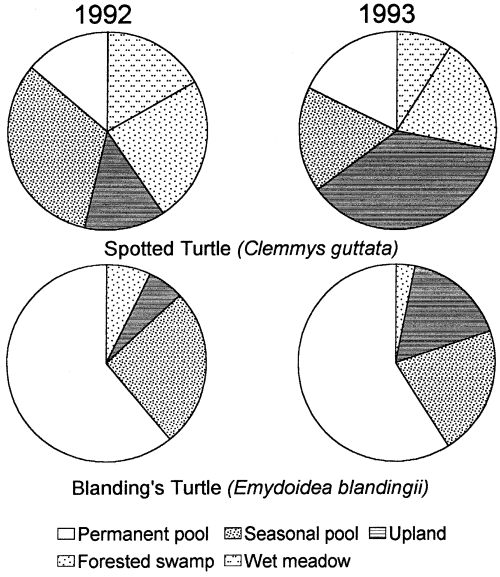
Landscape ecology approaches to wetland species conservation: a case study of two turtle species in southern Maine
1992 to 1993
Summary
The authors investigated the habitat use and movements of two turtle species to assess the importance of conserving multiple wetlands and the upland matrix in which they occur. They found that individuals of both species used multiple wetlands throughout the year, including permanent and seasonal pools, forested swamps, and wet meadows.
Key Personnel & Institutions
People: L. Joyal
Institutions: University of Maine, Orono, Department of Wildlife Ecology
Location
York
Resource Type
Article
Tags
Blanding's turtles, mating, nesting, spotted turtles, turtles
Topic Tags
conservation, ecosystem services, wildlife and habitat
Purpose Tags
education
Citation
Joyal, L.A., McCollough, M., & Hunter, M.L. (2001). Landscape ecology approaches to wetland species conservation: a case study of two turtle species in southern Maine. Conservation biology, 15(6), 1755-1762.
Source Link
Forest fragmentation patterns in Maine watersheds and prediction of visible crown diameter in recent undisturbed forest
2011 to 2012
Summary
The authors used multiple sources of remotely sensed, topographic, and site index data to predict forest locations containing large diameter trees and identify undisturbed forest patches.
Key Personnel & Institutions
People: Brianne Looze
Institutions: University of Maine
Location
Maine
Resource Type
Article
Tags
timber harvest, landsat, remote sensing, maine, ecoregion, principal components analysis
Topic Tags
methods, management
Purpose Tags
education
Citation
Looze, B.E. (2012). Forest Fragmentation Patterns in Maine Watersheds and Prediction of Visible Crown Diameter in Recent Undisturbed Forest. (University of Maine Ms Thesis).
Source Link
Habitat features associated with predation of New England cottontails: what scale is appropriate?
1989 to 1993
Summary
The authors examined habitat features at several spatial scales that were associated with predation of New England cottontails (Sylvilagus transitionalis) by mammalian carnivores. They found that the perimeter-to-area ratio of an occupied patch, the amount of disturbed habitat within 0.5 km of a patch, and the amount of coniferous forest within 1 km of a patch were greater for killed rabbits than for those that survived.
Key Personnel & Institutions
People: A. Brown
Institutions: University of New Hampshire, Department of Natural Resources and the Environment
Location
Strafford
Resource Type
Article
Tags
roads, rabbits, fragmentation, connectivity, landscape genetics, new england cottontail
Topic Tags
ecosystem services, wildlife and habitat
Purpose Tags
education
Citation
Brown, A.L., & Litvaitis, J.A. (1995). Habitat features associated with predation of New England cottontails: what scale is appropriate?. Canadian journal of zoology, 73(6), 1005-1011.
Source Link
http://www.nrcresearchpress.com/doi/abs/10.1139/z95-120#.WyqFKKdKiUk
A multiscale analysis of gene flow for the New England cottontail, an imperiled habitat specialist in a fragmented landscape
2006 to 2008
Summary
The authors evaluated local population structure and measures of genetic diversity of a geographically isolated population of New England cottontail (Sylvilagus transitionalis) in the northeastern United States. They assessed the relative importance of dispersal barriers and facilitators on gene flow varied among populations in relation to landscape composition, demonstrating the complexity and context dependency of factors influencing gene flow and highlighting the importance of replication and scale in landscape genetic studies.
Key Personnel & Institutions
People: Lindsey Fenderson , Noah Perlut , Adrienne Kovach, John Litvaitis, Kathleen O'Brien, Kelly Boland, Walter Jakubas
Institutions: University of New Hampshire , US Fish & Wildlife Service , Maine Department of Inland Fisheries & Wildlife
Location
Maine, New Hampshire
Resource Type
Article
Tags
land use, roads, rabbits, new england cottontail
Topic Tags
conservation, ecosystem services, drivers, wildlife and habitat
Purpose Tags
education
Citation
Fenderson, L. E., Kovach, A. I., Litvaitis, J. A., O'Brien, K. M., Boland, K. M., & Jakubas, W. J. (2014). A multiscale analysis of gene flow for the New England cottontail, an imperiled habitat specialist in a fragmented landscape. Ecology and Evolution, 4(10), 1853–1875. http://doi.org/10.1002/ece3.1068
Source Link
Quantifying terrestrial habitat loss and fragmentation: a protocol
2004 to 2005
Summary
This review paper describes habitat fragmentation, as well as alternative perspectives on fragmentation in which habitat patches are viewed either as analogs of oceanic islands embedded in an ecologically neutral sea or as patches of variable quality embedded within a complex and heterogeneous mosaic of patches of varying suitability and affects on habitat connectivit, and key spatial components of habitat loss and fragmentation: habitat extent, subdivision, geometry, isolation, and connectivity, and their affects on individual behavior and habitat use, population structure and viability, and interspecific interactions.
Key Personnel & Institutions
People: Kevin McGarigal
Institutions: UMass Amherst Department of Natural Resources Conservation , United States Department of Agriculture (USDA), Forest Service, Rocky Mountain Research Station
Location
No location information available
Resource Type
Article
Tags
biodiversity, fragmentation, anthropogenic habitat loss, guidelines, human impacts, protocol
Topic Tags
methods, management, planning, drivers, landscape pattern and connectivity
Purpose Tags
management, education
Citation
McGarigal, K., Cushman, S., & Regan, C. (2005). Quantifying Terrestrial Habitat Loss and Fragmentation: A Protocol. University of Massachusetts, 115.
Source Link
Wildlife dynamics in the changing New England landscape
1599 to 2002
Summary
The authors compiled data on major wildlife species to identify broad population trends and to address both fundamental and applied questions regarding these long-term patterns in Massachusetts. They found that wildlife populations were changing at a remarkable rate leading to significant ecological impacts on the landscape and many other species, creating major conservation and management challenges, and generating novel and oftentimes significant conflicts with human values.
Key Personnel & Institutions
People: David Foster
Institutions: Harvard University, Harvard Forest , Missouri Department of Conservation, Massachusetts Division of Fisheries and Wildlife
Location
Massachusetts
Resource Type
Article
Tags
birds, moose, bear, beaver, deer, deforestational fragmentation, human populations, land use change, wolf
Topic Tags
ecosystem services, drivers, wildlife and habitat
Purpose Tags
education
Citation
Foster, D. R., Motzkin, G., Bernardos, D., & Cardoza, J. (2002). Wildlife dynamics in the changing New England landscape. Journal of Biogeography, 29(10–11), 1337–1357. https://doi.org/10.1046/j.1365-2699.2002.00759.x
Source Link
https://onlinelibrary.wiley.com/doi/full/10.1046/j.1365-2699.2002.00759.x
Influence of land use and site characteristics on invasive plant abundance in the Quinebaug Highlands of southern New England
1999 to 2004
Summary
This study examined the distribution and abundance (cover and frequency) of invasive plants in natural habitats of the Quinebaug Highlands forest block in northern Connecticut and southern Massachusetts in relation to current and historical land use and site conditions.
Key Personnel & Institutions
People: Marjorie Lundgren , Christine Small, Glenn Dreyer
Institutions: Connecticut College , Wesleyan University
Location
Massachusetts, Connecticut
Resource Type
Article
Tags
land use, competition, plants, displacement, exotic, flora, invasives
Topic Tags
conservation, management, ecosystem services
Purpose Tags
education
Citation
Lundgren, M. R., Small, C. J., & Dreyer, G. D. (2004). Influence of Land Use and Site Characteristics on Invasive Plant Abundance in the Quinebaug Highlands of Southern New England. Eagle Hill Institute, 11(3), 313–332.
Source Link
http://www.jstor.org/stable/pdf/3858421.pdf?refreqid=excelsior:f8ebac9140612042c6bbee5e99cd1a83
Assessment of forest fragmentation in southern New England using remote sensing and geographic information systems technology
1972 to 1987
Summary
The authors used the natural logarithms of forest area to perimeter ratios, referred to as the forest continuity index, to assess patterns and trends of forest fragmentation across southern New England that included 157 townships in southern New Hampshire and north eastern Massachusetts. Decreases in forest continuity index values occurred throughout much of the study region between 1973 and 1988, suggesting that forest fragmentation is occurring over large regions within the eastern United States.
Key Personnel & Institutions
People: James Vogelmann
Institutions: University of New Hampshire
Location
SALISBURY, NEWBURYPORT, TEWKSBURY, FITCHBURG, ESSEX, READING, PEABODY, BURLINGTON, GROTON, ASHBURNHAM, AMESBURY, WENHAM, CARLISLE, SAUGUS, DANVERS, TYNGSBOROUGH, STONEHAM, NEWBURY, DRACUT, IPSWICH, HAMILTON, DUNSTABLE, ASHBY, LAWRENCE, GEORGETOWN, MELROSE, PEPPERELL, WOBURN, LUNENBURG, GROVELAND, WAKEFIELD, WESTFORD, NORTH READING, MIDDLETON, WILMINGTON, CHELMSFORD, BILLERICA, SHIRLEY, METHUEN, BEDFORD, ANDOVER, WEST NEWBURY, LITTLETON, HAVERHILL, ROWLEY, TOWNSEND, AYER, MERRIMAC, NORTH ANDOVER, LOWELL, WINCHESTER, LYNNFIELD, LYNN, TOPSFIELD, BOXFORD, Allenstown, Amherst, Andover, Antrim, Atkinson, Auburn, Barnstead, Barrington, Bedford, Bennington, Boscawen, Bow, Bradford, Brentwood, Brookline, Candia, Chester, Chichester, Concord, Danville, Deerfield, Deering, Derry, Dover, Dunbarton, Durham, East Kingston, Epping, Epsom, Exeter, Farmington, Francestown, Franklin, Fremont, Gilmanton, Goffstown, Greenfield, Greenland, Greenville, Hampstead, Hampton, Hampton Falls, Hancock, Henniker, Hillsborough, Hollis, Hooksett, Hopkinton, Hudson, Kensington, Kingston, Lee, Litchfield, Londonderry, Loudon, Madbury, Manchester, Mason, Merrimack, Milford, Milton, Mont Vernon, Nashua, New Boston, New Hampton, New Ipswich, Newfields, Newington, Newmarket, Newton, Northwood, Nottingham, Pelham, Peterborough, Pittsfield, Plaistow, Portsmouth, Raymond, Rindge, Rochester, Rollinsford, Rye, Salem, Salisbury, Sandown, Seabrook, Sharon, Somersworth, South Hampton, Strafford, Stratham, Sutton, Temple, Warner, Weare, Webster, Wilton, Windsor
Resource Type
Article
Tags
remote sensing, aerial imagery, habitat fragmentation
Topic Tags
landscape pattern and connectivity
Purpose Tags
conservation
Citation
Vogelmann, J.E. (1995). Assessment of forest fragmentation in southern New England using remote sensing and geographic information systems technology. Conservation Biology, 9(2), pp.439-449.
Source Link
http://www.jstor.org/stable/pdf/2386787.pdf?refreqid=excelsior%3Aaf7b848a69f45a66205f56299e9e0b44
Effects of ice storm-created gaps on forest breeding bird communities in central Vermont
1993 to 1997
Summary
The author investigated the short-term effects of the 1998 ice storm on breeding birds in a northern hardwood forest in central Vermont. Overall, species richness and diversity increased only at ice storm sites, whereas total abundance increased at controls.
Key Personnel & Institutions
People: Steven Faccio
Institutions: VINS (Vermont Institute of Natural Science)
Location
VERMONT
Resource Type
Article
Tags
forest disturbance, birds, forest management, wildlife
Topic Tags
management, ecosystem services, wildlife and habitat
Purpose Tags
management, education
Citation
Faccio, S.D. (2003). Effects of ice storm-created gaps on forest breeding bird communities in central Vermont. Forest Ecology and Management, 186(1), pp.133-145.
Source Link
https://www.sciencedirect.com/science/article/abs/pii/S0378112703002329
Effects of small-scale habitat disturbance on the ecology of breeding birds in a Vermont (USA) hardwood forest
1994 to 1995
Summary
The authors studied territory placement and foraging behavior of breeding birds in relation to juxtaposition of forest vegetation and logged patches in southern Vermont. They found that different bird species used disturbed vegetation at differing spatial scales, depending on territory size.
Key Personnel & Institutions
People: Richard Lent
Institutions: University of Vermont
Location
VERMONT
Resource Type
Article
Tags
forest disturbance, birds, wildlife, fragmentation
Topic Tags
ecosystem services, wildlife and habitat, landscape pattern and connectivity
Purpose Tags
management, education
Citation
Lent, R.A. & Capen, D.E. (1995). Effects of small-scale habitat disturbance on the ecology of breeding birds in a Vermont (USA) hardwood forest. Ecography 18: 97-108.
Source Link
http://www.jstor.org/stable/pdf/3682757.pdf?refreqid=excelsior%3A49578939eb13d4b88886915ee5b46a2f
Assessing population trends of New Hampshire forest birds: local vs. regional patterns
1968 to 1985
Summary
The authors examined the changes in abundance between 1969 and 1986 of 19 forest dwelling, mostly migratory bird species breeding in New Hampshire at 2 different scales: one local (an intensively studied 10-ha plot in unfragmented forest) and the other regional (Breeding Bird Surveys statewide). Overall, they found that more species declined than increased both locally (8 vs. 1) and regionally (5 vs. 1).
Key Personnel & Institutions
People: Richard Holmes
Institutions: American Ornithological Society
Location
New Hampshire
Resource Type
Article
Tags
songbirds, bird breeding surveys, forest dwelling birds, forest succession, migratory birds, neotropical migrants
Topic Tags
ecosystem services, drivers, wildlife and habitat
Purpose Tags
conservation
Citation
Holmes, R.T. & Sherry, T. (1988). Assessing population trends of New Hampshire forest birds: local vs. regional patterns. American Ornithological Society, Vol. 105(4), pp. 756-768.
Source Link
http://www.jstor.org/stable/pdf/4087390.pdf?refreqid=excelsior%3A070f7a4bfcd4ef806667ab2eafd6353a
Associations between breeding bird abundance and stand structure in the White Mountains, New Hampshire and Maine
1997 to 1998
Summary
The authors compared the associations of forest cover-type, stand size-class, and stand structure to abundance of breeding bird species in managed forest in northern New England. Of the 31 bird species that met the criteria for analysis, a significant association was detected between bird abundance and structure data for 30 species, cover-type data for 19 species, and size-class data for 10 species.
Key Personnel & Institutions
People: Richard DeGraaf
Institutions: United States Department of Agriculture (USDA), Forest Service
Location
New Hampshire
Resource Type
Article
Tags
bird habitat, forest structure, forest birds, forest cover, timber size-class
Topic Tags
ecosystem services, wildlife and habitat
Purpose Tags
management
Citation
DeGraaf, R.M., Hestbeck, J.B. & Yamasaki, M. (1998). Associations between breeding bird abundance and stand structure in the White Mountains, New Hampshire and Maine, USA. Forest Ecology and Management, 103(2-3), pp.217-233.
Source Link
Physiological responses by lagomorphs to resource limitations imposed by habitat fragmentation: implications to condition-sensitive predation
1993 to 1994
Summary
The authors used multiple and logistic regression analysis to study the breeding area requirements of 10 species of grassland and early successional birds at 90 grassland barren sites in Maine. They conlcuded that conservation efforts seeking to protect habitat for rare grassland birds need to consider sites of at least 100 ha and preferably 200 ha in size, and these are notably rare in Maine and probably throughout New England and eastern North America.
Key Personnel & Institutions
People: Peter Vickery , Malcolm Hunter, Scott Melvin
Institutions: University of Maine , Maine Department of Inland Fisheries & Wildlife
Location
Cumberland, Hancock, Lincoln, Sagadahoc, Waldo, Washington, York
Resource Type
Article
Tags
grasslands, breeding birds, early successional
Topic Tags
conservation, management, ecosystem services, wildlife and habitat
Purpose Tags
conservation, education
Citation
Vickery, P. D., Hunter, M. L., & Melvin, S. M. (1994). Effects of Habitat Area on the Distribution of Grassland Birds in Maine. Conservation Biology. Retrieved from https://onlinelibrary.wiley.com/doi/abs/10.1046/j.1523-1739.1994.08041087.x
Source Link
https://onlinelibrary.wiley.com/doi/abs/10.1046/j.1523-1739.1994.08041087.x
Characterization of forest fragmentation and urban sprawl using time sequential Landsat imagery
2000 to 2001
Summary
The authors identified and quantified forest fragmentation and urban sprawl in the 140 square mile Salmon River watershed in Connecticut. To do this, they developed accurate and consistent general land cover maps and identified the land cover change derived from Landsat Thematic Mapper and Enhanced Thematic Mapper satellite imagery.
Key Personnel & Institutions
People: James Hurd , Emily Wilson, Steven Lammey, Daniel Civco
Institutions: University of Connecticut, CAHNR
Location
Connecticut
Resource Type
Article
Tags
imagery, landsat, fragmentation, watershed
Topic Tags
methods, management, ecosystem services
Purpose Tags
education
Citation
Hurd, J. D., Wilson, E. H., Lammey, S. G., & Civco, D. L. (2001). Characterization of Forest Fragmentation and Urban Sprawl Using Time Sequential Landsay Imagery. ASPRS 2001 Annual Convention, 12.
Source Link
Forest fragmentation and avian nest predation in forested landscapes
1985
Summary
The authors placed artificial nests containing quail eggs in forests of different sizes and at various distances from the edge to test which of these factors was most important in describing predation. In doing so, they found that large areas and those bordered on at least one side by a large water body had lower predation rates.
Key Personnel & Institutions
People: Mark Small
Institutions: University of Maine, Orono, Department of Wildlife Ecology
Location
Lincoln, Sagadahoc
Resource Type
Article
Tags
artificial nests, forest fragmentation, nest predation, passerines
Topic Tags
conservation, ecosystem services, wildlife and habitat
Purpose Tags
conservation, education
Citation
Small, M.F. & Hunter, M.L. (1988). Forest fragmentation and avian nest predation in forested landscapes. Oecologia, 76(1), 62-64. https://doi.org/10.1007/BF00379601
Source Link
https://www.jstor.org/stable/4218636?seq=1#page_scan_tab_contents
Forest bird populations in Massachusetts: breeding habitat loss and other influences
2016 to 2017
Summary
The objective of this research was to determine whether changes in populations of forest-interior bird species were related to changes in extent of interior forest along Breeding Bird Survey census routes in Massachusetts. The authors found that changes in some bird populations seem to reflect forest succession, while others were unexplained and may be due to changes on migratory routes or wintering grounds.
Key Personnel & Institutions
People: Timothy Gardner
Institutions: College of the Holy Cross, Biology Department
Location
Massachusetts
Resource Type
Article
Tags
populations, bird breeding surveys, forest birds, forest loss, forest succession, interior forest
Topic Tags
ecosystem services, wildlife and habitat
Purpose Tags
education
Citation
Gardner, T.J., Eagan, C.R., and Bertin, R.I. (2017). Forest bird populations in Massachusetts: breeding habitat loss and other influences. Northeastern Naturalist, 24(3), 267-288.
Source Link
https://search.proquest.com/docview/1946214509?pq-origsite=gscholar
Edge effects enhance carbon uptake and its vulnerability to climate change in temperate broadleaf forests.
2015 to 2017
Summary
The authors examined the changes in biomass and forest growth on a gradient from the forest interior to edge. Using climate projections, the authors showed that future heat stress could reduce the forest edge growth enhancement by one-third by the end of the century.
Key Personnel & Institutions
People: Andrew Reinmann
Institutions: Boston University, Department of Earth and the Environment
Location
BELMONT, LYNN
Resource Type
Article
Tags
tree growth, carbon, fragmentation, forest edge
Topic Tags
ecosystem services, landscape pattern and connectivity
Purpose Tags
education
Citation
Reinmann, A.B. and Hutyra, L.R. (2017). Edge effects enhance carbon uptake and its vulnerability to climate change in temperate broadleaf forests. Proceedings of the National Academy of Sciences, 114(1), 107-112.
Source Link
Abundance, distribution, trends, and ownership patterns of early-successional forests in the northeastern United States
1947 to 1999
Summary
The author summarized results of the Forest Inventory and Analysis Program for 11 states in the Northeast to identify recent trends in the area of early-successional forests. The results suggest that the area of total forest land has remained relatively constant in the northeast; however, the area of early-successional forests has declined since the first forest surveys (ca. 1950).
Key Personnel & Institutions
People: R. Brooks
Institutions: United States Department of Agriculture (USDA), Forest Service , United States Department of Agriculture (USDA), Forest Service, Northeastern Research Station
Location
New York, New England
Resource Type
Article
Tags
fragmentation, fia, early successional forest, forest inventory and analysis, forest survey, ownership, parcelization
Topic Tags
management, ecosystem services, wildlife and habitat
Purpose Tags
education
Citation
Brooks, R.T. (2003). Abundance, distribution, trends, and ownership patterns of early-successional forests in the northeastern United States. Forest Ecology and Management, 185(1-2), 65-74.
Source Link
https://www.sciencedirect.com/science/article/pii/S0378112703002469
Forest loss in New England: A projection of recent trends
2016 to 2017
Summary
The authors addressed three questions concerning forest loss across six New England states: (1) What would be the consequences of a continuation of the recent trends in terms of changes to New England's forest cover mosaic? (2) What social and biophysical attributes are most strongly associated with recent trends in forest loss, and how do these vary geographically? (3) How sensitive are projections of forest loss to the reference period, i.e. how do projections based on the period spanning 1990-to-2000 differ from 2000-to-2010, or from the full period, 1990-to-2010?
Key Personnel & Institutions
People: Jonathan Thompson
Institutions: Harvard University, Harvard Forest , Harvard University , Boston University, Department of Earth and the Environment, Clemson University, Department of Forestry and Environmental Conservation
Location
VERMONT, Massachusetts, Maine, Connecticut, Rhode Island
Resource Type
Article
Tags
forest ecology, land use, census, biophysics, ecosystems, population density, urban areas
Topic Tags
management, ecosystem services
Purpose Tags
education
Citation
Thompson, J.R., Plisinski, J.S., Olofsson, P., Holden, C.E., & Duveneck, M.J. (2017). Forest loss in New England: A projection of recent trends. PLOS ONE, 12(12), e0189636. https://doi.org/10.1371/journal.pone.0189636
Source Link
http://journals.plos.org/plosone/article?id=10.1371/journal.pone.0189636
Housing is positively associated with invasive exotic plant species richness in New England, USA
2009 to 2010
Summary
The authors evaluated relationships between housing developments and the distribution of invasive exotic plants. They found that invasive exotic plant richness was equally or more strongly related to housing variables than to other human and environmental variables at the county level across New England.
Key Personnel & Institutions
People: G. Gavier-Pizarro
Institutions: United States Department of Agriculture (USDA), Forest Service, Northern Research Station , University of Wisconsin, Department of Forest and Wildlife Ecology
Location
New England
Resource Type
Article
Tags
land use, development, housing development, invasive plants, invasives
Topic Tags
management, ecosystem services, drivers, landscape pattern and connectivity
Purpose Tags
management, education
Citation
Gavier-Pizarro, G.I., Radeloff, V.C., Stewart, S.I., Huebner, C.D., and Keuler, N.S. (2010). Housing is positively associated with invasive exotic plant species richness in New England, USA. Ecological Applications, 20(7), 1913-1925.
Source Link
https://esajournals.onlinelibrary.wiley.com/doi/full/10.1890/09-2168.1
Techniques and considerations for FIA forest fragmentation analysis
1998 to 1999
Summary
This article descibes the possibilities of utilizing Forest Inventory Analysis data in combination with remote sensing and increased computing capacity to assess foret fragmentation in the region.
Key Personnel & Institutions
People: Andrew Lister
Institutions: United States Department of Agriculture (USDA), Forest Service, Northeastern Research Station
Location
New England
Resource Type
Article
Tags
ecology, monitoring, forest service, fia, forest resources, inventory
Topic Tags
methods, management, landscape pattern and connectivity
Purpose Tags
conservation, education
Citation
Lister, A.J., Lister, T.W., Riemann, R. and Hoppus, M. (2002). Techniques and Considerations for FIA forest fragmentation analysis. In: McRoberts, R.E., Reams, G.A., Van Deusen, P.C., Moser, J.W. (Eds). (2002). Proceedings of the Thrid Annual Forest Inventory and Analysis Symposium; Gen. Tech. Rep. NC-230. St. Paul, MN: U.S. Department of Agriculture, Forest Service, North Central Research Station: 156-161.
Source Link
Socioeconomics drive woody invasive plant richness in New England, USA through forest fragmentation
2012 to 2013
Summary
The authors tested whether woody invasive plant richness was higher in landscapes with many forest edges relative to other forest types, developing models that demonstrated that woody invasive plant richness was higher in landscapes with more edge forest relative to patch, perforated, and especially core forest types. Identifying these landscape patterns will aid ongoing efforts to use current distribution patterns to better predict where invasive species may occur in unsampled regions under current and future conditions.
Key Personnel & Institutions
People: Jenica Allen
Institutions: University of Connecticut, Department of Ecology and Evolutionary Biology, Duke University, Department of Statistical Science, University of Connecticut, Department of Natural Resources and the Environment
Location
New England
Resource Type
Article
Tags
land use, alien invasive species, exotic plants, IPANE, landcover, social-ecological
Topic Tags
management, ecosystem services, wildlife and habitat
Purpose Tags
management, education
Citation
Allen, J. M., Leininger, T. J., Hurd, J. D., Civco, D. L., Gelfand, A. E., and Silander, J. A. (2013). Socioeconomics drive woody invasive plant richness in New England, USA through forest fragmentation. Landscape Ecology, 28(9), 1671-1686. https://doi.org/10.1007/s10980-013-9916-7
Source Link
Niche dimensions of New England cottontails in relation to habitat patch size
1989 to 1991
Summary
The authors examined physical condition, niche dimensions, and survival of New England cottontails (Sylvilagus transitionalis) that occupied 21 habitat patches of different sizes during winter. Skewed sex ratios and low survival rates among rabbits on small patches suggest that these habitats act as sinks to dispersing juveniles from large source patches, possibly making local populations of New England cottontails vulnerable to extinction if large patches of habitat are not maintained.
Key Personnel & Institutions
People: Michael Barbour
Institutions: University of New Hampshire, Department of Natural Resources and the Environment
Location
Strafford
Resource Type
Article
Tags
rabbits, fragmentation, new england cottontail, niche expansion, resource limitations
Topic Tags
conservation, ecosystem services, wildlife and habitat
Purpose Tags
conservation, management, education
Citation
Barbour, M. S., and Litvaitis, J. A. (1993). Niche dimensions of New England cottontails in relation to habitat patch size. Oecologia, 95(3), 321-327. https://doi.org/10.1007/BF00320983
Source Link
Biofrag: a new database for analyzing BIOdiversity responses to forest FRAGmentation
2013 to 2014
Summary
The authors developed a relational database linking field data on habitat fragmentation to taxonomic nomenclature, spatial and temporal plot attributes, and environmental characteristics. The consistent format of this database facilitates testing of generalizations concerning biologic responses to fragmentation across diverse systems and taxa.
Key Personnel & Institutions
People: Marion Pfeifer
Institutions: Imperial College London , Stockholm Environment Institute , Universidad Nacional Autónoma de México (UNAM) , Ghent University, Department of Forest and Water Management
Location
New York, New England
Resource Type
Article
Tags
fragmentation, bioinformatics, data sharing, database, edge effects, landscape metrics
Topic Tags
methods, landscape pattern and connectivity
Purpose Tags
education
Citation
Pfeifer, M., Lefebvre, V., Gardner, T.A., Arroyo-Rodriguez, V., Baeten, L., Banks-Leite, C., Barlow, J., Betts, M.G., Brunet, J., Cerezo, A. & Cisneros, L.M. (2014). BIOFRAG - a new database for analyzing BIO diversity responses to forest FRAG mentation. Ecology and Evolution, 4(9): 1524-1537.
Source Link
Habitat fragmentation and its lasting impact on Earth's ecosystems
2014 to 2015
Summary
The authors conducted an analysis of global forest cover to reveal that 70% of remaining forest is within 1 km of the forest's edge, subject to the degrading effects of fragmentation. A synthesis of fragmentation experiments spanning multiple biomes and scales, five continents, and 35 years demonstrates that habitat fragmentation reduces biodiversity by 13 to 75% and impairs key ecosystem functions by decreasing biomass and altering nutrient cycles.
Key Personnel & Institutions
People: Nick Haddad
Institutions: Michigan State University , University of Colorado
Location
New York, New England
Resource Type
Article
Tags
spatial methods, fragmentation, global analysis
Topic Tags
conservation, ecosystem services, landscape pattern and connectivity
Purpose Tags
education
Citation
Haddad, N.M., Brudvig, L.A., Clobert, J., Davies, K.F., Gonzalez, A., Holt, R.D., Lovejoy, T.E., Sexton, J.O., Austin, M.P., Collins, C.D. & Cook, W.M. (2015). Habitat fragmentation and its lasting impact on Earth's ecosystems. Science Advances, 1(2), p.e1500052.
Source Link
Global-scale patterns of forest fragmentation
1999 to 2000
Summary
The authors conducted an analysis of forest fragmentation based on 1-km resolution land-cover maps for the globe, using six categories of fragmentation (interior, perforated, edge, transitional, patch, and undetermined) from the amount of forest and its occurrence as adjacent forest pixels. Patterns and differences at multiple scales were assess within and across continents.
Key Personnel & Institutions
People: Kurt Riitters
Institutions: United States Department of Agriculture (USDA), Forest Service, Southern Research Station
Location
New York, New England
Resource Type
Article
Tags
forests, analysis, forest fragmentation, global analysis
Topic Tags
methods, landscape pattern and connectivity
Purpose Tags
conservation, education
Citation
Riitters, K., Wickham, J., O’Neill, R., Jones, B. & Smith, E. (2000). Global-scale patterns of forest fragmentation. Conservation Ecology, 4(2).
Source Link
The Vermont Forest Integrity Bill (H.233)
2000 to 2013
Summary
This Vermont policy (H.233) was an update to Act 250 aimed to better maintain important rural natural resources. It was created following testimony of land use experts and review of research and legislative reports going back more than ten years, after which experts concluded that the existing Act 250 criteria failed to protect Vermont forests from subdivision and forest fragmentation.
Key Personnel & Institutions
Institutions: Vermont Natural Resources Council
Location
VERMONT
Resource Type
Policy
Tags
forest health, landuse planning, forestland conservation
Topic Tags
management, landscape pattern and connectivity
Purpose Tags
policy
Citation
The Vermont General Assembly (2017). H.233 - The Forest Integrity Bill. Available at http://vnrc.org/programs/forests-wildlife/forest-and-habitat-fragmentation-campaign/h-233/
Source Link
https://legislature.vermont.gov/Documents/2018/Docs/BILLS/H-0233/H-0233 As Introduced.pdf
Remote sensing of land-cover change and landscape context of the National Parks: a case study of the Northeast Temperate Network
2008 to 2009
Summary
In this study the authors developed and implemented a multi-scale protocol for detecting and monitoring land-cover change in and adjacent to National Parks and ten segments of the Appalachian National Scenic Trail (AT) in the northeastern United States. The study concluded that all of the studied park units, except one segment of AT in Maine, experienced increases of urban land and declines of forest cover in the immediately adjacent areas and extended buffer zones.
Key Personnel & Institutions
People: Y. Wang, Brian Mitchell , Brian Mitchell, Jarunee Nugranad-Marzilli, Gregory Bonynge, Yuyu Zhou, Gregory Shriver
Institutions: University of Rhode Island, Department of Natural Resources Science , Northeast Temperate Network
Location
No location information available
Resource Type
Article
Tags
landsat, recreation, Appalachian Trail, landcover change, national parks
Topic Tags
No topic tag keywords available
Purpose Tags
No purpose tag keywords available
Citation
Wang, Y., Mitchell, B.R., Nugranad-Marzilli, J., Bonynge, G., Zhou, Y., and Shriver, G. (2009). Remote sensing of land-cover change and landscape context of the National Parks: A case study of the Northeast Temperate Network. Remote Sensing of Environment, 113(7), 1453-1461.
Source Link
https://www.sciencedirect.com/science/article/pii/S0034425709000509
Interacting effects of climate change, landscape conversion, and harvest on carnivore populations at the range Margin: marten and lynx in the northern Appalachians
2006 to 2007
Summary
The author used a spatially explicit population model to assess potential effects of predicted changes in snowfall by 2055 on regional marten and lynx populations. The author found that the climate change interacted with logging in its effects on the marten and with trapping in its effects on the lynx, increasing overall vulnerability.
Key Personnel & Institutions
People: C. Carroll
Institutions: Klamath Center for Conservation Research
Location
VERMONT, Maine, New Hampshire
Resource Type
Article
Tags
populations, connectivity, marten, lynx
Topic Tags
conservation, management, ecosystem services, planning
Purpose Tags
conservation, education
Citation
Carroll, C. (2007). Interacting effects of climate change, landscape conversion, and harvest on carnivore populations at the range margin: marten and lynx in the northern Appalachians. Conservation biology, 21(4), 1092-1104.
Source Link
https://onlinelibrary.wiley.com/doi/full/10.1111/j.1523-1739.2007.00719.x
Human risk of infection with Borrelia burgdorferi, the lyme disease agent, in eastern United States
2003 to 2007
Summary
The authors mapped the geographic pattern of human risk for infection with Borrelia burgdorferi sensu stricto, the tick-borne pathogen that causes Lyme disease, for the eastern United States.
Key Personnel & Institutions
People: M. Diuk-Wasser
Institutions: Michigan State University , Yale School of Public Health , Institut National de la Recherche Agronomoique , California State University , University of California , Centers for Disease Control and Prevention , Dartmouth Medical School , University of Nebraska , University of Tennessee , Vilnius University , Emory University , University of Richmond
Location
New York, New England
Resource Type
Article
Tags
lyme disease, risk assesment
Topic Tags
management, planning
Purpose Tags
education
Citation
Diuk-Wasser, M.A., Hoen, A.G., Cislo, P., Brinkerhoff, R., Hamer, S. A., Rowland, M., Cortinas, R., Vourc'h, G., Melton, F., Hickling, G.J., Tsao, J.I., Bunikis, J., Barbour, A.G., Kitron, U., Piesman, J., and Fish, D. (2012). Human risk of infection with Borrelia burgdorferi, the Lyme disease agent, in eastern United States. The American Journal of Tropical Medicine and Hygiene, 86(2), 320-327.
Source Link
Special Features Overlay Zones (Section 208)
2012 to 2013
Summary
The Special Features Overlay Zones are superimposed over all underlying zoning districts, and include Wetlands, Deer Wintering Areas, Wellhead Protection Areas, Meadowlands, Steep Slopes, Ridgelines, and Wildlife Corridors.
Key Personnel & Institutions
Institutions: Vermont Natural Resources Council
Location
VERMONT
Resource Type
Policy
Tags
landuse planning, community based planning, habitat conservation
Topic Tags
ecosystem services, wildlife and habitat
Purpose Tags
management, policy
Citation
Vermont Natural Resources Council. (n.d.) Section 208: Special Features Overlay Zones. Available at http://vnrc.org/wp-content/uploads/typo3/Publications/SECTION 208.pdf
Source Link
https://vnrc.org/wp-content/uploads/2019/11/Special-Features-Overlay-Zone.pdf
Parcelization of Vermont Forest (H.758)
2006 to 2008
Summary
This Vermont bill proposed to establish programs to help prevent the parcelization of state forest land. The bill authorizes the Vermont Housing and Conservation Board to use its funds to preserve and conserve forest land, and requires that the Department of Forests, Parks and Recreation develop education materials regarding the impact of forest parcelization and track forest parcelization rates within the state.
Key Personnel & Institutions
Institutions: Vermont General Assembly
Location
VERMONT
Resource Type
Policy
Tags
landuse planning, forestland conservation, parcelization
Topic Tags
conservation, landscape pattern and connectivity
Purpose Tags
policy
Citation
The Vermont General Assembly. (2008). H. 758 - An Act Relating to the Parcelization of Vermont Forests.
Source Link
http://www.leg.state.vt.us/docs/legdoc.cfm?URL=/docs/2008/bills/intro/H-758.HTM
Local protection of natural resources after jam golf: standards and standard of review
2008 to 2009
Summary
This paper considers opportunities for towns to reduce vagueness in their municipal standards by improving specificity in town plans, zoning ordinances, and during the application process for PRDs and subdivisions.
Key Personnel & Institutions
People: Katherine Garvey
Institutions: Vermont Courts
Location
SOUTH BURLINGTON
Resource Type
Article
Tags
natural resource protection, planned residential development
Topic Tags
conservation, ecosystem services, drivers
Purpose Tags
policy
Citation
Garvey, K. (2009). Local protection on natural resources after JAM golf: standards and standard review. Vermont Journal of Environmental Law, Vol. 11: 145-166.
Source Link
Analysis of potential habitat fragmentation impacts to songbirds and bats associated with the Baron Winds Project, New York
2016 to 2017
Summary
This memo was prepared to assess the potential for habitat fragmentation impacts to breeding birds and bats from construction of the proposed Baron Winds Project.
Key Personnel & Institutions
People: Sarah Gravel
Institutions: Stantec Consulting Services, LLC, EverPower Wind Holdings Inc.
Location
Steuben
Resource Type
Report
Tags
fragmentation, songbirds, bats, certificate application, consulting, permit, wind turbines
Topic Tags
ecosystem services, drivers, wildlife and habitat, landscape pattern and connectivity
Purpose Tags
management, education
Citation
Gravel, S.B. and DiBello, F. (2017). Analysis of Potential Habitat Fragmentation Impacts to Songbirds and Bats Associated with the Baron Winds Project, New York [memo]. Stantec Consulting Services Inc.
Source Link
Forest Integrity Study Committee (H.857 - Act 171)
2016 to 2017
Summary
This act amends multiple provisions related to timber harvesting and forest management.
Key Personnel & Institutions
People: Michael Snyder
Institutions: Vermont Agency of Natural Resources , Vermont Forest Parks and Recreation , State of Vermont
Location
VERMONT
Resource Type
Policy
Tags
timber harvest, forest management, fragmentation, legislation
Topic Tags
management, ecosystem services, landscape pattern and connectivity
Purpose Tags
management, policy
Citation
Vermont Department of Forests, Parks and Recreation. (n.d.). Act 171 - Forest Integrity Study Committee. Available at http://fpr.vermont.gov/forest/act-171-study-committee
Source Link
https://fpr.vermont.gov/act-171-forest-integrity-study-committee
Vermont's land use and development law (Act 250)
1968 to 1970
Summary
This document describes Vermont's Act 250 database of permits
Key Personnel & Institutions
Institutions: Vermont Agency of Natural Resources , Natural Resources Board
Location
VERMONT
Resource Type
Policy
Tags
development, act 250, laws, permitting, policy
Topic Tags
conservation, management, ecosystem services
Purpose Tags
conservation, management, policy
Citation
Act 250 Program | Natural Resources Board. (n.d.). Available at http://nrb.vermont.gov/act250-program
Source Link
http://anr.vermont.gov/planning/act250-section248-info/act-250
Forest Harvest Regulation (Statute 8869)
1988 to 2012
Summary
To promote a healthy and sustainable forest that contains a balance of age classes necessary for a sustainable timber supply and spatial and compositional diversity, forest harvesting and liquidation harvesting are regulated pursuant to this subchapter.
Key Personnel & Institutions
Institutions: Maine Legislature
Location
Maine
Resource Type
Policy
Tags
clearcutting, clearcuts, forest harvest, forest resources, laws
Topic Tags
conservation, management, ecosystem services
Purpose Tags
management, policy
Citation
State of Maine. (n.d.). Title 12, §8869: Forest harvest regulations. Available at http://www.mainelegislature.org/legis/statutes/12/title12sec8869.html
Source Link
http://www.mainelegislature.org/legis/statutes/12/title12sec8869.html
Forest Sustainability (Statute 8876)
1994 to 1996
Summary
This Maine statute mandates the establishment of a process to assess forest sustainability building on the principles of sustainability developed by the Northern Forest Lands Council.
Key Personnel & Institutions
Institutions: Maine Legislature
Location
Maine
Resource Type
Policy
Tags
forest harvest, forest resources, forestry, laws, sustainability
Topic Tags
conservation, management, ecosystem services
Purpose Tags
management, policy
Citation
State of Maine. (n.d.). Title 12, §8876-A: Forest sustainability. Available at http://www.mainelegislature.org/legis/statutes/12/title12sec8876-A.html
Source Link
http://www.mainelegislature.org/legis/statutes/12/title12sec8876-A.html
New Hampshire's forestry regulations: policy, definitions, and administration
1994 to 1995
Summary
This document gives the related policy and administratives definitions for forest policy in New Hampshire.
Key Personnel & Institutions
Institutions: State of New Hampshire
Location
New Hampshire
Resource Type
Policy
Tags
forest resources, forestry, laws, long-term management, regulation, state-owned forests
Topic Tags
management, ecosystem services
Purpose Tags
management, policy
Citation
Chapter 227-G Policy, Definitions and Administration. (1995). Available at http://www.gencourt.state.nh.us/rsa/html/xix-a/227-g/227-g-mrg.htm
Source Link
http://www.gencourt.state.nh.us/rsa/html/xix-a/227-g/227-g-mrg.htm
New Hampshire's forestry regulations: forest resources, education, promotion, and planning
1994 to 1995
Summary
This New Hampshire act establishes priorities for assessing forest resource condition and educating the public about forest resources.
Key Personnel & Institutions
Institutions: State of New Hampshire
Location
New Hampshire
Resource Type
Policy
Tags
education, forest resources, forestry, laws, long-term management, state-owned forests
Topic Tags
conservation, management, ecosystem services
Purpose Tags
management, policy
Citation
Chapter 227-I Forest Resources Education, Promotion, and Planning. (1996).Available at http://www.gencourt.state.nh.us/rsa/html/xix-a/227-i/227-i-mrg.htm
Source Link
http://www.gencourt.state.nh.us/rsa/html/xix-a/227-i/227-i-mrg.htm
Handling of Slash (Section 16A)
1913 to 1914
Summary
The 1914 Massachusetts Slash Law required timber harvesters to leave slash in a condition that would not promote the spread of fire.
Key Personnel & Institutions
Institutions: General Court of the Commonwealth of Massachusetts
Location
Massachusetts
Resource Type
Policy
Tags
timber harvest, edge, forestry, laws, policy, slash
Topic Tags
methods, management
Purpose Tags
management, policy
Citation
State of Massachusetts. (n.d.). Section 16A - Handling of Slash. Available at https://malegislature.gov/Laws/GeneralLaws/PartI/TitleVII/Chapter48/Section16A
Source Link
https://malegislature.gov/Laws/GeneralLaws/PartI/TitleVII/Chapter48/Section16A
Massachusetts Forest Cutting Practices Act
2012 to 2013
Summary
The Massachusetts Forest Cutting Practices Act was created to ensure the long-term public benefits provided by forests.
Key Personnel & Institutions
Institutions: Massachusetts Department of Conservation and Recreation
Location
Massachusetts
Resource Type
Policy
Tags
timber harvest, forest resources, forestry, laws, permitting, policy, private land, timber cutting
Topic Tags
methods, management, ecosystem services, planning
Purpose Tags
management, policy
Citation
Massachusetts Department of Conservation and Recreation. (2013). Chapter132-MA Forest Cutting Practices Act. Available at http://www.mass.gov/eea/agencies/dcr/conservation/forestry-and-fire-control/chapter-132-ma-forest-cutting-practices-act.html
Source Link
Forest and Rangeland Renewable Resources Planning Act
1973 to 2010
Summary
The Forest and Rangeland Renewable Resources Planning Act of 1974 requires the Secretary of Agriculture to conduct an assessment of the Nation's renewable resources every 10 years.
Key Personnel & Institutions
Institutions: United States Department of Agriculture (USDA), Forest Service
Location
New York, New England
Resource Type
Policy
Tags
timber harvest, forestry, laws, policy, renewable resources
Topic Tags
management, ecosystem services
Purpose Tags
management, policy
Citation
USDA Forest Service (n.d.). Resource Planning Act of 1974. Available athttps://www.nrs.fs.fed.us/fia/topics/rpa/
Source Link
https://www.govinfo.gov/content/pkg/COMPS-1119/pdf/COMPS-1119.pdf
New York Forest Tax Law (480-a)
1973 to 1974
Summary
This policy, enacted in 1974, aimed to encourage the long-term management of woodlands in the State of New York in order to produce forest crops and thereby increase the likelihood of a more stable forest economy
Key Personnel & Institutions
Institutions: New York State Department of Environmental Conservation , New York Planning Federation , Empire State Forest Products Association
Location
New York
Resource Type
Policy
Tags
timber harvest, forest economy, forest resources, long-term management, tax break, woodlands
Topic Tags
conservation, management, ecosystem services
Purpose Tags
conservation, management
Citation
New York Department of Environmental Conservation. (n.d.). 480-a Forest Tax Law. Available at https://www.dec.ny.gov/lands/5236.html
Source Link
Vermont's use value appraisal program
1977 to 1978
Summary
In 1978, the Vermont legislature passed a law establishing the Use Value Appraisal of Agricultural, Forest, Conservation and Farm Buildings Property. Today, this program is known as "Current Use" and is administered by the Division of Property Valuation and Review within the Vermont Department of Taxes.
Key Personnel & Institutions
Institutions: State of Vermont
Location
VERMONT
Resource Type
Policy
Tags
agriculture, current use, laws, policy, private land, taxation
Topic Tags
conservation, management, ecosystem services
Purpose Tags
conservation, management, policy
Citation
Vermont Department of Taxes. (n.d.). Current Use. Retrieved April 19, 2018, from http://tax.vermont.gov/property-owners/current-use
Source Link
Vermont Sales and Use Tax Exemption for Forestry Equipment and Parts
2016 to 2017
Summary
Beginning July 1, 2017, specific types of equipment and repair parts are exempt from Vermont Sales and Use Tax.
Key Personnel & Institutions
Institutions: Vermont Department of Taxes
Location
VERMONT
Resource Type
Policy
Tags
forestry equipment, laws, policy, tax exemption, taxation
Topic Tags
conservation, management, ecosystem services
Purpose Tags
education, policy
Citation
Vermont Department of Taxes. (2017). Vermont Sales and Use Tax Exemption for Forestry Equipment and Parts. Available at http://tax.vermont.gov/sites/tax/files/documents/Forestry-Equip-FS.pdf
Source Link
Forest Tax Program (Chapter 61)
1972 to 2007
Summary
This document describes Massachusetts Current Use Programs that give preferential tax treatment to landowners who maintain their property as open space for timber production, agriculture or recreation
Key Personnel & Institutions
People: Jennifer Fish
Institutions: Massachusetts Department of Conservation and Recreation
Location
Massachusetts
Resource Type
Policy
Tags
timber harvest, forest resources, forest stewardship, land management, laws, long-term management, policy, recreational land, taxation
Topic Tags
conservation, management, ecosystem services
Purpose Tags
conservation, management, policy
Citation
Massachusetts Forest Tax Program Chapter 61. (n.d.). Retrieved April 19, 2018, from https://www.mass.gov/service-details/forest-tax-program-chapter-61
Source Link
https://www.mass.gov/service-details/forest-tax-program-chapter-61
New Hampshires Current Use Taxation Law (RSA 79-A)
2015 to 2016
Summary
This document is a layperson's guide to New Hampshires Current Use law
Key Personnel & Institutions
Institutions: SPACE - New Hampshire's Current Use Coalition
Location
New Hampshire
Resource Type
Policy
Tags
agriculture, current use, education, laws, long-term management, policy, private land, taxation
Topic Tags
conservation, management, ecosystem services
Purpose Tags
conservation, management, education, policy
Citation
A Layperson's Guide to New Hampshire Current Use. (2016). New England Forestry .Available at http://newenglandforestry.org/wp-content/uploads/2016/04/CurrentUseLaypersonsGuide.pdf
Source Link
http://newenglandforestry.org/wp-content/uploads/2016/04/CurrentUseLaypersonsGuide.pdf
Maine Tree Growth Tax Law
1971 to 1972
Summary
The Maine Legislature enacted the Tree Growth Tax Law in 1972 to help Maine landowners maintain their property as productive woodlands, and to broadly support Maine's wood products industry.
Key Personnel & Institutions
Institutions: Maine Forest Service, Maine Department of Conservation
Location
Maine
Resource Type
Policy
Tags
landowners, laws, long-term management, policy, private forests, taxation
Topic Tags
conservation, management, ecosystem services
Purpose Tags
management, policy
Citation
Maine Forest Service (n.d.). Tree Growth Tax Law Information: Be Woods Wise: Forest Policy and Management. Available at http://www.maine.gov/dacf/mfs/policy_management/woodswise/tree_growth_tax_law.html
Source Link
http://www.maine.gov/dacf/mfs/policy_management/woodswise/tree_growth_tax_law.html
New Hampshire's Changing Landscape: Population Growth, Land Use Conversion, and Resource Fragmentation in the Granite State
1998 to 1999
Summary
This study identified the extent and distribution of some of the most critical natural resources that make up New Hampshire's landscape. The authors describe the growth that New Hampshire has already accommodated and what the effect of growth and development over the next 20 years will be on the state's landscape.
Key Personnel & Institutions
People: Dan Sundquist
Institutions: Society for the Protection of NH Forests, The Nature Conservancy, New Hampshire Chapter
Location
New Hampshire
Resource Type
Report
Tags
fragmentation, education, land use change, outreach, population growth
Topic Tags
drivers
Purpose Tags
management, education
Citation
Sundquist, D. and Stevens, M. (1999). New Hampshire's changing landscape: population growth, land use conversion, and resource fragmentation in the Granite State. Report for The Society for the Protection of New Hampshire Forests and The New Hampshire Chapter of The Nature Conservancy.
Source Link
https://forestsociety.org/sites/default/files/NHChangingLandscape_2005.pdf
New York Forests, 2012
2011 to 2015
Summary
This report summarizes the second annual inventory of New York's forests, conducted in 2008-2012.
Key Personnel & Institutions
People: Richard H. Widmann
Institutions: United States Department of Agriculture (USDA), Forest Service
Location
New York
Resource Type
Report
Tags
timber harvest, land use, monitoring, forest inventory, education, inventory
Topic Tags
management
Purpose Tags
management, education
Citation
Widmann, R.H., Crawford, S., Kurtz, C.M., Nelson, M.D., Miles, P.D., Morin, R.S. and Riemann, R. (2015). New York Forests, 2012. Resource Bulletin NRS-98. Newtown Square, PA: US Department of Agriculture, Forest Service, Northern Research Station. 128 p., 98, pp.1-128.
Source Link
Forest Resource Assessment and Strategy: Keeping New York's Forests as Forests
2010 to 2015
Summary
This report presents information on the status of New York's nearly 19 million acres of forest land, and provides practical recommendations on how landowners, forest stakeholders and federal, state and local governments can work together to sustain the many benefits and ecosystem services our forests provide to our society.
Key Personnel & Institutions
People: David Peterson
Institutions: New York State Department of Environmental Conservation
Location
New York
Resource Type
Report
Tags
conservation, assessment, planning, strategic plan
Topic Tags
conservation, management
Purpose Tags
conservation, management
Citation
Paterson, D. A., Grannis, A. B., and Davies, R. K. (2010). Keeping New York's Forests as Forests. New York State Department of Environmental Conservation. Available at http://www.dec.ny.gov/docs/lands_forests_pdf/fras070110.pdf
Source Link
Northern forest futures project: scoping of issues in the forests of the Northeast and Midwest United States
2010 to 2011
Summary
The Northern Forest Futures Project (NFFP) is a window on tomorrow's forests, revealing how today's trends and choices can change the future landscape of the Northeast and Midwest.
Key Personnel & Institutions
People: Sherri Wormstead , Debra Dietzman, Katie LaJeunesse
Institutions: United States Department of Agriculture (USDA), Forest Service, Northern Research Station
Location
New York, New England
Resource Type
Report
Tags
forests, fragmentation, management, inventory, parcelization
Topic Tags
management
Purpose Tags
education
Citation
Dietzman, D., LaJeunesse, K., and Wormstead, S. (2011). Scoping of Issues in the Forests of the Northeast and Midwest United States, Version 3.0, June 2011. 41 p.
Source Link
https://www.nrs.fs.fed.us/futures/local-resources/downloads/NFFPScopingDoc.pdf
Permeability of existing structures for terrestrial wildlife: a passage assessment system
2010 to 2011
Summary
The purpose of this project was to create an assessment methodology to evaluate existing transportation infrastructure for its ability to facilitat wildlife movement from one side of a roadway to the other. To accomplish this, the research team developed initial criteria for assessing the permeability of existing bridges and culverts for terrestrial wildlife based on the current body of knowledge on how wildlife native to Washington use wildlife crossing structures.
Key Personnel & Institutions
People: Julia Kintsch
Institutions: ECO-resolutions, Utah State University
Location
No location information available
Resource Type
Report
Tags
wildlife, connectivity, bridge, culverts, enhancements, fence, permeability, retrofit, road management, transportation ecology, wildlife crossings
Topic Tags
management, ecosystem services, drivers
Purpose Tags
conservation, management
Citation
Kintsch, J. and Cramer, P.C. (2011). Permeability of existing structures for terrestrial wildlife: A passage assessment system. Research Report No. WA-RD 777.1. Washington State Department of Transportation, Olympia, WA.
Source Link
http://stayingconnectedinitiative.org/assets/PAS-system_Washington-DOT.pdf
Potential for retrofitting transportation infrastructure to benefit movement of terrestrial wildlife
2013 to 2014
Summary
Maine Audubon and its partners, the Maine Department of Transportation, Maine Department of Inland Fisheries and Wildlife, and The Nature Conservancy, conducted a pilot project to survey and evaluate existing road crossings in Maine for retrofit potential
Key Personnel & Institutions
People: Barbara Charry
Institutions: Maine Audubon Society
Location
Franklin, Oxford, York
Resource Type
Report
Tags
habitat connectivity, culverts, road infrastructure, wildlife crossings
Topic Tags
ecosystem services, drivers
Purpose Tags
conservation, education
Citation
Charry, B. and Kintsch, J. (2015). Maine Terrestrial Wildlife Crossings Survey Report: Potential for Retrofitting Transportation Infrastructure to Benefit Movement of Terrestrial Wildlife. Maine Audubon.
Source Link
http://stayingconnectedinitiative.org/assets/Terrestrial-Exec-Summary.pdf
Quantifying forest fragmentation using Geographic Information Systems and Forest Inventory and Analysis plot data
2005 to 2006
Summary
In this study, the authors compard the relationship between fragmentation metrics calculated using FIA plot data and satellite imagery at two different spatial resolutions.
Key Personnel & Institutions
People: Dacia Meneguzzo
Institutions: United States Department of Agriculture (USDA), Forest Service
Location
No location information available
Resource Type
Report
Tags
aerial imagery, forest fragmentation
Topic Tags
methods, landscape pattern and connectivity
Purpose Tags
conservation, education
Citation
Meneguzzo, D.M. and Hansen, M.H. (2006). Quantifying Forest Fragmentation Using Geographic Information Systems and Forest Inventory and Analysis Plot Data. In Proceedings of the eighth annual forest inventory and analysis symposium; 2006 October 16-19; Monterey, CA. Gen. Tech. Report WO-79. Washington, DC: U.S. Department of Agriculture, Forest Service. 408 p.
Source Link
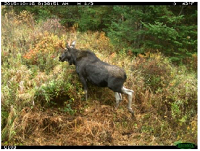
Reducing wildlife mortality on roads in Vermont: documenting wildlife movement near bridges and culverts to improve related conservation investments
2014 to 2016
Summary
This project gathered and analyzed game-camera data on the frequency of under-highway wildlife movement through bridges and culverts in Vermont.
Key Personnel & Institutions
People: Laura Farrell , Paul Marangelo
Institutions: University of Vermont , The Nature Conservancy
Location
VERMONT
Resource Type
Report
Tags
habitat connectivity, camera traps, bridge, culverts, permeability, wildlife movement
Topic Tags
methods, landscape pattern and connectivity
Purpose Tags
management
Citation
Marangelo, P. and Farrell, L. (2016). Reducing wildlife mortality on roads in Vermont: documenting wildlife movement near bridges and culverts to improve related conservation investments. The Nature Conservancy.
Source Link
http://roadsandwildlife.org/data/files/Documents/da14148d-2fb5-46f2-af70-7709603ef17b .pdf
Resilient sites for terrestrial conservation in the Northeast and Mid-Atlantic regions
2010 to 2011
Summary
The central idea of this project was that by mapping key geophysical settings and evaluating them for landscape characteristics that buffer against climate effects, the most resilient places in the landscape can be identified.
Key Personnel & Institutions
People: Mark Anderson, Arlene Olivero Sheldon, Melissa Clark
Institutions: The Nature Conservancy
Location
New York, New England
Resource Type
Report
Tags
climate change, conservation, diversity, habitat, natural communities, ecoregion, permeable landscape, resilience
Topic Tags
methods, management, wildlife and habitat, landscape pattern and connectivity
Purpose Tags
education
Citation
Anderson, M.G., Clark, M. and Olivero Sheldon, A. (2012). Resilient Sites for Terrestrial Conservation in the Northeast and Mid-Atlantic Region. The Nature Conservancy, Eastern Conservation Science. 168 pp.
Source Link
Roundtable on parcelization and forest fragmentation
2006 to 2007
Summary
The Roundtable on Parcelization and Forest Fragmentation was convened in August 2006 by Vermont Natural Resources Council in order to identify possible causes of and solutions to parcelization and forest fragmentation.
Key Personnel & Institutions
People: Jamey Fidel
Institutions: Vermont Natural Resources Council
Location
VERMONT
Resource Type
Report
Tags
forests, fragmentation, education, parcelization, stakeholders
Topic Tags
landscape pattern and connectivity
Purpose Tags
education
Citation
Fidel, J. (2007). Roundtable on Parcelization and Forest Fragmentation. Vermont Natural Resources Council. Available at https://fpr.vermont.gov/sites/fpr/files/Forest_and_Forestry/Vermont_Forests/Library/Forest-Roundtable-Report.pdf
Source Link
Securing permeable roadways for wide-ranging wildlife in the Black River Valley
2008 to 2012
Summary
The Black River Valley lies between the Tug Hill Plateau and the Adirondack Park -- the two largest core habitat blocks in the western part of the Northern Appalachian region -- and consists of 650,000 acres of forest. Mapping and modeling work by Two Countries, One Forest, The Nature Conservancy, and others identified the Black River Valley as a regionally important linkage.
Key Personnel & Institutions
People: Gustave Goodwin , Michelle Brown
Institutions: The Nature Conservancy , Staying Connected Initiative
Location
New York
Resource Type
Report
Tags
Black River Valley, core habitat, landscape connectivity
Topic Tags
conservation, landscape pattern and connectivity
Purpose Tags
conservation
Citation
Goodwin, G., Rinehart, K., Rafferty, A., Brown, M., Cheeseman, C. (2012). Securing permeable roadways for wide-rangingwildlife in the Black River Valley. The Nature Conservancy, Adirondack Chapter.
Source Link
Seeing the forest for the trees: reducing forest fragmentation in Vermont
2012 to 2013
Summary
This short article in Vermont Coverts outlines the concern and causes of forest fragmentation in Vermont.
Key Personnel & Institutions
Institutions: Vermont Natural Resources Council
Location
VERMONT
Resource Type
Report
Tags
climate change, recreation, landuse planning, current use, forest economy, forest fragmentation, parcelization
Topic Tags
conservation, management, ecosystem services, planning
Purpose Tags
conservation, education
Citation
Fidel, J. (2008). Seeing the forest for the trees: reducing forest fragmentation in Vermont. Vermont Coverts: Woodlands for Wildlife. Retrieved from http://vnrc.org/wp-content/uploads/2012/12/fragmentation_insert_final.pdf.
Source Link
https://mrvpd.org/wp-content/uploads/2018/08/fragmentation_insert_final.pdf
Staying connected in the northern Green Mountains: identifying structural pathways and other areas of high conservation priority
2008 to 2012
Summary
The authors identified critical areas of fine-scale wildlife connectivity, or structural pathways, within the Northern Green Mountains of Vermont, as well as the process used to refine the Northern Green Mountain landscape linkage boundary. In addition, parcels within the habitat blocks themselves were identified and ranked for importance in contributing to regional connectivity.
Key Personnel & Institutions
Not available.Location
GREEN MOUNTAIN RANGE
Resource Type
Report
Tags
conservation, road crossings, wildlife movement
Topic Tags
management, landscape pattern and connectivity
Purpose Tags
education
Citation
Hawk, R., Miller, C., Reining, C., and Gratton, L. (2012). Staying connected in the northern Green Mountains: identifying structural pathways and other areas of high conservation priority. The Staying Connected Initiative.
Source Link
http://216.92.98.160/assets/ngm_structural_pathways_and_parcels_29oct12_final.pdf
Synthesis: a place in between
2010 to 2011
Summary
This report is a synthesis intended to capture the nature and locations of land-focused organizations and their scope of work within the geographical area identified by the Staying Connected Initiative as the "Adirondacks - Southern Green Mountains Linkage", roughly comprising the Southern Lake Champlain Basin in Vermont and New York.
Key Personnel & Institutions
People: Monica Erhart, Leslie Karasin
Institutions: Lake Champlain Basin Program
Location
GREEN MOUNTAIN RANGE, New York
Resource Type
Report
Tags
outreach
Topic Tags
planning, landscape pattern and connectivity
Purpose Tags
education
Citation
Karasin, L. and Erhart, M. (2011). Synthesis: a place in between - Organizations working to maintain a healthy landscapbe between the Green Mountains and the Adirondacks. The Staying Connected Initative.
Source Link
http://stayingconnectedinitiative.org/assets/Synthesis_A_Place_In_Between.pdf
Terrestrial and wetland core-connector network, northeast U.S.
2016 to 2017
Summary
This mapping tool that identifies areas of core habitat that could be targeted for conservation.
Key Personnel & Institutions
People: Kevin McGargal
Institutions: DataBasin
Location
New York, New England
Resource Type
Report
Tags
conservation, parcelization, private land
Topic Tags
conservation
Purpose Tags
conservation
Citation
McGarigal, K. (2017). Terrestrial and Wetland Core-Connector Network, Northeast U.S. University of Massachusetts Amherst Landscape Ecology Lab. Retrieved from https://databasin.org/datasets/a045195633fc479ba71652b8b8c23a9b
Source Link
https://databasin.org/datasets/a045195633fc479ba71652b8b8c23a9b
The Berkshire wildlife linkage: connecting the Green Mts to Hudson Highlands for wildlife and people
2016 to 2017
Summary
The short report summaries the vision and key goals of the Staying Connected Intiative project that aims to protect the Berkshire wildlife linkage between the Green Mountains and the Hudson Highlands in New York.
Key Personnel & Institutions
Institutions: The Nature Conservancy , Staying Connected Initiative
Location
VERMONT, New York
Resource Type
Report
Tags
wildlife, fragmentation
Topic Tags
ecosystem services
Purpose Tags
education
Citation
Marx, L. (2017). The Berkshire wildlife linkage: connecting the Green Mts to Hudson Highlands for wildlife and people. The Staying Connected Intiative.
Source Link
http://stayingconnectedinitiative.org/assets/BWL_2pager_FINAL.pdf
The forests of Maine: 2003
2004 to 2005
Summary
The 2003 report of Maine's forest represent the first full set of annual inventory and growth data (FIA) since the end of the extreme spruce-budworm epidemic of the 1970's and 1980's.
Key Personnel & Institutions
People: William McWilliams
Institutions: United States Department of Agriculture (USDA), Forest Service, Northern Research Station
Location
Maine
Resource Type
Report
Tags
monitoring, analysis, forest composition, forest vitality, ingrowth, land management, sustainability, timber volume
Topic Tags
management
Purpose Tags
conservation, management, education
Citation
McWilliams, W.H., Butler, B.J., Caldwell, L.E., Griffith, D.M., Hoppus, M.L., Laustsen, K.M., Lister, A.J., Lister, T.W., Metzler, J.W., Morin, R.S., Sader, S.A., Stewart, L.B., Steinman, J.R., Westfall, J.A., Williams, D.A., Whitman, A., Woodall, C.W. (2005). The forests of Maine: 2003. Resour. Bull. NE-164. Newtown Square, PA: U.S. Department of Agriculture, Forest Service, Northeastern Research Station. 188 p.
Source Link
Vermont's Wildlife Action Plan 2015
2014 to 2015
Summary
According to Congressional mandate, Wildlife Action Plans must be updated at least every 10 years. This report represents the first revision of Vermont's Wildlife Action Plan, originally created in 2005.
Key Personnel & Institutions
Institutions: Vermont Fish and Wildlife Department
Location
VERMONT
Resource Type
Report
Tags
conservation, wildlife, management
Topic Tags
conservation, management, ecosystem services
Purpose Tags
conservation, management, education
Citation
Vermont Wildlife Action Plan Team. (2015). Vermont Wildlife Action Plan 2015. Vermont Fish and Wildlife Department. Montpelier, VT. http://www.vtfishandwildlife.com
Source Link
https://vtfishandwildlife.com/about-us/budget-and-planning/wildlife-action-plan
Wildlands and woodlands: A vision for the forests of Massachusetts
2017 to 2018
Summary
The authors propose a forest conservation strategy that extends a simple design from conservation biology in important new ways. This approach consists of large forest reserves in which natural processes dominate and human impact is minimized (Wildlands), embedded within expansive forestland that is protected from development but is actively managed in an ecologically sustainable manner (Woodlands).
Key Personnel & Institutions
People: David Foster
Institutions: Harvard University, Harvard Forest , Harvard University , Smithsonian Conservation Biology Institute
Location
Massachusetts
Resource Type
Report
Tags
conservation, land use, forests, fragmentation, development, advocacy, education
Topic Tags
conservation, management, ecosystem services
Purpose Tags
conservation, management, education
Citation
Foster, D. R., Kittredge, D., Donahue, B., Motzkin, G., Orwig, D., Ellison, A. & D'Amato, A. (2005). Wildlands and woodlands: a vision for the forests of Massachusetts. Petersham, MA: Harvard Forest.
Source Link
http://wildlandsandwoodlands.org/sites/default/files/Wildlands%20%26%20Woodlands%20Massachusetts.pdf
Wildlife connectivity in western Massachusetts: Results and recommendations from a 2013-14 study of wildlife movement in two corridors
2012 to 2013
Summary
Using winter tracking of mammal species, motion-triggered wildlife cameras, and surveys of roadkill, the authors studied where animals are able to move across the roads within the Berkshire Wildlife Linkage. This report details suggestions for landowners and groups interested in wildlfie movement on how to maintain connectivity across their landscapes.
Key Personnel & Institutions
People: Jessica Applin
Institutions: The Nature Conservancy
Location
Massachusetts
Resource Type
Report
Tags
conservation, wildlife, landuse planning, connectivity
Topic Tags
ecosystem services
Purpose Tags
conservation, management, education
Citation
Applin, J. & L. Marx. (2014). Wildlife connectivity in western Massachusetts: Results and recommendations from a 2013-14 study of wildlife movement in two corridors. The Nature Conservancy. Retrieved from https://www.nature.org/media/massachusetts/wildlife-connectivity-study-final.pdf.
Source Link
https://www.nature.org/media/massachusetts/wildlife-connectivity-study-final.pdf
Wildlife Road Watch: Citizen Scientist Observations
2009 to 2013
Summary
Maine Audubon Wildlife Road Watch is a citizen science project developed in partnership with Maine Department of Inland Fisheries and Wildlife, Maine Department of Transportation, and University of California, Davis Road Ecology Center, in which Volunteers record their observations of wildlife crossings
Key Personnel & Institutions
People: Barbara Charry
Institutions: Maine Audubon Society
Location
Maine
Resource Type
Report
Tags
conservation, citizen science, transportation management, wildlife crossings, wildlife movement
Topic Tags
ecosystem services
Purpose Tags
conservation, management
Citation
Charry, B. (2015). Wildlife Road Watch, Citizen Scientist Observations 2010-2014. Maine Audubon Society. Retrieved from http://stayingconnectedinitiative.org/assets/WRW-Report-2015-Final.pdf
Source Link
http://stayingconnectedinitiative.org/assets/WRW-Report-2015-Final.pdf
Forest fragmentation in Connecticut: what do we know and where are we headed?
2005 to 2006
Summary
This paper follows Connecticuts Forest Forum with a goal of creating a dialogue in order to effectively summarize the status and condition of Connecticut's forest
Key Personnel & Institutions
People: James Hurd
Institutions: United States Department of Agriculture (USDA), Forest Service, Northern Research Station , University of Connecticut, Yale University
Location
Connecticut
Resource Type
Report
Tags
awareness, education, forest fragmentation, parcelization, parcels, urban forests
Topic Tags
landscape pattern and connectivity
Purpose Tags
education
Citation
Hurd, J., Parent, J., Civco, D., Tyrrell, M., and Butler, B. (2006). Forest Fragmentation in Connecticut - What Do We Know and Where are We Headed? Retrieved from https://www.ctwoodlands.org/sites/default/files/CFPA Research Note 6 Forest Frag Oct 06_0.pdf.
Source Link
Threats to species of greatest conservation need and their habitats in New York State
2005 to 2006
Summary
This report references data from the The Comprehensive Wildlife Conservation Strategy (CWCS) planning database toidentify the threats to species of greatest conservation need in New York State.
Key Personnel & Institutions
People: Lisa Holst
Institutions: United States Department of Agriculture (USDA), Forest Service, Northern Research Station , New York Department of Agriculture and Markets
Location
New York
Resource Type
Report
Tags
conservation, awareness, frequency tracking, habitat loss, habitat threats, impact scaling, threats
Topic Tags
conservation, drivers
Purpose Tags
management, education
Citation
Holst, L. K., Schiavone, M., & Tomajer, T. (2005). Threats to Species of Greatest Conservation Need and their Habitats in New York State. In Comprehensive Widllife Conservation Strategy for New York. New York State Department of Environmental Conservation. p. 57-69.
Source Link
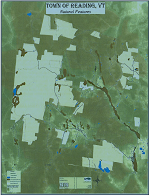
Town of Reading forest fragmentation project
2006 to 2008
Summary
This report was prepared for the Town of Reading, VT, to understand and mitigate forest fragmentation.
Key Personnel & Institutions
People: Jamey Fidel
Institutions: Vermont Natural Resources Council
Location
VERMONT
Resource Type
Report
Tags
forest fragmentation, forest planning, forest preservation, outreach, parcelization
Topic Tags
management, planning, drivers, landscape pattern and connectivity
Purpose Tags
conservation, management
Citation
Fidel, J. & Shupe, B. (2008). Town of Reading Forest Fragmentation Project. Vermont Natural Resources Council.
Source Link
http://swcrpc.org/wp-content/uploads/2013/11/Forest-Fragmentation-Project-2008-Reduced.pdf
Vermont habitat blocks and habitat connectivity: an analysis using Geographic Information Systems
2013 to 2014
Summary
This project is a directly related to Vermont's Wildlife Action Plan (2005) priority conservation goals. Using GIS analysis, the authors identified potential habitat blocks, wildlife corridors, and road crossings.
Key Personnel & Institutions
People: Eric Sorenson
Institutions: Vermont Fish & Wildlife Dept.
Location
VERMONT
Resource Type
Report
Tags
habitat connectivity, fragmentation mitigation, wildlife conservation
Topic Tags
landscape pattern and connectivity
Purpose Tags
conservation, education
Citation
Sorenson, E. & Osborne, J. (2014). Vermont habitat blocks and habitat connectivity: an analysis using Geographic Information Systems. Vermont Fish and Wildlife Department.
Source Link
Vermont Transportation & Habitat Connectivity Guidance Document
2011 to 2012
Summary
The information contained in this guidance document will inform transportation planning,
Key Personnel & Institutions
People: Laura Farrell
Institutions: Vermont Agency of Transportation, VTrans
Location
VERMONT
Resource Type
Report
Tags
monitoring, road crossings, transportation management, wildlife crossing structures, wildlife crossings, wildlife movement
Topic Tags
methods, management, landscape pattern and connectivity
Purpose Tags
management
Citation
Shilling, F., Cramer, P., Farrell, L., & Reining, C. (2012). Vermont transportation and habitat connectivity guidance document. Vermont Agency of Transportation.
Source Link
http://216.92.98.160/assets/vtrans_transport_habitat_connectivity_guidance_final_dec2012.pdf
Vermont's Wildlife Action Plan 2005
2004 to 2005
Summary
This report outlines the goals and purpose of Vermont's Wildlife Grants program and the Wildlife Action Plan, which were created to prevent wildlife from becoming endangered through early, strategic efforts to conserve wildlife and habitat.
Key Personnel & Institutions
People: Jon Kart
Institutions: Vermont Fish and Wildlife Department
Location
VERMONT
Resource Type
Report
Tags
conservation, wildlife, management
Topic Tags
conservation, management, ecosystem services
Purpose Tags
conservation, management, education
Citation
Kart, J., Regan, R., Darling, S.R., Alexander, C., Cox, K.,Ferguson, M., Parren, S., Royar, K. & Popp, B.(Eds). (2005). Vermont's Wildlife Action Plan. Waterbury, VT: Vermont Fish and Wildlife Department.
Source Link
Berkshire Natural Resources Council
2015 to 2016
Summary
This website provides information about the Berkshires Natural Resources Council.
Key Personnel & Institutions
Institutions: Berkshire Natural Resources Council
Location
PLAINFIELD
Resource Type
Website
Tags
conservation
Topic Tags
conservation, management
Purpose Tags
conservation
Citation
Berkshire Natural Resources Council. (2016). Available athttps://www.bnrc.org/
Source Link
Cold Hollow to Canada
Summary
This website provides information about Cold Hollow to Canada, which aims to provide a healthy and intact forested landscape that supports a strong and sustainable local economy through stewardship, with protection of core wildlife habitat and connectivity across the entire Northern Forest.
Key Personnel & Institutions
Institutions: Cold Hollow to Canada
Location
ENOSBURG, WESTFIELD, BAKERSFIELD, BELVIDERE, WATERVILLE, FLETCHER, MONTGOMERY, Richford
Resource Type
Website
Tags
conservation, northern forest, wildlife, forestland conservation, northeast, forest conservation, wildlife movement
Topic Tags
conservation, management, wildlife and habitat
Purpose Tags
conservation, education
Citation
Cold Hollow to Canada. (n.d.). Available at https://www.coldhollowtocanada.org/
Source Link
Forest Fragmentation Risk
2009 to 2010
Summary
This is a map layer uploaded by the Conservation Biology Institute showing an assessment of forest fragmentation within North America.
Key Personnel & Institutions
People: Kurt Riitters
Institutions: DataBasin
Location
New York, New England
Resource Type
Website
Tags
biodiversity, forest, biotic diversity, landcover, landscape, risk assesment
Topic Tags
landscape pattern and connectivity
Purpose Tags
education
Citation
Riitters, K. (2010). Forest Fragmentation Risk, Contiguous US. Conservation Biology Institute. Available at https://databasin.org/datasets/d4beb63317b84d3a998fd630aa21bb55
Source Link
https://databasin.org/datasets/d4beb63317b84d3a998fd630aa21bb55
Forest Reserve District-Bennington
2012 to 2013
Summary
In this blog post the VNRC provide information about the Bennington Forest Reserve District adopted by the town in the 1990s.
Key Personnel & Institutions
Institutions: Vermont Natural Resources Council
Location
BENNINGTON
Resource Type
Website
Tags
conservation, advocacy, education, sustainability
Topic Tags
conservation, planning
Purpose Tags
education
Citation
Vermont Natural Resources Council. (2013). Forest Reserve District-Bennington. Available at http://vnrc.org/resources/community-planning-toolbox/case-studies/forest-reserve-district-bennington/
Source Link
https://vnrc.org/community-planning-toolbox/case-studies/forest-reserve-district-bennington/
The forests of southern New England, 2007
2006 to 2007
Summary
This report summarizes the results of the fifth forest inventory of the forests of Southern New England (Connecticut, Massachusetts, and Rhode Island) conducted by the U.S. Forest Service, Forest Inventory and Analysis program.
Key Personnel & Institutions
People: Brett Butler
Institutions: United States Department of Agriculture (USDA), Forest Service, Northern Research Station , United States Department of Agriculture (USDA)
Location
Massachusetts, Connecticut, Rhode Island
Resource Type
Report
Tags
monitoring, forest inventory, forest service, fia, forest resources, long-term data
Topic Tags
management
Purpose Tags
conservation, management, education
Citation
Butler, B. J., Barnett, C. J., Crocker, S. J., Domke, G. M., Gormanson, D., Hill, W. N., Woodall, C. W. (2011). The Forests of Southern New England, 2007: A report on the forest resources of Connecticut, Massachusetts, and Rhode Island (No. NRS-RB-55). Newtown Square, PA: U.S. Department of Agriculture, Forest Service, Northern Research Station.56 p. https://doi.org/10.2737/NRS-RB-55
Source Link
The state of the forest and recommendations for forest substainability standards
1998 to 1999
Summary
This report includes a summary of forest management issues that the Maine Forest Service identifies as important public policy issues
Key Personnel & Institutions
People: John Nutting
Institutions: Maine Forest Service
Location
Maine
Resource Type
Report
Tags
conservation, management, forest service, forest resources, legislation, policy, protection, sustainability
Topic Tags
conservation, management
Purpose Tags
management, education, policy
Citation
Maine Forest Service Department of Conservation. (1999). The State of the Forest and Recommendations for Forest Substainability Standards - Final Report to the Joint Standing Committee of the 119th Legislature on Agriculture, Conservation and Forestry. Augusta, Maine. 41 p.
Source Link
http://www.maine.gov/DACF/mfs/about/state_assessment/downloads/sofjun12.PDF
Massachusetts Department of Fish & Game
Summary
This website provides information about the Massachusetts Department of Fish and Game.
Key Personnel & Institutions
Institutions: Massachusetts Department of Fish and Game
Location
Massachusetts
Resource Type
Website
Tags
conservation, wildlife conservation
Topic Tags
conservation, management, wildlife and habitat
Purpose Tags
conservation, management, education
Citation
Massachusetts Department of Fish and Game. (n.d.). Available at https://www.mass.gov/orgs/department-of-fish-and-game
Source Link
Massachusetts Forest Stewardship Program
Summary
Recognizing the public benefits of good stewardship on private forest land, the Massachusetts Forest Stewardship Program provides support, information, and resources to private forest landowners in their efforts to manage their land. This educational non-regulatory program is designed to help landowners protect the inherent ecosystem values of their forest.
Key Personnel & Institutions
Institutions: Massachusetts Department of Conservation and Recreation
Location
Massachusetts
Resource Type
Website
Tags
forest management, family forest, forestry, private forests
Topic Tags
management, ecosystem services
Purpose Tags
management, education
Citation
Massachusetts Forest Stewardship Program. (n.d.). Available at https://www.mass.gov/service-details/forest-stewardship-program.
Source Link
https://www.mass.gov/service-details/forest-stewardship-program
Massachusetts Land Trust Coalition
Summary
This website provides information about the Massachusetts Land Trust Coalition.
Key Personnel & Institutions
Institutions: Massachusetts Land Trust Coalition
Location
Massachusetts
Resource Type
Website
Tags
communities, conservation, education, policy
Topic Tags
conservation
Purpose Tags
conservation
Citation
MassLand: Massachusetts Land Trust Coalition. (n.d.). Available at http://massland.org/.
Source Link
Natural Resource Plan for Waitsfield, Vermont
2004 to 2005
Summary
Overview of the Waitsfield, Vermont Town Plan (2005) provided by Vermont Natural Resources Council (VNRC). In the plan, VNRC identifies key wildlife habitat and corridors with the goal of producing updated wildlife habitat policies.
Key Personnel & Institutions
Institutions: Vermont Natural Resources Council
Location
VERMONT
Resource Type
Website
Tags
conservation, forestland conservation, natural resource protection, tool
Topic Tags
conservation, methods, management, planning
Purpose Tags
policy
Citation
Vermont Natural Resources Council. (2005). Natural Resource Plan-Waitsfield. Available at http://vnrc.org/resources/community-planning-toolbox/case-studies/natural-resource-plan-waitsfield/
Source Link
https://vnrc.org/community-planning-toolbox/case-studies/natural-resource-plan-waitsfield/
Vermont Natural Resources Board
Summary
The new website for the Natural Resources Board of Vermont.
Key Personnel & Institutions
Institutions: Vermont Natural Resources Board
Location
VERMONT
Resource Type
Website
Tags
conservation, development, environmental policy, policy, regulation
Topic Tags
conservation, planning
Purpose Tags
management, policy
Citation
Vermont Natural Resources Board. (n.d.). Available at http://nrb.vermont.gov/.
Source Link
Franklin Land Trust
Summary
This website provides information about the Franklin Land Trust.
Key Personnel & Institutions
Institutions: Franklin Land Trust
Location
FRANKLIN
Resource Type
Website
Tags
agriculture, conservation, forestland conservation, protection
Topic Tags
conservation, landscape pattern and connectivity
Purpose Tags
conservation
Citation
Franklin Land Trust. (n.d.). Farm, Field and Forest Conservation. Available at http://www.franklinlandtrust.org/
Source Link
Future Human Footprint
2012 to 2013
Summary
A gallary of map layers about the future projection of the human footprint within North America.
Key Personnel & Institutions
Institutions: Two Countries One Forest
Location
New York, New England
Resource Type
Website
Tags
disturbance patterns, human disturbance, disturbance, human footprint, human impacts
Topic Tags
conservation, drivers, landscape pattern and connectivity
Purpose Tags
education
Citation
Two Countries One Forest. (2013). Future Human Footprint. Available at https://2c1forest.databasin.org/galleries/f76fc910963340849b23373c5804e6c5#expand=56636
Source Link
https://2c1forest.databasin.org/galleries/f76fc910963340849b23373c5804e6c5#expand=56636
Greensboro Land Trust
Summary
This website provides information about the Greensboro Land Trust (GLT).
Key Personnel & Institutions
Institutions: Greensboro Land Trust
Location
GREENSBORO
Resource Type
Website
Tags
conservation, forestland conservation
Topic Tags
conservation
Purpose Tags
conservation
Citation
The Greensboro Land Trust. (n.d.). Available at http://www.greensborolandtrust.org/.
Source Link
Hilltown Land Trust
Summary
This website provides information about the Hilltown Land Trust. The Hilltown Land Trust protects land and promotes ecological diversity and health, respectful land stewardship, historic character, and natural beauty in our hilltowns.
Key Personnel & Institutions
Institutions: Hilltown Land Trust
Location
ASHFIELD
Resource Type
Website
Tags
agriculture, conservation, forestland conservation
Topic Tags
conservation
Purpose Tags
conservation
Citation
Hilltown Land Trust. (n.d.). Available at https://www.hilltown-land-trust.org/.
Source Link
Landscape Fragmentation Tool
1984 to 2002
Summary
The Landscape Fragmentation Tool (LFT), jointly developed through a partnership between CLEAR and Placeways LLC, provides a method to quantify landscape fragmentation.
Key Personnel & Institutions
Institutions: University of Connecticut, CAHNR
Location
No location information available
Resource Type
Website
Tags
geographic information systems, analytical tools, GIS, landcover, tool, web tool
Topic Tags
landscape pattern and connectivity
Purpose Tags
education
Citation
Hurd, J. D. (n.d.). UConn CLEAR. Landscape Fragmentation Tool 2. Available at http://clear.uconn.edu/tools/lft/lft2/index.htm
Source Link
The State of the Forests
Summary
This report discusses the problem of fragmentation of the forest, which negatively impacts biodiversity. Also discussed is the lack of old growth forest and late successional forests which limits biodiversity of all species, and thereby reduces the level of ecosystem services provided.
Key Personnel & Institutions
Not available.Location
Maine
Resource Type
Report
Tags
biodiversity, forestland conservation, education, land conservation
Topic Tags
conservation, management, drivers
Purpose Tags
education
Citation
The Maine Mountain Conservancy. (2013). State of the Forests. Available at http://mainemountainconservancy.org/state-of-the-forests.html
Source Link
http://mainemountainconservancy.org/state-of-the-forests.html
Mass Woods
Summary
This website provides information about MassWoods created by UMass Amherst.
Key Personnel & Institutions
Institutions: UMass Amherst Department of Natural Resources Conservation
Location
AMHERST
Resource Type
Website
Tags
conservation, forestland conservation, private land, web tool
Topic Tags
conservation, methods
Purpose Tags
management, education
Citation
University of Amherst. (n.d.). MassWoods. Available at http://masswoods.org/
Source Link
Massachusetts Audubon
Summary
Mass Audubon protects 38,000 acres of land throughout Massachusetts, saving birds and other wildlife, and making nature accessible to all. As Massachusetts’ largest nature conservation nonprofit, more than half million visitors a year to our wildlife sanctuaries and 20 nature centers.
Key Personnel & Institutions
Institutions: Massachusetts Audubon
Location
Massachusetts
Resource Type
Website
Tags
conservation, wildlife, advocacy, education, wildlife conservation
Topic Tags
conservation, management, ecosystem services, wildlife and habitat
Purpose Tags
conservation, management, education
Citation
Mass Audubon. (n.d.). Available at https://www.massaudubon.org
Source Link
Massachusetts Department of Agricultural Resources
Summary
This website provides information about Massachusetts Department of Agricultural Resources, which aims to keep the Massachusetts’ food supply safe and secure, and to work to keep Massachusetts agriculture economically and environmentally sound.
Key Personnel & Institutions
Institutions: Massachusetts Department of Agricultural Resources
Location
Massachusetts
Resource Type
Website
Tags
agriculture, conservation, agricultural development
Topic Tags
conservation, methods, management
Purpose Tags
management, education
Citation
Massachusetts Department of Agricultural Resources. (n.d.). Available at https://www.mass.gov/orgs/massachusetts-department-of-agricultural-resources.
Source Link
Massachusetts Department of Conservation and Recreation
Summary
This website provides information about the Massachusetts Department of Conservation and Recreation.
Key Personnel & Institutions
Institutions: Massachusetts Department of Conservation and Recreation
Location
Massachusetts
Resource Type
Website
Tags
conservation, natural resource protection, natural resources, recreational land
Topic Tags
conservation, management
Purpose Tags
conservation, management, education
Citation
Massachusetts Department of Conservation & Recreation. (n.d.). Retrieved from https://www.mass.gov/orgs/department-of-conservation-recreation.
Source Link
Natural Resources Conservation Service
Summary
This website provides information about the Natural Resource Conservation Service (NRCS), which provides America's farmers and ranchers with financial and technical assistance to for conservation projects.
Key Personnel & Institutions
Institutions: United States Department of Agriculture (USDA), Natural Resources Conservation Service
Location
VERMONT
Resource Type
Website
Tags
agriculture, conservation, forestland conservation, tool
Topic Tags
conservation, planning
Purpose Tags
education
Citation
USDA Natural Resources Conservation Service. (2018). Available at https://www.nrcs.usda.gov/wps/portal/nrcs/site/national/home/
Source Link
New England Forestry Foundation
Summary
This website provides information about the New England Forestry Foundation.
Key Personnel & Institutions
Institutions: New England Forestry Foundation
Location
New England
Resource Type
Website
Tags
communities, education, new england forests, stewardship, wildlife conservation
Topic Tags
conservation, management, planning, wildlife and habitat
Purpose Tags
education
Citation
New England Forestry Foundation. (n.d.). Available at https://newenglandforestry.org/
Source Link
Northern Rivers Land Trust
Summary
This website provides information about the Northern Rivers Land Trust.
Key Personnel & Institutions
Institutions: Northern Rivers Land Trust
Location
HARDWICK
Resource Type
Website
Tags
agriculture, conservation, forestland conservation, conservation easements, wildlife conservation
Topic Tags
conservation, management, planning, wildlife and habitat
Purpose Tags
conservation, management
Citation
Northern Rivers Land Trust. (n.d.). Available at http://www.northernriverslandtrust.org/
Source Link
Notheast Wilderness Trust
Summary
The need to permanently protect wild lands and waters has never been greater. The Northeast Wilderness Trust is meeting this challenge, working with private landowners and other partners to save wildlife habitat from the Adirondacks to Maine.
Key Personnel & Institutions
Institutions: Northeast Wilderness Trust
Location
MONTPELIER
Resource Type
Website
Tags
conservation, northeastern forests
Topic Tags
conservation, wildlife and habitat
Purpose Tags
conservation
Citation
Northeast Wilderness Trust. (n.d.). Available athttp://www.newildernesstrust.org/
Source Link
Passumpsic Valley Land Trust
Summary
This website provides information about the Passumsic Valley Land Trust (PVLT).
Key Personnel & Institutions
Not available.Location
ST. JOHNSBURY
Resource Type
Website
Tags
conservation, forestland conservation, wildlife habitat
Topic Tags
conservation, management, wildlife and habitat
Purpose Tags
conservation, education
Citation
Passumpsic Valley Land Trust. (n.d.). Retrieved from https://pvlt.org/
Source Link
Vermont Regional Planning Commissions
Summary
This website provides information about the Vermont Association of Planning and Development Agencies.
Key Personnel & Institutions
Institutions: Vermont Association of Planning and Development Agencies
Location
BRATTLEBORO
Resource Type
Website
Tags
conservation, development, forest economy
Topic Tags
conservation, planning
Purpose Tags
education, policy
Citation
Vermont Association of Planning & Development Agencies. (2018). Available at https://www.vapda.org/
Source Link
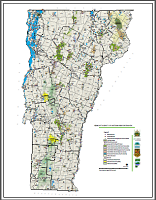
Vermont Agency of Natural Resource lands
2013 to 2014
Summary
Map showing privately owned and publically owned land in VT
Key Personnel & Institutions
Institutions: Vermont Agency of Natural Resources
Location
VERMONT
Resource Type
Map
Tags
forest, land ownership, public lands, state-owned forests
Topic Tags
landscape pattern and connectivity
Purpose Tags
management, education
Citation
Vermont Agency of Natural Resources. (2014). Vermont Agency of Natural Resources Land [map]. Retrieved from http://fpr.vermont.gov/sites/fpr/files/State_Lands_Administration/Land_Records/Library/ANR Lands.pdf
Source Link
http://fpr.vermont.gov/sites/fpr/files/State_Lands_Administration/Land_Records/Library/ANR Lands.pdf
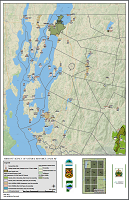
Vermont Agency of Natural Resource lands detail maps
2013 to 2014
Summary
Map showing Agency of Natural Resource owned and other public lands in VT
Key Personnel & Institutions
Institutions: Vermont Agency of Natural Resources
Location
VERMONT
Resource Type
Map
Tags
natural resources, public lands, state-owned forests
Topic Tags
conservation, landscape pattern and connectivity
Purpose Tags
education
Citation
Vermont Agency of Natural Resources. (2014). Vermont Agency of Natural Resource lands detail maps [map]. Retrieved from http://fpr.vermont.gov/sites/fpr/files/State_Lands_Administration/Land_Records/Library/mapbook_natgeo.pdf
Source Link
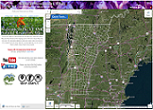
VT ANR Natural Resources Atlas
2017 to 2018
Summary
Atlas with 150 layers ranging from conserved lands to hazmat generators to watersheds to culverts
Key Personnel & Institutions
Institutions: Vermont Agency of Natural Resources
Location
VERMONT
Resource Type
Map
Tags
boundaries, built environment, natural resources
Topic Tags
landscape pattern and connectivity
Purpose Tags
management, education
Citation
Vermont Agency of Natural Resources. (2018). Vermont Natural Resources Atlas [map]. Retrieved from http://anrmaps.vermont.gov/websites/anra5/
Source Link
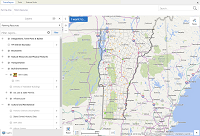
VT Planning Atlas
2017 to 2018
Summary
This web-based, interactive atlas is designed to be used by planners, developers, historic preservationists and conservationists within Vermont.
Key Personnel & Institutions
Institutions: Vermont Agency of Commerce and Community Development, ACCD
Location
VERMONT
Resource Type
Map
Tags
planning, smart growth
Topic Tags
landscape pattern and connectivity
Purpose Tags
management, education
Citation
Vermont Department of Housing and Community Development. (2018). Planning Atlas [map]. Retrieved from http://maps.vermont.gov/ACCD/PlanningAtlas/index.html?viewer=PlanningAtlas
Source Link
http://maps.vermont.gov/ACCD/PlanningAtlas/index.html?viewer=PlanningAtlas
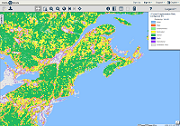
Forest fragmentation risk in the contiguous US
2001 to 2002
Summary
This map layer is an excerpt from a global assessment of forest fragmentation (Riitters et al., 2000) where each pixel value represents an index of forest fragmentation for the surrounding 81 sq. km.
Key Personnel & Institutions
People: James Wickham , Kurt Riitters
Institutions: Data Basin
Location
New York, New England
Resource Type
Map
Tags
forest fragmentation, risk assesment
Topic Tags
drivers, landscape pattern and connectivity
Purpose Tags
management
Citation
Riitters, K., Wickham, J., O'Neill, R., Jones, B. & Smith, E. (2000). Forest fragmentation risk in the contiguous US. Available at https://databasin.org/maps/new#datasets=d4beb63317b84d3a998fd630aa21bb55
Source Link
https://databasin.org/maps/new#datasets=d4beb63317b84d3a998fd630aa21bb55
Fragmentation and clearing of Maine forest habitats
2004 to 2005
Summary
This map was displays the extent of fragmentation in Maine's forests.
Key Personnel & Institutions
People: Lindsay Dreiss
Institutions: Middlebury College
Location
Maine
Resource Type
Map
Tags
fragmentation, maine, map, developed and agricultural lands, forest cover, harvested forest, human fragmentation, roadways
Topic Tags
drivers, landscape pattern and connectivity
Purpose Tags
education
Citation
Dreiss, L.M. (2008). Fragmentation and Clearing of Maine Forest Habitats, 2005 [map]. Retreived from https://www.researchgate.net/profile/Lindsay_Dreiss/publication/254600864_Fragmentation_and_Clearing_of_Maine_Forest_Habitats_2005/links/543ffa7c0cf2be1758cff522/Fragmentation-and-Clearing-of-Maine-Forest-Habitats-2005.pdf
Source Link
C-CAP (Coastal Change Analysis Program) land cover atlas
1995 to 2010
Summary
This interactive web map depicts landcover changes in coastal regions of the US over various timesteps.
Key Personnel & Institutions
Institutions: National Oceanographic and Atmospheric Administration (NOAA)
Location
New York, New England
Resource Type
Map
Tags
growth, fragmentation, forest cover, forest loss, landcover
Topic Tags
landscape pattern and connectivity
Purpose Tags
management, education
Citation
National Oceanic and Atmospheric Administration. (2017). C-CAP Land Cover Atlas [map]. Available at https://coast.noaa.gov/ccapatlas/
Source Link
Vermont Town Parcelization Data 2003 to 2009
2002 to 2010
Summary
This datasets provides summary statistics on town parcelization statistics and trends for all towns in Vermont.
Key Personnel & Institutions
Institutions: Northeastern States Research Cooperative , Vermont Natural Resources Council
Location
VERMONT
Resource Type
Dataset
Tags
resource management, fragmentation, forest planning, forest stewardship, parcelization, policy, wildlife conservation
Topic Tags
management, landscape pattern and connectivity
Purpose Tags
conservation, management, education, policy
Citation
Vermont Natural Resources Council. (2010). Informing Land Use Planning and Forestland Conservation Through Subdividision and Parcelization Trend Information Dataset. Available at http://www.vnrc.org/subdivisionreport/
Source Link
National Land Cover Database
1991 to 2011
Summary
The National Land Cover database for the United states contains spatially-explicit raster images of land cover types for 1992, 2001, 2006 and 2011.
Key Personnel & Institutions
Institutions: United States Geological Survey (USGS)
Location
New York, New England
Resource Type
Dataset
Tags
modeling, fragmentation, land use change
Topic Tags
management
Purpose Tags
education
Citation
Varies by dataset, see site.
Source Link
A global analysis of traits predicting species sensitivity to habitat fragmentation
2007 to 2018
Summary
The authors used generalized linear mixed-effect models in an information theoretic framework to assess the factors that explained species presence in remnant habitat patches. They found that the size of remnant habitat patches was the most important driver of species presence indicating that habitat relationships were more important than life history characteristics in predicting the effects of fragmentation.
Key Personnel & Institutions
People: Douglas Keinath, Daniel Doak, Karen Hodges
Institutions: University of Colorado , US Fish and Wildlife Service , The University of British Columbia, Department of Biology
Location
New York, New England
Resource Type
Article
Tags
birds, vertebrates, fragmentation, patch size
Topic Tags
drivers, wildlife and habitat
Purpose Tags
education
Citation
Keinath, D.A., Doak, D.F., Hodges, K.E., Prugh, L.R., Fagan, W., Sekercioglu, C.H., Buchart, S.H. and Kauffman, M. (2017). A global analysis of traits predicting species sensitivity to habitat fragmentation. Global Ecology and Biogeography, 26(1), pp.115-127.
Source Link
Creation of forest edges has a global impact on forest vertebrates
2016 to 2017
Summary
The authors assembled a global dataset on species responses to fragmentation and developed a statistical approach for quantifying edge impacts in heterogeneous landscapes to quantify edge-determined changes in abundance of 1,673 vertebrate species. They show that the abundances of 85% of species are affected, either positively or negatively, by forest edges.
Key Personnel & Institutions
People: Marion Pfeifer
Institutions: Newcastle University , Imperial College London , Flowminder Foundation
Location
New York, New England
Resource Type
Article
Tags
biodiversity, vertebrates, edge effects
Topic Tags
wildlife and habitat
Purpose Tags
education
Citation
Pfeifer, M., Lefebvre, V., Peres, C.A., Banks-Leite, C., Wearn, O.R., Marsh, C.J., Butchart, S.H.M., Arroyo-Rodriguez, V., Barlow, J., Cerezo, A. and Cisneros, L. (2017). Creation of forest edges has a global impact on forest vertebrates. Nature, 551(7679), p.187.
Source Link
Landscape correlates of forest plant invasions: A high-resolution analysis across the eastern United States
2000 to 2017
Summary
Using invasive plant data from 23,039 forest inventory plots in 13 ecological provinces, the authors employed logistic regression to relate the odds of invasion to distance from a road, with adjustments for broadscale differences attributable to ecological provinces, and local scale differences in productivity, forest fragmentation and land use. The results indicated the best predictor of the odds of invasion was ecological province, followed by land use, productivity, forest fragmentation and distance from a road, and the authors conclude that in the eastern United States, the existence of a nearby road is less important than the landscape context associated with the road.
Key Personnel & Institutions
People: Kurt Riiters , Kevin Potter
Institutions: United States Department of Agriculture (USDA), Forest Service, Southern Research Station , North Carolina State University, Department of Forestry and Environmental Resources , University of Florida, School of Forest Resources and Conservation
Location
New York, New England
Resource Type
Article
Tags
agriculture, roads, fragmentation, invasives
Topic Tags
management, landscape pattern and connectivity
Purpose Tags
education
Citation
Riitters, K., Potter, K., Iannone III, B.V., Oswalt, C., Fei, S. and Guo, Q. (2018). Landscape correlates of forest plant invasions: A high-resolution analysis across the eastern United States. Diversity and Distributions, 24(3), pp.274-284.
Source Link
Piecing together the fragments: elucidating edge effects on forest carbon dynamics
2002 to 2018
Summary
This review paper explores differences in carbon dynamics observed across biomes through a trade?offs framework that considers edge microenvironmental changes and limiting factors to productivity. The review concludes that in the mesic northeastern US, large increases in carbon stocks and productivity are found near the temperate forest edge, with over 23% of the forest area within 30 m of an edge. Changes in the wind, fire, and moisture regimes near tropical forest edges result in decreases in carbon stocks and productivity.
Key Personnel & Institutions
People: Andrew Reinmann , Jonathan Thompson , Lucy Hutyra , Ian Smith , Julia Marrs
Institutions: Boston University , Harvard University
Location
New York, New England
Resource Type
Article
Tags
stand structure, biodiversity, microclimate, carbon sequestration, edge effects
Topic Tags
ecosystem services, landscape pattern and connectivity
Purpose Tags
education
Citation
Smith, I.A., Hutyra, L.R., Reinmann, A.B., Marrs, J.K. and Thompson, J.R. (2018). Piecing together the fragments: elucidating edge effects on forest carbon dynamics. Frontiers in Ecology and the Environment, 16(4), pp.213-221.
Source Link
Effects of land use legacies and habitat fragmentation on salamander abundance
2012 to 2018
Summary
The authors examined how a history of agricultural land use and current forest fragmentation influence the abundance of red-backed salamanders (Plethodon cinereus). The results suggest that historical agriculture affected salamander abundance by altering forest vegetation at a local scale and forest cover at a landscape scale.
Key Personnel & Institutions
People: Bradley Cosentino, Kristen Brubaker
Institutions: Hobart and William Smith Colleges
Location
Hector
Resource Type
Article
Tags
agriculture, habitat, salamanders, fragmentation, landscape modification
Topic Tags
wildlife and habitat
Purpose Tags
education
Citation
Cosentino, B.J. and Brubaker, K.M. (2018). Effects of land use legacies and habitat fragmentation on salamander abundance. Landscape Ecology, 33(9), pp.1573-1584.
Source Link
Is habitat fragmentation good for biodiversity?
2017 to 2018
Summary
Based on a review of landscape-scale investigations, Fahrig (2017; Ecological responses to habitat fragmentation per se. Annual Review of Ecology, Evolution, and Systematics 48:1-23) reports that biodiversity responses to habitat fragmentation ‘per se’ are more often positive rather than negative and concludes that the widespread belief in negative fragmentation effects is a ‘zombie idea’. The authors suggest that Fahrig's conclusions are drawn from a narrow and potentially biased subset of available evidence, which ignore much of the observational, experimental and theoretical evidence for negative effects of altered habitat configuration. They argue that Fahrig's conclusions should be interpreted cautiously as they could be misconstrued by policy makers and managers, and provide six arguments why they should not be applied in conservation decision-making.
Key Personnel & Institutions
People: Robert Fletcher, Raphael Didham, Cristina Banks-Leite
Institutions: University of Florida, Department of Wildlife Ecology and Conservation , University of Western Australia, School of Biological Sciences , Floreat - CSIRO
Location
New York, New England
Resource Type
Article
Tags
biodiversity, conservation, fragmentation, habitat loss
Topic Tags
conservation, ecosystem services
Purpose Tags
education
Citation
Fletcher Jr, R.J., Didham, R.K., Banks-Leite, C., Barlow, J., Ewers, R.M., Rosindell, J., Holt, R.D., Gonzalez, A., Pardini, R., Damschen, E.I. and Melo, F.P. (2018). Is habitat fragmentation good for biodiversity?. Biological conservation, 226, pp.9-15.
Source Link
https://www.sciencedirect.com/science/article/pii/S0006320718305779
The exceptional value of intact forest ecosystems
2017 to 2018
Summary
In this paper, the authors argue that maintaining and, where possible, restoring the integrity of dwindling intact forests is an urgent priority for current global efforts to halt the ongoing biodiversity crisis, slow rapid climate change, and achieve sustainability goals. Furhter, they argue that retaining the integrity of intact forest ecosystems should be a central component of proactive global and national environmental strategies, alongside current efforts aimed at halting deforestation and promoting reforestation.
Key Personnel & Institutions
People: James Watson, Tom Evans, Oscar Venter
Institutions: ECHO Lake Aquarium , The University of Queensland, School of Earth and Environmental Sciences , Wildlife Conservation Society
Location
New York, New England
Resource Type
Article
Tags
biodiversity, climate change, acid deposition, sustainability
Topic Tags
ecosystem services
Purpose Tags
education
Citation
Watson, J.E., Evans, T., Venter, O., Williams, B., Tulloch, A., Stewart, C., Thompson, I., Ray, J.C., Murray, K., Salazar, A. and McAlpine, C. (2018). The exceptional value of intact forest ecosystems. Nature ecology & evolution, p.1.
Source Link
Does forest fragmentation cause an increase in forest temperature?
2015 to 2016
Summary
Using meta-analysis techniques, the authors calculated the effect size of distance from forest edge on air temperature, and tested for differences among forest types surrounded by different matrices. They found a negative edge-interior temperature gradient, but correlation coefficients were highly variable, and significant only for temperate and tropical forests surrounded by a highly contrasting open matrix. Therefore, they conclude that care is needed when assuming that fragmentation changes forest temperature, as thermal changes at forest edges depend on forest type and matrix composition, and it is still uncertain if this local gradient can be scaled up to the landscape.
Key Personnel & Institutions
People: Victor Arroyo-Rodriguez, Romeo Saldana-Vasquez, Lenore Fahrig
Institutions: The National Autonomous University of Mexico , Carleton University, Department of Biology , The Federal University of Paraiba
Location
New York, New England
Resource Type
Article
Tags
air temperature, forestland, forest edge, interior forest
Topic Tags
ecosystem services
Purpose Tags
education
Citation
Arroyo-Rodriguez, V., Saldana-Vazquez, R.A., Fahrig, L. and Santos, B.A. (2017). Does forest fragmentation cause an increase in forest temperature?. Ecological research, 32(1), pp.81-88.
Source Link
Tracking Parcelization Over Time: Updating the Vermont database to inform planning and policy (phase III report)
2003 to 2018
Summary
This project was designed to track and analyze parcelization trends on private land in Vermont. It uses state Grand List (tax) data, as well as Use Value Appraisal data, from 2004 to 2016 to establish a database of parcels in the state, compiled by size class and various other metrics.
Key Personnel & Institutions
People: Jamey Fidel , Kate McCarthy
Institutions: Vermont Natural Resources Council
Location
VERMONT
Resource Type
Report
Tags
forestland, parcelization, private land
Topic Tags
landscape pattern and connectivity
Purpose Tags
education
Citation
Fidel, J. & McCarthy, K. (2018). Tracking Parcelization Over Time: Updating the Vermont database to inform planning and policy. Phase III report. Vermont Natural Resources Council. Available at https://drive.google.com/file/d/1xZkEhVmlAf9x8BHy6rkUFiKDBa7iYA11/view
Source Link
https://drive.google.com/file/d/1xZkEhVmlAf9x8BHy6rkUFiKDBa7iYA11/view
VT Parcelization Website: Data Explorer
2003 to 2016
Summary
The Data Explorer component of the VT Parcelization Website includes a series in interactive reports that allow the user to select and visualize a range of metrics from the Parcelization Database. Metrics are available by town, county, Regional Planning Commission, and state. Values are available for all years included in the study (2004 to 2016).
Key Personnel & Institutions
People: Jamey Fidel , Brian Shupe, Brian Voigt, Kate McCarthy
Institutions: Vermont Natural Resources Council
Location
VERMONT
Resource Type
Website
Tags
parcelization
Topic Tags
planning, landscape pattern and connectivity
Purpose Tags
management, education
Citation
Fidel, J, Voigt, B, McCarthy, K, and Shupe, B. (2018). Data Explorer. Vermont Natural Resources Council. Available at https://vtforesttrends.vnrc.org/explorer
Source Link
Evaluating degradation in a North American temperate forest
1998 to 2018
Summary
This analysis of USDA Forest Service Forest Inventory and Analysis data shows that nearly 40% of the forestland in northern New England is in an understocked condition when species desirability and tree form are considered. This degraded condition is likely the result of past management activities that have not considered long-term silvicultural objectives and may entail reduced resilience to many climate-related risks for forests and the ecosystem services they provide.
Key Personnel & Institutions
People: Ethan Belair, Mark Ducey, John Gunn
Institutions: University of New Hampshire , University of New Hampshire Cooperative Extension
Location
VERMONT, Maine, New Hampshire
Resource Type
Article
Tags
silviculture, clearcutting, clearcuts, forest management, silvicultural treatments, forestry
Topic Tags
management, drivers, landscape pattern and connectivity
Purpose Tags
education
Citation
Gunn, J.S., Ducey, M.J. & Belair, E., (2019). Evaluating degradation in a North American temperate forest. Forest Ecology and Management, 432, pp.415-426.
Source Link
https://www.sciencedirect.com/science/article/pii/S0378112718313197
Master's Project: Vermont Town Forest Recreation Planning and Community Assistance Program: The Future of Forest-Based Outdoor Recreation
2016 to 2018
Summary
This research focused on balancing recreation and management in Vermont's forests and highlighted strategies for managing forests with recreation in mind. The Vermont Town Forest Recreation Planning Community Assistance Program (VTFRP) was a comprehensive community planning process held in ten diverse towns across Vermont. Forest management practices on public and private land were analyzed to demonstrate the appropriate balance between active forest management and forest-based recreation.
Key Personnel & Institutions
People: Taylor Luneau
Institutions: University of Vermont, Rubenstein School of Environment and Natural Resources
Location
HARDWICK, WOODBURY, HUNTINGTON, MARSHFIELD, MIDDLEBURY, HARTFORD, RICHMOND, HINESBURG, BRADFORD, WEATHERSFIELD
Resource Type
Article
Tags
land use, recreation, forestry
Topic Tags
management, ecosystem services
Purpose Tags
education
Citation
Luneau, T.M. (2019). Rubenstein School Masters Project Publications. Available at https://scholarworks.uvm.edu/rsmpp/20
Source Link
Anticipating cascading change in land use: Exploring the implications of a major trend in US Northern forests
2016 to 2017
Summary
Land managers, planners, and policy makers need to proactively consider the potential effects of change in order to prepare for it. But the direct consequences of social and ecological change are often not thoroughly identified and explored in policy analysis, and possible higher-order implications are rarely considered. This study used a structured group process called the Futures Wheel to uncover and analyze possible higher-order implications of an important trend in US Northern forests: lack of age-class diversity and uniform aging.
Key Personnel & Institutions
People: David Bengston, Michael Dockry, Stephen Shifley
Institutions: Northern Research Station
Location
New York, New England
Resource Type
Article
Tags
northern forest, fragmentation, early successional forest, forestry, parcelization
Topic Tags
management, planning, landscape pattern and connectivity
Purpose Tags
education
Citation
Bengston, D.N., Dockry, M.J. & Shifley, S.R. (2018). Anticipating cascading change in land use: Exploring the implications of a major trend in US Northern forests. Land Use Policy, 71, pp.222-229.
Source Link
https://www.sciencedirect.com/science/article/pii/S0264837717300790
Public acceptability of development in the Northern Forest of Vermont, USA - the influence of wildlife information, recreation involvement, and demographic characteristics
2014 to 2018
Summary
Increasing development such as roads and houses will alter future landscapes and result in biological, social, and economic trade-offs. Managing development requires information on the public’s acceptability of development and understanding which factors shape acceptability. The authors conducted a visual-preference survey of 9,000 households in Vermont, USA that asked about acceptable levels of development, acceptability of wildlife, involvement in recreation, and individual and town demographics.
Key Personnel & Institutions
People: Therese Donovan , James Murdoch , Jessica Espenshade
Institutions: United States Geological Survey (USGS) , Vermont Department of Fish & Wildlife, Non Game and Natural Heritage , Yale School of Forestry and Environmental Studies, Ucross High Plains Stewardship Initiative , University of Vermont, Rubenstein School of Environment and Natural Resources
Location
VERMONT
Resource Type
Article
Tags
development, visual preference survey, development acceptability, landscape
Topic Tags
ecosystem services, wildlife and habitat, landscape pattern and connectivity
Purpose Tags
education
Citation
Espenshade, J.L., Murdoch, J.D., Donovan, T.M., Manning, R.E., Bettigole, C.A. & Austin, J. (2018). Public acceptability of development in the Northern Forest of Vermont, USA—The influence of wildlife information, recreation involvement, and demographic characteristics. PloS one, 13(12), p.e0203515.
Source Link
https://journals.plos.org/plosone/article?id=10.1371/journal.pone.0203515
Characterizing Family Forest Owners who are Eligible to Participate in Preferential Forest Property Tax Programs (PFPTPs) across the U.S.
2010 to 2018
Summary
This research empirically assess ed the relationship between family forest landowner, parcel, and tax program characteristics and participation in state preferential forest property tax programs (PFPTPs) across the U.S. using data from the National Woodland Owner Survey. Results of a binary logistic regression model demonstrate that PFPTP participation for family forest owners who responded to the NWOS between 2011 and 2013, were at least slightly familiar with their PFPTP, owned a single wooded parcel, and met the minimum/maximum acreage requirements for PFPTP enrollment is influenced by five primary categories comprised of landowner characteristics, PFPTP characteristics, and land use characteristics.
Key Personnel & Institutions
People: Michael Kilgore, Charles Blinn, Justin Meier
Institutions: University of Minnesota, CFANS
Location
New York, New England
Resource Type
Report
Tags
silviculture, land use, family forest, forestry, tax exemption
Topic Tags
management, ecosystem services, planning
Purpose Tags
education
Citation
Kilgore, M.A., Blinn, C.R., Meier, J.T., Frey, G. and Snyder, S. (2018). Characterizing Family Forest Owners who are Eligible to Participate in Preferential Forest Property Tax Programs (PFPTPs) across the US.
Source Link
Vermont Parcelization Database
2003 to 2016
Summary
This database contains Vermont parcelization data for towns, counties, and regional planning commissions.
Key Personnel & Institutions
People: Jamey Fidel , Brian Shupe, Brian Voigt, Kate McCarthy
Institutions: Vermont Natural Resources Council
Location
VERMONT
Resource Type
Dataset
Tags
database, parcelization
Topic Tags
planning, landscape pattern and connectivity
Purpose Tags
education
Citation
Fidel, J, Voigt, B, McCarthy, K, and Shupe, B. (2018). Vermont Parcelization Database. Vermont Natural Resources Council. Available at https://vtforesttrends.vnrc.org/downloads
Source Link
Quantification of habitat fragmentation reveals extinction risk in terrestrial mammals
2016 to 2017
Summary
The authors developed high-resolution models that provide a global assessment of the degree of habitat fragmentation impacting the world’s terrestrial mammals. Results demonstrate that mammals with more fragmentation are at greater risk of extinction, even after accounting for the effects of key macroecological predictors, such as body size and geographic range size.
Key Personnel & Institutions
People: Kevin Crooks, Christopher Burdett, David Theobald
Institutions: Colorado State University, Natural Resource Ecology Lab , Colorado State University, Department of Fish, Wildlife and Conservation Biology , Colorado State University, Department of Biology , Centre of Excellence for Environmental Decisions , The University of Queensland, School of Earth and Environmental Sciences , Sapienza University di Roma, Global Mammal Assessment Program
Location
New York, New England
Resource Type
Article
Tags
mammals, fragmentation, terrestrial habitat
Topic Tags
landscape pattern and connectivity
Purpose Tags
education
Citation
Crooks, K.R., Burdett, C.L., Theobald, D.M., King, S.R., Di Marco, M., Rondinini, C. and Boitani, L. (2017). Quantification of habitat fragmentation reveals extinction risk in terrestrial mammals. Proceedings of the National Academy of Sciences, 114(29), pp.7635-7640.
Source Link
How does habitat fragmentation affect the biodiversity and ecosystem functioning relationship?
2017 to 2018
Summary
The authors reviewed the literature on habitat fragmentation, biodiversity and ecosystem functioning (BEF), and related fields. From this, they developed a framework to analyze how habitat fragmentation affects the BEF relationship through altering biodiversity and environmental conditions based on the pattern-process-scale perspective in landscape ecology. They concluded that habitat fragmentation can affect the BEF relationship directly by altering community composition, as well as indirectly by changing environmental conditions within and among habitat patches on both local and landscape levels.
Key Personnel & Institutions
People: Jiajia Liu, Maxwell Wilson, Guang Hu
Institutions: Zhejiang University , Arizona State University , Zhejiang Sci-Tech University , Beijing Normal University
Location
New York, New England
Resource Type
Article
Tags
biodiversity, community composition, habitat, fragmentation, forest composition, landscape ecology
Topic Tags
landscape pattern and connectivity
Purpose Tags
education
Citation
Liu, J., Wilson, M., Hu, G., Liu, J., Wu, J. and Yu, M. (2018). How does habitat fragmentation affect the biodiversity and ecosystem functioning relationship?. Landscape Ecology, 33(3), pp.341-352.
Source Link
The landscape context of family forests in the United States: Anthropogenic interfaces and forest fragmentation from 2001 to 2011
2000 to 2018
Summary
The objective of this study was to assess the status and change of the landscape context of family forests across the conterminous United States, as measured by interior forest status and anthropogenic (urban and agricultural) interface zones. To do this, the authors combined circa 2005 forest inventory data with land cover maps from 2001 and 2011 to evaluate changes in the vicinity of 132,497 inventory locations.
Key Personnel & Institutions
People: Kurt Riitters , Jennifer Costanza
Institutions: United States Department of Agriculture (USDA), Forest Service, Southern Research Station , North Carolina State University, Department of Forestry and Environmental Resources
Location
New York, New England
Resource Type
Article
Tags
agriculture, forest inventory, forest, family forest, forestland, urban areas
Topic Tags
ecosystem services, landscape pattern and connectivity
Purpose Tags
education
Citation
Riitters, K. and Costanza, J. (2018). The landscape context of family forests in the United States: Anthropogenic interfaces and forest fragmentation from 2001 to 2011. Landscape and Urban Planning.
Source Link
https://www.sciencedirect.com/science/article/pii/S0169204618301464
Ineffectiveness of local zoning to reduce regional loss and fragmentation of wintering habitat for white-tailed deer
1974 to 2018
Summary
The authors used a time series of Landsat satellite imagery (1975–2007) to quantify habitat changes in and adjacent to 187 areas zoned on private, commercial forestlands to protect habitat for wintering white-tailed deer (Odocoileus virginianus) in Maine. They found that areas protected for wintering deer collectively represent only 2% of the forested land base in our study area, and conclude that habitat protection focused solely on those narrowly-defined zones has been ineffective at achieving regional conservation of winter habitat for deer.
Key Personnel & Institutions
People: Erin Simons-Legaard, Daniel Harrison, Kasey Legaard
Institutions: University of Maine
Location
Maine
Resource Type
Article
Tags
winter, landsat, habitat, white-tailed deer, forestland, forestry
Topic Tags
wildlife and habitat
Purpose Tags
education
Citation
Simons-Legaard, E.M., Harrison, D.J. and Legaard, K.R. (2018). Ineffectiveness of local zoning to reduce regional loss and fragmentation of wintering habitat for white-tailed deer. Forest Ecology and Management, 427, pp.78-85.
Source Link
https://www.sciencedirect.com/science/article/pii/S0378112718304274
Implementing Act 171: Land Use Planning to Address Forest Fragmentation
2017 to 2018
Summary
This recorded webinar outlines Vermont's Act 171 regulations for land use planning to address forest fragmentation.
Key Personnel & Institutions
People: Jamey Fidel , Clare Rock
Institutions: Vermont Fish & Wildlife Dept. , Vermont Center for Geographic Information , Vermont Natural Resources Council
Location
VERMONT
Resource Type
Poster
Tags
land use, fragmentation, parcelization, planning
Topic Tags
ecosystem services, planning, landscape pattern and connectivity
Purpose Tags
management, education
Citation
Przyperhart, M., Rock, C. and Fidel, J. (2018). Implementing Act 171: Land Use Planning to Address Forest Fragmentation. Available at: https://www.youtube.com/watch?v=0dLaI9aBkGk
Source Link
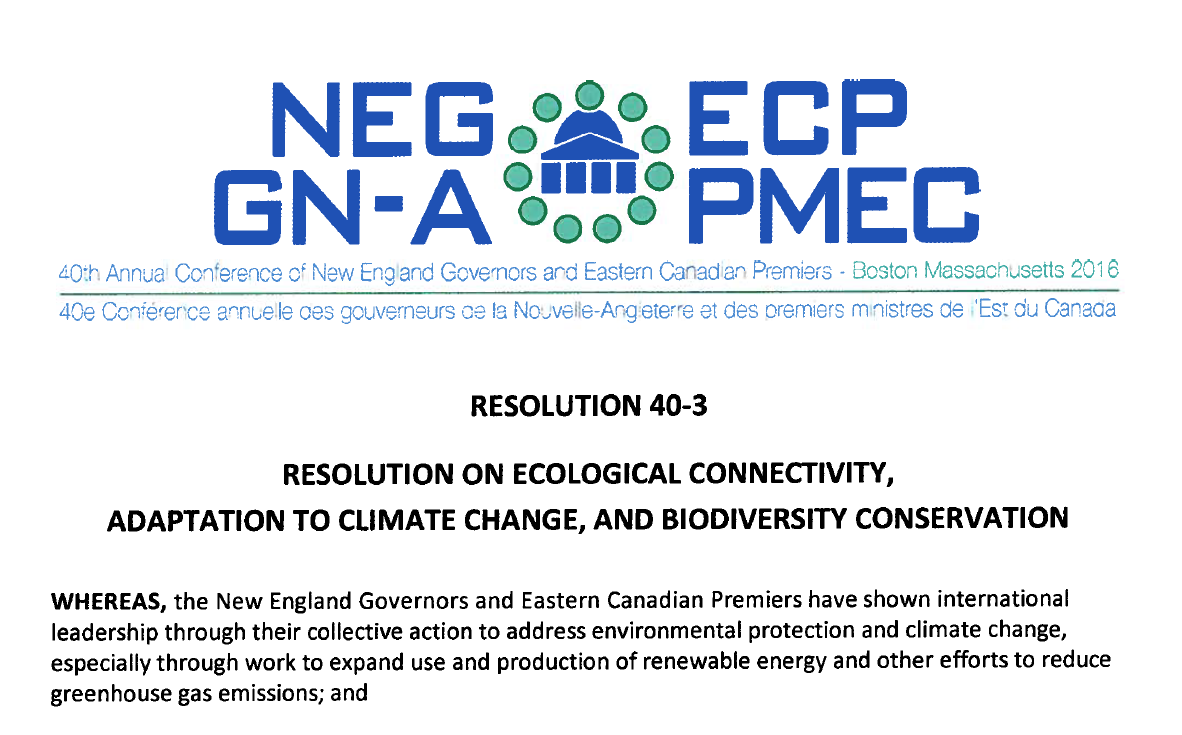
Resolution on Ecological Connectivity, Adaption to Climate Change, and Biodiversity Conservation
2016
Summary
This resolution outlines the many ways that ecological connectivity supports climate change resilience, forest health and wildlife health goals in the New England states and eastern Canadian provinces, and directs agencies within these jurisdictions to elevate ecological connectivity in the natural resource and transportation planning work.
Key Personnel & Institutions
Not available.Location
New England
Resource Type
Policy
Tags
biodiversity, climate change resilience, landscape connectivity, transportation
Topic Tags
planning, wildlife and habitat, landscape pattern and connectivity
Purpose Tags
policy
Citation
New England Governors and Eastern Canadian Premiers. 2016. Resolution 40-3 : Resolution on Ecological Connectivity, Adaptation to Climate Change, and Biodiversity Conservation
Source Link
https://www.coneg.org/wp-content/uploads/2019/01/40-3-Ecological-Connectivity-EN.pdf
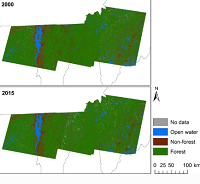
Simulating forest cover change in the northeastern U.S.: decreasing forest area and increasing fragmentation
1984 to 2018
Summary
The authors built a cellular automata model to simulate changes in forest cover of the Northern Forest (northeastern US) from 2015 to 2075, based on historical trends from 1985 to 2015. While there was an overall increase in forest cover between 2000 and 2015, there was a trend of decreasing forest area across the Northern Forest, which continued in the simulations. In both observed and simulated time periods, forest fragmentation increased, which posed a major threat to the Northern Forest.
Key Personnel & Institutions
People: Jennifer Pontius , David Gudex-Cross , Alison Adams , Gillian Galford
Institutions: University of Vermont
Location
New York
Resource Type
Article
Tags
northern forest, fragmentation
Topic Tags
conservation, management, landscape pattern and connectivity
Purpose Tags
conservation, management
Citation
Adams, A. B., Pontius, J., Galford, G., & Gudex-Cross, D. (2019). Simulating forest cover change in the northeastern US: decreasing forest area and increasing fragmentation. Landscape Ecology, 34(10), 2401-2419.
Source Link
https://link.springer.com/article/10.1007/s10980-019-00896-7

US family forest management coupling natural and human systems: Role of markets and public policy instruments
2018
Summary
The authors conduct a literature review on the influence of socio-economic structures on family forest owners and how they manage their lands, with a specific focus on public policy. The authors also identified areas where more research is needed.
Key Personnel & Institutions
People: Francisco Aguilar, Matthew Kelly
Institutions: Swedish University of Agricultural Sciences, Michigan Technological University
Location
No location information available
Resource Type
Article
Tags
No tag keywords available
Topic Tags
management, planning
Purpose Tags
policy
Citation
Aguilar, F. X., & Kelly, M. C. (2019). US family forest management coupling natural and human systems: Role of markets and public policy instruments. Landscape and Urban Planning, 188, 43-53.
Source Link
https://www.sciencedirect.com/science/article/pii/S0169204619300398
Effect of Forest Fragmentation on Lyme Disease Risk
1999 to 2002
Summary
The authors examined how forest destruction and fragmentation could increase a region's susceptibility to Lyme disease through a decrease in mammalian diversity and an increase in white-footed mouse populations, which carry the Lyme bacterium.
Key Personnel & Institutions
People: Brian F. Allan , Felicia Keesing, Richard Ostfeld
Institutions: Cary Institute of Ecosystem Studies , University of Illinois, Bard College
Location
Dutchess, New York
Resource Type
Article
Tags
No tag keywords available
Topic Tags
ecosystem services, drivers, wildlife and habitat, landscape pattern and connectivity
Purpose Tags
conservation, management
Citation
Allan, B. F., Keesing, F., & Ostfeld, R. S. (2003). Effect of forest fragmentation on Lyme disease risk. Conservation Biology, 17(1), 267-272.
Source Link
A systematic review of forest bird occurrence in North American forest fragments and the built environment
2014 to 2018
Summary
The study examined the effects of forest fragmentation on different bird species in the United States. The results indicate that it is important to preserve small forest fragments when developing land, because these are utilized by migratory and certail resident bird species.
Key Personnel & Institutions
People: Mark Hostetler , Jan-Michael Archer, Glenn Acomb, Robert Blair
Institutions: University of Florida, University of Minnesota
Location
No location information available
Resource Type
Article
Tags
No tag keywords available
Topic Tags
conservation, management, ecosystem services, planning, wildlife and habitat, landscape pattern and connectivity
Purpose Tags
conservation, management
Citation
Archer, J. M. J., Hostetler, M. E., Acomb, G., & Blair, R. (2019). A systematic review of forest bird occurrence in North American forest fragments and the built environment. Landscape and urban planning, 185, 1-23.
Source Link
https://www.sciencedirect.com/science/article/pii/S0169204619300404

Public hearing on CMP transmission corridor focuses on mitigating impacts
2019
Summary
This is an article and news clip from the public hearing in Bangor, Maine on the New England Clean Energy Connect (NECEC) Powerline.
Key Personnel & Institutions
People: Spencer Roberts
Institutions: WABI Channel 5
Location
Bangor, Maine
Resource Type
Poster
Tags
No tag keywords available
Topic Tags
conservation, wildlife and habitat, landscape pattern and connectivity
Purpose Tags
conservation
Citation
Public hearing on CMP transmission corridor focuses on mitigating impacts [Video File]. (2019, May 9). Retrieved from https://www.wabi.tv/content/news/Public-hearing-on-CMP-transmission-corridor-focuses-on-mitigating-impacts-509709651.html
Source Link
Family-forest owner decisions, landscape context, and landscape change
2015 to 2018
Summary
The authors were interested in determining whether state or regional differences influenced family forest owner decisions across 8 different forested landscapes in New England. They found that state and regional differences did influence family forest owner decisions, and suggested that these findings may be useful for implementing more successful programs and outreach for conservation easements.
Key Personnel & Institutions
People: Paul Catanzaro , Kathleen Bell, Marla Markowski-Lindsay, Jessica Leahy
Institutions: University of Maine , University of Massachusetts Amherst
Location
VERMONT, Massachusetts, Maine, New York
Resource Type
Article
Tags
No tag keywords available
Topic Tags
management, drivers
Purpose Tags
management, policy
Citation
Bell, K. P., Markowski-Lindsay, M., Catanzaro, P., & Leahy, J. (2019). Family-forest owner decisions, landscape context, and landscape change. Landscape and Urban Planning, 188, 118-131.
Source Link
https://www.sciencedirect.com/science/article/pii/S0169204618309344
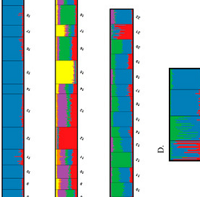
A Comparison of the Population Genetic Structure and Diversity between a Common (Chrysemys p. picta) and an Endangered (Clemmys guttata) Freshwater Turtle
2012 to 2018
Summary
The authors hypothesized that spotted turtles (Clemmys guttata) would have lower genetic diversity (higher rates of inbreeding) than eastern painted turtles (Chrysemys p. picta), as a result of historic habitat destruction and fragmentation. This hypothesis was based on the premise that spotted turtles would disproportionately experience the effects of habitat destruction and fragmentation since they are habitat specialists, while eastern spotted turtles are habitat generalists.
Key Personnel & Institutions
People: Scott Buchanan , Scott Buchanan, Scott Buchanan, Scott Buchanan, Jason Kolbe, Johanna Wegener, Jessica Atutubo, nancy Karraker
Institutions: University of Rhode Island, Rhode Island Division of Fish & Wildlife
Location
No location information available
Resource Type
Article
Tags
No tag keywords available
Topic Tags
No topic tag keywords available
Purpose Tags
No purpose tag keywords available
Citation
Buchanan, S. W., Kolbe, J. J., Wegener, J. E., Atutubo, J. R., & Karraker, N. E. (2019). A Comparison of the Population Genetic Structure and Diversity between a Common (Chrysemys p. picta) and an Endangered (Clemmys guttata) Freshwater Turtle. Diversity, 11(7), 99.
Source Link
Occupancy of freshwater turtles across a gradient of altered landscapes
2012 to 2017
Summary
The authors surveyed 88 wetlands across Rhode Island to estimate the relative abundances of freshwater turtle species and investigate covariates related to abundance and detection.
Key Personnel & Institutions
People: Scott Buchanan , Scott Buchanan, Scott Buchanan, Scott Buchanan, Bill Buffum, Gavino Puggioni, nancy Karraker
Institutions: University of Rhode Island
Location
No location information available
Resource Type
Article
Tags
No tag keywords available
Topic Tags
No topic tag keywords available
Purpose Tags
No purpose tag keywords available
Citation
Buchanan, S. W., Buffum, B., Puggioni, G., & Karraker, N. E. (2019). Occupancy of freshwater turtles across a gradient of altered landscapes. The Journal of Wildlife Management, 83(2), 435-445.
Source Link
https://wildlife.onlinelibrary.wiley.com/doi/full/10.1002/jwmg.21596
Maine Audubon, foresters work to protect critical bird habitat
2017 to 2018
Summary
A short article in the Forecaster describes how the populations of many forest birds in Maine have been steadily declining as threats to their existence continue to grow, including habitat fragmentation, encroaching development, air pollution and climate change.
Key Personnel & Institutions
People: Kate Irish Collins
Institutions: The Forecaster
Location
Maine
Resource Type
Website
Tags
birds, forestry
Topic Tags
ecosystem services, wildlife and habitat
Purpose Tags
education
Citation
Collins, K.I. (2018). Maine Audubon, foresters work to protect critical bird habitat. The Forecaster. Available at http://www.theforecaster.net/maine-audubon-foresters-work-to-protect-critical-bird-habitat/
Source Link
http://www.theforecaster.net/maine-audubon-foresters-work-to-protect-critical-bird-habitat/
N.H. Braces For More Ticks & More Tick-Borne Disease
2017 to 2018
Summary
The Exchange looked into the rise in tick and mosquito-borne illness in New England, including what may be causing the increase in these pests and the diseases they carry, and what residents can do to protect themselves.
Key Personnel & Institutions
Institutions: New Hampshire Public Radio
Location
New Hampshire
Resource Type
Website
Tags
public health, ticks
Topic Tags
wildlife and habitat
Purpose Tags
education
Citation
The Exchange. (2018). N.H. Braces For More Ticks & More Tick-Borne Disease. NHPR. Available at http://www.nhpr.org/post/nh-braces-more-ticks-more-tick-borne-disease#stream/0
Source Link
http://www.nhpr.org/post/nh-braces-more-ticks-more-tick-borne-disease#stream/0
Vermont's return on investment in land conservation
2017 to 2018
Summary
The Trust for Public Land conducted an economic analysis of the return on investment for land conservation in Vermont. The report found that every state dollar invested in land conservation returned $9 in natural goods and services.
Key Personnel & Institutions
People: Joe Roman
Institutions: University of Vermont, Rubenstein School of Environment and Natural Resources , Gund Institute for Environment
Location
VERMONT
Resource Type
Report
Tags
recreation, forestry, natural resources
Topic Tags
ecosystem services
Purpose Tags
education
Citation
The Trust for Public Land. (2018). Vermont's return on investment in land conservation. Available at https://www.tpl.org/sites/default/files/files_upload/Vt.ROI_.8_16_18final.digital.pdf
Source Link
https://www.tpl.org/resource/vermonts-return-investment-land-conservation
The shape of density dependence in fragmented landscapes explains an inverse buffer effect in a migratory songbird
1991 to 2017
Summary
The author found that landscape-scale density in wood thrush was lower and population declines steeper in higher quality, less fragmented landscapes (an inverse buffer effect) than in poor quality landscapes. These patterns suggest that wood thrush was not limited by availability of breeding habitat but that declines were primarily driven by non-breeding season events.
Key Personnel & Institutions
People: Caz Taylor
Institutions: Tulane University, Department of Ecology and Evolutionary Biology
Location
New York, New England
Resource Type
Article
Tags
fragmentation, habitat connectivity, breeding
Topic Tags
ecosystem services, wildlife and habitat, landscape pattern and connectivity
Purpose Tags
education
Citation
Taylor, C.M. (2017). The shape of density dependence in fragmented landscapes explains an inverse buffer effect in a migratory songbird. Scientific reports, 7(1), p.14522.
Source Link
Implementing Act 171 Land Use Planning To Address Forest Fragmentation
2017
Summary
Beginning in 2018, Vermont’s Act 171 requires that municipalities and regions that are updating their municipal and regional plans identify areas that are important as "forest blocks" and "habitat connectors" and plan for development in those areas to minimize forest fragmentation. As town and regional plans come up for revision, many communities are now attempting to create the required maps and write appropriate language. This webinar provides background information along with tools and examples.
Key Personnel & Institutions
People: Jamey Fidel , Jens Hilke, Clare Rock
Institutions: Vermont Natural Resources Council , Vermont Fish and Wildlife Department
Location
VERMONT
Resource Type
Website
Tags
fragmentation, planning
Topic Tags
management, planning, landscape pattern and connectivity
Purpose Tags
management, education
Citation
Hilke, J. Rock, C. & Fidel, J. (2017). Implementing Act 171 Land Use Planning To Address Forest Fragmentation. Available at https://www.youtube.com/watch?v=EusloD8LdAE
Source Link
New England Clean Energy Connect and the Impacts of Forest Fragmentation
2018
Summary
The author writes about Maine Audubon's position on New England Clean Energy Connect (NECEC), a transmission line that would carve a 150 foot corridor through a 53 mile stretch of remote woods in Maine. Maine Audubon reviewed the environmental impacts study provided by Central Maine Power (CMP) and felt that habitat fragmentation was not adequately addressed to properly protect sensitive wildlife species. To read more articles related to this story, including impacts on the Wood Turtle, American Marten, and Ovenbird, please visit Maine Audubon North Woods blog at: https://www.maineaudubon.org/news/category/advocacy/north-woods/
Key Personnel & Institutions
People: Eliza Donoghue
Institutions: Maine Audubon Society
Location
Maine
Resource Type
Website
Tags
No tag keywords available
Topic Tags
conservation, ecosystem services, wildlife and habitat, landscape pattern and connectivity
Purpose Tags
conservation, education, policy
Citation
Donoghue, E. (2019, April 2). New England Clean Energy Connect and the Impacts of Forest Fragmentation. Retrieved from https://www.maineaudubon.org/news/new-england-clean-energy-connect-and-the-impacts-of-forest-fragmentation/
Source Link
https://www.maineaudubon.org/news/category/advocacy/north-woods/
Social and biophysical determinants of future forest conditions in New England: Effects of a modern land-use regime
2009 to 2015
Summary
The authors modeled projections of New England's forest based on current trends to determine which landscape changes have the largest impact on carbon storage capabilities of New England forests.
Key Personnel & Institutions
People: Jonathan Thompson , Matthew Duveneck , Matthew Duveneck
Institutions: Harvard University, Harvard Forest , New England Conservatory
Location
No location information available
Resource Type
Article
Tags
No tag keywords available
Topic Tags
No topic tag keywords available
Purpose Tags
No purpose tag keywords available
Citation
Duveneck, M. J., & Thompson, J. R. (2019). Social and biophysical determinants of future forest conditions in New England: Effects of a modern land-use regime. Global Environmental Change, 55, 115-129.
Source Link
https://www.sciencedirect.com/science/article/pii/S0959378018312731
Effects of Suburbanizing Landscapes on Reproductive Effort of Vernal Pool-Breeding Amphibians
2013 to 2018
Summary
The authors study the impacts of suburbanization on amphibians that breed in vernal pools in Maine. They found that an increase of impervious surfaces within a kilometer of vernal pools has complex effects on breeding amphibians, with an overall negative effect on these species.
Key Personnel & Institutions
People: Malcolm Hunter, Carly Eakin, Aram Calhoun
Institutions: University of Maine
Location
Maine
Resource Type
Article
Tags
No tag keywords available
Topic Tags
conservation, wildlife and habitat, landscape pattern and connectivity
Purpose Tags
conservation
Citation
Eakin, C. J., Calhoun, A. J., & Hunter Jr, M. L. (2019). Effects of Suburbanizing Landscapes on Reproductive Effort of Vernal Pool-Breeding Amphibians. Herpetological Conservation and Biology, 14(2), 515-532.
Source Link
http://www.herpconbio.org/Volume_14/Issue_2/Eakin_etal_2019.pdf
Jane Difley: Preserving N.H.'s Forests for Two Decades
2018 to 2019
Summary
This is the transcript of a conversation with Jane Difley about her career as the first woman president of the Society for the Protection of New Hampshire Forests, who recently retired.
Key Personnel & Institutions
People: The Exchange
Institutions: New Hampshire Public Radio
Location
New Hampshire
Resource Type
Website
Tags
No tag keywords available
Topic Tags
conservation
Purpose Tags
education
Citation
Difley, J. (2019, Sept. 10). Personal interview with The Exchange.
Source Link
https://www.nhpr.org/post/jane-difley-preserving-nhs-forests-two-decades#stream/0

Risk Factors for Bites and Diseases Associated With Black-Legged Ticks: A Meta-Analysis
1983 to 2018
Summary
The authors performed a meta-analysis on factors proposed to increase or decrease the risk of black-legged bites and tick-borne disease.
Key Personnel & Institutions
People: Ilya Fischhoff, Felicia Keesing, Richard Ostfeld
Institutions: Cary Institute of Ecosystem Studies , Bard College
Location
No location information available
Resource Type
Article
Tags
No tag keywords available
Topic Tags
management, drivers
Purpose Tags
education
Citation
Fischhoff, I. R., Keesing, F., & Ostfeld, R. S. (2019). Risk factors for bites and diseases associated with blacklegged ticks: a meta-analysis. American journal of epidemiology.
Source Link
History matters: contemporary versus historic structure of bobcats in the New England region, USA
1951 to 2016
Summary
The authors of this study looked for genetic diversity and population structure differences between contemporary (2010-2017) and historic (1952-1964) bobcats. They found that there was a decline in both genetic diversity and differences in genetic population structures over time, suggesting that habitat fragmentation and range dynamics "may play a significant role in population structure."
Key Personnel & Institutions
People: John Litvaitis, Rory Carroll, Marian Litvaitis, Sarah Clements, Clark Stevens
Institutions: University of New Hampshire
Location
New England
Resource Type
Article
Tags
No tag keywords available
Topic Tags
conservation, wildlife and habitat, landscape pattern and connectivity
Purpose Tags
conservation
Citation
Carroll, R. P., Litvaitis, M. K., Clements, S. J., Stevens, C. L., & Litvaitis, J. A. (2019). History matters: contemporary versus historic population structure of bobcats in the New England region, USA. Conservation Genetics, 1-15.
Source Link
https://www.uvm.edu/femc/fragnet/search/?search-query=&filterType=article
Hierarchical population structure of a rare lagomorph indicates recent fragmentation has disrupted metapopulation function
2012 to 2018
Summary
The authors researched how habitat fragmentation has affected genetic diversity of the New England cottontail.
Key Personnel & Institutions
People: Adrienne Kovach, Amanda Cheeseman, Christopher Whipps, Jonathan Cohen, Sadie Ryan
Institutions: The State University of New York (SUNY), College of Environmental Science and Forestry (ESF) , University of New Hampshire , University of Florida
Location
New York
Resource Type
Article
Tags
No tag keywords available
Topic Tags
conservation, management, wildlife and habitat, landscape pattern and connectivity
Purpose Tags
conservation
Citation
Cheeseman, A. E., Cohen, J. B., Whipps, C. M., Kovach, A. I., & Ryan, S. J. (2019). Hierarchical population structure of a rare lagomorph indicates recent fragmentation has disrupted metapopulation function. Conservation Genetics, 20(6), 1237-1249.
Source Link
https://link.springer.com/article/10.1007/s10592-019-01206-z
Determinants of home-range size of imperiled New England cottontails (Sylvilagus transitionalis) and introduced eastern cottontails (Sylvilagus floridanus)
2012 to 2018
Summary
The authors of this study built models to determine the impact of habitat fragmentation and invasive species intrusion on the New England cottontail. Patch size and stem density of bushes both seem to be important for the survival of New England cottontails, as small patches (< 7 ha) without enough cover can act as population sinks.
Key Personnel & Institutions
People: Amanda Cheeseman, Christopher Whipps, Jonathan Cohen, Sadie Ryan
Institutions: The State University of New York (SUNY), College of Environmental Science and Forestry (ESF) , University of Florida
Location
Dutchess, Putnam, New York
Resource Type
Article
Tags
No tag keywords available
Topic Tags
conservation, management, wildlife and habitat, landscape pattern and connectivity
Purpose Tags
conservation, management
Citation
Cheeseman, A. E., Cohen, J. B., Ryan, S. J., & Whipps, C. M. (2019). Determinants of home-range size of imperiled New England cottontails (Sylvilagus transitionalis) and introduced eastern cottontails (Sylvilagus floridanus). Canadian Journal of Zoology, 97(6), 516-523.
Source Link
https://www.nrcresearchpress.com/doi/full/10.1139/cjz-2018-0277#.XhzFoMhKiUl
Satellite-detected forest disturbance forecasts American marten population decline: The case for supportive space-based monitoring
1974 to 2018
Summary
The authors studied the accuracy of using habitat monitoring and species distribution models as a proxy for direct monitoring when resources inhibit direct, in-situ monitoring of a species.
Key Personnel & Institutions
People: Erin Simons-Legaard, John Clare, Shawn McKinney, John DePue, Cynthia Loftin, Cynthia Loftin
Institutions: University of Maine , Maine Department of Inland Fisheries & Wildlife , Maine Cooperative Fish and Wildlife Research Unit
Location
No location information available
Resource Type
Article
Tags
No tag keywords available
Topic Tags
No topic tag keywords available
Purpose Tags
No purpose tag keywords available
Citation
Clare, J., McKinney, S. T., Simons-Legaard, E. M., DePue, J. E., & Loftin, C. S. (2019). Satellite-detected forest disturbance forecasts American marten population decline: The case for supportive space-based monitoring. Biological Conservation, 233, 336-345.
Source Link
https://www.sciencedirect.com/science/article/pii/S0006320718301083#!
Bill to protect state forestland axed in late-session maneuver
2018
Summary
This article in VT Digger describes how proposed Vermont bill H.904, which contained provisions to protect vast tracts of state forestland from parcelization — the practice of splitting forests into smaller and smaller tracts, leaving them increasingly vulnerable to development and degrading wildlife habitat -- was axed.
Key Personnel & Institutions
People: Mike Polhamus
Institutions: VTDigger
Location
VERMONT
Resource Type
Website
Tags
fragmentation, forestland, parcelization, policy
Topic Tags
planning, landscape pattern and connectivity
Purpose Tags
education
Citation
Polhamus, M. (2018). Bill to protect state forestland axed in late-session maneuver. VT Digger. Available at https://vtdigger.org/2018/05/18/bill-protect-state-forestland-axed-late-session-maneuver/
Source Link
https://vtdigger.org/2018/05/18/bill-protect-state-forestland-axed-late-session-maneuver/
Managing Forests for Trees and Birds in Massachusetts
2015 to 2016
Summary
Massachusetts has more than 3 million acres of forested land, and about 75% of that land is privately owned. This means that private landowners are positioned to be the most significant contributors to creating and maintaining habitat for forest birds and other wildlife.
Key Personnel & Institutions
Institutions: Massachusetts Audubon
Location
Massachusetts
Resource Type
Report
Tags
timber harvest, coarse woody debris, leaf litter, understory vegetation, forest management, forest birds, forest patch
Topic Tags
conservation, management, ecosystem services, wildlife and habitat
Purpose Tags
conservation, management
Citation
Massachusetts Audubon Society, Inc. (2018). Managing Forests for Trees and Birds in Massachusetts. Available at https://www.google.com/url?sa=t&rct=j&q=&esrc=s&source=web&cd=3&ved=2ahUKEwjig7OPpazeAhXRmeAKHeTiA7gQFjACegQIBhAC&url=https://www.mass.gov/files/documents/2018/04/24/ma-management-guide-for-web.pdf&usg=AOvVaw39Tt0wBr4OOXZdh5P-NIUT
Source Link
https://www.massaudubon.org/our-conservation-work/wildlife-research-conservation/forest-birds
Patterns in Forest Harvesting in New England and New York: Using FIA Data to Evaluate Silvicultural Outcomes
1998 to 2018
Summary
The authors developed a classification tree that used objective inventory data to classify harvests into one of twelve harvest types, based on pre- and post-harvest stocking levels, size distribution, and tree quality. The results indicate that exploitative treatments like commercial clearcutting and high-grading may be more common than is desirable, while some “classic” silvicultural techniques, like silvicultural clearcuts and seed tree harvesting, are comparatively rare. Further, the distribution of treatments varies across New York and New England, and bears little resemblance to the historical distribution of natural disturbances.
Key Personnel & Institutions
People: Ethan Belair, Mark Ducey
Institutions: University of New Hampshire , University of New Hampshire Cooperative Extension
Location
New York, New England
Resource Type
Article
Tags
silviculture, clearcutting, basal area, harvesting, clearcuts, forest management, silvicultural treatments
Topic Tags
ecosystem services, drivers, landscape pattern and connectivity
Purpose Tags
education
Citation
Belair, E.P. & Ducey, M.J. (2018). Patterns in Forest Harvesting in New England and New York: Using FIA Data to Evaluate Silvicultural Outcomes. Journal of Forestry, 116(3), pp.273-282.
Source Link
National Council for Air and Stream Improvement: Fragmentation in the Boreal Forest and Possible Effects on Terrestrial Wildlife
2020
Summary
The purpose of this report is to synthesize the available literature on fragmentation in the boreal and its effects on terrestrial vertebrates. The authors surveyed a wide range of scientific works originating primarily from Canada’s boreal forest, with some studies from Scandinavia and temperate North America.
Key Personnel & Institutions
People: Chris Wedeles , Darren J. H. Sleep
Institutions: Arborvitae Environmental Service , National Council for Air and Stream Improvement
Location
Maine, New England
Resource Type
Report
Tags
boreal
Topic Tags
methods, wildlife and habitat, landscape pattern and connectivity
Purpose Tags
management, education
Citation
Wedeles, C.; Sleep, D.J.H. December 2008. "Fragmentation in the Boreas Forest and Possible Effects on Terrestrial Wildlife, National Council for Air and Stream Improvement." Accessed From (https://www.ncasi.org/wp-content/uploads/2019/02/tb959.pdf)
Source Link
Letter to the editor: CMP power line would fragment forest
2019
Summary
An article summarizing the issues of the New England Clean Energy Connect and the disappointment of the support it is receiving.
Key Personnel & Institutions
People: John Nicholas
Institutions: Portland Press Herald
Location
New England
Resource Type
Poster
Tags
No tag keywords available
Topic Tags
conservation, planning, landscape pattern and connectivity
Purpose Tags
conservation, education, policy
Citation
Nicholas, J. 12 May 2019. "Letter to the editor: CMP power line would fragment forest." Accessed From (https://www.pressherald.com/2019/05/12/letter-to-the-editor-cmp-power-line-would-fragment-forest/)
Source Link
https://www.pressherald.com/2019/05/12/letter-to-the-editor-cmp-power-line-would-fragment-forest/
Climate Change and Biodiversity in Maine: Vulnerability of Habitats and Priority Species
2003 to 2014
Summary
A report of the vulnerability assessment of Maine's species and habitats, the relationship between species vulnerability and Maine Comprehensive Wildlife Conservation Strategy ( ME SWCS), to provide information to Maine natural resource managers and policy makers and to facilitate the incorporation of climate change information into upcoming revisions of ME SWCS.
Key Personnel & Institutions
People: Andrew Whitman , Andrew Cutko , Phillip DeMaynadier , Steve Walker , Barbara Vickery , Sally Stockwell , Robert Houston
Institutions: The Nature Conservancy , United States Fish and Wildlife Service, Maine Audubon Society , Maine Department of Inland Fisheries & Wildlife , Maine Department of Agriculture, Concervation and Forestry , Manomet Center for Conservation Sciences , Maine Coast Heritage Trust
Location
Maine
Resource Type
Report
Tags
climate change, assessment, natural resources
Topic Tags
conservation, methods, planning, wildlife and habitat, landscape pattern and connectivity
Purpose Tags
conservation, management, education, policy
Citation
Whitman, A.; Cutko, A.; deMaynadier, P.; Walker, S.; Vickery, B.; Stockwell, S.; Houston, R. 2014. "Climate Change and Biodiversity in Maine: Vulnerability of Habitats and Priority Species, Manoment Center for Conservation Sciences." Accessed From (https://www.manomet.org/wp-content/uploads/old-files/2013 BwH Vulnerability Report CS5v7_0.pdf)
Source Link
https://www.manomet.org/wp-content/uploads/old-files/2013 BwH Vulnerability Report CS5v7_0.pdf
NRCS Action Plan to Conserve: Identified Priority Fish and Wildlife Species and Habitat in Maine
2006
Summary
This action plan for Maine NRCS identifies conservation targets, major resource concerns for each conservation target, and discusses opportunities for NRCS programs to help alleviate or solve identified resource concerns.
Key Personnel & Institutions
Institutions: United States Department of Agriculture (USDA), Maine Natural Resources Conservation Service
Location
Maine
Resource Type
Report
Tags
resource
Topic Tags
conservation, methods, management, planning
Purpose Tags
conservation, management, policy
Citation
Natural Resources Conservation Service. June 2006. "NRCS Action Plan to Conserve: Identified Priority Fish and Wildlife Species and Habitat in Maine." Accessed From (https://www.nrcs.usda.gov/Internet/FSE_DOCUMENTS/nrcs141p2_001960.pdf)
Source Link
A Social Marketing Approach to Forest Land Conservation
2012
Summary
In an effort to develop conservation objectives with the purpose of protect working forest land, the Southwestern Maine Forest Fragmentation Coalition elected to utilize the outreach tool Tools for Engaging Landowners Effectively developed by the Sustaining Family Forests Initiative. A detailed communication plan was created with specific targeted messages which use a social marketing approach in identifying landowners in a 10-town focus area that would be most likely to be receptive to stewardship practices and actively engage in the conservation easement program.
Key Personnel & Institutions
People: Joseph Anderson , Mark Lapping
Institutions: University of Southern Maine, Muskie School of Public Service
Location
Maine
Resource Type
Report
Tags
No tag keywords available
Topic Tags
conservation, methods, management, planning
Purpose Tags
conservation, management, education, policy
Citation
Anderson, Joseph, "A Social Marketing Approach to Forest Land Conservation" (2012). Muskie School Capstones and Dissertations. 58. https://digitalcommons.usm.maine.edu/muskie_capstones/58
Source Link
Brown-Headed Cowbird Parasitism of Ovenbirds in Suburban Forest Fragments
1995 to 1999
Summary
Forest fragmentation in North America concerns many biologists because of its effects on wildlife populations. One group that has demonstrated particular sensitivity is Neotropical migrant birds. This reports on a study of Ovenbirds (Seiurus aurocapillus) in forest fragments in a suburban landscape in eastern Massachusetts to determine effects of cowbird parasitism on Ovenbird reproductive success.
Key Personnel & Institutions
People: Marta J. Hersek , Michelle A. Frankel , John A. Cigliano , Frederick E. Wasserman
Institutions: Boston University , Boston University, Department of Biology, Bradford College, Division of Natural Science
Location
Massachusetts
Resource Type
Article
Tags
populations, migratory birds
Topic Tags
conservation, management, planning, wildlife and habitat
Purpose Tags
conservation, management
Citation
Marta J. Hersek, Michelle A. Frankel, John A. Cigliano, Frederick E. Wasserman, "Brown-Headed Cowbird Parasitism of Ovenbirds in Suburban Forest Fragments", The Auk, Volume 119, Issue 1, 1 January 2002, Pages 240–243, https://doi.org/10.1093/auk/119.1.240
Source Link
Comparative Evaluation of Experimental Approaches to The Study of Habitat Fragmentation Effects
2002
Summary
Ecologists have used a variety of comparative mensurative and manipulative experimental approaches to study the biological consequences of habitat fragmentation. This paper evaluates the merits of the two major approaches and offer guidelines for selecting a design.
Key Personnel & Institutions
People: Kevin McGarigal , Samuel A. Cushman
Institutions: UMass Amherst Department of Natural Resources Conservation
Location
Massachusetts
Resource Type
Report
Tags
No tag keywords available
Topic Tags
methods, management, planning
Purpose Tags
management, education
Citation
McGarigal, K.; Cushman, S.A. "Comparative Evaluation of Experimental Approaches to the Study of Habitat Fragmentation Effects." Ecological Application, Ecological Society of America, vol. 12, issue 2, pp. 335-345, 1 April 2002. Accessed from (https://esajournals.onlinelibrary.wiley.com/doi/abs/10.1890/1051-0761(2002)012[0335:CEOEAT]2.0.CO;2)
Source Link
https://esajournals.onlinelibrary.wiley.com/doi/abs/10.1890/1051-0761(2002)012[0335:CEOEAT]2.0.CO;2
Temporal change in forest fragmentation at multiple scales
2007
Summary
This study used temporal land-cover data for the Chesapeake Bay region and the state of New Jersey to compare patch-based and area–density scaling measures of fragmentation for detecting changes in the spatial scale of forest that may result from forest loss.
Key Personnel & Institutions
People: James Wickham , Kurt Riitters , Timothy Wade, John Coulston
Institutions: United States Department of Agriculture (USDA), Forest Service, Southern Research Station , United States Environmental Protection Agency (EPA), National Exposure Research Laboratory
Location
New York
Resource Type
Report
Tags
No tag keywords available
Topic Tags
conservation, methods, management, landscape pattern and connectivity
Purpose Tags
conservation, management
Citation
Wickham, J.; Riitters, K.; Wade, T. et al. "Temporal change in forest fragmentation at multiple scales." Landscape Ecol 22, 481–489 (2007). Accessed from (https://doi.org/10.1007/s10980-006-9054-6)
Source Link
Forest Fragmentation And Bird Community Dynamics: Inference at Regional Scales
2001
Summary
This study tested whether in more fragmented landscapes there was a lower number of area?sensitive species and higher local extinction and turnover rates, which could explain higher temporal variability in species richness. To investigate such potential landscape effects at a regional scale, this study merged two independent, large?scale monitoring efforts: the North American Breeding Bird Survey (BBS) and the Land Use and Land Cover Classification data from the U.S. Geological Survey.
Key Personnel & Institutions
People: Thierry Boulinier , James D. Nichols , James E. Hines , John R. Sauer , Curtis H. Flather , Kenneth H. Pollock
Institutions: United States Department of Agriculture (USDA), Forest Service , United States Geological Survey (USGS)
Location
No location information available
Resource Type
Article
Tags
extinction
Topic Tags
No topic tag keywords available
Purpose Tags
No purpose tag keywords available
Citation
Boulinier, T.; Nichols, J.D.; Hines, J.E.; Sauer, J.R.; Flather, C.H.; Pollock, K.H. "Forest Fragmentation and Bird Community Dynamics: Inference at Regional Scales." Ecology, Ecological Society of America, vol. 82, issue 4, pp. 1159-1169, 1 April 2001. Accessed From (https://esajournals.onlinelibrary.wiley.com/doi/abs/10.1890/0012-9658(2001)082[1159:FFABCD]2.0.CO;2)
Source Link
https://esajournals.onlinelibrary.wiley.com/doi/abs/10.1890/0012-9658(2001)082[1159:FFABCD]2.0.CO;2
Reciprocal relationships between forest management and regional landscape structures: applying concepts from land system science to private forest management
2019
Summary
This article highlights potential mechanisms by which regional context enables or constrains decisions on private forest landholdings in the northeastern United States, examining relationships between land use and land management of private forest landholdings and landscape-level dynamics.
Key Personnel & Institutions
People: Kathleen Bell, Darla K. Munroe , Darla K. Munroe, Mindy S. Crandall , Chris Colocousis , Anita T. Morzillo
Institutions: University of Connecticut, Department of Natural Resources and the Environment, Ohio State University, Department of Geography , University of Maine, School of Forest Resources , James Madison University, Department of Sociology and Anthropology , University of Maine, School of Economics
Location
No location information available
Resource Type
Report
Tags
private land
Topic Tags
No topic tag keywords available
Purpose Tags
No purpose tag keywords available
Citation
Munroe, D.K.; Crandall, M.S.; Colocousis, C.; Bell, K.P.; Morzillo, A.T. 27 April 2019. "Reciprocal relationships between forest management and regional landscape structures: applying concepts from land system science to private forest management", Journal of Land Use Science, 14:2, 155-172, DOI: 10.1080/1747423X.2019.1607914
Source Link
https://www.tandfonline.com/doi/abs/10.1080/1747423X.2019.1607914
Act 250 at 50: Obstacles and Opportunities for the Future
2019
Summary
A slow erosion of act 250's jurisdictional power over the last fifty years and the need to address new environmental challenges necessitate the passage of a new bill to update the act and prepare Vermont for the future. As part of this process, the researchers worked with Representatives Amy Sheldon and Trevor Squirrel, and were charged with performing GIS analysis related to the proposed lowering of the elevation threshold for which Act 250 jurisdiction would apply, as well as proposing recommendations regarding environmental justice, climate change, and forest fragmentation.
Key Personnel & Institutions
People: Spencer Ainsworth , Isabel Herrick , Hollis Rhodes
Institutions: Middlebury College
Location
VERMONT
Resource Type
Policy
Tags
act 250
Topic Tags
conservation, methods, management, planning
Purpose Tags
conservation, management, policy
Citation
Ainsworth, S.; Herrick, I.; Rhodes, H. 15 December 2019. "Act 250 at 50: Obstacles and Opportunities for the Future." Accessed from (http://www.middlebury.edu/system/files/media/Act 250_FINAL.pdf)
Source Link
http://www.middlebury.edu/system/files/media/Act 250_FINAL.pdf
Lawn mowing frequency in suburban areas has no detectable effect on Borrelia spp. vector Ixodes scapularis (Acari: Ixodidae)
2012 to 2014
Summary
Forests have become increasingly fragmented throughout the US, with residential development serving as the primary driver of these changes. These altered landscapes have provided suitable conditions for a broad range of wildlife, including blacklegged ticks and their hosts. Lawns dominate residential landscapes, and thus their management has the potential to reduce the likelihood of contact with ticks in residential yards. This study tested the hypothesis that lawn mowing frequency influences tick occurrence in 16 suburban yards in Springfield, MA.
Key Personnel & Institutions
People: Susannah B. Lerman , Vincent D'Amico
Institutions: United States Department of Agriculture (USDA), Forest Service, Northern Research Station , University of Massachusetts, UMass
Location
SPRINGFIELD, Massachusetts
Resource Type
Report
Tags
ticks
Topic Tags
methods, management, wildlife and habitat, landscape pattern and connectivity
Purpose Tags
management, education
Citation
Lerman, Susannah B; Vincent D'Amico. “Lawn mowing frequency in suburban areas has no detectable effect on Borrelia spp. vector Ixodes scapularis (Acari: Ixodidae).” PloS one vol. 14,4 e0214615. 3 Apr. 2019, doi:10.1371/journal.pone.0214615
Source Link
Comparing the Climatic and Landscape Risk Factors for Lyme Disease Cases in the Upper Midwest and Northeast United States
2020
Summary
In this study, we explored and compared the climatic and landscape factors that shape the spatial patterns of human Lyme cases in these two regions, using the generalized linear mixed models.
Key Personnel & Institutions
People: Yuting Dong , Zheng Huang , Young Zhang , Yingying X.G. Wang , Yang La
Institutions: Nanjing Normal University, College of Life Sciences , Nanjing Forestry University, College of Biology and the Environment , University of Jyväskylä, Department of Biological and Environmental Science , Medical College, Tibet University
Location
New England
Resource Type
Article
Tags
lyme disease
Topic Tags
management, wildlife and habitat, landscape pattern and connectivity
Purpose Tags
management, education
Citation
Dong, Y.; Huang, Z.; Zhang, Y.; Wang, Y.X.; La, Y. Comparing the Climatic and Landscape Risk Factors for Lyme Disease Cases in the Upper Midwest and Northeast United States. Int. J. Environ. Res. Public Health 2020, 17, 1548.
Source Link
Sustaining forests through social, environmental, and community psychology constructs
2014
Summary
How landowners steward their property has the potential to affect timber supply; wildlife habitat and biodiversity; forest carbon sequestration; and a variety of recreational opportunities. Two social science surveys were implemented to explore landowner decision making and behavioral intentions. Social, environmental, and community psychology constructs served as the underlying theoretical framework.
Key Personnel & Institutions
People: Michael Ryan Quartuch , John Daigle
Institutions: University of Maine
Location
Maine
Resource Type
Report
Tags
biodiversity, carbon
Topic Tags
conservation, methods, management, ecosystem services, wildlife and habitat, landscape pattern and connectivity
Purpose Tags
conservation, management
Citation
Quartuch, M.R. May 2014. "Sustaining Forests Through Social, Environmental, and Community Psychology constructs." Accessed from (https://search.proquest.com/openview/8a86042b46d52aca339aae9fb7ac2f56/1?pq-origsite=gscholar&cbl=18750&diss=y)
Source Link
Variation and trends in sawmill wood procurement in the Northeastern United States
Summary
The sawmill industry in the Northeastern United States is represented by a wide variety of mills with highly variable round wood requirements and diverse procurement operations. Data collected from 211 sawmills in seven states are used to characterize wood procurement, with an emphasis on quantifying variation in operations among different types of firms.
Key Personnel & Institutions
People: Nate Anderson , Rene Germain
Institutions: The State University of New York (SUNY), College of Environmental Science and Forestry
Location
New England
Resource Type
Article
Tags
mill
Topic Tags
methods, management, landscape pattern and connectivity
Purpose Tags
management, education
Citation
Anderson, N.; Germain, R. (2007). "Variation and Trends in Sawmill Wood Procurement in the Northeastern United States." Accessed from: https://www.esf.edu/for/germain/Anderson & Germain 2007. Variation Wood Procurement Northeast. Forest Products Jo..pdf
Source Link
Approaches to Sustainable Forest Management in Parcelized Landscapes
2008
Summary
This study asks the question: How do partnerships involving environmental nonprofit organizations in Vermont attempt to achieve goals of sustainable forest management in the context of a parcelized landscape? Using a multiple case study approach, this study examined three SFM-related partnerships in Vermont that involve environmental nonprofit organizations. It assesses their strategies, organizational roles, challenges and perceived permanence.
Key Personnel & Institutions
People: Michelle Baumflek
Institutions: University of Vermont, Rubenstein School of Environment and Natural Resources
Location
VERMONT
Resource Type
Report
Tags
No tag keywords available
Topic Tags
conservation, methods, management, planning, landscape pattern and connectivity
Purpose Tags
conservation, management, education, policy
Citation
"Baumflek, Michelle, ""Approaches to Sustainable Forest Management in Parcelized Landscapes"" (2008). Graduate College Dissertations and Theses. 19. https://scholarworks.uvm.edu/graddis/19"
Source Link
National Association of State Foresters, Forest Action Plan, Maine
2019
Summary
The Maine Forest Action Plan is a keystone of the Maine Forest Service’s continuing efforts to inform our citizens about the condition of and trends in our forests and forest economy. It draws from a long history of strategic thinking on the issue of how to address Maine’s most important forestry issues. The plan addresses a number of topics, including, but not limited to: criteria and indicators of forest sustainability, threats and opportunities, priority forest areas, and strategies and resources needed to address threats to the state’s forest resources.
Key Personnel & Institutions
People: Joel Prince
Institutions: National Association of State Foresters
Location
Maine
Resource Type
Poster
Tags
No tag keywords available
Topic Tags
conservation, ecosystem services, planning, landscape pattern and connectivity
Purpose Tags
conservation, management, education, policy
Citation
Prince, J. 2019. "Maine Forest Action Plan." Accessed From (https://www.stateforesters.org/districts/maine/)
Source Link
Northern Forest Futures Project
2019
Summary
The Northern Forest Futures Project is a window on tomorrow’s forests, revealing how today’s trends and choices can change the future landscape of the Northeast and Midwest. Using the latest inventory data and scientific projections, the Northern Forest Futures Project helps visualize what’s here today and what to expect tomorrow. Ultimately, this project informs decision-making about the sustainable management of public and private forests in the northern United States.
Key Personnel & Institutions
Institutions: United States Department of Agriculture (USDA), Forest Service
Location
New England
Resource Type
Website
Tags
trends
Topic Tags
conservation, methods, management, planning, wildlife and habitat, landscape pattern and connectivity
Purpose Tags
conservation, management, education
Citation
USDA Forest Service. 2020." Northern Forest Futures Project." Accessed from (https://www.nrs.fs.fed.us/futures/)
Source Link
Family Forests Research
2019
Summary
The mission of the Family Forest Program is to conduct applied scientific research and outreach that contributes to the sustainable management of Maine’s family forests for desired products, services, and conditions in partnership with Maine’s family forest stakeholders.
Key Personnel & Institutions
People: Jessica Leahy, Stephanie Snyder, John Daigle , Crista Straub , Sandra de Urioste-Stone , Janet Gorman
Institutions: University of Maine, Center for Research on Sustainable Forests
Location
Maine
Resource Type
Website
Tags
family forest, outreach, sustainability
Topic Tags
conservation, methods, management, ecosystem services, landscape pattern and connectivity
Purpose Tags
conservation, management, education
Citation
Leahy, J.; Gorman, J.; Daigle, J.; Urioste-Stone, S.; Straub, C.; Snyder, S. 2019. "Family Forests Research Program Overview", Center for Research on Sustainable Forests, The University of Maine. Accessed From (https://crsf.umaine.edu/resources-2/family-forests-research/)
Source Link
https://crsf.umaine.edu/resources-2/family-forests-research/
Forest Management Plan
2004 to 2013
Summary
This plan describes the Hidden Valley Nature Center (HVNC) in Jefferson, Maine and makes suggestions for management. It is a comprehensive compilation and update of five existing management plans covering five separate land purchases.
Key Personnel & Institutions
People: Bambi Jones , David Moskovitz
Institutions: Hidden Valley Nature Center
Location
Jefferson, Maine
Resource Type
Report
Tags
No tag keywords available
Topic Tags
conservation, management, planning
Purpose Tags
conservation, management
Citation
Jones, B.; Moskovitz, D. June 20, 2013. "Forest Management Plan." Accessed From (https://www.midcoastconservancy.org/wp-content/uploads/2016/07/HVNC-Comprehensive-FMP-with-Stand-Map.pdf)
Source Link
New York State Department Of Environmental Conservation Forest Resource Assessment & Strategy
2009 to 2015
Summary
This Forest Resource Assessment and Strategy (FRAS) will identify threats, challenges and opportunities, and outline strategies to protect and improve New York's forest resources now and for future generations.
Key Personnel & Institutions
People: David A. Paterson , Alexander B. Grannis , Robert K. Davies
Institutions: New York State Department of Environmental Conservation , State of New York, ESRI Harris Geospatial Solutions and Leica Geosystems
Location
New York
Resource Type
Report
Tags
threats
Topic Tags
conservation, ecosystem services, planning
Purpose Tags
conservation, education
Citation
Paterson, D. A.; Grannis, A. B.; Davies, R. K. 2015. "New York State Department of Environmental Conservation Forest Resource Assesment & Strategy." Accessed From (https://www.dec.ny.gov/docs/lands_forests_pdf/fras070110.pdf)
Source Link
https://www.dec.ny.gov/docs/lands_forests_pdf/fras070110.pdf
Estate Planning as a Forest Stewardship Tool: A Study of Family Land Ownerships in the Northeastern U.S.
2017
Summary
This research provides foundational knowledge of the current status of family landowners' formal estate planning in four northeastern U.S. states. Using a mail survey in Massachusetts, Maine, New York and Vermont, they compiled information on owners' current management, future intentions, estate planning, and demographics.
Key Personnel & Institutions
People: Paul Catanzaro , Brett Butler , Mary Sisock , David Kittredge , Kathleen Bell, Marla Markowski-Lindsay, Jessica Leahy, Ezra Markowitz , Anita Milman , Shorna Broussard Allred , Rebekah Zimmerer
Institutions: United States Department of Agriculture (USDA), Forest Service, Northeastern Research Station , UMass Amherst Department of Natural Resources Conservation , University of Vermont, Rubenstein School of Environment and Natural Resources , University of Maine, School of Forest Resources , University of Maine, School of Economics , Cornell University, College of Agriculture and Life Sciences, Department of Natural Resources
Location
VERMONT, Massachusetts, Maine, New York
Resource Type
Report
Tags
family forest
Topic Tags
management, planning, landscape pattern and connectivity
Purpose Tags
management, education
Citation
Markowski-Lindsay, M.; Catanzaro, P.; Bell, K.; Kittredge, D.; Leahy, J.; Butler, B.; Markowitz, E.; Milman, A.; Zimmerer, R.; Allred, S.; Sisock, M. "Estate Planning as a Forest Stewardship Tool: A Study of Family Land Ownerships in the Northeatern U.S." Forest Policy and Economics, 30 March 2018, vol. 83, pp. 36-44, Accessed From (https://masswoods.org/sites/masswoods.org/files/pdf-doc-ppt/Estate-Planning-as-Forest-Stewardship-Tool.pdf).
Source Link
Partnership Conserves Nearly 24000 Acres of Working Forests in New Hampshire's North Country
2018
Summary
The New Hampshire Division of Forests and Lands and The Conservation Fund announced the completion of a multi-year effort to secure a 24,000-acre landscape of working forestland in Coos County near the Appalachian National Scenic Trail in the Mahoosuc Mountains. The private-public partnership recently acquired a working forest conservation easement on 14,987 acres owned and managed by private landowners using funding from the U.S. Forest Service's Forest Legacy Program, through the federal Land and Water Conservation Fund, and both state and private funding. This easement is held by the State of New Hampshire's Division of Forests and Lands, and together with another easement on an adjacent 8,700 acres surrounding Success Pond ensures the forest will be sustainably managed for the production of responsibly harvested timber and will be open for public outdoor recreation into the future. The forestland will continue to support local and regional jobs while providing timber to mills in New Hampshire, Maine and Canada.
Key Personnel & Institutions
People: Shelly Angers , Ann Simonelli
Institutions: The Conservation Fund , New Hampshire, Department of Natural & Cultural Resources
Location
Berlin, New Hampshire
Resource Type
Poster
Tags
working forests
Topic Tags
conservation, management, ecosystem services, planning
Purpose Tags
conservation, management, policy
Citation
Angers, S.; Simonelli, A. 19 September, 2018. "Partnership Conserves nearly 24,000 Acres of Working Forests in New Hampshire's North Country." Accessed From (https://www.nh.gov/nhdfl/news-and-events/pr-2018-mahoosuc-gateway.htm)
Source Link
https://www.nh.gov/nhdfl/news-and-events/pr-2018-mahoosuc-gateway.htm
Causes of Forest Fragmentation in the United States – 270 Meter Resolution
2011
Summary
This map layer is a grid map of the conterminous United States, created from National Land Cover Data (NLCD). The NLCD data was reclassified into four categories: forest, other natural (e.g. grassland, wetland, etc.), human land use (e.g. agriculture, urban, etc.), and nodata (water, ice and snow, and bare rock/sand).
Key Personnel & Institutions
People: Timothy Wade
Institutions: United States Geological Survey (USGS) , United States Environmental Protection Agency (EPA)
Location
New York, New England
Resource Type
Map
Tags
landuse
Topic Tags
landscape pattern and connectivity
Purpose Tags
education
Citation
Wade, T. 27 September 2011. "Causes of Forest Fragmentation in the United States - 270 Meter Resolution." National Atlas of the United States. Accessed From (https://www.sciencebase.gov/catalog/item/4f4e4a60e4b07f02db634d97).
Source Link
https://www.sciencebase.gov/catalog/item/504f821ae4b03f3ccc0290d4
NH Wildlife Corridors
2016 to 2018
Summary
In 2017/2018 the NH Fish and Game Department (NHFG) partnered with the NH Department of Transportation (NHDOT) and NH Department of Environmental Services (NHDES) to research wildlife corridors in New Hampshire and address Senate Bill 376, an act relative to wildlife corridors. The research topics included identifying (1) existing and needed wildlife corridors, (2) voluntary mechanisms that affect wildlife corridors and (3) any existing statutes, rules and regulations that affect wildlife corridors.
Key Personnel & Institutions
People: Michael Marchand , Sandra Houghton , Mark Ellingwood , Glenn Normandeau , Rebecca Martin , Lori Sommer , Collis Adams
Institutions: Connecticut Agricultural Experiment Station , Endangered and Nongame Wildlife Project, New Hampshire Fish and Game Department , New Hampshire Department of Transportation , New Hampshire Department of Environmental Services
Location
New Hampshire
Resource Type
Report
Tags
corridors
Topic Tags
conservation, management, planning, wildlife and habitat
Purpose Tags
conservation, management
Citation
Houghton, S.; Marchand, M.; Ellingwood, M.; Normandeau, G.; Martin, R.; Sommer, L.; Adams, C. June 2018. "New Hampshire Wildlife Corridors." Accessed From (https://www.wildlife.state.nh.us/nongame/documents/nh-wildlife-corr-rpt.pdf).
Source Link
Where Have the Songbirds Gone?
2014
Summary
In a joint project with the National Audubon Society, NASA DEVELOP brought Earth observations into the equation to help map and model the changing suitability of New England’s landscape. NASA Earth Applied Sciences’s DEVELOP program spearheads research partnerships seeking solutions to environmental and other Earth science issues.
Key Personnel & Institutions
Institutions: National Audubon Society , National Aeronautics and Space Administration (NASA), Develop
Location
New England
Resource Type
Poster
Tags
No tag keywords available
Topic Tags
conservation, wildlife and habitat
Purpose Tags
conservation, education
Citation
National Audubon Society, NASA Develop. 2014. "Where Have the Songbirds Gone?" Accessed From (https://www.nasa.gov/SpaceforUS/stories/nh.html)
Source Link
https://appliedsciences.nasa.gov/our-impact/story/where-have-songbirds-gone
Effects of land use on wild bee functional diversity
2019
Summary
The focus of this thesis is to uncover how differences in land use, from grazing to successional states in forests, influence a number of aspects wild bee diversity and community structure. Relative abundance and species richness have been used as standard methods for measuring the health of wild bee communities yet neither abundance nor richness are able to quantify how landscape change affects the traits found in members of the population. Phylogenetic methods are a novel tool that can measure community structure by examining how traits influence population structure.
Key Personnel & Institutions
People: Katherine A. Odanaka
Institutions: University of New Hampshire
Location
Strafford, New Hampshire
Resource Type
Report
Tags
No tag keywords available
Topic Tags
ecosystem services, wildlife and habitat, landscape pattern and connectivity
Purpose Tags
conservation
Citation
Odanaka, K. A. "Effects of Land Use on Wild Bee Functional Diversity." University of New Hampshire Scholars' Repository, Spring 2019. Accessed from https://pdfs.semanticscholar.org/1fa5/32100d68f1f3130c386b7c7d68e4472cc3ed.pdf
Source Link
https://pdfs.semanticscholar.org/1fa5/32100d68f1f3130c386b7c7d68e4472cc3ed.pdf
Fitter frogs from polluted ponds: The complex impacts of human?altered environments
2014 to 2018
Summary
Contrary to expectations, this study reports surprising benefits experienced by amphibian populations breeding and dwelling in proximity to roads. It shows that roadside populations of the wood frog, Rana sylvatica, exhibit better locomotor performance and higher measures of traits related to fitness compared with frogs from less disturbed environments located further away from roads. These results contrast previous evidence for maladaptation in roadside populations of wood frogs studied elsewhere. These results indicate that altered habitats might not be unequivocally detrimental and at times might contribute to metapopulation success. While the frequency of such beneficial outcomes remains unknown, their occurrence underscores the complexity of inferring consequences of environmental change.
Key Personnel & Institutions
People: Steven P. Brady , Francisco J. Zamora_Camacho , Fredrik A. A. Eriksson , Debora Goedert , Mar Comas , Ryan Calsbeek
Institutions: Dartmouth College , Estación Biológica de Doñana (EBD‐CSIC)
Location
VERMONT, NORWICH
Resource Type
Article
Tags
amphibians
Topic Tags
conservation, methods, management, wildlife and habitat, landscape pattern and connectivity
Purpose Tags
conservation, management, education
Citation
Brady, S. P.; Zamora-Camacho, F. J.; Eriksson, F. A. A.; Goedert, D.; Comas, M.; Calsbeek, R. "Fitter Frogs From Polluted Ponds: The Complex Impacts of Human-Altered Environments." Ecolutionary Applications, Ecolutionary Approaches to Environmental. Biomedical and Socio-Economic Issues, vol. 12, issue 7, Special issue: Maladaptation in Applied Evolution, 12 December 2018, pp. 1360-1370. Accessed from https://doi.org/10.1111/eva.12751
Source Link
New Hampshire Forest Resources Plan
1994 to 1996
Summary
Continuing the tradition begun in 1952, this Forest Resources Plan describes the condition of New Hampshire’s forests and articulates a vision for the future. It presents a variety of actions to address the question of what we must do to sustain New Hampshire’s forests and the economy that depends on them, and how we might use various means to achieve the vision.
Key Personnel & Institutions
People: John E. Sargent
Institutions: New Hampshire Division of Forests and Lands
Location
New Hampshire
Resource Type
Report
Tags
No tag keywords available
Topic Tags
conservation, methods, management, ecosystem services, planning, wildlife and habitat, landscape pattern and connectivity
Purpose Tags
conservation, management
Citation
Forest Resources Plan Steering Committee. "New Hampshire Forest Resources Plan." April 1996. Accessed from https://www.nh.gov/nhdfl/documents/nhfrp01.pdf
Source Link
New Hampshire’s Forests 2007
1952 to 2007
Summary
The first full annual inventory of New Hampshire’s forests reports nearly 4.8 million acres of forest land with an average volume of nearly 2,200 cubic feet per acre.
Key Personnel & Institutions
People: Randall Morin , Rachel Riemann , Brett Butler , Chuck Barnett , Gary J. Brand , Grand M. Domke , Susan Francher , Mark H. Hansen , Mark A. Hatfield , Charles J. Barnett
Institutions: United States Department of Agriculture (USDA), Forest Service , United States Department of Agriculture (USDA)
Location
No location information available
Resource Type
Report
Tags
inventory
Topic Tags
No topic tag keywords available
Purpose Tags
No purpose tag keywords available
Citation
Morin, R. S.; Barnett, C. J.; Brand, G. J.; Butler, B. J.; et. al. "New Hampshire's Forests 2007." September 2011. Accessed from https://www.nrs.fs.fed.us/pubs/rb/rb_nrs53.pdf
Source Link
Forests of New Hampshire, 2016
2010 to 2016
Summary
This publication provides an overview of forest resources in New Hampshire based on inventories conducted by the U.S. Forest Service, Forest Inventory and Analysis (FIA) program of the Northern Research Station.
Key Personnel & Institutions
People: Randall Morin
Institutions: United States Department of Agriculture (USDA), Forest Service, Northern Research Station
Location
New Hampshire
Resource Type
Report
Tags
inventory
Topic Tags
conservation, methods, management, ecosystem services, planning, wildlife and habitat, landscape pattern and connectivity
Purpose Tags
conservation, management
Citation
Morin, Randall S.; Lombard, Kyle. 2017. "Forests of New Hampshire, 2016." Resource Update FS-124. Newtown Square, PA: U.S. Department of Agriculture, Forest Service, Northern Research Station. 4 p. https://doi.org/10.2737/FS-RU-124
Source Link
Effects of timber size-class on predation of artificial nests in extensive forest
1988
Summary
Depredation on artificial ground and cup nests in even-aged seedling/sapling, pole, and mature stands of continuous northern harwood forest was studied in the White Mountain National Forest in New Hampshire, USA from May to June 1988. Track-board nests were used to identify predators of ground nests; plain ground nests and cup nests were used to investigate the effects of timber size-class on rates of predation.
Key Personnel & Institutions
People: Richard DeGraaf , Per Angelstam
Institutions: United States Department of Agriculture (USDA), Forest Service, Northeastern Research Station , University of Massachusetts Amherst , Grimsö Wildlife Research Station
Location
New Hampshire
Resource Type
Report
Tags
predation, white mountain national forest
Topic Tags
conservation, management, ecosystem services, wildlife and habitat
Purpose Tags
conservation, management
Citation
DeGraaf, R. M.; Angelstam, P. "Effects of Timber Size-Class on Predation of Artificial Nests in Extensive Forests." Forest Ecology and Management, vol. 61, issues 1-2, October 1993, pp. 127-136. Accessed from https://doi.org/10.1016/0378-1127(93)90194-R
Source Link
https://www.sciencedirect.com/science/article/abs/pii/037811279390194R
Nest predation rates in managed and reserved extensive northern hardwood forests
1991
Summary
Depredation rates on artificial ground and shrub nests in large blocks of managed and remote reserved northern hardwood forests were studied in the White Mountain National Forest (WMNF) (303 930 ha) in New Hampshire, USA, from June to August 1991. Both types of nests were monitored by trip cameras that recorded depredations as eggs were removed.
Key Personnel & Institutions
People: Richard DeGraaf
Institutions: United States Department of Agriculture (USDA), Forest Service, Northeastern Research Station , University of Massachusetts Amherst
Location
New Hampshire
Resource Type
Article
Tags
white mountain national forest
Topic Tags
conservation, management, ecosystem services, wildlife and habitat
Purpose Tags
conservation, management
Citation
DeGraaf, R. M. "Nest Predation Rates in Managed and Reserved Extensive Northern Hardwood Forests." Forest Ecology and Management, vol. 79, issue 3, December 1995, pp. 227-234. Accessed from https://doi.org/10.1016/0378-1127(95)03594-X
Source Link
https://www.sciencedirect.com/science/article/abs/pii/037811279503594X
Hot Spots of Perforated Forest in the Eastern United States
2005
Summary
This article identifies geographic concentrations (hot spots) of forest located near holes in otherwise intact forest canopies (perforated forest) in the eastern United States, and describes the proximate causes in terms of the nonforest land-cover types contained in those hot spots.
Key Personnel & Institutions
People: Kurt Riitters , John Coulston
Institutions: United States Department of Agriculture (USDA), Forest Service, Southern Research Station , North Carolina State University, Department of Forestry and Environmental Resources
Location
New England
Resource Type
Article
Tags
No tag keywords available
Topic Tags
conservation, ecosystem services, wildlife and habitat, landscape pattern and connectivity
Purpose Tags
conservation, education
Citation
Riitters, K.H.; Coulston, J.W. "Hot Spots of Perforated Forest in the Eastern United States." Environmental Management 35, 483–492 (2005). https://doi.org/10.1007/s00267-003-0220-1
Source Link
Songbird response to group selection harvests and clearcuts in a New Hampshire northern hardwood forest
1991 to 1993
Summary
The objective of this study was to determine if avian species richness and composition differ between clearcut and group selection openings, and between mature stands and the uncut portions of group selection stands. Point count surveys were conducted during the 1992 and 1993 breeding seasons within six study blocks in the White Mountain National Forest, NH.
Key Personnel & Institutions
People: Christine A. Costello , Mariko Yamasaki , Peter J Pekins , Peter J Pekins, William B Leak , Christopher D Neefus
Institutions: University of New Hampshire , United States Department of Agriculture (USDA), Forest Service, Northeastern Research Station , University of New Hampshire, Department of Natural Resources and the Environment
Location
No location information available
Resource Type
Report
Tags
white mountain national forest
Topic Tags
No topic tag keywords available
Purpose Tags
No purpose tag keywords available
Citation
Costello, C. A.; Yamasaki, M.; Pekins P. J.; Leak, W. B.; Neefus, C. D. "Songbird Response to Group Selection Harvests and Clearcuts in a New Hampshire Northern Hardwood Forest." Forest Ecology and Management, col. 127, issue 1-3, March 2000, pp. 41-54. Accessed from https://doi.org/10.1016/S0378-1127(99)00131-0
Source Link
https://www.sciencedirect.com/science/article/abs/pii/S0378112799001310
Thirty-Year Bird Population Trends in an Unfragmented Temperate Deciduous Forest: Importance of Habitat Change
1968 to 1998
Summary
Findings from this study demonstrate that major changes in bird abundances occur over time even in undisturbed and relatively mature forests, and illustrate the need for considering habitat requirements of individual species and how habitat suitability changes over time when trying to assess the causes of their long-term population trends. The results also imply that any conclusions about the effects of other factors affecting forest bird abundances, such as increased nest predation or brood parasitism associated with habitat fragmentation, must also account for successional changes that may be affecting habitat suitability.
Key Personnel & Institutions
People: Richard Holmes , Thomas W. Sherry
Institutions: Dartmouth College , Tulane University, Department of Ecology and Evolutionary Biology
Location
New Hampshire
Resource Type
Article
Tags
predation, succession, white mountain national forest
Topic Tags
conservation, management, wildlife and habitat, landscape pattern and connectivity
Purpose Tags
conservation, education
Citation
Richard T. Holmes, Thomas W. Sherry, "Thirty-Year Bird Population Trends in an Unfragmented Temperate Deciduous Forest: Importance of Habitat Change", The Auk, Volume 118, Issue 3, 1 July 2001, Pages 589–609, https://doi.org/10.1093/auk/118.3.589
Source Link
Improving the Quality of Connecticut’s Forests for Birds and Wildlife
2017
Summary
This website summarizes that are facing Connecticut's forest, with a focus on birds, and highlights some of the current programs in place to combat these issues.
Key Personnel & Institutions
People: Sean Grace
Institutions: Connecticut Audubon Society
Location
Connecticut
Resource Type
Poster
Tags
No tag keywords available
Topic Tags
conservation, methods, planning, wildlife and habitat
Purpose Tags
conservation, management, education
Citation
Grace, S. 12 July 2017. "Improving the Quality of Connecticuts Forest for Birds and Wildlife." Accessed from (https://ct.audubon.org/news/improving-quality-connecticut’s-forests-birds-and-wildlife)
Source Link
https://ct.audubon.org/news/improving-quality-connecticut’s-forests-birds-and-wildlife
Suburban Sprawl, Culture, Theory and Politics
2003
Summary
A comprehensive, multi-disciplinary analysis of suburban sprawl development and smart growth alternatives within the contexts of culture, ecology, and politics. It offers a mix of theoretical inquiry, historical analysis, policy critique, and case studies, written by academics and practitioners from around the world. In addition, each chapter is coupled with featured interviews with leading activists and policymakers working on sprawl issues.
Key Personnel & Institutions
People: Matthew Lindstrom , Hugh Bartling
Institutions: University of Florida
Location
New York, New England
Resource Type
Book
Tags
No tag keywords available
Topic Tags
conservation, ecosystem services, wildlife and habitat, landscape pattern and connectivity
Purpose Tags
conservation, management, education, policy
Citation
Lindstrom, M. J.; Bartling, H. 2003. "Suburban Sprawl: Culture Theory and Politics." Accessed from (https://books.google.com/books?id=RQN0OXl02qMC&lpg=PA16&dq=forest fragmentation new hampshire&pg=PP1#v=snippet&q=rhode island&f=false)
Source Link
A Multi-Scale Perspective of the Effects of Forest Fragmentation on Birds in Eastern Forests
2002
Summary
This is a report of a model that considers forest fragmentation within a spatial hierarchy that includes regional or biogeographic effects, landscape-level fragmentation effects, and local habitat effects. This model is largely a hypothesis based on retroduction from existing studies; nevertheless, the belief is that it has important conservation and research implications.
Key Personnel & Institutions
People: Therese Donovan , Richard DeGraaf , Frank Thompson , John Faaborg , Scott K. Robinson
Institutions: The Cooper Ornithological Society
Location
New England, New York
Resource Type
Report
Tags
No tag keywords available
Topic Tags
conservation, methods, management, wildlife and habitat
Purpose Tags
conservation, education
Citation
Thompson, Frank R.; Donovan, Therese M.; DeGraff, Richard M.; Faaborg, John; Robinson, Scott K. 2002. "A Multi-Scale Perspective of the Effects of Forest Fragmentation on Birds in Eastern Forests." In: George, T. Luke; Dobkin, David S., eds. Effects of Habitat Fragmentation on Birds in Western Landscapes: Contrasts With Paradigms from the Eastern United States. Studies in Avian Biology. 25:8-19
Source Link
Forest fragmentation and duration of forest tent caterpillar (Malacosoma disstria Hübner) outbreaks in northern hardwood forests
2010
Summary
This study used digital defoliation maps generated from aerial surveys and national land cover data to assess the effect of fragmentation on outbreak duration of forest tent caterpillar (Malacosoma disstria Hübner) in areas of NY, MA, VT, and NH
Key Personnel & Institutions
People: Ruth Yanai , Dylan Parry , Dustin M. Wood , Nicholas E. Pitel
Institutions: The State University of New York (SUNY), College of Environmental Science and Forestry
Location
VERMONT, Massachusetts, New Hampshire, New York
Resource Type
Article
Tags
defoliation, forest tent caterpillar
Topic Tags
conservation, wildlife and habitat, landscape pattern and connectivity
Purpose Tags
conservation, management, education
Citation
Wood, D. M.; Parry, D.; Yanai, R. D.; Pitel, N. E. 2 August, 2010. "Forest Fragmentation and Duration of Forest Tent Caterpillar (Malacosoma disstria Hubner) Outbreaks in Northern Hardwood Forests." Forest Ecology and Management, vol. 260, Issue 7, 31 August 2010, pp. 1193-1197. ScienceDirect https://doi.org/10.1016/j.foreco.2010.07.011
Source Link
https://www.sciencedirect.com/science/article/pii/S0378112710003828
A Meta-Analysis of Forest Cover, Edge Effects, and Artificial Nest Predation Rates
1998
Summary
This study evaluates the relationships between the degree of forest cover in a landscape and 1) avian nest success rates and 2) the existence of elevated predation rates near habitat edges. Data is combined from 13 previous studies in 33 U.S. landscapes to explore patterns of nest predation and landscape composition.
Key Personnel & Institutions
People: Malcolm Hunter, Mitschka J. Hartley
Institutions: University of Maine
Location
Maine, New Hampshire
Resource Type
Report
Tags
predation
Topic Tags
conservation, wildlife and habitat, landscape pattern and connectivity
Purpose Tags
conservation, education
Citation
Hartley, Mitschka J.; Malcolm L. Hunter. “A Meta-Analysis of Forest Cover, Edge Effects, and Artificial Nest Predation Rates.” Conservation Biology, vol. 12, no. 2, 1998, pp. 465–469. JSTOR, www.jstor.org/stable/2387518. Accessed 13 Apr. 2020.
Source Link
Forestland Parcelization in the New York City Watershed
1983 to 2000
Summary
The results of this study describe the degree of parcelization on private forestlands in four of the five counties within the Catskill/Delaware systems of the NYC Watershed between 1984 and 2000.
Key Personnel & Institutions
People: Rene Germain , Seth LaPierre
Institutions: The State University of New York (SUNY), College of Environmental Science and Forestry
Location
Catskill, New York
Resource Type
Report
Tags
watershed
Topic Tags
conservation, landscape pattern and connectivity
Purpose Tags
conservation, education
Citation
Seth LaPierre, René H. Germain, "Forestland Parcelization in the New York City Watershed", Journal of Forestry, Volume 103, Issue 3, April 2005, Pages 139–145, https://doi.org/10.1093/jof/103.3.139
Source Link
Motivations for Family Forestland Parcelization in the Catskill/Delaware Watersheds of New York
2012
Summary
To understand why landowners parcelize and sell their land, this study surveyed forestland owners in the Catskill-Delaware watersheds who did parcelize as well as those whose property remains intact.
Key Personnel & Institutions
People: Rebecca Sanborn Stone , Mary L. Tyrell
Institutions: Yale University, School of Forestry and Environmental Studies
Location
Catskill, Delaware, New York
Resource Type
Report
Tags
watershed
Topic Tags
conservation, methods, management, landscape pattern and connectivity
Purpose Tags
management, education
Citation
Rebecca Sanborn Stone, Mary L. Tyrrell, Motivations for "Family Forestland Parcelization in the Catskill/Delaware Watersheds of New York", Journal of Forestry, Volume 110, Issue 5, July 2012, Pages 267–274, https://doi.org/10.5849/jof.11-015
Source Link
Monitoring a New England Cottontail Reintroduction with Noninvasive Genetic Sampling
2012 to 2018
Summary
This study used noninvasive genetic sampling to monitor a reintroduction of a threatened shrubland specialist, the New England cottontail (Sylvilagus transitionalis), in southeastern New Hampshire, USA. The study monitored the apparent survival and breeding success of founder individuals and tracked changes in population size and genetic diversity for 5 years following an initial reintroduction in 2013.
Key Personnel & Institutions
People: Melissa L. Bauer , Brett Ferry , Heidi Holman
Institutions: University of New Hampshire, Department of Natural Resources and the Environment, New Hampshire Fish and Game Department
Location
New Hampshire
Resource Type
Article
Tags
new england cottontail
Topic Tags
conservation, methods, management, wildlife and habitat, landscape pattern and connectivity
Purpose Tags
conservation, management
Citation
Bauer, M. L.; Ferry, B.; Holman, H.; Kovach, A. I. "Monitoring a New England Cottontail Reintroduction with Noninvasive Genetic Sampling." Wildlife Society Bulletin, 20 February 2020. Accessed from https://doi.org/10.1002/wsb.1069
Source Link
https://wildlife.onlinelibrary.wiley.com/doi/abs/10.1002/wsb.1069
The Impacts Of Terrestrial Invasive Plants On Streams And Natural And Restored Riparian Forests In Northern New England
2019
Summary
This study quantifies the impacts of terrestrial invasive plant invasions by Japanese knotweed and woody invasive plant species on riparian forest structure, stream physical habitat, soil structure, and soil functioning in northern New Hampshire. In addition, the study assessed the effects of restoring native trees to disturbed riparian sites and their ability to resist invasive plants in central Vermont.
Key Personnel & Institutions
People: Thomas Lee , John Gunn, Chad F. Hammer , Wilfred Wollheim
Institutions: The State University of New York (SUNY)
Location
VERMONT, New Hampshire
Resource Type
Report
Tags
riparian, soil, streams, invasive plants
Topic Tags
conservation, management
Purpose Tags
conservation, management
Citation
Hammer, C. F. "The Impacts of Teresstrial Invasive Plants on Streams and Natural and Restored riparian Forests in Northern New England." University of New Hampshire, Natural Resources: Forestry. Accessed from https://scholars.unh.edu/cgi/viewcontent.cgi?article=2331&context=thesis
Source Link
https://scholars.unh.edu/cgi/viewcontent.cgi?article=2331&context=thesis
The effects of urbanization on carnivores in the New York metropolitan area
2019
Summary
It is necessary to examine the effects of urbanization and associated habitat fragmentation on the spatial ecology of predators, in order to develop a comprehensive understanding and formulate a proactive approach towards biodiversity protection in such areas. This study observed patterns of occurrence and activity of carnivores in four preserves in metropolitan the New York and New Jersey region.
Key Personnel & Institutions
People: Jillian R. Stark , Matthew Aiello-Lammens , Melissa M. Grigione
Institutions: Pace University
Location
New York
Resource Type
Article
Tags
carnivores, urbanization
Topic Tags
conservation, wildlife and habitat, landscape pattern and connectivity
Purpose Tags
conservation
Citation
Stark, J.R.; Aiello-Lammens, M.; Grigione, M.M. "The effects of urbanization on carnivores in the New York metropolitan area." Urban Ecosyst 23, 215–225 (2020). https://doi.org/10.1007/s11252-019-00923-0
Source Link
https://link.springer.com/article/10.1007/s11252-019-00923-0
Interior, Environment, and Related Agencies Appropriations for 2007, Testimony of the Eastern Forest Partnership
2006
Summary
This is a testimony of the Eastern Forest partnership and member groups representing citizens from Mississippi to Maine concerning FY07 appropriations for the U.S. Forest Service and the Department of the Interior - Specifically the Forest Legacy Program and Land and Water Conservation Fund.
Key Personnel & Institutions
People: Jad Daley
Institutions: Eastern Forest Partnership , House Appropriations Subcommittee on Interior, Environment, and Related Agencies
Location
New England
Resource Type
Report
Tags
No tag keywords available
Topic Tags
conservation, management, planning
Purpose Tags
conservation, management, policy
Citation
Charles H. Taylor; Daley, J. March 15, 2006. "Interior, Environment, and Related Agencies Appropriations for 2007" Accessed from https://books.google.com/books?id=j97kLzGzYjcC&pg=PA675&lpg=PA675&dq=forest+parcelization+maine&source=bl&ots=DhCBn8xLDX&sig=ACfU3U1Qzb7vZh2CJHpk4rBVuE6Kol5skw&hl=en&sa=X&ved=2ahUKEwi6pOmPytToAhWTgnIEHZ75DnI4ChDoATAGegQICxA0#v=onepage&q=forest parcelization maine&f=false
Source Link
Tracking Land Parcelization Over Time to Inform Planning and Policy in Vermont
2015
Summary
NSRC researchers tracked and analyzed parcelization trends on private land in Vermont by using Grand List (tax) data and Use Value Appraisal Program data from 2004 to 2016. Researchers established a database of parcels, compiled by size class and other metrics, with a focus on large parcels and forestland. They created a website to examine parcelization trends at town, county, regional planning commission, and state levels.
Key Personnel & Institutions
People: Jamey Fidel , Brian Shupe, Brian Voigt, Kate McCarthy
Institutions: University of Vermont , Vermont Natural Resources Council
Location
VERMONT
Resource Type
Report
Tags
taxation
Topic Tags
methods, planning, landscape pattern and connectivity
Purpose Tags
education, policy
Citation
Fidel, J.; Voigt, B.; McCarthy, K.; Shupe, B. 2015. "Tracking Land Parcelization Over time to Inform Planning and Policy in Vermont." Accessed from https://nsrcforest.org/project/tracking-land-parcelization-over-time-inform-planning-and-policy-vermont
Source Link
In Forest and Intact: Designating Future Use of Family-Forest-Owned Land
2018
Summary
Using mail survey data from the northeastern United States, this study explored family-forest-owner (FFO) legacy planning. The report summarizes FFO interest in planning for the future use of their land.
Key Personnel & Institutions
People: Paul Catanzaro , Brett Butler , David Kittredge , Kathleen Bell, Marla Markowski-Lindsay, Jessica Leahy, Ezra Markowitz , Anita Milman , Shorna Broussard Allred
Institutions: University of Maine , United States Department of Agriculture (USDA), Forest Service, Northeastern Research Station , UMass Amherst Department of Natural Resources Conservation , University of Maine, School of Forest Resources , University of Maine, School of Economics , Cornell University, College of Agriculture and Life Sciences, Department of Natural Resources
Location
VERMONT, Massachusetts, Maine, New York
Resource Type
Article
Tags
family forest
Topic Tags
management, planning, landscape pattern and connectivity
Purpose Tags
management, education
Citation
Markowski-Lindsay, M.; Catanzaro, P.; Bell, K.; Kittredge, D.; Markowitz, E.; Leahy, J.; Butler, B.; Milman, A.; Allred, S. 30 March 2018. "In Forest and Intact: Designating Future Use of Family-Forest-Owned Land." Accessed From (https://harvardforest1.fas.harvard.edu/sites/harvardforest.fas.harvard.edu/files/publications/pdfs/MarkowskiLinday_JForestry_2018.pdf).
Source Link
Open Corridors in a Heavily Forested Landscape: Impact on Shrubland and Forest-Interior Birds
1994
Summary
In eastern North America, remnant patches of forest surrounded by open habitat constitute unfavorable habitat for many species of migratory forest birds because of high rates of nest predation and cowbird parasitism. This article discusses the negative effects of corridors that divide forest patches and the best practices to positively impact the forests and bird habitats.
Key Personnel & Institutions
People: Robert Askins
Institutions: Connecticut College
Location
New England
Resource Type
Article
Tags
predation
Topic Tags
conservation, methods, management, planning, wildlife and habitat, landscape pattern and connectivity
Purpose Tags
conservation, management, education, policy
Citation
Askins, Robert A. “Open Corridors in a Heavily Forested Landscape: Impact on Shrubland and Forest-Interior Birds.” Wildlife Society Bulletin (1973-2006), vol. 22, no. 2, 1994, pp. 339–347., www.jstor.org/stable/3783267. Accessed 13 2020.
Source Link
Nest predator distribution among clearcut forest, forest edge and forest interior in an extensively forested landscape
1998
Summary
The distribution of avian and mammalian nest predator species in clearcut forest, forest edge and forest interior habitats was assessed on four study plots in 1992 and 1993 using line transect counts.
Key Personnel & Institutions
People: David King , Richard DeGraaf , Curtice Griffin
Institutions: University of Massachusetts Amherst , United States Department of Agriculture (USDA), Forest Service, Northern Research Station
Location
Massachusetts
Resource Type
Article
Tags
predation, mammals, forest edge, clearcut
Topic Tags
conservation, management, wildlife and habitat, landscape pattern and connectivity
Purpose Tags
conservation, management
Citation
King, I. D.; Griffin, C. R.; DeGraff, R. M. "Nest Predator Distribution Among Clearcut Forest, Forest Edge and Forest Interior in an Extensively Forested Landscape." Forest Ecology and Management, vol. 104, issues 1-3, 12 May 1998, Pages 151-156. ScienceDirect https://www.sciencedirect.com/science/article/abs/pii/S0378112797002533
Source Link
https://www.sciencedirect.com/science/article/abs/pii/S0378112797002533
Effects of landscape characteristics on amphibian distribution in a forest-dominated landscape
1997 to 1999
Summary
This study investigated the influence of landscape and wetland characteristics on pond-breeding amphibian assemblages in south-central New Hampshire, a relatively low populated and heavily forested region of the northeastern United States. This allowed for a better understanding of landscape influences in less disturbed areas, and to determine critical landscape disturbance thresholds, above which amphibians are negatively impacted.
Key Personnel & Institutions
People: Kimberly J. Babbitt , H. L. Herrmann , Matthew J. Baber , Russell J Congalton
Institutions: University of New Hampshire, Department of Natural Resources and the Environment
Location
New Hampshire
Resource Type
Article
Tags
amphibian
Topic Tags
conservation, methods, wildlife and habitat
Purpose Tags
conservation, education
Citation
Herrmann, H. L.; Babbitt, K. J.; Baber, M. J.; Congalton, R. G. "Effects of Landscape Characteristics on Amphibian Distribution in a Forest-Dominated Landscape." Biological Conservation, vol. 123, issue 2, May 2005, pp. 139-149. Accessed from https://doi.org/10.1016/j.biocon.2004.05.025
Source Link
https://www.sciencedirect.com/science/article/abs/pii/S000632070400432X
New Hampshire Everlasting: An Initiative to Conserve Our Quality-of-Life
2001
Summary
The Society for the Protection of New Hampshire Forests is a nonprofit membership organization founded in 1901 that has helped protect over one million acres in the state. The Society has on-going programs in land protection, environmental education, advocacy, research, and sustainable forest management. This Article explains the goals of the New Hampsire Everlasting program.
Key Personnel & Institutions
People: Sarah Thorne
Institutions: Society for the Protection of NH Forests
Location
New Hampshire
Resource Type
Article
Tags
No tag keywords available
Topic Tags
conservation, methods, management, planning, wildlife and habitat
Purpose Tags
conservation, management, education
Citation
Thorne, S. 22 September 2001. "New Hampshire Everlasting: An Initiatibe to Conserve Our Quality-of-Life." Accessed From (https://forestsociety.org/sites/default/files/nheverlasting.pdf)
Source Link
https://forestsociety.org/sites/default/files/nheverlasting.pdf
Connect The Coast Linking Wildlife Across New Hampshire's Seacoast And Beyond
2005 to 2016
Summary
Connect The Coast used spatial models to identify connecting lands for wildlife across the 10-mile buffered portion of the Piscataqua-Salmon Falls watershed that drains through New Hampshire.
Key Personnel & Institutions
People: Peter Steckler , Dea Brickner-Wood
Institutions: The Nature Conservancy, New Hampshire Chapter, Great Bay Resource Protection Partnership
Location
New Hampshire
Resource Type
Report
Tags
No tag keywords available
Topic Tags
conservation, methods, management, planning, wildlife and habitat, landscape pattern and connectivity
Purpose Tags
conservation, management, education
Citation
Steckler, P and Brickner-Wood, D. 2019. "Connect The Coast final report." The Nature Conservancy and the Great Bay Resource Protection Partnership. Concord, NH.
Source Link
https://www.nature.org/content/dam/tnc/nature/en/documents/nh-connect-the-coast-report.pdf
State of New Hampshire
2019
Summary
A resource overview and management direction for New Hampshire's proposed plans for Ashouelot River Conservation Focus Area, Blueberry Swamp Conservation Focus Area, Mascoma River Conservation Focus area, Pondicherry Conservation Focus Area, and Sprague Brook Conservation Focus area.
Key Personnel & Institutions
Institutions: State of New Hampshire
Location
New Hampshire
Resource Type
Report
Tags
No tag keywords available
Topic Tags
conservation, management, planning, wildlife and habitat
Purpose Tags
management, policy
Citation
State of New Hampshire. "Resources Overview and Management Direction for Conservation Focus Areas and Refuge Units" Accessed from https://www.fws.gov/uploadedFiles/Region_5/NWRS/North_Zone/Silvio_O_Conte_Complex/Silvio_O_Conte/01(f)w_Appendix_A_Conservation_Focus_Areas_New_Hampshire(435.pdf
Source Link
Report Finds Fragmentation Threatens Vermont’s Forests
2015
Summary
This article is a discussion on the 2015 Vermont Forest Fragmentation Report.
Key Personnel & Institutions
People: Pat Bradley
Institutions: WAMC Northeast Public Radio
Location
VERMONT
Resource Type
Poster
Tags
No tag keywords available
Topic Tags
conservation, ecosystem services, landscape pattern and connectivity
Purpose Tags
conservation, education, policy
Citation
Bradley, P. "Report Finds Fragmentation Threatens Vermont's Forests." WAMC Northeast Report, 16 April 2015, Accessed from https://www.wamc.org/post/report-finds-fragmentation-threatens-vermont-s-forests
Source Link
https://www.wamc.org/post/report-finds-fragmentation-threatens-vermont-s-forests
Vermont has conserved one third of the land needed for an ecologically functional future
2020
Summary
For the first time in more than a century, Vermont and neighboring states are losing forestland to development at a rate of almost 1,500 acres per year. As forest fragmentation gains ground across the New England landscape, where private ownerships and small land parcels are the norm, conserving land for future generations of people, wildlife, and plants becomes more necessary but more difficult.
Key Personnel & Institutions
Institutions: University of Vermont
Location
VERMONT
Resource Type
Poster
Tags
development
Topic Tags
conservation, ecosystem services, landscape pattern and connectivity
Purpose Tags
conservation, education
Citation
University of Vermont "Vermont Has Conserved One Third of the Land Needed for an Ecologically Functional Future." 1 April 2020, Accessed from https://phys.org/news/2020-04-vermont-ecologically-functional-future.html
Source Link
https://phys.org/news/2020-04-vermont-ecologically-functional-future.html
Chester PLANNING WITH WILDLIFE IN MIND
Summary
An overview of the health of the forests in Chester, Vermont with a focus on fragmentation and ecosystem services.
Key Personnel & Institutions
People: Monica Przyperhart
Institutions: Vermont Fish and Wildlife Department
Location
VERMONT, CHESTER
Resource Type
Report
Tags
No tag keywords available
Topic Tags
conservation, ecosystem services, wildlife and habitat, landscape pattern and connectivity
Purpose Tags
conservation, education
Citation
Przyperhart, M. "Chester: Planning With Wildlife in Mind." Accessed from http://www.chestervt.gov/uploads/1/1/9/4/119456679/vt_fish_and_wildlife_presentation.pdf
Source Link
http://www.chestervt.gov/uploads/1/1/9/4/119456679/vt_fish_and_wildlife_presentation.pdf
VLT Ecologist Reaches Students With Another Definition For ‘Breakups’
2019
Summary
Allaire was one of more than 20 presenters at the Youth Environmental Summit (YES) held on November 1 by the 4-H Club and University of Vermont. The annual conference offers sixth to 12th graders the opportunity to learn about environmental issues and get involved in their communities. She talked about forests blocks and their importance to habitat and wildlife diversity.
Key Personnel & Institutions
People: Allaire Diamond
Institutions: Vermont Land Trust
Location
VERMONT
Resource Type
Poster
Tags
No tag keywords available
Topic Tags
conservation, wildlife and habitat, landscape pattern and connectivity
Purpose Tags
conservation, education
Citation
Diamond, A. "VLT Ecologist Reaches Students With Another Definition for 'Breakups'." Breaking Up Hurts - Why Forest Blocks Matter to Nature and People, Youth Environmental Summit, 1 November 2019, Accessed from https://www.vlt.org/forests-wildlife-nature/youth-environmental-summit-forest-blocks-breakups
Source Link
https://www.vlt.org/forests-wildlife-nature/youth-environmental-summit-forest-blocks-breakups
Forest Integrity & Forest Stewardship
2017 to 2020
Summary
After January 1, 2018, municipalities seeking to have their plans approved by their Regional Planning Commission must include additional information on the future land use map and language that identifies state, regional or locally significant forest blocks and habitat connectors. The plan may also include specific policies on how the community will take steps to reduce forest fragmentation, enhance forest health, and support essential ecological functions.
Key Personnel & Institutions
Institutions: Central Vermont Regional Planning Commission
Location
VERMONT
Resource Type
Poster
Tags
No tag keywords available
Topic Tags
conservation, methods, management, landscape pattern and connectivity
Purpose Tags
conservation, management, policy
Citation
"Forest Integrity & Forest Stewardship." Central Vermont Regional Planning Comission, Accessed from http://centralvtplanning.org/programs/forest-stewardship/
Source Link
Improving Forest Ecosystem Health and Integrity
2018
Summary
In collaboration with the Vermont Community Foundation, the High Meadows Fund is inviting proposals for improving forest health and integrity in Vermont. The goal is to foster collaborative approaches to creating resilient, adaptable and healthy forests that pay dividends for wildlife, and contribute to the quality of life and cultural heritage of all Vermonters, including, but not limited to, those who depend on the forests for their livelihoods.
Key Personnel & Institutions
Institutions: High Meadows Fund, Vermont Community Foundation
Location
VERMONT
Resource Type
Report
Tags
forest health
Topic Tags
conservation, ecosystem services, wildlife and habitat
Purpose Tags
conservation, education
Citation
"Improving Forest Ecosystem Health and Integrity." High Meadows Fund, Vermont Community Foundation, September 2018, Accessed from https://static1.squarespace.com/static/51b0ce25e4b0e8d244de368b/t/5b9bd996aa4a994465e2da21/1536940439305/2018-09-14+HMF+Forest+Health+and+Integrity+RFP.pdf
Source Link
Large landscape conservation in a mixed ownership region: Opportunities and barriers for putting the pieces together
2020
Summary
This case study used geospatial analyses to compare a new state-level conservation design, Vermont Conservation Design, with formally protected lands in Vermont, USA.
Key Personnel & Institutions
People: Anthony D'Amato , Carolyn D. Loeb
Institutions: University of Vermont, Rubenstein School of Environment and Natural Resources , University of Vermont, Department of Plant Biology
Location
VERMONT
Resource Type
Article
Tags
No tag keywords available
Topic Tags
conservation, ecosystem services, landscape pattern and connectivity
Purpose Tags
conservation
Citation
Loeb, C. D.; D'Amato, A. W. "Large Landscape Conservation in a Mixed Ownership Region: Opportunities and Barriers for Putting the Pieces Together." Biological Conservation, vol. 243, March 2020, Accessed from https://www.sciencedirect.com/science/article/abs/pii/S0006320719316416?via=ihub
Source Link
https://www.sciencedirect.com/science/article/abs/pii/S0006320719316416?via=ihub
An Assessment of the Impacts of Green Mountain Power Corporation’s Searsburg, Vermont, Wind Power Facility on Breeding and Migrating Birds
1996 to 2002
Summary
Green Mountain Power Corporation’s wind power facility at Searsburg, Vermont, is only the second commercial wind power development to go on-line in the eastern United States and the first in many years. It was permitted in 1995, constructed in 1996-1997, and began operations in 1997. Although there were few objections to its development, environmental organizations and the Vermont Agency of Natural Resources questioned whether the project would impact birds and other wildlife.
Key Personnel & Institutions
People: Paul Kerlinger
Institutions: Curry & Kerlinger, L.L.C.
Location
VERMONT, SEARSBURG
Resource Type
Report
Tags
No tag keywords available
Topic Tags
conservation, methods, wildlife and habitat, landscape pattern and connectivity
Purpose Tags
conservation, education, policy
Citation
"Kerlinger, P. ""An Assessment of the Impacts of Green Mountain Power Corporation’s Searsburg, Vermont, Wind Power Facility on Breeding and Migrating Birds."" Proceedings of National Avian - Wind Power Planning Meeting III, June 2000, Accessed from https://s3.amazonaws.com/academia.edu.documents/29500196/avian98.pdf?response-content-disposition=inline; filename=Studies_on_nocturnal_flight_paths_and_al.pdf&X-Amz-Algorithm=AWS4-HMAC-SHA256&X-Amz-Credential=ASIATUSBJ6BAIQ7WELFW/20200422/us-east-1/s3/aws4_request&X-Amz-Date=20200422T185025Z&X-Amz-Expires=3600&X-Amz-Security-Token=IQoJb3JpZ2luX2VjECIaCXVzLWVhc3QtMSJGMEQCIEA+sYmbPOfpV+cB4D+UfvHNesxzfvlHqXkunQ6DBfkJAiAD9U4TfpEEIovcPvvGkatqPdsFICxkfKliOHCfc1Bjqyq0AwhLEAAaDDI1MDMxODgxMTIwMCIMd3BJuyjsS4w72d7fKpEDPwclffPVy0IyIK5prcBvTJsYrCXJ0LxRUWaZgHSeW7+yvwTcIzHgmSZYzt1mNnAJ2PbCAtZimL94li1FtkR/EYzVvRoU1sP35By7iy/ljvK18BMpweSbngoJ7ZeLEeyodaRwRAb/8ljieb1DWsCH3xlTog32bXRNi1efyGgg9xrndu03TNm1pQmCQwP+g+f2RTn7xVCB1YxutBYEFobOLO00HK8chwdBHcTc/15p2JYcNe9/XQVn76zHogtX8EHntMfoQcfxt79MSphgqmYAiMo3oJRRNLPST2U1MOhMwf3OrYcFvr3n8F1vplfVc6yeyBivRPbfR+MsrQ+hQoilBh9mxwoH8UPnF/nsv1B4V0yCmbdhRUrfDla4OYcBw4J53vtKDpza/w6ZCNbXintOZzPIYoWq5Mli6QomOJTQ6u3U/LWCDxrChB+opIQZTyP3zqT1+vyvTsxo+1GQZIMxk9VwdN6zFIXAkLBl0YFlBh6hQWhkQP6DWRNNQs+Bm7kW3qgk8nosv9OBN//bvadMPk4wq4uC9QU67AFSkUKIKPjdW8OQKz/nn+3MF113SvMYtvbJEnzP+Vz59xl5kfBVfB0mVpus0TtRX77vj5JZGh60zOeb2a76tu/zQ4JGO1+HzBFmSkBjvGOWLSEDMmCwBlQG+Rx0X8iREU/N/LYpbGMfLihjmWNfeh22zt9E6Nc5roXlPqgctixgNEJfoxEunLHLXV8o3Sl5j1y+ETM4SwW/GTdAi2yM/TPU5TBYDu/KtGiggbI0dXg9N4YHx+7XVjxkkDLCE9Pd8vqmCHO2aN1TTGMPEOsJ0sdvo9wwsU18/8Jh8CFc0H0ymqKIwOIXyCrSprQZ4g==&X-Amz-SignedHeaders=host&X-Amz-Signature=8b5cb53cffdd2579400fba06a34c76a9856ad4d46d7e0cdea48cf06682f5cbae#page=99"
Source Link
Characterization Of Suburban Sprawl And Forest Fragmentation Through Remote Sensing Applications
2000
Summary
Community leaders comprise a vast – and vastly under-served – group that is critical to our ability, as a nation, to manage global change. They are the end-user group upon which the work described in this paper is focused. A concerted effort is needed to provide our communities with information, easily-used tools, and educational programs that will enable them to factor in land cover changes – particularly those related to sprawl -- when planning and developing their communities. NAUTILUS’s three year work plan focuses on these major elements: (1) basic and applied remote sensing research; (2) tailored applications for the research results through GIS and WWW tools; (3) local outreach and education making use of the National NEMO Network.
Key Personnel & Institutions
People: James Hurd , Daniel Civco, Chester L. Arnold , Sandy Prisloe
Institutions: University of Connecticut, University of Connecticut, Department of Natural Resources and the Environment
Location
Connecticut, New England, New York
Resource Type
Report
Tags
global change
Topic Tags
conservation, management, landscape pattern and connectivity
Purpose Tags
conservation, management
Citation
Civco, D. L.; Hurd, J. D.; Arnold, C. L.; Prisole, S. "Characterization of Suburban Sprawl and Forest Fragmentation Through Remote Sensing Applications." Accessed from http://clear.uconn.edu/\/publications/research/tech_papers/Civco_et_al_ASPRS2000.pdf
Source Link
The Vermont Reptile and Amphibian Atlas
2016 to 2018
Summary
Amphibian monitoring at Mt. Mansfield provides locally intensive data on a subset of amphibian species. While these data are particularly valuable and allow for an observation of year-to-year population changes of the monitored species at Mt. Mansfield and provide local information on abnormalities, and natural history, they do not allow for the observation of more widespread changes in the distribution and/or natural history (calling times, migration dates, etc.) of the full range of reptiles and amphibians statewide. Nor do they allow for observations of changes in forest health, or the impacts of forest fragmentation and consumption on a larger scale. In addition, there is a real need to get reptile and amphibian natural history and management information out to a wide variety of landowners and land managers as well as other natural resource professionals.
Key Personnel & Institutions
People: James Andrews
Institutions: Vermont Family Forests, Forest Ecosystem Monitoring Cooperative (FEMC)
Location
VERMONT
Resource Type
Report
Tags
reptiles, amphibian, mt. mansfield
Topic Tags
conservation, management, wildlife and habitat, landscape pattern and connectivity
Purpose Tags
conservation, management
Citation
Andrews, J. S. "The Vermont Reptile and Amphibian Atlas." 4 February 2018, Accessed from https://www.uvm.edu/femc/attachments/project/349/Annual_Atlas_Report_for_FEMC,_2017.pdf
Source Link
https://www.uvm.edu/femc/attachments/project/349/Annual_Atlas_Report_for_FEMC,_2017.pdf
Results of the Vermont Forest Bird Monitoring Program, 1989-1996
1988 to 1996
Summary
This study conducted a statistical analysis of breeding census data from the first 8 years (1989-1996) of the Vermont Forest Bird Monitoring Program (FBMP). Data were collected at 17 study sites located in large tracts (=40.5 ha) of mature, forested habitats in Vermont.
Key Personnel & Institutions
People: Christopher Rimmer , Kent McFarland , Steven Faccio
Institutions: VINS (Vermont Institute of Natural Science)
Location
VERMONT
Resource Type
Article
Tags
mature forests
Topic Tags
conservation, wildlife and habitat, landscape pattern and connectivity
Purpose Tags
conservation
Citation
Faccio, Steven D., et al. “Results of the Vermont Forest Bird Monitoring Program, 1989-1996.” Northeastern Naturalist, vol. 5, no. 4, 1998, pp. 293–312. JSTOR, www.jstor.org/stable/3858561. Accessed 22 Apr. 2020.
Source Link
Area Sensitive Distributions Counteract Negative Effects Of Habitat Fagmentation On Breeding Birds
2001
Summary
This study used a modeling approach to determine the conditions under which fragmentation of breeding habitat can cause landscape?scale population declines in songbirds. The simulated species resided in a system of forest patches (a landscape) and could potentially disperse among patches between breeding seasons.
Key Personnel & Institutions
People: Therese Donovan , Roland L. Lamberson
Institutions: The State University of New York (SUNY), Humboldt State University
Location
New England, New York
Resource Type
Article
Tags
breeding
Topic Tags
conservation, wildlife and habitat, landscape pattern and connectivity
Purpose Tags
conservation
Citation
Donovan, T. M.; Lamberson, R. H. "Area-Sensitive Distributions Counteract Negative Effects of Habitat Fragmentation on Breeding Birds." Ecology Ecological Society of America, vol 82, issue 4, pp. 1170-1179, 1 April 2001, Accessed from https://doi.org/10.1890/0012-9658(2001)082[1170:ASDCNE]2.0.CO;2
Source Link
https://esajournals.onlinelibrary.wiley.com/doi/abs/10.1890/0012-9658(2001)082[1170:ASDCNE]2.0.CO;2
Champlain Valley Clayplain Forest Restoration: A Landowner’s Guide
2003
Summary
The Environmental Studies Program of Middlebury College in Middlebury, Vermont received permission from the College to restore a deforested clayplain fragment that, until recently, had been in agricultural use. Working in cooperation with the Champlain Valley Clayplain Forest Project (CVCFP), a group of students from the Environmental Studies Senior Seminar in the spring of 2003 undertook the task of restoring native clayplain forest to the site.
Key Personnel & Institutions
People: Michela Adrian , Nora Greenglass , Kelsey Ingmundson , Alex Kinsey , Brian McCurdy , Daniela Salaverry , Rita Vincello , Martin Whyte , Sarah Twichell
Institutions: Middlebury College
Location
VERMONT, CHAMPLAIN VALLEY
Resource Type
Report
Tags
agriculture
Topic Tags
conservation, methods, management, ecosystem services, landscape pattern and connectivity
Purpose Tags
conservation, management, education
Citation
Adrian, M.; Greenglass, N.; Ingmundson, K.; Kinsey, A.; McCurdy, B.; Salaverry, D.; Twichell, S.; Vincello, R.; Whyte, M. "Champlain Valley Clayplain Forest Restoration: A Landowner's Guide." Spring 2003, Accessed from http://www.middlebury.edu/media/view/255487/original/clayplain.pdf
Source Link
http://www.middlebury.edu/media/view/255487/original/clayplain.pdf
Landscape-Level Habitat Use by Brown-Headed Cowbirds in Vermont
1995
Summary
This report is on a study of the distribution of brown-headed cowbirds (Molothrus ater) in a forested landscape in central Vermont to better understand the effects of forest disturbance on the occurrence of this species in New England.
Key Personnel & Institutions
People: Dave Capen , Daniel R. Coker
Institutions: University of Vermont, Rubenstein School of Environment and Natural Resources
Location
VERMONT
Resource Type
Article
Tags
No tag keywords available
Topic Tags
conservation, wildlife and habitat, landscape pattern and connectivity
Purpose Tags
conservation, education
Citation
Coker, Daniel R.; David E. Capen. “Landscape-Level Habitat Use by Brown-Headed Cowbirds in Vermont.” The Journal of Wildlife Management, vol. 59, no. 4, 1995, pp. 631–637. JSTOR, www.jstor.org/stable/3801938. Accessed 22 Apr. 2020.
Source Link
Assessing an American Marten, Martes americana, Reintroduction in Vermont
1988 to 2003
Summary
This report is an overview of the results of a reintroduction of the American Marten in Vermont.
Key Personnel & Institutions
People: Richard DeGraaf , Clay Grove , Robert Brooks , Chris Bernier , Todd Fuller, Frank Thompson
Institutions: United States Department of Agriculture (USDA), Forest Service, Northern Research Station , United States Department of Agriculture (USDA), Forest Service, Green Mountain National Forest , Vermont Fish and Wildlife Department , University of Massachusetts, Department of Natural Resources Conservation
Location
VERMONT
Resource Type
Article
Tags
american marten
Topic Tags
conservation, wildlife and habitat, landscape pattern and connectivity
Purpose Tags
conservation
Citation
"Moruzzi, T. L.; Royar, K. J.; Grove, C.; Brooks R. T.; Bernier, C.; Thompson, F. L. Jr.; DeGraaf, R. M.; Fuller, T. K. ""Assessing an American Marten, Martes americana, reintroduction in Vermont."" Canadian Field-Naturalist 117(2): 190-195. 2003, Accessed from https://www.canadianfieldnaturalist.ca/index.php/cfn/article/view/681/682"
Source Link
https://www.canadianfieldnaturalist.ca/index.php/cfn/article/view/681/682
Developments in Forest and Environmental Law Influencing Natural Resource Management and Forestry Practices in the United States of America and Canada
1997
Summary
The widening agenda of the research group is being determined by the interaction of law with a variety of social, political, economic, and cultural conditions that affect forestry in the different countries and regions of the world. Persons with an interest in the challenging subject are invited to join the group. The invitation is extended not only to those in research, but also to those in academic, executive and managerial positions.
Key Personnel & Institutions
People: Franz Josef Schmithüsen , William C. Siegel
Institutions: Swiss Federal Institute of Technology
Location
VERMONT, New York, New England
Resource Type
Report
Tags
No tag keywords available
Topic Tags
methods, planning, drivers, landscape pattern and connectivity
Purpose Tags
education, policy
Citation
"Schmithusen, F. J.; Siegel, W. C. ""Developments in Forest and Environmental Law Influencing Natural Resource Management and Forestry Practices in the United States of America and Canada"" IUFRO World Series Vol. 7, issn 1016-3263, 1997, Accessed from https://www.research-collection.ethz.ch/bitstream/handle/20.500.11850/143363/1/eth-2558-01.pdf"
Source Link
https://www.research-collection.ethz.ch/bitstream/handle/20.500.11850/143363/1/eth-2558-01.pdf
Factors Influencing Occupancy Patterns of Eastern Newts across Vermont
2009
Summary
Little is known about the effects of land use and other factors on the occurrence of salamanders in the dispersal/terrestrial phase of their life cycle. To determine these effects, this study surveyed populations of Eastern Newts (Notophthalmus viridescens) at 551 stations across Vermont and modeled salamander distribution as a function of environmental variables hypothesized to influence site occupancy.
Key Personnel & Institutions
People: Therese Donovan , Brian Mitchell , Robert Long , Brian Mitchell, Kurt A. Rinehart , Paul Marengelo
Institutions: United States Geological Survey (USGS) , University of Vermont, Rubenstein School of Environment and Natural Resources , Vermont Fish and Wildlife Department
Location
No location information available
Resource Type
Report
Tags
salamanders
Topic Tags
No topic tag keywords available
Purpose Tags
No purpose tag keywords available
Citation
Kurt A. Rinehart, Therese M. Donovan, Brian R. Mitchell, and Robert A. Long "Factors Influencing Occupancy Patterns of Eastern Newts across Vermont," Journal of Herpetology 43(3), 521-531, (1 September 2009). https://doi.org/10.1670/08-063R1.1
Source Link
Reducing Wildlife Mortality on Roads in Vermont: Determining Relationships Between Structure Attributes and Wildlife Movement Frequency Through Bridges and Culverts to Improve Related Conservation Investments
2019
Summary
This project gathered and analyzed game-camera data on the frequency of wildlife movement through bridges and culverts in Vermont to generate results-based recommendations for improving the permeability of highways in Vermont for wildlife.
Key Personnel & Institutions
People: Paul Marengelo
Institutions: Vermont Agency of Transport , Vermont Nature Conservancy
Location
VERMONT
Resource Type
Article
Tags
bridge, culverts, highway systems
Topic Tags
conservation, methods, planning, wildlife and habitat, landscape pattern and connectivity
Purpose Tags
conservation, education
Citation
Marangelo, P. "Reducing Wildlife Mortality on Roads in Vermont: Determining Relationships Between Structure Attributes and Wildlife Movement Frequency Through Bridges and Culverts to Improve Related Conservation Investments." 26 September 2019, Accessed from https://www.researchgate.net/profile/Paul_Marangelo/publication/336588936_Reducing_Wildlife_Mortality_on_Roads_in_Vermont_Determining_Relationships_Between_Structure_Attributes_and_Wildlife_Movement_Frequency_Through_Bridges_and_Culverts_to_Improve_Related_Conservation_Inve/links/5da733aca6fdccdad54ab247/Reducing-Wildlife-Mortality-on-Roads-in-Vermont-Determining-Relationships-Between-Structure-Attributes-and-Wildlife-Movement-Frequency-Through-Bridges-and-Culverts-to-Improve-Related-Conservation-Inve.pdf
Source Link
Hudson Valley Forest Patch Update and Assessment
2019
Summary
Many changes have occurred in these forests since 2010 and updating this information is the first goal of this project. The second goal of this project is to estimate the condition of each forest patch based on a suite of metrics.
Key Personnel & Institutions
People: Timothy G. Howard , Amy K. Conley , Emily Cheadle
Institutions: The New York Heritage Program
Location
New York
Resource Type
Report
Tags
No tag keywords available
Topic Tags
conservation, methods, wildlife and habitat, landscape pattern and connectivity
Purpose Tags
conservation
Citation
Conley, A. K.; Cheadle, E.; Howard, T. G. "Hudson Valley Forest Patch Update and Assessment." December 2019, Accessed from https://www.nynhp.org/sites/default/files/Forest_Patch_Assessment_NYNHP_2019_20200228.pdf
Source Link
https://www.nynhp.org/projects/hudson-valley-forest-patches/
Active Humans, Inactive Carnivores, and Hiking Trails within a Suburban Preserve
2010 to 2012
Summary
The objectives of this study were to investigate the spatial and temporal activity patterns of mammalian carnivores in relation to distance from hiking trails. From 2011-2012, 236 camera stations were randomly deployed between trail and off-trail areas that covered an area of 4.8km2.
Key Personnel & Institutions
People: Melissa M. Grigione , Sonny Bandak , Ronald J. Sarno , Michaela C. Peterson , Daniel Farkas
Institutions: Hofstra University, Department of Biology , Pace University
Location
New York, New England
Resource Type
Report
Tags
mammals, carnivores
Topic Tags
conservation, wildlife and habitat, landscape pattern and connectivity
Purpose Tags
conservation
Citation
"Bandak, Sonny; Sarno, Ronald J.; Peterson, Michaela C.; Farkas, Daniel; and Grigione, Melissa M. (2020) ""Active Humans, Inactive Carnivores, and Hiking Trails within a Suburban Preserve,"" Suburban Sustainability: Vol. 6 : Iss. 1 , Article 1. https://www.doi.org/https://doi.org/10.5038/2164-0866.6.1.1032 Available at: https://scholarcommons.usf.edu/subsust/vol6/iss1/1"
Source Link
Long-term Outcomes and Tradeoffs of Forest Policy and Management Practices on the Broad-Scale Sustainability of Forest Resources: Wood Supply, Carbon, and Wildlife Habitat
2013
Summary
This study uses designed scenarios to compare the current harvest regime in Maine, characterized by a reliance on partial harvesting, to the regime that was present prior to forest policy change in the early 1990's, which included more clearcutting but fewer total acreage harvested anually. Simulations allowed us to address the hypothesis that management strategies that include very limited even-aged management and extensive partial harvesting in a predominantly spruce-fir forest will result in timber harvesting rates that are unsustainable, reduced forest carbon stocks, and negative impacts on wildlife habitats.
Key Personnel & Institutions
People: Andrew Lister , Erin Simons-Legaard, Kasey Legaard, Jeremy Wilson , Steve Sader , Brian Stuartevant
Institutions: United States Department of Agriculture (USDA), Forest Service, Northern Research Station , University of Maine, School of Forest Resources , Harris Center for Conservation Education
Location
Maine
Resource Type
Report
Tags
timber, harvest
Topic Tags
conservation, management, ecosystem services
Purpose Tags
conservation, management
Citation
Simons-Legaard, E.; Legaard, K.; Wilson, J.; Sader, S.; Lister, A.; Sturtevant, B. "Long-term Outcomes and Tradeoffs of Forest Policy and Management Practices on the Broad-Scale Sustainability of Forest Resources: Wood Supply, Carbon, and Wildlife Habitat." 31 July 2013, Accessed from https://nsrcforest.org/sites/default/files/uploads/simons-legaard10full.pdf
Source Link
https://nsrcforest.org/sites/default/files/uploads/simons-legaard10full.pdf
Resource management to rural residential: Tools to monitor parcelization in the Catskill Region of New York State
2013 to 2014
Summary
This study documents the change in private, rural parcel dynamics from 2004 to 2010 in the Catskill region at the township scale. A parcel density map was developed to observe trends in distribution of small parcels.
Key Personnel & Institutions
People: David Newman , Rene Germain , Cassandra N. Pinkoski , Avik Chatterjee , S. Scott Shannon
Institutions: The State University of New York (SUNY)
Location
Catskill, New York
Resource Type
Report
Tags
catskills
Topic Tags
conservation, planning, landscape pattern and connectivity
Purpose Tags
conservation, management
Citation
Pinkoski, C. N. "Resource management to rural residential: Tools to monitor parcelization in the Catskill Region of New York State." April 2014, Accessed from https://search.proquest.com/openview/5f9644aa11e12e245f58cd97dc0d6a81/1?pq-origsite=gscholar&cbl=18750&diss=y
Source Link
Taxonomic Review of Classical and Current Literature on the Perennial American Family Forest Problem
2011
Summary
This article includes many of the major nonindustrial private forest or family forest studies, from early to current, and classifies them both by themes used by other authors and categories that relate to major research areas in the current literature. A major focus of this literature deals with promoting management on family forest holdings and possible land management incentives and disincentives. Natural trends in family forest ownership, like parcelization, also impact upon forest management opportunities. By developing a taxonomy that classifies these studies by research objective, methodology, owner motivation, and problem definition, this article serves to organize the family forest literature in a manner that provides a temporal framework for better understanding the historical motivation for and development of family forest research in the United States.
Key Personnel & Institutions
People: Thomas J. Straka
Institutions: Clemson University, Department of Forestry and Environmental Conservation
Location
New York, New England
Resource Type
Article
Tags
No tag keywords available
Topic Tags
conservation, management, planning, landscape pattern and connectivity
Purpose Tags
conservation, management, education
Citation
Straka, T. J. "Taxonomic Review of Classical and Current Literature on the Perennial American Family Forest Problem" Forests, vol. 2, issue 3, pp. 660-706, Accessed from https://doi.org/10.3390/f2030660
Source Link
Connecticut's Forest Health
2020
Summary
CT DEEP monitors and assesses the factors that influence the health of Connecticut's state forests. They work in cooperation with state, federal, and municipal agencies to detect, manage, and treat all factors that negatively impact the state forests.
Key Personnel & Institutions
Institutions: Connecticut Department of Energy and Environmental Protection (DEEP)
Location
Connecticut
Resource Type
Poster
Tags
No tag keywords available
Topic Tags
conservation, management, wildlife and habitat, landscape pattern and connectivity
Purpose Tags
conservation, management, education
Citation
"Connecticut's Forest Health." Connecticut's Official State Website, February 2020, Accessed from https://portal.ct.gov/DEEP/Forestry/Forest-Protection/Forest-Health
Source Link
https://portal.ct.gov/DEEP/Forestry/Forest-Protection/Forest-Health
The Forests of Connecticut
2020
Summary
This report is reassuring for the citizens of Connecticut: their beloved forests are healthy. But this report also raises a word or two of caution: the forests of Connecticut are in danger of being loved to death. Unchecked, our yearning to own and live in our own small piece of Connecticut’s green treasure will eventually bring about a fundamental – and very sad – change. The very nature of our forests will change and the reasons that the forests of Connecticut are so special will diminish: less recreation, fewer wildlife, fewer forest products, and less natural beauty.
Key Personnel & Institutions
People: Tonya Lister , Andrew Lister , Richard H. Widmann , Chuck Barnett , Don Smith , Carol L. Alerich, Eric H. Wharton , Fred Borman
Institutions: United States Department of Agriculture (USDA), Forest Service, Northern Research Station , Forest Inventory and Analysis, FIA, Connecticut Department of Energy and Environmental Protection (DEEP)
Location
Connecticut
Resource Type
Report
Tags
No tag keywords available
Topic Tags
conservation, ecosystem services, planning
Purpose Tags
conservation, education
Citation
Wharton, W. H.; Widmann, R. H.; Alerich, C. L.; Barnett, C. J.; Lister, A. J.; Lister, T. W.; Smith, D.; Borman, F. "The Forest of Connecticut" April 2004, Accessed from https://mafiadoc.com/the-forests-of-connecticut-usda-forest-service_5994b7891723ddcd6988d59c.html
Source Link
https://mafiadoc.com/the-forests-of-connecticut-usda-forest-service_5994b7891723ddcd6988d59c.html
Connecticut Wildlife: Biodiversity, Natural History, and Conservation
2004
Summary
Connecticut Wildlife is the lavishly illustrated, exhaustive overview of the ecosystems of Connecticut, its plants and animals, and the ecological links among the state's wildlife and their habitats--from butterflies to red foxes, jellyfish to double-crested cormorants, poison ivy to phytoplankton. It carefully traces Connecticut's daily, seasonal, annual, and long-term cycles, which range from the dynamics of natural communities to patterns of reproduction and behavior in major groups of organisms. Whether looking at individual species or broad ecosystems, Geoffrey A. Hammerson's conservationist perspective shines in Connecticut Wildlife.
Key Personnel & Institutions
People: Geoffrey A. Hammerson
Institutions: Connecticut Association of Conservation and Inland Wetlands Commissions , Connecticut River Watershed Council
Location
Connecticut
Resource Type
Book
Tags
No tag keywords available
Topic Tags
conservation, wildlife and habitat
Purpose Tags
conservation
Citation
Hammerson, G. A. "Connecticut Wildlife: Biodiversity, Natural History, and Conservation" 2004, Accessed from https://books.google.com/books?id=FWc3zDq9P10C&pg=PA403&lpg=PA403&dq=forest+fragmentation+connecticut&source=bl&ots=Yxdhces9vo&sig=ACfU3U26eDDRE9USU8rxE3pvjUO0Vcp-NA&hl=en&sa=X&ved=2ahUKEwiv_bjx8Y3pAhWHgXIEHS9CCBM4ChDoATAGegQIChAB#v=onepage&q&f=false
Source Link
Collaborative Research: Effects of Forest Fragmentation on Lepidopteran Herbivores of Contrasting Diet Breadth
2016
Summary
This project will test alternative hypotheses that have been proposed to explain declines in specialist herbivores from fragmented forests. This research is important in understanding how changes in land use or other disturbances that fragment habitats will affect biodiversity and the integrity of ecosystems. The project will focus on butterfly larvae of species with different diet requirements as model study organisms. Their dependence on particular plant species and their role as prey for birds will be studied in 40 forest sites in Connecticut where the basic ecological interactions are well known. In addition to analysis of response to past forest fragmentation, experiments protecting caterpillars from predation will help quantify the importance of food resources. The study will improve understanding of natural food webs subject to human impacts and can guide future forest management. This project will also provide research training for students in forest ecology that will strengthen the scientific workforce.
Key Personnel & Institutions
People: Michael S. Singer , Betsy Von Holle
Institutions: National Science Foundation, NSF
Location
Connecticut
Resource Type
Report
Tags
biodiversity, birds
Topic Tags
conservation, wildlife and habitat
Purpose Tags
conservation, education
Citation
Holle, B. V.; Singer, M. "Collaborative Research: Effects of forest fragmentation on Lepidopteran herbivores of contrasting diet breadth." 8 September 2016, Accessed from https://www.nsf.gov/awardsearch/showAward?AWD_ID=1556766&HistoricalAwards=false
Source Link
https://www.nsf.gov/awardsearch/showAward?AWD_ID=1556766&HistoricalAwards=false
Webinar: Conserving Vermont’s Forest Birds
2019
Summary
From warblers and thrushes to vireos and flycatchers, Vermont provides summer breeding habitat for some of the greatest diversity of neotropical migratory songbirds found anywhere in the lower 48 states. Many of these species are at risk due to loss of suitable habitat, forest fragmentation, introduced species, incompatible forest management, and climate change. Bird conservation in the 21st century requires a proactive, multi-disciplinary approach.
Key Personnel & Institutions
People: Steve Hagenbuch
Institutions: Audubon Vermont , American Forest Foundation
Location
VERMONT
Resource Type
Poster
Tags
climate change, breeding birds, bird, breeding
Topic Tags
conservation, wildlife and habitat, landscape pattern and connectivity
Purpose Tags
conservation, education
Citation
Hagenbuch, S. "Webinar: Conserving Vermont's Forest Birds." Woods and Wildlife, 2019, Accessed from https://vimeo.com/332483829
Source Link
Spring 2019 Community Engaged Practicum - Future of the Northern Forest: Exploring Opportunities for Common Wealth Conservation in One Vermont Ecoregion - Project Statement for collaboration with Vermont Family Forests
2019
Summary
VFF plan for a September 2019 Commons Conservation Congress (“Caring for Our Home Grounds: A Commons Conservation Congress for Vermont’s Center-West Ecoregion”) and they are interested in a range of research, story-gathering, and recommendations that will not only set the stage for this symposium, but which will also inform ways to strengthen “commoning” in the CWE.
Key Personnel & Institutions
Institutions: Vermont Family Forests
Location
VERMONT
Resource Type
Article
Tags
No tag keywords available
Topic Tags
conservation, methods, management, ecosystem services, planning, landscape pattern and connectivity
Purpose Tags
conservation, management, policy
Citation
Vermont Family Forests "Spring 2019 Community Engaged Practicum - Future of the Northern Forest: Exploring Opportunities for Common Wealth Conservation in One Vermont Ecoregion - Project Statement for collaboration with Vermont Family Forests." Accessed from http://sites.middlebury.edu/envs0401/files/2019/02/Project-Statement_S19_Final.pdf
Source Link
http://sites.middlebury.edu/envs0401/files/2019/02/Project-Statement_S19_Final.pdf
2017 The Status Of Vermont Forest Birds: A Quarter Century of Monitoring
1997 to 2017
Summary
This report contains insights generated by a legion of skilled volunteer birders who have been listening to forest birds since 1989 as part of the Vermont Forest Bird Monitoring Program (FBMP). Their findings from the FBMP’s first 25 years illuminate population trends for 34 species, including many of our most cherished and iconic songbirds.
Key Personnel & Institutions
Institutions: Vermont Center for Ecostudies
Location
VERMONT
Resource Type
Report
Tags
songbirds
Topic Tags
conservation, wildlife and habitat, landscape pattern and connectivity
Purpose Tags
conservation
Citation
Vermont Center for Ecostudies "2017 The Status Of Vermont Forest Birds: A Quarter Century of Monitoring." 2017, Accessed from https://vtecostudies.org/wp-content/uploads/2017/04/Status-of-VT-Forest-Birds.pdf
Source Link
https://vtecostudies.org/wp-content/uploads/2017/04/Status-of-VT-Forest-Birds.pdf
Landscape-Based Forest Stewardship: Southern Windsor County, Vermont
2012 to 2014
Summary
The overarching goal of this project is “keeping forestland as forestland.” Forests are an integral part of the landscape in the Southern Windsor County region. They have been an important driver in the historical development of the area, provide crucial resources today, and will continue to be a critical asset in the development of a prosperous and sustainable future. In spite of the prominent role that forests play in our communities, they are often overlooked or afforded minimal discussion in Town Plans and are usually lumped into an all?encompassing ‘Natural Resources’ section. With this project, the Southern Windsor County Regional Planning Commission (SWCRPC) seeks to give our forest resources the attention they deserve by employing a “landscape-scale stewardship” approach to planning for their continued vitality.
Key Personnel & Institutions
People: Sam Schneski , Cynthia Rankin , Robbo Holleran , Roy Burton , Gil Whittemore , Daniel Ingold , Sue Greenall
Institutions: Ottauquechee Natural Resources Conservation , Weathersfield Planning Commission , North Springfield Sustainable Energy Project , West Windsor Conservation Commission
Location
SOUTHERN WINDSOR COUNTY REGIONAL PLANNING COMMISSION, VERMONT
Resource Type
Report
Tags
No tag keywords available
Topic Tags
conservation, ecosystem services, planning, landscape pattern and connectivity
Purpose Tags
conservation, management, policy
Citation
Schneski, S.; Rankin, C.; Holleran, R.; Burton, R.; Whittemore, G.; Ingold, D.; Greenall, S. "Landscape-Based Forest Stewardship: Southern Windsor County, Vermont." 2014, Accessed from https://www.lcpcvt.org/vertical/Sites/{3C01460C-7F49-40F5-B243-0CA7924F23AF}/uploads/SWCRPC_Regional_Forest_Stewardship_Report_FINAL.pdf
Source Link
Tracking Parcelization Over Time to Inform Planning and Policy: Parcelization Trends in Vermont
2003 to 2018
Summary
This is an overview of Phase 3 research by the Vermont Natural Resources Council's project that has the goals of quantifying the degree to which subdivision is affecting the viability of large parcels for resource management and conservation, the extent to which residential development is occurring, the extent to which large undeveloped woodland parcels are declining and to document trends that may be relevant for policies and programs that support resource management and/or minimize the fragmentation of land.
Key Personnel & Institutions
People: Jamey Fidel
Institutions: Vermont Natural Resources Council, Forest and Wildlife Program
Location
VERMONT
Resource Type
Poster
Tags
No tag keywords available
Topic Tags
conservation, methods, management, ecosystem services, planning, landscape pattern and connectivity
Purpose Tags
conservation, management, policy
Citation
Fidel, J. "Tracking Parcelization Over Time to Inform Planning and Policy: Parcelization Trends in Vermont." 2018, Accessed from https://vecan.net/wp-content/uploads/2019/12/Jamey-Fidel_compressed.pdf
Source Link
https://vecan.net/wp-content/uploads/2019/12/Jamey-Fidel_compressed.pdf
Out of The Woods, The Story of Cornwall's Forests
2012
Summary
When its first settlers arrived in the 1740s, Cornwall was covered by forest. Less than a century later, most of the town was open farmland. Today, Cornwall is 81% forest, thanks in part to reforestations efforts during the 1920s and ‘30s, when more than 450,000 trees were planted here.
Key Personnel & Institutions
Institutions: Cornwall Historical Society
Location
Connecticut
Resource Type
Website
Tags
reforestation
Topic Tags
conservation, ecosystem services
Purpose Tags
conservation, education
Citation
Cornwall Historical Society "Out of the Woods, The Story of Cornwall's Forests." 2012, Accessed from http://www.cornwallhistoricalsociety.org/exhibits/forests/index.htm
Source Link
http://www.cornwallhistoricalsociety.org/exhibits/forests/fragment.htm

The Forest Component Of Resource Based Planning: Integrating Forest Cover And Forest Fragmentation Into The National Nemo Network
2006 to 2008
Summary
Nationwide, unplanned development and the associated fragmentation, parcelization, and conversion of the forested landscape is threatening the sustainability of critical forest resources. The purpose of this project is integrate Forest Cover and Forest Fragmentation issues into educational programs for local land use decision-makers.
Key Personnel & Institutions
People: David W. Dickson
Institutions: University of Connecticut
Location
Connecticut
Resource Type
Report
Tags
No tag keywords available
Topic Tags
conservation, methods, management, landscape pattern and connectivity
Purpose Tags
conservation, management, education
Citation
Dickson, D. W. "The Forest Component of Resource Based Planning: Integrating Forest Cover and Forest Fragmentation Into the National Nemo Network" 14 September 2008, Accessed from https://portal.nifa.usda.gov/web/crisprojectpages/0208265-the-forest-component-of-resource-based-planning-integrating-forest-cover-and-forest-fragmentation-into-the-national-nemo-network.html
Source Link
Wildlands & Woodlands: A Vision for the New England Landscape
2013
Summary
Wildlands and Woodlands calls for conservation of 70 percent of New England as forests and 7 percent as farmlands — while there is still a spectacular chance. They celebrate the many committed people conserving land today and offer new ways to collaborate to triple the pace of conservation. Together they will sustain the forested and natural landscapes that sustain in turn.
Key Personnel & Institutions
People: David Foster , Malcolm Hunter, David Orwig , David Kittredge , Kathleen Lambert, Brian M. Donahue , Brian R. Hall , Lloyd C. Ireland , Robert J. Lilieholm
Institutions: Wildlands and Woodlands
Location
New England
Resource Type
Website
Tags
No tag keywords available
Topic Tags
conservation, ecosystem services
Purpose Tags
conservation, education
Citation
"Wildlands & Woodlands: A Vision for the New England Landscape." 2013, Accessed from https://www.wildlandsandwoodlands.org/
Source Link
Northeastern Forest Regeneration Handbook
2007
Summary
This handbook has been prepared to help readers develop an appreciation of how northeastern forests develop and an understanding of forest regeneration concepts, including the importance of disturbance. This information will help landowners and other land use decisionmakers, in concert with professional foresters, make informed decisions about forest regeneration options tailored to their management objectives.
Key Personnel & Institutions
People: Jeffrey Ward , Thomas E. Worthley , Peter J. Smallidge , Karen P. Bennett
Institutions: Connecticut Agricultural Experiment Station , Cornell University , University of Connecticut, University of New Hampshire Cooperative Extension , United States Department of Agriculture (USDA), Forest Service
Location
New York, New England
Resource Type
Book
Tags
No tag keywords available
Topic Tags
conservation, methods, management, ecosystem services
Purpose Tags
conservation, management, education
Citation
Ward, J. S.; Worthley, T. E.; Smallidge, P. J.; Bennett, K. P. "Northeastern Forest Regeneration Handbook." July 2006, Accessed from https://www.state.nj.us/dep/parksandforests/forest/docs/forest_regn_hndbk06.pdf
Source Link
https://www.state.nj.us/dep/parksandforests/forest/docs/forest_regn_hndbk06.pdf
Conserving The Heart of New England: The Connecticut River Watershed (Revised 2015)
2006
Summary
The Connecticut River is New England’s great rivers and one of only 14 designated American Heritage Rivers. It winds 410 miles from the Canadian border through New Hampshire, Vermont, Massachusetts, and Connecticut, joining the sea at Long Island Sound. The River is central to the story of this nation’s birth and its early political, agricultural, economic, and industrial development. The watershed—the 7.2 million acre area from which water flows to the Connecticut River—provides recreational opportunities, destinations, wild places, and working lands critical to New England’s identity. The land also produces more measurable benefits: revenues and jobs, food and forest products, and ecological goods and services. Yet, much of what we treasure about the watershed could be lost in years or decades as cities struggle and rural areas receive an unwelcome makeover.
Key Personnel & Institutions
People: Elizabeth Adams , Clem Clay , Brenda Faber , Jim Hafner , Lexi Shear , Christian Smith
Institutions: The Trust For Public Land
Location
VERMONT, Massachusetts, New Hampshire, Connecticut
Resource Type
Report
Tags
rivers, watershed
Topic Tags
conservation, management, ecosystem services
Purpose Tags
conservation, education
Citation
"Clay, C., et al. 2006. ""The Connecticut River Watershed: Conserving the Heart of New England."" The Trust for Public Land, viii+56 pages, Accessed from http://cloud.tpl.org/pubs/local_ct_river_report.pdf"
Source Link
Assessing Forest Fragmentation In Connecticut Using Multi-Temporal Land Cover
1984 to 2010
Summary
Connecticut’s Changing Landscape (CCL) is an ongoing project of the Center for Landuse Education and Research (CLEAR) at The University of Connecticut that currently consists of five dates of land cover (1985, 1990, 1995, 2002, and 2006) based on Landsat satellite imagery that spans a 21 year period for the state of Connecticut. This data has become a major resource for researchers, state agencies, regional and local planners, and the public to examine and assess land cover trends in the state.
Key Personnel & Institutions
People: James Hurd , Daniel Civco
Institutions: University of Connecticut
Location
Connecticut
Resource Type
Article
Tags
landsat
Topic Tags
conservation, landscape pattern and connectivity
Purpose Tags
conservation, education
Citation
Hurd, J.; Civco, D. L.; "Assessing Forest Fragmentation in Connecticut Using Milti-Temporal Land Cover" April 30 2010, Accessed from https://clear.uconn.edu/publications/research/tech_papers/Hurd_et_al_ASPRS2010.pdf
Source Link
Assessment of the Impact of Forest Habitat Fragmentation Through Analysis of Genetic Variability of Wood Frogs in Continuous and Discontinuous Forested Swamp Areas in Connecticut
1995 to 1996
Summary
The purpose of this study is to assess the ecological and genetic consequences due to habitat fragmentation. To assess the impact that barriers such as roadways have on small bodied, forest-dwelling animals, this study will focus on the genetic variability in wood frogs, Rana sylvatica, in discontinuous and continuous forested swamp areas in Connecticut.
Key Personnel & Institutions
People: Karen H. Beard , Benjamin H. Packard
Institutions: Yale University
Location
Connecticut
Resource Type
Report
Tags
frogs, roadways
Topic Tags
conservation, wildlife and habitat, landscape pattern and connectivity
Purpose Tags
conservation, education
Citation
Beard, K. H.; Packard, B. H.; "Assessment of the Impact of Forest Habitat Fragmentation Through Analysis of Genetic Variability of Wood Frogs in Continuous and Discontinuous Forested Swamp Areas in Connecticut" 14 August 1996, Accessed from https://cfpub.epa.gov/ncer_abstracts/index.cfm/fuseaction/display.abstractDetail/abstract/2153
Source Link
https://cfpub.epa.gov/ncer_abstracts/index.cfm/fuseaction/display.abstractDetail/abstract/2153
Lush And Leafy Forests Will Need Protection
2013
Summary
On the one hand, forests look good: lush and leafy. They may, in fact, be as robustly wooded and healthy as they have been since the beginning of the 19th century. The fall foliage color should be great. On the other hand, commercial and residential development, an onslaught of new invasive insect species and climate change seriously threaten the health and viability of the forests in the immediate future.
Key Personnel & Institutions
People: Steve Grant
Institutions: Hartford Courant
Location
Connecticut, New England
Resource Type
Poster
Tags
No tag keywords available
Topic Tags
conservation, ecosystem services, landscape pattern and connectivity
Purpose Tags
conservation, education
Citation
Grand, S. "Lush And Leafy Forests Will Need Protection" Hartford Courant, 5 October, 2013, Accessed from https://www.courant.com/news/connecticut/hc-xpm-2013-10-05-hc-forest-change-study-20131005-story.html
Source Link
Genetic Structure of Redback Salamander Plethodon cinereus Populations in Continuous and Fragmented Forests
1997
Summary
In this study, two woodland populations of the redback salamander Plethodon cinereus in Connecticut, USA, were contrasted using molecular and morphological markers.
Key Personnel & Institutions
People: James Gibbs
Institutions: Yale School of Forestry and Environmental Studies
Location
Connecticut
Resource Type
Report
Tags
salamanders
Topic Tags
conservation, wildlife and habitat
Purpose Tags
conservation
Citation
Gibbs, J. P. "Genetic Structure of Redback Salamander Plethodon Cinereus Populations in Continuous and Fragmented Forests
Source Link
https://www.sciencedirect.com/science/article/abs/pii/S0006320797001730
Response of Bird Populations To Long-Term Changes In Local Vegetation and Regional Forest Cover
2015
Summary
This study analyzed data from a woodland site for a 59-year period to determine whether changes in bird populations are related to changes in the diversity and relative abundance of woody plant species even when vegetation structure, degree of forest fragmentation in the surrounding landscape, and regional changes in bird populations are taken into account. Principal component analyses generated vegetation factors encompassing variables such as total basal area, shrub density, basal area of common tree species, and measures of tree and shrub species diversity. It also calculated a forest edge/forest area index based on GIS analysis of the landscape within 2 km of the study site.
Key Personnel & Institutions
People: Robert Askins , Mary Buchanan , Chad C. Jones
Institutions: Connecticut College, University of Connecticut
Location
Connecticut
Resource Type
Article
Tags
plant species, birds, GIS
Topic Tags
conservation, wildlife and habitat, landscape pattern and connectivity
Purpose Tags
conservation, education
Citation
Mary L. Buchanan, Robert A. Askins, and Chad C. Jones (2016) "Response of Bird Populations To Long-Term Changes In Local Vegetation and Regional Forest Cover." The Wilson Journal of Ornithology: December 2016, Vol. 128, No. 4, pp. 704-718.
Source Link
Vermont Parcelization Website
2003 to 2016
Summary
A multi-disciplinary team of researchers and natural resource professionals developed this website to investigate parcelization rates in Vermont between 2004 and 2016 at the town, county, Regional Planning Commission, and statewide levels. The website provides a certain focus on data related to forests, but you can utilize the tools, resources and reports on this website to better understand overall how land use change is impacting your region, county, or town.
Key Personnel & Institutions
People: Jamey Fidel , Brian Shupe, Brian Voigt, Kate McCarthy
Institutions: University of Vermont, Rubenstein School of Environment and Natural Resources , Vermont Natural Resources Council
Location
VERMONT
Resource Type
Website
Tags
No tag keywords available
Topic Tags
conservation, planning, landscape pattern and connectivity
Purpose Tags
conservation, policy
Citation
Fidel, J., et. al. "Vermont Parcelization Website" Vermont Natural Resources Council, Accessed from https://vtforesttrends.vnrc.org/home
Source Link
New Report Reveals 'Breaking Up' of Vermont Forest Parcels
2018
Summary
This article talks about the report released this fall by Vermont Business Magazine The Vermont Natural Resources Council (VNRC) that systematically tracks how parcel ownership is changing in Vermont, revealing where – and the rate at which – the breaking up of parcels (called “parcelization”) is occurring in Vermont forests. Tracking Parcelization Over Time is accompanied by a website that allows viewers to select and visualize a range of metrics from the Parcelization Database.
Key Personnel & Institutions
Institutions: Vermont Business Magazine
Location
VERMONT
Resource Type
Poster
Tags
No tag keywords available
Topic Tags
conservation, wildlife and habitat, landscape pattern and connectivity
Purpose Tags
conservation
Citation
Vermont Business Magazine "New Report Reveals 'Breaking Up' of Vermont Forest Parcels." 25 October 2018, Accessed from https://vermontbiz.com/news/2018/october/25/new-report-reveals-breaking-vermont-forest-parcels
Source Link
https://vermontbiz.com/news/2018/october/25/new-report-reveals-breaking-vermont-forest-parcels
Land Subdivision and Parcelization Trends in Vermont
2009
Summary
Using state Grand List data for 2003 and 2009 and wastewater permits and well completion reports, NSRC researchers established a database of all land parcels in Vermont and compiled number of parcels by size class for each year. Data from Property Transfer Returns and the Use Value Appraisal Program helped characterize ownership, use, and value trends. Researchers selected eight towns to further analyze subdivision trends and interviewed officials in other Northern Forest states to determine their ability to conduct similar subdivision and parcel size analysis.
Key Personnel & Institutions
People: Steven Sinclair , Jamey Fidel , Deb Brighton, Brian Shupe
Institutions: Vermont Natural Resources Council , Vermont Fish and Wildlife Department , Vermont Family Forests, Vermont Department of Forests, Parks and Recreation
Location
VERMONT
Resource Type
Report
Tags
No tag keywords available
Topic Tags
conservation, landscape pattern and connectivity
Purpose Tags
conservation
Citation
Fidel, J.; Shupe, B.; Brighton, D.; Sinclair, S. "Land Subdivision and Parcelization Trends in Vermont." Northeastern States Research Cooperative, 2009, Accessed from https://nsrcforest.org/project/land-subdivision-and-parcelization-trends-vermont
Source Link
https://nsrcforest.org/project/land-subdivision-and-parcelization-trends-vermont
Julie Moore: Protecting Vermont's forests requires cutting some trees
2019
Summary
For Vermont to truly embody our identity as the Green Mountain State, people must think holistically, not just about protecting forests, but the entire supply chain that allows forestland owners to receive a reasonable rate of return. Working to preserve forest products enterprises that add value and generate revenue essential to stable land ownership is the best practice of today and the future. The next time you see a log truck on the road, think about where it came from, where it's going, and the benefits we all accrue as a result.
Key Personnel & Institutions
People: Julie Moore
Institutions: Vermont Agency of Natural Resources
Location
VERMONT
Resource Type
Poster
Tags
No tag keywords available
Topic Tags
conservation, management, ecosystem services, landscape pattern and connectivity
Purpose Tags
conservation, management
Citation
Moore, J. "Julie Moore: Protecting Vermont's Forests Requires Cutting Some Trees." Bennington Banner, 25 September 2019, Accessed from https://www.benningtonbanner.com/stories/julie-moore-protecting-vermonts-forests-requires-cutting-some-trees,585730
Source Link
Resources for Kids, Adults & Landowners
2020
Summary
Vermont is rich in wildlife and natural beauty. As our population continues to grow, protecting natural areas and working landscapes becomes essential to our continued enjoyment of Vermont’s natural assets. This page is a list of resources and information about Vermont's lands.
Key Personnel & Institutions
Institutions: Linking Lands Alliance
Location
VERMONT
Resource Type
Poster
Tags
No tag keywords available
Topic Tags
conservation, management, ecosystem services, wildlife and habitat, landscape pattern and connectivity
Purpose Tags
conservation, education
Citation
Linking Lands Alliance "Resources for Kids, Adults & Landowners." Accessed from https://www.linkinglandsalliance.org/llaeducationalmaterial
Source Link
Connecticut’s Forest Action Plan 2020 Update
2009 to 2020
Summary
The Forest Action Plan is required by the U.S. Farm Bill and must be updated every 10 years and reviewed every five years. The next update is due in 2020. It includes an assessment of current conditions and strategies for the next 10 years. The Connecticut Department of Energy & Environmental Protection, Bureau of Natural Resources Forestry Division is working with partners and stakeholders to gather input on the relevant issues facing Connecticut’s forests.
Key Personnel & Institutions
Institutions: Connecticut Department of Energy and Environmental Protection (DEEP)
Location
Connecticut
Resource Type
Poster
Tags
No tag keywords available
Topic Tags
conservation, ecosystem services, planning, landscape pattern and connectivity
Purpose Tags
conservation, policy
Citation
Connecticut Department of Energy & Environmental Protection, Bureau of Natural Resources Forestry Division "Connecticut's Forest Action Plan 2020 Update." 2020, Accessed from https://portal.ct.gov/-/media/DEEP/forestry/forest_resource_plan/ForestActionPlanInformationSheetpdf.pdf
Source Link
Simulating Future Forest Fragmentation In A Connecticut Region Undergoing Suburbanization
2007
Summary
The purpose of this study is to develop a process for predicting and quantifying changes in the state of forest fragmentation over the next 30 years. The study addresses fragmentation caused by suburban development, which is a major contributor to forest fragmentation in the northeastern United States. Products from this study include ArcGIS models, to facilitate the application of the analysis processes to other study areas, and maps depicting land cover, forest fragmentation type (interior, edge, etc.), and future states of forest fragmentation for the study area. These maps have the potential to aid decision makers in identifying areas in their towns, or regions, that are at risk for significant forest fragmentation and enable them to take appropriate preventative measures.
Key Personnel & Institutions
People: James Hurd , Daniel Civco, Jason Parent
Institutions: University of Connecticut, Center for Land Use Education and Research
Location
Connecticut
Resource Type
Report
Tags
development, arcgis
Topic Tags
conservation, planning, landscape pattern and connectivity
Purpose Tags
conservation
Citation
Parent, J.; Civco, D.; Hurd, J. "Simulating Future Forest Fragmentation In A Connecticut Region Undergoing Suburbanization." 11 May 2007, Accessed From http://citeseerx.ist.psu.edu/viewdoc/download?doi=10.1.1.509.9776&rep=rep1&type=pdf
Source Link
Forest Regeneration Handbook: A Guide for Forest Owners, Harvesting Practitioners, and Public Official
2004
Summary
This hadbook was developed to provide an appreciation of how our forests developed and an understanding of forest regeneration concepts, including the importance of disturbance, This information will help landowners and public officials, in concert with professional foresters, make informed decisions about forest regeneration options tailored to their management objectives.
Key Personnel & Institutions
People: Jeffrey Ward , Thomas E. Worthley , Sharon M. Douglas , Carol R. Lemmon , Uma Ramakrishnan , Joseph P. Barsky , Martin J. Cubanski , Peter M. Picone
Institutions: Connecticut Agricultural Experiment Station , University of Connecticut, Connecticut Department of Energy and Environmental Protection (DEEP)
Location
Connecticut
Resource Type
Report
Tags
disturbance
Topic Tags
conservation, methods, management, ecosystem services, landscape pattern and connectivity
Purpose Tags
conservation, management, education
Citation
Ward, J. S.; Worthley, T. E. "Forest Regeneration Handbook: A Guide for Forest Owners, Harvesting Practitioners, and Public Official." 31 December 2004, Accessed from http://www.nysenvirothon.com/Referencesandother/ForestRegeneration_1_.pdf
Source Link
Our forests are a precious resource
2019
Summary
When contemplating the value of something, thoughts automatically go to the financial merit – what is it worth in dollars? Certainly, all land types have an assessed value determined in-part by current market prices for developable land. With forest there is also the financial value of trees for lumber and associated wood products. To truly appreciate our forest, one must look beyond money to the priceless resource shared.
Key Personnel & Institutions
People: Bill Reid
Institutions: The Bulletin
Location
Massachusetts, Connecticut
Resource Type
Poster
Tags
No tag keywords available
Topic Tags
conservation, ecosystem services
Purpose Tags
conservation, education
Citation
Reid, B. "Our Forests aare a Precious Resource" 1 December 2019, Accessed from https://www.norwichbulletin.com/news/20191201/our-forests-are-precious-resource
Source Link
Connecticut’s Forest Action Plan 2010 (Revised 2015): Building a better tomorrow forConnecticut’s forests today
2015
Summary
The Assessment and Strategy is required per the Food, Conservation, and Energy Act of 2008, commonly referred to as the Farm Bill, which was enacted June 19, 2008. All States wishing to be eligible to receive direct financial assistance, apply for competitive grants, and accept other support from the United States Department of Agriculture (USDA) Forest Service through the Cooperative Forest Assistance Act (CFAA) must submit these reports by June 2010. State Assessments are intended to identify key forest-related issues and priorities to support development of the long-term State Strategies.
Key Personnel & Institutions
People: Helene Hochholzer , Joel Stocker , William R Bentley , Dan Peracchio
Institutions: University of Connecticut, Salmon Brook Associates
Location
Connecticut
Resource Type
Report
Tags
No tag keywords available
Topic Tags
conservation, methods, management, planning
Purpose Tags
conservation, management, policy
Citation
Hochholzer, H.; Peracchio, D. "Connecticut's Forest Action Plan 2010 (Rrevised 2015)" 2015, Accessed From https://portal.ct.gov/-/media/DEEP/forestry/assessment_and_strategy/FAP2015pdf.pdf?la=en
Source Link
https://portal.ct.gov/-/media/DEEP/forestry/assessment_and_strategy/FAP2015pdf.pdf?la=en
Connecticut‘s Forest Resource Assessment and Strategy 2010: Building a better tomorrow for Connecticut’s forests today
2010
Summary
The Assessment and Strategy is required per the Food, Conservation, and Energy Act of 2008, commonly referred to as the Farm Bill, which was enacted June 19, 2008. All States wishing to be eligible to receive direct financial assistance, apply for competitive grants, and accept other support from the United States Department of Agriculture (USDA) Forest Service through the Cooperative Forest Assistance Act (CFAA) must submit these reports by June 2010. State Assessments are intended to identify key forest-related issues and priorities to support development of the long-term State Strategies.
Key Personnel & Institutions
People: Helene Hochholzer , Joel Stocker , William R Bentley
Institutions: University of Connecticut, Salmon Brook Associates
Location
Connecticut
Resource Type
Report
Tags
No tag keywords available
Topic Tags
conservation, methods, management, planning
Purpose Tags
conservation, management, policy
Citation
Hochholzer, H.; Peracchio, D. "Connecticut's Forest Action Plan 2010" 2010, Accessed From https://portal.ct.gov/-/media/DEEP/forestry/assessment_and_strategy/AssessmentStrategypdf.pdf?la=en
Source Link
https://portal.ct.gov/-/media/DEEP/forestry/assessment_and_strategy/AssessmentStrategypdf.pdf?la=en
Connecticut's Forest Resource Assessment and Strategy, 2010-2015
2010 to 2015
Summary
In order to continue to receive federal funds for certain programs, the Food, Conservation, and Energy Act of 2008 (2008 Federal Farm Bill) required each state to complete a Statewide Forest Resource Assessment and Strategy (A & S). This is a flyer explaining the assessment.
Key Personnel & Institutions
Institutions: Connecticut Agricultural Experiment Station , United States Department of Agriculture (USDA), Connecticut Audubon Society , Connecticut Forest and Park Association, Yale University, Connecticut Department of Energy and Environmental Protection (DEEP) , Natural Resources Conservation Service of Connecticut
Location
Connecticut
Resource Type
Poster
Tags
assessment
Topic Tags
conservation, methods, management, planning
Purpose Tags
conservation, management, policy
Citation
Connecticut Department of Energy & Environmental Protection, "Connecticut's Forest Resource Assesment and Strategy 2010-2015" 2015, Accessed from https://portal.ct.gov/-/media/DEEP/forestry/assessment_and_strategy/AssessmentFlyerpdf.pdf?la=en
Source Link
https://portal.ct.gov/-/media/DEEP/forestry/assessment_and_strategy/AssessmentFlyerpdf.pdf?la=en
The Connecticut Statewide Forest Resource Plan 2004-2013
2003 to 2013
Summary
This document seeks to bring together a coherent set of 'visions' and action steps for the users of Connecticut's forests. The product of nearly 4 years of work, the Forest Resource Plan is the comprehensive synthesis of a wide range of inputs from many forest users. This process was led by Ms. Helene Hochholzer, Forest Resource Planner, Connecticut DEEP Forester and author of the Connecticut Statewide Forest Resource Plan.
Key Personnel & Institutions
People: Helene Hochholzer
Institutions: Connecticut Department of Energy and Environmental Protection (DEEP)
Location
Connecticut
Resource Type
Article
Tags
No tag keywords available
Topic Tags
conservation, methods, management, planning
Purpose Tags
conservation, management, policy
Citation
Flounders, H. T. "The Connecticut Statewide Forest Resource Plan 2004-2013" 2020, Accessed From https://portal.ct.gov/-/media/DEEP/forestry/forest_resource_plan/fplanallpdf.pdf?la=en
Source Link
https://portal.ct.gov/-/media/DEEP/forestry/forest_resource_plan/fplanallpdf.pdf?la=en
Connecticut Forest Action Plan
2019
Summary
The Connecticut Forest Action Plan acts as a guide for the Division of Forestry and hopefully inspires others to improve and protect Connecticut's forest resources for future generations. Created in collaboration with many partners and stakeholders, the Forest Action Plan aims to identify issues and prioritize important areas, values, and needs. The Connecticut Forest Action Plan analyzes the current conditions and trends of forests in Connecticut and lays out strategies and action steps to best plan for the future of the forested landscape.
Key Personnel & Institutions
Institutions: Connecticut Department of Energy and Environmental Protection (DEEP)
Location
Connecticut
Resource Type
Poster
Tags
strategic plan
Topic Tags
conservation, methods, management, planning
Purpose Tags
conservation, management, policy
Citation
Connecticut Department of Energy & Environmental Protection, "Connecticut Forest Action Plan" 29 October 2019, Accessed from https://portal.ct.gov/DEEP/Forestry/Forest-Assessment
Source Link
FINAL: Chittenden County, VT Natural Resources Analysis
2012
Summary
This report provides an analysis of the natural resources of Chittenden County, the trends that have emerged, and recommendations for actions related to natural resource management and protection that support the sustained long term health, function and value of these resources.
Key Personnel & Institutions
Institutions: ECOS Project Steering Committee
Location
VERMONT, CHITTENDEN
Resource Type
Report
Tags
No tag keywords available
Topic Tags
conservation, methods, management, landscape pattern and connectivity
Purpose Tags
conservation, management, policy
Citation
ECOS Project Steering Committee "Final: Chittenden County, Vermont Natural Resources Analysis." 25 January 2012, Accessed from http://www.ecosproject.com/wp/wp-content/uploads/2016/07/ECOS-Natural-Resources-Analysis.pdf
Source Link
http://www.ecosproject.com/wp/wp-content/uploads/2016/07/ECOS-Natural-Resources-Analysis.pdf
Connecticut's Changing Landscape: What We're Measuring
1984 to 2010
Summary
Changing Landscape is a remote sensing-based land cover study that charts landscape changes in Connecticut and portions of New York. It covers the 25-year period from 1985 to 2010 (with in-between dates of 1990, 1995, 2002 and 2006). It includes information on basic land cover, as well as subsidiary analyses of riparian corridor land cover, impervious cover and agricultural field and soil analysis.
Key Personnel & Institutions
People: Chester L. Arnold
Institutions: University of Connecticut
Location
Connecticut
Resource Type
Report
Tags
No tag keywords available
Topic Tags
conservation, ecosystem services, landscape pattern and connectivity
Purpose Tags
conservation, education
Citation
Arnold, C. "Connecticut's Changing Landscape: What We're Measuring." Volume 2, Forest Fragmentation, 2010, Accessed from http://clear.uconn.edu/projects/landscape/v2/forestfrag/measuring/index.htm
Source Link
https://media.clear.uconn.edu/projects/landscape/v2/measuring/index.htm
Forest Fragmentation Due To Land Parcelization And Subdivision: A Remote Sensing And GIS Analysis
2004
Summary
The combination of high population density and forestland ownership puts the Connecticut's forest resource at risk and places a premium on understanding the relationship of development patterns, especially forest fragmentation and landscape parcelization, to the physical changes in the landscape. Forest extent and fragmentation will be mapped for a 40-year period. The relationship between land subdivision and forest fragmentation will be examined. Correlations of these trends will be made with observable trends in regulatory and policy decisions and characteristics of the landscape.
Key Personnel & Institutions
People: James Hurd , Daniel Civco, Brian M. Holdt
Institutions: University of Connecticut
Location
Connecticut
Resource Type
Report
Tags
trends
Topic Tags
conservation, landscape pattern and connectivity
Purpose Tags
conservation
Citation
Holdt, B. M.; Civco, D. L.; Hurd, J. D. "Forest Fragmentation Due To Land Parcelization And Subdivision: A Remote Sensing And GIS Analysis." May 2004, Accessed from http://clear.uconn.edu/\/publications/research/tech_papers/Holdt_et_al_ASPRS2004.pdf
Source Link
Northeastern regional forest fragmentation assessment: rationale, methods, and comparisons with other studies
2002 to 2003
Summary
The authors assessed forest fragmentation in 13 northeastern states using Landsat imagery in order to gain a greater understanding of the trends in and status of this region's forests.
Key Personnel & Institutions
People: Andrew Lister
Institutions: United States Department of Agriculture (USDA), Forest Service , United States Department of Agriculture (USDA), Forest Service, Northeastern Research Station
Location
VERMONT, Massachusetts, Maine, New York, New Hampshire, Connecticut, Rhode Island
Resource Type
Article
Tags
landsat, fragmentation, northeast, fia
Topic Tags
methods
Purpose Tags
education
Citation
Lister, A., Riemann, R., Lister, T., & McWilliams, W. (2003). Northeastern Regional Forest Fragmentation Assessment: Rationale, Methods, and Comparisons with Other Studies. 2003 Proceedings of the Fifth Annual Forest Inventory and Analysis Symposium. Retrieved from https://www.nrs.fs.fed.us/pubs/gtr/gtr_wo069/gtr_wo069_013.pdf
Source Link
The early development of forest fragmentation effects on birds
1995 to 1996
Summary
The authors developed a temporal model of forest fragmentation effects on densities of forest- breeding birds and test our model using data from an active industrial forest landscape. The model and our empirical data indicate that densities of several forest-dwelling bird species can increase within a forest stand soon after the onset of fragmentation as a result of displaced individuals packing into remaining habitat.
Key Personnel & Institutions
People: John Hagan
Institutions: United States Department of Agriculture (USDA), Forest Service, Northern Research Station
Location
Maine
Resource Type
Article
Tags
models, birds, fragmentation, breeding birds, habitat loss
Topic Tags
methods, ecosystem services
Purpose Tags
education
Citation
Hagan, J.M., Haegen, V., Matthew, W., & McKinley, P.S. (1996). The early development of forest fragmentation effects on birds. Conservation Biology, 10 (1), 188-202.
Source Link
http://www.jstor.org/stable/pdf/2386955.pdf?refreqid=excelsior:3692f61fe3ddc10b0d55e0c69ab7262e
Forest fragmentation of the conterminous United States: assessing forest intactness through road density and spatial characteristics
2001 to 2002
Summary
The authors presented a methodology to create a forest fragmentation database for the conterminous United States by utilizing the high-resolution National Land Cover Database, roads, and indices that quantify forest landscape patterns, as well as propose some of its potential uses for conservation scientists, restoration scientists, land managers, policymakers, and others.
Key Personnel & Institutions
People: Gerald Heilman , James Strittholt, Nicholas Slosser, Dominick Dellasala
Institutions: Conservation Biology Institute, World Wildlife Fund
Location
New York, New England
Resource Type
Article
Tags
remote sensing, fragmentation, disturbance
Topic Tags
methods, landscape pattern and connectivity
Purpose Tags
education
Citation
Heilman, G.E., Strittholt, J.R., Slosser, N.C., & Dellasala, D.A. (2002). Forest Fragmentation of the Conterminous United States: Assessing Forest Intactness through Road Density and Spatial Characteristics: Forest fragmentation can be measured and monitored in a powerful new way by combining remote sensing, geographic information systems, and analytical software. AIBS Bulletin, 52 (5), 411-422.
Source Link
Terrestrial habitat use by nesting painted turtles in landscapes with different levels of fragmentation
2001
Summary
To understand the demography of aquatic turtles to landuse change, the authors investigated the nesting habitats used by adult female painted turtles (Chrysemys picta).
Key Personnel & Institutions
People: E. Baldwin
Institutions: University of New Hampshire, Department of Natural Resources and the Environment
Location
Strafford, Rockingham
Resource Type
Article
Tags
habitat, reptiles, fragmentation, aquatic organisms, breeding, road crossings, turtles
Topic Tags
ecosystem services, wildlife and habitat
Purpose Tags
education
Citation
Baldwin, E.A., Marchand, M.N., & Litvaitis, J.A. (2004). Terrestrial habitat use by nesting painted turtles in landscapes with different levels of fragmentation. Northeastern Naturalist, 11(1), 41-48.
Source Link
Effects of habitat features and landscape composition on the population structure of a common aquatic turtle in a region undergoing rapid development
1999 to 2000
Summary
Using a geographic information system and live trapping of turtles, the authors compared the proportion of males, the proportion of adults, and the relative abundance of turtles in 37 ponds to understand the demography of a common aquatic turtle (Chrysemys picta) along a gradient of urbanization in southeastern New Hampshire. They found that turtle abundance increased as the distance to neighboring wetlands decreased and the amount of nesting habitat near pond edges increased.
Key Personnel & Institutions
People: Michael Marchand
Institutions: University of New Hampshire, Department of Natural Resources and the Environment
Location
Strafford, Rockingham
Resource Type
Article
Tags
demography, fragmentation, aquatic organisms, road crossings, turtles
Topic Tags
ecosystem services, wildlife and habitat
Purpose Tags
education
Citation
Marchand, M.N. & Litvaitis, J.A. (2004). Effects of habitat features and landscape composition on the population structure of a common aquatic turtle in a region undergoing rapid development. Conservation Biology, 18(3), 758-767.
Source Link
https://onlinelibrary.wiley.com/doi/full/10.1111/j.1523-1739.2004.00019.x
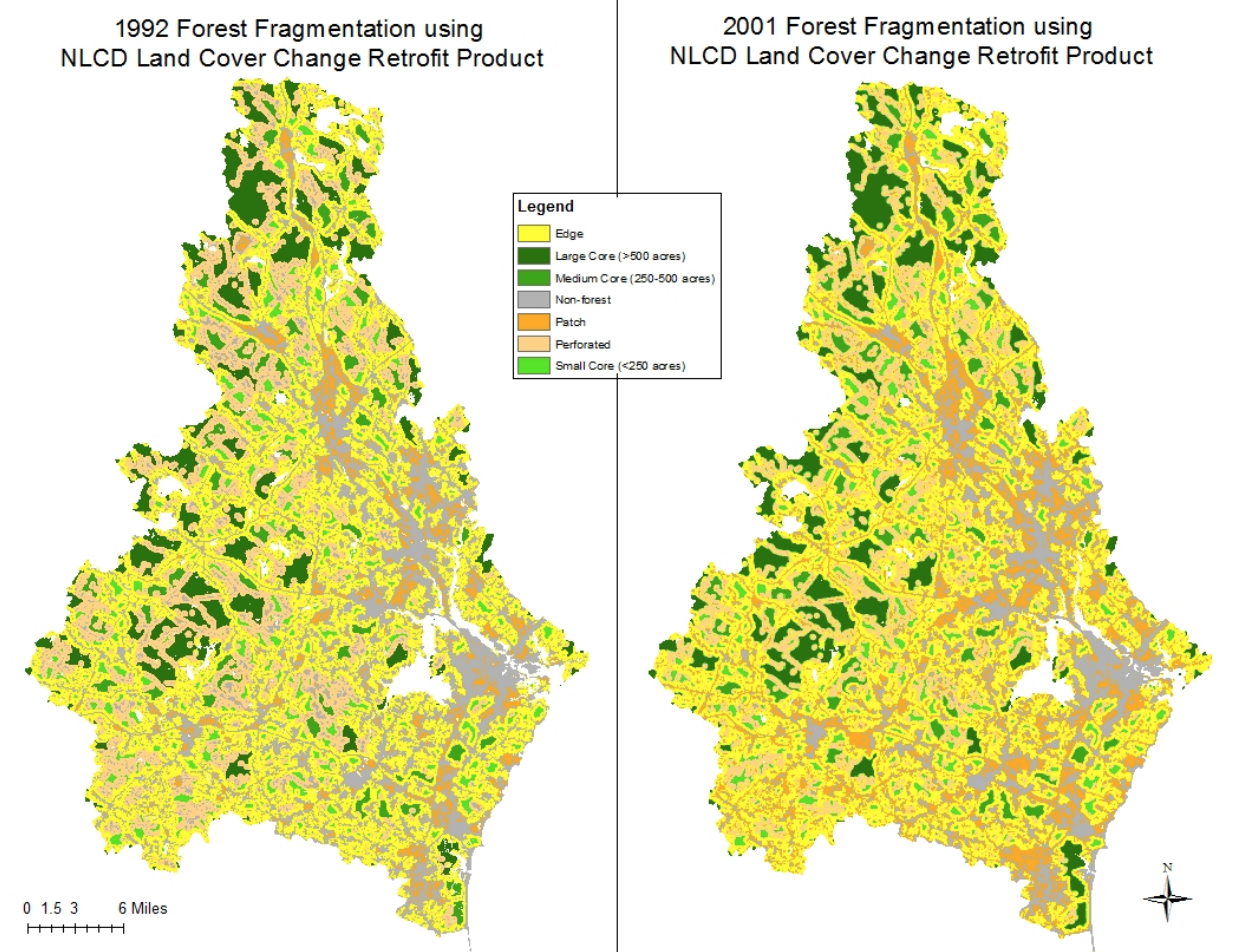
Mapping and analysis of fragmentation in southeastern New Hampshire
1991 to 2001
Summary
This project used the National Land Cover Dataset Land Cover Retrofit product of Coastal Watershed, NH to evaluate various fragmentation techniques including, (1) FRAGSTATS (University of Massachusetts) and (2) the Forest Fragmentation program from the Center for Land Use Education and Research (CLEAR, University of Connecticut), and (3) a number of other image analysis techniques.
Key Personnel & Institutions
People: Meghan MacLean
Institutions: University of New Hampshire, Department of Natural Resources and the Environment
Location
New Hampshire
Resource Type
Article
Tags
fragmentation, fragstats, landcover change, CLEAR
Topic Tags
methods, landscape pattern and connectivity
Purpose Tags
education
Citation
MacLean, M. G., & Congalton, R. G. (2010). Mapping and Analysis of Fragmentation in Southeastern New Hampshire. ISPRS. Retrieved from http://www.isprs.org/proceedings/XXXVIII/part4/files/MacLean.pdf
Source Link
http://www.isprs.org/proceedings/XXXVIII/part4/files/MacLean.pdf
Effects of habitats fragmentation on birds and mammals in landscapes with different proportions of suitable habitat: a review
1993 to 1994
Summary
This review paper outlined the patterns and effects of habitat fragmentation, concluding that in most landscapes the total area of suitable habitat will be of greater importance than its spatial arrangements for species living in this particular habitat.
Key Personnel & Institutions
People: Henrik Andren
Institutions: Swedish University of Agricultural Sciences
Location
No location information available
Resource Type
Article
Tags
fragmentation, habitat fragmentation, random sample hypothesis
Topic Tags
conservation, methods, landscape pattern and connectivity
Purpose Tags
conservation, management
Citation
Andren, H. (1994). Effects of habitat fragmentation on birds and mammals in landscapes with different proportions of suitable habitat: a review. Oikos, pp.355-366.
Source Link
Landscape modification and habitat fragmentation: a synthesis
2006 to 2007
Summary
This review (1) demonstrates that species-oriented and pattern-oriented approaches to understanding the ecology of modified landscapes are highly complementary, (2) clarifies the links between a wide range of interconnected themes, and (3) provides clear and consistent terminology. Tangible research and management priorities are outlined that are likely to benefit the conservation of native species in modified landscapes around the world.
Key Personnel & Institutions
People: Joern Fischer
Institutions: The Australian National University
Location
No location information available
Resource Type
Article
Tags
biodiversity, conservation biology, habitat fragmentation, landscape modification
Topic Tags
conservation, management, landscape pattern and connectivity
Purpose Tags
conservation, management
Citation
Fischer, J., D. B. Lindenmayer. 2007. Landscape modification and habitat fragmentation: a synthesis. Global Ecology and Biogeography, Vol. 16(3), pp.265-280.
Source Link
http://onlinelibrary.wiley.com/doi/10.1111/j.1466-8238.2007.00287.x/full
Fragmentation of continental United States forests
2001 to 2002
Summary
The authors report a multiple-scale analysis of forest fragmentation based on 30-m (0.09 ha pixel) land-cover maps for the conterminous United States. They found that most forest is found in fragmented landscapes suggesting that while forests are connected over large regions, fragmentation may be so pervasive that edge effects potentially influence ecological processes on most forested lands.
Key Personnel & Institutions
People: Kurt Riitters
Institutions: United States Department of Agriculture (USDA), Forest Service , United States Environmental Protection Agency (EPA)
Location
New York, New England
Resource Type
Article
Tags
forest ecology, edge effects, forest fragmentation, landscape pattern, spatial patterns
Topic Tags
landscape pattern and connectivity
Purpose Tags
conservation, management
Citation
Riitters, K.H., Wickham, J.D., O'neill, R.V., Jones, K.B., Smith, E.R., Coulston, J.W., Wade, T.G. & Smith, J.H. (2002). Fragmentation of continental United States forests. Ecosystems, 5(8), pp.0815-0822.
Source Link
New York State forests may be at their peak: report
2014 to 2015
Summary
The overall forest cover of New York State may have reached a peak, according to a new federal report. The U.S. Department of Agriculture's Forest Service conducted an inventory of forests in the state between 2008 and 2012 and found that while forested land is increasing in some areas, fragmentation and invasive pests are destroying trees elsewhere.
Key Personnel & Institutions
People: Joshua Learn
Institutions: The Wildlife Society
Location
New York
Resource Type
Article
Tags
emerald ash borer, forest service, forest fragmentation, hemlock woolly aldelgid, invasives
Topic Tags
management, landscape pattern and connectivity
Purpose Tags
education, policy
Citation
Learn, J. R. (2015, December 4). New York State Forests May Be at Their Peak. The Wildlife Society. Retrieved April 12, 2018, from http://wildlife.org/new-york-state-forests-may-be-at-their-peak-report/
Source Link
http://wildlife.org/new-york-state-forests-may-be-at-their-peak-report/
Housing developments in rural New England: effects on forest birds
1992 to 1993
Summary
This study compared bird assemblages between forests with different housing densities in western Massachusetts. Identified trends suggest that birds of New England's relatively extensive forests may be subject to greater fragmentation effects than generally thought, as a result of increasing rural housing development within forests.
Key Personnel & Institutions
People: Daniel Kluza
Institutions: United States Department of Agriculture (USDA), Forest Service , University of Massachusetts Amherst
Location
HAMPSHIRE, FRANKLIN
Resource Type
Article
Tags
forest birds, forest interior species, housing development, neotropical migrants
Topic Tags
ecosystem services, drivers, landscape pattern and connectivity
Purpose Tags
management, education
Citation
Kluza, D.A., Griffin, C.R. & DeGraaf, R.M. (2000). Housing developments in rural New England: effects on forest birds. In Animal Conservation forum (Vol. 3, No. 1, pp. 15-26). Cambridge University Press.
Source Link
Effect of development on bird species composition of two urban forested wetlands in Staten Island, New York
1988 to 1989
Summary
To evaluate the influence of development on bird species composition, the authors conduced a 2-yr breeding bird census at two urban, forested wetlands in Staten Island, Richmond County, New York. The study indicated that forest islands in New York City can provide nesting habitat for area-sensitive bird species, but development that encroaches upon or degrades these habitats promotes the urbanization of the forest bird community.
Key Personnel & Institutions
People: Christina Dowd
Institutions: New York State Department of Environmental Conservation
Location
Richmond
Resource Type
Article
Tags
forest interior species, forest islands, neotropical migrants, urban birds, urban sprawl, urbanization
Topic Tags
drivers, wildlife and habitat, landscape pattern and connectivity
Purpose Tags
conservation, management
Citation
Dowd, C. (1992). Effect of Development on Bird Species Composition of Two Urban Forested Wetlands in Staten Island, New York. Journal of Field Ornithology, pp.455-461.
Source Link
http://www.jstor.org/stable/pdf/4513743.pdf?refreqid=excelsior%3A982027e9f2e487ffc7df4788440e8758
A spatially hierarchical approach to systematic reserve design in the northern forest of New England
2000 to 2006
Summary
The author employed a hierarchically structured planning unit framework to a heuristic reserve design model for the northern forest of New England. Results of the reserve design models and landscape metrics indicated that a hierarchically structured planning-unit framework may lessen the trade-off between reserve connectivity and cost efficient feature representation, when compared to the three single-scale schemes.
Key Personnel & Institutions
People: Mischa Hey
Institutions: University of Vermont, Wildlife and Fisheries Biology
Location
New England
Resource Type
Article
Tags
community patterns, modeling, wildlife, connectivity, parcelization
Topic Tags
methods, ecosystem services, landscape pattern and connectivity
Purpose Tags
conservation, education
Citation
Hey, M.J. (2006). A Spatially Hierarchical Approach to Systematic Reserve Design in the Northern Forest of New England. MS Thesis, Wildlife and Fisheries Biology, The University of Vermont, Burlington, Vermont. Available at http://primo.uvm.edu/primo-explore/fulldisplay?vid=UVM&docid=UVM_VOYAGER1543535&context=L&search_scope=uvm_voyager&lang=en_US
Source Link
Temporal change in fragmentation of continental US forests
1991 to 2000
Summary
In this study, new temporal land-cover data from the National Land Cover Database were used to estimate changes in forest fragmentation at multiple scales for the continental US. The results indicated that continental US forests were sensitive to forest loss because of their already fragmented state.
Key Personnel & Institutions
People: James Wickham
Institutions: United States Department of Agriculture (USDA), Forest Service , United States Environmental Protection Agency (EPA)
Location
New York, New England
Resource Type
Article
Tags
fragmentation, change, cumulative impacts, forest edge, forest loss, landcover, scale
Topic Tags
drivers, landscape pattern and connectivity
Purpose Tags
management, education
Citation
Wickham, J.D., Riitters, K.H., Wade, T.G. & Homer, C. (2008). Temporal change in fragmentation of continental US forests. Landscape Ecology, 23(8), pp.891-898.
Source Link
https://link.springer.com/content/pdf/10.1007/s10980-008-9258-z.pdf
A resistant-kernel model of connectivity for amphibians that breed in vernal pools
1998 to 2007
Summary
The authors developed a model of connectivity among vernal pools for the four ambystomatid salamanders that occur in Massachusetts and applied it to the nearly 30,000 potential ephemeral wetlands across the state. They found that the most functionally connected pool complexes occurred in southeastern and northeastern Massachusetts, areas with rapidly increasing suburban development.
Key Personnel & Institutions
People: Bradley Compton
Institutions: UMass Amherst Department of Natural Resources Conservation
Location
Massachusetts
Resource Type
Article
Tags
communities, vernal pools, metapopulation, pond-breeding amphibian, resistant-kernel model, seasonal pond
Topic Tags
conservation, wildlife and habitat, landscape pattern and connectivity
Purpose Tags
conservation
Citation
Compton, B.W., McGarigal, K., Kushman, S.A., & Gamble, L.R. (2007). A Resistant-Kernel Model of Connectivity for Amphibians that Breed in Vernal Pools. Society for Conservation Biology. //doi.org/10.1111/j.1523-1739.2007.00674.x
Source Link
Rescaling the human footprint: a tool for conservation planning at an ecoregional scale
2001 to 2002
Summary
The authors mapped the Human Footprint for the Northern Appalachian/Acadian ecoregion at a 90-m resolution using best available data on human settlement, access, land use change, and electrical power infrastructure.
Key Personnel & Institutions
People: Gillian Woolmer , Gillian Woolmer
Institutions: Wildlife Conservation Society of Canada
Location
No location information available
Resource Type
Map
Tags
fragmentation, connectivity, human impacts
Topic Tags
No topic tag keywords available
Purpose Tags
No purpose tag keywords available
Citation
Woolmer, G., Trombulak, S.C., Ray, J.C., Doran, P.J., Anderson, M.G., Baldwin, R.F., Morgan, A. & Sanderson, E.W. (2008). Rescaling the human footprint: a tool for conservation planning at an ecoregional scale. Landscape and Urban Planning, 87(1), pp.42-53. //doi.org/10.1016/j.landurbplan.2008.04.005
Source Link
https://2c1forest.databasin.org/galleries/ff9e496d5eb14aadafa22064462c5e65#expand=56591
Fragmentation of forest communities in the eastern United States
2010 to 2011
Summary
The authors combined forest inventory data with land cover data to compare 70 forest communities in terms of the amount and ownership of intact (i.e., not fragmented) forest, and the proximate causes (i.e., adjacent land cover) of fragmentation. The results provide insight for targeting land management strategies to maintain the diversity and regional distributions of intact forest communities.
Key Personnel & Institutions
People: Kurt Riiters , Kurt Riitters
Institutions: United States Department of Agriculture (USDA), Forest Service , United States Environmental Protection Agency (EPA)
Location
VERMONT, Massachusetts, Maine, New York, New Hampshire
Resource Type
Article
Tags
fragmentation, edge effects, fragmentation drivers, indicators
Topic Tags
management, drivers, landscape pattern and connectivity
Purpose Tags
management, education
Citation
Riitters, K.H., Coulston, J.W. & Wickham, J.D. (2012). Fragmentation of forest communities in the eastern United States. Forest Ecology and Management, 263, pp.85-93. //doi.org/10.1016/j.foreco.2011.09.022
Source Link
https://www.srs.fs.usda.gov/pubs/ja/2011/ja_2011_riitters_001.pdf
Use of road maps in national assessments of forest fragmentation in the United States
2003 to 2004
Summary
The authors compared forest fragmentation as calculated from high-resolution land-cover maps alone (Method 1) and after superimposing detailed road maps (Method 2) and fond that there was more overall fragmentation with Method 2. The results emphasize that the question of incorporating road maps must consider the purpose of the assessment, the characteristics of the data, and the relative sensitivities of indices to different patterns of fragmentation.
Key Personnel & Institutions
People: Kurt Riiters
Institutions: United States Department of Agriculture (USDA), Forest Service , United States Environmental Protection Agency (EPA)
Location
New York, New England
Resource Type
Article
Tags
fragmentation, road networks, road-caused fragmentation, superimposed imagery
Topic Tags
methods, landscape pattern and connectivity
Purpose Tags
conservation, management, education
Citation
Riiters, K., Wickham, J. & Coulston, J. (2004). Use of Road Maps in National Assessments of Forest Fragmentation in the United States. Ecology and Society 9(2): 13.
Source Link
Forest fragmentation and risk of giardiasis in New York State
1999 to 2009
Summary
This study examined 11 years of surveillance data in New York State to measure the relationship between forest fragmentation and the incidence of giardiasis. Adjusted Poisson models showed that increasing points of contact between forested land and developed land, as measured by their shared edges and by the perimeter length of forested patches, were associated with higher incidence of giardiasis cases, whereas increasing forest density was associated with a lower incidence.
Key Personnel & Institutions
People: Michael Walsh
Institutions: The State University of New York (SUNY), School of Public Health, Department of Epidemiology and Biostatistics
Location
New York
Resource Type
Article
Tags
forest fragmentation, giardia, giardiasis, landscape epidemiology
Topic Tags
planning, drivers, landscape pattern and connectivity
Purpose Tags
management, education
Citation
Walsh, M.G. (2013). Forest fragmentation and risk of giardiasis in New York State. EcoHealth, 10(4), pp.405-414.
Source Link
https://link.springer.com/content/pdf/10.1007%2Fs10393-013-0881-z.pdf
Forest fragmentation and its implications in central New York
1984 to 1985
Summary
The author performed an inventory of current forested areas in Onondaga County, NY using aerial photographs. The results showed that many forest islands were isolated by agricultural, industrial, and urban development, and as a result were so small and so isolated from areas of similar types that they may degenerate into a non-forested condition.
Key Personnel & Institutions
People: Deborah Gill
Institutions: The State University of New York (SUNY), College of Environmental Science and Forestry
Location
Onondaga
Resource Type
Article
Tags
agricultural development, forest islands, urbanization
Topic Tags
management, drivers, landscape pattern and connectivity
Purpose Tags
conservation, management
Citation
Hill, D.B. (1985). Forest fragmentation and its implications in central New York. Forest Ecology and Management, 12(2), pp.113-128.
Source Link
https://www.sciencedirect.com/science/article/abs/pii/0378112785900799
Patterns of deforestation and reforestation in different landscape types in central New York
1937 to 1977
Summary
The authors documented the change in density and size of forest islands within individual landscape types of central New York. They found that the intensity of landscape use determined the frequency of fragmentation, elimination, consolidation and emergence of forest islands.
Key Personnel & Institutions
People: Wayme Zipperer
Institutions: United States Department of Agriculture (USDA), Forest Service , The State University of New York (SUNY), College of Environmental Science and Forestry
Location
Onondaga
Resource Type
Article
Tags
deforestation, forest islands, reforestation
Topic Tags
management, drivers, landscape pattern and connectivity
Purpose Tags
conservation, management
Citation
Zipperer, W.C., Burgess, R.L. & Nyland, R.D. (1990). Patterns of deforestation and reforestation in different landscape types in central New York. Forest Ecology and Management, 36(1), pp.103-117.
Source Link
https://www.sciencedirect.com/science/article/abs/pii/037811279090066K
The development of forest islands in exurban central New York state
1985 to 1986
Summary
The authors investigated the composition and characteristics of forestland in Onondaga County in central New York State. The results suggest that tree species composition was less diverse than in the residual islands which were never cleared for protracted agricultural use. Overall, available data suggest the prevalence of fairly homogeneous structural conditions across most forest stands.
Key Personnel & Institutions
People: R. Nyland
Institutions: United States Department of Agriculture (USDA), Forest Service , The State University of New York (SUNY), College of Environmental Science and Forestry
Location
Onondaga
Resource Type
Article
Tags
clearcuts, forest regeneration, agricultural development, forest islands
Topic Tags
drivers, wildlife and habitat, landscape pattern and connectivity
Purpose Tags
management
Citation
Nyland, R.D., Zipperer, W.C. & Hill, D.B. (1986). The development of forest islands in exurban central New York State. Landscape and Urban Planning, 13, pp.111-123.
Source Link
Forest fragmentation in Massachusetts, USA: a town-level assessment using morphological spatial pattern analysis and affinity propagation
2015 to 2016
Summary
The authors classified the pattern of forests in Massachusetts using fragmentation indicators to address these objectives: 1) characterize the spatial pattern of forest fragmentation in Massachusetts towns using Morphological Spatial Pattern Analysis, and (2) identify regional trends using archetypal towns in relation to town history, geography and socioeconomic characteristics. We identified six representative towns that typify different types of forest fragmentation.
Key Personnel & Institutions
People: J. Rogan
Institutions: United States Department of Agriculture (USDA), Forest Service , United States Department of Agriculture (USDA), Forest Service, Northern Research Station , Clark University, Clark Graduate School of Geography, Université de Montréal, Département de Géographie, McGill University, Department of Natural Resource Sciences and McGill School of Environment, Temple University, Geography and Urban Studies Department, Clark University, Department of International Development, Community, and Environment, US Forest Service, Research Triangle Park
Location
Massachusetts
Resource Type
Article
Tags
affinity propagation, forest fragmentation, morphological spatial pattern analysis
Topic Tags
methods, landscape pattern and connectivity
Purpose Tags
education
Citation
Rogan, J., Wright, T.M., Cardille, J., Pearsall, H., Ogneva-Himmelberger, Y., Riemann, R., Riitters, K. & Partington, K. (2016). Forest fragmentation in Massachusetts, USA: A town-level assessment using Morphological spatial pattern analysis and affinity propagation. GIScience & Remote Sensing, 53(4), pp.506-519.
Source Link
https://www.srs.fs.usda.gov/pubs/ja/2016/ja_2016_riitters_001.pdf
Relationships among North American songbird trends, habitat fragmentation, and landscape occupancy
1969 to 1979
Summary
The authors used Breeding Bird Survey data and associated landscape metrics to test the hypothesis that range-wide population change in species for which habitat fragmentation negatively affects reproductive success should depend on the proportion of the population that actually occupies fragmented landscapes. The results indicated a significant, negative relationship between the proportion of the breeding population occupying fragmented landscapes and the population trend from 1970 to 1980.
Key Personnel & Institutions
People: Therese Donovan
Institutions: United States Department of Agriculture (USDA), Forest Service , The State University of New York (SUNY), College of Environmental Science and Forestry (ESF)
Location
VERMONT, Massachusetts, Maine, New York, New Hampshire
Resource Type
Article
Tags
fragmentation, songbirds, bird survey, landscape occupancy
Topic Tags
ecosystem services, wildlife and habitat, landscape pattern and connectivity
Purpose Tags
education
Citation
Donovan, T.M. & Flather, C.H. (2002) Relationships Amoung North American Songbird Trends, Habitat Fragmentation, and Landscape Occupancy. Ecolocial Applications. 12(2): 346-374
Source Link
Use of FIA data and GIS to characterize the effects of fragmentation on the forests of New Hampshire
2008 to 2009
Summary
The authors used a raster land-cover classification of New Hampshire to characterize the level of fragmentation and urbanization in the local neighborhood surrounding each forested Forest Inventory and Analysis (FIA) plot. Findings highlight the forest-type groups that are in the most fragmented and urbanized conditions, and make comparisons between fragmentation metrics and stand characteristics.
Key Personnel & Institutions
People: Randall Morin
Institutions: United States Department of Agriculture (USDA), Forest Service
Location
New Hampshire
Resource Type
Article
Tags
forest health, forest inventory, forest structure, forest composition, forest fragmentation, landcover, urbanization
Topic Tags
wildlife and habitat, landscape pattern and connectivity
Purpose Tags
conservation, management, education
Citation
Morin, R. S., Lister, A., & Doyle, J. (2009). Use of FIA Data and GIS to Characterize the Effects of Fragmentation on the Forests of New Hampshire. USDA Forest Service, Northern Research Station. Retrieved from https://www.nrs.fs.fed.us/pubs/jrnl/2009/nrs_2009_morin_001.pdf
Source Link
Effects of small forest openings on the breeding bird community in a Vermont hardwood forest
1990 to 1991
Summary
The authors examined the response of a forest bird community to the presence of small openings created by patch clear-cutting 0.4-ha plots within an extensive northern hardwood forest. Overall, bird species diversity increased in forested areas containing small openings due to the addition of edge and open- area nesters, but several forest-interior species were adversely affected by the presence of openings.
Key Personnel & Institutions
People: Dave Capen , Stephen Germaine, Stephen Vessey, Stephen Germaine , Stephen Vessey
Institutions: University of Vermont, Rubenstein School of Environment and Natural Resources , Bowling Green State University, Department of Biological Sciences
Location
No location information available
Resource Type
Article
Tags
birds, forest management, wildlife, fragmentation
Topic Tags
No topic tag keywords available
Purpose Tags
No purpose tag keywords available
Citation
Germaine, S.S., Vessey, S.H. & Capen, D.E. (1997). Effects of small forest openings on the breeding bird community in a Vermont hardwood forest. Condor, pp.708-718.
Source Link
https://sora.unm.edu/sites/default/files/journals/condor/v099n03/p0708-p0718.pdf
Effect of clearcut borders on distribution and abundance of forest birds in northern New Hampshire
1991 to 1992
Summary
The authors compared numbers of forest bird territories between forest edge and forest interior areas to determine whether clearcuts affect bird abundance in adjacent forest. While some birds were less abundant in edge areas, the distribution of these species did not differ from the distribution of randomly placed simulated territories.
Key Personnel & Institutions
People: David King , Richard DeGraaf , Curtice Griffin
Institutions: Wilson Ornithological Society
Location
New Hampshire
Resource Type
Article
Tags
clearcuts, bird abundance, forest edge, neotropical migrants
Topic Tags
ecosystem services, wildlife and habitat
Purpose Tags
conservation, education
Citation
King, D.I., Griffin, C.R. & DeGraaf, R.M. (1997). Effect of clearcut borders on distribution and abundance of forest birds in Northern New Hampshire. The Wilson Bulletin, pp.239-245.
Source Link
http://www.jstor.org/stable/pdf/4163807.pdf?refreqid=excelsior:a04ef66e23c177ec278c02debe6a86c0
Effect of even-aged timber management on bird species diversity and composition in northern hardwoods of New Hampshire
1988 to 1989
Summary
The objective was to determine the effects of even-aged timber management on bird species diversity and composition in an extensively forested landscape, the White Mountain National Forest in New Hampshire. The authors found that bird species diversity was greater on managed than on reserved areas, and there were no species unique to reserved areas.
Key Personnel & Institutions
People: Christopher Welsh
Institutions: The Wildlife Society
Location
Coos, Carroll
Resource Type
Article
Tags
timber harvest, edge habitat, neotropical migrants
Topic Tags
management, ecosystem services, wildlife and habitat, landscape pattern and connectivity
Purpose Tags
conservation, management, education
Citation
Welsh, C.J. & Healy, W.M. (1993). Effect of even-aged timber management on bird species diversity and composition in northern hardwoods of New Hampshire. Wildlife Society Bulletin, pp.143-154.
Source Link
http://www.jstor.org/stable/pdf/3782916.pdf?refreqid=excelsior%3A340771089c7a3322a0d2ec7093060abd
Reversing the fragmentation perspective: effects of clearcut size on bird species richness in Maine
1988 to 1989
Summary
The authors examined the effects of clearcut size on bird species richness in a forest-dominated landscape in eastern Maine. They found that species richness increased with clearcut size but the number of species present per plot did not differ significantly over the size range of cuts.
Key Personnel & Institutions
People: Tamia Rudnicky
Institutions: University of Maine
Location
Baring Plt, Hancock, Washington
Resource Type
Article
Tags
clearcuts, bird species richness, edge effects, forest fragmentation, landscape ecology, patch size
Topic Tags
ecosystem services, wildlife and habitat, landscape pattern and connectivity
Purpose Tags
management, education
Citation
Rudnicky, T.C. & Hunter, M.L., (1993). Reversing the fragmentation perspective: effects of clearcut size on bird species richness in Maine. Ecological Applications, 3(2), pp.357-366.
Source Link
http://www.jstor.org/stable/pdf/1941838.pdf?refreqid=excelsior:66a4deafcb1c6633bf0c10cda580a9c4
Impacts of forest fragmentation on species richness: a hierarchical approach to community modelling
2005 to 2006
Summary
The authors developed a hierarchical model to assess the community response of breeding birds in the Hudson River Valley, New York, to habitat fragmentation and analysed the model using a Bayesian approach. The model revealed that species richness of the observed bird community was maximized in small forest fragments with a high perimeter/area ratio.
Key Personnel & Institutions
People: Elise Zipkin , Amielle DeWan , Andrew Royle
Institutions: Cornell University, Hudson River Estuary Program , United States Geological Survey (USGS), Patuxent Wildlife Research Center
Location
Columbia, Dutchess, Greene, Orange, Putnam, Rensselaer, Rockland, Ulster, Westchester
Resource Type
Article
Tags
biodiversity, species richness, fragmentation, occupancy modeling, hierarchical modeling, imperfect detection
Topic Tags
methods, ecosystem services, wildlife and habitat, landscape pattern and connectivity
Purpose Tags
conservation, management, education
Citation
Zipkin, E.F., DeWan, A. & Andrew Royle, J. (2009). Impacts of forest fragmentation on species richness: a hierarchical approach to community modelling. Journal of Applied Ecology, 46(4), pp.815-822.
Source Link
https://blogs.cornell.edu/hudsonbiodiversity/files/2016/10/Zipkin_DeWan_Royle_2009-1i83ib0.pdf
Abundance and productivity of forest songbirds in a managed, unfragmented landscape in Vermont
1992 to 1998
Summary
The authors studied a breeding songbird community in a landscape characterized by scattered openings in a forest matrix in Vermont from 1993 to 1994. At the scale of this study, a minimal amount of canopy removal in the extensively forested landscape did not affect abundance and overall productivity of songbirds inhabiting the remaining forest, but canopy removal had begun to suppress productivity of some forest interior species
Key Personnel & Institutions
People: Ernest Buford
Institutions: University of Vermont
Location
MIDDLEBURY, ROCHESTER, GREEN MOUNTAIN RANGE
Resource Type
Article
Tags
productivity, fragmentation, songbirds
Topic Tags
conservation, management, ecosystem services, wildlife and habitat, landscape pattern and connectivity
Purpose Tags
conservation, management, education
Citation
Buford, E.W. & Capen, D.E. (1999). Abundance and productivity of forest songbirds in a managed, unfragmented landscape in Vermont. The Journal of wildlife management, pp.180-188.
Source Link
http://www.jstor.org/stable/pdf/3802499.pdf?refreqid=excelsior:a7e65640fb80d7ccb25f86928c2127c6
Increasing forest resiliency for an uncertain future
2015 to 2016
Summary
The goal of this publication was to provide landowners, foresters, conservation organizations, and municipal officials a framework for addressing emerging challenges in an integrated way that is specific to forestland and takes into consideration individual goals, available time, and resources.
Key Personnel & Institutions
People: Paul Catanzaro , Anthony D'Amato , Emily Huff
Institutions: University of Vermont , United States Department of Agriculture (USDA), Forest Service, Northern Research Station , University of Massachusetts Amherst
Location
New England
Resource Type
Report
Tags
climate change, conservation, carbon sequestration, forest conversion, forest stressors, invasives
Topic Tags
methods, ecosystem services, planning
Purpose Tags
conservation, education
Citation
Catanzaro, P., D'Amato, A., & Huff, E.S. (2016). Increasing forest resiliency for an uncertain future. Report for the USDA Forest Service. Available at https://masswoods.net/sites/masswoods.net/files/Forest-Resiliency.pdf
Source Link
http://masswoods.org/sites/masswoods.net/files/Forest-Resiliency.pdf
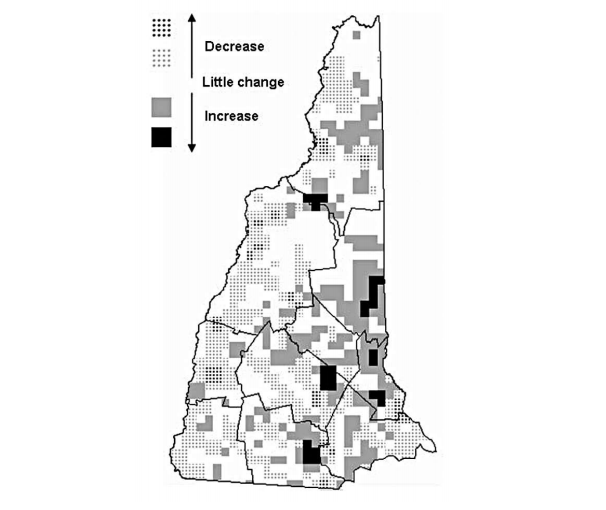
Identifying areas of relative change in forest fragmentation in New Hampshire between 1990 and 2000
1989 to 2000
Summary
In this study, the authors developed new landcover classifications from Landsat imagery data acquired in 1990 and 2000 for New Hampshire, assessed fragmentation in both time periods, and created maps depicting the spatial extent of fragmentation change through time.
Key Personnel & Institutions
People: Tonya Lister
Institutions: United States Department of Agriculture (USDA), Forest Service , United States Department of Agriculture (USDA), Forest Service, Northeastern Research Station , United States Department of Agriculture (USDA), Forest Inventory and Analysis, FIA
Location
New Hampshire
Resource Type
Article
Tags
landsat, fragmentation, fia, edge effects, parcelization, spatial assessment
Topic Tags
management, ecosystem services, planning, landscape pattern and connectivity
Purpose Tags
management, education
Citation
Lister, T., Lister, A., McWilliams, W. & Riemann, R. (2007). Identifying areas of relative change in forest fragmentation in New Hampshire between 1990 and 2000. In: McRoberts, Ronald E.; Reams, Gregory A.; Van Deusen, Paul C.; McWilliams, William H., eds. Proceedings of the seventh annual forest inventory and analysis symposium; October 3-6, 2005; Portland, ME. Gen. Tech. Rep. WO-77. Washington, DC: US Department of Agriculture, Forest Service: 89-95. (Vol. 77).
Source Link
Effects of forest roads on habitat quality for ovenbirds in a forested landscape
1996
Summary
The authors studied the influence of forest roads on Ovenbird density in an extensively forested region of Vermont, evaluating habitat use and reproductive success relative to mechanisms proposed to explain the density-edge relationship. They concluded that habitat quality for Ovenbirds may be lower within 150 m of unpaved roads in extensive forested landscapes, affecting territory density and possibly reproductive success.
Key Personnel & Institutions
People: Yvette Ortega
Institutions: University of Vermont
Location
MIDDLEBURY, GREEN MOUNTAIN RANGE
Resource Type
Article
Tags
forest edge, forest interior species, neotropical migrants
Topic Tags
wildlife and habitat, landscape pattern and connectivity
Purpose Tags
management, education
Citation
Ortega, Y.K. and Capen, D.E. (1999). Effects of forest roads on habitat quality for ovenbirds in a forested landscape. The Auk, pp.937-946.
Source Link
http://www.jstor.org/stable/pdf/4089673.pdf?refreqid=excelsior:e1e7a6099fe76ce140970d49029c768d
Ski trail effects on a beetle (Coleoptera: Carabidae, Elateridae) community in Vermont
2000
Summary
The authors studied beetle diversity and species composition using pitfall traps placed along three parallel transects that extended from the center of a downhill ski trail, 100 m into a large, unfragmented spruce-fir forest on Mount Mansfield State Park, VT. The results suggest that ski trails were strong barriers to dispersal for forest beetles, several of which were flightless or dimorphic and primarily short-winged.
Key Personnel & Institutions
People: Allan Strong
Institutions: University of Vermont
Location
CHITTENDEN, LAMOILLE, WASHINGTON
Resource Type
Article
Tags
fragmentation, dispersal barriers, edge effects, montane forests, skiing
Topic Tags
conservation, wildlife and habitat, landscape pattern and connectivity
Purpose Tags
management, education
Citation
Strong, A.M., Dickert, C.A. and Bell, R.T. (2002). Ski trail effects on a beetle (Coleoptera: Carabidae, Elateridae) community in Vermont. Journal of Insect Conservation, 6(3), pp.149-159.
Source Link
https://link.springer.com/content/pdf/10.1023/A:1023223532149.pdf
A global evaluation of forest interior area dynamics using tree cover data from 2000 to 2012
2014 to 2015
Summary
The authors assessed global and regional changes in forest fragmentation in relation to the change of forest area from 2000 to 2012 using published global tree cover data.
Key Personnel & Institutions
People: James Wickham , Kurt Riitters , Jennifer Costanza
Institutions: United States Department of Agriculture (USDA), Forest Service, Southern Research Station , United States Environmental Protection Agency (EPA) , North Carolina Cooperative Fish and Wildlife Research Unit
Location
New York, New England
Resource Type
Article
Tags
monitoring, spatial analysis, assessment, forest fragmentation
Topic Tags
methods, landscape pattern and connectivity
Purpose Tags
education
Citation
Riitters, K., Wickham, J., Costanza, J. K., & Vogt, P. (2016). A global evaluation of forest interior area dynamics using tree cover data from 2000 to 2012. Landscape Ecology, 31(1), 137-148.
Source Link
Effect of forest fragmentation on lyme disease risk
2001 to 2002
Summary
The authors comparted density of infected nymphal blacklegged ticks, which is the primary risk factor for Lyme disease, in small and large forest patches. They found a significant linear decline in nymphal infection prevalence with increasing patch area and a significant exponential decline in nymphal density with increasing patch area.
Key Personnel & Institutions
People: Brian F. Allan
Institutions: Cary Institute of Ecosystem Studies , Rutgers University, Bard College, Department of Biology
Location
Dutchess
Resource Type
Article
Tags
ecology, forests, impacts, lyme disease, public health, ticks
Topic Tags
ecosystem services, landscape pattern and connectivity
Purpose Tags
conservation, education
Citation
Allan, B.F., Keesing, F. & Ostfeld, R.S. (2003). Effect of forest fragmentation on Lyme disease risk. Conservation Biology, 17(1), pp.267-272.
Source Link
https://onlinelibrary.wiley.com/doi/epdf/10.1046/j.1523-1739.2003.01260.x
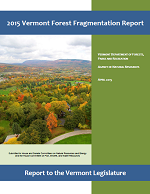
2015 Vermont Forest Fragmentation Report
2014 to 2015
Summary
This report focuses on the issue arising in fragmentation in Vermont from the years of land-use and deforestation. With a vast majority of the land privately and publicly owned by residents, foretes have isolated from one another and lost their enrichment of wildlife and tree species.
Key Personnel & Institutions
People: Michael Snyder
Institutions: Vermont Forest Parks and Recreation
Location
VERMONT
Resource Type
Report
Tags
water quality, wildlife, fragmentation, advocacy, decision making, edge effects, parcelization, policy
Topic Tags
ecosystem services, landscape pattern and connectivity
Purpose Tags
conservation, policy
Citation
Vermont Department of Forests, Parks and Recreation. (2015). 2015 Vermont Forest Fragmentation Report. Vermont Department of Forests, Parks and Recreation. 62 p.
Source Link
An enduring place: wildlife and people in the Worcester Range through the Northeastern Highlands
2011 to 2012
Summary
This report outlines the key habitat features that make the Worcester Range and Northeastern Highlands region important to Vermont's people and animals.
Key Personnel & Institutions
People: Tom Slayton
Institutions: Vermont Fish & Wildlife Dept. , National Wildlife Federation
Location
VERMONT
Resource Type
Report
Tags
conservation, habitat connectivity, northeastern highlands, Worcester range
Topic Tags
ecosystem services, landscape pattern and connectivity
Purpose Tags
conservation
Citation
Slayton, T. (2012). An enduring place: wildlife and people in the Worcester Range through the Northeastern Highlands. Staying Connected Initative.
Source Link
Analysis of the drivers of urban growth and second home development in the Nothern Forest Region of Vermont
2011 to 2012
Summary
The authors applied the land use change model UrbanSim to Vermont's Northern Forest region to assess future patterns of urban, suburban, exurban and rural residential development under baseline conditions and alternative infrastructure investment and land use policy scenarios.
Key Personnel & Institutions
People: Austin Troy , Brian Voigt
Institutions: University of Vermont, Rubenstein School of Environment and Natural Resources , Northeastern States Research Cooperative
Location
VERMONT
Resource Type
Report
Tags
fragmentation, forest, forest planning, parcelization, residential management
Topic Tags
landscape pattern and connectivity
Purpose Tags
management
Citation
Troy, A. and Voigt, B. (2012). Analaysis of the drivers of urban growth and second home development in the Northern Forest Region of Vermont. University of Vermont, Rubenstein School of Environment and Natural Resources and Northeastern States Research Cooperative. Retrieved from http://nsrcforest.org/sites/default/files/uploads/troy08full.pdf.
Source Link
http://nsrcforest.org/sites/default/files/uploads/troy08full.pdf
Anticipated effects of development on habitat fragmentation and movement of mammals into and out of the Schoodic District, Acadia National Park, Maine
2011 to 2012
Summary
In this study, we examined habitat fragmentation consequences owing to a planned 1,295 hectare development by Winter Harbor Holding Company (WHHC) adjacent to the Schoodic District of Acadia National Park (ANP), Maine. Specifically, we examined the effects of development on (a) core natural habitat area (a cross-habitat indicator of fragmentation), (b) the suitability of habitat for bobcat, fisher, mink, and moose, and (c) the movement of these four species between ANP and other nearby protected areas (species specific indicators of fragmentation).
Key Personnel & Institutions
People: Jason Rohweder
Institutions: United States Geological Survey (USGS) , National Park Service, NPS, United States Department of the Interior
Location
Maine
Resource Type
Report
Tags
species, habitat, fragmentation, development, analysis, suitable habitat
Topic Tags
ecosystem services, landscape pattern and connectivity
Purpose Tags
education
Citation
Rohweder, J.J., De Jager, N.R., and Guntenspergen, G.R. (2012). Anticipated effects of development on habitat fragmentation and movement of mammals into and out of the Schoodic District, Acadia National Park, Maine. U.S. Geological Survey Scientific Investigations Report. 30 p.
Source Link
https://pubs.usgs.gov/sir/2012/5149/pdf/sir2012-5149_web.pdf
Wildlife Connectivity Study Final Report (Bolton Waterbury STP 2709(1))
2012 to 2014
Summary
This study was undertaken to answer pertinent questions about wildlife habitat, mortiality, and zone from Bolton to Waterbury, VT, particularly relating to the I89 highway corridor.
Key Personnel & Institutions
People: Johnson McFarland
Institutions: Vermont Fish & Wildlife Dept. , Vermont Agency of Transportation, VTrans
Location
BOLTON, WATERBURY
Resource Type
Report
Tags
endangered species, wildlife, highway systems, infrastructure planning, policy
Topic Tags
ecosystem services, drivers
Purpose Tags
management, policy
Citation
Johnson, M. & Andrews, J.S. (2016). Bolton Waterbury STP 2709(1) Wildlife Connectivity Study Final Report. Vermont Fish and Wildlife and Vermont Agency of Transportation. 91 p.
Source Link
http://stayingconnectedinitiative.org/assets/I-89_Wildlife_Connectivity_FINAL___.pdf
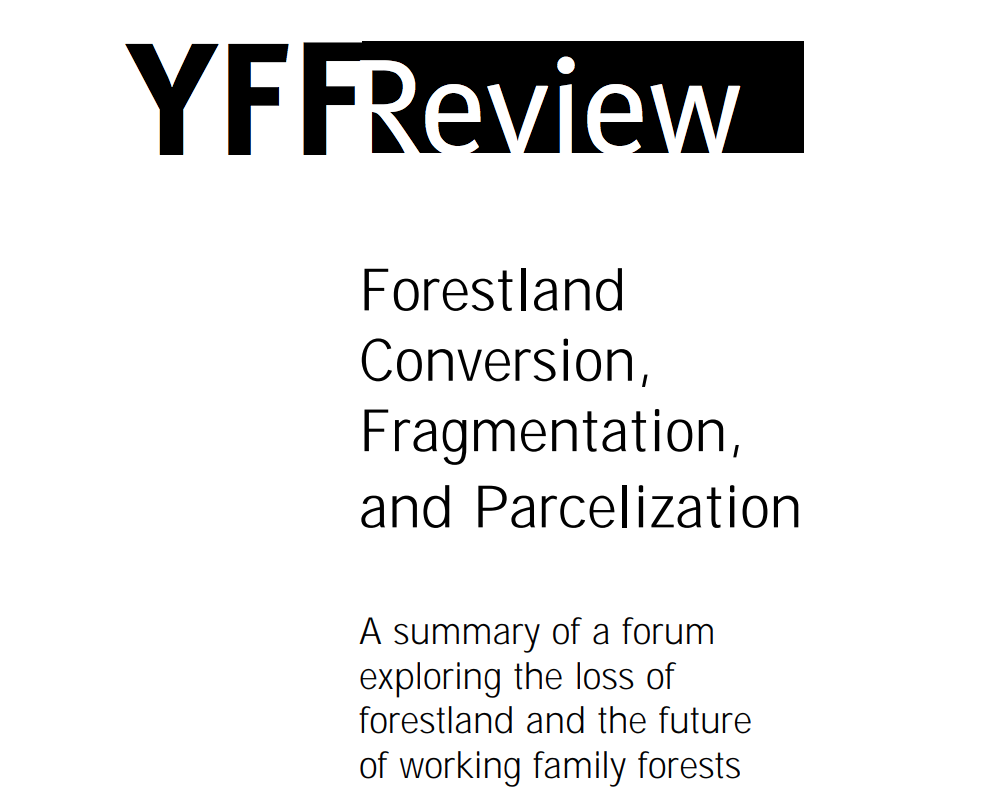
Forestland, conversion, fragmentation, and parcelization: A summary of a forum exploring the loss of forestland and the future of working family forests
2000
Summary
The Yale Forest Forum and the Southern New England Forest Consortium hosted a public forum and workshop titled 'A Fragmented End? How Parcelization and Land Use Conversion May Mark the End of Working Family Forests' at the Yale School of Forestry and Environmental Studies in New Haven, Connecticut in 2000. The purpose of the forum was to discuss the potential risk of forest fragmentation, parcelization, and land use conversion on the viability of working family forests specifically to address the scope, impact, possible solutions, policy implications, and research priorities.
Key Personnel & Institutions
People: Mary Tyrrell
Institutions: Yale University, School of Forestry and Environmental Studies
Location
New Hampshire
Resource Type
Report
Tags
fragmentation, education, forum, planning
Topic Tags
management, planning
Purpose Tags
management, education
Citation
Tyrrell, M. and Dunning, G. (Eds.). (2000). Forestland, Conversion, Fragmentation, and Parcelization: A summary of a forum exploring the loss of forestland and the future of working family forests. Yale Forest Forum Series: 3 (6).
Source Link
From the Adirondacks to Acadia: a wildlands network design for the greater northern Appalachians
2005 to 2006
Summary
This study examined a conservation plan designed to systematically identify a network of areas of high conservation priority within the Northern Appalachian/Acadian and St. Lawrence/Champlain Valley ecoregions of the northeastern United States and southeastern Canada.
Key Personnel & Institutions
People: Conrad Reining, Karen Beazley, Patrick Doran, Charlie Bettigole
Institutions: Wildlands Network
Location
VERMONT, Maine, New York, New Hampshire
Resource Type
Report
Tags
conservation, fragmentation
Topic Tags
conservation
Purpose Tags
conservation, education
Citation
Reining, C., Beazley, K., Doran, P. and Bettigole, C. (2006). From the Adirondacks to Acadia: a wildlands network design for the greater Northern Appalachians. Wildlands Project. Richmond, VT. 60 p.
Source Link
https://wildlandsnetwork.org/resources/adirondacks-to-acadia-wildlands-network-design
Implementing conservation plans through municipal land use planning
2014 to 2015
Summary
This research addresses the conservation research-implementation gap by developing a framework relating science-based conservation plans, local and regional government planning capacity, and municipal government policy actions.
Key Personnel & Institutions
People: Margaret Bryant
Institutions: Northeastern States Research Cooperative , Staying Connected Initiative
Location
VERMONT, New York
Resource Type
Report
Tags
climate change, monitoring, conservation implementation, residential management
Topic Tags
conservation, management
Purpose Tags
conservation, management
Citation
Byrant, M.M. (2015). Implementing Conservation Plans Through Municipal Land Use Planning. Nothern States Research Cooperative (NSRC). Retrieved from http://nsrcforest.org/sites/default/files/uploads/bryant12full.pdf.
Source Link
http://nsrcforest.org/sites/default/files/uploads/bryant12full.pdf
Indicators of streamflow alteration, habitat fragmentation, impervious cover, and water quality for Massachusetts stream basins
2008 to 2009
Summary
This report details the indicators that were developed to characterize types of potential alteration for sub-basins and groundwater contributing areas in Massachusetts.
Key Personnel & Institutions
People: P. Weiskel
Institutions: United States Geological Survey (USGS)
Location
Massachusetts
Resource Type
Report
Tags
land use, water quality, streamflow, forests, fragmentation, impervious cover
Topic Tags
ecosystem services, landscape pattern and connectivity
Purpose Tags
education
Citation
Weiskel, P. K., Brandt, S. L., DeSimone, L. A., Ostiguy, L. J., & Archfield, S. A. (2010). Indicators of streamflow alteration, habitat fragmentation, impervious cover, and water quality for Massachusetts stream basins. US Department of the Interior, US Geological Survey. 70 p.
Source Link
https://pubs.usgs.gov/sir/2009/5272/pdf/sir2009-5272_text.pdf
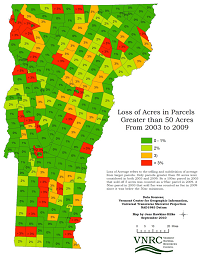
Informing land use planning and forestland conservation through subdivision and parcelization trend information
2002 to 2010
Summary
The authors analyzed subdivision trends in Vermont by using state Grand List data for 2003 and 2009 to establish a database of parcels of land in the state, compiled by class size. The analysis goals were to: (1) quantify the extent of subdivision and the degree to which subdivision is affecting the viability of undeveloped land for resource management; (2) quantify and understand the extent to which residential development is occurring on parcels that are larger than needed for a residence; and (3) investigate and document paaerns that may be relevant for policies and programs that support resource management and/or discourage fragmentation.
Key Personnel & Institutions
People: Deb Brighton
Institutions: Northeastern States Research Cooperative , Vermont Natural Resources Council
Location
FLETCHER, STOWE, ELMORE, CALAIS, MIDDLESEX, NORWICH, BENNINGTON, HINESBURG
Resource Type
Report
Tags
resource management, fragmentation, forest stewardship, parcelization, policy, policy making, wildlife conservation
Topic Tags
management
Purpose Tags
conservation, management, policy
Citation
Brighton, D., Fidel, J., Shupe, B., Sinclair, S. and Austin, J. (2010). Informing land use planning and forestland conservation through subdivision and parcelization trend information. Vermont Natural Resources Council.
Source Link
https://drive.google.com/file/d/1rnkZm13s_NGiv46Xvcrpef-OEmIxYbq_/view
New Hampshire's forestry regulations: forest health
1994 to 1995
Summary
This New Hampshire act establishes the importance of monitoring and assessing of the status of changes and long-term trends in the health of the state's forests and the ability to detect and reduce the incidence and severity of forest insect and disease infestations.
Key Personnel & Institutions
Institutions: State of New Hampshire
Location
New Hampshire
Resource Type
Policy
Tags
disease, forest resources, forestry, laws, long-term management, state-owned forests
Topic Tags
management, ecosystem services
Purpose Tags
management, policy
Citation
Chapter 227-K Forest Health. (n.d.). Available at http://www.gencourt.state.nh.us/rsa/html/xix-a/227-k/227-k-mrg.htm
Source Link
http://www.gencourt.state.nh.us/rsa/html/xix-a/227-k/227-k-mrg.htm
Use and Diminution of Adirondack and Catskill Parks (Statute 9-0301)
2011 to 2012
Summary
This New York law describes the disposition of the Adirondack and Catskill parks.
Key Personnel & Institutions
Institutions: State of New York
Location
New York
Resource Type
Policy
Tags
forest resources, forestry, laws, long-term management, policy, public lands, state-owned forests
Topic Tags
conservation, management, ecosystem services
Purpose Tags
conservation, management, policy
Citation
State of New York. (n.d.). New York Consolidated Laws, Environmental Conservation Law - ENV § 9-0301. Available at /content/codesnew/codesnewhandler.html/ny/environmental-conservation-law/env-sect-9-0301.html
Source Link
https://codes.findlaw.com/ny/environmental-conservation-law/env-sect-9-0301.html
Restrictions on use of state lands (Statute 9-0303)
2011 to 2012
Summary
This New York law describes protections for state lands from any actions that would otherwise change the integrity of the state lands.
Key Personnel & Institutions
Institutions: State of New York
Location
New York
Resource Type
Policy
Tags
forest resources, forestry, laws, long-term management, policy, public lands, state-owned forests
Topic Tags
conservation, management, ecosystem services
Purpose Tags
conservation, management, policy
Citation
State of New York. (n.d.). New York Consolidated Laws, Environmental Conservation Law - ENV § 9-0303. (n.d.). Available at /content/codesnew/codesnewhandler.html/ny/environmental-conservation-law/env-sect-9-0303.html
Source Link
https://codes.findlaw.com/ny/environmental-conservation-law/env-sect-9-0303.html
A standardized framework for using camera traps to monitor wildlife crossing structures
1969 to 2014
Summary
This poster itdenfies inconsistencies in wildlife crossing structures and how using camera traps to monitor the performance to these crossing structures could lead to future improvements.
Key Personnel & Institutions
People: Julia Kintsch
Institutions: ECO-resolutions, Utah State University
Location
No location information available
Resource Type
Poster
Tags
camera traps, climate change resilience, landscape scale habitat, wildlife crossing structures, wildlife crossings
Topic Tags
management, ecosystem services, landscape pattern and connectivity
Purpose Tags
management, education
Citation
Kintsch, J., & Cramer, P. (2016). A Standardized Framework for Using Camera Traps to Monitor Wildlife Crossing Structures [poster]. Available at http://stayingconnectedinitiative.org/assets/KintschCramer_CCTWS2016_PosterFinalDraft.pdf
Source Link
http://stayingconnectedinitiative.org/assets/KintschCramer_CCTWS2016_PosterFinalDraft.pdf
Ecoregional habitat connectivity science applied at multiple scales in transportation
2007 to 2009
Summary
This PowerPoint presentation introduces the Staying Connected Initiative and the projects that members have tackled, including tracking and identifying conflicts between wildlife crossings and people.
Key Personnel & Institutions
People: Jens Hilke, Conrad Reining, Dirk Bryant
Institutions: Staying Connected Initiative
Location
VERMONT
Resource Type
Poster
Tags
road crossings, wildlife connectivity, wildlife crossings, wildlife movement, wildlife tracking
Topic Tags
wildlife and habitat
Purpose Tags
conservation, management
Citation
Reining, C., Hilke, J., and Bryant, D. (2012). Ecoregional Habitat Connectivity Science Applied at Multiple Scales in Transportation. Powerpoint. Retrieved from http://216.92.98.160/assets/newt_2012_sci_and_transportation.ppt
Source Link
http://216.92.98.160/assets/newt_2012_sci_and_transportation.ppt
Keeping working forests available for wildlife
2012 to 2013
Summary
This pamphlet outlines the importance of connected landscapes for wildlife.
Key Personnel & Institutions
People: Monica Erhart
Institutions: Vermont Natural Resources Council , Staying Connected Initiative
Location
VERMONT, New York
Resource Type
Poster
Tags
species richness, habitat, working forests
Topic Tags
ecosystem services, landscape pattern and connectivity
Purpose Tags
education
Citation
Erhart, M. (2013). Staying Connected, Keeping Working Forests Available for Wildlife. Staying Connected Initiative. Retrieved from http://www.stayingconnectedinitiative.org/assets/keeping_forests_connected.pdf
Source Link
http://www.stayingconnectedinitiative.org/assets/keeping_forests_connected.pdf
Why did that bear cross the road? A guide to habitat connectivity
2010 to 2011
Summary
Pamphlet by the Staying Connected Initiative about the importance of habitat connectivity.
Key Personnel & Institutions
Institutions: Vermont Fish & Wildlife Dept. , Staying Connected Initiative
Location
VERMONT
Resource Type
Poster
Tags
landuse planning, habitat connectivity, ecological design, road barrier mitigation, wildlife crossings
Topic Tags
ecosystem services, landscape pattern and connectivity
Purpose Tags
conservation, management
Citation
Staying Connected Initiative. (2013). Staying Connected: Why did that bear cross the road? A Guide to Habitat Connectivity. Available at http://www.stayingconnectedinitiative.org/assets/whatishabitatconnectivity_final.pdf
Source Link
http://www.stayingconnectedinitiative.org/assets/whatishabitatconnectivity_final.pdf
Potential conservation easement provisions designed to explicitly address connectivity in the northern Appalachians
2011 to 2012
Summary
This document provides sample conservation easement language designed to address issues of habitat connectivity.
Key Personnel & Institutions
Institutions: Staying Connected Initiative
Location
New York, New England
Resource Type
Poster
Tags
habitat connectivity, conservation easements, forest conservation, habitat corridor, landscape connectivity, landscape permeability
Topic Tags
conservation, management, planning, landscape pattern and connectivity
Purpose Tags
conservation, management
Citation
Staying Connected Initiative. (2012). Potential Conversation Easement Provisions Designed to Explicitly Address Connectivity in the Northern Appalachians. Available at http://www.stayingconnectedinitiative.org/assets/connectivityconservationeasementlanguage_final.pdf
Source Link
http://www.stayingconnectedinitiative.org/assets/connectivityconservationeasementlanguage_final.pdf
Make room for wildlife: a resource for local planners and communities in the Adirondacks
2013
Summary
This pamphlet is geared for planners and communities within the Adirondacks to help them manage lands for wildlife.
Key Personnel & Institutions
Institutions: Wildlife Conservation Society
Location
Clinton, Essex, Franklin, Fulton, Hamilton, Herkimer, Lewis, Saratoga, St Lawrence, Warren, Washington, Oneida
Resource Type
Poster
Tags
fragmentation, landuse planning, wildlife habitat
Topic Tags
management, ecosystem services, planning, wildlife and habitat
Purpose Tags
management
Citation
Wildlife Conservation Society. (2013). Make Room For Wildlife: A Resource for Local Planners and Communities in the Adirondacks. Wildlife Conservation Society Adirondack Program. Available at http://www.stayingconnectedinitiative.org/assets/makeroomforwildlife_asbook_highres.pdf.
Source Link
http://www.stayingconnectedinitiative.org/assets/makeroomforwildlife_asbook_highres.pdf

Volunteer tracking instructions northern Green Mountains
2010 to 2011
Summary
Instruction for volunteer wildlife trackers working throughout the Northern Green Mountains. Volunteers were tracking wildlife activity near road systems.
Key Personnel & Institutions
Institutions: Staying Connected Initiative
Location
GREEN MOUNTAIN RANGE
Resource Type
Poster
Tags
habitat connectivity, citizen science, tracking, wildlife crossings, wildlife tracking
Topic Tags
methods, ecosystem services, wildlife and habitat
Purpose Tags
education
Citation
Hawk, R. & Hancock, C. (2011). Volunteer Tracking Instructions. Staying Connected Initiative. Available at http://www.stayingconnectedinitiative.org/assets/_21ngs_volunteer_tracking_instructions2_12-1-11.pdf
Source Link
http://www.stayingconnectedinitiative.org/assets/_21ngs_volunteer_tracking_instructions2_12-1-11.pdf

Volunteer Tracking Form
2010 to 2011
Summary
Volunteer form built by the Staying Connected Initiative for their volunteers to record tracks found near designated road ways.
Key Personnel & Institutions
Institutions: Staying Connected Initiative
Location
GREEN MOUNTAIN RANGE
Resource Type
Poster
Tags
habitat connectivity, citizen science, tracking, wildlife crossings, wildlife tracking
Topic Tags
ecosystem services, wildlife and habitat
Purpose Tags
management
Citation
Hancock, C. (2011). The WildPaths Project: Volunteer Tracking Form. Staying Connected Initiative. Available at http://www.stayingconnectedinitiative.org/assets/_22ngs_wpp_correctedvolunteertrackingform_12-16-11.pdf
Source Link
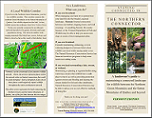
The Northern Connector
2010 to 2011
Summary
A guide for landowner to maintaining a connected landscape for wildlife between the northern Green Mountains and the Sutton Mountains of Quebec and beyond by the Staying Connected Initiative.
Key Personnel & Institutions
Institutions: Staying Connected Initiative
Location
GREEN MOUNTAIN RANGE
Resource Type
Poster
Tags
wildlife, landuse planning, habitat connectivity, land management, landscape connectivity
Topic Tags
ecosystem services, landscape pattern and connectivity
Purpose Tags
conservation
Citation
Staying Connected Initiative.(2011). Staying Connected in: The Northern Connector. Available at http://www.stayingconnectedinitiative.org/assets/_11ngs_landowner_management_brochure2_11-30-11.pdf
Source Link
http://www.stayingconnectedinitiative.org/assets/_11ngs_landowner_management_brochure2_11-30-11.pdf
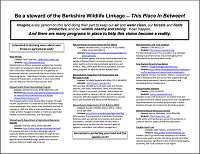
Be a steward of the Berkshire Wildlife Linkage -- this place in between!
2015 to 2016
Summary
This document provides contacts for landowners to different programs that help landowners and communities learn more about the management of forestland.
Key Personnel & Institutions
Institutions: Staying Connected Initiative
Location
WILLIAMSTOWN, FRANKLIN
Resource Type
Poster
Tags
agriculture, wildlife, landuse planning, wildlife connectivity
Topic Tags
conservation, ecosystem services, planning
Purpose Tags
conservation
Citation
Staying Connected Initiative. (2016). Be a steward of the Berkshire Wildlife Linkage. Available at http://stayingconnectedinitiative.org/assets/Landowner_resources_NBerks_Franklin_DRAFT.pdf
Source Link
http://stayingconnectedinitiative.org/assets/Landowner_resources_NBerks_Franklin_DRAFT.pdf
Critical paths: enhancing road permeability for wildlife in Vermont
2008 to 2009
Summary
The overriding goal of the Critical Paths project is to assist in the implementation of Vermont's State Wildlife Action Plan, which specifically recognizes the impacts of roads on wildlife habitat, and identifies the need to prioritize road crossing areas for wildlife.
Key Personnel & Institutions
People: George Leoniack
Institutions: National Wildlife Federation , Vermont Natural Resources Council , Vermont Fish and Wildlife Department , Leoniak Tracking Services
Location
VERMONT
Resource Type
Report
Tags
conservation, landuse planning, permeable landscape, transportation, vehicle-wildlife collisions
Topic Tags
management, drivers, landscape pattern and connectivity
Purpose Tags
conservation, management
Citation
Leoniak, G., Scharf, T., Fidel, J., Gay, G., Hammond, F. and Hilke, J.. (2009). Critical paths - Enhancing Road Permability for Wildlife in Vermont. The Wildlife Conservation Society. 77 p.
Source Link
http://www.nwf.org/~/media/PDFs/Regional/Northeast/NRC_Critical_Paths_Report.pdf
FIA photointerpretation in Southern New England: a tool to determine forest fragmentation and proximity to human development
1997 to 1998
Summary
In southern New England, the Northeastern Forest Inventory and Analysis unit has initiated data collection on the extent and location of forest fragmentation and proximity to human development during phase one (photointerpretation) of the inventory process.
Key Personnel & Institutions
People: Rachel Riemann
Institutions: United States Department of Agriculture (USDA), Forest Service, Northern Research Station
Location
Connecticut, Rhode Island
Resource Type
Article
Tags
biodiversity, monitoring, fauna, fia, flora, forest fragmentation, forest inventory and analysis, human development, hydrologic, photointerpretation, tracking
Topic Tags
conservation, ecosystem services, drivers
Purpose Tags
conservation, management, education
Citation
Riemann, R. & Tillman, K. (1999). FIA photointerpretation in Southern New England: a tool to determine forest fragmantation and proximity to human development. Res. Pap. NE-709. Radnor, PA: U.S. Department of Agriculture, Forest Service, Northeastern Research Station. 12 p.
Source Link
Forest fragmentation
2015 to 2016
Summary
Report advocating for legislative action to keep forests intact.
Key Personnel & Institutions
People: Steven Sinclair
Institutions: Vermont Forest Parks and Recreation
Location
VERMONT
Resource Type
Poster
Tags
resource management, wildlife, fragmentation, forest stewardship, land ownership
Topic Tags
management, ecosystem services
Purpose Tags
conservation, management, policy
Citation
Sinclair, S. (2016). Forest Fragmentation. Vermont Department of Forests, Parks, and Recreation.
Source Link
http://vtcommunityforestry.org/sites/default/files/pictures/arbor_day_2016_frag.pdf
Forest fragmentation action plan
2013 to 2014
Summary
The Forest Fragmentation Action Plan is a coordinated land use plan to reduce forest fragmentation at the local, regional, and state levels. This plan was developed by the Vermont Natural Resources Council with input from local planning and conservation commissions, selectboards, regional planning commissions, the VT Dept. of Forests, Parks and Recreation, the VT Fish and Wildlife Dept., the VT Dept. of Housing and Community Development, the VT Planners Association, and UVM Extension.
Key Personnel & Institutions
People: Emma Zavez
Institutions: Vermont Natural Resources Council
Location
VERMONT
Resource Type
Report
Tags
resource management, fragmentation, habitat connectivity, forest planning, parcelization
Topic Tags
methods, management, ecosystem services, landscape pattern and connectivity
Purpose Tags
conservation, management
Citation
Zavez, E. and Fidel, J. (2014). Forest Fragmentation Action Plan. Vermont Natural Resources Council.
Source Link
http://vnrc.org/wp-content/uploads/2019/08/Final-Forest-Fragmentation-Action-Plan-1.pdf
Forest fragmentation in Connecticut: 1985-2006
2009 to 2010
Summary
The purpose of this research was to develop an understanding of Connecticut's forests and how fragmentation has progressed over time. The Center for Land Use Education and Research (CLEAR) and the University of Connecticut created a forest fragmentation model for researchers, land use officials, natural resource professionals and the public to understand the health and condition of Connecticut's forested areas.
Key Personnel & Institutions
Institutions: University of Connecticut, Center for Land Use Education and Research
Location
Connecticut
Resource Type
Report
Tags
mapping, modelling, analysis, edge effects, forest cover, GIS, research
Topic Tags
methods, landscape pattern and connectivity
Purpose Tags
conservation, education
Citation
Wilson, E. and Arnold, C. (2010). Forest fragmentation in Connecticut, 1985-2006 research summary.Center for Land Use Education and Research. Available at https://cslib.contentdm.oclc.org/digital/collection/p128501coll2/id/142009/rec/1
Source Link
https://cslib.contentdm.oclc.org/digital/collection/p128501coll2/id/142009/rec/1
Changes to the land: four scenarios for the future of the Massachusetts landscape
2013 to 2014
Summary
In 2011, with the input of many groups and individuals from across Massachusetts, Harvard Forest launched a new project to evaluate potential futures for the Massachusetts landscape, and for forests in particular. The purpose of the project was to compare a set of contrasting scenarios to help inform and motivate conservation and land-use decisions.
Key Personnel & Institutions
Institutions: Harvard University, Harvard Forest , Harvard University
Location
Massachusetts
Resource Type
Report
Tags
land use, fragmentation, forest, education, outreach, planning, trends
Topic Tags
drivers
Purpose Tags
management, education
Citation
Thompson, J., Lambert, K.F., Foster, D., Blumstein, M., Broadbent, E., and Zambrano, A.A. (2014). Changes to the Land: Four Scenarios for the Future of the Massachusetts Landscape. Harvard Forest, Harvard University. 39 p.
Source Link
Community strategies for Vermont's forests and wildlife: a guide for local action
2012 to 2013
Summary
A guide for communities to take local action to ensure the future of their forests and wildlife. It is designed to provide planning and conservation commissions as well as landowners and community organizations with concrete strategies (both regulatory and non–regulatory) to keep forests intact.
Key Personnel & Institutions
Institutions: Vermont Natural Resources Council , Front Porch Community Planning and Design
Location
VERMONT
Resource Type
Report
Tags
forest conservation, planning
Topic Tags
conservation, management
Purpose Tags
conservation, management
Citation
Fidel, J., McCarthy, K. and Murry, S. (2013). Community strategies for Vermont's forest and wildlife: a guide for local action. Vermont Natural Resources Council. Available at http://vnrc.org/wp-content/uploads/2013/08/VNRC-Forestland-Conservation-10-1-links.pdf
Source Link
http://vnrc.org/wp-content/uploads/2019/08/VNRC-Forestland-Conservation-10-1-links.pdf
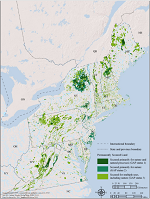
Conservation status of fish, wildlife, and natural habitats in the Northeast landscape
2010 to 2011
Summary
In 2008, the Northeast Association of Fish and Wildlife Agencies and its partners developed a multi-state monitoring framework to take stock of the condition and conservation of the species and habitats that characterize the region. Building on the 2008 report, this report is the first attempt to implement the recommendations of the monitoring framework.
Key Personnel & Institutions
People: Mark Anderson, Arlene Olivero Sheldon
Institutions: The Nature Conservancy
Location
New York, New England
Resource Type
Report
Tags
conservation, resource management, policy
Topic Tags
conservation, management
Purpose Tags
education
Citation
Anderson, M.G. & Olivero Sheldon, A. (2011). Conservation status of fish, wildlife, and natural habitats in the Northeast landscape. The Nature Conservancy, Eastern Conservation Science.289 p.
Source Link
Conserving Vermont's natural heritage: a guide to community-based planning for the conservation of Vermont's fish, wildlife, and biological diversity
2003 to 2004
Summary
This report is designed for use at the local level to help decision-makers preserve Vermont natural resources, wildlife and cultural heritage.
Key Personnel & Institutions
People: John Austin
Institutions: Vermont Fish & Wildlife Dept. , Vermont League of Cities and Towns
Location
VERMONT
Resource Type
Report
Tags
conservation, community based planning, forest preservation, natural heritage
Topic Tags
conservation, management
Purpose Tags
conservation, management
Citation
Austin, J., Alexander, C., Marshall, E., Hammond, F., Shippee, J., and Thompson, E. (2013). Conserving Vermont's natural heritage: a guide to community-based planning for the conservation of Vermont's fish, wildlife, and biological diversity. Vermont Fish and Wildlife Department . 136 p.
Source Link
Conserving wildlife in Maine's developing landscape
1999 to 2000
Summary
This report outlines the current state of Maine's forest habitats and potential future conditions.
Key Personnel & Institutions
People: Barbara Charry
Institutions: Maine Audubon Society
Location
Cumberland, York
Resource Type
Report
Tags
amphibians, birds, insects, mammals, mollusks, reptiles, education, outreach, wildlife habitat
Topic Tags
ecosystem services
Purpose Tags
education
Citation
Charry, B. (2000). Conserving Wildlife in Maine's Developing Landscape. Maine Audubon Society. Available at http://www.maineaudubon.org/wp-content/uploads/2017/03/MEAud-Conserving-Wildlife-Developing-Landscape.pdf
Source Link
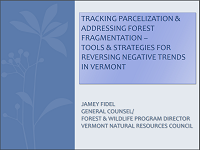
Tracking parcelization and addressing forest fragmentation: tools and strategies for reversing negative trends in Vermont
2002 to 2014
Summary
This presentation by Jamey Fidel, General Counsel/Forest and Wildlife Program Director for Vermont Natural Resources Council at the FEMC 2015 Annual Conference, addresses parcelization and fragmentation in Vermont and provides steps on reducing the negative impacts from such events.
Key Personnel & Institutions
People: Jamey Fidel
Institutions: Vermont Natural Resources Council , Vermont Natural Resources Council, Forest and Wildlife Program
Location
VERMONT
Resource Type
Poster
Tags
fragmentation, landuse planning, landscape connectivity, parcelization
Topic Tags
conservation, management, landscape pattern and connectivity
Purpose Tags
conservation, management
Citation
Fidel, J. (2015). Tracking parcelization and addressing forest fragmentation: tools and strategies for reversing negative trends in Vermont. Vermont Natural Resources Council. Available at https://www.uvm.edu/femc/attachments/project/999/annualMeeting/2015/presentations/Fidel_VMC_2015.pdf
Source Link
https://www.uvm.edu/femc/attachments/project/999/annualMeeting/2015/presentations/Fidel_VMC_2015.pdf
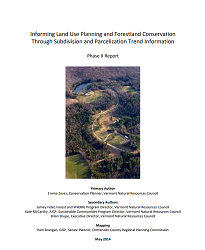
Informing land use planning and forestland conservation through subdivision and parcelization trend information
2009 to 2010
Summary
This project (1) establishes a database of parcels of land in Vermont, compiled by class size, and documents the current status of land in parcels in 2009, and (2) documents, in a final report and webpage, recent changes to parcel size and ownership patterns, implications for forest management, and specific subdivision and land classification trend information for every municipality in Vermont.
Key Personnel & Institutions
People: Steven Sinclair , Jamey Fidel , Deb Brighton, Brian Shupe
Institutions: Vermont Agency of Natural Resources , Vermont Natural Resources Council , Vermont Family Forests
Location
VERMONT
Resource Type
Report
Tags
fragmentation, landuse planning, landscape connectivity, parcelization
Topic Tags
conservation, management, landscape pattern and connectivity
Purpose Tags
conservation, management
Citation
Fidel, J., Shupe, B., Brighton, D., Sinclair, S., & Austin, J. (2010). Informing Land Use Planning and Forestland Conservation Through Subdivision and Parcelization Trend Information. Retrieved from https://nsrcforest.org/sites/default/files/uploads/fidel09VNRCfull.pdf
Source Link
http://nsrcforest.org/sites/default/files/uploads/fidel09VNRCfull.pdf
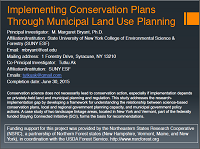
The Berkshire wildlife linkage: a corridor for wildlife and people
2014 to 2015
Summary
This document provides information about the Berkshire Widllife Linkage, and how the vision and goals provided by the Staying Connected Initiative will be achieved.
Key Personnel & Institutions
Institutions: The Nature Conservancy , Staying Connected Initiative
Location
VERMONT, New York
Resource Type
Poster
Tags
landuse planning, Appalachian Trail, habitat corridor, habitat islands, parcelization, road crossings
Topic Tags
conservation, landscape pattern and connectivity
Purpose Tags
conservation, management
Citation
Staying Connected Initiatve. (2015). The Berkshire Wildlife Linkage: A Corridor for Wildlife and People. Available at http://stayingconnectedinitiative.org/assets/Berkshire-Wildlife-Linkage-A-Corridor-for-Wildlife-and-People.pdf
Source Link
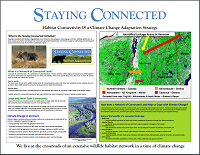
Habitat connectivity is a climate change adaptation strategy
2011 to 2012
Summary
This poster explains what the Staying Connected Initiative and how habitat connectivity can help combat climate change.
Key Personnel & Institutions
Institutions: Staying Connected Initiative
Location
VERMONT, Maine, New York, New Hampshire
Resource Type
Poster
Tags
climate change mitigation, wildlife habitat
Topic Tags
conservation, ecosystem services, landscape pattern and connectivity
Purpose Tags
conservation, management
Citation
Staying Connected Initiative. (2012). Staying Connected: Habitat Connectivity is a Climate Change Adaptation Strategy. Available at http://www.stayingconnectedinitiative.org/assets/habitat_connectivity_is_climate_change_adaptation_poster_2012.pdf
Source Link
New York's melting pot: forest fragmentation effects
2010 to 2011
Summary
This poster presents information concerning the effects forest fragmentation on the genetic diversity of a keystone tree species, red oak (Quercus rubra), as well as the overall plant species diversity in New York State's deciduous temperate forest.
Key Personnel & Institutions
People: Rolanda Rojas
Institutions: Louis Calder Center , New York Botanical Garden
Location
New York
Resource Type
Poster
Tags
climate change, species diversity, fragmentation, biotic diversity, red oak
Topic Tags
ecosystem services, drivers, landscape pattern and connectivity
Purpose Tags
conservation, education
Citation
Rojas, R., Litt, A. and Lewis, J. (2011). New York's melting pot: forest fragmentation effects. Louis Calder Center and New York Botanical Garden.
Source Link
Maine state forest assessment and strategies
2009 to 2010
Summary
The 2010 State Forest Assessment and Strategy covers the condition of and trends in Maine's forests and forest economy. Pursuant to state and federal legislative direction, the report addresses a number of topics, including: criteria and indicators of forest sustainability, threats and opportunities, priority forest areas, and strategies and resources needed to address threats to the state's forest resources.
Key Personnel & Institutions
People: Donald Mansius
Institutions: Maine Forest Service, Maine Department of Conservation, Maine Forest Service, Forest Policy and Management
Location
Maine
Resource Type
Report
Tags
fragmentation, forest, parcelization
Topic Tags
management
Purpose Tags
education
Citation
Maine Forest Service, Department of Conservation. (2010). Maine State Forest Assessment and Strategies. Maine Forest Service, Department of Conservation. Augusta, ME. 225 pp.
Source Link
http://www.maine.gov/dacf/mfs/publications/reports/maine_assessment_and_strategy_final.pdf
New Hampshire Forest Resource Strategies
2009 to 2010
Summary
The New Hampshire Forest Resource Plan includes both the statewide assessment of forestland and resource strategy for the future.
Key Personnel & Institutions
Institutions: New Hampshire Division of Forests and Lands , NH Forest Advisory Board
Location
New Hampshire
Resource Type
Report
Tags
conservation, forest management, fragmentation, resource planning
Topic Tags
conservation, management
Purpose Tags
management
Citation
Department of Resources and Economic Development. (2010). New Hampshire Forest Resource Strategies. Concord, NH. 149 p. Retrieved from https://www.nhdfl.org/DRED/media/Documents/NH-Forest-Resource-Strategies-Final.pdf.
Source Link
https://www.nh.gov/nhdfl/documents/nh-forest-resource-strategies-final.pdf
New Hampshire statewide forest resources assessment - 2010: important data and information about New Hampshire's forests
1993 to 2010
Summary
This Assessment Report is a background paper designed to provide the best information available about the status of New Hampshire's forests to facilitate a revision to the Forest Resources Plan with input from many stake holder groups.
Key Personnel & Institutions
People: Constance Carpenter
Institutions: New Hampshire Division of Forests and Lands , NH Forest Advisory Board
Location
New Hampshire
Resource Type
Report
Tags
conservation, water, soil, forest management, fragmentation, land use change, planning
Topic Tags
conservation, management, ecosystem services
Purpose Tags
management
Citation
New Hampshire Department of Resources and Economic Development. (2010). New Hampshire Statewide Forest Resources Assessment 2010: Important Data and Information about New Hampshire's Forests. New Hampshire Department of Resources and Economic Development. 59 p. Retrieved from https://www.nhdfl.org/DRED/media/Documents/NH-Statewide-Assessment-2010-update.pdf
Source Link
https://www.nh.gov/nhdfl/documents/nh-statewide-assessment-2010-update.pdf
New Hampshire's Vanishing Forests: Conversion, Fragmentation and Parcelization of Forests in the Granite State
1999 to 2000
Summary
A summary of a forum exploring the loss of forestland and the future of working family forests.
Key Personnel & Institutions
People: Mary Tyrrell
Institutions: Society for the Protection of NH Forests
Location
New Hampshire
Resource Type
Report
Tags
forests, fragmentation, parcelization
Topic Tags
landscape pattern and connectivity
Purpose Tags
education
Citation
Thorne, S. and Sundquist, D. (2001). New Hampshire's vanishing forests: Conversion, fragmentation and parcelization of forests in the Granite State. Society for the Protection of New Hampshire Forests.
Source Link
Changes in timberland ownership
2004 to 2005
Summary
This presentation focuses on the changing ownership of New Hampshire's forestland
Key Personnel & Institutions
People: Paul Doscher
Institutions: Society for the Protection of NH Forests
Location
New Hampshire
Resource Type
Poster
Tags
forestland, education, forest cover, land ownership, population growth, timber
Topic Tags
ecosystem services, landscape pattern and connectivity
Purpose Tags
education
Citation
Doscher, P. (2005). Changes in Timberland Ownership - The New Hampshire Experience. Society for the Protection of NH Forests. Available at https://www.google.com/url?sa=t&rct=j&q=&esrc=s&source=web&cd=5&ved=0ahUKEwjU1PTgrrfaAhVNhOAKHVkEDuMQFgg0MAQ&url=http://www.communitiescommittee.org/conference/presentations/doscher.ppt&usg=AOvVaw1QX9vN3btBjVNrH3tRUn13
Source Link
http://www.communitiescommittee.org/conference/presentations/stein.ppt
Sprawl and wildlife habitat
2014 to 2015
Summary
An educational briefing created by Grow Smart Maine about the impacts of sprawl to wildlife habitat.
Key Personnel & Institutions
Institutions: Grow Smart Maine
Location
Maine
Resource Type
Poster
Tags
development, awareness, disturbance, education, forest fragmentation, sprawl
Topic Tags
conservation, ecosystem services, landscape pattern and connectivity
Purpose Tags
conservation, education
Citation
Sprawl and Wildlife Habitat. (2015). GrowSmart Maine. Retrieved from https://growsmartmaine.org/wp-content/uploads/2015/08/Sprawl-and-Wildlife.pdf
Source Link
https://drive.google.com/file/d/1ybg8gPzNUNacQmB-_NN4lqD0clmwxuqA/view
Addressing forest fragmentation and forestland conservation through Act 250 and land use planning
2016 to 2017
Summary
An educational presentation on how urbanization and development impact the Vermont forests and a review of Act 250.
Key Personnel & Institutions
People: Jamey Fidel
Institutions: Vermont Bar Association
Location
VERMONT
Resource Type
Poster
Tags
fragmentation, development, landuse planning, act 250, education, laws, policy, urbanization
Topic Tags
conservation, drivers, landscape pattern and connectivity
Purpose Tags
conservation, education, policy
Citation
Fidel, J. (2017). Addressing Forest Fragmentation and Forestland Conservation Through ACT 250 & Land Use Planning, 60.
Source Link
https://www.vtbar.org/UserFiles/Files/EventAds/Materials 6-22-17 Afternoon Sessions.pdf
Protecting forests in Connecticut for the future: how are we doing? What will it take?
2014 to 2015
Summary
A presentation by Eric Hammerling, executive director of the Connecticut Forest and Park Association on the forest conditions of Connecticut.
Key Personnel & Institutions
People: Eric Hammerling
Institutions: Connecticut Forest and Park Association
Location
Connecticut
Resource Type
Poster
Tags
invasive species, species diversity, fragmentation, forest, education, nonprofit
Topic Tags
conservation, ecosystem services
Purpose Tags
conservation, education
Citation
Hammerling, E. (2015). Protecting Forests in Connecticut for the Future: How are we doing? What will it take? Available at http://www.ct.gov/caes/lib/caes/documents/plant_science_day/2015/psd_2015__johnson_lecture_hammerling.pdf
Source Link
Maine's tree growth tax law: the basics
2017 to 2018
Summary
The Maine Tree Growth Tax Law provides for the valuation of land that has been classified as forest land on the basis of productivity value, rather than on just value. The law is based on Article IX, Section 8 of the Maine Constitution that permits such valuation of forest land for property tax purposes. The purpose of this bulletin is to explain the more important features of the law.
Key Personnel & Institutions
Institutions: Maine Forest Service , Maine Forest Service, Maine Department of Conservation, Maine Revenue Service
Location
Maine
Resource Type
Poster
Tags
land management, landowners, laws, long-term management, policy, private forests, taxation
Topic Tags
conservation, management
Purpose Tags
management, policy
Citation
Maine Forest Service. (2018). Maine's Tree Growth Tax Law: The Basics. Available at https://www.maine.gov/dacf/mfs/policy_management/tgtl/tgtl_basics_presentation.pdf
Source Link
https://www.maine.gov/dacf/mfs/policy_management/tgtl/tgtl_basics_presentation.pdf
Keeping forests as forests: minimizing loss and fragmentation of forest land
2012 to 2013
Summary
This report by VNRC identifies the importance of Vermont's forests to wildlife for the human community, including the benefits of preserving forests. The report also discusses the issues of forest loss and fragmentation, and identifies the drivers that lead to loss and fragmentation as being incremental development and the subdivision of forest management.
Key Personnel & Institutions
Institutions: Vermont Natural Resources Council
Location
VERMONT
Resource Type
Report
Tags
forests, fragmentation, benefits, guidance, historical, landscape, preservation, prevention, reforestation
Topic Tags
management, ecosystem services
Purpose Tags
conservation
Citation
Vermont Natural Resources Council. (2013). Keeping Forests as Forests - Minimizing Loss and Fragmentation of Forest Land. VNRC, Montpelier, VT.
Source Link
Landscape-based forest stewardship northwest region Vermont
2013 to 2014
Summary
This plan outlines landscape-level planning processes that can identify how to value forestland and what measures can be taken to ensure that forests will be maintained in a healthy state in order to keep forests intact.
Key Personnel & Institutions
Institutions: Northwest Regional Planning Comission
Location
VERMONT
Resource Type
Report
Tags
fragmentation, forest value, landscape
Topic Tags
landscape pattern and connectivity
Purpose Tags
conservation, management
Citation
Landscape-Based Forest Stewardship, Northwest Region. (2014). Vermont Northwest Regional Planning Commission. 74 p. Available at https://docs.wixstatic.com/ugd/cf375c_815632a56aa34a9ab222f39951eb7158.pdf
Source Link
https://docs.wixstatic.com/ugd/cf375c_815632a56aa34a9ab222f39951eb7158.pdf
Losing Ground: At What Cost? Changes in land use and their impact on habitat, biodiversity, and ecosystem services in Massachusetts
2002 to 2003
Summary
This report outlines the issues surrounding forest fragementation and development in Massachusetts. Mass Audubon has chosen to make changes in land use the focal point of its current assessment of the environmental health of the Commonwealth. Understanding trends in development is particularly important in Massachusetts, which possesses a number of natural communities and rare species of regional and global significance.
Key Personnel & Institutions
People: Kevin Breunig
Institutions: Massachusetts Audubon
Location
Massachusetts
Resource Type
Report
Tags
biodiversity, land use, habitat, birds, fragmentation, development, advocacy, education
Topic Tags
ecosystem services, drivers
Purpose Tags
conservation, management, education
Citation
Breunig, K. (2003). Losing Ground: At What Cost? Changes in Land Use and Their Impact on Habitat, Biodiversity, and Ecosystem Services in Massachusetts. Summary Report for Mass Audubon.
Source Link
https://www.massaudubon.org/content/download/8599/149714/file/LosingGround_All.pdf
Sheffield Land Trust
1988 to 2017
Summary
This website provide information about the Sheffield Land Trust.
Key Personnel & Institutions
Institutions: Sheffield Land Trust
Location
SHEFFIELD
Resource Type
Website
Tags
agriculture, conservation, forestland conservation
Topic Tags
conservation
Purpose Tags
conservation, education
Citation
Sheffield Land Trust. (n.d.). Available at http://www.sheffieldland.org/index.html
Source Link
Staying Connected Initiative
Summary
This website provides information about the Staying Connected Initiative.
Key Personnel & Institutions
Institutions: Staying Connected Initiative
Location
New York, New England
Resource Type
Website
Tags
communities, community patterns, wildlife connectivity, wildlife habitat, wildlife movement
Topic Tags
conservation, planning, wildlife and habitat, landscape pattern and connectivity
Purpose Tags
conservation, education
Citation
Staying Connected Initiative. (n.d.) Available at http://stayingconnectedinitiative.org/
Source Link
Stowe Land Trust
Summary
This website provides information to the Stowe Land Trust.
Key Personnel & Institutions
Institutions: Stowe Land Trust
Location
STOWE
Resource Type
Website
Tags
forestland conservation, conservation easements
Topic Tags
conservation, planning
Purpose Tags
conservation
Citation
Stowe Land Trust. (n.d.).Retrieved from https://www.stowelandtrust.org/
Source Link
The Conservation Fund
Summary
This website provides information about The Conservation Fund.
Key Personnel & Institutions
Institutions: The Conservation Fund
Location
New York, New England
Resource Type
Website
Tags
communities, conservation, natural resources
Topic Tags
conservation, planning
Purpose Tags
conservation
Citation
The Conservation Fund. (n.d.). Available at https://www.conservationfund.org/
Source Link
The Nature Conservancy
Summary
This website provides information about the Nature Conservancy.
Key Personnel & Institutions
Institutions: The Nature Conservancy
Location
VERMONT, Massachusetts, Maine, New York, New Hampshire
Resource Type
Website
Tags
diversity, forestland conservation, conserved land, natural resource protection
Topic Tags
conservation, planning, wildlife and habitat
Purpose Tags
conservation
Citation
The Nature Conservancy. (n.d.). Available at https://www.nature.org/en-us/
Source Link
The Trust for Public Land
Summary
This website provides information about the Trust for Public Lands (TPL).
Key Personnel & Institutions
Institutions: The Trust For Public Land
Location
VERMONT, Massachusetts, Maine, New Hampshire
Resource Type
Website
Tags
conservation, recreation, conserved land, recreational land, social-ecological
Topic Tags
conservation, management
Purpose Tags
conservation
Citation
The Trust for Public Lands. (n.d.). Available at https://www.tpl.org/home
Source Link
The Vermont Land Trust
2016 to 2017
Summary
This website provides information about the Vermont Land Trust (VLT).
Key Personnel & Institutions
Institutions: Vermont Land Trust
Location
VERMONT
Resource Type
Website
Tags
conservation, connectivity, conserved land
Topic Tags
conservation, landscape pattern and connectivity
Purpose Tags
conservation
Citation
Vermont Land Trust (n.d.). Available at https://www.vlt.org/
Source Link
Two Countries One Forest
2008 to 2013
Summary
This website provides information about Two Countries, One Forest a major Canadian-U.S. collaborative of conservation organizations, researchers, foundations and conservation-minded individuals.
Key Personnel & Institutions
Institutions: Two Countries One Forest
Location
New York, New England
Resource Type
Website
Tags
conservation, conservation planning, conserved land, ecoregion
Topic Tags
conservation, wildlife and habitat, landscape pattern and connectivity
Purpose Tags
conservation, education
Citation
Two Countries, One Forest. (n.d.). Available at https://programs.wcs.org/2c1forest/
Source Link
Vermont Department of Forest, Parks and Recreation
Summary
This is the website to the Department of Forest, Parks and Recreation in Vermont.
Key Personnel & Institutions
Institutions: Vermont Agency of Natural Resources, Vermont Department of Forests, Parks and Recreation
Location
VERMONT
Resource Type
Website
Tags
conservation, diversity, forestland conservation, natural resource management, natural resources, research
Topic Tags
conservation, management, planning, wildlife and habitat, landscape pattern and connectivity
Purpose Tags
management
Citation
Agency of Natural Resources. (n.d.). Department of Forest, Parks and Recreation. Available at http://fpr.vermont.gov/
Source Link
Vermont River Conservancy
Summary
This website provides information about the Vermont River Conservancy.
Key Personnel & Institutions
Institutions: Vermont River Conservancy
Location
MONTPELIER
Resource Type
Website
Tags
conservation, water, recreation, protection, public lands, recreational land
Topic Tags
conservation
Purpose Tags
conservation
Citation
Vermont River Conservancy (n.d.). Available at http://www.vermontriverconservancy.org/
Source Link
Forest Fragmentation
Summary
The issue of forest fragmentation in Vermont, explained by the Vermont Natural Resources Council.
Key Personnel & Institutions
Institutions: Vermont Natural Resources Council
Location
No location information available
Resource Type
Website
Tags
conservation, community based planning, planning
Topic Tags
No topic tag keywords available
Purpose Tags
No purpose tag keywords available
Citation
Vermont Natural Resources Council. (n.d.). Forest Fragmentation. Available at http://vnrc.org/resources/community-planning-toolbox/issues/forest-fragmentation/
Source Link
https://vnrc.org/healthy-forests-wildlife/forest-fragmentation/
Wildlife Corridor Overlay Zone
2007 to 2008
Summary
This post from Vermont Natural Resources Council (VNRC) describes the town of Shrewsbury, Vermont, and the updates to the Town Plan in 2008. The update focused on zoning documents to ensure future goals with wildlife corridors within Shrewsbury, which resulted in an expansion of the areas protected by using a bear overlay zone to include wildlife habitat and corridors.
Key Personnel & Institutions
Institutions: Vermont Natural Resources Council
Location
VERMONT, SHREWSBURY
Resource Type
Website
Tags
conservation, public lands, wildlife conservation, wildlife habitat
Topic Tags
conservation, wildlife and habitat
Purpose Tags
policy
Citation
Vermont Natural Resources Council. (2008). Wildlife Corridor Overlay Zone - Shrewsbury. Available at http://vnrc.org/resources/community-planning-toolbox/case-studies/wildlife-corridor-overlay-zone-shrewsbury/
Source Link
https://vnrc.org/community-planning-toolbox/case-studies/wildlife-corridor-overlay-zone-shrewsbury/
Wildlife Habitat and Natural Areas
Summary
This post from VNRC talks about the role of wildlife habitat within the state of Vermont and how important it is to have concrete documentation/policy to conserve wildlife and natural lands.
Key Personnel & Institutions
Institutions: Vermont Natural Resources Council
Location
VERMONT
Resource Type
Website
Tags
conservation, wildlife, public lands, wildlife habitat, wildlife and habitat
Topic Tags
conservation, wildlife and habitat
Purpose Tags
education, policy
Citation
Vermont Natural Resources Council. (n.d.). Wildlife Habitat and Natural Areas. Available at http://vnrc.org/resources/community-planning-toolbox/issues/wildlife-habitat-and-natural-areas/
Source Link
https://vnrc.org/community-planning-toolbox/issues/wildlife-habitat-and-natural-areas/
Williamstown Rural Lands Foundation
1985 to 2018
Summary
Web page for the Williamstown Rural Lands Foundation.
Key Personnel & Institutions
Institutions: Williamstown Rural Lands Foundation
Location
WILLIAMSTOWN
Resource Type
Website
Tags
conservation, recreation, education, protection, recreational land
Topic Tags
conservation
Purpose Tags
conservation
Citation
Williams Rural Land Foundation. (n.d.). Available at https://wrlf.org/
Source Link
Mongabay: News and Inspriration from Nature's Frontline
2016 to 2017
Summary
This short online article provides an overview of a study that concluded that forest fragmentation can boosts carbon storage along temperate forest edges.
Key Personnel & Institutions
People: John Cannon
Institutions: Mongabay
Location
Massachusetts
Resource Type
Website
Tags
regeneration, forest regeneration, carbon sequestration
Topic Tags
ecosystem services
Purpose Tags
education
Citation
Cannon, J. C. (2017, January 9). Fragmentation boosts carbon storage along temperate forest edges. Mongabay. Retrieved from https://news.mongabay.com/2017/01/fragmentation-boosts-carbon-storage-along-temperate-forest-edges/.
Source Link
https://news.mongabay.com/2017/01/fragmentation-boosts-carbon-storage-along-temperate-forest-edges/
Stressors: Development and habitat loss
2014 to 2015
Summary
This tool allows users to explore and learn about environmental threats and impacts to wildlife in Massachusetts.
Key Personnel & Institutions
Institutions: UMass Amherst Department of Natural Resources Conservation
Location
Massachusetts
Resource Type
Website
Tags
conservation, wildlife, development, habitat loss, wildlife habitat
Topic Tags
conservation, wildlife and habitat, landscape pattern and connectivity
Purpose Tags
management, education
Citation
Massachusetts Climate Adaptation Partnership. (2015). Stressors: Development and habitat loss. Available at https://climateactiontool.org/content/development-and-habitat-loss
Source Link
https://climateactiontool.org/content/development-and-habitat-loss
Climate Change - Good News and Bad News about Forest Fragmentation
2015 to 2016
Summary
This article, published in Bostonia, provides an overview of reserach by two Boston University scientistis on their work looking at the effects of forest fragmentation under a changing climate.
Key Personnel & Institutions
People: Lucy Hutyra
Institutions: Boston University
Location
BOSTON
Resource Type
Website
Tags
communities, biology, chemistry, climate change, ecology, carbon, education, environment, global health, heat stress
Topic Tags
drivers, landscape pattern and connectivity
Purpose Tags
education
Citation
Moran, B. (2016). Good News and Bad News about Forest Fragmentation - New England Forests May Be More Sensitive To Climate Change. Available at https://www.bu.edu/research/articles/forest-fragmentation/
Source Link
New Partnership Concerned About Forest Fragmentation
2016 to 2017
Summary
This web article discusses the status of forest fragmentation within Rhode Island's forest.
Key Personnel & Institutions
People: Frank Carini
Institutions: EcoRI
Location
Rhode Island
Resource Type
Website
Tags
agriculture, ecology, fragmentation, development, forestry
Topic Tags
conservation
Purpose Tags
education
Citation
Carini, F. (2017). New Partnership Concerned About Forest Fragmentation. ecoRI News. Available at https://www.ecori.org/smart-growth/2017/2/14/new-partnership-concerned-about-forest-fragmentation
Source Link
https://www.ecori.org/smart-growth/2017/2/14/new-partnership-concerned-about-forest-fragmentation
R.I. Land Conservationists Worry Power Plant Will Fragment Forest, Harm Species
2016 to 2017
Summary
This short article on WBUR outlines the problems with light pollution and forest fragmentation in the northeastern US.
Key Personnel & Institutions
People: Bill Eccleston
Institutions: Rhode Island Public Radio, New England News Collaborative
Location
Rhode Island
Resource Type
Website
Tags
wildlife, development, connectivity, corridor, land conservation
Topic Tags
conservation, drivers
Purpose Tags
conservation, education
Citation
Brookins, A. (2017, October 9). R.I. Land Conservationists Worry Power Plant Will Fragment Forest, Harm Species. WBUR News. Available at http://www.wbur.org/news/2017/10/09/rhode-island-power-plant-conservationists
Source Link
http://www.wbur.org/news/2017/10/09/rhode-island-power-plant-conservationists
New England is Losing 65 Acres of Forestland Per Day, Report Finds
2016 to 2017
Summary
New England has been losing forestland to development at a rate of 65 acres per day -- a loss that comes at a time when public funding for preservation of open land, both state and federal, has also been on the decline in all six states.
Key Personnel & Institutions
People: Steve LeBlanc
Institutions: Harvard University, Harvard Forest , The Associated Press, WBUR News
Location
New England
Resource Type
Website
Tags
conservation, development, new england, forest decline
Topic Tags
drivers, landscape pattern and connectivity
Purpose Tags
conservation, education
Citation
LeBlanc, S. (2017, Septempber 19). New England Is Losing 65 Acres Of Forestland Per Day, Report Finds. WBUR News. Available at http://www.wbur.org/news/2017/09/19/new-england-forest-report
Source Link
http://www.wbur.org/news/2017/09/19/new-england-forest-report
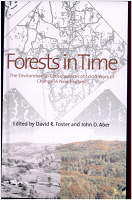
Forests in Time: The Environmental Consequences of 1,000 Years of Change in New England
2005 to 2006
Summary
This book outlines the rise and fall of eastern hemlock, an iconic and important tree in the northeast. Drawing on a century of studies at Harvard University's Harvard Forest, the authors explore what hemlock's modern decline due to the invasive pest, hemlock woolly adelgid, can tell us about the challenges facing nature and society in an era of habitat changes and fragmentation, as well as global change.
Key Personnel & Institutions
People: David Foster , John Aber
Institutions: Harvard University, Harvard Forest
Location
New England
Resource Type
Book
Tags
global change, habitat fragmentation, land use change
Topic Tags
wildlife and habitat, landscape pattern and connectivity
Purpose Tags
education
Citation
Foster, D.R. and Aber, J.D. (Eds). (2006). Forests in time: the environmental consequences of 1,000 years of change in New England. New Haven, CT: Yale University Press.
Source Link
https://books.google.com/books/about/Forests_in_Time.html?id=GENV8N2qgiMC
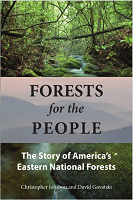
Forests for the People: The Story of America's Eastern National Forests
2012 to 2013
Summary
"Forests for the People" tells one of the most extraordinary stories of environmental protection in our nation's history: how a diverse coalition of citizens, organizations, and business and political leaders worked to create a system of national forests in the Eastern United States. It offers an insightful and wide-ranging look at the actions leading to the passage of the Weeks Act in 1911 -- landmark legislation that established a system of well-managed forests in the East, the South, and the Great Lakes region -- along with case studies that consider some of the key challenges facing eastern forests today.
Key Personnel & Institutions
People: Christopher Johnson
Location
New York, New England
Resource Type
Book
Tags
timber harvest, eastern national forests, invasives, national parks, prescribed burns, Weeks act, wilderness protections
Topic Tags
management, ecosystem services
Purpose Tags
conservation
Citation
Johnson, C. & Govatski, D.(2013). Forests for the People: The Story of America's Eastern National Forests. Island Press.
Source Link
https://books.google.com/books/about/Forests_for_the_People.html?id=3-FoAQAACAAJ
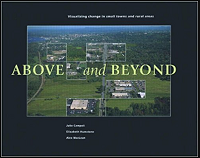
Above and beyond: visualizing change in small towns and rural areas
2001 to 2002
Summary
Highlighting widespread trends in contemporary land development-from fragmentation (our tendency to spread out) to separation (our tendency to allocate separate areas of town for living, working, shopping and playing)-the authors offer case examples of communities that have succeeded in curbing those trends.Â
Key Personnel & Institutions
People: J. Campoli
Location
VERMONT
Resource Type
Book
Tags
landuse planning, rural america, suburban, urban sprawl
Topic Tags
drivers
Purpose Tags
management
Citation
Campoli, J., MacLean, A.S. & Humstone, E. (2002). Above and beyond: visualizing change in small towns and rural areas. Planners Press, American Planning Association.
Source Link
Integrated Geospatial Education and Technology Training
2006 to 2007
Summary
This website provides access to instructional resources (e.g.,PowerPoint presentations, student exercises and videos) useful for teaching introductory courses (and course modules) in remote sensing and for integrating remote sensing in in geospatial programs.
Key Personnel & Institutions
People: Osa Brand
Institutions: United States Geological Survey (USGS) , National Science Foundation, NSF, Sigma Space Corporation, National Aeronautics and Space Administration (NASA), Goddard Space Flight Center, West Valley College, Jefferson Community and Technical College, National Geotech Center, Black Hills State University, ESRI Harris Geospatial Solutions and Leica Geosystems, American Society for Photogrammetry and Remote Sensing
Location
No location information available
Resource Type
Website
Tags
geographic information systems, remote sensing, spatial analysis, GIS, tool
Topic Tags
methods
Purpose Tags
management, education
Citation
Integrated Geospatial Education & Technology Training. (n.d.). Retrieved April 19, 2018, from http://www.igettremotesensing.org/
Source Link
BIOFRAG - Biodiversity responses to habitat degradation & fragmentation
2011 to 2018
Summary
The BIOFRAG project was started to develop a consistent methodology to quanitfy the impact of habitat fragmentation on abundance of species and species turnover. The authors focued on edge effects and patch-matrix contrast to quanitfy two metrics: fragmentation impact and edge sensitivity.
Key Personnel & Institutions
People: Marion Pfeifer
Institutions: BIOFRAG
Location
No location information available
Resource Type
Website
Tags
communities, biodiversity, data sharing, database, fragstats, habitat degredation
Topic Tags
methods, landscape pattern and connectivity
Purpose Tags
education
Citation
BIOFRAG - Biodiversity responses to habitat degradation & fragmentation. (n.d.). Available at https://biofrag.wordpress.com/
Source Link
Trees for life: habitat fragmentation
Summary
This web article provides an easy-to-understand overview of the problems related to forest fragmentation, with particular focus on wildlife impacts.
Key Personnel & Institutions
People: Dan Puplett
Institutions: Trees for Life
Location
No location information available
Resource Type
Website
Tags
biodiversity, threats
Topic Tags
drivers, landscape pattern and connectivity
Purpose Tags
education
Citation
Puplett, D. (n.d.). Habitat fragmentation. Available at https://treesforlife.org.uk/forest/human-impacts/habitat-fragmentation/
Source Link
https://treesforlife.org.uk/forest/human-impacts/habitat-fragmentation/
Life on the Edge
2015 to 2016
Summary
Despite being conducted in rural Petersham, Massachusetts, the inspiration for my summer research project comes from patterns observed in urban environments. We live in a growing world in which cities are expanding, both in terms of population and geography. As cities sprawl outwards, forested regions, such as New England, are converted into fragmented landscapes where the forest is interrupted by human land use. Replacing forests with something else can have significant impacts on the carbon cycle as forests play a key role in removing and storing atmospheric carbon. However, the data that I have collected this summer suggests that forests have the ability to mitigate some of the carbon storage loss associated with forest fragmentation.
Key Personnel & Institutions
People: Ian Smith
Institutions: Harvard University, Harvard Forest
Location
Massachusetts
Resource Type
Website
Tags
cities, edge effects, forest edge, human land use, urban forests
Topic Tags
drivers, landscape pattern and connectivity
Purpose Tags
conservation, education
Citation
Smith, I. (2016). Life on the Edge. Harvard Forest. Available at http://harvardforest.fas.harvard.edu/blog/ian-smith
Source Link
BioMap2
2009 to 2010
Summary
BioMap2 is designed to guide strategic biodiversity conservation in Massachusetts over the next decade by focusing land protection and stewardship on the areas that are most critical for ensuring the long-term persistence of rare and other native species and their habitats, exemplary natural communities, and a diversity of ecosystems.
Key Personnel & Institutions
People: Henry Woosley
Institutions: The Nature Conservancy , Massachusetts Division of Fisheries and Wildlife, The Natural Heritage and Endangered Species Program
Location
Massachusetts
Resource Type
Map
Tags
habitat, spatial analysis, ecoregion, landscape blocks, tool, web tool
Topic Tags
conservation, methods, planning, landscape pattern and connectivity
Purpose Tags
education
Citation
Massachusetts Department of Fish and Game. (2010). BioMap 2 - Natural Heritage [map]. Available at http://maps.massgis.state.ma.us/dfg/biomap2.htm
Source Link
https://gis.eea.mass.gov/portal/apps/webappviewer/index.html?id=e2b6c291e0294c3281488621aaa095bf
Suburban Sprawl: Culture, Theory, and Politics
2002 to 2003
Summary
A comprehensive, multi-disciplinary analysis of suburban sprawl development and smart growth alternatives within the contexts of culture, ecology, and politics. This book offers a mix of theoretical inquiry, historical analysis, policy critique, and case studies, written by academics and practitioners from around the world.
Key Personnel & Institutions
People: Matthew Lindstrom
Location
No location information available
Resource Type
Book
Tags
ecology, development, landuse planning, culture, politics, suburban sprawl
Topic Tags
drivers
Purpose Tags
management, policy
Citation
Lindstrom, M.J. & Bartling, H. eds. (2003). Suburban sprawl: Culture, theory, and politics. New York, NY: Rowman & Littlefield.
Source Link
https://books.google.com/books/about/Suburban_Sprawl.html?id=RQN0OXl02qMC
Forests at the Wildland-Urban Interface: Conservation and Management
2003 to 2004
Summary
Forests at the Wildland-Urban Interface: Conservation and Management provides information, strategies, and tools to enhance natural resource management, planning, and policymaking at the wildland-urban interface.
Key Personnel & Institutions
People: Susan Vince
Location
No location information available
Resource Type
Book
Tags
landuse planning, forestland, natural resource management, urbanization
Topic Tags
ecosystem services, drivers
Purpose Tags
management
Citation
Vince, S.W., Duryea, M.L., Macie, E.A. and Hermansen, A. eds. (2004). Forests at the wildland-urban interface: conservation and management. Boca Raton, FL: CRC Press Taylor and Francis Group. 312 p.
Source Link
Forest island dynamics in man-dominated landscapes
1980 to 1981
Summary
This book analyzed the patterns found within forest island landscapes.
Key Personnel & Institutions
People: R. Burgess
Location
No location information available
Resource Type
Book
Tags
ecology, human impacts, landscape ecology, natural resources, threats
Topic Tags
drivers, wildlife and habitat, landscape pattern and connectivity
Purpose Tags
education
Citation
Burgess, R.L. and Sharpe, D.M. (Eds.). (1981). Forest island dynamics in man-dominated landscapes. New York: Springer-Verlag, 310 pp.
Source Link
Forest Fragmentation: Wildlife and Management Implications
1998 to 1999
Summary
This book summarizes findings from the first scientific conference to address fragmentation in relationship to forest management and the consequences for wildlife populations in the forests of the western United States and Canada.
Key Personnel & Institutions
People: James Rochelle, Leslie Lehmann, Joe Wisniewski
Location
No location information available
Resource Type
Book
Tags
forest management, connectivity, habitat fragmentation, habitat threats, threats
Topic Tags
drivers, wildlife and habitat, landscape pattern and connectivity
Purpose Tags
management, education
Citation
Rochelle, J. A., Lehmann, L. A., and Wisniewski, J. (1999). Forest Fragmentation: Wildlife and Management Implications. Boston, MA: Brill.
Source Link
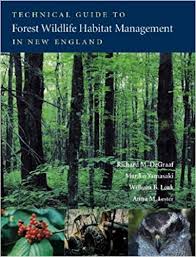
Technical guide to forest wildlife habitat management in New England
2005 to 2006
Summary
This book is a compilation of forest management practices now crucial for creating a range of forest habitat conditions to maintain or enhance forest wildlife diversity in New England.
Key Personnel & Institutions
People: Richard DeGraaf
Location
New England
Resource Type
Book
Tags
forest management, fragmentation, education, land use change, wildlife management
Topic Tags
management, ecosystem services, drivers
Purpose Tags
management, education
Citation
DeGraaf, R.M., Yamasaki, M., Leak, W.B. and Lester, A.M. (2006). Technical Guide to Forest Wildlife Habitat Management in New England. Burlington, VT: University of Vermont Press.
Source Link
The Changing Nature of the Maine Woods
2011 to 2012
Summary
This book synthesizes the latest scientific discoveries regarding changing forest conditions in the Maine Woods
Key Personnel & Institutions
People: Andrew Barton
Institutions: University of Maine
Location
Maine
Resource Type
Book
Tags
ecology, history, landscape change, habitat, forest, forest resources
Topic Tags
management, ecosystem services, drivers
Purpose Tags
education
Citation
Barton, A. M., White, A. S., and Cogbill, C. V. (2012). The Changing Nature of the Maine Woods. Durham, NH: University of New Hampshire Press.
Source Link
https://books.google.com/books?id=Dy7e6imrltIC&dq=Maine+forest+fragmentation&source=gbs_navlinks_s
New England's Forest Landscape: Ecological Legacies and Conservation Patterns Shaped by Agrarian History
2007 to 2008
Summary
This is the second chapter of the book "New England's Forest Landscape: Ecological Legacies and Conservation Patterns Shaped by Agrarian History"
Key Personnel & Institutions
People: David Foster
Institutions: Harvard University, Harvard Forest , Harvard University , University of Massachusetts Amherst , Brandeis University
Location
New England
Resource Type
Article
Tags
conservation, history, agrarian history, anthropology
Topic Tags
conservation, drivers
Purpose Tags
education
Citation
Foster, D R., Donahue, B., Kittredge, D., Motzkin, G., Hall, B., Turner, B., and Chilton, E.S. (2008). New England's Forest Landscape: Ecological Legacies and Conservation Patterns Shaped by Agrarian History. In Agrarian Landscapes in Transition: Comparisons of Long-Term Ecological and Cultural Change: 344.
Source Link
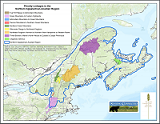
Priority linkages in the northern Appalachian-Acadian region
2014 to 2015
Summary
Map identifying priority landscape linkages for wildlife connectivity
Key Personnel & Institutions
Institutions: Staying Connected Initiative , Two Countries One Forest
Location
VERMONT, Maine, New York, New Hampshire
Resource Type
Map
Tags
connectivity, corridors, wildlife connectivity, wildlife connectivity planning
Topic Tags
conservation, wildlife and habitat, landscape pattern and connectivity
Purpose Tags
education
Citation
Two Countries One Forest. (2015). Priority Linkages in the Northern Appalachian-Acadian Region [map]. Retrieved from http://216.92.98.160/assets/SCILinkageBoundaries_May_2015.pdf
Source Link
http://216.92.98.160/assets/SCILinkageBoundaries_May_2015.pdf
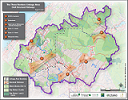
The three borders linkage area
2011 to 2012
Summary
This map identifies priority landscape linkages for wildlife connectivity.
Key Personnel & Institutions
Institutions: The Nature Conservancy , Wildlife Conservation Society , Two Countries One Forest , Conservation De La Nature - Canada , Canadian Parks and Wilderness Society (CPAWS)
Location
New York
Resource Type
Map
Tags
communities, wildlife, connectivity, corridors, wildlife connectivity
Topic Tags
conservation, wildlife and habitat, landscape pattern and connectivity
Purpose Tags
education
Citation
The Nature Conservancy. (2012). The Three Borders Linkage Area [map]. Retrieved from http://216.92.98.160/assets/3borderslinkagepathways_aug12_.pdf
Source Link
http://216.92.98.160/assets/3borderslinkagepathways_aug12_.pdf
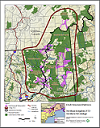
Northeast Kingdom (VT): northern NH linkage
2011 to 2012
Summary
This map depicts draft structural pathways that may be used to conserve wildlife connectivity in northern Vermont and New Hampshire.
Key Personnel & Institutions
Institutions: The Nature Conservancy
Location
VERMONT, New Hampshire
Resource Type
Map
Tags
wildlife, connectivity, corridors, wildlife connectivity, wildlife connectivity planning
Topic Tags
conservation, wildlife and habitat, landscape pattern and connectivity
Purpose Tags
education
Citation
The Nature Conservancy. (2012). Northeast Kingdom Northern NH Linkage [map]. Retrieved from http://216.92.98.160/assets/nek-nnh_proj_area_sps.pdf
Source Link
Old Growth Forest Network
2006 to 2007
Summary
Joan Maloof, Professor Emeritus at Salisbury University, founded the Old-Growth Forest Network to preserve, protect and promote the country's few remaining stands of old-growth forest
Key Personnel & Institutions
People: Joan Maloof
Institutions: Old-Growth Forest Network
Location
HAMPSHIRE, FRANKLIN, Cattaraugus, Cortland, Erie, Franklin, Hamilton, Niagara, Onondaga, Tompkins
Resource Type
Website
Tags
old growth forests, forest, disturbance, intact forests, mature forests
Topic Tags
conservation
Purpose Tags
education
Citation
Old-Growth Forest Network. (n.d.). Available at http://www.oldgrowthforest.net
Source Link
World Wildlife Fund
Summary
An overview of the New England - Acadian forests by the WWF regarding conservation status, remaining blocks of intact habitat, degree of protection for those blocks, and severity of threats.
Key Personnel & Institutions
People: M. Davis
Institutions: World Wildlife Fund
Location
New York, New England
Resource Type
Website
Tags
conservation, disturbance, threats, wildlife habitat
Topic Tags
conservation, wildlife and habitat, landscape pattern and connectivity
Purpose Tags
conservation, education
Citation
Davis, M., Gratton, L., Adams, J., Goltz, J., Stewart, C., Buttrick, S., Mann, G. (n.d.). New England-Acadian forests. Available at https://www.worldwildlife.org/ecoregions/na0410
Source Link
Highstead: Dedicated to conserving New Englands natural landscapes
1981 to 2018
Summary
Highstead works to inspire curiosity and build knowledge about plants and wooded landscapes in order to enhance life, preserve nature, and advance sound stewardship practices.
Key Personnel & Institutions
Institutions: Harvard University , Highstead
Location
New England
Resource Type
Website
Tags
conservation, monitoring, forests, new england, connecticut, Harvard Forest, highstead, long-term research, stewardship
Topic Tags
conservation
Purpose Tags
conservation, management, education
Citation
Highstead. (n.d.). Dedicated to conserving New England's natural landscapes. Available at http://highstead.net/about/mission.shtml
Source Link
What is forest fragmentation and why is it a problem?
2013 to 2014
Summary
This article by Michael Snyder, the Commisioner of the Vermont Department of Forests, Parks, and Recreation, describes fragmentation and its impacts on forest ecosystems in the Autumn 2014 issue of the Northern Woodlands Magazine.
Key Personnel & Institutions
People: Michael Snyder
Institutions: Vermont Forest Parks and Recreation , Northern Woodlands
Location
New England
Resource Type
Website
Tags
human disturbance, education, fragmentation drivers
Topic Tags
drivers
Purpose Tags
education
Citation
Snyder, M. (2014, October 13). What is forest fragmentation and why is it a problem? Nothern Woodlands Magazine. Retrieved from https://northernwoodlands.org/articles/article/forest-fragmentation
Source Link
https://northernwoodlands.org/articles/article/forest-fragmentation
Report on the Environment
2013 to 2014
Summary
This indicator describes forest fragmentation in the contiguous US c. 2001, 2006, and 2011. This information provides a broad, recent picture of the spatial pattern of the nation's forests and the extent to which they are being broken into smaller patches and pierced or interspersed with non-forest cover.
Key Personnel & Institutions
Institutions: United States Department of Agriculture (USDA), Forest Service , United States Environmental Protection Agency (EPA) , United States Department of Agriculture (USDA)
Location
New York, New England
Resource Type
Website
Tags
EPA, forest fragmentation, impacts, NLCD, spatial patterns, trends
Topic Tags
drivers, landscape pattern and connectivity
Purpose Tags
conservation, education
Citation
Environmental Protection Agency. (2015). Report on the Environment. Available at https://cfpub.epa.gov/roe/indicator.cfm?i=81
Source Link
Forest Fragmentation
Summary
This website provides basic information about forest fragmentation and how it impacts wildlife.
Key Personnel & Institutions
Not available.Location
VERMONT
Resource Type
Website
Tags
human disturbance, roads, education
Topic Tags
drivers, wildlife and habitat, landscape pattern and connectivity
Purpose Tags
education
Citation
Forest Fragmentation. (n.d.). Available at http://www.web.ca/~nwatch/fmp/Issue_Pages/forestfragmentation.html
Source Link
http://www.web.ca/~nwatch/fmp/Issue_Pages/forestfragmentation.html
How Forest Fragmentation Threatens Biodiversity
2014 to 2015
Summary
This website discusses the consequences of forest fragmentation on the ecology of the National Parks.
Key Personnel & Institutions
Institutions: EcoWatch
Location
VERMONT, Maine
Resource Type
Website
Tags
biodiversity, habitat threats, threats
Topic Tags
drivers, wildlife and habitat, landscape pattern and connectivity
Purpose Tags
education
Citation
EcoWatch. (2015). How Forest Fragmentation Threatens Biodiversity. Available at https://www.ecowatch.com/how-forest-fragmentation-threatens-biodiversity-1882034965.html
Source Link
https://www.ecowatch.com/how-forest-fragmentation-threatens-biodiversity-1882034965.html
What is forest fragmentation and why is it improtant?
1996 to 1997
Summary
This website descibes forest fragmentation and its impacts on woodland birds.
Key Personnel & Institutions
Institutions: United States Department of Agriculture (USDA), Forest Service , Cornell Lab of Ornithology, Cornell Laboratory of Ornithology, Birds in Forested Landscapes
Location
No location information available
Resource Type
Website
Tags
habitat, birds, education, forest fragmentation, woodlands
Topic Tags
conservation, drivers, wildlife and habitat, landscape pattern and connectivity
Purpose Tags
education
Citation
Cornell Lab of Ornithology (n.d.). What is forest fragmentation and why is it important? Birds In Forested Landscapes. Available at http://static.birds.cornell.edu/bfl/gen_instructions/fragmentation.html
Source Link
http://static.birds.cornell.edu/bfl/gen_instructions/fragmentation.html
Why forest fragmentation risks mass extinctions
2014 to 2015
Summary
This article outlines the risk of extinction that fragmented forests face throughout North America and South America.
Key Personnel & Institutions
People: David Edwards
Location
New York, New England
Resource Type
Website
Tags
wildlife, disturbance, education, forest patch, threats
Topic Tags
drivers, wildlife and habitat
Purpose Tags
education
Citation
Edwards, D. (2015, March 23). Why forest fragmentation risks mass extinctions. Available at https://www.weforum.org/agenda/2015/03/why-forest-fragmentation-risks-mass-extinctions/
Source Link
https://www.weforum.org/agenda/2015/03/why-forest-fragmentation-risks-mass-extinctions/
Building for Birds: an online tool to evaluate how different development designs impact forest habitat
2016 to 2017
Summary
The tool described in this essay helps city decision-makers evaluate how different development designs benefit or do not benefit different bird species.
Key Personnel & Institutions
People: Mark Hostetler
Institutions: United States Fish and Wildlife Service
Location
No location information available
Resource Type
Website
Tags
conservation, habitat, birds, wildlife, management, ecosystems
Topic Tags
landscape pattern and connectivity
Purpose Tags
conservation, management, education
Citation
Hostetler, M., & Archer, J. M. (2017, January 11). Building for Birds: An Online Tool to Evaluate How Different Development Designs Impact Forest Bird Habitat. The Nature of Cities. Available at https://www.thenatureofcities.com/2017/01/11/building-birds-new-online-tool-evaluate-different-development-designs-impact-forest-bird-habitat/
Source Link

Connectivity areas and habitat blocks
2010 to 2011
Summary
In 2011, the Staying Connected Initiative used GIS modeling to identify important Habitat Connectivity Areas in the Northern Green Mountains. These areas were deemed important “connecting habitat” that link large blocks of habitat within a landscape, allowing the movement, migration, and dispersal of wide-ranging mammals.
Key Personnel & Institutions
Institutions: Staying Connected Initiative
Location
GREEN MOUNTAIN RANGE
Resource Type
Map
Tags
wildlife, corridors, wildlife connectivity, wildlife connectivity planning
Topic Tags
conservation, wildlife and habitat, landscape pattern and connectivity
Purpose Tags
education
Citation
Staying Connected Initiative. (2011). Connectivity Areas and Habitat Blocks - A Regional Perspective [map]. Retrieved from http://216.92.98.160/assets/_15connectivityarea_habitatblocks.pdf
Source Link
http://216.92.98.160/assets/_15connectivityarea_habitatblocks.pdf
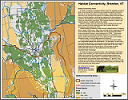
Habitat connectivity in Brandon, VT
2010 to 2011
Summary
Map identiying connecting habitat between large habitat blocks
Key Personnel & Institutions
Institutions: Staying Connected Initiative
Location
PITTSFIELD, BRANDON
Resource Type
Map
Tags
wildlife, corridors, wildlife connectivity planning, wildlife habitat
Topic Tags
conservation, wildlife and habitat, landscape pattern and connectivity
Purpose Tags
education
Citation
Marangelo, P. (2011). Habitat Connectivity, Brandon, VT. Staying Connected Initiative. Available at http://216.92.98.160/assets/brandonconnectivityhabitatblocks11_2011.pdf
Source Link
http://216.92.98.160/assets/brandonconnectivityhabitatblocks11_2011.pdf
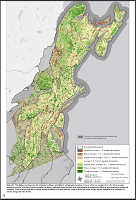
Terrestrial resilience tabloid maps
2010 to 2011
Summary
Maps identifying areas of terrestrial resilience to climate change
Key Personnel & Institutions
Institutions: The Nature Conservancy
Location
New York, New England
Resource Type
Map
Tags
climate change, habitat, resilience
Topic Tags
conservation, wildlife and habitat, landscape pattern and connectivity
Purpose Tags
education
Citation
The Nature Conservancy. (2011). Map Set. Available online at http://216.92.98.160/assets/terrestrialresiliencetabloidmaps013012.pdf.
Source Link
http://216.92.98.160/assets/terrestrialresiliencetabloidmaps013012.pdf
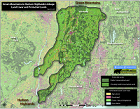
Green Mountains to Hudson Highlands linkage land cover and protected lands
2016 to 2017
Summary
This map depicts the land cover and protected lands in the Green Mountain to Hudson Highlands Linkage
Key Personnel & Institutions
Institutions: Staying Connected Initiative
Location
VERMONT, Massachusetts, New York, Connecticut
Resource Type
Map
Tags
habitat, connectivity, conserved land, landcover, protected areas
Topic Tags
conservation, methods, wildlife and habitat, landscape pattern and connectivity
Purpose Tags
education
Citation
Staying Connected Initiative. (2017). Green Mountains to Hudson Highlands Linkage Land Cover and Protected Lands [map]. Retrieved from http://stayingconnectedinitiative.org/assets/GreensHudsonHighlands.jpg
Source Link
http://stayingconnectedinitiative.org/assets/GreensHudsonHighlands.jpg
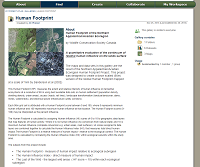
Human footprint of the northern Appalachian/Acadian ecoregion
2012 to 2013
Summary
The maps and data sets in this gallery are the result of the Northern Appalachian/Acadian Ecoregion Human Footprint Project. This project was designed to create a down scaled (90m) version of the Global Human Footprint mapped at a scale of 1km by Sanderson et al (2002).
Key Personnel & Institutions
Institutions: Data Basin , Two Countries One Forest
Location
New York, New England
Resource Type
Map
Tags
human footprint, human influence index, Northern Appalachians
Topic Tags
conservation, wildlife and habitat, landscape pattern and connectivity
Purpose Tags
management
Citation
Two Countries One Forest. (2013). Human Footprint [map]. Retrieved from https://2c1forest.databasin.org/galleries/ff9e496d5eb14aadafa22064462c5e65
Source Link
https://2c1forest.databasin.org/galleries/ff9e496d5eb14aadafa22064462c5e65
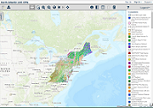
North Atlantic terrestrial habitat
2017 to 2018
Summary
These dataset provide information on various ecosystems throughout New England created by the Conservation Biology Institute.
Key Personnel & Institutions
Institutions: Data Basin , Northeast Conservation Planning Atlas
Location
New York, New England
Resource Type
Map
Tags
ecosystems, formations, landcover
Topic Tags
landscape pattern and connectivity
Purpose Tags
management, education
Citation
Conservation Biology Institute. (2018). Northeast Conservation Planning Atlas [map]. Retrieved from https://nalcc.databasin.org/maps/new#datasets=20f6caffbec545c29b7e391f934e2651
Source Link
https://nalcc.databasin.org/maps/new#datasets=20f6caffbec545c29b7e391f934e2651
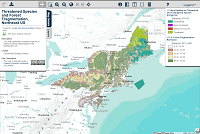
Threatened species and forest fragmentation
2009 to 2010
Summary
This map provides locations of threatened species along with areas of forest fragmentation
Key Personnel & Institutions
Institutions: Data Basin
Location
New York, New England
Resource Type
Map
Tags
endangered species, wildlife, habitat threats, landcover, risk assesment, threats, wildlife habitat
Topic Tags
conservation, wildlife and habitat, landscape pattern and connectivity
Purpose Tags
management, education
Citation
Conservation Biology Institute. (2010). Threatened Species and Forest Fragmentation, Northeast US [map]. Retrieved from https://databasin.org/maps/1177a5b4fec4470e829e29cf575527a3/active
Source Link
https://databasin.org/maps/1177a5b4fec4470e829e29cf575527a3/active
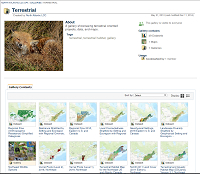
North Atlantic landscape conservation cooperative data basin
2013 to 2014
Summary
Northeast Conservation planning atlas gallery of terrestial related projects, data, and maps.
Key Personnel & Institutions
Institutions: Northeast Conservation Planning Atlas
Location
New York, New England
Resource Type
Map
Tags
community patterns, conservation, conservation planning, terrestrial habitat
Topic Tags
conservation, planning, wildlife and habitat, landscape pattern and connectivity
Purpose Tags
management, education
Citation
Northeast Conservation Planning Atlas. (2014). Terrestrial [map]. Retrieved from https://nalcc.databasin.org/galleries/012067d1312f463b9c0a7aa1d594b887
Source Link
https://nalcc.databasin.org/galleries/012067d1312f463b9c0a7aa1d594b887
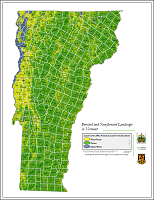
Forested and non-forested landscape in Vermont
2011 to 2012
Summary
This map compares forested and non-forested lands in the state of Vermont.
Key Personnel & Institutions
Institutions: Vermont Agency of Natural Resources
Location
VERMONT
Resource Type
Map
Tags
landcover
Topic Tags
landscape pattern and connectivity
Purpose Tags
management, education
Citation
Vermont Agency of Natural Resources. (2012). Forested and Non-forested Landscape in Vermont. Vermont [map]. Retrieved from http://anr.vermont.gov/sites/anr/files/gis/documents/Forested Landscape in Vermont.pdf
Source Link
http://anr.vermont.gov/sites/anr/files/gis/documents/Forested Landscape in Vermont.pdf
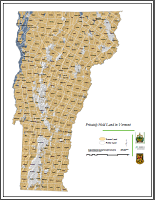
Privately held land in Vermont
2011 to 2012
Summary
Map showing privately owned and publically owned land in VT
Key Personnel & Institutions
Institutions: Vermont Agency of Natural Resources
Location
VERMONT
Resource Type
Map
Tags
land ownership, landowners, private land
Topic Tags
landscape pattern and connectivity
Purpose Tags
management, education
Citation
Vermont Agency of Natural Resources. (2012). Privately Held Land in Vermont [map]. Retrieved from http://anr.vermont.gov/sites/anr/files/gis/documents/Private Land in Vermont.pdf
Source Link
http://anr.vermont.gov/sites/anr/files/gis/documents/Private Land in Vermont.pdf
Vermont S165 An act relating to forest fragmentation and Act 250
2018 to 2019
Summary
This is an introduced bill to protect forest resources by amending the permit criteria of Act 250, the Vermont land use law. This bill specifically addresses forest fragmentation, the protection of natural communities, and protection for threatened and endangered species, citing the need to reduce development in natural areas in a way that will further fragment the forest or will negatively impact sensitive species and to mitigate damages to natural communities that cannot be avoided.
Key Personnel & Institutions
People: Virginia Lyons , Christopher Bray, Alison Clarkson, Anthony Pollina, Becca Balint, Brian Campion, Dick McCormack, Ruth Hardy
Location
VERMONT
Resource Type
Policy
Tags
No tag keywords available
Topic Tags
conservation, management, wildlife and habitat, landscape pattern and connectivity
Purpose Tags
policy
Citation
Vermont S165: An act relating to forest fragmentation and Act 250, VT Legislation Number 339629 v.2. (2019)
Source Link
Forest Fragmentation Analysis from Multiple Imaging Formats
1999 to 2018
Summary
This study examines the difference in forest fragmentation data based on image resolution, and found significant differences in fragmentation metrics based on the resolution used. The authors then discuss reasons for this disparity and why it is important.
Key Personnel & Institutions
People: Iris Fynn, James Campbell
Institutions: Virginia Tech
Location
No location information available
Resource Type
Article
Tags
No tag keywords available
Topic Tags
conservation, methods, management, landscape pattern and connectivity
Purpose Tags
management
Citation
Fynn, I. E., & Campbell, J. (2019). Forest Fragmentation Analysis from Multiple Imaging Formats. Journal of Landscape Ecology, 12(1), 1-15.
Source Link
https://content.sciendo.com/view/journals/jlecol/12/1/article-p1.xml
Local abundance of Ixodes scapularis in forests: Effects of environmental moisture, vegetation characteristics, and host abundance
2009 to 2019
Summary
The authors studied environmental factors that promote Ixodes scapularis, or the black-legged tick, which carries Lyme disease. They also determined that studies should include both host counts and flag/drag counts of ticks to conduct a more complete study of black-legged tick populations.
Key Personnel & Institutions
People: Howard Ginsberg, Eric Rulison, Jasmine Miller, Genevieve Pang, Isis Arsnoe, Nicholas Ogden, Roger LeBrun, Jean Tsao, Graham J. Hickling
Institutions: Michigan State University , Patuxent Wildlife Research Center, Rhode Island Field Station, University of Rhode Island, University of Tennessee Institute of Agriculture, Public Health Agency of Canada
Location
No location information available
Resource Type
Article
Tags
No tag keywords available
Topic Tags
No topic tag keywords available
Purpose Tags
No purpose tag keywords available
Citation
Ginsberg, H. S., Rulison, E. L., Miller, J. L., Pang, G., Arsnoe, I. M., Hickling, G. J., ... & Tsao, J. I. (2020). Local abundance of Ixodes scapularis in forests: Effects of environmental moisture, vegetation characteristics, and host abundance. Ticks and tick-borne diseases, 11(1), 101271.
Source Link
https://www.sciencedirect.com/science/article/pii/S1877959X19301827
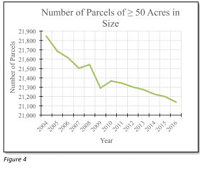
Vermont forest parcels shrinking, report shows
2003 to 2015
Summary
This article discusses a report released by the Vermont Natural Resources Council that found Vermont's land parcels to be shrinking.
Key Personnel & Institutions
People: Elizabeth Gribkoff
Institutions: VTDigger
Location
VERMONT
Resource Type
Website
Tags
No tag keywords available
Topic Tags
conservation, management, ecosystem services, drivers, landscape pattern and connectivity
Purpose Tags
conservation, management
Citation
Gribkoff, E. (2018, Oct. 3). Vermont forest parcels shrinking, report shows. Retrieved from: https://vtdigger.org/2018/10/03/vermont-forest-parcels-shrinking-report-shows/
Source Link
https://vtdigger.org/2018/10/03/vermont-forest-parcels-shrinking-report-shows/
Toward a Salt Marsh Management Plan for New York City: Recommendations for Strategic Restoration and Protection
2018
Summary
Salt marshes provide important ecosystem services in New York City, and many have been destroyed by development. The authors recommended preservation techniques after identifying vunerability of different marshes and threats to the marshes.
Key Personnel & Institutions
People: Christopher Haight, Marit Larson, Marit Larson , Rebecca Swadek, Ellen Kracauer Hartig
Institutions: New York City Department of Parks & Recreation
Location
No location information available
Resource Type
Article
Tags
No tag keywords available
Topic Tags
No topic tag keywords available
Purpose Tags
No purpose tag keywords available
Citation
Haight, C., Larson, M., Swadek, R. K., & Hartig, E. K. (2019). Toward a Salt Marsh Management Plan for New York City: Recommendations for Strategic Restoration and Protection. In Coastal Wetlands (pp. 997-1022). Elsevier.
Source Link
https://www.sciencedirect.com/science/article/pii/B9780444638939000290
Local policy and landowner attitudes: A case study of forest fragmentation
2011 to 2017
Summary
The study looks at ways to minimize development damage on forests in Wisconsin without alienating landowners by implementing restrictive policies.
Key Personnel & Institutions
People: Anna Haines, Aaron Thompson, Daniel McFarlane, Anthony Sharp
Institutions: University of Wisconsin, Stevens Point, Purdue University, Land and Water Conservation Department, Waupaca County, WI
Location
No location information available
Resource Type
Article
Tags
No tag keywords available
Topic Tags
conservation, methods, management, planning, landscape pattern and connectivity
Purpose Tags
management, policy
Citation
Haines, A. L., Thompson, A. W., McFarlane, D., & Sharp, A. K. (2019). Local policy and landowner attitudes: A case study of forest fragmentation. Landscape and Urban Planning, 188, 97-109.
Source Link
https://www.sciencedirect.com/science/article/pii/S016920461830937X
Impact of time on interpretations of forest fragmentation: Three-decades of fragmentation dynamics over Canada
1983 to 2018
Summary
The authors analyzed forest fragmentation across Canada that has occurred in the last 30 years and examined the ability of fragmented forest regions to return to a pre-disturbance state.
Key Personnel & Institutions
People: Txomin Hermosilla, Michael Wulder, Joanne White, Nicholas Coops, Paul Pickell, Douglas Bolton
Institutions: Boston University , Canadian Forest Service, University of British Columbia
Location
No location information available
Resource Type
Article
Tags
No tag keywords available
Topic Tags
conservation, drivers, landscape pattern and connectivity
Purpose Tags
conservation
Citation
Hermosilla, T., Wulder, M. A., White, J. C., Coops, N. C., Pickell, P. D., & Bolton, D. K. (2019). Impact of time on interpretations of forest fragmentation: Three-decades of fragmentation dynamics over Canada. Remote sensing of environment, 222, 65-77.
Source Link
https://www.sciencedirect.com/science/article/pii/S0034425718305807
High burdens of Ixodes scapularis larval ticks on white-tailed deer may limit Lyme disease risk in a low biodiversity setting
2013 to 2018
Summary
The authors used back-esitmates to research the potential of white-tailed deer as a dilution host.
Key Personnel & Institutions
People: Ching-I Huang, Samantha Kay, Stephen Davis, Danielle Tufts, Kimberley Gaffett, Maria Diuk-Wasser, Brian Tefft
Institutions: Columbia University , Royal Melbourne Institute of Technology, The Nature Conservancy on Block Island, Rhode Island Department of Environmental Management
Location
Rhode Island
Resource Type
Article
Tags
No tag keywords available
Topic Tags
management, drivers, wildlife and habitat, landscape pattern and connectivity
Purpose Tags
management
Citation
Huang, C. I., Kay, S. C., Davis, S., Tufts, D. M., Gaffett, K., Tefft, B., & Diuk-Wasser, M. A. (2019). High burdens of Ixodes scapularis larval ticks on white-tailed deer may limit Lyme disease risk in a low biodiversity setting. Ticks and tick-borne diseases, 10(2), 258-268.
Source Link
https://www.sciencedirect.com/science/article/pii/S1877959X18302991
Tracking the endangered Northern Black Racer, Coluber constrictor constrictor, in Maine to determine areas of conservation importance
2017 to 2018
Summary
The author participated in research on a subspecies of the Black Racer (Coluber constrictor), the Northern Black Racer (C. constrictor constrictor), which is endangered due to its restricted range in Maine. The study sought to fill knowledge gaps on specific habitat preferences of Northern Black Racers in Maine to promote more effective conservation efforts.
Key Personnel & Institutions
People: Josiah Johnson
Institutions: Colby College
Location
Maine
Resource Type
Article
Tags
No tag keywords available
Topic Tags
conservation, management, wildlife and habitat, landscape pattern and connectivity
Purpose Tags
conservation, management
Citation
Johnson, J. (2019). Tracking the endangered Northern Black Racer, Coluber constrictor constrictor, in Maine to determine areas of conservation importance.
Source Link
https://digitalcommons.colby.edu/cgi/viewcontent.cgi?article=1982&context=honorstheses
Research and Conservation of the New England Cottontail Rabbit (Final Report for the Cooperative Agreement between the U.S. Fish and Wildlife Service and the University of New Hampshire)
2012 to 2015
Summary
This article is a summary of work done by Dr. Adrienne Kovach and affiliates on the impacts of habitat fragmentation on the New England cottontail. Dr. Kovach and her affiliates' research has helped conservationists determine where New England cottontail populations are located, better methodologies to survey for New England cottontails, what the genetic structure of different populations is, and how habitat fragmentation can have negative effects on the genetic diversity and health of New England cottontails. Links to the report and other research articles can be found at the bottom of this summary article: https://newenglandcottontail.org/content/connecting-populations.
Key Personnel & Institutions
People: Lindsey Fenderson , Adrienne Kovach, Kathleen O'Brien, Kelly Boland, Walter Jakubas, Katrina Amaral, Michael Palace, Thea Kristensen
Institutions: University of New Hampshire , US Fish & Wildlife Service , Maine Department of Inland Fisheries & Wildlife
Location
Maine, Connecticut
Resource Type
Report
Tags
No tag keywords available
Topic Tags
conservation, methods, management, wildlife and habitat, landscape pattern and connectivity
Purpose Tags
conservation, management
Citation
Kovach, A. (2016). Final Report for the Cooperative Agreement between the U.S. Fish and Wildlife Serice and the University of New Hampshire (#F13AC00103).
Source Link
https://newenglandcottontail.org/content/connecting-populations
Wild Canid Distribution and Co-existence in a Natural–Urban Matrix of the Pioneer Valley of Western Massachusetts
2011 to 2018
Summary
Some carnivoran species, such as coyote (Canis latrans), red fox (Vulpes vulpes), and gray fox (Urocyon cinereoargenteus), have semi-adapted to human development and can compete for resources in urban areas. The authors determined site characteristics, prey species, and distribution patterns of these three species in Pioneer Valley, MA.
Key Personnel & Institutions
People: Stephen DeStefaNo , Eric LeFlore, Todd Fuller, John Finn, John Organ
Institutions: United States Geological Survey (USGS) , University of Massachusetts Amherst
Location
Massachusetts
Resource Type
Article
Tags
No tag keywords available
Topic Tags
conservation, wildlife and habitat, landscape pattern and connectivity
Purpose Tags
conservation
Citation
LeFlore, E. G., Fuller, T. K., Finn, J. T., DeStefano, S., & Organ, J. F. (2019). Wild Canid Distribution and Co-existence in a Natural–Urban Matrix of the Pioneer Valley of Western Massachusetts. Northeastern Naturalist, 26(2), 325-342.
Source Link
Early Successional Forest Management on Private Lands as a Coupled Human and Natural System
2014 to 2018
Summary
A lot of forested land around the world is privately owned, making voluntary conservation on private lands crucial for preventing forest loss and mitigating forest fragmentation. Research has shown that social factors, such as economics, can be used for positive outcomes in forest management on private lands, and the authors sought to determine if forest management for the benefit of wildlife would have a similar impact on voluntary forest management.
Key Personnel & Institutions
People: Seth Lutter, Ashley Dayer, Amanda Rodewald, Darin McNeil, Jeffery Larkin
Institutions: Cornell University , Virginia Polytechnic Institute and State University, Indiana University of Pennsylvania, American Bird Conservancy
Location
No location information available
Resource Type
Article
Tags
No tag keywords available
Topic Tags
conservation, management, ecosystem services, wildlife and habitat
Purpose Tags
conservation, management
Citation
Lutter, S. H., Dayer, A. A., Rodewald, A. D., McNeil, D. J., & Larkin, J. L. (2019). Early Successional Forest Management on Private Lands as a Coupled Human and Natural System. Forests, 10(6), 499.
Source Link
Missing the people for the trees: Identifying coupled natural–human system feedbacks driving the ecology of Lyme disease
2000 to 2017
Summary
This study looks at Lyme disease through the lens of fragmentation and human interaction with fragmented landscapes to provide recommendations for reducing the incidence of Lyme disease in human populations.
Key Personnel & Institutions
People: Andrew MacDonald, Ashley Larsen, Andrew Plantinga
Institutions: Stanford University, University of California, Santa Barbara
Location
New England
Resource Type
Article
Tags
No tag keywords available
Topic Tags
management, drivers, landscape pattern and connectivity
Purpose Tags
management, policy
Citation
MacDonald, A. J., Larsen, A. E., & Plantinga, A. J. (2019). Missing the people for the trees: Identifying coupled natural–human system feedbacks driving the ecology of Lyme disease. Journal of applied ecology, 56(2), 354-364.
Source Link
https://besjournals.onlinelibrary.wiley.com/doi/full/10.1111/1365-2664.13289
Floristic Change in New England and New York: Regional Patterns of Plant Species Loss and Decline
1878 to 2018
Summary
The authors examine changes in floristic communities across New England and New York from the late 1800's to 2019.
Key Personnel & Institutions
People: Caitlin McDonough MacKenzie, Glen Mittelhauser , Abraham Miller-Rushing, Richard Primack , Richard Primack
Institutions: University of Maine , Boston University , Maine Natural History Observatory, Acadia National Park, Schoodic Institute
Location
No location information available
Resource Type
Article
Tags
No tag keywords available
Topic Tags
No topic tag keywords available
Purpose Tags
No purpose tag keywords available
Citation
MacKenzie, C. M., Mittelhauser, G., Miller-Rushing, A. J., & Primack, R. B. (2019). Floristic change in New England and New York: regional patterns of plant species loss and decline. Rhodora, 121(985), 1-36.
Source Link
Stream salamander persistence influenced by the interaction between exurban housing age and development
2013 to 2018
Summary
Urban stream syndrome describes the changes that occur to a stream ecosystem when development occurs. Since exurban development has increased, it is important to understand how these changes impact species such as salamanders. The authors wante to understand which stream features were most important to promote long-term persistence of salamanders in urban stream syndrome streams, using Eurycea bislineata (northern two-lined salamander) and Desmognathus fuscus (northern dusky salamander) as case studies.
Key Personnel & Institutions
People: D. Cristina Macklem , Ashley Helton, Morgan Tingley , Jenny Dickson, Tracy Rittenhouse
Institutions: University of Connecticut, Connecticut Department of Energy and Environmental Protection (DEEP)
Location
Connecticut
Resource Type
Article
Tags
No tag keywords available
Topic Tags
conservation, management, wildlife and habitat
Purpose Tags
conservation
Citation
Macklem, D. C., Helton, A. M., Tingley, M. W., Dickson, J. M., & Rittenhouse, T. A. (2019). Stream salamander persistence influenced by the interaction between exurban housing age and development. Urban Ecosystems, 1-16.
Source Link
https://link.springer.com/article/10.1007/s11252-019-00883-5
Family forest owners and landscape-scale interactions: A review
1990 to 2018
Summary
The author conducted a literature analysis of trends occuring on small-owner- and collective-managed forested landscapes across the globe. Generally, there was a theme of increased parcelization and globalized pressure to convert forested landscapes to plantations or over-exploit them for forest products, both of which can facilitate fragmentation and forest loss. Programs and policies targeting small land-holders and communal forest owners that incentivize protection and restoration of their forests, such as forest-based tourism and non-timber forest products, are extremely effective, under-valued methods to protect forested landscapes and promote biodiversity.
Key Personnel & Institutions
People: Audrey Mayer
Institutions: Michigan Technological University
Location
No location information available
Resource Type
Article
Tags
No tag keywords available
Topic Tags
conservation, management, ecosystem services, planning, drivers, landscape pattern and connectivity
Purpose Tags
conservation, management, policy
Citation
Mayer, A. L. (2019). Family forest owners and landscape-scale interactions: A review. Landscape and Urban Planning, 188, 4-18.
Source Link
https://www.sciencedirect.com/science/article/pii/S0169204618311927
Perspectives of resource management professionals on the future of New England’s landscape: Challenges, barriers, and opportunities
2013 to 2018
Summary
This research looks at family forest owners in New England to determine what stakeholders believe to be the driving factor behind land use change, how to better incentivize forest stewardship, and proposed solutions for revising incentives and diversifying outreach programs.
Key Personnel & Institutions
People: Jonathan Thompson , Marissa McBride, Matthew Duveneck , Kathleen Lambert, Kathleen Theoharides, Matthew Duveneck
Institutions: Harvard University, Harvard Forest , Massachusetts Executive Office of Energy and Environmental Affairs
Location
No location information available
Resource Type
Article
Tags
No tag keywords available
Topic Tags
No topic tag keywords available
Purpose Tags
No purpose tag keywords available
Citation
McBride, M. F., Duveneck, M. J., Lambert, K. F., Theoharides, K. A., & Thompson, J. R. (2019). Perspectives of resource management professionals on the future of New England’s landscape: Challenges, barriers, and opportunities. Landscape and Urban Planning, 188, 30-42.
Source Link
https://www.sciencedirect.com/science/article/pii/S0169204618311988
An assessment of ecological values and conservation gaps in protection beyond the corridor of the Appalachian Trail
2012 to 2017
Summary
This research focuses on conservation differences across states and regions spanned by the Appalachian Trail, with the purpose of filling knowledge gaps and providing spatial data that can be used for maintenance in the future.
Key Personnel & Institutions
People: Peter McKinley, R. Travis Belote, Gregory Aplet , Gregory Aplet
Institutions: The Wilderness Society
Location
No location information available
Resource Type
Article
Tags
No tag keywords available
Topic Tags
No topic tag keywords available
Purpose Tags
No purpose tag keywords available
Citation
McKinley, P. S., Belote, R. T., & Aplet, G. H. (2019). An assessment of ecological values and conservation gaps in protection beyond the corridor of the Appalachian Trail. Conservation Science and Practice, 1(6), e30.
Source Link
https://conbio.onlinelibrary.wiley.com/doi/full/10.1111/csp2.30
The environmental consequences of forest fragmentation in the Western Maine Mountains
2017
Summary
The author explains forest fragmentation in the context of Maine's forests, detailing drivers and impacts of fragmentation on Maine's landscape and wildlife.
Key Personnel & Institutions
People: Janet McMahon
Institutions: Maine Mountain Collaborative
Location
Maine
Resource Type
Report
Tags
No tag keywords available
Topic Tags
conservation, management, drivers, wildlife and habitat, landscape pattern and connectivity
Purpose Tags
conservation, education
Citation
McMahon, J. (2018). The Environmental Consequences of FOREST FRAGMENTATION in the Western Maine Mountains.
Source Link
A comparison of participants and non-participants of state forest property tax programs in the United States
2010 to 2018
Summary
Forest property tax programs are widely and effectively used to incentivize good forest stewardship on privately-owned lands. The authors were interested in characterizing family forest owners who are enrolled in forest property tax programs to better understand why a portion of family forest owners do not participate in these programs. Through a better understanding of these dynamics, increased participation in these programs may be attained.
Key Personnel & Institutions
People: Michael Kilgore, Charles Blinn, Justin Meier, Stephanie Snyder, Gregory Frey
Institutions: United States Department of Agriculture (USDA), Forest Service, Southern Research Station , United States Department of Agriculture (USDA), Forest Service, Northern Research Station , University of Minnesota
Location
No location information available
Resource Type
Article
Tags
No tag keywords available
Topic Tags
conservation, management, drivers, landscape pattern and connectivity
Purpose Tags
conservation, management, policy
Citation
Meier, J. T., Kilgore, M. A., Frey, G. E., Snyder, S. A., & Blinn, C. R. (2019). A comparison of participants and non-participants of state forest property tax programs in the United States. Forest Policy and Economics, 102, 10-16.
Source Link
https://www.sciencedirect.com/science/article/pii/S1389934118304386

Gastrointestinal parasites of the New England cottontail rabbit (Sylvilagus transitionalis) and eastern cottontail rabbit (Sylvilagus floridanus) in the Hudson Valley, New York
2012 to 2018
Summary
The goal of this study was to investigate the decline of the New England cottontail rabbit and the explosion of the introduced eastern cottontail in the context of gastrointestinal parasites. The majority of rabbits surveyed were found to harbor at least one parasite species, regardless of rabbit species, but the eastern cottontail was found to have a significantly higher parasite species richness than the New England cottontail. The authors noted that future work will be completed to genetically confirm parasite identifications and resolve some remaining questions.
Key Personnel & Institutions
People: Christopher Whipps, Jonathan Cohen, Emily Gavard, Sadie Ryan
Institutions: The State University of New York (SUNY), College of Environmental Science and Forestry (ESF) , University of Florida
Location
New York
Resource Type
Article
Tags
No tag keywords available
Topic Tags
conservation, drivers, wildlife and habitat
Purpose Tags
conservation
Citation
Whipps, C. M., Gavard, E. J., Cohen, J., & Ryan, S. J. (2019). Gastrointestinal parasites of the New England cottontail rabbit (Sylvilagus transitionalis) and eastern cottontail rabbit (Sylvilagus floridanus) in the Hudson Valley, New York. Parasitology research, 1-6.
Source Link
https://link.springer.com/article/10.1007/s00436-019-06351-5
Ovenbird
2019 to 2018
Summary
This author describes ovenbird habitat, conservation, and identification, focusing on Connecticut.
Key Personnel & Institutions
People: Chris Wood
Institutions: Connecticut Audubon Society
Location
Connecticut
Resource Type
Website
Tags
No tag keywords available
Topic Tags
conservation, wildlife and habitat
Purpose Tags
education
Citation
Wood, C. (2019, June 28). Ovenbird. Retrieved from: https://www.ctaudubon.org/2019/06/ovenbird/#sthash.ZO3DoV7J.kmwhkKQx.dpbs
Source Link
https://www.ctaudubon.org/2019/06/ovenbird/#sthash.ZO3DoV7J.R0rdNnn0.dpbs
The effects of habitat loss and fragmentation on plant functional traits and functional diversity: what do we know so far?
1959 to 2018
Summary
The authors conducted a literature review on the impacts of fragmentation and habitat loss on plant individual functional traits, or a plant's ability to persist, disperse, and establish itself in a new location, and plant fuctional diversity. Following their summary of fragmentation impacts on fuctional traits and diversity, they discussed current knowledge gaps and proposed ways to move forward.
Key Personnel & Institutions
People: Jenny Zambrano, Carol Garzon-Lopez, Lauren Yeager, Claire Fortunel, Norbert Cordeiro, Noelle Beckman, Noelle Beckman
Institutions: Utah State University, University of California , Washington State University, Universidad de los Andes, University of Texas at Austin, Roosevelt University, The Field Museum, Universite de Montpellier
Location
No location information available
Resource Type
Article
Tags
No tag keywords available
Topic Tags
No topic tag keywords available
Purpose Tags
No purpose tag keywords available
Citation
Zambrano, J., Garzon-Lopez, C. X., Yeager, L., Fortunel, C., Cordeiro, N. J., & Beckman, N. G. (2019). The effects of habitat loss and fragmentation on plant functional traits and functional diversity: what do we know so far?. Oecologia, 191(3), 505-518.
Source Link
https://link.springer.com/content/pdf/10.1007/s00442-019-04505-x.pdf
Forest fragmentation and biodiversity: the case for intermediate-sized conservation areas
2009
Summary
A review of 58 papers on effects of forest fragmentation reveals that general conclusions from fragmentation research are biased due to a focus on birds, on size-effects rather than isolation, and on species presence rather than population sizes. Perhaps the most important finding is that current knowledge on fragmentation effects is based mainly on studies in small fragments (<10 ha).
Key Personnel & Institutions
Not available.Location
New England, New York
Resource Type
Article
Tags
analysis, assessment
Topic Tags
conservation, methods, planning, wildlife and habitat
Purpose Tags
conservation, education
Citation
Zuidema, P.A., Sayer, J.A., Dijkman, W. "Forest Fragmentation and Biodiversity: The Case for Intermediate-sized Conservation Areas." Cambridge Core, Cambridge University Press. vol. 23, issue 4, December 1996, pp. 290-297. Accessed from (https://www.cambridge.org/core/journals/environmental-conservation/article/forest-fragmentation-and-biodiversity-the-case-for-intermediatesized-conservation-areas/34D3DEA131ABA80454D095F505EBAFF7#fndtn-information)
Source Link
The Dynamics of Temperate Forest Fragmentation: an Examination of Susceptibility to Woody Invasive Species
2000
Summary
The assessment of the effects of fragmentation on the susceptibility of Eastern deciduous forests to woody invasive species. Study is a count of woody individuals in plots Williamstown, Massachusetts.
Key Personnel & Institutions
People: Henry (Hank) Art
Institutions: Williams College
Location
WILLIAMSTOWN
Resource Type
Report
Tags
fragmentation, invasives
Topic Tags
conservation, drivers, landscape pattern and connectivity
Purpose Tags
conservation, education
Citation
Buckley, L.B. 2000. "The Dynamics of Temperate Forest Fragmentation: an Examination of Susceptibility to Woody Invasive Species." Accessed from (https://web.williams.edu/wp-etc/ces/temperate-forest-fragmentation.pdf)
Source Link
https://web.williams.edu/wp-etc/ces/temperate-forest-fragmentation.pdf
Habitat Fragmentation Effects Depend on Complex Interactions Between Population Size and Dispersal Ability: Modeling Influences of Roads, Agriculture and Residential Development Across a Range of Life-History Characteristics
2009
Summary
An analysis of the effect of habitat fragmentation by roads, residential and agricultural land uses on hypothetical vernal pool breeding animals in western Massachusetts.
Key Personnel & Institutions
People: Bradley Compton , Kevin McGargal
Institutions: United States Department of Agriculture (USDA), Forest Service, Rocky Mountain Research Station, University of Massachusetts, Department of Natural Resources Conservation
Location
Massachusetts
Resource Type
Report
Tags
agriculture, roads, fragmentation, vernal pools
Topic Tags
conservation, methods, wildlife and habitat, landscape pattern and connectivity
Purpose Tags
conservation, education
Citation
Cushman, S.A.; Compton, B.W.; McGarigal, K. 2009. "Habitat Fragmentation Effects Depend on Complex Interactions Between Population Size and Dispersal Ability: Modeling Influences of Roads, Agriculture and Residential Development Across a Range of Life-History Characteristics." Accessed From (https://www.umass.edu/landeco/pubs/cushman.et.al.2009.chapter20.pdf)
Source Link
https://www.umass.edu/landeco/pubs/cushman.et.al.2009.chapter20.pdf
Impacts of Habitat Loss and Fragmentation on Terrestrial Biodiversity
2018
Summary
An argument for future research on taxonomic groups and global threats such as climate change in order to effectively improve species conservation efforts.
Key Personnel & Institutions
People: Jordan E. Rogan , Thomas E. Lacher
Institutions: Texas A&M University
Location
New England
Resource Type
Article
Tags
biodiversity, fragmentation
Topic Tags
conservation, management, planning, wildlife and habitat, landscape pattern and connectivity
Purpose Tags
conservation, management, education
Citation
Rogan, J.E.; Lacher Jr, T.E. "Impact of Habitat Loss and Fragmentation on Terrestrial Biodiversity." Reference Module in Earth Systems and Environmental Sciences, 2018. Accessed From (https://www.sciencedirect.com/science/article/pii/B9780124095489109133)
Source Link
https://www.sciencedirect.com/science/article/pii/B9780124095489109133
Trends in Massachusetts Forests: A Half-century of Change
1949 to 2002
Summary
An overview of Massachusetts forests quality based on data from the USDA Forest Service periodic inventories.
Key Personnel & Institutions
People: Richard H. Widmann
Institutions: United States Department of Agriculture (USDA), Forest Service, Northern Research Station , Massachusetts Division of Fisheries and Wildlife
Location
Massachusetts
Resource Type
Book
Tags
trends
Topic Tags
conservation, methods, ecosystem services, planning, wildlife and habitat
Purpose Tags
conservation, management, education
Citation
Widmann, R.H. 2002. "Trends in Massachusetts Forests: A Half-century of Change." Accessed From (https://books.google.com/books?id=TjKI0sqcTw4C&printsec=frontcover#v=onepage&q&f=false)
Source Link
Tree Productivity Enhanced with Conversion from Forest to Urban Land Covers
2017
Summary
Article gives an overview of a study on the effects of forest disruption, the subsequent growth period of trees and the changes in carbon storage. In eastern Massachusetts, the trees on the edge of the forests grew 90 percent faster then those in the middle. However, these edges may have a drop in growth rates as they are more sensitive to higher temperatures.
Key Personnel & Institutions
People: Michael Marchand , Andrew Reinmann , Lucy Hutyra , Tammy Malone, Allison Dunn , Brittain M. Briber , Steve M. Raciti , Steve M. Raciti, Victoria K. Dearborn , Christopher E. Holden
Institutions: Boston University, Department of Earth and the Environment, Hofstra University, Department of Biology , Worcester State University, Department of Earth, Environment and Physics
Location
No location information available
Resource Type
Article
Tags
carbon, edge
Topic Tags
No topic tag keywords available
Purpose Tags
No purpose tag keywords available
Citation
Briber BM, Hutyra LR, Reinmann AB, Raciti SM, Dearborn VK, Holden CE, et al. (2015) Tree Productivity Enhanced with Conversion from Forest to Urban Land Covers. PLoS ONE 10(8): e0136237. doi:10.1371/journal.pone.0136237
Source Link
https://journals.plos.org/plosone/article/file?id=10.1371/journal.pone.0136237&type=printable
MassGIS Data: Interior Forest
1998 to 2009
Summary
These datasets identify the extensively forested portions of Massachusetts where forest cover is relatively un-fragmented by human development.
Key Personnel & Institutions
Institutions: Massachusetts Department of Fish and Game
Location
Massachusetts
Resource Type
Map
Tags
interior forest
Topic Tags
management, planning, wildlife and habitat
Purpose Tags
management, education
Citation
Department of Fish and Game MassGIS (Bureau of Geographic Information). October 2018. "MassGIS Data: Interior Forests." Accessed from (https://docs.digital.mass.gov/dataset/massgis-data-interior-forest)
Source Link
https://www.mass.gov/info-details/massgis-data-interior-forest
Forest harvesting and land-use conversion over two decades in Massachusetts
2006
Summary
A look at the ongoing disturbance of forest harvesting and the interaction with land use conversion.
Key Personnel & Institutions
People: C. John Burk , David Foster , David Kittredge , Robert McDonald , Glenn Motzkin , Michael S. Bank
Institutions: Harvard University, Harvard Forest , University of Massachusetts, Department of Natural Resources Conservation
Location
Massachusetts
Resource Type
Article
Tags
harvesting, disturbance, forest conversion
Topic Tags
management, ecosystem services, planning
Purpose Tags
management, education
Citation
McDonald, R.I.; Motzkin, G.; Bank, M.S.; Kittredge, D.B.; Burk, J.; Foster, D.R. 15 May 2006. "Forest harvesting and land-use conversion over two decades in Massachusetts." Forest Ecology and Management, vol. 227, Issues 1-2, Pages 31-41. Accessed From (https://www.sciencedirect.com/science/article/abs/pii/S0378112706000983)
Source Link
https://www.sciencedirect.com/science/article/abs/pii/S0378112706000983
Consequences of forest fragmentation for juvenile survival in spotted (Ambystoma maculatum) and marbled (Ambystoma opacum) salamanders
2005
Summary
This study compared demographic traits of post metamorphic salamanders among old fields, forest interior, and edge habitats over 2 years in order to observe the consequences of forest fragmentation on these salamanders.
Key Personnel & Institutions
People: Betsie B. Rothermel , Raymond D. Semlitsch
Institutions: University of Missouri
Location
New England
Resource Type
Article
Tags
salamanders
Topic Tags
conservation, wildlife and habitat
Purpose Tags
conservation
Citation
Rothermel, B.B.; Semlitsch, R.D. "Consequences of Forest Fragmentation for Juvenile Survival in Spotted (Ambystoma maculatum) and Marbled (Ambystoma opacum) salamanders." Canadian journal of Zoology, 11 July 2006, Accessed from (https://www.nrcresearchpress.com/doi/abs/10.1139/z06-056#.XoSlMohKiUk)
Source Link
https://www.sciencedirect.com/science/article/pii/S0378112706000983
Forest fragmentation predicts local scale heterogeneity of Lyme disease risk
2005
Summary
This study tests weather landscape fragmentation plays a role in the Lyme disease risk based on the density of the host species.
Key Personnel & Institutions
People: John S. Brownstein , David K. Skelly , Theodore R. Holford , Durlan Fish
Institutions: Yale University, School of Forestry and Environmental Studies , Boston Children's Hospital , Yale School of Medicine, Department of Epidemiology and Public Health
Location
Connecticut
Resource Type
Article
Tags
lyme disease
Topic Tags
wildlife and habitat, landscape pattern and connectivity
Purpose Tags
education
Citation
Brownstein, J.S.; Skelly, D.K.; Holford, T.R. et al. "Forest fragmentation predicts local scale heterogeneity of Lyme disease risk." Oecologia 146, 469–475 (2005). https://doi.org/10.1007/s00442-005-0251-9
Source Link
The Ecological Road?Effect Zone of a Massachusetts (U.S.A.) Suburban Highway
2001
Summary
This report studies the effects of human road traffic on the surrounding ecology. The effects of the factors were measured and a conclusion was made that nature reserves and busy roads should be separated.
Key Personnel & Institutions
People: Richard T. T. Forman , Robert D. Deblinger
Institutions: Harvard University , Massachusetts Division of Fisheries and Wildlife, General Court of the Commonwealth of Massachusetts
Location
Massachusetts
Resource Type
Article
Tags
roads
Topic Tags
conservation, methods, management, planning, wildlife and habitat, landscape pattern and connectivity
Purpose Tags
conservation, management, education
Citation
Forman, R.T.T.; Deblinger, R.D. "The Ecological Road-Effect Zone of Massachusetts (U.S.A.) Suburban Highway." Conservation Biology, vol. 14, issue 1, 24 December 2001. Accessed From (https://conbio.onlinelibrary.wiley.com/doi/abs/10.1046/j.1523-1739.2000.99088.x)
Source Link
https://conbio.onlinelibrary.wiley.com/doi/abs/10.1046/j.1523-1739.2000.99088.x
Effects of air quality, urbanization, and fragmentation on aboveground carbon storage of temperate forest ecosystems
2014 to 2019
Summary
A study of the combined effects of urbanization and air quality on carbon storage in vegetation. Tests were performed at seven sites along a 120 km rural to urban gradient across Massachusetts.
Key Personnel & Institutions
People: Lucy Hutyra , Pamela Templer , Richard Primack , Richard Primack, Erin A. Pierce
Institutions: Boston University
Location
No location information available
Resource Type
Article
Tags
carbon
Topic Tags
No topic tag keywords available
Purpose Tags
No purpose tag keywords available
Citation
Pierce, E.A. 2019. "Effects of Air Quality, Urbanization, and Fragmentation on Aboveground Carbon Storage of Temperate Forest Ecosystems." Accessed From (https://open.bu.edu/ds2/stream/?#/documents/387435/page/1)
Source Link
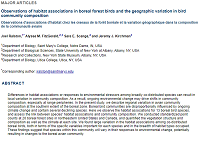
Observations of habitat associations in boreal forest birds and the geographic variation in bird community composition
2018
Summary
The authors described regional variation in boreal bird community composition to understand how climate change may affect the boreal avian community.
Key Personnel & Institutions
People: Jeremy Kirchman, Jeremy Kirchman , Joel Ralston, Alyssa FitzGerald, Sara Scanga , Sara Scanga
Institutions: Saint Mary's College, The State University of New York (SUNY), New York State Museum, Utica College
Location
No location information available
Resource Type
Article
Tags
No tag keywords available
Topic Tags
No topic tag keywords available
Purpose Tags
No purpose tag keywords available
Citation
Ralston, J., FitzGerald, A. M., Scanga, S. E., & Kirchman, J. J. (2019). Observations of habitat associations in boreal forest birds and the geographic variation in bird community composition. The Wilson Journal of Ornithology, 131(1), 12-23.
Source Link
Bumble bee (Bombus) distribution and diversity in Vermont, USA: a century of change
1914 to 2017
Summary
Certain bumble bee species, all of which are important pollinators in temperate ecosystems, have been declining due to factors including habitat loss, parasites, pesticides, and climate change. Conservation efforts for these species are difficult, as there is a lack of quantitative data on historical abundance and distrubution. The authors, with the help of 53 citizen scientists, conducted bumble bee surveys in Vermont and identified and digitized bumble bee speciments in 13 collections, showing a trend of srong decline in species abundance, diversity, and richness.
Key Personnel & Institutions
People: Kent McFarland , Leif Richardson , Spencer Hardy, Sara Zahendra
Institutions: University of Vermont , Vermont Center for Ecostudies, VCE , Middlebury College
Location
VERMONT
Resource Type
Article
Tags
No tag keywords available
Topic Tags
conservation, management, drivers, wildlife and habitat, landscape pattern and connectivity
Purpose Tags
conservation, management, education
Citation
Richardson, L. L., McFarland, K. P., Zahendra, S., & Hardy, S. (2019). Bumble bee (Bombus) distribution and diversity in Vermont, USA: a century of change. Journal of Insect Conservation, 23(1), 45-62.
Source Link
https://www.sciencedirect.com/science/article/pii/S0169204618311927

National Update of Forest Fragmentation Indicators, 2001-2011
2000 to 2015
Summary
The author summaries forest fragmentation trends in the conterminous United States from 2001 to 2011, using multiscale forest area density as the primary indicator. By looking at fragmentation as a change in forest area density on several different magnitudes of scale, forest fragmentation could be summarized more accurately.
Key Personnel & Institutions
People: Kurt Riitters
Institutions: United States Department of Agriculture (USDA), Forest Service, Southern Research Station
Location
No location information available
Resource Type
Book
Tags
No tag keywords available
Topic Tags
conservation, management, landscape pattern and connectivity
Purpose Tags
conservation, education
Citation
Riitters, K. (2019). National Update of Forest Fragmentation Indicators, 2001–2011. In: Potter, Kevin M.; Conkling, Barbara L., eds. 2016. Forest health monitoring: national status, trends, and analysis 2015. Gen. Tech. Rep. SRS-213. Asheville, NC: US Department of Agriculture, Forest Service, Southern Research Station. 226 p., 213, 93-102.
Source Link
Direct and Indirect Effects of Anthropogenic Land Use on Bobcats (Lynx rufus) in New England
2018
Summary
This document is a dissertation on the decline and resurgence of the bobcat in New England, related to anthropogenic land use. The author explores historic and modern genetics, diet, and stress of New England bobcat populations, and then connects these to historic and modern land uses.
Key Personnel & Institutions
People: Rory Carroll
Institutions: University of New Hampshire
Location
New England
Resource Type
Article
Tags
No tag keywords available
Topic Tags
conservation, drivers, wildlife and habitat, landscape pattern and connectivity
Purpose Tags
conservation
Citation
Carroll, R. P. (2019). Direct and Indirect Effects of Anthropogenic Land Use on Bobcats (Lynx rufus) in New England (Doctoral dissertation, University of New Hampshire).
Source Link
https://scholars.unh.edu/cgi/viewcontent.cgi?article=3438&context=dissertation
Implementation of an occupancy-based monitoring protocol for a widespread and cryptic species, the New England cottontail (Sylvilagus transitionalis)
2014 to 2018
Summary
The goal of this study was to recommend an effective, long-term monitoring strategy for the New England cottontail that would be adaptable to other species. Based on their findings, the suthors give monitoring recommendations and conservation implications.
Key Personnel & Institutions
People: Colin Shea, Mitchell Eaton, Darryl MacKenzie
Institutions: North Carolina State University
Location
Massachusetts, Maine, New Hampshire, Connecticut, Rhode Island, New York
Resource Type
Article
Tags
No tag keywords available
Topic Tags
conservation, methods, management, wildlife and habitat, landscape pattern and connectivity
Purpose Tags
conservation, management, policy
Citation
Shea, C. P., Eaton, M. J., & MacKenzie, D. I. (2019). Implementation of an occupancy-based monitoring protocol for a widespread and cryptic species, the New England cottontail (Sylvilagus transitionalis). Wildlife Research, 46(3), 222-235.
Source Link
Evidence for Edge Enhancements of Soil Respiration in Temperate Forests
2015 to 2018
Summary
Forests often act as a net carbon sink, while forest soils emit carbon dioxide via decomposition and biological activity, called soil respiration. The effects of forest fragmentation on a forest's ability to store carbon are unknown, so the authors studied forest soil respiration in fragmented forest edges and compared their results to soil respiration in unfragmented forest interiors. They found that forest soils from fragmented edges emit more carbon dioxide than interior forest soils, identifying a phenomenon in the carbon cycle that has implications for understanding carbon exchange in fragmented landscapes.
Key Personnel & Institutions
People: Andrew Reinmann , Jonathan Thompson , Lucy Hutyra , Ian Smith , David Allen
Institutions: Boston University , Harvard University , City University of New York, Hunter College, National Institute of Standards and Technology
Location
Massachusetts
Resource Type
Article
Tags
No tag keywords available
Topic Tags
ecosystem services, drivers, landscape pattern and connectivity
Purpose Tags
management
Citation
Smith, I. A., Hutyra, L. R., Reinmann, A. B., Thompson, J. R., & Allen, D. W. (2019). Evidence for edge enhancements of soil respiration in temperate forests. Geophysical Research Letters, 46(8), 4278-4287.
Source Link
https://agupubs.onlinelibrary.wiley.com/doi/full/10.1029/2019GL082459
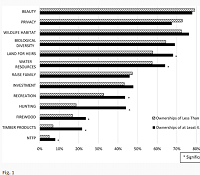
Small-Area Family Forest Ownerships in the USA
2010 to 2017
Summary
The authors researched small family forest owners (<4 ha) to see how they managed their forests in comparison to larger family forest owners, since small family forest owners are often excluded from research due to the small size of their forest holding yet they make up 60% of all family forest owners in the United States.
Key Personnel & Institutions
People: Brett Butler , Marla Markowski-Lindsay, Stephanie Snyder
Institutions: University of Massachusetts Amherst , United States Department of Agriculture (USDA), Forest Service, Northern Research Station
Location
No location information available
Resource Type
Article
Tags
No tag keywords available
Topic Tags
conservation, management, ecosystem services, wildlife and habitat
Purpose Tags
management
Citation
Snyder, S. A., Butler, B. J., & Markowski-Lindsay, M. (2019). Small-Area Family Forest Ownerships in the USA. Small-scale Forestry, 18(1), 127-147.
Source Link
How CMP’s $1 billion hydro project could affect habitat in a wild corner of Maine
2018
Summary
The article discusses the New England Clean Energy Connect (NECEC) Powerline and the impacts this powerline could have on sensitive wildlife, as the porposed powerline path would cut the right-of-way through previously unfragmented swaths of forest in Maine.
Key Personnel & Institutions
People: Lori Valigra
Institutions: Bangor Daily News
Location
Maine
Resource Type
Website
Tags
No tag keywords available
Topic Tags
conservation, wildlife and habitat, landscape pattern and connectivity
Purpose Tags
conservation, education
Citation
No citation available.
Source Link
Enhancement of Risk for Lyme Disease by Landscape Connectivity, New York, New York, USA
2016 to 2018
Summary
The authors researched Lyme disease in an urban setting, assessing park connectivity and landscape composition contributions to black-legged tick nymph densities and infection rate.
Key Personnel & Institutions
People: Meredith VanAcker, Eliza Little, Goudarz Molaei, Waheed Bajwa, Maria Diuk-Wasser
Institutions: Connecticut Agricultural Experiment Station , Columbia University , New York Department of Health and Mental Hygiene
Location
New York
Resource Type
Article
Tags
No tag keywords available
Topic Tags
management, wildlife and habitat, landscape pattern and connectivity
Purpose Tags
management
Citation
VanAcker, M. C., Little, E. A., Molaei, G., Bajwa, W. I., & Diuk-Wasser, M. A. (2019). Enhancement of Risk for Lyme Disease by Landscape Connectivity, New York, New York, USA. Emerging infectious diseases, 25(6), 1136.
Source Link
Nutrient and carbon cycling along nitrogen deposition gradients in broadleaf and conifer forest stands in the east of England
2004 to 2018
Summary
The study examined the effects of forest fragmentation on nutrient cycling in coniferous and deciduous forests.
Key Personnel & Institutions
People: Elena Vanguelova, Rona Pitman
Institutions: Centre for Ecosystem, Society and Biosecurity, Forest Research, Alice Holt Lodge
Location
No location information available
Resource Type
Article
Tags
No tag keywords available
Topic Tags
management, ecosystem services, drivers, landscape pattern and connectivity
Purpose Tags
management
Citation
Vanguelova, E. I., & Pitman, R. M. (2019). Nutrient and carbon cycling along nitrogen deposition gradients in broadleaf and conifer forest stands in the east of England. Forest Ecology and Management, 447, 180-194.
Source Link
https://www.sciencedirect.com/science/article/pii/S0378112718318437
Yards increase forest connectivity in urban landscapes
2019
Summary
This study quantified the structural composition (patches and paths), connectivity and fragmentation of an entire tree canopy network spanning 1220 Boston’s neighborhoods to assess the configuration of the urban forest potentially affecting tree-dependent wildlife species, such as some birds and arboreal mammals.
Key Personnel & Institutions
People: Alessandro Ossola , Dexter Locke , Brenda Lin , Emily Minor
Institutions: United States Department of Agriculture (USDA), Forest Service, Northern Research Station , University of Illinois, Macquarie University, Department of Biological Sciences, Centre for Smart Green Cities , CSIRO Land and Water Flagship
Location
BOSTON
Resource Type
Report
Tags
canopy
Topic Tags
ecosystem services, planning, wildlife and habitat, landscape pattern and connectivity
Purpose Tags
management, education
Citation
Ossola, A.; Locke, D.; Lin, B. et al. (2019) "Yards increase forest connectivity in urban landscapes." Landscape Ecol 34, 2935–2948. https://doi.org/10.1007/s10980-019-00923-7
Source Link
https://link.springer.com/article/10.1007/s10980-019-00923-7
Rapid Assessment of New Conservation Science in the Northern Appalachian-Acadian Ecoregion
2019
Summary
This is an assessment of the conservation challenges and opportunities that have emerged over the last decade in the Norther Appalachian-Acadian Ecoregion. It provides an overview of results from new conservation science. Recommendations about conservation priorities are made.
Key Personnel & Institutions
People: Karen Richardson , Wynet Smith
Institutions: Two Countries One Forest
Location
New York
Resource Type
Report
Tags
Northern Appalachians
Topic Tags
conservation, methods, management, planning
Purpose Tags
conservation, management, education
Citation
Richardson, K.; Smith, W. August 2019. "Rapid Assessment of New Conservation Science in the Northern Appalachian-Acadian Ecoregion." Accessed from (https://2c1forest.org/wp-content/uploads/2019/08/Rapid_Assessment_Final_8.12.19.pdf)
Source Link
https://2c1forest.org/wp-content/uploads/2019/08/Rapid_Assessment_Final_8.12.19.pdf
Family Forest Research Center
2015 to 2020
Summary
This is a research center that studies the behaviors and attitudes of the people who own forests. They investigate the social, political and economic dimensions of family forest ownership in the hope of improving forest conservation.
Key Personnel & Institutions
People: Paul Catanzaro , Brett Butler , Emily Huff , David Kittredge , Marla Markowski-Lindsay, Stephanie Snyder, Jesse Caputo , Kristen Floress , Amanda Robillard , Emma Sass
Institutions: Family Forest Research Center , United States Department of Agriculture (USDA), Forest Service
Location
Massachusetts
Resource Type
Website
Tags
family forest, forest economy
Topic Tags
conservation, methods, management, planning, drivers, wildlife and habitat
Purpose Tags
conservation, management, education
Citation
"Family Forest Research Center." 2016. USDA Forest Service, University of Massachusetts Amherst, Michigan State University. Accessed From (http://www.familyforestresearchcenter.org/)
Source Link
Forest Conservation and Stewardship in Massachusetts
2004
Summary
This report outlines the findings of forest specialists and their hope of creating a stewardship of forests that would include private and public lands that would be managed collaboratively.
Key Personnel & Institutions
People: David Foster , Charles H. W. Foster , Perry R. Hagenstein
Institutions: Harvard University, Harvard Forest , New England Natural Resources Center
Location
Massachusetts
Resource Type
Report
Tags
No tag keywords available
Topic Tags
conservation, methods, management, planning
Purpose Tags
conservation, management
Citation
Foster, C.H.W.; Hagenstein, P.R.; Foster, D.R. 2004. "Forest Conservation and Stewardship in Massachusetts." Accessed from (https://harvardforest.fas.harvard.edu/sites/harvardforest.fas.harvard.edu/files/publications/pdfs/FosterCHW_ForestConservation_2004.pdf)
Source Link
Forest and Habitat Fragmentation Impacts: NECEC Power Line Segment 1
1941 to 2018
Summary
The author illustrates the impact that fragmentation caused by the NECEC Powerline Corridor would have on the Northern Maine Forests, specifically the headwaters of the Upper Moose River between the Quebec border and Corburn Mountain.
Key Personnel & Institutions
People: Roger Merchant
Institutions: University of Maine
Location
Maine
Resource Type
Report
Tags
No tag keywords available
Topic Tags
conservation, management, ecosystem services, wildlife and habitat, landscape pattern and connectivity
Purpose Tags
conservation
Citation
Merchant, Roger. (2019). 3 RM MAY 17, 2019 Forest Fragmentation NECEC. 10.13140/RG.2.2.30265.21601.
Source Link
https://www.researchgate.net/publication/333432728_3_RM_MAY_17_2019_Forest_Fragmentation_NECEC
Two salamander species respond differently to timber harvests in a managed New England forest
2016 to 2018
Summary
The authors researched the effects of forest management techniques on eastern red-backed salamanders (Plethodon cinereus) and eastern newts (Notophthalmus viridescens), examining communities in harvest zones that had regenerated for different periods of time.
Key Personnel & Institutions
People: Angus Mossman, Max Lambert, Mark Ashton, Jessica Wikle, Marlyse Duguid
Institutions: Yale University, University Of California, Berkeley
Location
Connecticut
Resource Type
Article
Tags
No tag keywords available
Topic Tags
conservation, management, wildlife and habitat
Purpose Tags
conservation, management
Citation
Mossman, A., Lambert, M. R., Ashton, M. S., Wikle, J., & Duguid, M. C. (2019). Two salamander species respond differently to timber harvests in a managed New England forest. PeerJ, 7, e7604.
Source Link
https://peerj.com/articles/7604/?utm_source=TrendMD&utm_campaign=PeerJ_TrendMD_0&utm_medium=TrendMD
Stand Dynamics and Structure of Two Primary Champlain Valley Clayplain Forests, Vermont
2018
Summary
The authors examined tree recruitment and structural dynamics in clayplain forests in Vermont.
Key Personnel & Institutions
People: Helena Murray , Anthony D'Amato
Institutions: University of Vermont
Location
VERMONT
Resource Type
Article
Tags
No tag keywords available
Topic Tags
conservation, landscape pattern and connectivity
Purpose Tags
conservation, management
Citation
Murray, H. F., & D'Amato, A. W. (2019). Stand Dynamics and Structure of Two Primary Champlain Valley Clayplain Forests, Vermont. Northeastern Naturalist, 26(1), 95-115.
Source Link
Dam Removal Effects on Benthic Macroinvertebrate Dynamics: A New England Stream Case Study (Connecticut, USA)
2004 to 2018
Summary
The authors studied the effects of dam removal on the structure, function, and composition of benthic macroinvertebrate communities in a stream in Conecticut.
Key Personnel & Institutions
People: Helen Poulos, Kate Miller, Ross Heinemann, Michelle Kraczkowski, Adam Whelchel , Adam Whelchel, Barry Chernoff , Barry Chernoff
Institutions: The Nature Conservancy , Wesleyan University, University of Saint Joseph, University of New Haven
Location
No location information available
Resource Type
Article
Tags
No tag keywords available
Topic Tags
No topic tag keywords available
Purpose Tags
No purpose tag keywords available
Citation
Poulos, H. M., Miller, K. E., Heinemann, R., Kraczkowski, M. L., Whelchel, A. W., & Chernoff, B. (2019). Dam Removal Effects on Benthic Macroinvertebrate Dynamics: A New England Stream Case Study (Connecticut, USA). Sustainability, 11(10), 2875.
Source Link
Landscape factors predict local extirpation in an imperilled minnow species, the bridle shiner (Notropis bifrenatus)
1959 to 2018
Summary
The brindle shiner (Notropis bifrenatus) was thought to be in strong decline and extripated from many areas in Connecticut. A recent study suggested that electrofishing is an inefficient method to sample for the brindle shiner, so the authors wanted to test this hypothesis and more accurately describe current brindle shiner populations and reasons for decline.
Key Personnel & Institutions
People: Kasey Pregler, Neal Hagstrom, Eric Schultz, Jason Vokoun
Institutions: University of Connecticut, Connecticut Department of Energy and Environmental Protection (DEEP)
Location
Connecticut
Resource Type
Article
Tags
No tag keywords available
Topic Tags
conservation, methods, management, wildlife and habitat
Purpose Tags
conservation
Citation
Pregler, K. C., Hagstrom, N., Schultz, E. T., & Vokoun, J. C. (2019). Landscape factors predict local extirpation in an imperilled minnow species, the bridle shiner (Notropis bifrenatus). Aquatic Conservation: Marine and Freshwater Ecosystems, 29(8), 1227-1237.
Source Link
Wildlands and Woodlands Farmlands and Communities
2017
Summary
The Wildlands and Woodlands strive to retain and permanently protect at least 70 percent of the New England landscape. Forest lands have been experiencing a loss starting in 2010.
Key Personnel & Institutions
People: Jonathan Thompson , Kathy Fallon Lambert , David Foster , David Kittredge , Brian M. Donahue , Clarisse Hart , William Lahich , Spencer Meyer , Mary Buchanan
Institutions: Harvard University, Harvard Forest , Wildlands and Woodlands
Location
New England
Resource Type
Report
Tags
No tag keywords available
Topic Tags
conservation, management, ecosystem services
Purpose Tags
conservation, management, education
Citation
Foster, D.; Lambert, K.F.; Kittredge, D.; Donahue, B.; Hart, C.; et al. 2017. "Wildlands and Woodlands Farmlands and Communities." Harvard Forest, Harvard University. Accessed From (https://www.wildlandsandwoodlands.org/sites/default/files/Wildlands and Woodlands 2017 Report.pdf)
Source Link
https://www.wildlandsandwoodlands.org/sites/default/files/Wildlands and Woodlands 2017 Report.pdf
Wildlands and Woodlands
2010
Summary
The Wildlands and Woodlands vision calls for an unparalleled, long-term conservation effort to retain at least 70 percent of the region in forestland, permanently free from development.
Key Personnel & Institutions
People: Kathy Fallon Lambert , Raynald Brulotte , Raynald Brulotte , David Foster , Malcolm Hunter, David Orwig , David Kittredge , Brian M. Donahue , Brian R. Hall , Lloyd C. Ireland , Robert J. Lilieholm
Institutions: University of Maine , Harvard University, Harvard Forest , Wildlands and Woodlands
Location
No location information available
Resource Type
Report
Tags
No tag keywords available
Topic Tags
No topic tag keywords available
Purpose Tags
No purpose tag keywords available
Citation
Foster, D.R.; Donahue, B.M.; Kittredge, D.B.; Lambert, K.F.; Hunter, M.L.; et al. 2010. "Wildlands and Woodlands." Harvard Forest, Harvard University. Accessed From (https://www.wildlandsandwoodlands.org/sites/default/files/Wildlands and Woodlands New England.pdf)
Source Link
https://www.wildlandsandwoodlands.org/sites/default/files/Wildlands and Woodlands New England.pdf
NECEC And Forest Fragmentation Part 2: The Ovenbird
2019
Summary
A focus on the species that need intact blocks of interior forests and will not be protected well enough by the New England Clean Energy Connect. This part focuses specifically on Ovenbirds.
Key Personnel & Institutions
People: Eliza Donoghue
Institutions: Maine Audubon Society
Location
New England
Resource Type
Poster
Tags
ovenbird
Topic Tags
conservation, ecosystem services, planning, wildlife and habitat
Purpose Tags
conservation, education, policy
Citation
Donoghue, E. 3 April 2019. "NECEC and Forest Fragmentation Part 2: The Ovenbird." Accessed from (https://www.maineaudubon.org/news/necec-and-forest-fragmentation-part-2-the-ovenbird/)
Source Link
https://www.maineaudubon.org/news/necec-and-forest-fragmentation-part-2-the-ovenbird/
NECEC And Forest Fragmentation Part 3: The American Marten
2019
Summary
A focus on the species that need intact blocks of interior forests and will not be protected well enough by the New England Clean Energy Connect. This part focuses specifically on the American Marten.
Key Personnel & Institutions
People: Eliza Donoghue
Institutions: Maine Audubon Society
Location
New England
Resource Type
Poster
Tags
american marten
Topic Tags
conservation, ecosystem services, planning, wildlife and habitat
Purpose Tags
conservation, education, policy
Citation
Donoghue, E. 3 April 2019. "NECEC and Forest Fragmentation Part 2: The Ovenbird." Accessed from (https://www.maineaudubon.org/news/necec-and-forest-fragmentation-part-2-the-ovenbird/)
Source Link
https://www.maineaudubon.org/news/necec-and-forest-fragmentation-part-3-the-american-marten/
The Conservation Fund: Reed Forest
2020
Summary
The Conservation Fund aims to permanently protect more than 36,000 acres of working forests in the eastern United states, including the Reed Forest in Maine.
Key Personnel & Institutions
People: Brian Dangler , Evan Smith
Institutions: The Conservation Fund , Forest Society of Maine
Location
Maine
Resource Type
Poster
Tags
working forests
Topic Tags
conservation, management, ecosystem services, planning, wildlife and habitat
Purpose Tags
conservation, management, policy
Citation
Dangler, B.; Smith, E. 2020. "Reed Forest, The Conservation Fund, Working Forest Fund." Accessed From (https://www.conservationfund.org/projects/reed-forest)
Source Link
New Hampsire Wildlife Action Plan 2015
2015
Summary
The 2015 revision of the Wildlife Action Plan incorporates new data, methodologies and extensive public input to identify species in greatest need of conservation, habitats that are at the greatest risk, as well as land uses and activities that present the greatest threats to wildlife and habitat. It outlines more than 100 actions that can be taken by diverse stakeholders to protect and manage wildlife and habitat in New Hampshire.
Key Personnel & Institutions
People: Mark Ellingwood , Glenn Normandeau , John Kanter
Institutions: Endangered and Nongame Wildlife Project, New Hampshire Fish and Game Department
Location
New Hampshire
Resource Type
Report
Tags
No tag keywords available
Topic Tags
conservation, methods, management, ecosystem services, planning, wildlife and habitat, landscape pattern and connectivity
Purpose Tags
conservation, management
Citation
Normandeau, G.; Ellingwood, M.; Kanter, J. "New Hampshire Wildlife Action Plan, 2015 Revised Edition." 2015. Accessed from https://www.wildlife.state.nh.us/wildlife/documents/wap/introandfrontpages.pdf
Source Link
Forestland Parcelization in Upstate New York Despite Economic Stagnation and a Declining Population
1974 to 2000
Summary
This study documents the parcelization of NIPF (Nonindustrial private forestlands) holdings in a central New York State county during the last twenty-five years of the twentieth century.
Key Personnel & Institutions
People: Rene Germain , Kevin Brazill , Stephen Stehman
Institutions: The State University of New York (SUNY)
Location
New York
Resource Type
Article
Tags
No tag keywords available
Topic Tags
conservation, management, ecosystem services, planning, drivers, landscape pattern and connectivity
Purpose Tags
conservation, management
Citation
Germain, R.; Brazill, K.; Stehman, S. "Forestland Parcelization in Upstate New York Despite Economic Stagnation and a Declining Population." Northern Journal of Applied Forestry, 2006. Accessed from https://pdfs.semanticscholar.org/3887/65e08545fa1c604cc9efe80955be42359650.pdf
Source Link
https://pdfs.semanticscholar.org/3887/65e08545fa1c604cc9efe80955be42359650.pdf
The Effects of Forestland Parcelization and Ownership Transfers on Nonindustrial Private Forestland Forest Stocking in New York
1983 to 2007
Summary
This study completed forestinventories on a sample of 137 NIPF woodlots to examine the relationship between parcelization and ownership changes and 23 forest stocking and quality variables.
Key Personnel & Institutions
People: Nate Anderson , Rene Germain , Eddie Bevilacqua
Institutions: The State University of New York (SUNY)
Location
New York
Resource Type
Report
Tags
No tag keywords available
Topic Tags
conservation, management, ecosystem services, planning, landscape pattern and connectivity
Purpose Tags
conservation, management
Citation
Germain, R.; Anderson, N.; Bevilacqua, E. "The Effects of Forestland Parcelization and Ownership Transfers on Nonindustrial Private Forestland Forest Stocking in NewYork." Society of American Foresters, 2007. Accessed from https://www.researchgate.net/publication/233582311_The_Effects_of_Forestland_Parcelization_and_Ownership_Transfers_on_Nonindustrial_Private_Forestland_Forest_Stocking_in_New_York
Source Link
The Land Conservation Plan For New Hampshire’s Coastal Watersheds
2006
Summary
Spanning 990 square miles and 46 towns, New Hampshire’s coastal watersheds harbor exceptional and irreplaceable natural, cultural, recreational and scenic resources. To advance the long-term protection of these resources, the State of New Hampshire, acting through the NH Coastal Program and the NH Estuaries Project, sought to develop a comprehensive, science-based land conservation plan for our coastal watersheds. The State engaged a partnership of The Nature Conservancy, Society for the Protection of New Hampshire Forests, Rockingham Planning Commission, and Strafford Regional Planning Commission to develop the plan. The New Hampshire Charitable Foundation’s Piscataqua Region supported this effort as a regional approach to setting land conservation priorities and strategies, and provided substantial matching funds.
Key Personnel & Institutions
People: Dan Sundquist , Mark Zanket , Pete Ingraham , Jenn Alford , Jill Robinson , Theresa Walker , Cliff Sinnott , Cynthia Copeland
Institutions: The Nature Conservancy , Society for the Protection of NH Forests, Rockingham Planning Commission, Strafford Regional Planning Commission
Location
New Hampshire
Resource Type
Report
Tags
watersheds
Topic Tags
conservation, management, ecosystem services, wildlife and habitat, landscape pattern and connectivity
Purpose Tags
conservation, management, education
Citation
Zankel, M., C. Copeland, P. Ingraham, J. Robinson, C. Sinnott, D. Sundquist, T. Walker, and J. Alford. 2006. The Land Conservation Plan for New Hampshire’s Coastal Watersheds. The Nature Conservancy, Society for the Protection of New Hampshire Forests, Rockingham Planning Commission, and Strafford Region Planning Commission. Prepared for the New Hampshire Coastal Program and the New Hampshire Estuaries Project, Concord, NH. Accessed from https://www.epa.gov/sites/production/files/2015-09/documents/piscataqua_land_conservation_plan.pdf
Source Link
https://www.epa.gov/sites/production/files/2015-09/documents/piscataqua_land_conservation_plan.pdf
Forest Management In The New York City Watershed
2003
Summary
The paper gives a brief history of water supply for NYC, before looking at the current challenge - maintaining water quality and sustainable forests. To bring upstate and NYC interests together and forge a mutually beneficial solution, the Watershed Agricultural Council (WAC) was established in 1993. The Council promotes voluntary participation in agriculture Best Management Practices (BMPs) by landowners and farmers in the Watershed. WAC is a partnership between watershed farmers and the city created in an effort to balance pollution prevention, economic viability and public health concerns.
Key Personnel & Institutions
People: Rene Germain , Victor Brunette
Institutions: Watershed Agricultural Council
Location
New York, New York
Resource Type
Report
Tags
No tag keywords available
Topic Tags
conservation, methods, management, ecosystem services, landscape pattern and connectivity
Purpose Tags
conservation, management, education
Citation
Brunette, V.; Germain, R. H. "Forest Management in the New York City Watershed." 2003. Accessed from http://www.fao.org/3/xii/0649-b3.htm
Source Link
2010 Statewide Forest Resource Assessments and Strategies in the Northeast and Midwest: A Regional Summary
2009 to 2011
Summary
In 2010, State forestry agencies nationwide completed a Statewide Forest Resource Assessment and Strategy. These documents outline important issues, opportunities, and strategies for each State, and meet the Cooperative Forestry Assistance Act (CFAA) (as amended by the 2008 Farm Bill)1 Key elements of the State Forest Resource Assessments and Strategies: requirement for the State to be eligible for funds authorized by the CFFA.
Key Personnel & Institutions
People: Sherri Wormstead , Tom Luther , Martina Barnes
Institutions: United States Department of Agriculture (USDA), Forest Service
Location
New England
Resource Type
Report
Tags
northeast, strategic plan
Topic Tags
conservation, management, ecosystem services, landscape pattern and connectivity
Purpose Tags
conservation, management
Citation
Wormstead, S.; Luther, T.; Barnes, M. "2010 Statewide Forest Resource Assessments and Strategies in the Northeast and Midwest: A Regional Summary." April 8, 2011. Accessed from https://www.mass.gov/files/documents/2016/08/ne/ne-mw-reg-summary-stateassessstrategy.pdf
Source Link
https://www.mass.gov/files/documents/2016/08/ne/ne-mw-reg-summary-stateassessstrategy.pdf
Working Forest Fund
2020
Summary
This is a page on the Conservation Fund website explaining the impacts of the Working Forest Fund and the problems that they are trying to combat.
Key Personnel & Institutions
People: Brian Dangler , Ann Simonelli , Eric Kostegan
Institutions: The Conservation Fund , Working Forest Fund
Location
New England
Resource Type
Poster
Tags
working forests
Topic Tags
conservation, management, ecosystem services, wildlife and habitat, landscape pattern and connectivity
Purpose Tags
conservation, management, education
Citation
Dangler, B.; Kostegan, E.; Simonelli, A. "Working Forest Fund." The Conservation Fund, 2020. Accessed from https://www.workingforestfund.org/#contact
Source Link
The New York Forest Owner Association
1962
Summary
NYFOA is a not-from profit group of New York State landowners promoting stewardship of private forests. Stewardship puts into practice knowledge of forest ecosystems, silviculture, local economies, watersheds, wildlife, natural aesthetics and even law for the long term benefit of current and future generations. NYFOA, through its local chapters, provides this knowledge for landowners and the interested public.
Key Personnel & Institutions
People: Deborah Gill , Ronald Pedersen , John Druke , Jerry Michael , Joan Kappel , Jim Minor
Institutions: The New York Forest Owners Association
Location
New York
Resource Type
Website
Tags
No tag keywords available
Topic Tags
conservation, methods, management, ecosystem services, landscape pattern and connectivity
Purpose Tags
conservation, management, education
Citation
Pedersen, R.; Minor, J.; Druke, J.; Michael, J.; Gill, D.; Kappel, J. "The New York Forest Owner, A Publication of The New York Forest Owners Association." vol. 39, number 5, October 2001. Accessed from https://www.nyfoa.org/application/files/6414/8354/4270/2001_09.pdf
Source Link
Eastern Deciduous Forest, Second Edition: Ecology and Wildlife Conservation
2005
Summary
From the East Coast to the Mississippi River, from southern Canada to northern Florida, the eastern deciduous forest of North America is home to a wonderfully diverse range of wildlife and ecosystems. Richard H. Yahner integrates basic biological principles into an account of the ecological consequences of society’s actions. As Yahner traces the history of conservation of the forest, he discusses relevant issues such as the loss of biodiversity, acid deposition, ozone depletion, and global climatic change. This new edition includes the most up-to-date information on the forest and its wildlife, with special attention given to contemporary conservation issues. The result is a timely and useful tool for anyone who wants to know or hopes to help one of North America’s great natural resources.
Key Personnel & Institutions
People: Richard H. Yahner
Institutions: Pennsylvania State University, School of Forest Resources
Location
New England
Resource Type
Book
Tags
No tag keywords available
Topic Tags
conservation, wildlife and habitat, landscape pattern and connectivity
Purpose Tags
conservation, education
Citation
Yahner, R. H. "Eastern Deciduous Forests, Second Edition: Ecology and Wildlife Conservation." June 5, 2000. Buy online at https://www.amazon.com/Eastern-Deciduous-Forest-Second-Conservation/dp/0816633606
Source Link
Parcelization and affluence: Implications for nonindustrial private forests
1992
Summary
The quality of life we cherish is in many ways dependent on the health and accessibility of our forests. Forests provide recreational and aesthetic relief from the pressures of modem society, as well as the raw material for a multitude of wood products. Many rural communities rely heavily on economic benefits provided by timber, tourism, and other forest-related recreation industries. Since approximately 85% of all timberland in the highly populated East is privately owned, these owners and the decisions they make are extremely important in maintaining quality of life and economic vitality within the region.
Key Personnel & Institutions
People: Donald Dennis
Institutions: United States Department of Agriculture (USDA), Forest Service, Northeastern Research Station
Location
VERMONT, New Hampshire
Resource Type
Poster
Tags
production, recreation, forest economy, private land, timber
Topic Tags
conservation, ecosystem services, landscape pattern and connectivity
Purpose Tags
conservation, education
Citation
Dennis, D. F. "Parcelization and Affluence: Implications for Nonindustrial Private Forests." Northern Journal of Applied Forestry, 9 (1992), Accessed from https://www.fs.fed.us/nrs/pubs/jrnl/1992/ne_1992_dennis_001.pdf
Source Link
America's Private Forests: Challenges for Conservation
2002
Summary
A survey of the literature and experts, including recently released government data, indicates that the long-term viability of privately owned forests in the United States is increasingly threatened by conversion, fragmentation, parcelization, and diminished ecological function. In the face of these threats, those concerned about the future of private forests need to join in a new initiative to more effectively conserve and steward America's private forests. A framework for this initiative is described, as well as key tools to expand forest conservation.
Key Personnel & Institutions
People: Constance Best
Institutions: Pacific Forest Trust
Location
New York, New England
Resource Type
Article
Tags
private forests
Topic Tags
conservation, ecosystem services, landscape pattern and connectivity
Purpose Tags
conservation, education
Citation
Best, C. "America's Private Forests: Challenges for Conservation." Journal of Forestry, vol. 100, issue 3, April 2002, pp. 14-17. Accessed from https://academic.oup.com/jof/article/100/3/14/4612996
Source Link
Family Forest Owner Trends in the Northern United States
2011
Summary
Understanding forest ownership trends is critical for understanding forest trends. In the northern United States, where 55% of the forestland is controlled by families and individuals, it is imperative that we understand the trends within this complex and dynamic group of owners. The US Forest Service conducted forest landowner surveys across this region, and the rest of the United States, in 1993 and 2006. The published results are not directly comparable because of differences in what was reported and how the data were processed. Fortunately, the same sample designs were used and a subset of identical or near identical questions was asked on both surveys so that reprocessing the data allows for trends to be accurately assessed. The average size of family forest holdings decreased from 25 to 20 ac, reasons for owning remained amenity centered, and the owners are now more likely to be older, retired, have a higher income, and more educated.
Key Personnel & Institutions
People: Brett Butler , Zhao Ma
Institutions: United States Department of Agriculture (USDA), Forest Service, Northern Research Station , Utah State University
Location
New York, New England
Resource Type
Article
Tags
family forest
Topic Tags
conservation, management, ecosystem services, landscape pattern and connectivity
Purpose Tags
conservation, education
Citation
Brett J. Butler, Zhao Ma, "Family Forest Owner Trends in the Northern United States", Northern Journal of Applied Forestry, Volume 28, Issue 1, March 2011, Pages 13–18, https://doi.org/10.1093/njaf/28.1.13
Source Link
Are pre-Columbian conditions relevant baselines for managed forests in the northeastern United States?
2003
Summary
Populations of a number of taxa associated with shrublands, early-successional forests, and other disturbance-generated habitats (collectively referred to as thickets) are declining in the northeastern United States. Increasing ownership parcelization, a relatively young forest, and landscape fragmentation substantially reduce the practicality and suitability of small-scale disturbances for generating thicket habitats. Addressing the needs of thicket-dependent species in the northeastern United States will require creativity, a willingness to explore a variety of solutions, and public support.
Key Personnel & Institutions
People: John Litvaitis
Institutions: University of New Hampshire, Department of Natural Resources and the Environment
Location
New England
Resource Type
Article
Tags
disturbance
Topic Tags
conservation, methods, management, wildlife and habitat, landscape pattern and connectivity
Purpose Tags
conservation, management
Citation
Litvaitis, J. A. "Are pre-Columbian Conditions Relevant Paselines For Managed Forests In The Northeastern United States?" Forest Ecology and Management, vol. 185, issue 1-2, 3 November 2003, pp. 113-126. Accessed from https://www.sciencedirect.com/science/article/abs/pii/S0378112703002500
Source Link
https://www.sciencedirect.com/science/article/abs/pii/S0378112703002500
America’s Family Forest Owners
2004
Summary
The number of family forest owners in the conterminous United States increased from 9.3 million in 1993 to 10.3 million in 2003, and these owners now control 42% of the nation's forestland. The reasons why people own forestland are diverse. Some of the more common ones are aesthetic enjoyment, the tract is part of a farm or home site, and to pass the land on to heirs. Half of the family forest owners have harvested trees, but only 3% of them have a written forest-management plan. Trends in owners' ages and future land-use intentions suggest widescale transfers of family forestland in the near future.
Key Personnel & Institutions
People: Brett Butler , Earl C. Latherberry
Institutions: United States Department of Agriculture (USDA), Forest Service, Northeastern Research Station , United States Department of Agriculture (USDA), Forest Service, North Central Research Station
Location
New England, New York
Resource Type
Article
Tags
family forest, trends
Topic Tags
management, landscape pattern and connectivity
Purpose Tags
management, education
Citation
Butler, B. J.; Leatherberry, E. C. "America's Family Forest Owners." Journal of Forestry, vol. 102, issue 7, October 2004, pp. 4-14. Accessed from https://doi.org/10.1093/jof/102.7.4
Source Link
The Increasing Importance of Small-Scale Forestry: Evidence from Family Forest Ownership Patterns in the United States
2008
Summary
This paper suggests that the number and proportion of small-scale family forest owners in the United States are both increasing due to the increasing importance of non-timber amenities to forest landowners.
Key Personnel & Institutions
People: Brett Butler , Young Zhang , X. Liao , John Schelhas
Institutions: United States Department of Agriculture (USDA), Forest Service, Northern Research Station , United States Department of Agriculture (USDA), Forest Service, Southern Research Station , Auburn University, School of Forestry and Wildlife Sciences
Location
New York, New England
Resource Type
Article
Tags
family forest
Topic Tags
management, ecosystem services, landscape pattern and connectivity
Purpose Tags
conservation, management, education
Citation
Zhang, Y.; Liao, X.; Butler, B.J. et al. "The Increasing Importance of Small-Scale Forestry: Evidence from Family Forest Ownership Patterns in the United States." Small-scale Forestry 8, 1 (2009). https://doi.org/10.1007/s11842-008-9050-6
Source Link
Are Family Forest Owners Facing a Future In Which Forest Management Is Not Enough?
2009
Summary
This Article evaluated the effectiveness of three tools commonly suggested for meeting the financial demands of property taxes: (1) use of economic returns from timber management, (2) enrollment in a current-use tax program, and (3) sale of a conservation easement, within a rural watershed in western Massachusetts.
Key Personnel & Institutions
People: Paul Catanzaro , Anthony D'Amato , David Kittredge , David T. Damery , Kristina A. Ferrare
Institutions: University of Massachusetts Amherst , University of New Hampshire Cooperative Extension , University of Minnesota
Location
Massachusetts
Resource Type
Article
Tags
watersheds, conservation easements, taxation, timber
Topic Tags
conservation, management, landscape pattern and connectivity
Purpose Tags
conservation, education, policy
Citation
Anthony W. D'Amato, Paul F. Catanzaro, David T. Damery, David B. Kittredge, Kristina A. Ferrare, "Are Family Forest Owners Facing a Future In Which Forest Management Is Not Enough?", Journal of Forestry, vol 108, Issue 1, January 2010, Pages 32–38, https://doi.org/10.1093/jof/108.1.32
Source Link
The effectiveness of state preferential property tax programs in conserving forests: Comparisons, measurements, and challenges
2014
Summary
By examining survey data from state preferential property tax program administrators across the United States, this paper describes the commonalities and differences among states regarding their preferential property tax programs, provides a preliminary understanding of the relationship between state preferential property tax policy and trends in private forest conditions, and identifies issues related to the effectiveness of state preferential property tax programs and private forest land management and conservation.
Key Personnel & Institutions
People: Brett Butler , Michael Kilgore, David Kittredge , Mary L. Tyrell , Zhao Ma , John L. Greene , Jaekton H. Hewes
Institutions: United States Department of Agriculture (USDA), Forest Service, Northern Research Station , United States Department of Agriculture (USDA), Forest Service, Southern Research Station , University of Massachusetts Amherst , Yale School of Forestry and Environmental Studies , Purdue University, University of Minnesota, Family Forest Research Center
Location
New York, New England
Resource Type
Article
Tags
private forests
Topic Tags
conservation, management, ecosystem services, landscape pattern and connectivity
Purpose Tags
conservation, education, policy
Citation
Ma, Z.; Butler, B. J,; Catanzaro P. F.; Greene, J. L.; Hewes, J. H.; Kilgore, M. A.; Kittredge, D. B.; Tyrell, M. "The Effectiveness of State Preferential Property Tax Programs in Conserving Forests: Comparisons, Measurements, and Challenges." Land Use Policy, vol. 36, January 2014, pp. 492-499. Accessed from https://www.familyforestresearchcenter.org/wp-content/uploads/2016/03/54Ma_Prop_Tax.pdf
Source Link
https://www.familyforestresearchcenter.org/wp-content/uploads/2016/03/54Ma_Prop_Tax.pdf
Parcelization in the Chesapeake Bay Watershed and Implications for Sustainable Forestry
2006
Summary
Accelerated land parcelization across rural and forest land of the Chesapeake Bay Watershed threatens the watershed’s ecological and economic health. Factors causing parcelization trends are apparent to many natural resource managers, but empirical data is limited. A literature review provides snapshot examples of parcelization in New York, Pennsylvania, Maryland, and Virginia. Concern among natural resource managers is that a growing mosaic of small landowners, with varying objectives, complicates natural resource management, jeopardizing the economic viability of sustainable forest management. Pessimistic and optimistic outlooks of sustainable forestry on the highly parcelized landscape are discussed. New paradigms and opportunities catering to a changing forest owner demographic are emerging.
Key Personnel & Institutions
People: Nathan H. McElroy , David L. Trauger , Gary Evans , Milagros Alvarez , A. L. Hammett
Institutions: Virginia Polytechnic Institute and State University
Location
New York
Resource Type
Report
Tags
watersheds
Topic Tags
conservation, ecosystem services, planning, landscape pattern and connectivity
Purpose Tags
conservation, education
Citation
McElroy, N. H.; Trauger, D. L.; Evans, G.; Alvarez, M.; Hammett, A. L. "Parcelization in the Chesapeak Bay Watershed and Implications for Sustainable Forestry." 7 December 2006. Accessed from https://www.researchgate.net/publication/265528431_Parcelization_in_the_Chesapeake_Bay_Watershed_and_Implications_for_Sustainable_Forestry
Source Link
Does New Large Private Landownership and Their Management Priorities Influence Public Access in the Northern Forest?
2012
Summary
Results from a survey of private land owners that own 1,000 acres or more of land in the Northern Forest.
Key Personnel & Institutions
People: Walter Kuentzel , John Daigle , Lindsay Utley , Lisa C. Chase , Tommy L. Brown
Institutions: University of Vermont , University of Vermont, Rubenstein School of Environment and Natural Resources , University of Maine, School of Forest Resources , Cornell University, College of Agriculture and Life Sciences, Department of Natural Resources
Location
New York, New England
Resource Type
Article
Tags
private land
Topic Tags
conservation, methods, management, ecosystem services, landscape pattern and connectivity
Purpose Tags
conservation, management
Citation
John J. Daigle; Lindsay Utley; Lisa C. Chase; Walter F. Kuentzel; Tommy L. Brown "Does New Large Private Landownership and Their Management Priorities Influence Public Access in the Northern Forest?", Journal of Forestry, Volume 110, Issue 2, March 2012, Pages 89–96, https://doi.org/10.5849/jof.10-091
Source Link
Forests on the Edge: A GIS-based Approach to Projecting Housing Development on Private Forests
2006
Summary
The United States Department of Agriculture (USDA) Forest Service is sponsoring the “Forests on the Edge” project to develop a better understanding of the contributions of America’s private forests to timber, wildlife, and water resources and the pressures exerted on these resources from development, fire, air pollution, and insects and diseases. The project uses Geographic Information Systems (GIS) techniques to construct a series of maps depicting pressures and opportunities on America’s private forests in the lower 48 states. Phase I of the project identifies fourth-level watersheds with private forests that are projected to experience increased housing density by 2030. The majority of these watersheds are in the eastern United States, although some that are projected to experience the greatest percent change are in the West. The methodology, results, and planned uses of Phase I products are presented, as are examples of the potential impacts of increased housing density on forest attributes such as wildlife, timber, and water.
Key Personnel & Institutions
People: David Theobald, Ron McRoberts , Mark Nelson , Mike Eley , Mike Dechter , Susan Stein
Institutions: United States Department of Agriculture (USDA)
Location
New York, New England
Resource Type
Report
Tags
water, timber
Topic Tags
conservation, management, landscape pattern and connectivity
Purpose Tags
conservation, management, education
Citation
Stein, Susan; McRoberts, Ron; Nelson, Mark; Theobald, David; Eley, Mike; Dechter, Mike. 2006. "Forests on the Edge: A GIS-based Approach to Projecting Housing Development on Private Forests." In: Aguirre-Bravo, C.; Pellicane, Patrick J.; Burns, Denver P.; and Draggan, Sidney, Eds. 2006. Monitoring Science and Technology Symposium: Unifying Knowledge for Sustainability in the Western Hemisphere Proceedings RMRS-P-42CD. Fort Collins, CO: U.S. Department of Agriculture, Forest Service, Rocky Mountain Research Station. p. 736-743, accessed from https://www.fs.usda.gov/treesearch/pubs/26564
Source Link
Forest Parcelization in the United States: A Study of Contributing Factors
2001
Summary
This article reviews the causes of parcelization suggested in the existing literature and attempts to provide some empirical evidence concerning their validity. Death, urbanization, income, regulatory uncertainty, and financial assistance for landowners are found to have significant impacts on the change in average parcel size in the United States.
Key Personnel & Institutions
People: Sayeed R. Mehmood , Daowei Zhang
Institutions: Auburn University, School of Forestry and Wildlife Sciences
Location
New York, New England
Resource Type
Article
Tags
No tag keywords available
Topic Tags
landscape pattern and connectivity
Purpose Tags
education
Citation
S.R. Mehmood; D. Zhang "Forest Parcelization in the United States: A Study of Contributing Factors", Journal of Forestry, Volume 99, Issue 4, April 2001, Pages 30–34, https://doi.org/10.1093/jof/99.4.30
Source Link
Fractured Forests Are Endangering Wildlife, Scientists Find
2019
Summary
This article compares and contrasts the information around the world about fragmented forests and the effects on wildlife.
Key Personnel & Institutions
People: Carl Zimmer
Institutions: New York Times
Location
New York, New England
Resource Type
Poster
Tags
No tag keywords available
Topic Tags
conservation, ecosystem services, wildlife and habitat, landscape pattern and connectivity
Purpose Tags
conservation, education
Citation
Zimmer, C. "Fractured Forests Are Endangering Wildlife, Scientists Find." New York Times, 5 December 2019. Accessed from https://www.nytimes.com/2019/12/05/science/forests-fragmentation-wildlife.html
Source Link
https://www.nytimes.com/2019/12/05/science/forests-fragmentation-wildlife.html
Watershed Agricultural Council’s Forestry Program
1996 to 2007
Summary
In November 1994, the Catskill Mountain News described a new partnership developing between New York City and forestry interests in its upstate watershed. This partnership between forest owners, loggers, and wood products businesses was modeled after the Watershed Agricultural Council, which was at that time a city-funded program of voluntary farm improvement projects. Later that year a consortium of approximately 75 forestry stakeholders convened in the aptly-named upstate town of Liberty, NY, to talk about New York City’s proposed watershed protection efforts and to discuss the potential for a voluntary, city-funded forest management program. The success of this meeting led to another, and on January 5, 1995, the Watershed Forest Ad Hoc Task Force was formally established with the following mission: “To improve both the short- and long-term economic viability of forest landownerships and the forest products industry to the benefit of local communities in the New York City water supply watersheds in ways compatible with water quality protection and sustainable forest management.”
Key Personnel & Institutions
Institutions: NYC Department of Environmental Protection , United States Department of Agriculture (USDA), Forest Service, Watershed Agricultural Council
Location
New York
Resource Type
Poster
Tags
watershed
Topic Tags
conservation, methods, management, ecosystem services, wildlife and habitat, landscape pattern and connectivity
Purpose Tags
conservation, management, education
Citation
Watershed Agricultural Council, Forestry Program, 10 Year Anniversary (1997-2007), New York, Accessed from https://www.nycwatershed.org/wp-content/uploads/2015/10/FP-10yr-Anniversary.pdf
Source Link
https://www.nycwatershed.org/wp-content/uploads/2015/10/FP-10yr-Anniversary.pdf
Strategies for Sustainable Forest Management
2017
Summary
Forested land improves urban water quality, but needs to be appropriately managed and protected from the impacts of land use changes. Professor René Germain at SUNY ESF is passionate about improving the sustainability of forest management, and carries out research and outreach programs to build knowledge and explore better management practices.
Key Personnel & Institutions
People: Rene Germain
Institutions: The State University of New York (SUNY), College of Environmental Science and Forestry (ESF)
Location
New York, New York
Resource Type
Report
Tags
watershed
Topic Tags
conservation, management, ecosystem services
Purpose Tags
conservation, management, education
Citation
Germain, R. H. "Strategies for Sustainable Forest Management." Scientia, Accessed from https://www.scientia.global/wp-content/uploads/2017/06/René-Germain.pdf
Source Link
https://www.scientia.global/wp-content/uploads/2017/06/René-Germain.pdf
Thriving or Surviving? Forester Responses to Private Forestland Parcelization in New York State
2012
Summary
This study conducted twenty in-depth interviews with foresters working in New York State to determine (1) how foresters have experienced parcelization of properties they work with, (2) what challenges are associated with forestry projects on decreasing property sizes, and (3) what kinds of changes foresters are making to adapt to decreasing property sizes.
Key Personnel & Institutions
People: Shorna Broussard Allred , Andrew E. L'Roe
Institutions: Cornell University
Location
New York
Resource Type
Article
Tags
No tag keywords available
Topic Tags
conservation, methods, management, ecosystem services, landscape pattern and connectivity
Purpose Tags
conservation, management, education
Citation
L’Roe, A.W.; Allred, S.B. "Thriving or Surviving? Forester Responses to Private Forestland Parcelization in New York State." Small-scale Forestry 12, 353–376 (2013). https://doi.org/10.1007/s11842-012-9216-0
Source Link
Issues in Forestry Research and Application: 2013 Edition
2013
Summary
This ScholarlyEditions ™ book delivers timely, authoritative and comprehensive information about Applied Forestry.
Key Personnel & Institutions
People: Q. Ashton Acton
Location
New York, New York
Resource Type
Book
Tags
watershed
Topic Tags
conservation, methods, management, landscape pattern and connectivity
Purpose Tags
management, education
Citation
Acton, Q. A. "Issues in Forestry Research and Application." ScholarlyEditions™, 2013, Accessed from https://books.google.com/books?id=IpKs1XKmKs4C&printsec=frontcover#v=onepage&q&f=false
Source Link
Forest Land Parcelization and Fragmentation
1979 to 1994
Summary
Information from forest-land owners in New York gave fresh insight into the process of forest parcelization. The actions of private forest land owners have changed the mosaic of land uses and the parcelization of the forests of New York.
Key Personnel & Institutions
People: Thomas W. Birch
Institutions: United States Department of Agriculture (USDA), Forest Service, Northeastern Research Station
Location
New York
Resource Type
Article
Tags
No tag keywords available
Topic Tags
conservation, management, ecosystem services, landscape pattern and connectivity
Purpose Tags
conservation, management, education
Citation
Birch, T. W. "Forest Land Parcelization and Fragmentation." Accessed from https://www.esf.edu/for/germain/Birch Forestland Parcelization.pdf
Source Link
https://www.esf.edu/for/germain/Birch Forestland Parcelization.pdf
Bottom-Up and Top-Down Effects of Forest Fragmentation Differ Between Dietary Generalist and Specialist Caterpillars
2016 to 2019
Summary
This report presents an initial test of the hypothesis that landscape fragmentation affects tri-trophic interactions more severely for dietary specialist than for generalist insect herbivores. It specifically tested a bottom-up hypothesis, that fragmentation reduces hostplant food quality to herbivores, with the most pronounced effects for dietary specialists. It also tested a top-down hypothesis, that fragmentation reduces parasitism of caterpillars, with the most pronounced effects on dietary specialists. They studied interactions among trees, caterpillars, and parasitoids in forest fragments (3–1013 ha) in Connecticut, U.S.A. in 2017 and 2018.
Key Personnel & Institutions
People: Riley M. Anderson , Nicole M. Dallar , Nikki L. Pirtel , Christian J. Connors , James Mickley , Robert Bagchi , Michael S. Singer
Institutions: Wesleyan University, University of Connecticut, Department of Ecology and Evolutionary Biology
Location
Connecticut
Resource Type
Report
Tags
herbivory, parasites
Topic Tags
conservation, wildlife and habitat, landscape pattern and connectivity
Purpose Tags
conservation, education
Citation
Anderson RM, Dallar NM, Pirtel NL, Connors CJ, Mickley J, Bagchi R and Singer MS (2019) "Bottom-Up and Top-Down Effects of Forest Fragmentation Differ Between Dietary Generalist and Specialist Caterpillars." Front. Ecol. Evol. 7:452. doi: 10.3389/fevo.2019.00452
Source Link
https://www.frontiersin.org/articles/10.3389/fevo.2019.00452/full
Parcelization and Land Use: A Case Study in the New York City Watershed
2010
Summary
This study surveyed the owners of intact and subdivided family forest parcels across various parcel sizes to gauge their awareness of forest management practices and to assess the potential property-level impacts of their activities on water quality. To support the landowner survey, they used field data on forest stocking and timber quality gathered at each property.
Key Personnel & Institutions
People: Nate Anderson , Rene Germain , Jennifer A. Caron
Institutions: The State University of New York (SUNY), College of Environmental Science and Forestry (ESF) , United States Department of Agriculture (USDA), Forest Service, California Public Utilities Commission
Location
New York, New York
Resource Type
Article
Tags
family forest, watershed
Topic Tags
ecosystem services, landscape pattern and connectivity
Purpose Tags
education
Citation
Caron, J. A.; Germain, R. H.; Anderson, N. M. "Parcelization and Land Use: A Case Study in the New York City Watershed." Northern Journal of Applied Forestry, vol 29, issue 1, March 2012, Accessed from https://www.fs.fed.us/rm/pubs_other/rmrs_2012_caron_j001.pdf
Source Link
Private Forestland Parcelization In New York: Patterns, Drivers, And Effects
2012
Summary
This thesis examines the scale of private forestland parcelization in New York, as well drivers of the phenomenon and reactions by foresters that work with private forest landowners. Quantitative analysis of property sales data was used to determine the rates of forest parcelization in eastern New York, the decision-making process of parcelizing landowners in three Hudson Valley counties was examined using a mixed-method approach, and qualitative methods were used to understand how parcelization affects the business practices of foresters across the state.
Key Personnel & Institutions
People: Andrew Walker Roe
Institutions: Cornell University
Location
New York
Resource Type
Report
Tags
private forests
Topic Tags
ecosystem services, drivers, landscape pattern and connectivity
Purpose Tags
education
Citation
Roe, A. W. "Private Forestland Parcelization in New York: Patterns, Drivers, and Effects." Accessed from https://ecommons.cornell.edu/bitstream/handle/1813/29223/awr45thesisPDF.pdf?sequence=1
Source Link
https://ecommons.cornell.edu/bitstream/handle/1813/29223/awr45thesisPDF.pdf?sequence=1
The Size of Forest Holding/Parcelization Problem in Forestry: A Literature Review
2013
Summary
This report reviewed forest parcelization literature for historical themes, technical considerations, and continuing ownership problems, emphasizing the current circumstances of forest parcelization and its historical roots in the size of forest holding problem. Many of the sociological, economic, financial, and technical relationships identified earlier as foundations of the size of forest holding problem are shown to be also fundamental to the parcelization problem in forestry.
Key Personnel & Institutions
People: John L. Greene , John E. Hatcher , Thomas J. Straka
Institutions: United States Department of Agriculture (USDA), Forest Service, Southern Research Station , Clemson University, Department of Forestry and Environmental Conservation
Location
New York, New England
Resource Type
Article
Tags
No tag keywords available
Topic Tags
conservation, landscape pattern and connectivity
Purpose Tags
conservation, education
Citation
Hatcher, J. E.; Straka, T. J.; Greene, J. L. "The Size of Forest Holding/Parcelization Problem in Forestry: A Literature Review." Resources 2013, 2, 39-57; Accessed from https://www.mdpi.com/2079-9276/2/2/39/pdf
Source Link
Vermont Forest Fragmentation
2019
Summary
This article is an abstract of the work of Jim Bove with the Forest Service. The primary objective of this work is to assess and understand how socio-economic factors relate to changes in forest fragmentation.
Key Personnel & Institutions
People: Jim Bove
Institutions: University of Vermont, Rubenstein School of Environment and Natural Resources , United States Department of Agriculture (USDA), Forest Service
Location
VERMONT
Resource Type
Report
Tags
No tag keywords available
Topic Tags
conservation, management, ecosystem services, landscape pattern and connectivity
Purpose Tags
conservation, management
Citation
Bove, J. "Vermont Forest Fragmentation." Accessed from https://www.uvm.edu/rsenr/sal/lumodel/bove_abs.html
Source Link
Forest Fragmentation - New Forest Fragmentation Town Plan Requirement
2019
Summary
This website page is a part of the Two Rivers-Ottauquechee Regional Commission. It explains the plan for implementing Act 171 which will address forest fragmentation.
Key Personnel & Institutions
People: Jamey Fidel , Jens Hilke, Clare Rock
Institutions: Vermont Agency of Natural Resources , Two Rivers-Ottauquechee Regional Commission
Location
VERMONT
Resource Type
Poster
Tags
No tag keywords available
Topic Tags
conservation, methods, management, ecosystem services, wildlife and habitat, landscape pattern and connectivity
Purpose Tags
conservation, management, education, policy
Citation
Hilke, J.; Rock, C.; Fidel, J. "Forest Fragmentation - New Forest Fragmentation Town Plan Requirement." Accessed from https://www.trorc.org/forestry/forest-fragmentation/
Source Link
Planning: A Key Step Towards Protecting Forest and Wildlife Resources - Act 171 Guidance
2018
Summary
Act 171 amended Vermont Planning Statutes to encourage and allow municipalities to address protection of forest blocks and habitat connectors, while also supporting the local forest products industry. After January 1, 2018, municipalities seeking to have their plans approved by their Regional Planning Commission must include additional information on the future land use map and language that identifies state, regional or locally significant forest blocks and habitat connectors. The plan may also include specific policies on how the community will take steps to reduce forest fragmentation, enhance forest health, and support essential ecological functions.
Key Personnel & Institutions
People: Julie Moore
Institutions: Vermont Agency of Natural Resources , Vermont Fish and Wildlife Department , Vermont Department of Forests, Parks and Recreation
Location
VERMONT
Resource Type
Policy
Tags
No tag keywords available
Topic Tags
conservation, methods, management, ecosystem services, wildlife and habitat, landscape pattern and connectivity
Purpose Tags
conservation, management, education, policy
Citation
Moore, J. "Act 171 Guidance - Planning: A Key Step Towards Protecting Forest and Wildlife Resources." Vermont Agency of Natural Resources, March 2018, Accessed from https://anr.vermont.gov/sites/anr/files/co/planning/documents/guidance/Act171Guidance.pdf
Source Link
https://anr.vermont.gov/sites/anr/files/co/planning/documents/guidance/Act171Guidance.pdf
Vermont Parcelization Website: Reports
2006 to 2020
Summary
Reports relating to parcelization and forest fragmentation can be located from this website. In particular, Vermont Natural Resources Council has published three reports analyzing parcelization trend information. The Phase III Report analyzes data on this website.
Key Personnel & Institutions
People: Jamey Fidel
Institutions: Vermont Natural Resources Council
Location
VERMONT
Resource Type
Website
Tags
No tag keywords available
Topic Tags
conservation, management, ecosystem services, wildlife and habitat, landscape pattern and connectivity
Purpose Tags
conservation, management, education
Citation
"Reports: Vermont Parcelization Website" Vermont Natural Resources Council, Accessed from https://vtforesttrends.vnrc.org/reports
Source Link
Informing Land Use Planning and Forestland Conservation Through Subdivision and Parcelization Trend Information (Phase II Report)
2002 to 2014
Summary
Phase II of the project, VNRC has conducted a second round of analysis in fourteen additional towns: Bolton, Brandon, Dorset, Fayston, Hardwick, Huntington, Jericho, Marlboro, Monkton, Morristown, Richmond, Shrewsbury, Tinmouth and West Windsor. VNRC examined subdivision trends in each of these towns between 2002 and 2010 to ground truth findings from the Phase 1 report, and build a better understanding about zoning and subdivision in Vermont.
Key Personnel & Institutions
People: Emma Zavez , Jamey Fidel , Brian Shupe, Kate McCarthy
Institutions: Vermont Natural Resources Council
Location
VERMONT, MORRISTOWN, HARDWICK, JERICHO, BOLTON, HUNTINGTON, MONKTON, FAYSTON, SHREWSBURY, DORSET, MARLBORO, RICHMOND, TINMOUTH, WEST WINDSOR, BRANDON
Resource Type
Report
Tags
No tag keywords available
Topic Tags
conservation, ecosystem services, planning, drivers, landscape pattern and connectivity
Purpose Tags
conservation, education, policy
Citation
Zavez, E.; Fidel, J.; McCarthy, K.; Shupe, B. "Informing Land Use Planning and Forestland Conservation Trough Subdivision and Parcelization Trend Information: Phase II Report" Accessed from https://drive.google.com/file/d/1pFVWuqzhJShWIPMrRBQQ8Oj-_IEZisNo/view
Source Link
https://drive.google.com/file/d/1pFVWuqzhJShWIPMrRBQQ8Oj-_IEZisNo/view
An Assessment of Forest Cover and Impervious Surface Area on Family Forests in the New York City Watershed
2012
Summary
Using a combination of field measurements and analysis of digital orthoimagery, this study quantified forest cover and impervious surface area on new parcels resulting from subdivision and compared subdivided parcels to intact parcels.
Key Personnel & Institutions
People: Nate Anderson , Rene Germain , Myrna H. Hall
Institutions: The State University of New York (SUNY), College of Environmental Science and Forestry (ESF) , United States Department of Agriculture (USDA), Forest Service, Rocky Mountain Research Station, The State University of New York (SUNY)
Location
New York, New York
Resource Type
Article
Tags
No tag keywords available
Topic Tags
ecosystem services, landscape pattern and connectivity
Purpose Tags
education
Citation
Nathaniel M. Anderson, René H. Germain, Myrna H. Hall, "An Assessment of Forest Cover and Impervious Surface Area on Family Forests in the New York City Watershed", Northern Journal of Applied Forestry, Volume 29, Issue 2, June 2012, Pages 67–73, https://doi.org/10.5849/njaf.11-009
Source Link
The Boom in Forest Owners--A Bust for Forestry?
1998
Summary
Private forests are breaking into smaller ownerships. The largest parcels remain intact for now, but the acreage in midsize woodlots is shrinking and the bottom class is growing. As the size of their ownerships decreases, owners are less likely to see the relevance of forestry. Without significant investments in public relations and marketing, forestry will become less and less relevant to more and more people, and we will lose vital forests that can produce both environmental and economic benefits. We need new approaches and technologies designed for small parcels.
Key Personnel & Institutions
People: Lester A. DeCoster
Institutions: The DeCoster Group
Location
New York, New England
Resource Type
Article
Tags
No tag keywords available
Topic Tags
conservation, management, ecosystem services
Purpose Tags
conservation, management, education
Citation
Lester A. DeCoster, "The Boom in Forest Owners--A Bust for Forestry?", Journal of Forestry, Volume 96, Issue 5, May 1998, Pages 25–28, https://doi.org/10.1093/jof/96.5.25
Source Link
Urbanization's impact on sustained yield management as perceived by forestry professionals in central New York
2009
Summary
This study surveyed professional foresters in a five-county area of New York and asked them to rate the potential for sustained yield management by township. They utilized those expert opinions to develop a logistic regression model that predicted the probability of sustained yield management in central New York while exploring the factors that influence sustained yield management.
Key Personnel & Institutions
People: Rene Germain , Eddie Bevilacqua , Brandon W. Vickery
Institutions: The State University of New York (SUNY), College of Environmental Science and Forestry (ESF) , Franklin Land Trust , The State University of New York (SUNY)
Location
New York
Resource Type
Article
Tags
No tag keywords available
Topic Tags
conservation, management, landscape pattern and connectivity
Purpose Tags
conservation, management
Citation
Vickery, B. W.; Germain, R. H.; Bevilacqua, E. "Urbanization's Impact on Sustained Yield Management as Perceived by Forestry Professionals in Central New York." Forest Policy and Economics, vol 11, issue 1, January 2009, pp. 42-49, Accessed from https://www.sciencedirect.com/science/article/abs/pii/S1389934108000774
Source Link
https://www.sciencedirect.com/science/article/abs/pii/S1389934108000774
Time and Distance: Comparing Motivations Among Forest Landowners in New England, USA
2008
Summary
Using survey data (n = 879) of landowners in Massachusetts and Vermont, USA, this study began the process of sorting out time (i.e., length of landownership) and distance (i.e., distance of primary residence from forest holding), and their relationships to motivations for continued landownership and management.
Key Personnel & Institutions
People: David Kittredge , Mark Rickenbach
Institutions: University of Wisconsin, Department of Forest and Wildlife Ecology , University of Massachusetts, Department of Natural Resources Conservation
Location
VERMONT, Massachusetts
Resource Type
Article
Tags
No tag keywords available
Topic Tags
conservation, management, landscape pattern and connectivity
Purpose Tags
conservation, management
Citation
Rickenbach, M.; Kittredge, D.B. "Time and Distance: Comparing Motivations Among Forest Landowners in New England, USA." Small-scale Forestry 8, 95–108 (2009). https://doi.org/10.1007/s11842-008-9071-1
Source Link
Culture, Conflict, And Communication In The Wildland-urban Interface
1993
Summary
This book addresses issues related to the wildland-urban interface. The material in the sections of this book collectively represent a wide range of interests involving research and management on the wildland-urban interface.
Key Personnel & Institutions
People: Alan W. Ewert , Deborah J. Chavez , Arthur W. Magill
Institutions: United States Department of Agriculture (USDA), Forest Service , Indiana University, Department of Environmental Health
Location
New York, New England
Resource Type
Book
Tags
No tag keywords available
Topic Tags
conservation, management, ecosystem services, landscape pattern and connectivity
Purpose Tags
conservation, management, education
Citation
Ewert, A. W.; Chavez, D. J.; Magill, A. W. "Culture, Conflict, and Communication in the Wildland-Urban Interface." 1993, Accessed from https://books.google.com/books?hl=en&lr=&id=ogScDwAAQBAJ&oi=fnd&pg=PT8&dq=forest+parcelization+new+york&ots=wPsVZQ5tva&sig=OnC2NN6pARKdO6JLwDcpNOAKuAM#v=snippet&q=parcelization&f=false
Source Link
Forests Adrift: Currents Shaping the Future of Northeastern Trees
2020
Summary
This book is the result of over fourty years spent studying forests, and an even longer fascination of trees by Charles D. Canham. Canham is most interested in the Great Mountain Forest in Norfolk, Connecticut, the forests of southern New England and the Adirondacks in New York.
Key Personnel & Institutions
People: Charles D. Canham
Institutions: Yale University
Location
VERMONT, NORFOLK, New York, Connecticut, New England
Resource Type
Book
Tags
Adirondacks
Topic Tags
conservation, management, ecosystem services, wildlife and habitat, landscape pattern and connectivity
Purpose Tags
conservation, management, education
Citation
Canham, C. D. "Forests Adrift - Currents Shaping the Future of Northeastern Trees." Yale University Press, 2020, Accessed from https://books.google.com/books?hl=en&lr=&id=LgLMDwAAQBAJ&oi=fnd&pg=PP1&dq=forest+parcelization+new+york&ots=0_njlE1Ou7&sig=OkedXkJvtXNRh6B5H8XWKSg6yrE#v=onepage&q&f=false
Source Link
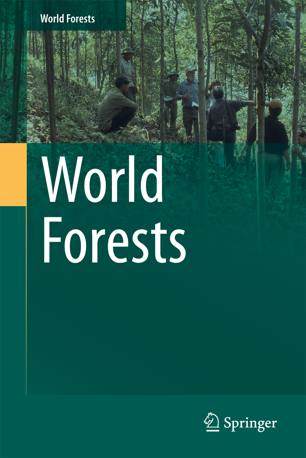
Societal Expectations from Family Forestry in the USA and Europe
2019
Summary
This article focuses on societal expectations and specifically considers what is expected from family or small-scale private forests in the USA and Europe. These expectations will shape the services provided by forests either directly via landowner and land manager actions or indirectly via policies that may encourage action. This chapter is presented as a conceptual discussion, intended to identify what societal expectations are from family forests and how they may relate to the service-dominant logic framework and the potential this framework provides for better matching expectations with services from this important forest land ownership base.
Key Personnel & Institutions
People: Emily Huff , Nataly Jurges , Maria Canadas
Institutions: Michigan State University , Georg-August-Universitat Gottingen , University of Lisbon
Location
New York, New England
Resource Type
Article
Tags
private forests
Topic Tags
conservation, management, ecosystem services
Purpose Tags
conservation, management, education
Citation
Huff E.S., Jürges N., Canadas M. (2019) "Societal Expectations from Family Forestry in the USA and Europe." In: Hujala T.; Toppinen A.; J. Butler B. (eds) "Services in Family Forestry." World Forests, vol 24. Springer, Cham. Accessed from https://link.springer.com/chapter/10.1007/978-3-030-28999-7_3
Source Link
https://link.springer.com/chapter/10.1007/978-3-030-28999-7_3
Extinction filters mediate the global effects of habitat fragmentation on animals
2019
Summary
This study tested the hypothesis that forest fragmentation sensitivity—affected by avoidance of habitat edges—should be driven by historical exposure, and therefore species’ evolutionary responses to disturbance.
Key Personnel & Institutions
People: Marion Pfeifer , Cristina Banks-Leite, Victor Arroyo-Rodriguez, Danilo Bandini Ribeiro , Jos Barlow , Felix Eigenbrod , Deborah Faria
Institutions: Oregon State University , Newcastle University , Imperial College London , Universidad Nacional Autónoma de México (UNAM) , Universidade Federal de Mato Grosso do Sul , Lancaster University , Universidade Federal de Lavras , University of Southampton , Universidade Estadual de Santa Cruz
Location
New York, New England
Resource Type
Report
Tags
evolution, global analysis
Topic Tags
conservation, management, wildlife and habitat, landscape pattern and connectivity
Purpose Tags
conservation, management, education
Citation
"Betts, M. G.; Wolf, C.; Pfeifer, M.; Banks-Leite, C.; Arroyo-Rodriguez, V.; Ribeiro, D. B.; Barlow, J.; Eigenbrod, F.; Faria, D.; et. al. ""Extinction Filters Mediate the Global Effects of Habitat Fragmentation on Animals." Science, vol 366, issue 6470, pp. 1236-1239, DOI: https://doi.org/10.1126/science.aax9387"
Source Link
Forest fragmentation
2019
Summary
This article talks about the negative effects of forest fragmentation specifically in Vermont.
Key Personnel & Institutions
People: Ethan Tapper
Institutions: Vermont Department of Forests, Parks and Recreation
Location
VERMONT
Resource Type
Poster
Tags
No tag keywords available
Topic Tags
conservation, management, wildlife and habitat, landscape pattern and connectivity
Purpose Tags
conservation, management, education
Citation
Tapper, E. "Forest Fragmentation." The Charlotte News, 13 June 2019. Accessed from https://www.charlottenewsvt.org/2019/06/13/forest-fragmentation/
Source Link
https://www.charlottenewsvt.org/2019/06/13/forest-fragmentation/
Forest Fragmentation May Increase Lyme Disease Risk
2003
Summary
This article describes a few results of studies on forest fragmentation and how it relates to blacklegged tick populations in the north eastern United States.
Key Personnel & Institutions
People: Robin Meadows
Institutions: Society For Conservation Biology
Location
New York, New England
Resource Type
Poster
Tags
ticks
Topic Tags
wildlife and habitat, landscape pattern and connectivity
Purpose Tags
conservation, education
Citation
Society For Conservation Biology. "Forest Fragmentation May Increase Lyme Disease Risk." ScienceDaily. ScienceDaily, 30 January 2003.
Source Link
https://www.conservationmagazine.org/2008/07/forest-fragmentation-may-increase-lyme-disease-risk/
Habitat Fragmentation And Arthropod Community Change: Carrion Beetles, Phoretic Mites, And Flies
2001
Summary
Little is known about the effects of habitat fragmentation on forest insect communities. We studied relationships among carrion beetles (Coleoptera: Silphidae), an insect guild important to decomposition processes in forests, the beetles' phoretic mites, and the beetles' primary competitors, muscoid flies, along an urban–rural gradient of forest fragmentation in central New York State, USA.
Key Personnel & Institutions
People: James Gibbs , Edward J. Stanton
Institutions: The State University of New York (SUNY)
Location
New York
Resource Type
Report
Tags
insects
Topic Tags
conservation, wildlife and habitat, landscape pattern and connectivity
Purpose Tags
conservation, education
Citation
Gibbs, J.P.; Stanton, E.J. (2001), "HABITAT FRAGMENTATION AND ARTHROPOD COMMUNITY CHANGE: CARRION BEETLES, PHORETIC MITES, AND FLIES." Ecological Applications, Accessed from https://esajournals.onlinelibrary.wiley.com/doi/abs/10.1890/1051-0761(2001)011[0079:HFAACC]2.0.CO;2
Source Link
https://esajournals.onlinelibrary.wiley.com/doi/abs/10.1890/1051-0761(2001)011[0079:HFAACC]2.0.CO;2
Transitions in forest fragmentation: implications for restoration opportunities at regional scales
1999
Summary
Where the potential natural vegetation is continuous forest (e.g., eastern US), a region can be divided into smaller units (e.g., counties, watersheds), and a graph of the proportion of forest in the largest patch versus the proportion in anthropogenic cover can be used as an index of forest fragmentation. If forests are not fragmented beyond that converted to anthropogenic cover, there would be only one patch in the unit and its proportional size would equal 1 minus the percentage of anthropogenic cover.
Key Personnel & Institutions
People: James Wickham , Kurt Riitters , Timothy Wade, K. Bruce Jones
Institutions: United States Geological Survey (USGS) , United States Environmental Protection Agency (EPA) , United States Environmental Protection Agency (EPA)
Location
New York, New England
Resource Type
Article
Tags
No tag keywords available
Topic Tags
conservation, methods, management, landscape pattern and connectivity
Purpose Tags
conservation, education
Citation
Wickham, J.D.; Jones, K.B.; Riitters, K.H. et al. "Transitions in forest fragmentation: implications for restoration opportunities at regional scales." Landscape Ecology 14, 137–145 (1999). https://doi.org/10.1023/A:1008026129712
Source Link
A Reevaluation of the Effects of Forest Fragmentation on Rates of Bird?Nest Predation
1995
Summary
This is a presentation of data indicating that the trends reported by quail-egg experiments do not constitute compelling evidence that forest fragmentation increases rates of predation on passerine nests.
Key Personnel & Institutions
People: David G. Haskell
Institutions: Cornell University
Location
New York, New England
Resource Type
Report
Tags
predation
Topic Tags
conservation, wildlife and habitat, landscape pattern and connectivity
Purpose Tags
conservation
Citation
Haskell, D.G. (1995), "A Reevaluation of the Effects of Forest Fragmentation on Rates of Bird?Nest Predation." Conservation Biology, vol 9, issue 5, pp. 1316-1318, Accessed from https://conbio.onlinelibrary.wiley.com/doi/abs/10.1046/j.1523-1739.1995.9051312.x-i1
Source Link
https://conbio.onlinelibrary.wiley.com/doi/abs/10.1046/j.1523-1739.1995.9051312.x-i1
Influence of high-resolution data on the assessment of forest fragmentation
2019
Summary
Because patterns depend on spatial resolution, emerging improvements in the spatial resolution of land cover may lead to new insights about the scaling of landscape patterns. This study compared forest fragmentation measures derived from very high resolution (1 m2) data with the same measures derived from the commonly used (30 m?×??30 m; 900 m2) Landsat-based data.
Key Personnel & Institutions
People: James Wickham , Kurt Riitters
Institutions: United States Department of Agriculture (USDA), Forest Service, Southern Research Station , United States Environmental Protection Agency (EPA)
Location
New York, New England
Resource Type
Article
Tags
No tag keywords available
Topic Tags
conservation, landscape pattern and connectivity
Purpose Tags
conservation, education
Citation
Wickham, J.; Riitters, K.H. "Influence of high-resolution data on the assessment of forest fragmentation." Landscape Ecol 34, 2169–2182 (2019). https://doi.org/10.1007/s10980-019-00820-z
Source Link
https://link.springer.com/article/10.1007/s10980-019-00820-z
Reducing Forest Fragmentation through Subdivision and Zoning Strategies
2011
Summary
This project analyzed subdivision trends in 14 case study towns to discern whether certain zoning districts and land use patterns promote or curtail parcelization in forestland. The results informed the development of a Forest Fragmentation Action Plan and technical assistance tools for municipalities and regional planners to combat forest fragmentation and parcelization through land use planning.
Key Personnel & Institutions
People: Emma Zavez , Jamey Fidel , Brian Shupe, Kate McCarthy
Institutions: Vermont Natural Resources Council
Location
VERMONT
Resource Type
Report
Tags
No tag keywords available
Topic Tags
conservation, methods, management, landscape pattern and connectivity
Purpose Tags
conservation, management
Citation
Fidel, J.; McCarthy, K.; Shupe, B.; Zavez, E. "Reducing Forest Fragmentation Through Subdivision and Zoning Strategies." Community Strategies for Vermont's Forests and Wildlife: A Guide for Local Action, 2011, Accessed from https://nsrcforest.org/project/reducing-forest-fragmentation-through-subdivision-and-zoning-strategies
Source Link
New report on Vermont forests addresses fragmentation
2015
Summary
Vermont Department of Forests, Parks and Recreation Commissioner Michael Snyder unveiled a new report to the Legislature that addresses the fragmentation of Vermont’s forests and makes recommendations for how to protect their integrity. He released the report before a joint meeting of several key House and Senate committees of the Vermont Legislature.
Key Personnel & Institutions
Institutions: Vermont Business Magazine
Location
No location information available
Resource Type
Poster
Tags
No tag keywords available
Topic Tags
conservation, methods, management, ecosystem services, wildlife and habitat, landscape pattern and connectivity
Purpose Tags
conservation, education, policy
Citation
"New Report on Vermont Forests Adresses Fragmentation" Vermon Business Magazine, 16 April 2015, Accessed from https://vermontbiz.com/news/april/new-report-vermont-forests-addresses-fragmentation
Source Link
https://vermontbiz.com/news/april/new-report-vermont-forests-addresses-fragmentation

Forest Fragmentation and Parcelization
2020
Summary
A description of the information on Vermont's forest fragmentation and parcelization by the Mad River Valley Planning District.
Key Personnel & Institutions
People: Jamey Fidel
Institutions: Mad River Valley Planning District
Location
VERMONT
Resource Type
Poster
Tags
No tag keywords available
Topic Tags
wildlife and habitat, landscape pattern and connectivity
Purpose Tags
education
Citation
"Forest Fragmentation and Parcelization" mad River Valley Planning District, Accessed from https://mrvpd.org/forest-fragmentation-and-parcelization/
Source Link
Habitat Loss and Fragmentation
2020
Summary
The Vermont Center for Ecostudies: Vermont Atlas of life website uses this article to talk about habitat loss and fragmentation and the impacts on bird populations.
Key Personnel & Institutions
Institutions: Vermont Center for Ecostudies, VCE
Location
VERMONT
Resource Type
Poster
Tags
No tag keywords available
Topic Tags
conservation, wildlife and habitat, landscape pattern and connectivity
Purpose Tags
conservation, education
Citation
"Habitat Loss and Fragmentation" The Vermont Center for Ecostudies, 2020, Accessed from https://val.vtecostudies.org/projects/vermont-breeding-bird-atlas/habitat-loss-and-fragmentation/
Source Link
https://val.vtecostudies.org/projects/vermont-breeding-bird-atlas/habitat-loss-and-fragmentation/

DEVELOPMENT REVIEW
2020
Summary
A preliminary assessment involves staff review of known wildlife and fisheries resources of interest and the potential for these resources to occur in the project area or adjacent properties. The department provides a preliminary response indicating the potential for impacts and/or request further on-site investigation.
Key Personnel & Institutions
Institutions: Vermont Fish and Wildlife Department
Location
VERMONT
Resource Type
Poster
Tags
No tag keywords available
Topic Tags
conservation, methods, management, ecosystem services
Purpose Tags
conservation, management
Citation
"Development Review" Vermont Fish and Wildlife Department, 2020, Accessed from https://vtfishandwildlife.com/conserve/development-review
Source Link
New Report Unravels the Complex Issue of Forest Fragmentation in Vermont
2016
Summary
This article describes the 2015 Fragmentation Report, prepared by the Vermont Department of Forests, Parks and Recreation, which explores the value of structurally diverse vegetation, as well as the drivers of fragmentation. The authors highlight key benefits of intact forests by going beyond general forest descriptions (such as composition, arrangement, size, etc.) to tell a story of forest structure and function.
Key Personnel & Institutions
People: Sam Talbot
Institutions: University of Vermont, Rubenstein School of Environment and Natural Resources
Location
VERMONT
Resource Type
Poster
Tags
No tag keywords available
Topic Tags
conservation, management, planning
Purpose Tags
conservation, education, policy
Citation
Talbot, S. "New Report Unravels the Complex Issue of Forest Fragmentation in Vermont." econews Vermont, 27 April 2016, Accessed from http://www.econewsvt.org/news/new-report-unravels-the-complex-issue-of-forest
Source Link
http://www.econewsvt.org/news/new-report-unravels-the-complex-issue-of-forest
Fragmentation: Hartford, Vermont
2019
Summary
This article focuses on giving information on fragmentation, how it impacts wildlife habitat, the different landscape patterns and their faults and ways to combat these issues.
Key Personnel & Institutions
Institutions: Hartford Conservation Comission
Location
VERMONT
Resource Type
Poster
Tags
No tag keywords available
Topic Tags
conservation, wildlife and habitat, landscape pattern and connectivity
Purpose Tags
conservation, education
Citation
"Fragmentation: Hartford, Vermont" Hartford Conservation Commission, Accessed from https://www.hartford-vt.org/DocumentCenter/View/187/Fragmentation-PDF
Source Link
https://www.hartford-vt.org/DocumentCenter/View/187/Fragmentation-PDF
A model for simulating forest fragmentation due to suburban development in Vermont
2002 to 2004
Summary
Urban sprawl contributes to the fragmentation of forest habitat and to the reduction in ecosystem function. This project models the impacts of predicted future urban growth on forest fragmentation levels in Northwestern Vermont and simulates how these outcomes change under alternative policy scenarios.
Key Personnel & Institutions
People: Austin Troy
Institutions: University of Vermont, Rubenstein School of Environment and Natural Resources
Location
VERMONT
Resource Type
Report
Tags
No tag keywords available
Topic Tags
conservation, methods, management, landscape pattern and connectivity
Purpose Tags
conservation, management, education
Citation
Troy, A. "A Model for Simulating Forest Fragmentation Due to Suburban Development in Vermont." 30 September 2004, Accessed from https://portal.nifa.usda.gov/web/crisprojectpages/0193809-a-model-for-simulating-forest-fragmentation-due-to-suburban-development-in-vermont.html
Source Link
Private Owners, Land Stewardship, And the Future of Connecticut’s Forests
2015
Summary
A new Yale-led study provides important new insights into the attitudes, objectives, and behaviors of these landowners, findings that will help conservation and forestry professionals to more strategically communicate with forest owners about stewardship and develop programs that meet their needs.
Key Personnel & Institutions
People: Kevin Dennehy
Institutions: Yale School of Forestry and Environmental Studies
Location
Connecticut
Resource Type
Poster
Tags
No tag keywords available
Topic Tags
conservation, ecosystem services, planning, landscape pattern and connectivity
Purpose Tags
conservation, education
Citation
Dennehy, K. "Private Owners, Land Stewardship, And the Future of Connecticut's Forests." 8 July 2015, Accessed from https://environment.yale.edu/news/article/yale-report-explores-attitudes-objectives-of-connecticuts-private-forest-owners/
Source Link
The Next Generation's Forest: Woodland Owners' Attitudes Toward Estate Planning and Land Preservation in Connecticut
1994
Summary
This paper describes the approach taken by the University of Connecticut Cooperative Extension System and several partners to assess NIPF owners' knowledge levels and needs in these areas. It reports on the results of a mail survey to NIPFs and on the implications those results have for future research and educational efforts. The results and implications should be applicable in other states where high land values and land fragmentation are important issues.
Key Personnel & Institutions
People: Stephpen H. Broderick , Kenneth P. Hadden , Brian Heninger
Institutions: University of Connecticut
Location
Connecticut
Resource Type
Article
Tags
No tag keywords available
Topic Tags
conservation, methods, management, planning
Purpose Tags
conservation, management, education
Citation
Stephpen H. Broderick, Kenneth P. Hadden, Brian Heninger, "The Next Generation's Forest: Woodland Owners' Attitudes Toward Estate Planning and Land Preservation in Connecticut", Northern Journal of Applied Forestry, Volume 11, Issue 2, June 1994, Pages 47–52, https://doi.org/10.1093/njaf/11.2.47
Source Link
https://academic.oup.com/njaf/article-abstract/11/2/47/4802499
Assessing The Impact Of Land Cover Spatial Resolution On Forest Fragmentation Modeling
2008
Summary
Researchers at the University of Connecticut’s Center for Landuse Education and Research (CLEAR) have been utilizing a raster based image convolution forest fragmentation model developed by Riitters et al. (2000) to assess the impact of landscape change on forest resources in the State of Connecticut. The model calculates Pf (forest proportion) and Pff (forest connectivity or adjacency) values based on a roving window analysis. These values are used to assign, to the center forest pixel of the analysis window, one of five possible forest fragmentation categories of core, perforated, edge, transition, and patch forest
Key Personnel & Institutions
People: James Hurd , Daniel Civco
Institutions: University of Connecticut, Center for Land Use Education and Research
Location
Connecticut
Resource Type
Report
Tags
No tag keywords available
Topic Tags
conservation, landscape pattern and connectivity
Purpose Tags
conservation
Citation
Hurd, J.; Civco, D. L. "Assessing The Impact Of Land Cover Spatial Resolution On Forest Fragmentation Modeling" May 2008, Accessed from http://clear.uconn.edu/publications/research/tech_papers/Hurd_Civco_ASPRS2008.pdf
Source Link
http://www.asprs.org/a/publications/proceedings/portland08/0030.pdf
Habitat, Food Habits, And Productivity Of Northern Goshawks Nesting In Connecticut
1996 to 1999
Summary
The objectives of this study were to measure habitat and landscape features, describe food habits, and document productivity of goshawks. Despite its occurrence, surprisingly little is known about the ecology and distributional status of this species within the state. The goshawk was considered a rare species in New England for most of the last century.The increased breeding population of the goshawk in the past 30 yr may be due to extensive reforestation, the growth of existing forest providing mature forest that they seem to prefer for nesting.
Key Personnel & Institutions
People: Trevor E. Becker , Dwight G. Smith
Institutions: The Cooper Ornithological Society
Location
Connecticut
Resource Type
Article
Tags
No tag keywords available
Topic Tags
conservation, methods, management, wildlife and habitat, landscape pattern and connectivity
Purpose Tags
conservation, management
Citation
Becker, T. E.; Smith, D. G.; Bosakowski, T. "Habitat, Food Habits, And Productivity Of Northern Goshawks Nesting In Connecticut" Studies in Avian Biology No. 31:119-125, 1999, Accessed from https://sora.unm.edu/sites/default/files/SAB_031_2006 P119-125_Habitat, Food Habits, and Productivity of Northern Goshawks Nesting in Connecticut_Trevor E. Becker, Dwight G. Smith, Thomas Bosakowski.pdf
Source Link
Forest Fragmentation: Implications for Sustainable Private Forests
2000
Summary
In this article are listed some of the factors seen as combining to increase forest fragmentation at an even faster pace, and the consequent challenges that this crisis presents to foresters.
Key Personnel & Institutions
People: Lester A. DeCoster , Neil Sampson
Institutions: The DeCoster Group
Location
New York, New England
Resource Type
Article
Tags
No tag keywords available
Topic Tags
conservation, management, landscape pattern and connectivity
Purpose Tags
conservation, management
Citation
Neil Sampson, Lester DeCoster, Forest Fragmentation: Implications for Sustainable Private Forests, Journal of Forestry, Volume 98, Issue 3, March 2000, Pages 4–8, https://doi.org/10.1093/jof/98.3.4
Source Link
Quantifying and Describing Urbanizing Landscapes in the Northeast United States
2002
Summary
A model has been created to quantify and describe forest fragmentation over various geographic areas and an urban growth model has been developed that quantifies and categorizes urban change. Both of these models use land-cover information as their source data. These tools and the derived information are important educational components of the University’s recently created Center for Land use Education And Research.
Key Personnel & Institutions
People: James Hurd , Emily Wilson, Daniel Civco, Chester L. Arnold , Michael P. Prisloe
Institutions: University of Connecticut
Location
New York, New England
Resource Type
Report
Tags
No tag keywords available
Topic Tags
conservation, management, planning, landscape pattern and connectivity
Purpose Tags
conservation, management, policy
Citation
"Civco, D. L.; Hurd, J. D.; Wilson, E. H.; Arnold, C. L.; Prisloe, M. P. ""Quantifying and Describing Urbanizing Landscapes in the Northeast United States"" Photogrammetric Engineering & Remote Sensing (dcivco@canr.uconn.edu). Vol. 68, No. 10, October 2002, pp. 1083–1090. Accessed from https://pdfs.semanticscholar.org/68a7/a68932828b8dff006a8fd46f91da2dcf42b1.pdf"
Source Link
https://pdfs.semanticscholar.org/68a7/a68932828b8dff006a8fd46f91da2dcf42b1.pdf
Relationship Between the Regional Abundance of Forest and the Composition of Forest Bird Communities
1987
Summary
This study surveyed bird populations in 46 forest tracts in Connecticut, USA, to determined how the distribution of birds is related to forest area, isolation from other forest, and vegetation structure.
Key Personnel & Institutions
People: Robert Askins , Margarett J. Philbrick
Institutions: Connecticut College
Location
Connecticut
Resource Type
Article
Tags
birds
Topic Tags
conservation, wildlife and habitat, landscape pattern and connectivity
Purpose Tags
conservation
Citation
Askins, R. A.; Philbrick, M. J.; Sugeno, D. S. "Relationship Between the Regional Abundance of Forest and the Composition of Forest Bird Communities" Biological Conservation, vol. 39, issue 2, 1987, pp. 129-152, 6 March 1986. Accessed from https://www.sciencedirect.com/science/article/abs/pii/0006320787900309
Source Link
https://www.sciencedirect.com/science/article/abs/pii/0006320787900309
Regional-Scale Assessment of Deer Impacts on Vegetation Within Western Connecticut, USA
2010
Summary
This study conducted a survey in western Connecticut, USA, woodlots to examine how spatial variation in deer densities influences variation in impacts on plant species abundance, identity and diversity, and tree regeneration. It also used a Geographic Information System to quantify trends between land?cover type and deer density.
Key Personnel & Institutions
Institutions: Yale University, School of Forestry and Environmental Studies
Location
Connecticut
Resource Type
Report
Tags
deer
Topic Tags
wildlife and habitat, landscape pattern and connectivity
Purpose Tags
education
Citation
Rutherford, A. C.; Schmitz, O. J. "Regional?Scale Assessment of Deer Impacts on Vegetation Within Western Connecticut, USA" The Journal of Wildlife Management, col 74, issue 6, August 2010, pp. 1257-1263. Accessed from https://wildlife.onlinelibrary.wiley.com/doi/abs/10.1111/j.1937-2817.2010.tb01246.x
Source Link
https://wildlife.onlinelibrary.wiley.com/doi/abs/10.1111/j.1937-2817.2010.tb01246.x
The Influence of Roadside Forest Management on Temperate Deciduous Forest Understories
2015 to 2019
Summary
The objective of this study was to understand the spatial extent and magnitude of edge influence on environmental conditions and understory communities in managed and un-managed roadside forests.
Key Personnel & Institutions
People: Julia A. Rogers
Institutions: University of Connecticut
Location
Connecticut
Resource Type
Report
Tags
understory
Topic Tags
conservation, methods, management, planning, landscape pattern and connectivity
Purpose Tags
conservation, management, policy
Citation
Rogers, Julia A. "The Influence of Roadside Forest Management on Temperate Deciduous Forest Understories" (2019). Master's Theses. 1379. https://opencommons.uconn.edu/gs_theses/1379
Source Link
https://opencommons.uconn.edu/cgi/viewcontent.cgi?article=2472&context=gs_theses
Nonnative Vegetation Dynamics in the Understory of a Fragmented Temperate Forest
2019
Summary
This study examined 11 years of compositional and structural change in a small (60 ha) forest preserve in Connecticut with abundant invasive plants, a diverse land use history, and varied edaphic characteristics. It quantified the extent to which vegetation composition changed at the species, life form, and community scales and then assessed the possible factors driving these changes.
Key Personnel & Institutions
People: David Foster , Edward Faison , Betsy Von Holle , Joshua M. Rapp , Sarah Moore
Institutions: Harvard University, Harvard Forest , Harvard University , Highstead
Location
Connecticut
Resource Type
Article
Tags
invasives
Topic Tags
conservation, methods, management, wildlife and habitat
Purpose Tags
conservation, management
Citation
Edward K. Faison, David R. Foster, Betsy Von Holle, Joshua M. Rapp, and Sarah Moore "Nonnative vegetation dynamics in the understory of a fragmented temperate forest," The Journal of the Torrey Botanical Society 146(4), 252-261, (23 October 2019). https://doi.org/10.3159/TORREY-D-19-00004.1
Source Link
Sustaining America's Urban Trees and Forests: a Forests on the Edge Report
2010
Summary
The purpose of this report is to provide an overview of the current status and benefits of America’s urban forests, compare differences in urban forest canopy cover among regions, and discuss challenges facing urban forests and their implications for urban forest management.
Key Personnel & Institutions
People: David J. Nowak , Paula B. Randler , Paula B. Randler, Eric J. Greenfield , Sara J. Comas , Mary A. Carr , Ralph J. Alig
Institutions: United States Department of Agriculture (USDA), Forest Service, Northern Research Station , United States Department of Agriculture (USDA), Forest Service
Location
No location information available
Resource Type
Report
Tags
urban
Topic Tags
No topic tag keywords available
Purpose Tags
No purpose tag keywords available
Citation
Nowak, D. J.; Greenfield, E. J.; Stein, S. M.; Randler, P. B.; Comas, S. J.; Carr, M. A.; Alig, R. J. "Sustaining America's Urban Trees and Forests: a Forests on the Edge Report" June 2010, Accessed from https://www.fs.fed.us/nrs/pubs/gtr/gtr_nrs62.pdf
Source Link
Forest Fragmentation Extension Programming: A National Initiative
2002
Summary
This paper documents how the term fragmentation has developed, the types of studies dominant in literature, and where the studies occurred. Several methods were employed to obtain literature used in this research.
Key Personnel & Institutions
People: Sarah Crim , Mark R. Dubois , James Finley , Rick Fletcher , Laura J. Robinson , Catalino Blanche
Institutions: Oregon State University , The Pennsylvania State University , Auburn University , United States Department of Agriculture (USDA), Cooperative State Research Extension and Education Service , The Sustainable Forestry Partnership
Location
New England, New York
Resource Type
Report
Tags
global analysis
Topic Tags
conservation, landscape pattern and connectivity
Purpose Tags
conservation, education
Citation
Crim, S.; Dubois, M. R.; Finley, J.; Fletcher, R.; Robinson, L. J.; Blanche, C. "Forest Fragmentation Extension Programming: A National Initiative" 9 September 2002, Accessed from https://pdfs.semanticscholar.org/6fe5/4d05eb99fff45046ccfdf710216993e61414.pdf
Source Link
https://pdfs.semanticscholar.org/6fe5/4d05eb99fff45046ccfdf710216993e61414.pdf
Rhode Island Woodland Partnership Preventing The Loss of Rhode Island’s Forests
2012
Summary
The Rhode Island Woodland Partnership (RIWP) believes that preventing the loss and fragmentation of Rhode Island’s forestland is a critical aspect of protecting the natural resources - especially good clean drinking water - and, the social and economic values of Rhode Island. They encourage and promote the protection of the remaining intact forest cover in Rhode Island through the application of policies that discourage further forest fragmentation and encourage development patterns that conserve the landscape values of larger, unbroken tracts of land.
Key Personnel & Institutions
People: Christopher Riely
Institutions: Rhode Island Woodland Partnership
Location
Rhode Island
Resource Type
Poster
Tags
water, natural resources
Topic Tags
conservation, methods, ecosystem services, planning
Purpose Tags
conservation, management, education
Citation
Riely, C. "Rhode Island Woodland Partnership: Preventing The Loss of Rhode Island's Forests" Accessed from https://rhodeislandwoods.uri.edu/files/RIWP-PreventingLossForestland.pdf
Source Link
https://rhodeislandwoods.uri.edu/files/RIWP-PreventingLossForestland.pdf
Rhode Island Wildlife Action Plan
2020
Summary
Rhode Island’s Comprehensive Wildlife Conservation Strategy (CWCS) process identified threats to these important species and their habitats, and it identified habitat loss and degradation from human population growth, with its associated impacts, as high on the long list of threats. The plan outlines a series of actions prescribed for the next decade to address these threats and to effectively conserve Rhode Island’s important wildlife resources.
Key Personnel & Institutions
Institutions: Northeast Association of Fish and Wildlife Agencies, NatureServe , National Geographic
Location
Rhode Island
Resource Type
Poster
Tags
threats
Topic Tags
conservation, methods, wildlife and habitat
Purpose Tags
conservation, education, policy
Citation
Association of Fish and Wildlife Agencies "Rhode Island Wildlife Action Plan" LandScope America, 2020, Accessed from http://www.landscope.org/rhode-island/priorities/
Source Link
Rhode Island's Wildlife Action Plan
2015
Summary
This document is the 10-year revision of Rhode Island’s Wildlife Action Plan (WAP), an effective strategy for wildlife conservation enabled through the State Wildlife Grants (SWG) program administered by the U.S. Fish and Wildlife Service (USFWS). The goal of this document is to provide direction of wildlife conservation efforts for the next decade. It represents a vision and a strategy that the Rhode Island Department of Environmental Management’s Division of Fisheries and Wildlife (RI DEM DFW) shares with its partners for conservation of wildlife in the state.
Key Personnel & Institutions
Institutions: Rhode Island Department of Environmental Management, Terwilliger Consulting , The Nature Conservancy, Rhode Island
Location
Rhode Island
Resource Type
Report
Tags
No tag keywords available
Topic Tags
conservation, management, ecosystem services, wildlife and habitat, landscape pattern and connectivity
Purpose Tags
conservation, education, policy
Citation
Rhode Island Department of Environmental Management "Rhode Island Wildlife Action Plan" 2015, Accessed from http://www.dem.ri.gov/programs/fish-wildlife/wildlifehuntered/swap15.php
Source Link
http://www.dem.ri.gov/programs/fish-wildlife/wildlifehuntered/swap15.php
RI Coverts Project Introduction
2004 to 2018
Summary
Rhode Island Resource Conservation and Development Area Council Inc. started the Rhode Island Coverts Program in Rhode Island to help woodland owners conserve their land and protect wildlife habitats in an effort to sustain forests and prevent further fragmentation.
Key Personnel & Institutions
Institutions: Rhode Island Resource Conservation & Development Area Council, Inc.
Location
Rhode Island
Resource Type
Website
Tags
No tag keywords available
Topic Tags
conservation, methods, management, wildlife and habitat
Purpose Tags
conservation, management, education
Citation
Rhode Island Resource Conservation and Development Area Council, Inc. "Rhode Island Coverts Project Introduction" 2018, Accessed from http://www.rircd.org/covertsprojectintroduction.htm
Source Link
R.I. Forest Preservation and Energy Goals are at Odds
2020
Summary
A report released on Feb. 17 by the Rhode Island Department of Environmental Management and the Rhode Island Tree Council describes the economic and environmental importance of forests and proposes measures to conserve woodlands. The 132-page document stops short, however, of recommending that the state curtail its incentives to commercial solar energy developers to clear cut hundreds of acres of forest to build their facilities.
Key Personnel & Institutions
People: Cynthia Drummond
Institutions: The Westerly Sun
Location
Rhode Island
Resource Type
Poster
Tags
forest economy
Topic Tags
conservation, methods, ecosystem services, landscape pattern and connectivity
Purpose Tags
conservation, education, policy
Citation
Drummond, C. "R.I. Forest Preservation and Energy Goals are at Odds" The Sun, 20 February, 2020, Accessed from https://www.thewesterlysun.com/news/richmond-hopkinton/r-i-forest-preservation-and-energy-goals-are-at-odds/article_9924ffd2-5420-11ea-bf13-4b3632d6a2f0.html
Source Link

History & Mission of the Rhode Island Tree Council
1993 to 2020
Summary
The Rhode Island Tree Council helps improve Rhode Island’s tree resources, build healthy and vibrant urban forests, and educates citizens about urban forestry. A non-profit, tax-exempt, 501C (3) entity, the group offers a wide variety of programs and resources designed to educate the public on the benefits and value of trees. RI Tree’s membership is open to all. It includes local organizations, professional consultants, and individual volunteers, who act as Advisors and Trustees for the organization and serve on its Board of Directors.
Key Personnel & Institutions
Institutions: Rhode Island Tree Council
Location
Rhode Island
Resource Type
Website
Tags
urban
Topic Tags
conservation, methods, management, ecosystem services
Purpose Tags
conservation, management, education
Citation
Rhode Island Tree Council "History & Mission of the Rhode Island Tree Council" 2020, Accessed from https://www.ritree.org/about-us
Source Link
Reintroduction of New England Cottontail (Sylvigaus transitionalis) on Ninigret National Wildlife Refuge
2018
Summary
The U.S. Fish and Wildlife Service proposes to reintroduce New England Cottontail rabbits onto the Ninigret National Wildlife Refuge in order to establish a population. To help insure the success of the reintroduction effort, a small number of eastern cottontails could be live-trapped and moved to the barrier beach portion of the refuge. This will minimize competition between eastern cottontails and the New England Cottontail at the reintroduction site. The reintroduction effort is not anticipated to effect ongoing recreational activities, public use, or habitat management activities on the refuge.
Key Personnel & Institutions
Institutions: United States Fish and Wildlife Service
Location
Rhode Island
Resource Type
Report
Tags
rabbits
Topic Tags
conservation, methods, wildlife and habitat
Purpose Tags
conservation, education, policy
Citation
U.S. Fish and Wildlife Service "Reintroduction of New England Cottontail (Sylvigaus transitionalis) on Ninigret National Wildlife Refuge" February, 2018, Accessed from https://www.fws.gov/uploadedFiles/Region_5/NWRS/North_Zone/Rhode_Island_Complex/Ninigret/NEC.NewsRelease.withProjectDescription.pdf
Source Link
The Forests of Rhode Island
2020
Summary
While this report highlights a success story, it also emphasizes a need to continue forestry efforts. As in earlier times, Rhode Island stands to lose our forests as pressures of urban sprawl and unchecked development surpass the pioneers’ efforts to clear the landscape for agriculture. Unlike the agrarian landscapes of the past, shopping malls, suburban neighborhoods, and highways will not provide opportunity for forest regeneration. Consequently, forestry interests must work towards improving the planning scenarios within communities and fostering business opportunities through sustainable forestry activities.
Key Personnel & Institutions
People: Tonya Lister , Andrew Lister , Brett Butler , Catherine Sparks , Paul Ricard , Marla Emery , Thomas A. Dupree , Paul Dolan , Charles J. Barnett
Institutions: United States Department of Agriculture (USDA), Forest Service, Rhode Island Department of Environmental Management
Location
No location information available
Resource Type
Report
Tags
urban
Topic Tags
No topic tag keywords available
Purpose Tags
No purpose tag keywords available
Citation
Barnett, C. J.; Butler, J.; Dolan, P.; Dupree, T. A.; Emery, M.; Lister, A.; Lister, T. W.; Ricard, P.; Sparks, C. "The Forests of Rhode Island" September 2002, Accessed from https://pdfs.semanticscholar.org/80aa/82e7dc7e796e4516ada6e248eba3f47a8d52.pdf
Source Link
Guest Blog: You Can’t Get There from Here: Protecting Irreplaceable Wildlife Corridors
2016
Summary
One of the hallmarks of The Nature Conservancy is its pursuit of non-confrontational, pragmatic solutions to conservation challenges. For this reason, the Conservancy rarely takes a public position on a specific development project. However, Invenergy’s proposed Clear River Energy Center would do such harm to Rhode Island’s ecology, its biodiversity, and its resilience to climate change that they are compelled to oppose this new power plant.
Key Personnel & Institutions
Institutions: Conservation Law Foundation
Location
Rhode Island
Resource Type
Poster
Tags
No tag keywords available
Topic Tags
conservation, planning, wildlife and habitat, landscape pattern and connectivity
Purpose Tags
conservation, education, policy
Citation
Conservation Law Foundation "Guest Blog: You Can’t Get There from Here: Protecting Irreplaceable Wildlife Corridors" 13 October, 2016, Accessed from https://www.clf.org/blog/invenergy-protecting-wildlife-corridors/
Source Link
https://www.clf.org/blog/invenergy-protecting-wildlife-corridors/
Emigration Behavior of Spotted Salamanders on Golf Courses in Southern Rhode Island
2006
Summary
Few studies have investigated the emigration behavior of adult ambystomatid salamanders in fragmented landscapes. This study assessed the emigration behavior of 30 Spotted Salamanders (Ambystoma maculatum) by implanting transmitters in 2003. Study sites, all in southern Rhode Island, included an active golf course, a golf course under construction, and a closed-canopy forest that served as a control site.
Key Personnel & Institutions
People: Katherine E. Montieth , Peter W. C. Paton
Institutions: University of Rhode Island, Department of Natural Resources Science
Location
Rhode Island
Resource Type
Report
Tags
salamanders
Topic Tags
conservation, wildlife and habitat, landscape pattern and connectivity
Purpose Tags
conservation
Citation
Katherine E. Montieth, and Peter W. C. Paton. “Emigration Behavior of Spotted Salamanders on Golf Courses in Southern Rhode Island.” Journal of Herpetology, vol. 40, no. 2, 2006, pp. 195–205. JSTOR, www.jstor.org/stable/4092981. Accessed 6 May 2020.
Source Link
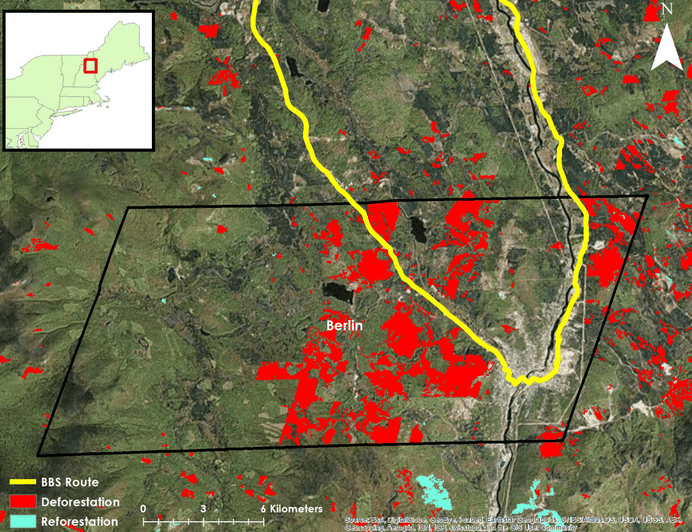
Songbird Population Dynamics in Fragmented New England Habitat
2014
Summary
This study utilized an occupancy model using songbirds to analyze the effects of various fragmentation metrics. Forest fragmentation metrics were derived using the 2001, 2006, and 2011 National Land Cover Database, Landsat, and Aqua/Terra data from the NASA’s Earth Observing System. The habitat variables were combined with large-scale, multi-year Breeding Bird Survey data from the U.S. Geological Survey. The focal area was Bird Conservation Region (BCR) 14 in the northeastern United States, which is characterized by northern hardwood and spruce-fir forests, a vital transition zone between northern boreal and southern temperate landscapes. Representative species were chosen as models of different life histories and have different theoretical responses to changes in forest structure. The habitat variables and songbird survey data were used in a multi-season occupancy-based model that can be applied to a multitude of avian species across North America.
Key Personnel & Institutions
People: Morgan Tingley , James D. Nichols , Alexander Nelson , Sam Weber , Kiersten Newtoff , James Nichols, Frederick S. Policelli
Institutions: Middlebury College , United States Geological Survey (USGS), Patuxent Wildlife Research Center, University of Connecticut, National Aeronautics and Space Administration (NASA), Goddard Space Flight Center, Virginia Polytechnic Institute and State University, Institute for Bird Populations , University of North Carolina
Location
No location information available
Resource Type
Article
Tags
songbirds, spruce-fir, boreal
Topic Tags
No topic tag keywords available
Purpose Tags
No purpose tag keywords available
Citation
Nelson, A.; Weber, S.; Newtoff, K.; Tingley, M.; Nichols, J.; Policelli, F.; "Songbird Population Dynamics in Fragmented New England Habitat" 3 August 2014, Accessed from https://earthzine.org/songbird-population-dynamics-in-fragmented-new-england-habitat/
Source Link
https://earthzine.org/songbird-population-dynamics-in-fragmented-new-england-habitat/
Estimating Ownerships and Parcels of Nonindustrial Private Forestland in Massachusetts
2005 to 2008
Summary
A heuristic was used to aggregate similar parcels to provide an estimate of actual landownership. The estimated average statewide ownership is 17.9 ac, and when properties less than 10 ac are excluded, the average rises to 42.5 ac. The median ownership varies from east to west in the state across the spectrum of suburban development radiating from the metropolitan Boston area, with the median being 4.8, 7.8, and 8.6 ac in the eastern, central, and western part of the state, respectively. These results are compared with ownership estimates generated by the US Forest Service Forest Inventory and Analysis.
Key Personnel & Institutions
People: Paul Catanzaro , Jennifer Fish , Brett Butler , Anthony D'Amato , David Kittredge
Institutions: Harvard University, Harvard Forest , Massachusetts Department of Conservation and Recreation , United States Department of Agriculture (USDA), Forest Service, Northern Research Station , University of Minnesota, University of Massachusetts, Department of Natural Resources Conservation
Location
Massachusetts
Resource Type
Article
Tags
No tag keywords available
Topic Tags
conservation, management, ecosystem services, drivers, landscape pattern and connectivity
Purpose Tags
conservation, management, policy
Citation
Kittredge, D. B.; D'Amato, A. W.; Catanzaro, P.; Fish, J.; Butler, B.; "Estimating Ownerships and Parcels of Nonindustrial Private Forestland in Massachusetts" September 2008, Accessed from https://pdfs.semanticscholar.org/bd96/3e2a80cfb822fb5415d4f85fa3778b564c2e.pdf?_ga=2.11876404.187097471.1588606058-98031439.1588606058
Source Link
The Value of Rhode Island Forests
2019
Summary
The Value of Rhode Island Forests has two primary goals: to outline the benefits that Rhode Island’s forests provide to the state and to recommend practical strategies to encourage forest conservation. The Rhode Island Tree Council, a non-profit organization dedicated to supporting healthy forests and trees, conceived of this project with the Rhode Island Department of Environmental Management (RIDEM). This report is intended as a tool for public engagement and a source of guidance for Rhode Island policymakers. The report’s findings can support the work of the many stakeholders who seek to pass down the essential knowledge of forest stewardship for generations of Rhode Islanders to come.
Key Personnel & Institutions
People: Christopher Riely , Judee Burr , Kate Sayles
Institutions: United States Department of Agriculture (USDA), Rhode Island Department of Environmental Management, Rhode Island Tree Council
Location
Rhode Island
Resource Type
Report
Tags
No tag keywords available
Topic Tags
conservation, management, planning, landscape pattern and connectivity
Purpose Tags
conservation, management, education, policy
Citation
Riely, C.; Sayles, K.; Burr, J. "The Value of Rhode Island Forests" August 2019, Accessed from http://www.dem.ri.gov/programs/bnatres/forest/pdf/forest-value.pdf
Source Link
http://www.dem.ri.gov/programs/bnatres/forest/pdf/forest-value.pdf
Follow the Forest
2020
Summary
In the middle of this world-renown resource, Follow the Forest seeks to protect and connect core forests, the largest intact woodland areas in a region of increasing development. Core forests filter air and water while also providing important habitat for wildlife, linking Connecticut’s Litchfield Hills to the Green Mountains of Vermont. However, the threat of forests being disconnected through fragmentation and changing land use persists even as we recognize the global importance of this resource. The loss of forested land is not linear. Without strategic vision and protection, individual core forests will dwindle and ultimately erode the ecological integrity of eastern New York and New England.
Key Personnel & Institutions
Institutions: Housatonic Valley Association , Follow the Forest
Location
New York, New England
Resource Type
Website
Tags
No tag keywords available
Topic Tags
conservation, management, planning, wildlife and habitat, landscape pattern and connectivity
Purpose Tags
conservation, management, education, policy
Citation
"Follow the Forest" Housatonic Valley Association, 2020, Accessed from https://www.arcgis.com/apps/Cascade/index.html?appid=578d52a766774787b7144b1cfea3f393
Source Link
https://www.arcgis.com/apps/Cascade/index.html?appid=578d52a766774787b7144b1cfea3f393
Conversions of Forest Land: Trends, Determinants, Projections, and Policy Considerations
2010
Summary
This is a report on information about conservation of the United States forest lands. The information includes trends and projections and suggestions for policies that may help with conservation.
Key Personnel & Institutions
People: Susan Stein , David J. Nowak , Ralph J. Alig , David Wear , Susan Stewart
Institutions: United States Department of Agriculture (USDA), Forest Service, Southern Research Station , Northern Research Station , United States Department of Agriculture (USDA), Forest Service, United States Department of Agriculture (USDA), Forest Service, Pacific Northwest Research Station
Location
New York, New England
Resource Type
Report
Tags
No tag keywords available
Topic Tags
conservation, methods, ecosystem services, planning, landscape pattern and connectivity
Purpose Tags
conservation, management, education
Citation
Alig, Ralph; Stewart, Susan; Wear, David; Stein, Susan; Nowak, David. "Conversions of forest land: trends, determinants, projections, and policy considerations." 2010. Accessed from https://www.fs.fed.us/pnw/pubs/gtr802/Vol1/pnw_gtr802vol1_alig.pdf
Source Link
New England and Northern New York Forest Ecosystem Vulnerability Assessment and Synthesis: A Report from the New England Climate Change Response Framework Project
2017
Summary
This assessment evaluates the vulnerability of forest ecosystems across the New England region (Connecticut, Maine, Massachusetts, New Hampshire, northern New York, Rhode Island, and Vermont) under a range of future climates. We synthesizes and summarizes information on the contemporary landscape, provided information on past climate trends, and described a range of projected future climates. This information was used to parameterize and run multiple vegetation impact models, which provided a range of potential vegetative responses to climate. Finally, these results were brought before a multidisciplinary panel of scientists and natural resource professionals familiar with the forests of this region to assess ecosystem vulnerability through a formal consensus-based expert elicitation process.
Key Personnel & Institutions
People: Anthony D'Amato , Frank Thompson , Maria K. Janowiak , Christopher W. Swanson , Louis Iverson , William D. Dijak , Stephen Matthews , Matthew P. Peters , Anantha M. Prasad
Institutions: United States Department of Agriculture (USDA), Forest Service
Location
New York, New England
Resource Type
Report
Tags
No tag keywords available
Topic Tags
conservation, methods, management, ecosystem services, wildlife and habitat
Purpose Tags
conservation, management, education
Citation
Janowiak, Maria K.; D’Amato, Anthony W.; Swanston, Christopher W.; Iverson, Louis; Thompson, Frank R., III; et. al. 2018." New England and northern New York forest ecosystem vulnerability assessment and synthesis: a report from the New England Climate Change Response Framework project." Gen. Tech. Rep. NRS-173. Newtown Square, PA: U.S. Department of Agriculture, Forest Service, Northern Research Station. 234 p. https://doi.org/10.2737/nrs-gtr-173.
Source Link
Human Dimensions Of Private Forestland Ownership: Sampling, Estimation, Decision Making Processes, And Implications
2010
Summary
This dissertation challenges the presumptions with which PFL research has been previously conducted, lays a foundation for sound, future research, and begins exploring important aspects of private forest landowership. The research presented here focuses primarily on the approaches employed by the United States Department of Agriculture Forest Service to sample PFLs and estimate parameters of the PFL population and of private forestland across the nation.
Key Personnel & Institutions
People: James Finley , Alexander Leventon Metcalf , A. E. Luloff , Allyson B. Muth , Richard C. Stedman , Eric K. Zenner , Michael G. Messina
Institutions: Pennsylvania State University, School of Forest Resources
Location
New York, New England
Resource Type
Report
Tags
No tag keywords available
Topic Tags
methods, management, ecosystem services, planning
Purpose Tags
management, education, policy
Citation
Metcalf, A. L.; Finley, J. C.; et. al. "Human Dimensions Of Private Forestland Ownership: Sampling, Estimation, Decision Making Processes, And Implications
Source Link
Effects of Forest Fragmentation on Breeding Tanagers: A Continental Perspective
1994 to 2001
Summary
This report studied the effects of habitat fragmentation on four species of North American tanagers (Piranga spp.) at 1107 study sites in 1995. Volunteer researchers used the standardized protocol of Project Tanager to select sites, census for breeding tanagers, and measure habitat and landscape features on a continental scale. In a principal components analysis, this study used measures of forest patch size, distance to nearest other forest patches (isolation), percent forest cover and length of linear edge in a 1000?ha landscape, and elevation.
Key Personnel & Institutions
People: Kenneth V. Rosenberg , James D. Lowe , Andre A. Dhondt
Institutions: Cornell Lab of Ornithology
Location
New York, New England
Resource Type
Article
Tags
No tag keywords available
Topic Tags
conservation, management, wildlife and habitat, landscape pattern and connectivity
Purpose Tags
conservation, education
Citation
Rosenberg, K. V.; Lowe, J. D.; Dhondt, A. A. "Effects of Forest Fragmentation on Breeding Tanagers: A Continental Perspective
Source Link
https://conbio.onlinelibrary.wiley.com/doi/abs/10.1046/j.1523-1739.1999.98020.x
Amphibian Movements in Response to Forest Edges, Roads, and Streambeds in Southern New England
1998
Summary
This study used drift fences and pitfall traps to intercept dispersing amphibians and examine amphibian movements relative to roads, forest edges, and streambeds in a forest tract in southern Connecticut.
Key Personnel & Institutions
People: James Gibbs
Institutions: The Wildlife Society
Location
Connecticut
Resource Type
Report
Tags
amphibians
Topic Tags
conservation, management, wildlife and habitat, landscape pattern and connectivity
Purpose Tags
conservation, management, education
Citation
Gibbs, J. P. "Amphibian Movements in Response to Forest Edges, Roads, and Streambeds in Southern New England" The Journal of Wildlife Management, vol. 62, no. 2 (April, 1998), pp. 584-589
Source Link
Habitat Correlates of Reproductive Effort in Wood Frogs and Spotted Salamanders in an Urbanizing Watershed
2007
Summary
This study was interested in the effects of habitat characteristics on amphibian population size and used Wood Frog (Rana sylvatica) and Spotted Salamander (Ambystoma maculatum) egg mass counts as an index. Between 2001 and 2005, it monitored 65 seasonal ponds within forested landscapes in the Pawcatuck River watershed of Rhode Island.
Key Personnel & Institutions
People: Peter W. C. Paton , Dennis E. Skidds , Francis C. Golet , Jonathan C. Mitchell
Institutions: National Park Service, NPS, University of Rhode Island
Location
Rhode Island
Resource Type
Report
Tags
amphibians, salamanders
Topic Tags
conservation, wildlife and habitat, landscape pattern and connectivity
Purpose Tags
conservation
Citation
Dennis E. Skidds, Francis C. Golet, Peter W. C. Paton, and Jonathan C. Mitchell "Habitat Correlates of Reproductive Effort in Wood Frogs and Spotted Salamanders in an Urbanizing Watershed," Journal of Herpetology 41(3), 439-450, (1 September 2007). https://doi.org/10.1670/0022-
Source Link
Effects of Landscape Fragmentation and Climate on Lyme Disease Incidence in the Northeastern United States
2014
Summary
This study explores the influence of landscape (e.g., land use pattern and landscape fragmentation) and climatic factors (e.g., temperature and precipitation) at a regional scale on Lyme disease incidence. The study area includes thirteen states in the Northeastern United States.
Key Personnel & Institutions
People: Phoebe Minh Tran , Lance Waller
Institutions: Emory University
Location
New York, New England
Resource Type
Article
Tags
lyme disease
Topic Tags
management, wildlife and habitat, landscape pattern and connectivity
Purpose Tags
management
Citation
Tran, P.M.; Waller, L. "Effects of Landscape Fragmentation and Climate on Lyme Disease Incidence in the Northeastern United States." EcoHealth 10, 394–404 (2013). https://doi.org/10.1007/s10393-013-0890-y
Source Link
Landscape and Habitat Predictors of Canada Warbler (Wilsonia Canadensis) and Northern Waterthrush (Seiurus noveboracensis) Occurrence in Rhode Island Swamps
1999
Summary
This thesis examined the relative influence of forest habitat characteristics and landscape context on the presence of Canada Warblers (Wilsonia canadensis) and Northern Waterthrushes (Seiurus noveboracensis) in 80 survey plots located in 44 Rhode Island forested swamps during 1997 and 1998. It used both univariate and forward stepwise logistic regression analysis to create models for predicting the probability of occurrence, or incidence, of each species.
Key Personnel & Institutions
People: Francis C. Golet , Nicholas A. Miller
Institutions: University of Rhode Island
Location
Rhode Island
Resource Type
Report
Tags
birds
Topic Tags
conservation, wildlife and habitat, landscape pattern and connectivity
Purpose Tags
conservation, education
Citation
Miller, Nicholas A. "Landscape and Habitat Predictors of Canada Warbler (Wilsonia Canadensis) and Northern Waterthrush (Seiurus noveboracensis) Occurrence in Rhode Island Swamps" (1999). Open Access Master's Theses. Paper 601. https://digitalcommons.uri.edu/theses/601
Source Link
Emerging Dragonfly Diversity at Small Rhode Island (U.S.A.) Wetlands Along an Urbanization Gradient
2003 to 2010
Summary
Natural habitat use by dragonflies was assessed on an urban to rural land-use gradient at a set of 21 wetlands, during two emergence seasons (2004, 2005). The wetlands were characterized for urbanization level by using the first factor from a principal components analysis combining chloride concentration in the wetland and percent forest in the surrounding buffer zone. Measurements of species diversity and its components (species richness and evenness) were analyzed and compared along the urbanization gradient, as were distributions of individual species.
Key Personnel & Institutions
People: Howard Ginsberg, Maria Aliberti Lubertazzi
Institutions: University of Rhode Island
Location
Rhode Island
Resource Type
Article
Tags
urbanization
Topic Tags
conservation, wildlife and habitat, landscape pattern and connectivity
Purpose Tags
conservation
Citation
Aliberti Lubertazzi, M.A.; Ginsberg, H.S.; "Emerging dragonfly diversity at small Rhode Island (U.S.A.) wetlands along an urbanization gradient." Urban Ecosyst 13, 517–533 (2010). https://doi.org/10.1007/s11252-010-0133-8
Source Link
High Burdens of Ixodes scapularis Larval Ticks on White-Tailed Deer May Limit Lyme Disease Risk in a Low Biodiversity Setting
2013 to 2015
Summary
This study estimated the proportion of larvae that fed on deer in an extremely species-poor community on Block Island, RI, where tick nymphal infection prevalence was found to be lower than expected. In 2014, it measured the density, larval tick burdens, and realized reservoir competence of small mammal and bird hosts on Block Island, RI. In 2015, it measured the infection prevalence of host-seeking Ixodes scapularis nymphs resulting from larvae fed on available hosts in 2014.
Key Personnel & Institutions
People: Ching-I Huang, Samantha Kay, Stephen Davis, Danielle Tufts, Kimberley Gaffett, Maria Diuk-Wasser, Brian Tefft
Institutions: Columbia University , Royal Melbourne Institute of Technology, The Nature Conservancy on Block Island, Rhode Island Department of Environmental Management
Location
Rhode Island
Resource Type
Article
Tags
birds, mammals, ticks
Topic Tags
No topic tag keywords available
Purpose Tags
No purpose tag keywords available
Citation
No citation available.
Source Link
https://www.sciencedirect.com/science/article/pii/S1877959X18302991
Factors Affecting the Persistence of New England Cottontail Metapopulations: The Role of Habitat Management
1996
Summary
This study used computer simulations in the context of metapopulation theory to understand the effects of environmental correlation, habitat loss, and habitat management on remaining populations of New England cottontails.
Key Personnel & Institutions
People: John Litvaitis, Rafael Villafuerte
Institutions: The Wildlife Society
Location
New England
Resource Type
Article
Tags
habitat loss, new england cottontail
Topic Tags
conservation, wildlife and habitat, landscape pattern and connectivity
Purpose Tags
conservation, education
Citation
Litvaitis, John A., and Rafael Villafuerte. “Factors Affecting the Persistence of New England Cottontail Metapopulations: The Role of Habitat Management.” Wildlife Society Bulletin (1973-2006), vol. 24, no. 4, 1996, pp. 686–693. JSTOR, www.jstor.org/stable/3783159. Accessed 12 May 2020.
Source Link
National Assessments of Forest Fragmentation in the US
2006
Summary
This paper provides a brief overview of the processes and initiatives driving interest in national assessments of forest fragmentation (e.g., the Montréal Process) and review the results of recent assessments of landscape pattern (and by proxy, fragmentation) conducted at the US national level.
Key Personnel & Institutions
People: John A. Kapfer
Institutions: University of South Carolina, Department of Geography
Location
New York, New England
Resource Type
Article
Tags
No tag keywords available
Topic Tags
planning, drivers, landscape pattern and connectivity
Purpose Tags
education, policy
Citation
Kaupfer, J. A. "National Assessments of Forest Fragmentation in the US" Global Environmental Change, vol 16, issue 1, February 2006, pp. 73-82, https://www.sciencedirect.com/science/article/abs/pii/S0959378005000701Accessed from
Source Link
https://www.sciencedirect.com/science/article/abs/pii/S0959378005000701
MA Forest Scenarios Study: Changes to the Land: Four Scenarios for the Future of the Massachusetts Landscape
2020
Summary
NEFF participated in scoping the four alternatives for the future of Massachusetts forests that were evaluated by Harvard and the Smithsonian. Specifically, NEFF’s executive director, Bob Perschel, helped craft the forest management practices to be included in the “Forests as Infrastructure” scenario, basing his prescriptions on what NEFF does on our own lands and advocates for in-state forest policy across the region.
Key Personnel & Institutions
People: Robert Perschel , Frank Lowenstein
Institutions: New England Forestry Foundation
Location
Massachusetts
Resource Type
Poster
Tags
No tag keywords available
Topic Tags
conservation, management, ecosystem services, planning, landscape pattern and connectivity
Purpose Tags
conservation, management, education
Citation
Perschel, B.; Lowenstein, F. "MA Forest Scenarios Study - Changes to the Land: Four Scenarios for the Future of the Massachusetts Landscape" 2020, Accessed from https://newenglandforestry.org/connect/publications/ma-forest-scenarios-study/
Source Link
https://newenglandforestry.org/connect/publications/ma-forest-scenarios-study/
BioMap2: Conserving the Biodoversity of Massachusetts in a Changing World
2010
Summary
The Massachusetts Department of Fish & Game’s Natural Heritage & Endangered Species Program (NHESP) and The Nature Conservancy’s Massachusetts Program developed BioMap2 to protect the state’s biodiversity in the context of projected effects of climate change. BioMap2 combines NHESP’s 30 years of rigorously documented rare species and natural community data with spatial data identifying wildlife species and habitats that were the focus of the Division of Fisheries and Wildlife’s 2005 State Wildlife Action Plan (SWAP). BioMap2 also integrates The Nature Conservancy’s assessment of large, well-connected, and intact ecosystems and landscapes across the Commonwealth, incorporating concepts of ecosystem resilience to address anticipated climate change impacts.
Key Personnel & Institutions
People: Henry Woolsey , Andrew Finton , James DeNormandie
Institutions: The Nature Conservancy , Massachusetts Audubon , Massachusetts Division of Fisheries and Wildlife, The Natural Heritage and Endangered Species Program
Location
Massachusetts
Resource Type
Report
Tags
No tag keywords available
Topic Tags
conservation, methods, management, planning, wildlife and habitat, landscape pattern and connectivity
Purpose Tags
conservation, management, education, policy
Citation
Woolsey, H.; Finton, A.; DeNormandie, J.; "BioMap2: Conserving the Biodoversity of Massachusetts in a Changing World" 2010, Accessed from https://www.mass.gov/files/documents/2016/08/wi/biomap2-summary-report.pdf
Source Link
Habitat Preferences of New England Cottontail and Eastern Cottontail in Relation to Proximity to Wetlands and Developed Areas
2015
Summary
The University of Rhode Island recently completed an analysis of overstory canopy cover in 336 cottontail locations that found that NEC occupied sites with higher overstory tree canopy than EC. The current study used the same 336 cottontail locations to assess NEC and EC habitat preferences in relation to wetlands, open areas, and developed areas. Contrary to expectations, NEC did not appear to avoid wetlands. There were also no indications that NEC preferred or avoided sites near agriculture, pasture, grassland or developed areas, however, EC were more likely to occupy these sites. Based on these findings, suggestions are offered for finetuning the RI GIS model to identify sites for creation of habitat for NEC.
Key Personnel & Institutions
People: Bill Buffum
Institutions: University of Rhode Island, Department of Natural Resources Science
Location
Rhode Island
Resource Type
Article
Tags
new england cottontail
Topic Tags
conservation, management, wildlife and habitat, landscape pattern and connectivity
Purpose Tags
conservation, management, education
Citation
Buffum, B. "Habitat Preferences of New England Cottontail and Eastern Cottontail in Relation to Proximity to Wetlands and Developed Areas" August 2015, Accessed from https://web.uri.edu/forestry/files/2012/11/Buffum-2015-Habitat-preferences-of-NEC-and-EC-proximity-to-wetland-and-developed-areas.pdf
Source Link
Proceedings of the fifth Annual Forest Inventory and Analysis Symposium: Assessment and Mapping of Forest Parcel Sizes
2013 to 2003
Summary
This is a report on the Fifth Annual Forest Inventory and Analysis Symposium. The documents contributed to this report include forest inventory in the areas of policy, assessments, statistics, remote sensing, information science, and forest health for the Forest Inventory and Analysis program of the USDA Forest Service.
Key Personnel & Institutions
People: William McWilliams , Ron McRoberts , Gregory A. Reams , Paul C. Van Deursen
Institutions: Forest Inventory and Analysis, FIA, United States Department of Agriculture (USDA), Forest Service, National Council for Air and Stream Improvement
Location
New York, New England
Resource Type
Report
Tags
No tag keywords available
Topic Tags
conservation, methods, management, ecosystem services, wildlife and habitat, landscape pattern and connectivity
Purpose Tags
conservation, management, education, policy
Citation
McRoberts, R. E.; Reams, G. A.; Van Deursen, P. C.; McWilliams, W. H. "Proceedings of the fifth Annual Forest Inventory and Analysis Symposium: Assessment and Mapping of Forest Parcel Sizes" 2005, Accessed from https://books.google.com/books?hl=en&lr=&id=0j1p6PqTK84C&oi=fnd&pg=PA27&dq=forest+parcelization+northeast+us&ots=IbA9IX6DTp&sig=M4N8HPnIkkWg4lCA2J3VSvU9zbg#v=onepage&q&f=false
Source Link
Sawmill Wood Procurement In The Northeast United States
2008
Summary
This study uses a range of methods to expand our understanding of wood procurement by this industry and explores the relationships between wood procurement and a variety of socioeconomic and ecologic variables. The study focuses on sawmills in the United States and Canada that are located within 100 miles of the Northern Forest – a 26 million acre area of spruce-fir and mixed hardwood forest that spans Maine, New Hampshire, Vermont, and New York.
Key Personnel & Institutions
People: David Newman , Nate Anderson , Rene Germain , Kimberly Schulz
Institutions: The State University of New York (SUNY)
Location
VERMONT, Maine, New York, New Hampshire
Resource Type
Article
Tags
northern forest
Topic Tags
methods, management, ecosystem services, drivers
Purpose Tags
management, education
Citation
Anderson, N. M. "Sawmill Wood Procurement in the Northeast United States." 2008, Accessed from https://search.proquest.com/openview/b3278d93f8bbc586cc4995f1549c3952/1?pq-origsite=gscholar&cbl=18750&diss=y
Source Link
Forest Disturbance Process: Fragmentation and Land Use Change
2013
Summary
NRS researchers are working to develop a better understanding of land use and land cover change and the effects of forest fragmentation and to develop knowledge and tools to help people make informed choices about how they use natural resources.
Key Personnel & Institutions
Institutions: United States Department of Agriculture (USDA), Forest Service, Northern Research Station
Location
New York, New England
Resource Type
Website
Tags
natural resources
Topic Tags
conservation, wildlife and habitat, landscape pattern and connectivity
Purpose Tags
conservation, education, policy
Citation
"Fragmentation and Land Use Change" Forest Disturbance Processes, April 11, 2013, Accessed from https://www.nrs.fs.fed.us/disturbance/land_use_fragmentation/
Source Link
https://www.nrs.fs.fed.us/disturbance/land_use_fragmentation/
Northeast-Midwest State Foresters Alliance and United States Department of Agriculture (USDA), Forest Service, Northeastern Area State and Private Forestry: Guide for State Forest Action Plans - August 31, 2018
2018
Summary
The Cooperative Forestry Assistance Act (CFAA) provides the authorities for a broad range of State and Private Forestry programs. As amended by the 2008 Farm Bill, the CFAA requires each State forestry agency to develop a “Statewide Assessment and Strategies for Forest Resources,” collectively referred to as State Forest Action Plan (SFAP), to be eligible to receive funds under the authorities of the Act.
Key Personnel & Institutions
Institutions: Northeast-Midwest State Foresters Alliance , United States Department of Agriculture (USDA), Forest Service, Northeastern Area State and Private Forestry
Location
New York, New England
Resource Type
Report
Tags
No tag keywords available
Topic Tags
conservation, methods, management, planning, landscape pattern and connectivity
Purpose Tags
conservation, management, policy
Citation
"Guide for State Forest Action Plans" 31 August, 2018, Accessed from https://www.stateforesters.org/wp-content/uploads/2018/10/NMSFA-NA-StateForestActionPlan-Guide-20180831-1-1.pdf
Source Link
Rhode Island Forest Resources Assessment and Strategies "A Path to Tomorrow's Forests"
2010
Summary
The Rhode Island Forest Resources Assessment and Strategies was updated from these two documents, the Rhode Island Forest Resources Management Plan and Rhode Island Urban and Community Forest Plan, with input from the Forest Resources Assessment and Strategies Committee, (RI Stewardship Committee members and other invited environmental partners) to incorporate other statewide planning documents.
Key Personnel & Institutions
Institutions: Rhode Island Department of Environmental Management, United States Department of Agriculture (USDA), Forest Service
Location
Rhode Island
Resource Type
Report
Tags
No tag keywords available
Topic Tags
conservation, methods, management, wildlife and habitat, landscape pattern and connectivity
Purpose Tags
conservation, management, policy
Citation
DEM, Division of Forest Environment "Rhode Island Forest Resources Assessment and Strategies" June 2010, Accessed from http://www.dem.ri.gov/programs/bnatres/forest/pdf/assestra.pdf
Source Link
http://www.dem.ri.gov/programs/bnatres/forest/pdf/assestra.pdf
Working With Your Neighbors— Reconnecting Forest Fragments
2000
Summary
The Forest Legacy Program, created by congress and funded through the USDA Forest Service, aims to help maintain the integrity and traditional uses of our forests through the acquisition of land or interests in land from willing sellers. Interests acquired by the state of Rhode Island are purchased at the fair market value determined by standardized appraisal methods.
Key Personnel & Institutions
Institutions: United States Department of Agriculture (USDA), Forest Service
Location
Rhode Island
Resource Type
Poster
Tags
No tag keywords available
Topic Tags
conservation, management, landscape pattern and connectivity
Purpose Tags
conservation, management
Citation
The Forest Legacy Program "Working With Your Neighbors— Reconnecting Forest Fragments" Accessed from http://cels.uri.edu/docslink/safewaterPDF/FACTSH10_2.pdf
Source Link
Urban-Rural Interfaces: Linking People and Nature
2012
Summary
Organized into three sections on changing ecosystems, changing human dimensions, and the dynamic integration of human and natural systems, this book is a must read for anyone who works in the real world, where natural and human systems are joined. This is the new sustainability science, an emerging discipline that integrates social and economic values with the physical, chemical, and ecological functions of ecosystems. The goal is optimal management, since our human impact is often significant and far-reaching in both space and time.
Key Personnel & Institutions
People: Wayme Zipperer , David N. Laband , B. Graeme Lockaby
Institutions: American Society of Agronomy , Soil Science Society of America , Crop Science Society of America
Location
New York, New England
Resource Type
Book
Tags
No tag keywords available
Topic Tags
conservation, methods, management, landscape pattern and connectivity
Purpose Tags
conservation, education
Citation
Laband, D. N.; Lockaby, B. G.; Zipperer, W. C. "Ruban Rural Interfaces: Linking People and Nature" 2012, Accessed from https://books.google.com/books?id=fmDMDwAAQBAJ&pg=PA209&lpg=PA209&dq=Forest+parcelization+rhode+island&source=bl&ots=owPlsQCmxI&sig=ACfU3U1gawZlS8K68idNALQHJlqUdRkckQ&hl=en&sa=X&ved=2ahUKEwiY677LhZHpAhULlnIEHRbMDAEQ6AEwGnoECAoQAQ#v=onepage&q&f=false
Source Link
The Use of Conservation Easements to Protect Private Forestland in Rhode Island
2014
Summary
This report focuses on Rhode Island as a case study to analyze the extent to which conservation easements have been effective in protecting Rhode Island forestland and its associated ecosystem services. Two main issues have been determined to limit the potential effectiveness of conservation easements: annual monitoring and forest fragmentation. Methods for monitoring and reducing fragmentation used by other agencies were examined to assess for any improvements that could be made.
Key Personnel & Institutions
People: Jin Hyung Lee , Caroline Karp
Institutions: Institute at Brown for Environment and Society, Brown Center for Environmental Studies
Location
Rhode Island
Resource Type
Report
Tags
No tag keywords available
Topic Tags
conservation, methods, management, planning, landscape pattern and connectivity
Purpose Tags
conservation, management, policy
Citation
Lee, J. H.; Karp, C. "The Use of Conservation Easements to Protect Private Forestland in Rhode Island" 1 May 2014, Accessed from https://www.brown.edu/academics/institute-environment-society/sites/brown.edu.academics.institute-environment-society/files/uploads/Lee_Jin_Hyung_Practicum-Report_Spring2014.pdf
Source Link
Classification of Forest Fragmentation in North America, 1992
1991 to 1993
Summary
The map layer is an excerpt from a global assessment of forest fragmentation (Riitters et al., 2000). Each pixel value represents an index of forest fragmentation for the surrounding 81 sq. km. The map layer was created by applying spatial algorithms to a 1 sq. km. resolution map of global land cover (Loveland and Belward 1997) known as NAIGBP1_2L, obtained from the USGS Center for EROS Distributed Active Archive Center (DAAC) as part of the Global Land Cover Characteristics database (GLCC)(Loveland et al. 1991, 1999).
Key Personnel & Institutions
People: Kurt Ritters
Institutions: University of California , National Atlas of the United States
Location
New York, New England
Resource Type
Map
Tags
No tag keywords available
Topic Tags
landscape pattern and connectivity
Purpose Tags
education
Citation
Ritters, K. "Classification of Forest Fragmentation in North America, 1992" 1993, Accessed from https://geodata.lib.berkeley.edu/catalog/stanford-gf689bt9239
Source Link
https://geodata.lib.berkeley.edu/catalog/stanford-gf689bt9239
Conserving Vernal Pool Wildlife in Urbanizing Landscapes
2007
Summary
This chapter of the journal 'Science and Conservation of Vernal Pools in Northeastern North America' has information on how wildlife in vernal pools are impacted by urbanization. It also explains opportunities and recommendations for conservation.
Key Personnel & Institutions
People: Aram Calhoun, Bryan Windmiller
Institutions: University of Maine
Location
New York, New England
Resource Type
Article
Tags
No tag keywords available
Topic Tags
conservation, wildlife and habitat, landscape pattern and connectivity
Purpose Tags
conservation
Citation
Windmiller, B.; Calhoun, A. J. K. "Conserving Vernal Pool Wildlife in Urbanizing Landscapes" Science and Conservation of Vernal Pools in Northeastern North America, 13 August, 2007, pp. 233-251, Accessed from https://www.nae.usace.army.mil/Portals/74/docs/regulatory/VernalPools/Ch12_ScienceConservationofVernalPools.pdf
Source Link
If Invenergy Builds a Power Plant in Northwest Rhode Island, This is What We Lose…
2018
Summary
Save The Bay, the Nature Conservancy, the Audubon Society, the Blackstone Valley Tourism Council, the Metacoment Land Trust and an Eagle Scout joined with the Burrillville Conservation Commission in opposition to the proposed power plant. The plant, if built, will cause forest fragmentation that will have an incremental deadly effect on the environment. Construction and operation of the plant would cause permanent damage to the area and pose “unacceptable risks” to the Narragansett Bay Watershed.
Key Personnel & Institutions
People: Steve Ahlquist
Institutions: Uprise RI
Location
Rhode Island
Resource Type
Poster
Tags
No tag keywords available
Topic Tags
conservation, ecosystem services, planning, wildlife and habitat
Purpose Tags
conservation, education, policy
Citation
Ahlqyist, S. "If Invenergy Builds a Power Plant in Northwest Rhode Island, This is What We Lose" Uprise RI, 10 July 2018, Accessed from https://upriseri.com/2018-07-10-what-we-lose/
Source Link
Plant Invasions In Rhode Island Riparian Zones
2005
Summary
The purpose of this study was to assess the relationship of land use with the occurrence of invasive plant species in vegetated riparian zones and their corresponding usage by different species of birds.
Key Personnel & Institutions
People: Suzanne M. Lussier , Sara N. Dasilva
Institutions: Rhode Island Natural History Survey
Location
Rhode Island
Resource Type
Report
Tags
riparian, birds, invasive plants
Topic Tags
conservation, methods, wildlife and habitat, landscape pattern and connectivity
Purpose Tags
conservation
Citation
Lussier, S. M.; Dasilva, S. N. "Plant Invasions in Rhode Island Riparian Zones" Rhode Island Naturalist, vol. 12, num 2, November 2005, Accessed from https://rinhs.org/wp-content/uploads/2014/02/ri_naturalist_fall_2005.pdf
Source Link
https://cfpub.epa.gov/si/si_public_record_Report.cfm?Lab=NHEERL&dirEntryId=139003
Forces That Shaped the Forests of the Northeastern United States
1998
Summary
This article is an overview of the forces that have changed and shaped the northeastern united states, one of which is fragmentation, a newer issue.
Key Personnel & Institutions
People: William A. Niering
Institutions: Connecticut College
Location
New York, New England
Resource Type
Report
Tags
No tag keywords available
Topic Tags
conservation, drivers, landscape pattern and connectivity
Purpose Tags
conservation, education
Citation
Niering, William A. “Forces That Shaped the Forests of the Northeastern United States.” Northeastern Naturalist, vol. 5, no. 2, 1998, pp. 99–110. JSTOR, www.jstor.org/stable/3858581
Source Link
Comparing Forest Fragmentation in Eastern U.S. Forests Using Patch-Mosaic and Gradient Surface Models
Summary
This report introduces an approach for extracting landscape pattern information from gradient surfaces using a thresholding approach to discretize gradient surfaces into multiple discrete maps according to forest cover density. These maps can then be analyzed using conventional landscape metric tools.
Key Personnel & Institutions
People: Amy E. Frazier , Peter Kendron
Institutions: Oklohoma State University, Department of Geography
Location
New York, New England
Resource Type
Article
Tags
No tag keywords available
Topic Tags
conservation, methods, management, ecosystem services, wildlife and habitat, landscape pattern and connectivity
Purpose Tags
conservation, education
Citation
Frazier, A. E.; Kendron, P. "Comparing Forest Fragmentation in Eastern U.S. Forests Using Patch-Mosaic and Gradient Surface Models" vol. 41, September 2017, pp. 108-115, Accessed from https://www.sciencedirect.com/science/article/abs/pii/S1574954117301437
Source Link
https://www.sciencedirect.com/science/article/abs/pii/S1574954117301437
Landscape Characteristics Affecting Streams in Urbanizing Regions of the Delaware River Basin (New Jersey, New York, and Pennsylvania, U.S.)
1998 to 2001
Summary
In this study we investigate those specific landscape metrics which are functionally linked to indicators of stream ecological condition, and in particular, identify those characteristics that exacerbate or mitigate changes in ecological condition over and above impervious surface. The approach used addresses challenges associated with redundancy of landscape metrics, and links landscape pattern and composition to an indicator of stream ecological condition across a broad area of the eastern United States.
Key Personnel & Institutions
People: Rachel Riemann , Karen Riva-Murray , Peter Murdoch , Jeffrey M. Fischer , Robin Brightbill
Institutions: United States Department of Agriculture (USDA), Forest Service, Northern Research Station , United States Geological Survey (USGS) , United States Geological Survey (USGS), New York Water Science Center , United States Geological Survey (USGS), Pennsylvania Water Science Center , United States Geological Survey (USGS), New Jersey Water Science Center
Location
New York, New England
Resource Type
Report
Tags
impervious cover, stream
Topic Tags
conservation, ecosystem services, landscape pattern and connectivity
Purpose Tags
conservation, education
Citation
Riva-Murray, K., Riemann, R., Murdoch, P. et al. Landscape characteristics affecting streams in urbanizing regions of the Delaware River Basin (New Jersey, New York, and Pennsylvania, U.S.). Landscape Ecol 25, 1489–1503 (2010). https://doi.org/10.1007/s10980-010-9513-y
Source Link
2017 Vermont Forest Action Plan
2017
Summary
The Department of Forests, Parks and Recreation (FPR) has the statutory authority to assess the state’s forest resources and guide the department in fulfilling program responsibilities. In addition, each state is required to complete a state assessment and develop resource strategies to receive funds from the USDA Forest Service under the Cooperative Forestry Assistance Act (CFAA). The Vermont Division of Forests (Division) currently receives approximately 20% of its funding through the CFAA for Forest Stewardship, Urban and Community Forestry, Forest Legacy Administration, Fire Assistance, and Forest Health Monitoring.
Key Personnel & Institutions
People: Michael Snyder , Steven Sinclair
Institutions: Vermont Department of Forests, Parks and Recreation
Location
VERMONT
Resource Type
Report
Tags
No tag keywords available
Topic Tags
conservation, management, ecosystem services, planning, landscape pattern and connectivity
Purpose Tags
conservation, management, education, policy
Citation
Snyder, M. C.; Sinclair, S. J. "2017 Vermont Forest Action Plan" 2016, Accessed from https://fpr.vermont.gov/sites/fpr/files/Forest_and_Forestry/Vermont_Forests/Library/2017_VT_ForestActionPlan.pdf
Source Link
R.I. Woodland Partnership Works to Prevent Continued Loss of Priceless Resource
2017
Summary
Rhode Island’s forestlands are being lost to residential, commercial, and other non-forest land uses at an alarming rate. The extent of forests in Rhode Island decreased by about 10,000 acres between 1998 and 2007. This has resulted in our forests being fragmented into smaller, disconnected tracts with the subsequent loss of important economic and community benefits that Rhode Island forests provide.
Key Personnel & Institutions
Institutions: Rhode Island Woodland Partnership , Eco RI News
Location
Rhode Island
Resource Type
Poster
Tags
residential management
Topic Tags
conservation, methods, planning, landscape pattern and connectivity
Purpose Tags
conservation, education, policy
Citation
Rhode Island Woodland Partnership "R.I. Woodland Partnership Works to Prevent Continued Loss of Priceless Resource" Eco RI news, 9 August 2017, Accessed from https://www.ecori.org/green-opinions/2017/8/8/ri-woodland-partnership-works-to-prevent-continued-loss-of-priceless-resource
Source Link
Forest Fragmentation in Central Massachusetts 1951-1991
1950 to 1991
Summary
This study is a measurement of forest characteristics in central Massachusetts that have been significant elsewhere and highlight those that have shown significant change since 1951, providing a focus for future ecological work. Located in central Massachusetts.
Key Personnel & Institutions
People: Abel Russ
Institutions: Clark University
Location
Massachusetts
Resource Type
Report
Tags
fragmentation
Topic Tags
landscape pattern and connectivity
Purpose Tags
education
Citation
Russ, A. "Fragmentation in Central Massachusetts 1951-1991" Clark University, June 26, 2000, Accessed from (https://www2.clarku.edu/departments/hero/archive/hero_www/abel/forest_fragmentation.html)
Source Link
https://www2.clarku.edu/departments/hero/archive/hero_www/abel/forest_fragmentation.html
Forest Core BioMap2
2010
Summary
BioMap2 was developed in 2010 as a conservation plan to protect the state’s biodiversity.
Key Personnel & Institutions
Institutions: Massachusetts Division of Fisheries and Wildlife, The Natural Heritage and Endangered Species Program
Location
Massachusetts
Resource Type
Report
Tags
forests
Topic Tags
conservation, wildlife and habitat, landscape pattern and connectivity
Purpose Tags
conservation
Citation
"Forest Core, BioMap2 Components", 2010, Natural Heritage and Endangered Species Program, Massachusetts Division of Fisheries and Wildlife, Accessed from (https://www.mass.gov/doc/forest-core/download)
Source Link
Global Forest Fragmentation
2014
Summary
This book covers the major questions of forest fragmentation as general questions affecting the world’s forest biodiversity, ecosystem function and ecosystem services.
Key Personnel & Institutions
People: Chris J. Kettle , Lian Pin Koh
Institutions: Eidgenössische Technische Hochschule Zürich, Department of Environmental System Science , University of Adelaide
Location
No location information available
Resource Type
Book
Tags
forests, fragmentation
Topic Tags
ecosystem services, planning, landscape pattern and connectivity
Purpose Tags
conservation, education, policy
Citation
Kettle, C.J., Koh, L.P., 2014 "Global Forest Fragmentation" Department of Environmental System Science, ETH Zurich, Zurich Switzerland, Accessed from (https://www.cabi.org/environmentalimpact/ebook/20143317935)
Source Link
Forest Fragmentation and Housing Development
1981 to 2012
Summary
This web page is an overview of data and statistics on forest fragmentation both due to natural causes and human development.
Key Personnel & Institutions
People: Curtis H. Flather , Milagros Alvarez , Mark Nelson , Michael Knowles
Institutions: United States Department of Agriculture (USDA), Forest Service, U.S. Endowment of Forestry and Communities
Location
No location information available
Resource Type
Website
Tags
forests, development
Topic Tags
conservation, planning, drivers, wildlife and habitat, landscape pattern and connectivity
Purpose Tags
conservation, education
Citation
Alvarez M., Nelson, M., Flather, C., Knowles, M., 2018 "Forest Fragmentation and Housing Development" U.S. Forest Service, U.S. Endowment for Forestry and Communities. Accessed from https://www.arcgis.com/apps/Cascade/index.html?appid=ed360934f2654044adefaf3ef08eeb54
Source Link
https://www.arcgis.com/apps/Cascade/index.html?appid=ed360934f2654044adefaf3ef08eeb54
Urbanization and Fragmentation Mediate Temperate Forest Carbon Cycle Response to Climate
2020
Summary
This study demonstrates that the highly fragmented nature of urban forests compared to rural forests makes them a stronger carbon sink per unit area, but also much more vulnerable to a warming climate. Collectively, the results highlight the need to include the effects of both urbanization and fragmentation when quantifying regional carbon balance and its response to a changing climate.
Key Personnel & Institutions
People: Andrew Reinmann , Jonathan Thompson , Lucy Hutyra , Ian Smith
Institutions: Harvard University, Harvard Forest , Boston University, Department of Earth and the Environment, Hunter College, The City University of New York (CUNY), Advanced Science Research Center, Environmental Sciences Initiative, Hunter College, Department of Geography and Environmental Science , Advanced Science Research Center (CUNY), Graduate Center, Earth and Environmental Sciences and Biology
Location
Massachusetts
Resource Type
Report
Tags
climate, carbon, fragmentation, urbanization
Topic Tags
conservation, drivers, landscape pattern and connectivity
Purpose Tags
conservation
Citation
Reinmann, A.B., Smith, I.A., Thompson, J.R., Hutyra, L.R. 3 November 2020 "Urbanization and Fragmentation Mediate Temperate Forest Carbon Cycle Response to Climate" Environmental Research Letters, Accessed From (https://iopscience.iop.org/article/10.1088/1748-9326/abbf16/pdf)
Source Link
https://iopscience.iop.org/article/10.1088/1748-9326/abbf16/pdf
Forest Stewardship in Southern New England Natural Areas - Applying History, Science, and Values
2017
Summary
This is a presentation highlighting the important ecological and forest conservation issues in southern new England. This history informs the use of stewardship and management practices.
Key Personnel & Institutions
People: Edward Faison
Institutions: Highstead
Location
New England
Resource Type
Report
Tags
forest stewardship, stewardship
Topic Tags
conservation, methods, management, planning
Purpose Tags
conservation, management
Citation
Faison, E.K., 2017 "Forest Stewardship in Southern New England Natural Areas - Applying History, Science, and Values" Highstead Foundation, Accessed from (https://www.simsbury-ct.gov/sites/g/files/vyhlif1216/f/uploads/170417_forest_stewardship_presentation.pdf)
Source Link
Stop the Massachusetts Chainsaw Massacre, Protect New England’s Forests
2004 to 2020
Summary
This is an article with many photos to highlight the impacts of commercial logging in Massachusetts public forests.
Key Personnel & Institutions
People: Chris Matera
Institutions: Grass Roots Fund, Massachusetts Forest Watch
Location
Massachusetts
Resource Type
Article
Tags
forests, forestry, protection
Topic Tags
conservation, methods, management, planning
Purpose Tags
conservation, management
Citation
Matera, C., "Stop the Massachusetts Chainsaw Massacre, Protect New England’s Forests" Massachusetts Forest Watch, Accessed From (http://maforests.org/)
Source Link
Global patterns and predictors of bird species responses to forest fragmentation: Implications for ecosystem function and conservation
2013
Summary
This study uses linear mixed models to explore patterns of occurrence and ecological function of 2844 bird species at 293 localities spanning five continents.
Key Personnel & Institutions
People: Tom P. Bregman , Cagan H. Sekercioglu , Joseph A. Tobias
Institutions: University of Oxford, Edward Grey Institute, Department of Zoology , University of Utah, Department of Biology
Location
No location information available
Resource Type
Report
Tags
birds, fragmentation, bird, global
Topic Tags
conservation, ecosystem services, wildlife and habitat, landscape pattern and connectivity
Purpose Tags
conservation
Citation
Bregman, T.P., Sekercioglu, C.H., Tobias, J.A., "Global patterns and predictors of bird species responses to forest fragmentation: Implications for ecosystem function and conservation" Biological Conservation, Colume 169, January 2014, pp. 372-383, 2013. Accessed from (https://www.sciencedirect.com/science/article/pii/S0006320713004035#!)
Source Link
https://www.sciencedirect.com/science/article/pii/S0006320713004035#!
OSI assists Patrick-Murray administration in completing MA’s largest conservation restriction on private land
2011 to 2012
Summary
This is an article describing a deal made to conserve the largest historic land trust since the 1920’s in Western Massachusetts.
Key Personnel & Institutions
Institutions: Open Space Institute
Location
Massachusetts
Resource Type
Article
Tags
private land
Topic Tags
conservation, management, planning
Purpose Tags
conservation, management
Citation
"OSI assists Patrick-Murray administration in completing MA’s largest conservation restriction on private land" Open Space Institute, 2021, Accessed from (https://www.openspaceinstitute.org/news/osi-assists-patrick-murray-administration-in-completing-mas-largest-conservation-restriction-on-private-land)
Source Link
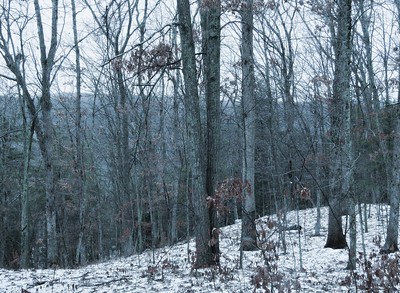
New England Losing Forest Cover, Experts Call for Accelerated Conservation
2010
Summary
This article describes the report "Wildlands and Woodlands: A Vision for the New England Landscape" which calls for retaining 70 percent of the New England forested landscape.
Key Personnel & Institutions
People: David Kittredge
Institutions: University of Massachusetts Amherst
Location
New England
Resource Type
Article
Tags
forests
Topic Tags
conservation, management, landscape pattern and connectivity
Purpose Tags
conservation, management
Citation
"New England Losing Forest Cover, Experts Call for Accelerated Conservation" University of Massachusetts Amherst, May 19, 2010, Accessed from (https://www.umass.edu/archivenewsoffice/article/new-england-losing-forest-cover-experts-call-accelerated-conservation)
Source Link
Land Use Change
2005
Summary
This article I an overview of the land use change in Northeastern U.S. starting in the 1980s.
Key Personnel & Institutions
Institutions: Northeast-Midwest State Foresters Alliance
Location
No location information available
Resource Type
Article
Tags
land use change
Topic Tags
landscape pattern and connectivity
Purpose Tags
education
Citation
"Land Use Change" A Snapshot of the Northeastern Forests, USDA Forest Service, Northeastern Area State & Private Forestry, NA-IN-01-06, October 2005
Source Link
A Policy Agenda for Conserving New England’s Forests: Priorities for 2013
2013
Summary
This Policy Agenda provides a broad-based appeal to the New England congressional delegation for continued bipartisan support and federal investment and partnership to help the region realize the benefits unique to New England’s forest-based economy.
Key Personnel & Institutions
Institutions: Northern Forest Canoe Trail
Location
New England
Resource Type
Article
Tags
No tag keywords available
Topic Tags
methods, management, ecosystem services, planning
Purpose Tags
conservation, management, policy
Citation
"A Policy Agenda for Conserving New England’s Forests: Priorities for 2013" Northern Forest Canoe Trail, New England’s Foressts Partners, 2013, Accessed from (http://www.northernforestcanoetrail.org/media/Policy Agenda for Conserving New England's Forests.pdf)
Source Link
http://www.northernforestcanoetrail.org/media/Policy Agenda for Conserving New England's Forests.pdf
The Place You Call Home: A Guide to Caring for Your Land in Massachusetts
2014
Summary
This guide is intended to be both a celebration of the region’s forestland and a forestland owner’s manual.
Key Personnel & Institutions
People: Elise Tillinghast
Institutions: Northern Woodlands
Location
Massachusetts
Resource Type
Article
Tags
guidance, private land
Topic Tags
conservation, methods, management, ecosystem services
Purpose Tags
conservation, management, education
Citation
Tillinghast, E. "The Place You Call Home: A Guide to Caring for Your Land in Massachusetts" Northern woodlands, January, 2015
Source Link
https://newenglandforestry.org/wp-content/uploads/2016/04/The-Place-You-Call-Home-MA.pdf
New York State Forest Action Plan
2020
Summary
The recommendations in this State Forest Action Plan (Plan or SFAP) outline the actions to be taken to ensure New York’s forests are prepared for the challenges and opportunities of the next 10 years. The Plan provides an important framework for the ongoing efforts of the New York State Climate Action Council to identify strategies, policies, and regulations to reach the State’s climate goals through forest protection and management. This Plan’s strategies also aim to stimulate public policy that safeguards the irreplaceable value of forests as climate change mitigators by preventing loss of forests to development or infrastructure.
Key Personnel & Institutions
People: Jerry Carlson , Sara Hart , Jason Drobnack , Barbara Lucas-Wilson , Dan Gaidasz , Jeffrey Mapes , Josh Clague , Julianna DiBiase , Peter Innes
Institutions: New York State Department of Environmental Conservation
Location
New York
Resource Type
Article
Tags
No tag keywords available
Topic Tags
methods, management, planning
Purpose Tags
management, policy
Citation
Cuomo, A.M., Seggos, B., "New York State Forest Action Plan", Department of Environmental Conservation, New York State, December 2020, Accessed from (https://www.dec.ny.gov/docs/lands_forests_pdf/nysfap.pdf)
Source Link
Decreasing Woodlot Size and the Future of Timber Sales in Massachusetts: When Is an Operation Too Small?
1996
Summary
The heavily forested landscape of Massachusetts is dominated by nonindustrial private ownerships. Statistics indicate that parcel size has decreased to a most recent average of 10.6 ac. Professional loggers were queried to determine if there was a timber sale size (expressed in either volume or area) below which they would not bid.
Key Personnel & Institutions
People: David Kittredge , Michael J. Mauri , Edward J. Mcguire
Institutions: University of Massachusetts, Amherst, Department of Forestry and Wildlife Management
Location
Massachusetts
Resource Type
Article
Tags
timber
Topic Tags
conservation, planning, landscape pattern and connectivity
Purpose Tags
conservation, management
Citation
Kittredge D.B. Jr., Mauri, M.J., McGuire, E.J., "Decreasing Woodlot Size and the Future of Timber Sales in Massachusetts: When Is an Operation Too Small?", Northern Journal of Applied Forestry, Volume 13, Issue 2, June 1996, Pages 96–101, https://doi.org/10.1093/njaf/13.2.96
Source Link
https://academic.oup.com/njaf/article/13/2/96/4802312?login=true
Reality Check: Has The Massachusetts Current-Use Tax Program Been Effective In Deterring Forest Parcelization?
2005
Summary
The study described in this article will attempt to address the efficacy of the Chapter 61 program in deterring forest parcelization across the state since the mid-1980s. It will also examine the rate of enrollees who obtain permanent protection for their forest land through conservation restrictions following initial program enrollment.
Key Personnel & Institutions
People: Jaekton H. Hewes
Institutions: University of Massachusetts, Department of Natural Resources Conservation
Location
Massachusetts
Resource Type
Article
Tags
parcelization
Topic Tags
conservation, planning, landscape pattern and connectivity
Purpose Tags
conservation, management
Citation
Hewes, J.H., ""Reality Check: Has The Massachusetts Current-Use Tax Program Been Effective In Deterring Forest Parcelization?"" Department of Natural Resources Conservation, University of Massachusetts, Amherst, 2005, Accessed from (https://www.fs.fed.us/ne/newtown_square/publications/technical_reports/pdfs/2005/325papers/hewes325.pdf)
Source Link
Projected Urban Growth (2000–2050) and Its Estimated Impact on the US Forest Resource
2005
Summary
This study projects the Urban growth in the US until 2050. Because of this urban growth, more regional planning and management may be needed to sustain forest products and ecosystem services required by a growing urban population.
Key Personnel & Institutions
People: David J. Nowak , Jeffrey T. Walton
Institutions: United States Department of Agriculture (USDA), Forest Service, Northern Research Station , The State University of New York (SUNY), College of Environmental Science and Forestry
Location
No location information available
Resource Type
Article
Tags
urban, impacts, resource
Topic Tags
conservation, management, ecosystem services, landscape pattern and connectivity
Purpose Tags
conservation, management
Citation
Nowak, D.J., Walton, J.T., "Projected Urban Growth (2000–2050) and Its Estimated Impact on the US Forest Resource", Journal of Forestry, Volume 103, Issue 8, December 2005, Pages 383–389, https://doi.org/10.1093/jof/103.8.383
Source Link
https://academic.oup.com/jof/article/103/8/383/4598675?login=true
Parcelization of nonindustrial private forestlands in Oneida County, New York: 1975–2000
1974 to 2002
Summary
This study uses established sampling and analysis techniques to document the parcelization of nonindustrial private lands (NIPL) in Oneida County, New York between 1075 and 2000 with a special focus on the division of nonindustrial private forestlands
Key Personnel & Institutions
People: Kevin Brazill
Institutions: The State University of New York (SUNY), College of Environmental Science and Forestry
Location
Oneida, New York
Resource Type
Report
Tags
parcelization, private forests
Topic Tags
drivers, landscape pattern and connectivity
Purpose Tags
management
Citation
Brazill, K.P., "Parcelization of nonindustrial private forestlands in Oneida County, New York: 1975–2000", State University of New York, College of Environmental Science & Forestry, August 2002, Accessed from (https://www.proquest.com/openview/f657cd0b3fab83db4a1ef2fa2bf8e78d/1?pq-origsite=gscholar&cbl=18750&diss=y)
Source Link
Applying the Transtheoretical Model of Change to Legacy Planning Decisions
2021
Summary
This study applied the transtheoretical model of behavior change to understand which activities and behaviors FFOs have pursued in relation to forest legacy planning. They conducted a regional mail survey of 2500 FFOs across Maine, Massachusetts, Vermont, and New York.
Key Personnel & Institutions
People: Paul Catanzaro , Marla Markowski-Lindsay, Michael Ryan Quartuch , Ezra Markowitz , Shorna Broussard Allred
Institutions: Family Forest Research Center , Cornell University, College of Agriculture and Life Sciences, Department of Natural Resources , University of Massachusetts, Amherst, Department of Environmental Conservation
Location
New England
Resource Type
Report
Tags
change, model
Topic Tags
conservation, management, landscape pattern and connectivity
Purpose Tags
conservation, management
Citation
Quartuch, M.R., Broussard Allred, S., Markowitz, E. et al. Applying the Transtheoretical Model of Change to Legacy Planning Decisions. Small-scale Forestry 20, 457–478 (2021). https://doi.org/10.1007/s11842-021-09476-7
Source Link
https://link.springer.com/article/10.1007/s11842-021-09476-7
One Size Does Not Fit All: Relationships between Size of Family Forest Holdings and Owner Attitudes and Behaviors
2005 to 2020
Summary
Using segmented regression, the relationships between size of forest holdings and the attitudes and behaviors of these family forest ownerships were tested using data from the 2018 iteration of the USDA Forest Service’s National Woodland Owner Survey.
Key Personnel & Institutions
People: Brett Butler , Jesse Caputo , Amanda Robillard , Emma Sass , Brett Butler
Institutions: United States Department of Agriculture (USDA), Forest Service, Northern Research Station , United States Department of Agriculture (USDA), Forest Service, Northern Research Station , Family Forest Research Center , University of St Andrews
Location
No location information available
Resource Type
Report
Tags
private forests
Topic Tags
conservation, management, ecosystem services, landscape pattern and connectivity
Purpose Tags
conservation, management
Citation
Butler, B.J., Caputo, J., Robillard, A.L., Sass, E.M., Sutherland, C., "One Size Does Not Fit All: Relationships between Size of Family Forest Holdings and Owner Attitudes and Behaviors", Journal of Forestry, Volume 119, Issue 1, January 2021, Pages 28–44, https://doi.org/10.1093/jofore/fvaa045
Source Link
https://academic.oup.com/jof/advance-article-abstract/doi/10.1093/jofore/fvab029/6270758
The Contribution of Wildlife Hosts to the Rise of Ticks and Tick-Borne Diseases in North America
2021
Summary
This forum article highlights the roles that wildlife hosts play in the maintenance and transmission of zoonotic, companion animal, livestock, and wildlife tick-borne pathogens.
Key Personnel & Institutions
People: Jean Tsao, Sarah Hamer , Seungeun Han , Jennifer L. Sidge , Graham J. Hickling
Institutions: Michigan State University , Texas A&M University, Department of Veterinary Integrative Biosciences, Schubolt Center for Avian Health , National Veterinary Institute, Department of Disease Control and Epidemiology , Michigan Department of Agriculture and Rural Development , University of Tennessee, Center for Wildlife Health, Department of Forestry, Wildlife and Fisheries
Location
No location information available
Resource Type
Article
Tags
ticks
Topic Tags
conservation, wildlife and habitat, landscape pattern and connectivity
Purpose Tags
conservation
Citation
Tsao, J.I, Hamer, S.A., Han, S., Sidge, J.L., Hickling, G.J. "The Contribution of Wildlife Hosts to the Rise of Ticks and Tick-Borne Diseases in North America", Journal of Medical Entomology, Volume 58, Issue 4, July 2021, Pages 1565–1587, https://doi.org/10.1093/jme/tjab047
Source Link
https://academic.oup.com/jme/article/58/4/1565/6245992?login=true
Threats, Challenges Facing Maine’s Forests
2020
Summary
This article highlights the challenges and threats such as forest fragmentation, over-harvesting, development pressures, climate change, invasive pests, pathogens and plants, and a rapidly aging cohort of small woodland owners.
Key Personnel & Institutions
Institutions: Maine Tree Foundation
Location
Maine
Resource Type
Article
Tags
forests, threats
Topic Tags
management, ecosystem services, drivers, wildlife and habitat, landscape pattern and connectivity
Purpose Tags
conservation, management
Citation
"Threats, Challenges Facing Maine’s Forests" Maine tree, Archive, Forests For Maine’s Future, 2020, Accessed from (https://mainetree.org/2020/04/threats-challenges-facing-maines-forests-html/)
Source Link
https://mainetree.org/2020/04/threats-challenges-facing-maines-forests-html/
Application for Site Location of Development Act Permit and Natural Resources Protection Act permit for the New England Clean Energy Connect ("NECEC")
2019
Summary
The purpose of this testimony is to describe the adverse impacts of habitat fragmentation that would be caused by the New England Clean Energy Connect Project.
Key Personnel & Institutions
People: Janet McMahon
Institutions: Maine Department of Environmental Protection, Maine Department of Agriculture, Conservation & Forestry, Land Use Planning Commission
Location
Maine
Resource Type
Article
Tags
permit, policy
Topic Tags
conservation, planning, landscape pattern and connectivity
Purpose Tags
conservation, policy
Citation
McMahon, J.S., "Application for Site Location of Development Act Permit and Natural Resources Protection Act permit for the New England Clean Energy Connect ("NECEC")" State of Maine Department of Environmental Protection, State of Maine Land Use Planning Commission in the Matter of Central Maine Power Company, 2019, Accessed from (https://www11.maine.gov/dacf/lupc/projects/site_law_certification/slc9/party_testimony/slc9_Group1_Direct_Testimony.pdf)
Source Link
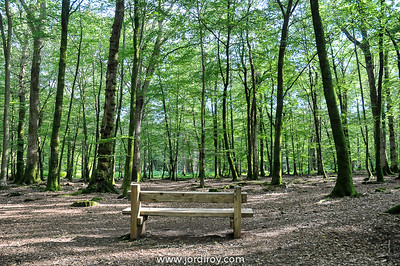
Economics of habitat fragmentation: a review and critique of the literature
2018
Summary
This paper presents a review of the existing economics literature that addresses habitat pattern/fragmentation and defines themes, issues, and next steps for this literature.
Key Personnel & Institutions
People: H. Jo Albers , Katherine D. Lee , Katherine R. E. Sims
Institutions: Amherst College , University of Wyoming , University of Idaho, Department of Agricultural Economics and Rural Sociology
Location
No location information available
Resource Type
Article
Tags
forest economy, literature review
Topic Tags
ecosystem services, planning, drivers, landscape pattern and connectivity
Purpose Tags
management, education, policy
Citation
Albers, H.J., Lee, K.D., Sims, K.R.E., "Economics of Habitat Fragmentation: a review and critique of literature" Accessed from (https://www.amherst.edu/system/files/media/FragmentationAlbersLeeSims Final.pdf)
Source Link
https://www.amherst.edu/system/files/media/FragmentationAlbersLeeSims Final.pdf
Biodiversity in the Forests of Maine: Guidelines for Land Management
1976 to 1999
Summary
By focusing on the potential influences of forest management on biological diversity this publication complements and expands on “A Forester’s Guide to Managing Wildlife Habitats in Maine” (Elliott 1988), while adding a set of broad, landscape-level considerations and recommendations that have been absent from most previously published guidelines.
Key Personnel & Institutions
People: Carol Foss , Gro Flatebo , Steven K. Pelletier
Institutions: University of Maine, University of Maine Cooperative Extension
Location
Maine
Resource Type
Article
Tags
biodiversity, guidelines
Topic Tags
conservation, methods, management, ecosystem services, landscape pattern and connectivity
Purpose Tags
conservation, management
Citation
Flatebo, G., Foss, C. R., Pelletier, S. K. "Biodiversity in the Forests of Maine: Guidelines for Land Management" University of Maine Cooperative Extension, 1999, Accessed from (https://www.nyfoa.org/application/files/3014/7948/5456/BiodiversityinMaineForests.pdf)
Source Link
https://www.nyfoa.org/application/files/3014/7948/5456/BiodiversityinMaineForests.pdf
$7 Million Federal Award Will Fund Stream Connectivity, Private Road Improvements in Maine
2021
Summary
Project partners led by The Nature Conservancy in Maine will use an innovative Stream Smart design and installation approach to improve habitat and aquatic organism passage and reduce impacts from increasingly volatile storm flows, using a $7 Million Federal Award.
Key Personnel & Institutions
People: Jeremy Cluchey
Institutions: The Nature Conservancy
Location
Maine
Resource Type
Article
Tags
roads, streams, funding
Topic Tags
conservation, management, planning, wildlife and habitat, landscape pattern and connectivity
Purpose Tags
conservation, policy
Citation
Cluchey, J., "$7 Million Federal Award Will Fund Stream Connectivity, Private Road Improvements in Maine" The Nature Conservancy, may 03, 2021, Accessed from (https://www.nature.org/en-us/newsroom/maine-award-funds-stream-connectivity/)
Source Link
https://www.nature.org/en-us/newsroom/maine-award-funds-stream-connectivity/
Protect the North Woods. Stop the Transmission Line.
Summary
This article outlines the campaign of Environment Maine to stop the building of a transmission line that would cut through the ecologically valuable wilderness in Maine.
Key Personnel & Institutions
Institutions: Environment Maine
Location
Maine
Resource Type
Article
Tags
protection
Topic Tags
conservation, planning, landscape pattern and connectivity
Purpose Tags
conservation, policy
Citation
"Protect the North Woods. Stop the Transmission Line." Environment Maine, Accessed from (https://environmentmaine.org/feature/mee/protect-north-woods-stop-transmission-line)
Source Link
https://environmentmaine.org/feature/mee/protect-north-woods-stop-transmission-line
Protecting Habitat in Downeast Maine
2004 to 2014
Summary
More than half of the Maine Woods has changed ownership in the last two decades, and natural landscapes are threatened with conversion to small private landholdings. In response to these threats, local community leaders and conservation organizations had begun forming partnerships aimed at protecting these landscapes on a massive scale.
Key Personnel & Institutions
Institutions: National Fish and WIldlife Foundation
Location
Maine
Resource Type
Article
Tags
protection
Topic Tags
conservation, wildlife and habitat, landscape pattern and connectivity
Purpose Tags
conservation, policy
Citation
"Protecting Habitat in Downeast Maine" National Fish And Wildlife Foundation, Accessed from (https://www.nfwf.org/media-center/featured-stories/protecting-habitat-downeast-maine)
Source Link
https://www.nfwf.org/media-center/featured-stories/protecting-habitat-downeast-maine
Defining Forest Fragmentation by Corridor Width: The Influence of Narrow Forest-Dividing Corridors on Forest-Nesting Birds in Southern New Jersey
1994
Summary
This study examined three types of ubiquitous, narrow, forest-dividing corridors for effects that influence the relative abundance and community composition of forest-nesting birds.
Key Personnel & Institutions
People: Adam C. Rich , David S. Dobkin , Lawrence J. Niles
Institutions: Society For Conservation Biology , High Desert Ecological Research Institute
Location
No location information available
Resource Type
Article
Tags
birds, corridor, nesting
Topic Tags
conservation, wildlife and habitat, landscape pattern and connectivity
Purpose Tags
conservation
Citation
Rich, A.C., Dobkin, D.S. and Niles, L.J. (1994), "Defining Forest Fragmentation by Corridor Width: The Influence of Narrow Forest-Dividing Corridors on Forest-Nesting Birds in Southern New Jersey". Conservation Biology, 8: 1109-1121. https://doi.org/10.1046/j.1523-1739.1994.08041109.x
Source Link
https://conbio.onlinelibrary.wiley.com/doi/abs/10.1046/j.1523-1739.1994.08041109.x
Forest Canopy Closure and Juvenile Emigration by Pool-Breeding Amphibians in Maine
1999
Summary
This study examined whether selection occurs for closed-canopy forest conditions during emigration by using pitfall traps and drift fences to sample naturally occurring populations of wood frogs and spotted salamanders along recently created forest clearcut edges in central Maine.
Key Personnel & Institutions
People: Malcolm Hunter, Phillip DeMaynadier
Institutions: University of Maine, Orono, Department of Wildlife Ecology
Location
Maine
Resource Type
Article
Tags
amphibians, vernal pools, canopy
Topic Tags
conservation, wildlife and habitat, landscape pattern and connectivity
Purpose Tags
conservation
Citation
DeMaynadier, P.G., Hunter, M.L.. “Forest Canopy Closure and Juvenile Emigration by Pool-Breeding Amphibians in Maine.” The Journal of Wildlife Management, vol. 63, no. 2, 1999, pp. 441–450. JSTOR, www.jstor.org/stable/3802629. Accessed 13 Aug. 2021.
Source Link
Effects of Silvicultural Edges on the Distribution and Abundance of Amphibians in Maine
2008
Summary
To better understand the importance of edge effects on amphibians in a forested landscape, this study sampled the distribution of populations along drift fences placed perpendicular to silvicultural edges of varying contrast in central Maine.
Key Personnel & Institutions
People: Malcolm Hunter, Phillip DeMaynadier
Institutions: University of Maine, Orono, Department of Wildlife Ecology, Society For Conservation Biology
Location
Maine
Resource Type
Article
Tags
silviculture, abundance, amphibian, distribution, edge
Topic Tags
conservation, wildlife and habitat, landscape pattern and connectivity
Purpose Tags
conservation
Citation
Demaynadier, P.G., Hunter, M.L. (1998), "Effects of Silvicultural Edges on the Distribution and Abundance of Amphibians in Maine". Conservation Biology, 12: 340-352. https://doi.org/10.1111/j.1523-1739.1998.96412.x
Source Link
https://conbio.onlinelibrary.wiley.com/doi/abs/10.1111/j.1523-1739.1998.96412.x
Easements and Conservation Policy in the North Maine Woods
2001
Summary
This article address conservation concerns and asks if development, recreation, biodiversity protection, and forest fragmentation are being addressed. It also asks if costs and benefits associated with the various conservation of the state are being weighed.
Key Personnel & Institutions
People: David J. Lewis
Institutions: University of Maine , University of Maine, Margaret Chase Smith Policy Center
Location
Maine
Resource Type
Article
Tags
conservation easements
Topic Tags
conservation, methods, management, ecosystem services, wildlife and habitat, landscape pattern and connectivity
Purpose Tags
conservation, management, policy
Citation
Lewis, D. J. "Easements and Conservation Policy in the North Maine Woods." Maine Policy Review 10.1 (2001) : 24 -36, https://digitalcommons.library.umaine.edu/mpr/vol10/iss1/5.
Source Link

A methodology for evaluation of the economic, forest fragmentation, and wildlife habitat effects of policies restricting size and adjacency of clearcut timber harvests
1996
Summary
This article outlines an integrative approach that could be used to evaluate the economic and ecological consequences of specific forest regulation policies.
Key Personnel & Institutions
People: Tara Michele Barrett
Institutions: University Of California, Berkeley
Location
Maine
Resource Type
Article
Tags
timber, harvest
Topic Tags
methods, management, planning, drivers
Purpose Tags
conservation, management, policy
Citation
Barrett, T.M., "A methodology for evaluation of the economic, forest fragmentation, and wildlife habitat effects of policies restricting size and adjacency of clearcut timber harvests" ProQuest, University of California, Berkeley. 1996, Accessed from (https://www.proquest.com/openview/33529460caf5cd25d9f92bb5485c056c/1?pq-origsite=gscholar&cbl=18750&diss=y)
Source Link
New Forestry in Eastern Spruce-Fir Forests: Principles and Applications to Maine
1992
Summary
This bulletin is a version of the original paper, of a compilation of papers presented at the technical session of the Forest Ecology Working Group at the National Convention of the Society of American Foresters. It was revised and expanded in response to comments from ten reviewers, including industrial foresters, wildlife biologists, and environmentalists from Maine, New Brunswick, and Ontario.
Key Personnel & Institutions
People: Robert Seymour , Malcolm Hunter
Institutions: University of Maine , University of Maine, School of Forest Resources , University of Maine, School of Forest Resources
Location
Maine
Resource Type
Article
Tags
spruce-fir
Topic Tags
conservation, management, ecosystem services, planning
Purpose Tags
conservation, management
Citation
Seymour, R. S., Hunter, M.L. JR, "New Forestry in Eastern Spruce-Fir Forests: Principles and Applications to Maine" Maine Agricultural Experiment Station, University of Maine. April 1992, Accessed from (https://www.researchgate.net/profile/Robert-Seymour/publication/259459089_New_Forestry_in_Eastern_Spruce-Fir_Forests_Principles_and_Applications_to_Maine/links/0046352bc4003ba335000000/New-Forestry-in-Eastern-Spruce-Fir-Forests-Principles-and-Applications-to-Maine.pdf)
Source Link
The Current Status and Conservation Needs of Maine Birds
2020
Summary
This chapter is a summary of forest changes and successful conservation efforts that ensure the diversity and abundance of native birds in Maine. Insight into the future of the species that remain at the greatest risk is given.
Key Personnel & Institutions
People: Barbara Vickery , Jeffrey V. Wells , Charles D. Duncan
Institutions: Princeton University Press
Location
Maine
Resource Type
Book
Tags
No tag keywords available
Topic Tags
conservation, wildlife and habitat
Purpose Tags
conservation
Citation
Wells, J. V., Vickery, B. S. and Duncan, C. D.. "4 The Current Status and Conservation Needs of Maine Birds: ". Birds of Maine, edited by Scott Weidensaul and Barbara Vickery, Princeton: Princeton University Press, 2020, pp. 43-74. https://doi.org/10.1515/9780691211855-008
Source Link
https://www.degruyter.com/document/doi/10.1515/9780691211855-008/html
Active Forest Management Reduces Blacklegged Tick and Tick-Borne Pathogen Exposure Risk
2018 to 2019
Summary
This was a two year study that tested the hypothesis that recent timber harvesting impacts blacklegged tick density and infection prevalence in managed nonindustrual forests
Key Personnel & Institutions
People: Jessica Leahy, Christine E. Conte , Allison M. Gardner
Institutions: University of Maine, School of Forest Resources , University of Maine, School of Forest Resources , University of Maine, School of Biology and Ecology
Location
Hancock, Maine
Resource Type
Article
Tags
ticks, pathogens
Topic Tags
management, wildlife and habitat, landscape pattern and connectivity
Purpose Tags
management
Citation
Conte, C.E., Leahy, J.E. & Gardner, A.M. "Active Forest Management Reduces Blacklegged Tick and Tick-Borne Pathogen Exposure Risk". EcoHealth (2021). https://doi.org/10.1007/s10393-021-01531-1
Source Link
https://link.springer.com/article/10.1007/s10393-021-01531-1
How well do proxy species models inform conservation of surrogate species?
2021
Summary
This study evaluated the North Atlantic Landscape Conservation Cooperative (NALCC) proxy models of LC and represented species framework across 13 states in the northeastern United States from Virginia to Maine. It validated a suite of questions related to co-occurrence of proxy and represented species with a compilation of independent datasets.
Key Personnel & Institutions
People: Scott Schwenk , Daniel Harrison, Cynthia Loftin, Cynthia Loftin , Petra Wood , Zachary G. Loman , William V. Deluca
Institutions: North Atlantic Landscape Conservation Cooperative, Maine Cooperative Fish and Wildlife Research Unit, University of Massachusetts, Amherst, Department of Environmental Conservation , Maine Department of Wildlife, Fisheries, and Conservation Biology
Location
No location information available
Resource Type
Article
Tags
No tag keywords available
Topic Tags
conservation, wildlife and habitat, landscape pattern and connectivity
Purpose Tags
conservation
Citation
Loman, Z.G., Deluca, W.V., Harrison, D.J. et al. "How well do proxy species models inform conservation of surrogate species?". Landscape Ecol (2021). https://doi.org/10.1007/s10980-021-01294-8
Source Link
https://link.springer.com/article/10.1007/s10980-021-01294-8
Place Attachment and Concern in Relation to Family Forest Landowner Behavior
2020
Summary
This study expands on the contemporary approach to studying family forests which has identified distinct subgroups of landowners through segmentation analysis. It incorporates the concept of place to provide a novel perspective on how the cognition and emotions that create place attachment and landowner concerns influence certain landowner behaviors. The study specifically modeled legacy planning and future landowner ownership behavioral intentions/behaviors.
Key Personnel & Institutions
People: Jessica Leahy, Patrick Lyons
Institutions: University of Maine, School of Forest Resources
Location
Maine
Resource Type
Article
Tags
No tag keywords available
Topic Tags
conservation, management, landscape pattern and connectivity
Purpose Tags
conservation, management
Citation
Leahy J, Lyons P. "Place Attachment and Concern in Relation to Family Forest Landowner Behavior". Forests. 2021; 12(3):295. https://doi.org/10.3390/f12030295
Source Link
Vermont Endangered Species Committee (ESC) 9-17-2020 Meeting Minutes
2020
Summary
Topics discussed at this meeting were the Act 250 criteria for forest fragmentation will be addressed by rule. Recreational trail jurisdiction is being considered in the Senate. FY21 budget was challenging due to a 3% reduction and special fund impacts. The FY22 budget was passed by the House. The Coronavirus Aid, Relief, and Economic Security Act (CARES Act) provided 14 million in funding to ANR. State lands received 3 million in funding for sustainable recreation.
Key Personnel & Institutions
People: Julie Moore
Institutions: Vermont Agency of Natural Resources, Endangered Species Committee
Location
VERMONT
Resource Type
Report
Tags
endangered species
Topic Tags
conservation, methods, management, planning
Purpose Tags
conservation, management, policy
Citation
Moore, J., "Vermont Endangered Species Committee (ESC) 9-17-2020 Meeting Minutes" September 17, 2020,
Source Link
Celebrating Progress, Possibilities, and Partnerships: Proceedings of the 2019 Forest Inventory and Analysis (FIA) Science Stakeholder Meeting
2019
Summary
This document is full of abstracts (brief and extended) from each of the presentations that were part of the 2019 FIA Stakeholders Science Meeting. The myriad of projects presented are a true testament to the impact the USDA Forest Service FIA Program has and the contributions that continue to be made to forest resource research.
Key Personnel & Institutions
People: Thomas J. Brandeis
Institutions: United States Department of Agriculture (USDA), Forest Service, Southern Research Station
Location
VERMONT, New Hampshire, Connecticut, Rhode Island
Resource Type
Article
Tags
forest inventory
Topic Tags
conservation, methods, management, planning
Purpose Tags
conservation, management, education
Citation
Brandeis, T. J. "Celebrating Progress, Possibilities, and Partnerships: Proceedings of the 2019 Forest Inventory and Analysis (FIA) Science Stakeholder Meeting" USDA Forest Service, September 2020. Accessed from (file:///C:/Users/abelisle/Downloads/gtr_srs256.pdf)
Source Link
Using landscape metrics to characterize towns along an urban-rural gradient
2010 to 2021
Summary
This article presents an approach to defining urban–rural gradients that integrates multiple landscape pattern metrics related to ecosystem processes important for natural resources and wildlife sustainability.
Key Personnel & Institutions
People: Kathleen Bell, Cynthia Loftin, Cynthia Loftin , Abigail Kaminski , Dana Marie Bauer , Erik J. Nelson
Institutions: Maine Cooperative Fish and Wildlife Research Unit, University of Maine, School of Economics , Clark University , Clark University, George Perkins Marsh Institute , Bowdoin College
Location
VERMONT, Massachusetts, Maine, New Hampshire, Connecticut, Rhode Island, New England
Resource Type
Article
Tags
urban
Topic Tags
ecosystem services, wildlife and habitat, landscape pattern and connectivity
Purpose Tags
education
Citation
Kaminski, A., Bauer, D. M., Bell, K. P., Loftin, C. S., Nelson, E. J. "Using landscape metrics to characterize towns along an urban-rural gradient". Landscape Ecol, 2021. https://doi.org/10.1007/s10980-021-01287-7
Source Link
https://link.springer.com/article/10.1007/s10980-021-01287-7
The Pollination Services of Forests: A Review of Forest and Landscape Interventions to Enhance Their Cross-Sectoral Benefits
2020
Summary
This working paper, which is aimed at forest practitioners, landscape planners and land-use decision-makers, reviews published literature on the impacts of forest and landscape management practices on pollinators. It also addresses the implications of climate change, collates 36 case studies, and makes recommendation on measures for maintaining pollinator diversity and abundance in forests and landscapes.
Key Personnel & Institutions
People: Chris J. Kettle , Smitha Krishnan , Gabriela Wiederkehr Guerra , Damien Bertrand , Sheila Wertz-Kanounnikoff
Institutions: ETH Zurich and Vrije Universiteit Brussel , Biodiversity International , Food and Agriculture Organization of the United Nations
Location
VERMONT, Massachusetts, New York, New Hampshire, New England
Resource Type
Book
Tags
No tag keywords available
Topic Tags
conservation, methods, management, drivers, wildlife and habitat, landscape pattern and connectivity
Purpose Tags
conservation, management, education
Citation
Krishnan, S., Guerra, G. W., Bertrand, D., Wertz-Kanounnikoff, S., Kettle, C. "The Pollination Services of Forests: A Review of Forest and Landscape Interventions to Enhance Their Cross-Sectoral Benefits" Food and Agriculture Organization of the United Nations, 2020. Accessed from (https://books.google.com/books?hl=en&lr=&id=JhvtDwAAQBAJ&oi=fnd&pg=PA81&dq=forest+fragmentation+new+hampshire&ots=D-JDi3YKLF&sig=AszPARpfR7BiisW5YABYqjmNFA0#v=onepage&q&f=false)
Source Link
Wild bee distribution near forested landscapes is dependent on successional state
2020
Summary
This study examined how land use type and distance from the forest edge affect the abundance and richness of the wild bee community across four forest successional states. Bees were collected in sites representing four stages of forest succession and analyzed using generalized linear mixed models with negative binomial distributions.
Key Personnel & Institutions
People: Katherine A. Odanaka , Sandra M. Rehan
Institutions: University of New Hampshire, Department of Biological Sciences
Location
Strafford, New Hampshire
Resource Type
Article
Tags
No tag keywords available
Topic Tags
conservation, ecosystem services, drivers, wildlife and habitat, landscape pattern and connectivity
Purpose Tags
conservation, education
Citation
Odanaka, K.A., Rehan, S.M. "Wild bee distribution near forested landscapes is dependent on successional state". For. Ecosyst. 7, 26 (2020). https://doi.org/10.1186/s40663-020-00241-4
Source Link
https://forestecosyst.springeropen.com/articles/10.1186/s40663-020-00241-4
Northeastern Area, State and Private Forestry: Strategic Plan, FY 2004 to FY
2003
Summary
This strategic plan builds from the past as it looks to the future, providing guidance for the next five years. The mission, vision and guiding principles ensure accountability for activities that make a positive difference on the ground and in people's lives.
Key Personnel & Institutions
People: Kathryn P. Maloney
Institutions: United States Department of Agriculture (USDA), Forest Service, Northeastern Area State and Private Forestry
Location
New York, New England
Resource Type
Report
Tags
No tag keywords available
Topic Tags
conservation, methods, management, planning
Purpose Tags
conservation, management, policy
Citation
Maloney, K. P.; "Northeastern Area, State and Private Forestry: Strategic Plan, FY 2004 to FY" July 2003, Accessed from https://books.google.com/books?id=mefnRDMbgGkC&pg=PA29&lpg=PA29&dq=forest+parcelization+northeast+us&source=bl&ots=zSeD1J_Cka&sig=ACfU3U0nZHbMTOlYW6BnbnL-6ocC8VMtOg&hl=en&sa=X&ved=2ahUKEwjqyuX44ZrpAhVDgnIEHftvBAY4ChDoATAIegQIChAB#v=onepage&q&f=false
Source Link
U.S. Forest Fragmentation - Northeast
2002
Summary
This dataset depicts indices of forest fragmentation within the U.S. Northeast region. This dataset can help inform prioritization of landscapes for conservation through identification of more intact forested areas.
Key Personnel & Institutions
People: James Strittholt
Institutions: Conservation Biology Institute
Location
No location information available
Resource Type
Map
Tags
intact forests
Topic Tags
No topic tag keywords available
Purpose Tags
No purpose tag keywords available
Citation
Strittholt, J. "U.S. Forest Fragmentation - Northeast" 2002, Accessed from https://databasin.org/datasets/6184881e98ba4eb5899bbaf7f57ceff2
Source Link
https://databasin.org/datasets/6184881e98ba4eb5899bbaf7f57ceff2
Threatened Species and Forest Fragmentation, Northeast US
2010
Summary
This map represents threatened species in relation to forest fragmentation in the Northeastern US.
Key Personnel & Institutions
Institutions: Conservation Biology Institute
Location
New England
Resource Type
Map
Tags
No tag keywords available
Topic Tags
conservation, landscape pattern and connectivity
Purpose Tags
conservation, education
Citation
"Threatened Species and Forest Fragmentation, Northeast US" 13 October 2010, Accessed from https://databasin.org/maps/1177a5b4fec4470e829e29cf575527a3
Source Link
Is Forest Fragmentation a Management Issue in the Northeast?
1988 to 1990
Summary
This report presents six papers from the technical session sponsored by the Wildlife and Fish Ecology Working Group, Society of American Foresters' Annual Convention, October19, 1988, Rochester, New York. These papers are used to determine the effects of forest fragmentation on the northeastern region of the United States.
Key Personnel & Institutions
People: Richard DeGraaf , William M. Healy
Institutions: United States Department of Agriculture (USDA), Forest Service
Location
New York, New England
Resource Type
Report
Tags
No tag keywords available
Topic Tags
conservation, methods, wildlife and habitat, landscape pattern and connectivity
Purpose Tags
conservation, education
Citation
DeGraaf, R. M.; Healy, W. M. "Is Forest Fragmentation a Management Issue in the Northeast?" 1990, Accessed from https://www.fs.fed.us/ne/newtown_square/publications/technical_reports/pdfs/scanned/gtr140.pdf
Source Link
Workshop Proceedings: Management of North Central and Northeastern Forests for Nongame Birds
1979
Summary
This is an overview of the third workshop of the National Nongame Bird Steering Committee. The purpose of this workshop is to share state of the art nongame bird research and management in various ecoregions of the United States.
Key Personnel & Institutions
People: Robert A. Hann
Institutions: United States Department of Agriculture (USDA), Forest Service, United States Department of Agriculture (USDA), Forest Service, North Central Forest Experiment Station
Location
New York, New England
Resource Type
Report
Tags
birds
Topic Tags
conservation, management, planning, wildlife and habitat
Purpose Tags
conservation, management, education
Citation
Hann, R. A. "Workshop Proceedings: Management of North Central and Northeastern Forests for Nongame Birds" 1992, Accessed from https://books.google.com/books?hl=en&lr=&id=3vcTAAAAYAAJ&oi=fnd&pg=PA198&dq=forest+fragmentation+northeast+us&ots=ZQbkzT-qqF&sig=4Kf_Jg5yuZqvaCeuKKNYphk9rSk#v=onepage&q&f=false
Source Link
Maine’s Climate Future: 2020 Update
2020
Summary
Maine’s ocean, forests, fields, wetlands, lakes, and rivers are very important to their way of life, livelihoods, and economy. The goal of this research is to use the best available information to understand the changes taking place all around Maine in order to avoid the worst case scenarios for the future.
Key Personnel & Institutions
People: Dr. Ivan Fernandez , Sean Birkel , Julia Simonson , Bradford Lyon , Andrew Pershing
Institutions: University of Maine , University of Maine, Climate Change Institute
Location
Maine
Resource Type
Article
Tags
climate
Topic Tags
conservation, management, ecosystem services, planning, drivers
Purpose Tags
conservation, management
Citation
Fernandez, I. J., Birkel, S., Simonson, J., Lyon, B., Pershing, A. "Maine’s Climate Future: 2020 Update" 2020, Climate Change Institute, The University of Maine. Accessed from (https://digitalcommons.library.umaine.edu/cgi/viewcontent.cgi?article=1005&context=climate_facpub)
Source Link
https://digitalcommons.library.umaine.edu/cgi/viewcontent.cgi?article=1005&context=climate_facpub
Fine-Scale Habitat Use and Movement of Wood Turtles (Gluptemys Insculpta) in the Northwoods of Maine and Vermont
2020
Summary
The movement and fine-scale habitat selection of two wood turtle populations was analyzed to inform management strategies that help sustain these wood turtle populations. This research also provides baseline data for populations located in relatively unfragmented habitat.
Key Personnel & Institutions
People: Sierra R. Marchacos
Institutions: Unity College , Plymouth State University
Location
VERMONT, Maine
Resource Type
Report
Tags
turtles
Topic Tags
conservation, wildlife and habitat, landscape pattern and connectivity
Purpose Tags
conservation
Citation
Marchacos, S. R., "Fine-Scale Habitat Use and Movement of Wood Turtles (Gluptemys Insculpta) in the Northwoods of Maine and Vermont". Unity College, Plymouth State University, December 2020. Accessed from (https://www.proquest.com/openview/514cc50012e0378b3c03ed0f6ae96018/1?pq-origsite=gscholar&cbl=44156)
Source Link
https://www.proquest.com/openview/514cc50012e0378b3c03ed0f6ae96018/1?pq-origsite=gscholar&cbl=44156
Working Forests Kept Working: The Working Forest Fund
2017
Summary
This in an overview of the Conservation Fund’s Working Forest Fund (WFF) which bridges the gap between securing multi-million dollar funding and conserving America’s working forests.
Key Personnel & Institutions
People: Anna Fitch
Institutions: Forest Society of Maine
Location
Maine
Resource Type
Article
Tags
working forests
Topic Tags
conservation, management, landscape pattern and connectivity
Purpose Tags
conservation
Citation
Fitch, A., Watts, A. "Working Forests Kept Working: The Working Forest Fund" The Forest Society of Maine, August 25, 2017, Accessed from (https://www.fsmaine.org/working-forest-fund/)
Source Link
Report on Maine Forest Service District Forester Program to the Joint Standing Committee on Agriculture, Conservation and Forestry of the 129th Maine Legislature, First Regular Session
2019
Summary
This is a report on the session of the Maine Forest Service’s District Forester Program. The Healthy Forests Program is in partnership with the Sustainable Forestry Initiative, Forest Resources Association and Certified Logging Professional Program.
Key Personnel & Institutions
Institutions: Maine Forest Service, Forest Policy and Management
Location
Maine
Resource Type
Report
Tags
agriculture, forestry
Topic Tags
conservation, management, landscape pattern and connectivity
Purpose Tags
conservation, management
Citation
"Report on Maine Forest Service District Forester Program to the Joint Standing Committee on Agriculture, Conservation and Forestry of the 129th Maine Legislature, First Regular Session" Maine Forest Service, Forest Policy and Management Devision, March 1, 2019
Source Link
https://digitalmaine.com/cgi/viewcontent.cgi?article=1246&context=for_docs
Maintiaining The Integrity of Forests and Water Quality: Challenges and Opportunities
2002 to 2018
Summary
This article covers topics of forest fragmentation, parcelization, land use trends in forests, statewide reports and initiatives, strategies, issues related to industrial scale SAP extraction, federal and state laws related to water pollution from logging and regulation of water pollution from public and private roads and driveways.
Key Personnel & Institutions
People: Jamey Fidel
Institutions: Vermont Natural Resources Council
Location
VERMONT
Resource Type
Article
Tags
water quality
Topic Tags
conservation, management, landscape pattern and connectivity
Purpose Tags
conservation, management, policy
Citation
Fidel, J. "Maintiaining The Integrity of Forests and Water Quality: Challenges and Opportunities" Vermont Natural Resources Council, July 30, 2020. Accessed from (https://www.friendsofthemadriver.org/uploads/1/0/5/0/105053173/7-30-20_fidel___groveman_webinar_for_r2r.pdf)
Source Link

Spatial Heterogeneity and Socioeconomic Patterns: Identifying the Impact of Urban Center on Forest Fragmentation
2017
Summary
This research identified the relationship between spatial pattern of forest and socioeconomic drivers in southern New Hampshire. The results indicated that house density was the most important factor in contributing to the forest fragmentation.
Key Personnel & Institutions
People: Junmei Tang , Liping Di , Jingfeng Xiao
Institutions: George Mason University, Center for Spatial Information Science Systems , University of New Hampshire, Institute for the Study of Earth, Oceans and Space
Location
New Hampshire
Resource Type
Article
Tags
urban, forest economy, impacts
Topic Tags
conservation, drivers, landscape pattern and connectivity
Purpose Tags
conservation
Citation
Tang, J., Di, L., Xiao, J. "Spatial Heterogeneity and Socioeconomic Patterns: Identifying the Impact of Urban Center on Forest Fragmentation" IEEEXplore, George Mason University, University of New Hampshire, 4 December, 2017. https://doi.org/10.1109/IGARSS.2017.8126893
Source Link

Artificial Nest Predation Dynamics Along a Forest Fragmentation Gradient: A Preliminary Analysis
2008
Summary
The objective of this study was to examine artificial nest predation dynamics along a fragmentation gradient (farm woodlots, logged forest stands and contiguous forest) in the conifer dominated Boreal Mixedwood.
Key Personnel & Institutions
People: Keith Hobson, Erin Bayne
Institutions: Canadian Wildlife Service, Saskatoon , University of Saskatchewan, Department of Biology
Location
VERMONT, Massachusetts, Maine, New York, New Hampshire, Connecticut, Rhode Island, New England
Resource Type
Article
Tags
predation, artificial nests
Topic Tags
conservation, management, wildlife and habitat, landscape pattern and connectivity
Purpose Tags
conservation, management
Citation
Bayne, E., Hobson, K. "Artificial Nest Predation Dynamics Along a Forest Fragmentation Gradient: A Preliminary Analysis" Journal of Sustainable Forestry, V. 5, 1997, Issue 1-2, 17 October 2008. https://doi.org/10.1300/J091v05n01_06
Source Link
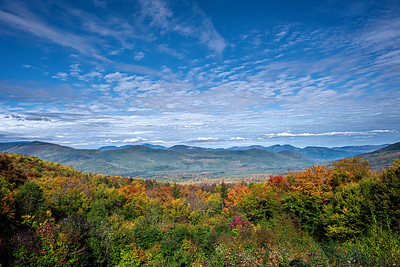
Birds at Log Landings in the White Mountain National Forest, New Hampshire
1988 to 1990
Summary
Birds were surveyed at log landings and forest/clearcut borders in the hardwood forest type of the White Mountain National Forest (WMNF) of New Hampshire during the breeding seasons of 1989 and 1990 to examine the possibility of log landings functioning as wildlife openings.
Key Personnel & Institutions
People: James W. Tucker , David P. Olson
Institutions: University of New Hampshire, Department of Natural Resources and the Environment, Auburn University, School of Forestry and Wildlife Sciences , Auburn University, School of Forestry and Wildlife Sciences
Location
New Hampshire
Resource Type
Article
Tags
white mountain national forest
Topic Tags
conservation, methods, management, ecosystem services, wildlife and habitat
Purpose Tags
conservation, management
Citation
Tucker, J. W., Jr., Olson, D. P. "Birds at Log Landings in the White Mountain National Forest, New Hampshire" Maine Naturalist 2, no. 2 (1994): 91-104. Accessed August 30, 2021. doi:10.2307/3858252.
Source Link
High-resolution forest carbon modelling for climate mitigation planning over the RGGI region, USA
2021
Summary
This study employs an updated version of the Ecosystem Demography (ED) model, an improved lidar initialization strategy, and an expanded calibration/validation approach to updated and expanded a high-resolution forest carbon modelling approach previously developed for the state of Maryland to 11 states in the Regional Greenhouse Gas Initiative (RGGI) domain .
Key Personnel & Institutions
People: Lei Ma , George Hurtt , Hao Tang , Rachel Lamb
Institutions: University of Maryland
Location
VERMONT, Massachusetts, Maine, New York, New Hampshire, Connecticut, Rhode Island
Resource Type
Article
Tags
carbon, modelling, climate change mitigation
Topic Tags
conservation, methods, management, ecosystem services, planning
Purpose Tags
conservation, management
Citation
Ma, L., Hurtt, G., Tang, H., Lamb, R. "High-resolution forest carbon modelling for climate mitigation planning over the RGGI region, USA" Environmental Research Letters, V. 16, No. 4. Accessed from (https://iopscience.iop.org/article/10.1088/1748-9326/abe4f4/meta)
Source Link
https://iopscience.iop.org/article/10.1088/1748-9326/abe4f4/meta
Social and Economic Pressures That Lead to Fragmentation, Parcelization, and Deforestation in the Maine Woods
2021
Summary
This thesis focuses on specific issues that help further an understanding of the pressures that motivate forest/farm landowners to manage their lands for various uses.
Key Personnel & Institutions
People: Jayne Lello
Institutions: University of Maine
Location
Maine
Resource Type
Article
Tags
landowners
Topic Tags
conservation, management, ecosystem services, drivers
Purpose Tags
conservation, management, education
Citation
Lello, J. "Social and Economic Pressures That Lead to Fragmentation, Parcelization, and Deforestation in the Maine Woods" The University of Maine, May 2012. Accessed from (https://digitalcommons.library.umaine.edu/etd/1724/)
Source Link
Forests on the Edge: A Case Study of South-Central and Southwest Maine Watersheds
2007
Summary
This is a preliminary report in book form that focuses on the health of forests on several watersheds located in southern Maine as housing development is expected to significantly increase.
Key Personnel & Institutions
People: Eric M. White
Institutions: United States Department of Agriculture (USDA), Forest Service, Pacific Northwest Research Station
Location
Maine
Resource Type
Book
Tags
watersheds
Topic Tags
conservation, management, drivers, landscape pattern and connectivity
Purpose Tags
conservation, management
Citation
White, E.M. "Forests on the Edge: A Case Study of South-Central and Southwest Maine Watersheds" USDA Forest Service, Pacific Northwest Research Station. 2007. Accessed from (https://www.fs.fed.us/openspace/fote/maine-casestudy-ew-062506.pdf)
Source Link
https://www.fs.fed.us/openspace/fote/maine-casestudy-ew-062506.pdf
Forestry Cooperatives for Diverse Management Goals: An Assessment of Interest Levels among Maine’s Nonindustrial Private Forest Owners Enrolled in the Tree Growth Tax Program
2005
Summary
The purpose of this study was to present forestry cooperative models to small, non-industrial woodland owners in Maine and to ascertain interest levels.
Key Personnel & Institutions
People: Brian Jonathan Schneider
Institutions: University of Maine
Location
Maine
Resource Type
Article
Tags
assessment, private forests, taxation
Topic Tags
conservation, management, ecosystem services, drivers
Purpose Tags
conservation, management, education
Citation
Schneider, B. J. "Forestry Cooperatives for Diverse Management Goals: An Assessment of Interest Levels among Maine’s Nonindustrial Private Forest Owners Enrolled in the Tree Growth Tax Program" The University of Maine. 2005. Accessed from (https://digitalcommons.library.umaine.edu/etd/451/)
Source Link
A Closer Look at Forests on the Edge: Future Development on Private Forests in Three States
2008
Summary
This book examines the factors behind projected patterns of residential development and conversion of private forest land by 2030 in northwestern Washington, southern Maine and northwestern Georgia.
Key Personnel & Institutions
People: Eric M. White
Institutions: United States Department of Agriculture (USDA), Forest Service, Pacific Northwest Research Station
Location
Maine
Resource Type
Book
Tags
private forests
Topic Tags
conservation, ecosystem services, wildlife and habitat
Purpose Tags
conservation
Citation
White, E.M. "A Closer Look at Forests on the Edge: Future Development on Private Forests in Three States" USDA Forest Service, Pacific Northwest Research Station. May 2008. Accessed from (https://books.google.com/books?hl=en&lr=&id=_BTJPvR8n8AC&oi=fnd&pg=PP9&dq=forest+parcelization+maine&ots=4sJ4SGlKtt&sig=kbE86lB5vMSbpIgr4XxquJYTgbs#v=onepage&q&f=false)
Source Link
Changing Forests - Challenging Times: Proceedings of the New England Society of American Foresters 85th Winter Meeting
2005
Summary
This is a compilation of abstracts submitted from the New England society of American foresters 85th winter meeting.
Key Personnel & Institutions
People: Mark Twery , Laura Kenefic
Institutions: United States Department of Agriculture (USDA), Forest Service, Northeastern Research Station
Location
New England
Resource Type
Article
Tags
No tag keywords available
Topic Tags
conservation, methods, management, ecosystem services, planning
Purpose Tags
conservation, management
Citation
Kenefic, L. S., Twery, M. J. "Changing Forests - Challenging Times: Proceedings of the New England Society of American Foresters 85th Winter Meeting" USDA Forest Service, Northeastern Research Station, March 2005. Accessed from (https://www.fs.fed.us/ne/newtown_square/publications/technical_reports/pdfs/2005/ne_gtr325.pdf#page=23)
Source Link
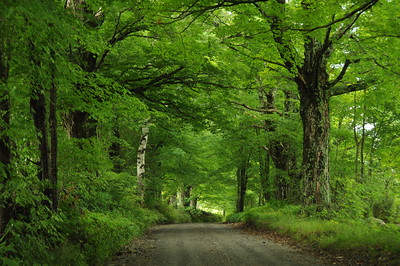
Trends and drivers of conservation easements in the United States
2021
Summary
The study objective was to analyze conservation easement trends and examine underlying choice determinants in the United States.
Key Personnel & Institutions
People: Sabhyata Lamichhane
Institutions: Mississippi State University
Location
VERMONT, Massachusetts, Maine, New York, New Hampshire, Connecticut, Rhode Island, New England
Resource Type
Article
Tags
conservation easements, trends
Topic Tags
conservation, management, landscape pattern and connectivity
Purpose Tags
conservation, management, policy
Citation
Lamichhane, S. "Trends and drivers of conservation easements in the United States" Mississippi State University, August 2020. Accessed from "https://www.proquest.com/openview/9ad1a4dd52df870707e6ae965893f822/1?pq-origsite=gscholar&cbl=18750&diss=y"
Source Link
New Hampshire Forest Action Plan - 2020
2020
Summary
This is a comprehensive assessment of forest resources and a statewide plan that was prepared as the sixth statewide forest assessment plan. These are to be prepared every 10 years.
Key Personnel & Institutions
People: Brad Simpkins , Susan Francher , Tracey Boisvert
Institutions: New Hampshire Division of Forests and Lands , University of New Hampshire Cooperative Extension
Location
New Hampshire
Resource Type
Report
Tags
No tag keywords available
Topic Tags
conservation, methods, management, planning
Purpose Tags
conservation, management, policy
Citation
Simpkins, B., Boisvert, T., Francher, S., Guinn, W., Lombard, K., Roberge, S., Sherman, S., Stanwood, S. "New Hampshire Forest Action Plan - 2020" Department of Natural and Cultural Resources, Devision of Forests and Lands, 2020. Accessed from "https://www.nh.gov/nhdfl/documents/nh-draft-sfap-sept-2020.pdf"
Source Link
https://www.nh.gov/nhdfl/documents/nh-draft-sfap-sept-2020.pdf
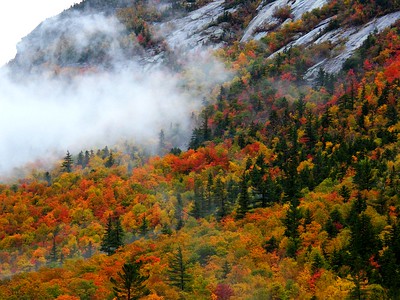
Background: Protecting Contiguous Habitat
1986 to 2005
Summary
This case study focuses on the concerns of protecting contiguous forest habitat in Dummerston, Vermont.
Key Personnel & Institutions
Institutions: New Hampshire Project Learning Tree
Location
VERMONT, DUMMERSTON, New Hampshire, New England
Resource Type
Article
Tags
No tag keywords available
Topic Tags
conservation, methods, management, wildlife and habitat, landscape pattern and connectivity
Purpose Tags
conservation, management
Citation
"Background: Protecting Contiguous Habitat" New Hampshire Project Learning Tree. Accessed from (https://www.plt.org/stuff/contentmgr/files/1/f1e63ab150f34a365494a91fc32545ad/files/background.pdf)
Source Link
https://www.plt.org/stuff/contentmgr/files/1/f1e63ab150f34a365494a91fc32545ad/files/background.pdf
Position Statements: Parcelization, Fragmentation, and the Loss of Private Land in the United States
Summary
The Society of American Foresters (SAF) supports land use and land management policies that strive to minimize forest loss and recognize the ecological, economic, and social importance of privately-owned forestland.
Key Personnel & Institutions
Institutions: Society of American Foresters
Location
VERMONT, Massachusetts, Maine, New York, New Hampshire, Connecticut, Rhode Island, New England
Resource Type
Article
Tags
private land
Topic Tags
conservation, management, ecosystem services
Purpose Tags
conservation, management, policy
Citation
"Position Statements: Parcelization, Fragmentation, and the Loss of Private Land in the United States" The Society of American Foresters. Accessed from (https://www.eforester.org/Main/Issues_and_Advocacy/Statements/Loss_of_US_Private_Forestland.aspx)
Source Link
https://www.eforester.org/Main/Issues_and_Advocacy/Statements/Loss_of_US_Private_Forestland.aspx
New Hampshire Conservation Summary
Summary
New Hampshire’s ecological systems range from the windswept alpine summits of the White Mountains to biologically-rich salt marshes on the coast of the Atlantic Ocean. Conservation efforts have protected many ecologically important areas in New Hampshire.
Key Personnel & Institutions
Institutions: LandScope America
Location
New Hampshire
Resource Type
Article
Tags
No tag keywords available
Topic Tags
conservation, management, ecosystem services, planning
Purpose Tags
conservation, management
Citation
"New Hampshire Conservation Summary" Landscope America, 2021. Accedded from (http://www.landscope.org/new-hampshire/overview/)
Source Link
The Unsustainable Economics of a Sustainable Maine Forest
2008
Summary
This paper was prepared the Keeping Forests as Forests Study Group. It is still currently under revision. It discusses the changing forests and the economic consequences.
Key Personnel & Institutions
People: Mike LeVert , Charles Lawton
Institutions: University of Southern Maine, Muskie School of Public Service , Maine State Planning Office
Location
Maine
Resource Type
Article
Tags
forest economy
Topic Tags
conservation, methods, management, ecosystem services, planning
Purpose Tags
conservation, management
Citation
LeVert, M., Colgan, C., Lawton, C. "The Unsustainable Economics of a Sustainable Maine Forest" Maine State Planning Office, Muskie School of Public Service, Planning Decisions, Inc. February 15, 2008. Accessed from (https://citeseerx.ist.psu.edu/viewdoc/download?doi=10.1.1.498.9471&rep=rep1&type=pdf)
Source Link
A Review of Changes in US Logging Businesses 1980s-Present
2018
Summary
This article reviews the logging business in the United States which has faced a number of challenges as well as the resilience and innovation over the years.
Key Personnel & Institutions
People: Joseph L. Conrad , W. Dale Greene , Patrick Hiesl
Institutions: Paul Smith's College, Adirondack Watershed Institute, The University of Georgia, Warnell School of Forestry and Natural Resources
Location
VERMONT, Massachusetts, Maine, New York, New Hampshire, Connecticut, Rhode Island, New England
Resource Type
Article
Tags
No tag keywords available
Topic Tags
conservation, management, ecosystem services
Purpose Tags
conservation, management
Citation
Conrad, L. J., Greene, W. D., Hiesl, P. "A Review of Changes in US Logging Businesses 1980s-Present" Journal of Forestry, V. 116, Issue 3, May 2018, pp 291-303. https://doi.org/10.1093/jofore/fvx014
Source Link
https://academic.oup.com/jof/article/116/3/291/4980796?login=true
Cold Hollow Carbon: A Vermont Forest Carbon Cooperative for Climate Change Mitigation
2020
Summary
This case profile details the genesis of the first aggregated forest carbon offset project in the United States, known as Cold Hollow Carbon.
Key Personnel & Institutions
People: Kavita K. Macleod
Institutions: Vermont Land Trust , International Land Conservation Network , Lincoln Institute of Land Policy
Location
VERMONT
Resource Type
Article
Tags
climate change, carbon
Topic Tags
conservation, management, ecosystem services
Purpose Tags
conservation, management
Citation
Macleod, K. K. "Cold Hollow Carbon: A Vermont Forest Carbon Cooperative for Climate Change Mitigation" The International Land Conservation Network, January 2021. Accessed from (https://www.coldhollowtocanada.org/fileadmin/files/Case_Profile_Cold_Hollow_Carbon_VT_03_24_21_.pdf)
Source Link
https://www.coldhollowtocanada.org/fileadmin/files/Case_Profile_Cold_Hollow_Carbon_VT_03_24_21_.pdf
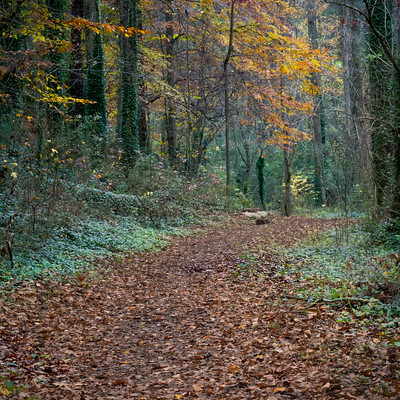
Interface Urban Forest Management in an Urbanizing Landscape
2020
Summary
The goal of this article is to present a framework that serves as a first step in explaining the trends in the use and management of private land for timber production in an urbanizing environment.
Key Personnel & Institutions
People: Maria A. Canha-e-Sa , Sofia F. Franco
Institutions: Nova School of Business and Economics, Nova University
Location
VERMONT, Massachusetts, Maine, New York, New Hampshire, Connecticut, Rhode Island, New England
Resource Type
Article
Tags
urban
Topic Tags
conservation, management, ecosystem services
Purpose Tags
conservation, management
Citation
Cunha-e-Sa, M. A., Franco, S. F. "Interface Urban Forest Management in an Urbanizing Landscape" 28 September 2020. https://doi.org/10.1093/acrefore/9780199389414.013.666
Source Link
Aging Forest Owners: What Will Become of Their Woods
2011
Summary
This article highlights the potential problems facing the forests as there is a large transition of forest property from one generation to the next.
Key Personnel & Institutions
People: Joe Rankin
Institutions: Maine Tree Foundation
Location
Maine
Resource Type
Article
Tags
No tag keywords available
Topic Tags
conservation, management, landscape pattern and connectivity
Purpose Tags
conservation, management
Citation
Rankin, J. "Aging Forest Owners: What Will Become of Their Woods" Maine Tree, September 2011, Accessed from (https://mainetree.org/2011/09/aging-forest-owners-what-will-become-of-their-woods-html/)
Source Link
https://mainetree.org/2011/09/aging-forest-owners-what-will-become-of-their-woods-html/
Vermont Forests Shrinking 1500 Acres a Year
2007 to 2014
Summary
This article explains the findings of a report released by forestry Researchers at Harvard University and the University of Vermont which shows that Vermont is losing 1500 acres of forest a year.
Key Personnel & Institutions
Institutions: VTDigger , Vermont Invasives
Location
VERMONT
Resource Type
Article
Tags
No tag keywords available
Topic Tags
conservation, management, landscape pattern and connectivity
Purpose Tags
conservation, management
Citation
"Vermont Forests Shrinking 1500 Acres a Year" Vermont Digger, Vermont Invasives, Accessed from (https://vtinvasives.org/news-events/news/study-vermont-forests-shrinking-1500-acres-a-year)
Source Link
https://vtinvasives.org/news-events/news/study-vermont-forests-shrinking-1500-acres-a-year
Beyond the Beauty Strip
2012
Summary
This article comes at the 20th anniversary of the publication Beyond the Beauty Strip: Saving What’s Left of Our Forests. Lansky explains that most though some of the forest lands have been protected, many of the major negative trends have continued.
Key Personnel & Institutions
People: Mitch Lansky
Institutions: Maine Organic Farmers and Gardeners Association
Location
Maine
Resource Type
Article
Tags
No tag keywords available
Topic Tags
conservation, management, landscape pattern and connectivity
Purpose Tags
conservation, management
Citation
Lansky, M. "Beyond the Beauty Strip". Maine Organic Farmers and Gardeners, Fall 2012. Accessed from (https://www.mofga.org/resources/forestry/beyond-the-beauty-strip/)
Source Link
https://www.mofga.org/resources/forestry/beyond-the-beauty-strip/
The Maine Woods, A Publication of the Forest Ecology Network, The Pingree Forest Partnership
2001
Summary
This article is about the closing of a historical deal between the Pingree family and New England Forestry Foundationthat will protect762,192 acres of Maine forest land.
Key Personnel & Institutions
Institutions: New England Forestry Foundation
Location
Maine
Resource Type
Article
Tags
ecology
Topic Tags
conservation, management
Purpose Tags
conservation, management
Citation
"The Maine Woods, A Publication of the Forest Ecology Network, The Pingree Forest Partnership" The Maine Woods, A Publication of the Forest Ecology Network, V.5 No. 2, New England Forestry Foundation. Accessed from (http://www.forestecologynetwork.org/TMW_LateFall2001/pingree_partnership.html)
Source Link
http://www.forestecologynetwork.org/TMW_LateFall2001/pingree_partnership.html
The Northern Forest of Maine, New Hampshire, Vermont and New York: A look at the land, economies and communities 1994-2004
1993 to 2004
Summary
This is a draft of the 10th Anniversary Review of the work of the Northern Forest Land Council, produced by the North East State Foresters Association
Key Personnel & Institutions
People: Eric Kingsley , Charles A. Levesque , Christina Petersen
Institutions: North East State Foresters Association
Location
VERMONT, Maine, New Hampshire, New York
Resource Type
Article
Tags
forest economy
Topic Tags
conservation, management, landscape pattern and connectivity
Purpose Tags
conservation, management, policy
Citation
Kingsley, E., Levesque, C. A., Petersen, C. "The Northern Forest of Maine, New Hampshire, Vermont and New York: A look at the land, economies and communities 1994-2004". North East State Foresters Association, August, 2004. Accessed from (http://www.nefainfo.org/uploads/2/7/4/5/27453461/nflcattenyears.thebackgroundpaper.8.23.04.pdf)
Source Link
http://www.nefainfo.org/uploads/2/7/4/5/27453461/nflcattenyears.thebackgroundpaper.8.23.04.pdf
New Hampshire Towns of Gorham And Milan Expand Protection For Community Forests
2020
Summary
This article provides information on recent land purchases that will help to augment town revenue, while ensuring clean drinking water, protecting wildlife habitat, and providing enhanced recreational opportunities
Key Personnel & Institutions
People: Ann Simonelli
Institutions: The Conservation Fund
Location
Gorham, Milan, New Hampshire
Resource Type
Article
Tags
No tag keywords available
Topic Tags
conservation, ecosystem services, wildlife and habitat, landscape pattern and connectivity
Purpose Tags
conservation, management
Citation
Simonelli, A. "New Hampshire Towns of Gorham And Milan Expand Protection For Community Forests" The Conservation Fund, August 3, 2020. Accessed from (https://www.conservationfund.org/impact/press-releases/2278-community-forests-expand-protection-in-new-hampshire)
Source Link
The State of New Hampshire’s Forests
1995 to 2021
Summary
In accordance with RSA 227-I:8 a citizens committee developed the Forest Resources Plan in 1996, summarizing the condition of the forestland proposing options to a variety of conservation partners to follow to achieve the vision.
Key Personnel & Institutions
Institutions: New Hampshire Division of Forests and Lands
Location
New Hampshire
Resource Type
Article
Tags
No tag keywords available
Topic Tags
conservation, management, ecosystem services, planning
Purpose Tags
conservation, management, policy
Citation
"The State of New Hampshire’s Forests" New Hampshire Division of Forests and Lands, April 2002. Accessed from (https://extension.unh.edu/sites/default/files/migrated_unmanaged_files/Resource000242_Rep261.pdf)
Source Link
https://extension.unh.edu/sites/default/files/migrated_unmanaged_files/Resource000242_Rep261.pdf
Wildlife Corridor Sage Mountain Botanical Sanctuary
2021
Summary
Sage Mountain Botanical Sanctuary serves as a critical corridor for terrestrial and riparian wildlife, at the southern end of over 80,000 acres of contiguous forest including the 26,000 acre Groton State Forest.
Key Personnel & Institutions
Institutions: Sage Mountain Botanical Sanctuary
Location
New Hampshire
Resource Type
Article
Tags
No tag keywords available
Topic Tags
conservation, wildlife and habitat, landscape pattern and connectivity
Purpose Tags
conservation
Citation
"Wildlife Corridor" Sage Mountain Botanical Sanctuary, 2021. Accessed from (https://sagemountain.com/conservation/land-nature/corridor/)
Source Link
New England-Acadian Forests
2021
Summary
This article is an extensive overview of the New England-Acadian forests that span New England and the Eastern Townships and the Beauce regions of Quebec and 50 percent of New Brunswick.
Key Personnel & Institutions
Institutions: World Wildlife Fund
Location
New England
Resource Type
Article
Tags
No tag keywords available
Topic Tags
conservation, wildlife and habitat
Purpose Tags
conservation, education
Citation
Davis, M., Gratton, L., Adams, J., Goltz, J., Stewart, C., Buttrick, S., Zinger, N., Kavanagh, K., Sims, M., Mann, G. "New England-Acadian Forests" World Wildlife Fund, 2021. Accessed from (https://www.worldwildlife.org/ecoregions/na0410)
Source Link
A Survey of Non-Native Plants Associated with Gravel Sediment Projects in White Mountain National Forest
2015 to 2020
Summary
This research involved a mixed methods approach that included 1) identifying non-native plant species on WMNF at thirty five construction sites, 2) determining the source of the gravel used at these sites, and 3) reviewing Master Plans from forty-two towns surrounding the WMNF to determine whether NNIS are a concern at the municipal level and identify what NNIS actions are implemented.
Key Personnel & Institutions
People: Jessica Casterline
Institutions: Plymouth State University
Location
New Hampshire
Resource Type
Article
Tags
white mountain national forest, non-native
Topic Tags
conservation, management, drivers, landscape pattern and connectivity
Purpose Tags
conservation, management
Citation
Casterline, J. "A Survey of Non-Native Plants Associated with Gravel Sediment Projects in White Mountain National Forest". Plymouth State University, 1 May 2020. Accessed from (https://www.proquest.com/openview/6d062e7707bc83574261dfe2d26464cb/1?pq-origsite=gscholar&cbl=44156)
Source Link
https://www.proquest.com/openview/6d062e7707bc83574261dfe2d26464cb/1?pq-origsite=gscholar&cbl=44156
Multiscale landscape genetics of American marten at their southern range periphery
2020
Summary
American marten (Martes americana) are a conservation priority in many forested regions of North America. Populations are fragmented at the southern edge of their distribution due to suboptimal habitat conditions. Facilitating gene flow may improve population resilience through genetic and demographic rescue. They used a multiscale approach to estimate the relationship between genetic connectivity and landscape characteristics among individuals at three scales in the northeastern United States: regional, subregional, and local.
Key Personnel & Institutions
People: William Kilpatrick , James Murdoch , Cody Aylward
Institutions: University of Vermont, Rubenstein School of Environment and Natural Resources , University of Vermont, Department of Biology
Location
VERMONT, Maine, New York, New Hampshire
Resource Type
Article
Tags
american marten
Topic Tags
conservation, drivers, wildlife and habitat, landscape pattern and connectivity
Purpose Tags
conservation
Citation
Aylward, C.M., Murdoch, J.D., Kilpatrick, C.W. "Multiscale landscape genetics of American marten at their southern range periphery". Heredity 124, 550–561, 2020. https://doi.org/10.1038/s41437-020-0295-y
Source Link
Impact of Land Use Changes and Habitat Fragmentation on the Eco-epidemiology of Tick-Borne Diseases
2020
Summary
This forum paper focuses on how land use changes have shaped the eco-epidemiology of Ixodes scapularis-borne pathogens, in particular the Lyme disease spirochete Borrelia burgdorferi sensu stricto in the eastern United States. It uses this as a model system, addressing other tick-borne disease systems as needed to illustrate patterns or processes.
Key Personnel & Institutions
People: Meredith VanAcker, Maria Diuk-Wasser, Maria P Fernandez
Institutions: Columbia University , Columbia University, Department of Ecology, Evolution and Environmental Biology
Location
VERMONT, Massachusetts, Maine, New York, New Hampshire, Connecticut, Rhode Island, New England
Resource Type
Article
Tags
impacts, landscape epidemiology, ticks
Topic Tags
management, drivers, wildlife and habitat, landscape pattern and connectivity
Purpose Tags
management
Citation
Diuk-Wasser, M. A., VanAcker, M. C., Fernandez, M. P. "Impact of Land Use Changes and Habitat Fragmentation on the Eco-epidemiology of Tick-Borne Diseases", Journal of Medical Entomology, Volume 58, Issue 4, July 2021, Pages 1546–1564, https://doi.org/10.1093/jme/tjaa209
Source Link
https://academic.oup.com/jme/article/58/4/1546/5936773?login=true
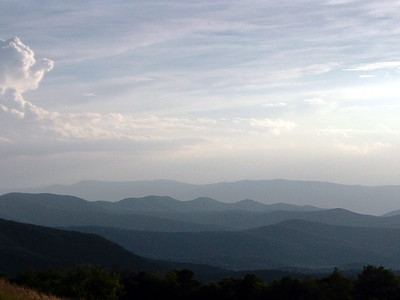
Threshold responses of songbirds to forest loss and fragmentation across the Marcellus-Utica shale gas region of central Appalachia, USA
2004 to 2020
Summary
The goal of this study was to identify threshold responses among bird species and habitat guilds to (1) overall forest loss and fragmentation in affected landscapes, and (2) distance from anthropogenic disturbance, both related and unrelated to shale gas.
Key Personnel & Institutions
People: Randy Dettmers, Petra Wood , Laura S. Farwell , Margaret C. Brittingham
Institutions: United States Geological Survey (USGS) , University of Wisconsin, Department of Forest and Wildlife Ecology , Pennsylvania State University, School of Forest Resources , West Virginia University, West Virginia Cooperative Fish and Wildlife Research Unit
Location
New York
Resource Type
Article
Tags
songbirds, Northern Appalachians
Topic Tags
conservation, ecosystem services, drivers, landscape pattern and connectivity
Purpose Tags
conservation, education
Citation
Farwell, L.S., Wood, P.B., Dettmers, R. et al. "Threshold responses of songbirds to forest loss and fragmentation across the Marcellus-Utica shale gas region of central Appalachia, USA". Landscape Ecol 35, 1353–1370 (2020). https://doi.org/10.1007/s10980-020-01019-3
Source Link
https://link.springer.com/article/10.1007/s10980-020-01019-3
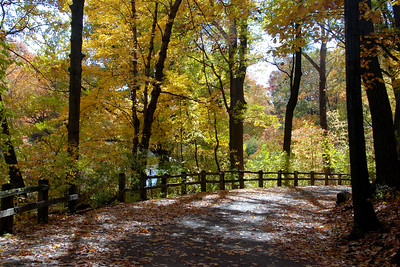
Can Disruption of an Ant–Plant Mutualism Explain a Lack of Recovery of Forest Herbs in Post-Agricultural Forests of New York?
2020
Summary
To determine if disruption to this ant–plant mutualism can partially explain the current distribution patterns of myrmecochorous plants, this study quantified the proportion of seeds removed by ants while accounting for predation by rodents in residual and post-agricultural forests.
Key Personnel & Institutions
People: Gregory McGee, Nathan G. Kiel , Geoffrey R. Griffiths
Institutions: The State University of New York (SUNY), College of Environmental Science and Forestry (ESF) , University of Wisconsin, Madison, Department of Integrative Biology
Location
New York
Resource Type
Article
Tags
herbs, agricultural development
Topic Tags
conservation, methods, planning, drivers, wildlife and habitat, landscape pattern and connectivity
Purpose Tags
conservation
Citation
Kiel, N. G., Griffiths, G. R., McGee, G. G. "Can Disruption of an Ant–Plant Mutualism Explain a Lack of Recovery of Forest Herbs in Post-Agricultural Forests of New York?," Northeastern Naturalist 27(2), 215-228, (28 April 2020). https://doi.org/10.1656/045.027.0204
Source Link

Forests and Insects
1997
Summary
The book covers such topics as colonization of trees by insects, population dynamics of forest insects, insect natural enemies, the effects of climate change and pollution on forest pests, spatial variation in the abundance of insects,the mineralization of carbon by termites, the impact of herbivorous insects, and the conservation of forest insect diversity, including the effects of forest fragmentation and deforestation.
Key Personnel & Institutions
People: Allan D. Watt , Nigel R. Stork , Mark D. Hunter
Institutions: University of Georgia , James Cook University, Cooperative Research Centre for Tropical Rainforest Ecology and Management , Edinburgh Research Station, Institute of Terrestrial Ecology
Location
Massachusetts, Maine, New York, New Hampshire, Connecticut
Resource Type
Book
Tags
insects
Topic Tags
conservation, drivers, wildlife and habitat, landscape pattern and connectivity
Purpose Tags
conservation
Citation
Watt, A. D., Stork, N. E., Hunter, M. D. "Forests and Insects" Royal Entomological Society, Chapman and Hall, issue 18, 1997. Accessed from (https://books.google.com/books?hl=en&lr=&id=wTNnPaLszyQC&oi=fnd&pg=PA303&dq=forest+fragmentation+new+york&ots=Awpuxu4D0l&sig=s77ja_eQ3dAVmQVyzAVb1jjSDc8#v=onepage&q&f=false)
Source Link
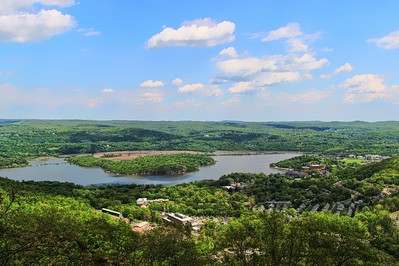
Hudson Valley Forest Fragmentation, Derived from 2016 NLCD
2015 to 2019
Summary
The results of this study are intended to inform communities about the impact of fragmentation on their significant forested areas but is not intended to be a substitute for on the ground assessments of condition.
Key Personnel & Institutions
People: Amy K. Conley
Institutions: New York Department of Environmental Conservation, New York Natural Heritage Program
Location
New York
Resource Type
Report
Tags
No tag keywords available
Topic Tags
conservation, ecosystem services, landscape pattern and connectivity
Purpose Tags
conservation
Citation
Conley, A. "Hudson Valley Forest Fragmentation, Derived from 2016 NLCD" New York Natural Heritage Program, 28 October, 2019. Accessed from (http://gis.ny.gov/gisdata/metadata/nysdec.HREP-Forest-Patch-Frag.xml)
Source Link
http://gis.ny.gov/gisdata/metadata/nysdec.HREP-Forest-Patch-Frag.xml
Forest Condition Index: Conservation Data for the Hudson River Estuary Watershed
2019
Summary
In 2019, the Hudson River Estuary Program partnered with the New York Natural Heritage Program to assess the condition of forests in the watershed so that conservation, restoration, and management decisions can be informed by the best available data.
Key Personnel & Institutions
People: Ingrid Haeckel , Nate Nardi-Cyrus
Institutions: Cornell University, Hudson River Estuary Program , New York Department of Environmental Conservation, New York Natural Heritage Program
Location
New York
Resource Type
Article
Tags
watershed
Topic Tags
conservation, ecosystem services, landscape pattern and connectivity
Purpose Tags
conservation
Citation
Haeckel, I., Nardi-Cyrus, N. "Forest Condition Index: Conservation Data for the Hudson River Estuary Watershed" NYS Department of Environmental Conservation, 2019. Accessed from (https://www.nynhp.org/documents/98/forest_condition_index_hshjI31.pdf)
Source Link
https://www.nynhp.org/documents/98/forest_condition_index_hshjI31.pdf
Hudson Valley Forest Patch Update and Assessment
2015 to 2020
Summary
The objective of this project was to delineate road-less forest patches throughout New York State, based on the latest version of the National Land Cover Dataset (2016), and then to assess the condition of those patches within the Hudson River Estuary Watershed.
Key Personnel & Institutions
Institutions: New York State Department of Environmental Conservation , New York Department of Environmental Conservation, New York Natural Heritage Program
Location
New York
Resource Type
Article
Tags
assessment
Topic Tags
conservation, ecosystem services, landscape pattern and connectivity
Purpose Tags
conservation
Citation
"Hudson Valley Forest Patch Update and Assessment" New York National Heritage Program, Division of Water, 31 December, 2020. Accessed from (https://www.nynhp.org/projects/hudson-valley-forest-patches/)
Source Link
https://www.nynhp.org/projects/hudson-valley-forest-patches/
Forests in New York City Parks
2021
Summary
The purpose of this page is to get to know more about New York’s forested areas, and really see the forest for more than just trees! Explore the basic structure of forests, the importance of forests in New York City, how NYC Parks cares for forests, and how you can care for them, too.
Key Personnel & Institutions
Institutions: New York City Department of Parks & Recreation, New York City Department of Parks & Recreation
Location
New York, New York
Resource Type
Article
Tags
forest, parks, and recreation
Topic Tags
conservation, management, ecosystem services
Purpose Tags
conservation, management, education
Citation
"Forests in New York City Parks" New York City Parks, Learning Hub. Accessed from (https://www.nycgovparks.org/learn/ecosystems/forests-in-new-york-city-parks)
Source Link
https://www.nycgovparks.org/learn/ecosystems/forests-in-new-york-city-parks
Habitat Loss
1999 to 2021
Summary
This article gives descriptions of different kinds of major habitat loss in the United States, their causes and how to combat those losses.
Key Personnel & Institutions
Institutions: National Wildlife Federation
Location
VERMONT, Massachusetts, Maine, New York, New Hampshire, Connecticut, Rhode Island, New England
Resource Type
Article
Tags
No tag keywords available
Topic Tags
conservation, management, drivers
Purpose Tags
conservation, management, education
Citation
"Habitat Loss" National WIldlife Federation. Accessed from (https://www.nwf.org/Educational-Resources/Wildlife-Guide/Threats-to-Wildlife/Habitat-Loss)
Source Link
https://www.nwf.org/Educational-Resources/Wildlife-Guide/Threats-to-Wildlife/Habitat-Loss
Threats to Biodiversity in the Watershed
2006 to 2021
Summary
This website provides and overview of the threats to biodiversity in the Hudson River Estuary Watershed. It also has a section that offers conservation and land-use approaches to avoid and minimize these challenges.
Key Personnel & Institutions
Institutions: Cornell University, College of Agriculture and Life Sciences, Department of Natural Resources
Location
New York
Resource Type
Website
Tags
biodiversity, watershed
Topic Tags
conservation, management, ecosystem services, planning
Purpose Tags
conservation, management, education
Citation
"Threats to Biodiversity in the Watershed" Cornell University. Accessed from (https://hudson.dnr.cals.cornell.edu/natural-areas-biodiversity/threats-biodiversity-watershed)
Source Link
https://hudson.dnr.cals.cornell.edu/natural-areas-biodiversity/threats-biodiversity-watershed
Threats to Biodiversity in the Watershed
2006 to 2021
Summary
This website provides and overview of the threats to biodiversity in the Hudson River Estuary Watershed. It also has a section that offers conservation and land-use approaches to avoid and minimize these challenges.
Key Personnel & Institutions
People: Randall Morin , Rachel Riemann , William McWilliams , Brett Butler , Mark Nelson , William H. McWilliams , Rachel Riemann , Jason Drobnack , Cassandra M. Kurtz , Susan J. Crocker , Thomas A. Albright
Institutions: United States Department of Agriculture (USDA), Forest Service, Northern Research Station , Cornell University, College of Agriculture and Life Sciences, Department of Natural Resources
Location
New York
Resource Type
Website
Tags
biodiversity, watershed
Topic Tags
conservation, management, ecosystem services, planning
Purpose Tags
conservation, management, education
Citation
"Threats to Biodiversity in the Watershed" Cornell University. Accessed from (https://hudson.dnr.cals.cornell.edu/natural-areas-biodiversity/threats-biodiversity-watershed)
Source Link
https://hudson.dnr.cals.cornell.edu/natural-areas-biodiversity/threats-biodiversity-watershed
Managing Forests For Birds: A Forester’s Guide
2019
Summary
This is a report on the forests of New York and their importance in the habitat of birds and conservation for those bird populations.
Key Personnel & Institutions
People: Suzanne Treyger
Institutions: Audubon New York
Location
New York
Resource Type
Report
Tags
birds
Topic Tags
conservation, management, ecosystem services, wildlife and habitat
Purpose Tags
conservation, management
Citation
Treyger, S.M. "Managing Forests for Birds: A Forester’s Guide". Audubon New York, 2019. Accessed from (https://ny.audubon.org/sites/default/files/free_guide_forest_management_new_york_birds.pdf)
Source Link
https://ny.audubon.org/sites/default/files/free_guide_forest_management_new_york_birds.pdf
Community Planning Toolbox: Forest Fragmentation
Summary
This website describes the issues facing Vermont’s forests that are a result of forest fragmentation and discusses possible tools to combat these issues.
Key Personnel & Institutions
Institutions: Vermont Natural Resources Council
Location
VERMONT
Resource Type
Website
Tags
communities, tool
Topic Tags
conservation, management, ecosystem services, landscape pattern and connectivity
Purpose Tags
conservation, management, education
Citation
"Community Planning Toolbox: Forest Fragmentation" Vermont Natural Resources Council. Accessed from (https://vnrc.org/community-planning-toolbox/issues/forest-fragmentation/)
Source Link
https://vnrc.org/community-planning-toolbox/issues/forest-fragmentation/
Forestland Parcelization
1974 to 2010
Summary
The Department of Natural Resources at Cornell University is working to understand how private forestland parcelization is occurring in New York State and is making resources available to better support landowners, forest professionals, and local policy-makers as they respond to this phenomenon.
Key Personnel & Institutions
People: Shorna Broussard Allred , Andrew Walker Roe , Peter J. Smallidge
Institutions: Cornell University, College of Agriculture and Life Sciences, Department of Natural Resources , Cornell University, Cooperative Extension
Location
New York
Resource Type
Website
Tags
No tag keywords available
Topic Tags
conservation, drivers, landscape pattern and connectivity
Purpose Tags
conservation, education
Citation
Allred, S. B., Stedman, R. C., Smallidge, P, Roe, A. W. "Forestland Parcelization: New York Patterns" Cornell University, Department of Natural Resources, Human Dimensions Research Unit. Accessed from (https://sites.google.com/site/forestparcelization/home)
Source Link

Mapping Rural Land Parcelization: A Methodology to Analyze the Intensity of Parcelization using Real Property Data
2016
Summary
The methodology proposed in this thesis report was able to identify patterns of privately owned rural land parcelization using the Finger Lakes and Mohawk Valley regions of New York as case studies.
Key Personnel & Institutions
People: Eva R. Salinas
Institutions: The State University of New York (SUNY)
Location
New York
Resource Type
Report
Tags
No tag keywords available
Topic Tags
conservation, management, landscape pattern and connectivity
Purpose Tags
conservation, management
Citation
Salinas, E. R. "Mapping Rural Land Parcelization: A Methodology to Analyze the Intensity of Parcelization using Real Property Data" State University of New York, May 2016. Accessed from (https://www.proquest.com/openview/7e06fe0c13bed8e50257104282d70070/1?pq-origsite=gscholar&cbl=18750)
Source Link
https://www.proquest.com/openview/7e06fe0c13bed8e50257104282d70070/1?pq-origsite=gscholar&cbl=18750
Changes in land use, forest ownership, parcel size, and fragmentation in forests of the U.S.
2020
Summary
Using U.S. Department of Agriculture Forest Service Forest Inventory and Analysis (FIA) data, we examined changes in land use, ownership, parcel size, and parcel level in the U.S. South.
Key Personnel & Institutions
People: Brett Butler , Jesse Caputo , Kurt Ritters , Thomas J. Brandeis
Institutions: United States Department of Agriculture (USDA), Forest Service, Southern Research Station
Location
VERMONT, Massachusetts, Maine, New York, New Hampshire, Connecticut, Rhode Island, New England
Resource Type
Article
Tags
land use change, ownership
Topic Tags
management, drivers, landscape pattern and connectivity
Purpose Tags
conservation, management
Citation
Caputo, J., Butler, B., Brandeis, T., Riitters, K. "Changes in land use, forest ownership, parcel size, and fragmentation in forests of the U.S." e-Research Paper-63. Asheville, NC: U.S. Department of Agriculture Forest Service, Southern Research Station, V 63, sp 1, ep 16, 2020. Accessed from (https://www.srs.fs.usda.gov/pubs/60404/)
Source Link
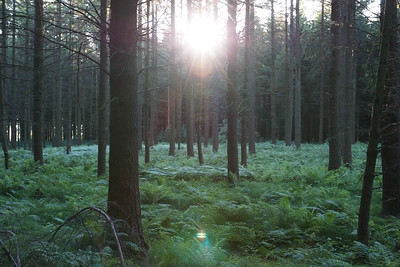
An Empirical Study of Posting Private Nonindustrial Forests
1993
Summary
This chapter identifies characteristics influencing the posting of nonindustrial private forest lands by analyzing and empirical model that examined the relationship between posting and variables that measure characteristics of the land, owner and surrounding community. The results are useful for assessing the implications of parcelization and the changing characteristics of landowners on posting.
Key Personnel & Institutions
People: Donald Dennis
Institutions: United States Department of Agriculture (USDA), Forest Service, NEFES
Location
VERMONT, Massachusetts, Maine, New York, New Hampshire, Connecticut, Rhode Island, New England
Resource Type
Article
Tags
private forests
Topic Tags
conservation, management, drivers, landscape pattern and connectivity
Purpose Tags
conservation, management
Citation
Dennis, D. F. “An Empirical Study of Posting Private Nonindustrial Forests.” Wildlife Society Bulletin (1973-2006), vol. 21, no. 1, 1993, pp. 6–10. JSTOR, www.jstor.org/stable/3783354. Accessed 2 Sept. 2021.
Source Link
Factors Influencing Involvement of a Forester in Managing Non-industrial Forests
1990
Summary
The purpose of this study was to identify forest and owner characteristics that influence whether professional forestry advice will be sought or not. The results are useful in assessing the impact of parcelization and changes in the characteristics of those who own forests on professional involvement in forestry decisions.
Key Personnel & Institutions
People: Donald Dennis , Paul E. Sendak
Institutions: United States Department of Agriculture (USDA), Forest Service, NEFES
Location
VERMONT, Massachusetts, Maine, New York, New Hampshire, Connecticut, Rhode Island, New England
Resource Type
Article
Tags
No tag keywords available
Topic Tags
conservation, management, landscape pattern and connectivity
Purpose Tags
conservation, management
Citation
Dennis, D. F. "Factors Influencing Involvement of a Forester in Managing Non-industrial Forests" USDA Forest Service, 5 June 1990. Accessed from (https://d1wqtxts1xzle7.cloudfront.net/43795743/Dennis1991_Factors_Influencing_Involvement_of_a_Forester_in_Managing_1-with-cover-page-v2.pdf?Expires=1630610962&Signature=Z8RVjUHTnsj3n3DJ6fkSi7ZnboLoRmFgOGbmkWJjjS3vivVt4SVUMDFVBHk5s2YT557bPazJ2wFU7hjKHXbnHhynnwcxHCytjBDUI5ltNQ2yrhaf-EPwSo12zjel0A4PlDtMmGDId3gWv6TgptnHBGETJGp65yAmPFsCD53m6~dz2-63p9G0ZUi1X2zpouvMi4AAIL8I~cZvOe7XuGQDUkh41G~ulYe3X43AwfH~bQOwY0F32du9XWiUMw4EEAga0z2IvCgbjJ8vjXlFyg684i4HgLoaFa1GzMTqvItICG~8T4igj0gxtzyuDuiyVaGD1KbI7KVDUS8mA04BDb8DSg__&Key-Pair-Id=APKAJLOHF5GGSLRBV4ZA)
Source Link
https://scholarsjunction.msstate.edu/cgi/viewcontent.cgi?article=3216&context=td

How Landowner Engagement Affects Forest Management Practices in Northern Vermont
2012
Summary
This study interviewed landowners and conducted field surveys on 59 Family Forest Owned properties, of at least 25 acres of forestland, in a four-county region of Vermont, who had harvested timber in the last 5 years.
Key Personnel & Institutions
People: Bryan E. Ellis
Institutions: The State University of New York (SUNY)
Location
VERMONT
Resource Type
Report
Tags
landowners
Topic Tags
conservation, management, landscape pattern and connectivity
Purpose Tags
conservation, management
Citation
Ellis, B. E. "How Landowner Engagement Affects Forest Management Practices in Northern Vermont" State University of New York, May 2012. Accessed from (https://www.proquest.com/openview/4a6a8257577575f78d978136b925bf8c/1?pq-origsite=gscholar&cbl=18750)
Source Link
https://www.proquest.com/openview/4a6a8257577575f78d978136b925bf8c/1?pq-origsite=gscholar&cbl=18750
Vermont Conservation Design: Maintaining and Enhancing an Ecologically Functional Landscape
2018
Summary
Vermont Conservation Design is a practical and efficient plan to address that uncertainty, and sustain the state’s valued natural areas, forests, waters, wildlife, and plants for future generations.
Key Personnel & Institutions
People: Eric Sorenson , Robert Zaino
Institutions: Vermont Agency of Natural Resources , Vermont Fish and Wildlife
Location
VERMONT
Resource Type
Article
Tags
ecological design, landscape
Topic Tags
conservation, methods, management, ecosystem services, planning
Purpose Tags
conservation, management
Citation
Sorenson, E., Zaino, R. ""Vermont Conservation Design: Maintaining and Enhancing an Ecologically Functional Landscape"" Vermont Acengy of Natural Resources, Vermont Fish and WIldlife, February, 2018. Accessed from (https://vtfishandwildlife.com/sites/fishandwildlife/files/documents/Conserve/VT Conservation Landscape-level Design/Vermont-Conservation-Design-Summary-Report-February-2018.pdf)
Source Link
Charlie Hancock, The big Picture
2021
Summary
This article describes the findings and concerns of Charlie Hancock, an owner of a forestry consulting company in Franklin county, Vermont. Hancock said the biggest problem facing Vermont’s forests is fragmentation.
Key Personnel & Institutions
People: Charlie Hancock
Institutions: Staying Connected Initiative
Location
VERMONT
Resource Type
Article
Tags
No tag keywords available
Topic Tags
conservation, methods, management
Purpose Tags
conservation, management, education
Citation
"Charlie Hancock, The big Picture" Staying Connected Initiative, 2021. Accessed from (http://stayingconnectedinitiative.org/our-work/local-engagement-and-capacity-planning/charlie-hancock-profile/)
Source Link
Managing Rich Northern Hardwood Forests for Ecological Values and Timber Production: Recommendations for Landowners in the Taconic Mountains
2018
Summary
Concerned about the issues facing forests, a group of foresters and ecologists has gathered periodically in southwestern Vermont since 1997 to discuss the ecology and management of these woods, called Rich Northern Hardwood Forests.
Key Personnel & Institutions
People: Alan Calfee , Chris Olson
Institutions: The Nature Conservancy
Location
VERMONT, New York, New England
Resource Type
Article
Tags
ecology, landowners, timber
Topic Tags
conservation, methods, management, ecosystem services
Purpose Tags
conservation, management
Citation
"Managing Rich Northern Hardwood Forests for Ecological Values and Timber Production: Recommendations for Landowners in the Taconic Mountains"" The Nature Conservancy, 2018. Accessed from (https://www.nature.org/content/dam/tnc/nature/en/documents/managing_rich_northern_hardwood_forest.pdf)
Source Link
Monitoring Forest Bird Populations in Vermont: Results of the Vermont Forest Bird Monitoring Program, 1989-1996
1988 to 1996
Summary
Using data from the first eight years of the Vermont Forest Bird Monitoring Program, a statistical analysis of birds censused during breeding season was conducted at 17 study sites located in mature, forested habitats in Vermont.
Key Personnel & Institutions
People: Christopher Rimmer , Kent McFarland , Steven Faccio
Institutions: VINS (Vermont Institute of Natural Science)
Location
VERMONT
Resource Type
Report
Tags
birds
Topic Tags
conservation, wildlife and habitat, landscape pattern and connectivity
Purpose Tags
conservation
Citation
Faccio, S. D., Rimmer, C. C., McFarland, K. P. "Monitoring Forest Bird Populations in Vermont: Results of the Vermont Forest Bird Monitoring Program, 1989-1996" Vermont Institute of Natural Science, November 1997. Accessed from (https://www.uvm.edu/femc/attachments/project/999/reports/BirdPopulations.pdf)
Source Link
https://www.uvm.edu/femc/attachments/project/999/reports/BirdPopulations.pdf
Investigating Bobcat-Recreation Conflict in Vermont
2020
Summary
This is a community engagement practicum through Middlebury College in partnership with the Northeast Wilderness Trust. They compiled a comprehensive literature review into wildlife-recreation conflict, with a focus on bobcats (Lynx rufus), developed a pilot study to investigate the impacts of multi-use trail networks on bobcats in Vermont, and created a habitat suitability index and model to identify and compare study sites.
Key Personnel & Institutions
People: Anna Willig , Greta Savitsky , Caroline Daley
Institutions: Middlebury College , Northeast Wilderness Trust
Location
VERMONT
Resource Type
Report
Tags
recreation, wildlife conflicts
Topic Tags
conservation, wildlife and habitat, landscape pattern and connectivity
Purpose Tags
conservation
Citation
Daley, C., Savitsky, G., Willig, A. ""Investigating Bobcat-Recreation Conflict in Vermont"" Middlebury College, Northeast Wilderness Trust, Spring 2020. Accessed from (http://www.middlebury.edu/system/files/media/NEWT_Final Report_DM.pdf)
Source Link
http://www.middlebury.edu/system/files/media/NEWT_Final Report_DM.pdf
30 Years of Land Cover Change in Connecticut, USA: A Case Study of Long-Term Research, Dissemination of Results, and Their Use in Land Use Planning and Natural Resource Conservation
1984 to 2015
Summary
The project analyzes changes to the state’s landscape using Landsat-derived 30-m land cover and cross-correlation analysis. It includes seven dates spanning 30 years, from 1985 to 2015.
Key Personnel & Institutions
People: James Hurd , Emily Wilson, Daniel Civco, Chester L. Arnold
Institutions: University of Connecticut, University of Connecticut, Department of Natural Resources and the Environment
Location
Connecticut
Resource Type
Report
Tags
land use planning, landcover change, long-term research, natural resources
Topic Tags
conservation, landscape pattern and connectivity
Purpose Tags
conservation
Citation
Arnold, C., Wilson, E., Hurd, J., Civco, D. "30 Years of Land Cover Change in Connecticut, USA: A Case Study of Long-Term Research, Dissemination of Results, and Their Use in Land Use Planning and Natural Resource Conservation" Land, vol. 9, issue 8, 225. 31 July 2020. https://doi.org/10.3390/land9080255
Source Link
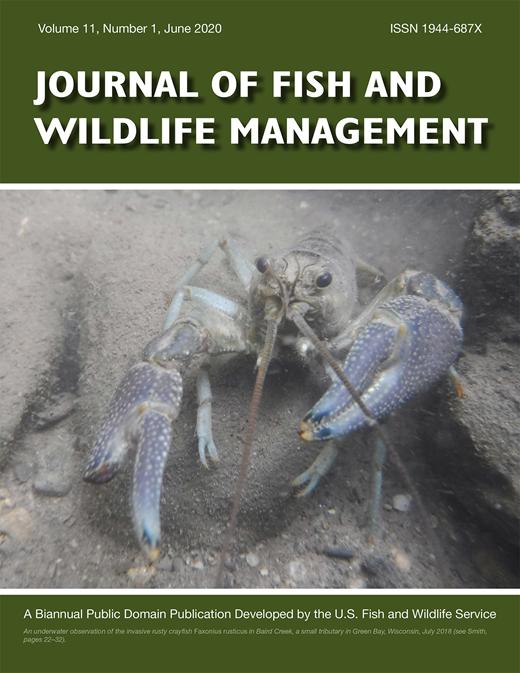
Spatial Use and Survival of Sympatric Populations of New England and Eastern Cottontails in Connecticut
2019
Summary
The objectives of this project were to quantify home range and core area sizes, annual survival rates, minimum population densities, and range overlap for sympatric populations of New England Cottontail and eastern cottontail at four sites in Connecticut.
Key Personnel & Institutions
People: Travis J. Goodie , Howard J. Kilpatrick
Institutions: Connecticut Department of Energy and Environmental Protection (DEEP) , University of Connecticut, Wildlife and Fisheries Conservation Center
Location
Connecticut
Resource Type
Report
Tags
survival, new england cottontail
Topic Tags
conservation, wildlife and habitat
Purpose Tags
conservation
Citation
Kilpatrick, H. J., Goodie, T. J. "Spatial Use and Survival of Sympatric Populations of New England and Eastern Cottontails in Connecticut" Journal of Fish and Wildlife Management 10 June 2020; 11 (1): 3–10. doi: https://doi.org/10.3996/082016-JFWM-062
Source Link
Forest Patch Size Predicts Seed Bank Composition in Urban Areas
2017 to 2019
Summary
This study asks the questions: how does regeneration, vis-a-vis the buried seed bank, vary in heterogenous urban forests? And, can forest patch size be used to predict regeneration and consequent management interventions?
Key Personnel & Institutions
People: Mark Ashton, Marlyse Duguid, Danica A Doroski
Institutions: Yale University, School of Forestry and Environmental Studies
Location
Connecticut
Resource Type
Report
Tags
seed banks, forest patch, patch size, composition
Topic Tags
conservation, methods, management, drivers, landscape pattern and connectivity
Purpose Tags
conservation, management
Citation
Doroski, D. A., Duguid, M. C., Ashton, M. S. "Forest Patch Size Predicts Seed Bank Composition in Urban Areas" Appl Veg Sci. 2021;24:e12534. https://doi.org/10.1111/avsc.12534
Source Link

Consequences of Forest Fragmentation for the Dynamics of Bird Populations: Conceptual Issues and the Evidence
2008
Summary
This paper reviews the consequences of forest fragmentation for the dynamics of bird populations.
Key Personnel & Institutions
People: Jorund Rolstad
Institutions: Botanical Journal of the Linnean Society , Norwegian Forest Research Institute
Location
VERMONT, Massachusetts, Maine, New York, New Hampshire, Connecticut, Rhode Island, New England
Resource Type
Article
Tags
birds
Topic Tags
conservation, wildlife and habitat
Purpose Tags
conservation
Citation
Rolstad, J. "Consequences of forest fragmentation for the dynamics of bird populations: conceptual issues and the evidence", Biological Journal of the Linnean Society, Volume 42, Issue 1-2, January 1991, Pages 149–163, https://doi.org/10.1111/j.1095-8312.1991.tb00557.x
Source Link
https://academic.oup.com/biolinnean/article-abstract/42/1-2/149/2654446
Temporal Characterization of Connecticut’s Landscape: Methods, Results, and Applications
2003
Summary
This paper describes the generation of different types of information layers of a forest fragmentation model and how they are being applied as tools for land use planning in Connecticut.
Key Personnel & Institutions
People: James Hurd , Emily Wilson, Daniel Civco, Chester L. Arnold , Sandy Prisloe
Institutions: University of Connecticut, University of Connecticut, Center for Land Use Education and Research
Location
Connecticut
Resource Type
Report
Tags
No tag keywords available
Topic Tags
conservation, methods, landscape pattern and connectivity
Purpose Tags
conservation
Citation
Hurd, J. D., Civco, D. L., Wilson, E. H., Prisloe, S., Arnold, C. L. "Temporal Characterization of Connecticut’s Landscape: Methods, Results, and Applications" ASPRS 2003 Annual Conference Proceedings, May 2003. Accessed from (http://citeseerx.ist.psu.edu/viewdoc/download?doi=10.1.1.497.8900&rep=rep1&type=pdf)
Source Link
Forest Fragmentation: Act 250 Considerations
2002 to 2017
Summary
This report is an overview of parcelization and fragmentation in Vermont, the results of a roundtable discussion, and research done to develop act 250.
Key Personnel & Institutions
People: Jamey Fidel
Institutions: Vermont Natural Resources Council
Location
VERMONT
Resource Type
Report
Tags
act 250
Topic Tags
conservation, methods, planning, drivers, landscape pattern and connectivity
Purpose Tags
conservation, management, policy
Citation
Fidel, J. "Forest Fragmentation: Act 250 Consideration" Vermont Natural Resources Council, 2020. Accessed from (https://legislature.vermont.gov/Documents/2020/WorkGroups/House Natural/Bills/19-0040/Written Testimony/Forest Fragmentation/W~Jamey Fidel~19-0040, Forest Fragmentation, Act 250 Considerations~2-8-2019.pdf)
Source Link
Landowners, Forest Products Industry, Professional Foresters & Conservation Working Together to Sustain New York’s Forest Resources
2017
Summary
This is a list of the objectives and break down of objectives from various landowners, forest product industries, professional foresters and conservation programs in order to sustain New York’s forest resources.
Key Personnel & Institutions
People: Muriel Church
Institutions: The Council of Forest Resource Organizations
Location
New York
Resource Type
Article
Tags
forest products
Topic Tags
conservation, methods, management, ecosystem services
Purpose Tags
conservation, management
Citation
Church, M. "Landowners, Forest Products Industry, Professional Foresters & Conservation Working Together to Sustain New York’s Forest Resources" The Council of Forest Resource Organizations, 2017. Accessed From (https://www.nyfoa.org/application/files/2214/8953/7590/FAD_Issue_Sheets_2017.pdf)
Source Link
https://www.nyfoa.org/application/files/2214/8953/7590/FAD_Issue_Sheets_2017.pdf
Parcelization and Land Use Change in the Rural Residential Landscape of the Catskill Region in New York State
2016
Summary
The Catskill region of New York State serves as the source of New York City’s water supply. This is one of many ecosystem services from this region. This study documents the continued change in private, rural parcel sizes from 2004 to 2010 in the Catskill region.
Key Personnel & Institutions
People: Rene Germain , Eddie Bevilacqua
Institutions: The State University of New York (SUNY)
Location
Catskill, New York
Resource Type
Report
Tags
catskills, land use change
Topic Tags
management, drivers, landscape pattern and connectivity
Purpose Tags
management
Citation
Germain, R., Pinkoski, C., Bevilacqua, E. "Parcelization and Land Use Change in the Rural Residential Landscape of the Catskill Region in New York State" The State University of New York, 2016. Accessed from (http://www.willallen.com/JCP/JCP_2016_V12_5_Germain.pdf)
Source Link
Generating a Forest Parcelization Map For Madison County, NY
2003
Summary
The objective of this study was to investigate techniques for modeling forest parcel size in order to facilitate future efforts to generate a national map depicting the distribution of forest parcel sizes County tax records and land-cover data for Madison County, New York.
Key Personnel & Institutions
People: Brett Butler , Susan L. King
Institutions: United States Department of Agriculture (USDA), Forest Service, Northern Research Station
Location
Madison, New York
Resource Type
Article
Tags
map
Topic Tags
management, drivers, landscape pattern and connectivity
Purpose Tags
management
Citation
King, S. L., Butler, B. J. "Generating a Forest Parcelization Map for Madison County, NY" Systems Analysis in Forest Resources: Proceedings of the 2003 Symposium, pps. 147-155, October 2005. Accessed from (https://books.google.com/books?hl=en&lr=&id=cbpFXR7iKEIC&oi=fnd&pg=PA147&dq=forest+parcelization+new+york&ots=IVFAI5Ryyp&sig=jvvb0taT3zk8Wa5AAiMvUer3XqQ#v=onepage&q&f=false)
Source Link
Small-scale non-industrial private forest ownership in the United States: rationale and implications for forest management
2005
Summary
This paper argues different reasons for the increase of non-industrial private forest ownership increasing in the U.S. it also discusses the implications of the parcelization of NIPF ownerships on forest management.
Key Personnel & Institutions
People: Daowei Zhang , Yaoqui Zhang
Institutions: United States Department of Agriculture (USDA), Forest Service
Location
VERMONT, Massachusetts, Maine, New York, New Hampshire, Connecticut, Rhode Island, New England
Resource Type
Article
Tags
private forests
Topic Tags
conservation, ecosystem services, drivers
Purpose Tags
conservation, education
Citation
Zhang, Y., Zhang, D., Schelhas, J. "Small-scale non-industrial private forest ownership in the United States: rationale and implications for forest management" U.S. Forest Service, Silva Fennica, Vol. 39(3): 443-454, 2005. Accessed from (https://www.fs.usda.gov/treesearch/pubs/25014)
Source Link
Welcome to CLEAR’s Forest Fragmentation Analysis Project
1984 to 2006
Summary
This portion of the CLEAR Research site provides information on the results of our forest fragmentation analysis. By applying CLEAR’s forest fragmentation tool to the five remote sensing-derived land cover datasets of the Connecticut’s Changing Landscape study (1985, 1990, 1995, 2002, 2006), they give a better sense of the health and function of one of our state’s most important natural resources.
Key Personnel & Institutions
Institutions: University of Connecticut, Center for Land Use Education and Research
Location
Connecticut
Resource Type
Website
Tags
analysis, CLEAR
Topic Tags
conservation, ecosystem services, landscape pattern and connectivity
Purpose Tags
conservation
Citation
"Welcome to CLEAR’s Forest Fragmentation Analysis Project" Connecticut’s Changing Landscape, 2006. Accessed from (https://clear.uconn.edu/projects/landscape/v2/forestfrag/index.htm)
Source Link
https://media.clear.uconn.edu/projects/landscape/v2/forestfrag/index.htm
Changing Landscape: Connecticut and Long Island Sound Land Cover and Change
1984 to 2015
Summary
CLEAR’s Landscape Fragmentation Tool was used to identify four forest fragmentation categories using a 300 foot edge width applied to the reclassified land cover.
Key Personnel & Institutions
People: Emily Wilson
Institutions: University of Connecticut, Center for Land Use Education and Research
Location
Connecticut
Resource Type
Website
Tags
landcover, landcover change, CLEAR
Topic Tags
conservation, ecosystem services, landscape pattern and connectivity
Purpose Tags
conservation
Citation
Wilson, E. "Changing Landscape: Connecticut and Long Island Sound Land Cover and Change" Center For Land Use Education & Research, 2015. Accessed from (https://clear.uconn.edu/\/projects/landscape/CT/forestfrag.htm)
Source Link
https://clear.uconn.edu/\/projects/landscape/CT/forestfrag.htm
Environmental Quality in Connecticut Throughout the Year 2018
Summary
This edition documents the condition of Connecticut’s environment through 2018.
Key Personnel & Institutions
Institutions: Connecticut State Council on Environmental Quality
Location
Connecticut
Resource Type
Website
Tags
environment
Topic Tags
conservation, ecosystem services, drivers, wildlife and habitat, landscape pattern and connectivity
Purpose Tags
conservation, education
Citation
"Environmental Quality in Connecticut Throughout the Year 2018" Connecticut State Council on Environmental Quality, 2018. Accessed from (https://portal.ct.gov/CEQ/AR-18-Gold/2018-CEQ-Annual-Report-eBook/Land-Preserved_Land)
Source Link
https://portal.ct.gov/CEQ/AR-18-Gold/2018-CEQ-Annual-Report-eBook/Introduction
DEEP Report: Connecticut’s Forest Coverage Remains ’Remarkable’, But Insects, Weather and Decelopment
2020
Summary
Connecticut’s forests, from urban patches to wide expanses, are essential to the state’s health and character, but insects, drought and development remain persistent threats, according to the state Department of Energy and Environmental Protection’s Forest Action Plan 2020, which details current conditions and long-term vulnerabilities.
Key Personnel & Institutions
People: Jesse Leavenworth
Institutions: Hartford Courant
Location
Connecticut
Resource Type
Article
Tags
weather, insects, forest cover
Topic Tags
conservation, ecosystem services, drivers, wildlife and habitat
Purpose Tags
conservation
Citation
Leavenworth, J. ""DEEP Report: Connecticut’s Forest Coverage Remains ’Remarkable’, But Insects, Weather and Decelopment"" Hartford Courant, 01 December, 2020. Accessed from (https://www.courant.com/news/connecticut/hc-news-ct-forest-report-20201201-xrow7csyzjff7hhe4mwzm7mr2y-story.html)
Source Link

Remote Sensing and GIS Analysis of Landscape Parcelization and Forest Fragmentation
Summary
The combination of high population density and forestland ownership puts the Connecticut's forest resource at risk and places a premium on understanding the relationship of development patterns, especially forest fragmentation and landscape parcelization, to the physical changes in the landscape.
Key Personnel & Institutions
People: Daniel Civco
Institutions: University of Connecticut
Location
Connecticut
Resource Type
Report
Tags
No tag keywords available
Topic Tags
conservation, ecosystem services, drivers, landscape pattern and connectivity
Purpose Tags
conservation
Citation
Civco, D. L. "Remote Sensing and GIS Analysis of Landscape Parcelization and Forest Fragmentation" University of Connecticut, 30 September, 2006. Accessed from (https://portal.nifa.usda.gov/web/crisprojectpages/0193844-remote-sensing-and-gis-analysis-of-landscape-parcelization-and-forest-fragmentation.html)
Source Link
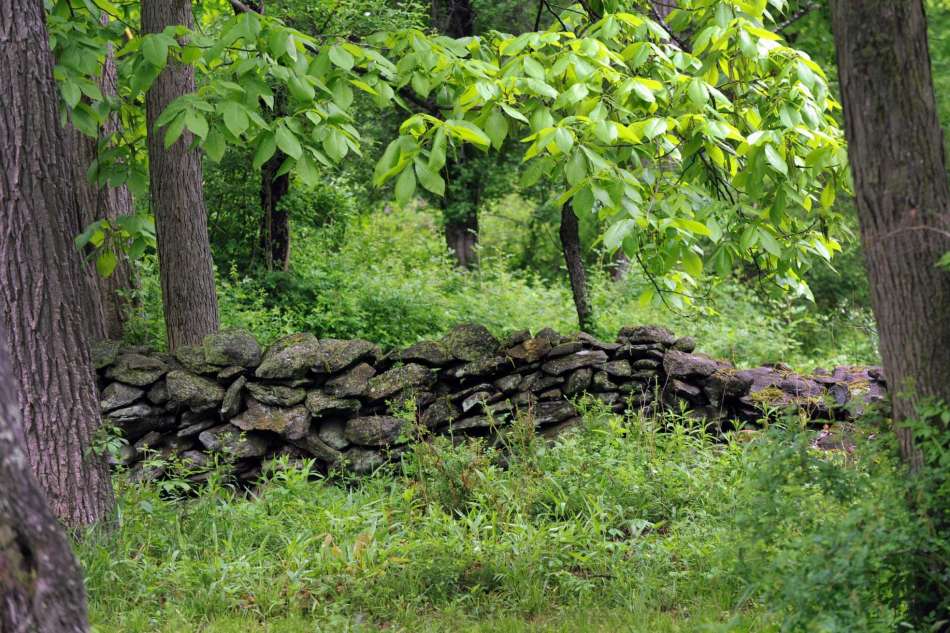
Report: Connecticut’s Forests are in Jeopardy
2017
Summary
A Harvard research report shows that after 150 years of reforestation efforts around New England, the region is headed toward “irreversible” forest loss due to development, and Fairfield County in particular is at a “high” risk.
Key Personnel & Institutions
People: Pat Tomlinson
Institutions: The Hour
Location
Connecticut
Resource Type
Article
Tags
No tag keywords available
Topic Tags
conservation, ecosystem services, drivers, landscape pattern and connectivity
Purpose Tags
conservation
Citation
Tomlinson, P. "Report: Connecticut’s Forests are in Jeopardy" The Hour, 23 September, 2017. Accessed from (https://www.thehour.com/news/article/Report-Connecticut-s-forests-are-in-jeopardy-12222933.php)
Source Link
https://www.thehour.com/news/article/Report-Connecticut-s-forests-are-in-jeopardy-12222933.php
Connecticut’s 2020 Forest Action Plan DRAFT
2020
Summary
The Connecticut Department of Energy and Environmental Protection (DEEP) and its many partners and constituents are striving to keep forests as forests. A statewide goal of no net forest loss will focus on keeping forests present, connected, healthy, and productive for the people and ecosystems of Connecticut.
Key Personnel & Institutions
People: Dan Peracchio
Institutions: Connecticut Department of Energy and Environmental Protection (DEEP)
Location
Connecticut
Resource Type
Report
Tags
No tag keywords available
Topic Tags
methods, management, ecosystem services, planning, wildlife and habitat, landscape pattern and connectivity
Purpose Tags
conservation, management
Citation
Peracchio, D. ""Connecticut’s 2020 Forest Action Plan DRAFT"" Connecticut Department of Energy and Environmental Protection, 2020. Accessed from (https://portal.ct.gov/-/media/DEEP/forestry/2020_Draft_FAP.pdf)
Source Link
https://portal.ct.gov/-/media/DEEP/forestry/2020_Draft_FAP.pdf
Connecticut‘s Forest Resource Assessment and Strategy 2010
2010
Summary
Connecticut‘s Statewide Forest Resource Assessment and Strategy is a guidance document meant for the Connecticut Department of Environmental Protection‘s Division of Forestry, and our forest conservation partners in academia, extension, non-profits, regional, municipal, and private landowners.
Key Personnel & Institutions
People: Helene Hochholzer
Institutions: Connecticut Department of Energy and Environmental Protection (DEEP)
Location
Connecticut
Resource Type
Report
Tags
assessment, strategic plan
Topic Tags
methods, management, ecosystem services, planning, wildlife and habitat
Purpose Tags
conservation, management
Citation
Hochholzer, H. ""Connecticut‘s Forest Resource Assessment and Strategy"" Connecticut Department of Environmental Protection, 2010. Accessed from (https://portal.ct.gov/-/media/DEEP/forestry/assessment_and_strategy/AssessmentStrategypdf.pdf)
Source Link
https://portal.ct.gov/-/media/DEEP/forestry/assessment_and_strategy/AssessmentStrategypdf.pdf
Connecticut’s Forest Legacy Problem
1989 to 2002
Summary
This article is an overview of the history, requirements and goals of Connecticut’s Forest Legacy program.
Key Personnel & Institutions
People: Fred Borman
Institutions: Connecticut Department of Energy and Environmental Protection (DEEP)
Location
Connecticut
Resource Type
Article
Tags
No tag keywords available
Topic Tags
conservation, methods, management
Purpose Tags
conservation, management
Citation
Vorman, F. III "Connecticut’s Forest Legacy Problem" Connecticut Department of Environmental Protection, March 2002. Accessed from (http://www.ecfla.org/connecticuts-forest-legacy-problem/)
Source Link
From Engagement to Action: Supporting Woodland Owners in Decisions About Their Land
2019
Summary
This document produced by New England Forestry Foundation reports on a focused effort to apply new approaches to reach out to forest landowners and engage them in improving their forest management and exploring conservation outcomes.
Key Personnel & Institutions
People: Robert Perschel , Frank Lowenstein , Elizabeth G. Hayden
Institutions: New England Forestry Foundation
Location
VERMONT, Massachusetts, Maine, New Hampshire, Connecticut, Rhode Island, New England
Resource Type
Article
Tags
decision support, private forests, woodlands
Topic Tags
conservation, methods, management
Purpose Tags
conservation, management, education
Citation
Hayden, E. G., Lowenstein, F., Perschel, R. T. ""From Engagement to Action: Supporting Woodland Owners in Decisions About Their Land"" New England Forestry Foundation, November 2019. Accessed from (https://newenglandforestry.org/wp-content/uploads/2019/11/engagement-to-action-2019report.pdf)
Source Link
https://newenglandforestry.org/wp-content/uploads/2019/11/engagement-to-action-2019report.pdf
Sustained Yield Management on Family Woodlands in Vermont’s Northern Forest
2011
Summary
This project investigated 59 recently harvested, family-owned properties with 25 acres or more of timberland across a four-county area of Vermont. On each property, this study evaluated the use of silviculture and compliance with Best Management Practices (BMP) to determine the extent of sustained yield management.
Key Personnel & Institutions
People: Neal F. Maker
Institutions: The State University of New York (SUNY)
Location
VERMONT
Resource Type
Report
Tags
family forest
Topic Tags
conservation, management, landscape pattern and connectivity
Purpose Tags
conservation, management
Citation
Maker, N. F. "Sustained Yield Management on Family Woodlands in Vermont’s Northern Forest" State University of New York, November 2011. Accessed from (https://www.proquest.com/openview/bd83d9935f51101b7bfad65fe4450851/1?pq-origsite=gscholar&cbl=18750)
Source Link
https://www.proquest.com/openview/bd83d9935f51101b7bfad65fe4450851/1?pq-origsite=gscholar&cbl=18750
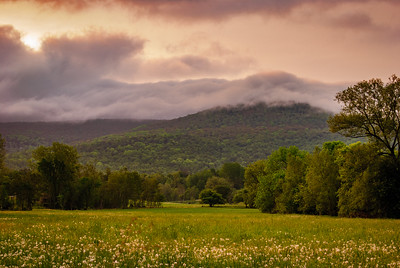
Adding Value and Conserving Community Forests: The Case of Certification in Vermont, USA
2002
Summary
At this stage, FSC certification serves as an intervening filter between local forest ecosystems and economic markets, enhances community social capital, and helps generate market premiums.
Key Personnel & Institutions
People: Mark Lorenzo
Institutions: International Association for the Study of Common Property (IASCP)
Location
VERMONT
Resource Type
Article
Tags
No tag keywords available
Topic Tags
conservation, management, ecosystem services
Purpose Tags
conservation, management
Citation
Lorenzo, M. "Adding Value and Conserving Community Forests: The Case of Certification in Vermont, USA" International Association for the Study of Common Property, June 2002. Accessed from (http://hdl.handle.net/10535/887)
Source Link
Loss of Undeveloped Woodland in Vermont
2003 to 2017
Summary
A new report by the Vermont Natural Resources Council (VNRC) highlights the increasing loss of undeveloped woodland tracts in Vermont through parcelization, the breaking up of land into smaller and smaller parcels. The phenomenon of parcelization, which usually occurs through subdivision, is gaining momentum, and subsequent development is causing forest cover to decline in Vermont.
Key Personnel & Institutions
People: Jamey Fidel
Institutions: Vermont Natural Resources Council
Location
VERMONT
Resource Type
Article
Tags
No tag keywords available
Topic Tags
conservation, landscape pattern and connectivity
Purpose Tags
conservation
Citation
Fidel, J. "Loss of Undeveloped Woodland in VT" Vermont Natural Resources Council, 1 January, 2018. Accessed from (https://www.vermontwoodlands.org/resources-post/loss-of-undeveloped-woodland-in-vt/)
Source Link
https://www.vermontwoodlands.org/resources-post/loss-of-undeveloped-woodland-in-vt/
Working Landscape: Agriculture and Forestry
2019
Summary
In order to maintain Vermont’s working landscape and the occupations it supports, Vermonters must recognize its contributions to the Region and be prepared to address the challenges to its sustainability.
Key Personnel & Institutions
Institutions: Two Rivers-Ottauquechee Regional Commission
Location
VERMONT
Resource Type
Article
Tags
agriculture, forestry
Topic Tags
conservation, management, ecosystem services
Purpose Tags
conservation, management
Citation
"Working Landscape: Agriculture and Forestry" Two Rivers-Ottauquechee Regional Plan, ch 5, p. 120, 2019 draft. Accessed from (https://www.trorc.org/wp-content/uploads/2019/06/5_Working_Landscape.pdf)
Source Link
https://www.trorc.org/wp-content/uploads/2019/06/5_Working_Landscape.pdf
Putting The Pieces Together: Vermont Partnership Approaches to Sustainable Forest Management in Parcelized Landscapes
2008
Summary
This study asks the question: How do partnerships involving environmental nonprofit organizations in Vermont attempt to achieve goals of sustainable forest management in the context of a parcelized landscape?
Key Personnel & Institutions
People: Michelle Joy Maumfleck
Institutions: University of Vermont
Location
VERMONT
Resource Type
Report
Tags
sustainability
Topic Tags
conservation, methods, management, landscape pattern and connectivity
Purpose Tags
conservation, management
Citation
Baumflek, M. J. "Putting The Pieces Together: Vermont Partnership Approaches to Sustainable Forest Management in Parcelized Landscapes" University of Vermont, February, 2008. Accessed from (https://citeseerx.ist.psu.edu/viewdoc/download?doi=10.1.1.874.475&rep=rep1&type=pdf)
Source Link
https://library.uvm.edu/collections/theses?search_type=item&bid=1617335
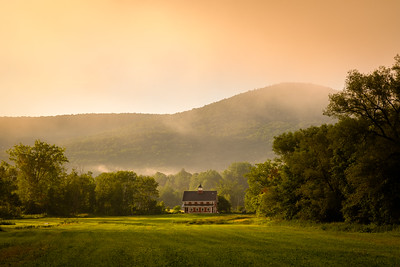
Forest Fragmentation Threatens Bird Diversity
2018
Summary
Scientists note that habitat fragmentation is the biggest threat to the health of mature forests. Ron Krupp explains how this negatively effects bird diversity.
Key Personnel & Institutions
People: Ron Krupp
Institutions: Vermont Public Radio
Location
VERMONT
Resource Type
Article
Tags
diversity, birds, threats
Topic Tags
conservation, wildlife and habitat, landscape pattern and connectivity
Purpose Tags
conservation
Citation
Krupp, R. "Forest Fragmentation Threatens Bird Diversity" Vermont Public Radio, 26 June, 2018. Accessed from (https://www.vpr.org/programs/2018-06-26/forest-fragmentation-threatens-bird-diversity)
Source Link
https://www.vpr.org/programs/2018-06-26/forest-fragmentation-threatens-bird-diversity

Commissioner Warns of Forest Fragmentation
2015
Summary
For the first time in a century, Vermont is losing forestland and the existing forests are being broken into smaller, fragmented parcels that threaten the state’s cherished relationship with those forests, Vermont’s top forestry official told lawmakers.
Key Personnel & Institutions
People: Wilson Ring
Institutions: Burlington Free Press
Location
VERMONT
Resource Type
Article
Tags
No tag keywords available
Topic Tags
conservation, methods, planning, landscape pattern and connectivity
Purpose Tags
conservation, policy
Citation
Ring, W. "Commissioner Warns of Forest Fragmentation" Associated Press, Burlington Free Press, 16 April, 2015. Accessed from (https://www.burlingtonfreepress.com/story/news/local/vermont/2015/04/16/commissioner-warns-forest-fragmentation/25897293/)
Source Link
Vermont’s Forests 2007
2007
Summary
The first full annual inventory of Vermont’s forests reports more than 4.5 million acres of forest land with an average volume of more than 2,200 cubic feet per acre. Additional information is presented on forest attributes, land use change, carbon, timber products, and forest health.
Key Personnel & Institutions
Institutions: United States Department of Agriculture (USDA), Forest Service
Location
VERMONT
Resource Type
Report
Tags
No tag keywords available
Topic Tags
conservation, management, ecosystem services, drivers, landscape pattern and connectivity
Purpose Tags
conservation, management
Citation
"Vermont’s Forests 2007" U.S. Forest Service, July, 2011. Accessed from (https://www.nrs.fs.fed.us/pubs/rb/rb_nrs51.pdf)
Source Link
Threats to Vermont’s Wildlife
2015
Summary
This article is an overview of suggested practices that can be implemented to minimize threats to Vermont’s Wildlife.
Key Personnel & Institutions
Institutions: Linking Lands Alliance
Location
VERMONT
Resource Type
Article
Tags
threats
Topic Tags
conservation, methods, management, planning, wildlife and habitat
Purpose Tags
conservation, management, education
Citation
"Threats to Vermont’s Wildlife" Linking Lands Alliance, 2015. Accessed from (https://www.linkinglandsalliance.org/wildlifethreats)
Source Link
Forest Bird Habitat Assessment
2016 to 2017
Summary
Information in this report is presented from the landscape level to the property level. This assessment was conducted in order to determine what birds are currently utilizing the habitats on the property, describe and assess current forest bird habitat conditions on the property and make recommendations for protecting and improving habitat for a suite of priority forest birds.
Key Personnel & Institutions
Institutions: Connecticut Agricultural Experiment Station , Ferrucci & Walicki, LLC , Audubon Connecticut
Location
Connecticut
Resource Type
Report
Tags
birds
Topic Tags
conservation, management, ecosystem services, wildlife and habitat
Purpose Tags
conservation, management, education
Citation
"Forest Bird Habitat Assessment" Audubon Connecticut, 28 February, 2017. Accessed from (https://www.cantonlandtrust.org/static/docs/sww-audubon-2017.pdf)
Source Link
https://www.cantonlandtrust.org/static/docs/sww-audubon-2017.pdf
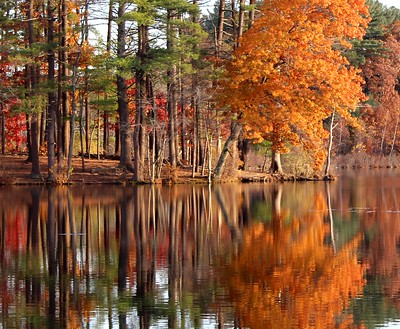
Managing Forests within a Watershed: The Importance of Stewardship
2001
Summary
Four years after its inception an outreach campaign promoting forest stewardship in south-central Connecticut was carefully evaluated.
Key Personnel & Institutions
People: Thomas E. Worthley , C. Benjamin Tyson
Institutions: Central Connecticut State University, Department of Communication , University of Connecticut, Cooperative Extension System, Stewardship Program
Location
Connecticut
Resource Type
Article
Tags
watershed, stewardship
Topic Tags
conservation, management, ecosystem services
Purpose Tags
conservation, management, education
Citation
Tyson, C.B., Worthley, T.E. "Managing Forests within a Watershed: The Importance of Stewardship", Journal of Forestry, Volume 99, Issue 8, August 2001, Pages 4–10, https://doi.org/10.1093/jof/99.8.4
Source Link
https://academic.oup.com/jof/article/99/8/4/4614392?login=true

Executive Summary: Forests of the Northern United States
2012
Summary
This executive summary provides an overview of the 200-page report, Forests of the Northern United States, which covers in detail current forest conditions, recent trends, issues, threats and opportunities in the forests in the 20 Northern States.
Key Personnel & Institutions
People: Sherri Wormstead , Stephen Shifley, Francisco Aguilar, David J. Nowak , Eric J. Greenfield , Susan Stewart , Nianfu Song , Dale D. Gormanson , W. Keith Moser
Institutions: United States Department of Agriculture (USDA), Forest Service, Northern Research Station , The State University of New York (SUNY), College of Environmental Science and Forestry (ESF) , University of Missouri
Location
VERMONT, Massachusetts, Maine, New York, New Hampshire, Connecticut, Rhode Island, New England
Resource Type
Article
Tags
summary
Topic Tags
conservation, methods, management, ecosystem services, drivers
Purpose Tags
conservation, management, education
Citation
Shifley, S.R., Aguilar, F.X., Song, N., Stewart, S.I., Nowak, D.J., Gormanson, D.D., Moser, W.K., Wormstead, S., Greenfield, E.J. "Executive Summary: Forests of the Northern United States". Gen. Tech. Rep. NRS-90 ES. Newtown Square, PA: U.S. Department of Agriculture, Forest Service, Northern Research Station. 40 p., 2012. Accessed from (https://www.fs.usda.gov/treesearch/pubs/40562)
Source Link

Conservation of Biological Diversity
2016
Summary
Across the Northern United States, growing human populations will place increased service demands on forests for the foreseeable future. The type, magnitude, and stability of future services from northern forests will depend in part on the level of biological diversity in those forests.
Key Personnel & Institutions
People: Rachel Riemann , Mark Nelson , W. Keith Moser , James D. Garner , Barry T (Ty) Wilson , Brent Dickenson , Brian G. Tavernia
Institutions: United States Department of Agriculture (USDA), Forest Service, Northern Research Station
Location
VERMONT, Massachusetts, Maine, New York, New Hampshire, Connecticut, Rhode Island, New England
Resource Type
Article
Tags
No tag keywords available
Topic Tags
conservation, methods, management, ecosystem services, wildlife and habitat
Purpose Tags
conservation, management
Citation
Tavernia, B.G., Nelson, M.D., Riemann, R., dickenson, B., Moser, W.K., Wilson, B.T. (Ty), Garner, J.D. "Conservation of Biological Diversity". In: Shifley, Stephen R.; Moser, W. Keith, eds. Future forests of the northern United States. Gen. Tech. Rep. NRS-151. Newtown Square, PA: U.S. Department of Agriculture, Forest Service, Northern Research Station: 43-76. Chapter 3, 2016. Accessed from (https://www.fs.usda.gov/treesearch/pubs/50452)
Source Link

Forest Landowner Characteristics on Fragmented Ownerships in the Catskill and Delaware Watersheds
2008
Summary
This study follows up the work of LaPierre and Germain (2005), which documented the decrease in average parcel size and increase in number of smaller parcels in the Catskill Counties portion of the Watershed. This work documents parcelization in Delaware County and compares owners of parcelized versus intact properties between 1984 and 2005. The study describes landowners’ property modifications, land use, and forest management practices and the impervious surface area coverage on their forested parcels.
Key Personnel & Institutions
People: Jennifer A. Caron
Institutions: The State University of New York (SUNY), College of Environmental Science and Forestry (ESF)
Location
New York, New York
Resource Type
Report
Tags
watersheds, ownership
Topic Tags
conservation, management, ecosystem services, landscape pattern and connectivity
Purpose Tags
conservation, management
Citation
Caron, J. "Forest Landowner Characteristics on Fragmented Ownerships in the Catskill and Delaware Watersheds" State University of New York College of Environmental Science and Forestry, ProQuest Dissertations Publishing, 2009. 1463658. Accessed from (https://www.proquest.com/openview/aaef4b2ea3b1fd4aa23582ecd46c7225/1?pq-origsite=gscholar&cbl=18750)
Source Link
https://www.proquest.com/openview/aaef4b2ea3b1fd4aa23582ecd46c7225/1?pq-origsite=gscholar&cbl=18750
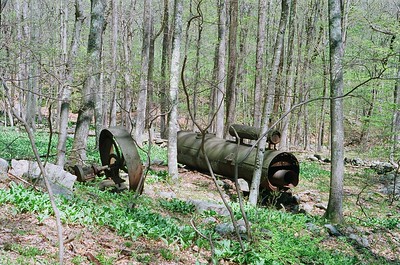
Challenges to Sawmill Businesses in New England and New York State: A Survey of Wood Procurement Managers
2010
Summary
This study investigated factors that may impact the ability of sawmill procurement organizations in the region to obtain wood raw material by surveying mill procurement managers in the region.
Key Personnel & Institutions
People: Louis J. Morin , Andrew F. Egan
Institutions: Paul Smith's College, Adirondack Watershed Institute, University of Maine, School of Forest Resources
Location
VERMONT, Massachusetts, Maine, New York, New Hampshire, Connecticut, Rhode Island, New England
Resource Type
Article
Tags
wood
Topic Tags
conservation, methods, management, ecosystem services
Purpose Tags
conservation, management
Citation
Egan, A.F., Morin, L.J. "Challenges to Sawmill Businesses in New England and New York State: A Survey of Wood Procurement Managers", Journal of Forestry, Volume 108, Issue 8, December 2010, Pages 408–412, https://doi.org/10.1093/jof/108.8.408
Source Link
https://academic.oup.com/jof/article/108/8/408/4598915?login=true
Forests of the Northern United States
2011
Summary
This report provides a broad overview of current conditions affecting forests in the 20-state region. It draws on information from numerous sources to provide (1) an understanding of the characteristics of northern forests relative to the rest of the United States, (2) a comparative framework for understanding differences among States and how they individually and collectively contribute to the region’s forest resources, and (3) a context for interpreting projections of future forest conditions in the region.
Key Personnel & Institutions
People: Sherri Wormstead , Stephen Shifley, Francisco Aguilar, David J. Nowak , Eric J. Greenfield , Susan Stewart , Nianfu Song , Dale D. Gormanson , W. Keith Moser
Institutions: United States Department of Agriculture (USDA), Forest Service, Northern Research Station , The State University of New York (SUNY), College of Environmental Science and Forestry (ESF) , University of Missouri
Location
VERMONT, Massachusetts, Maine, New York, New Hampshire, Connecticut, Rhode Island, New England
Resource Type
Report
Tags
No tag keywords available
Topic Tags
conservation, management, ecosystem services, drivers
Purpose Tags
conservation, management
Citation
Shifley, S.R., Aguilar, F.X., Song, N., Stewart, S.I., Nowak, D.J., Gormanson, D.D., Moser, W.K., Wormstead, S., Greenfield, E.J. ""Forests of the Northern United States"". USDA Forest Service, Northern Research Station, January 2012. Accessed from (https://www.fs.fed.us/nrs/pubs//gtr/gtr_nrs90.pdf)
Source Link

America’s Private Forests: Status and Stewardship
2001
Summary
This book is an overview of the issues facing America’s private forests, the status of the forests and tools for conserving these resources.
Key Personnel & Institutions
People: Constance Best , Laurie A. Wayburn
Institutions: Pacific Forest Trust
Location
VERMONT, Massachusetts, Maine, New York, New Hampshire, Connecticut, Rhode Island, New England
Resource Type
Book
Tags
private forests, stewardship
Topic Tags
conservation, methods, management, ecosystem services, drivers, landscape pattern and connectivity
Purpose Tags
conservation, management
Citation
Best, C., Wayburn, L.A. "America’s Private Forests: Status and Stewardship" The Pacific Forest Trust, 2001. Accessed from (https://books.google.com/books?hl=en&lr=&id=rsQIzUsbwgAC&oi=fnd&pg=PR2&dq=forest+parcelization+rhode+island&ots=9JzwF5-GOK&sig=m4vPsJJ4ZC7hDV-Nuf_R_Gy4jvQ#v=onepage&q&f=false)
Source Link

State and Private Forestry Fact Sheet: Rhode Island 2021
2019 to 2021
Summary
The State and Private Forestry programs promote the health, resilience, and productivity of trees and forests across all ownerships for the benefit of people and wildlife; establish and manage urban and community forests; empower private landowners with information and technical assistance to sustainably manage their forests; and protect critically important rural forests and watersheds.
Key Personnel & Institutions
Institutions: Rhode Island Department of Environmental Management, United States Department of Agriculture (USDA), Forest Service, Eastern Region State and Private Forestry
Location
Rhode Island
Resource Type
Report
Tags
private forests, state-owned forests
Topic Tags
conservation, management, ecosystem services, drivers, landscape pattern and connectivity
Purpose Tags
conservation, management
Citation
"State and Private Forestry Fact Sheet: Rhode Island 2021" Rhode Island Department of Environmental Management, US Forest Service Eastern Region, 12 September 2021. Accessed from (https://apps.fs.usda.gov/nicportal/temppdf/sfs/naweb/ri_std.pdf)
Source Link
https://apps.fs.usda.gov/nicportal/temppdf/sfs/naweb/ri_std.pdf
Rhode Island Needs to Act on Forest Conservation
2021
Summary
Fragmentation, caused by relentless sprawl, is the biggest threat to the health of the state’s forests. This article highlights some actions the state is taking to combat this issue.
Key Personnel & Institutions
People: Frank Carini
Institutions: Eco RI News
Location
Rhode Island
Resource Type
Article
Tags
No tag keywords available
Topic Tags
conservation, management, ecosystem services, drivers, landscape pattern and connectivity
Purpose Tags
conservation, management
Citation
Carini, F. "Rhode Island Needs to Act on Forest Conservation" ecoRI News, 26 March, 2021. Accessed from (https://www.ecori.org/natural-resources/2021/3/25/rhode-island-needs-to-action-on-forest-conservation)
Source Link
Scituate Reservoir Watershed Property: Forest Stewardship Plan
2010 to 2020
Summary
The forestry program manages the Scituate Reservoir Watershed Property by promoting long-term ecosystem health to protect a high quality water supply and other natural resources.
Key Personnel & Institutions
People: Christopher Riely , Robert Macmillan , Richard Blodgett
Institutions: Providence Water Supply Board, Water Resources Division
Location
Rhode Island
Resource Type
Report
Tags
watershed, stewardship, reservoirs
Topic Tags
conservation, methods, management, ecosystem services
Purpose Tags
conservation, management
Citation
Macmillan, R., Riely, C., Blodgett, R. "Scituate Reservoir Watershed Property: Forest Stewardship Plan"
Source Link
https://www.potomacdwspp.org/wp-content/uploads/2015/03/2011-20_PWSBForestStewardshipPlan_RI.pdf
A Policy Agenda for Conserving New England’s Forests: Priorities for 2012
2010 to 2012
Summary
This Policy Agenda provides a broad-based appeal to the New England congressional delegation for continued bipartisan support and federal investment and partnership to help the region realize the benefits unique to New England’s forest-based economy.
Key Personnel & Institutions
Institutions: Wildlands and Woodlands, Northern Forest Canoe Trail
Location
VERMONT, Massachusetts, Maine, New York, New Hampshire, Connecticut, Rhode Island, New England
Resource Type
Report
Tags
No tag keywords available
Topic Tags
methods, management, ecosystem services, planning
Purpose Tags
conservation, management, policy
Citation
"A Policy Agenda for Conserving New England’s Forests: Priorities for 2012" Northern Forest Canoe Trail, New England’s Forests Partners, 2012, Accessed from (http://www.wildlandsandwoodlands.org/sites/default/files/Policy Agenda for Conserving New England's Forests FY12 Priorities.pdf)
Source Link
Forest Legacy Program Assessment of Need
2019
Summary
The 2019 Forest Legacy Assessment of Need for Massachusetts provides a comprehensive, long range process to identify and protect privately-owned woodlands that are under threat of parcelization, fragmentation, and conversion to non-forest uses.
Key Personnel & Institutions
People: Peter Church
Institutions: Massachusetts Department of Conservation and Recreation, Bureau of Forest Fire Control and Forestry
Location
Massachusetts
Resource Type
Report
Tags
No tag keywords available
Topic Tags
conservation, management, ecosystem services, landscape pattern and connectivity
Purpose Tags
conservation, management
Citation
Church, P. "Forest Legacy Program Assessment of Need" Bureau of Forestry, Department of Conservation and Recreation, January 2020. Accessed from (https://www.mass.gov/doc/approval-of-massachusetts-assessment-of-need-under-the-forest-legacy-program/download)
Source Link
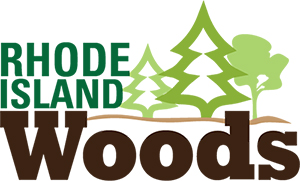
Learning From the Past: Rhode Island Forest History
1599 to 2013
Summary
This article is a brief history of the forests of Rhode Island, starting in the 1600s. The purpose of this article is to highlight historical mistakes in an attempt to avoid those same mistakes in the future.
Key Personnel & Institutions
People: Christopher Riely
Institutions: University of Rhode Island
Location
Rhode Island
Resource Type
Article
Tags
history
Topic Tags
methods, management, ecosystem services, drivers, landscape pattern and connectivity
Purpose Tags
conservation, management, education
Citation
Burdett, H. K., Modisette, C., McCann, Neptin, B. "Learning From the Past: Rhode Island Forest History", Southern New England Forest Consortium, Inc., University of Rhode Island Cooperative Extension, 2013. Accessed from (https://rhodeislandwoods.uri.edu/files/HISTORY-dragged.pdf)
Source Link
https://web.uri.edu/rhodeislandwoods/about-ri-woods/history/
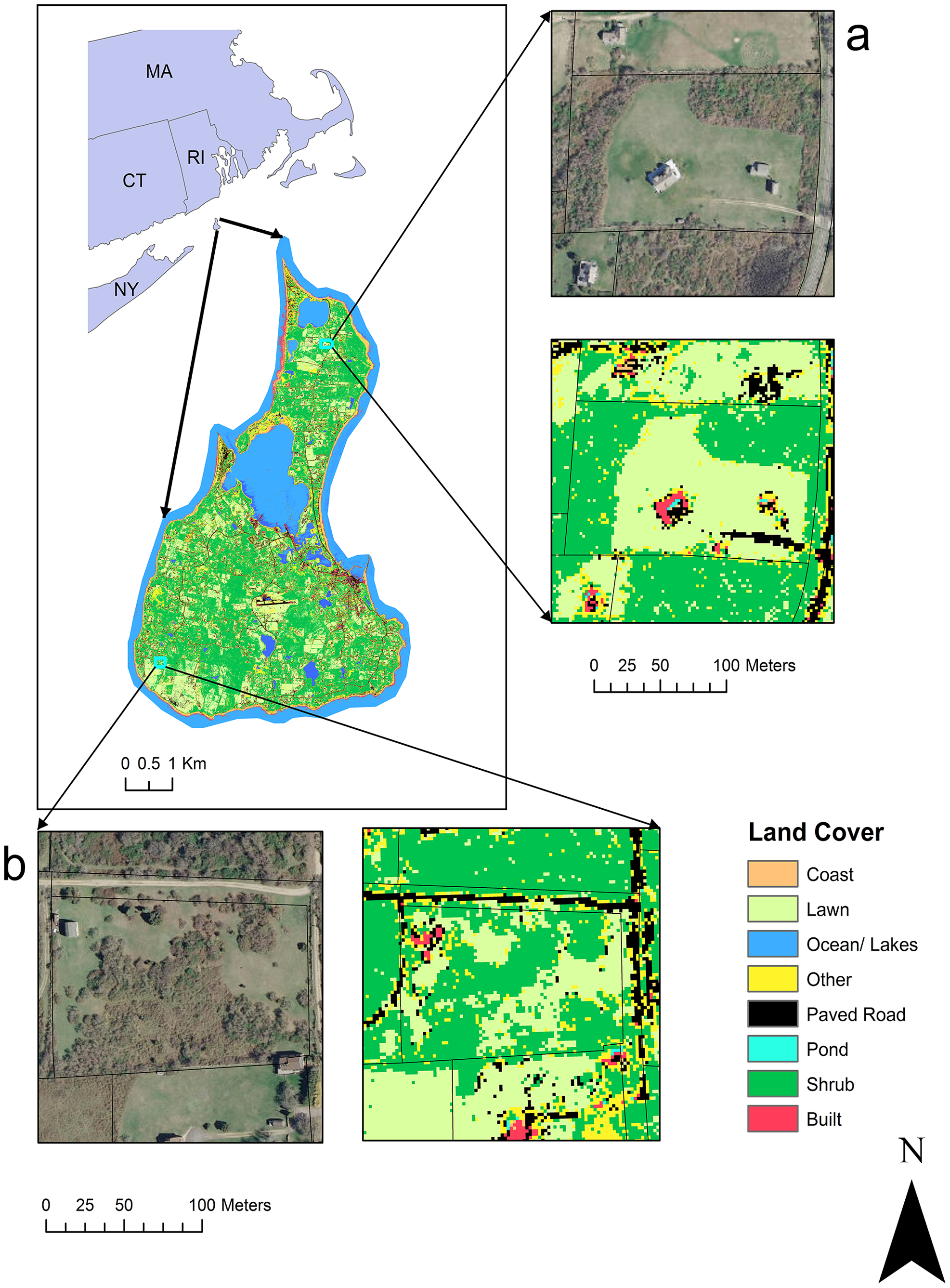
Integrated Assessment of Behavioral and Environmental Risk Factors for Lyme Disease Infection on Block Island, Rhode Island
2014
Summary
This study simultaneously assessed the influence of peridomestic tick exposure risk and human behavior risk factors for Lyme disease infection on Block Island, Rhode Island.
Key Personnel & Institutions
People: Maria Diuk-Wasser, Casey Finch , Mohammed Salim Al-Damluji , Linda Niccolai , Tanner Steeves , Corrine Folsom O'Keefe , Peter J. Krause
Institutions: Yale School of Medicine, Department of Epidemiology and Public Health
Location
Rhode Island
Resource Type
Article
Tags
lyme disease, risk assesment, ticks
Topic Tags
management, drivers, wildlife and habitat, landscape pattern and connectivity
Purpose Tags
management
Citation
Finch C., Al-Damluji M.S., Krause P.J., Niccolai L., Steeves T., O’Keefe C.F., et al. "Integrated Assessment of Behavioral and Environmental Risk Factors for Lyme Disease Infection on Block Island, Rhode Island". PLoS ONE 9(1): e84758, 2014. https://doi.org/10.1371/journal.pone.0084758
Source Link
https://journals.plos.org/plosone/article?id=10.1371/journal.pone.0084758
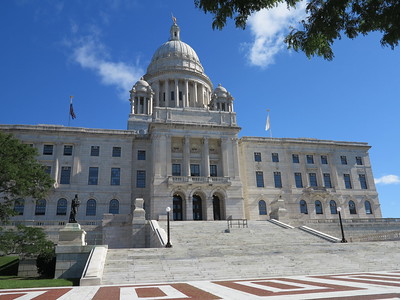
An Assessment of Impervious Surface Areas in Rhode Island
2007
Summary
In this study, information of ISA for the state of Rhode Island using 1-m spatial resolution true-color digital orthophotography data was extracted. An object-oriented algorithm of multiple-agent segmentation and classification (MASC) that we developed for ISA information extraction was employed.
Key Personnel & Institutions
People: Y. Wang, Yuyu Zhou
Institutions: University of Rhode Island, Department of Natural Resources Science
Location
Rhode Island
Resource Type
Report
Tags
No tag keywords available
Topic Tags
conservation, drivers, landscape pattern and connectivity
Purpose Tags
conservation
Citation
Zhou, Y., Wang, Y.Q. "An Assessment of Impervious Surface Areas in Rhode Island" Northeastern Naturalist, 14(4):643-650 (2007). https://doi.org/10.1656/1092-6194(2007)14[643:AAOISA]2.0.CO;2
Source Link

Predictors of Species Sensitivity to Fragmentation
2001
Summary
This study reviewed empirical data and hypotheses derived from demographic, optimal foraging, life-history, community, and biogeographic theory for predicting the sensitivity of species to habitat fragmentation.
Key Personnel & Institutions
People: Klaus Henle , Kendi F. Davies , Michael Kleyer , Chris Margules , Josef Settele
Institutions: University of California Berkeley, Department of Environmental Science, Policy, and Management , Floreat - CSIRO , CSIRO Land and Water Flagship , Carl von Ossietzky University Oldenburg , Helmholtz Centre for Environmental Research
Location
VERMONT, Massachusetts, Maine, New York, New Hampshire, Connecticut, Rhode Island, New England
Resource Type
Report
Tags
No tag keywords available
Topic Tags
conservation, wildlife and habitat, landscape pattern and connectivity
Purpose Tags
conservation
Citation
Henle, K., Davies, K.F., Kleyer, M. et al. "Predictors of Species Sensitivity to Fragmentation". Biodiversity and Conservation 13, 207–251 (2004). https://doi.org/10.1023/B:BIOC.0000004319.91643.9e
Source Link
https://link.springer.com/article/10.1023/B:BIOC.0000004319.91643.9e#citeas

The Increasing Influence of Urban Environments on US Forest Management
2005
Summary
Forests near urban communities face a special set of challenges that will only intensify as these communities grow in area, population, and complexity. This article investigates changes in the extent and growth patterns of urban areas across the United States during the past 10 years and discusses the implications of this expansion for management of both urban and exurban forests.
Key Personnel & Institutions
People: David J. Nowak , Jeffrey T. Walton , Soojeong Myeong , Latif G. Kaya , John F. Dwyer
Institutions: The State University of New York (SUNY), College of Environmental Science and Forestry (ESF) , United States Department of Agriculture (USDA), Forest Service, Northeastern Research Station , United States Department of Agriculture (USDA), Forest Service, North Central Research Station
Location
VERMONT, Massachusetts, Maine, New York, New Hampshire, Connecticut, Rhode Island, New England
Resource Type
Article
Tags
urban
Topic Tags
conservation, planning, drivers, landscape pattern and connectivity
Purpose Tags
conservation
Citation
Nowak, D.J., Walton, J.T., Dwyer, J.F., Kaya, L.G., Myeong, S. "The Increasing Influence of Urban Environments on US Forest Management" Journal of Forestry, Volume 103, Issue 8, December 2005, Pages 377–382, https://doi.org/10.1093/jof/103.8.377
Source Link

Does Habitat Fragmentation Affect Landscape-Level Temperatures? A Global Analysis
2020
Summary
This study quantifies the impacts of habitat fragmentation on landscape-level temperature across the globe.
Key Personnel & Institutions
People: Clarice B Mendes , Jayme A. Prevedello
Institutions: Rio De Janeiro State University, Department of Ecology, Landscape Ecology Lab
Location
VERMONT, Massachusetts, Maine, New York, New Hampshire, Connecticut, Rhode Island, New England
Resource Type
Article
Tags
temperature, global
Topic Tags
conservation, ecosystem services, landscape pattern and connectivity
Purpose Tags
conservation
Citation
Mendes, C.B., Prevedello, J.A. "Does habitat fragmentation affect landscape-level temperatures? A global analysis". Landscape Ecol 35, 1743–1756 (2020). https://doi.org/10.1007/s10980-020-01041-5
Source Link
https://link.springer.com/article/10.1007/s10980-020-01041-5
Drivers and Causes of Zoonotic Diseases: An Overview
2021
Summary
This study focuses on the direct drivers with the greatest potential influence on zoonotic disease emergence and which thereby increase the risk of epidemics and pandemics – land-use change, especially resulting from intensified agriculture and livestock production, the trade in wildlife, and wild meat consumption.
Key Personnel & Institutions
People: Mariana Napolitano Ferreira , Wendy Elliott , Rachel Goldon Kroner , Margaret F. Kinnaird , Paula R. Prist , Paula Valdujo , Mariana M. Vale
Institutions: World Wildlife Fund, Conservation International , Universidade de Sao Paulo, Instituto de Biociencias , Universidade Federal Do Rio de Janeiro
Location
VERMONT, Massachusetts, Maine, New York, New Hampshire, Connecticut, Rhode Island, New England
Resource Type
Article
Tags
No tag keywords available
Topic Tags
management, drivers, wildlife and habitat, landscape pattern and connectivity
Purpose Tags
management, education
Citation
Ferreira, M.N., elliott, W., Kroner, R.G., kinnaird, M.F., Prist, P.R., Valdujo, P., Vale, M.M. "Drivers and Causes of Zoonotic Diseases: An Overview" Parks, Vol 21 (Special Issue, March 2021. Accessed from: https://www.researchgate.net/profile/Rachel-Golden-Kroner/publication/349990389_Drivers_and_causes_of_zoonotic_diseases_An_overview/links/607c5569907dcf667bab3d85/Drivers-and-causes-of-zoonotic-diseases-An-overview.pdf
Source Link

Relationships Between Major Ownerships, Forest Aboveground Biomass Distributions, and Landscape Dynamics in the New England Region of USA
2010
Summary
This study utilizes remote sensing derived forest aboveground biomass (AGB) estimates and ownership information obtained from the Protected Areas Database (PAD), combining landscape analyses and GIS techniques to demonstrate how different ownerships (public, regulated private, and other private) relate to the spatial distribution of AGB in New England states of the USA.
Key Personnel & Institutions
People: Brett Butler , Mark Ducey, Daolan Zheng , Linda S. Heath
Institutions: University of New Hampshire, Department of Natural Resources and the Environment, United States Department of Agriculture (USDA), Forest Service, Northern Research Station , Family Forest Research Center
Location
VERMONT, Massachusetts, Maine, New York, New Hampshire, Connecticut, Rhode Island, New England
Resource Type
Report
Tags
aboveground biomass, distribution, ownership
Topic Tags
conservation, management, ecosystem services, drivers, landscape pattern and connectivity
Purpose Tags
conservation
Citation
Zheng, D., Heath, L.S., Ducey, M.J. et al. "Relationships Between Major Ownerships, Forest Aboveground Biomass Distributions, and Landscape Dynamics in the New England Region of USA". Environmental Management 45, 377–386 (2010). https://doi.org/10.1007/s00267-009-9408-3
Source Link
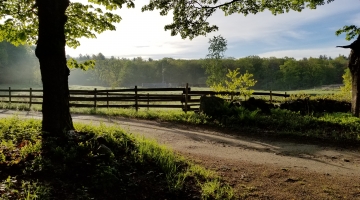
Meeting the Conservation Challenge in New England
2010
Summary
This article is an overview of the history of New England’s forests and the challenges faced, actions taken and current issues among these forests.
Key Personnel & Institutions
People: David Foster
Institutions: Harvard University, Harvard Forest
Location
VERMONT, Massachusetts, Maine, New York, New Hampshire, Connecticut, Rhode Island, New England
Resource Type
Article
Tags
No tag keywords available
Topic Tags
conservation, management, ecosystem services, drivers, landscape pattern and connectivity
Purpose Tags
conservation, management
Citation
Foster, D. "Meeting the Conservation Challenge in New England" Harvard Forest, 2010. Accessed from: https://harvardforest1.fas.harvard.edu/sites/harvardforest.fas.harvard.edu/files/publications/pdfs/Foster_chpt2ConservationCapital_2010.pdf
Source Link
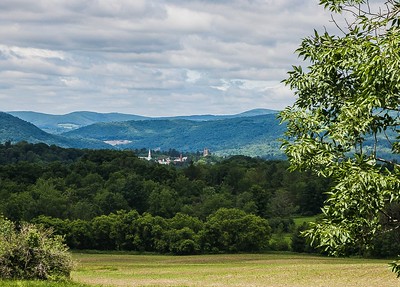
Of Vert and Vision Ensuring the Legacy of the Northern Forest of New England and New York
1992
Summary
Of Vert and Vision represents the collective contributions of more than thirty individuals. Not all will agree with its conclusions, but few will disagree with its primary thrust - that the future of the northern forest lands of New England and New York needs to be a matter of vital concern to its public and its leadership.
Key Personnel & Institutions
People: Charles H. W. Foster
Institutions: Harvard University
Location
VERMONT, Massachusetts, Maine, New York, New Hampshire, Connecticut, Rhode Island, New England
Resource Type
Article
Tags
No tag keywords available
Topic Tags
conservation, methods, management, ecosystem services
Purpose Tags
conservation, management
Citation
Foster, C.H.W., "Of Vert and Vision: Ensuring the Legacy of the Northern Forest of New England and New York". CSIA Discussion Paper 92-13, Kennedy School of Government, Harvard University, December 1992. Accessed from: https://www.belfercenter.org/sites/default/files/legacy/files/disc_paper_92_13.pdf
Source Link
https://www.belfercenter.org/sites/default/files/legacy/files/disc_paper_92_13.pdf
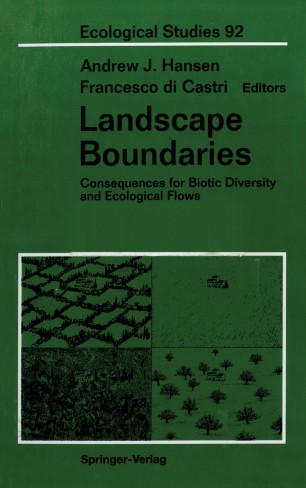
Landscape Boundaries: Consiquences for Biotic Diversity and Ecological Flows
Summary
This book is concerned with the fundamental pieces that compose a landscape, how they are bounded, how landscape boundaries influence interaction among patches. The purpose of these questions is to attempt to understand the workings of landscapes.
Key Personnel & Institutions
People: Francesco di Castri , Andrew J. Hansen
Institutions: Oregon State University , United Nations Educational, Scientific and Cultural Organization (UNESCO)
Location
VERMONT, Massachusetts, Maine, New York, New Hampshire, Connecticut, Rhode Island, New England
Resource Type
Book
Tags
boundaries, diversity, biotic diversity
Topic Tags
conservation, ecosystem services, wildlife and habitat, landscape pattern and connectivity
Purpose Tags
conservation
Citation
Hansen, A.J., Di Castri, F. "Landscape Boundaries" Springer, New York, NY, 1992, https://doi.org/10.1007/978-1-4612-2804-2
Source Link
https://link.springer.com/book/10.1007/978-1-4612-2804-2#about
Trends in Rhode Island Forests: A Half-Century of Change
Summary
Some of the significant trends that have occurred in Rhode Island’s forests over the last half century are highlighted in this report. The data are summarized from reports published by the USDA Forest Service, which periodically inventories the forest resources of the 50 states. In 1998, the USDA Forest Service, in cooperation with the Rhode Island Department of Environmental Management, Division of Forest Environment completed the fourth statewide inventory of Rhode Island’s forests.
Key Personnel & Institutions
Institutions: United States Department of Agriculture (USDA), Forest Service, Northeastern Research Station , Rhode Island Department of Environmental Management
Location
Rhode Island
Resource Type
Article
Tags
change, trends
Topic Tags
conservation, ecosystem services, drivers
Purpose Tags
conservation
Citation
"Trends in Rhode Island Forests: A Half-Century of Change" US Department of Agricluture, Forest Service, 1998. Accessed from (https://www.fs.fed.us/ne/newtown_square/publications/brochures/pdfs/state_forests/ri_forest.pdf)
Source Link
Natural Resources Inventory
2018
Summary
The purpose of the Natural Resource and Conservation element is to provide guidance and support through various goals, policies, and actions for conservation efforts that protect and manage the town’s natural resources.
Key Personnel & Institutions
Institutions: North Smithfield Land Trust
Location
Rhode Island
Resource Type
Article
Tags
inventory, natural resources
Topic Tags
conservation, management, ecosystem services, wildlife and habitat
Purpose Tags
conservation, management
Citation
"Natural Resources Inventory" North Smithfield Land Trust, 12 December, 2018. Accessed from (https://www.nsmithfieldri.org/sites/g/files/vyhlif3596/f/uploads/natural_resources_12-12-18.pdf)
Source Link
https://www.nsmithfieldri.org/sites/g/files/vyhlif3596/f/uploads/natural_resources_12-12-18.pdf
Land Protection: Behind the Scenes
2017
Summary
Land protection is at the core of the Tiverton land trust mission.
Key Personnel & Institutions
Institutions: Tiverton Land Trust
Location
Rhode Island
Resource Type
Article
Tags
protection
Topic Tags
conservation, management, ecosystem services, planning, landscape pattern and connectivity
Purpose Tags
conservation, management
Citation
""Land Protection: Behind the Scenes"" Tiverton Land Trust, 2017. Accessed from (https://www.tivertonlandtrust.org/images/pdfs/2017-Summer.pdf)
Source Link
https://www.tivertonlandtrust.org/images/pdfs/2017-Summer.pdf

Correlations and Variance Among Species Traits Explain Contrasting Impacts of Fragmentation and Habitat Loss on Functional Diversity
2020
Summary
The objectives of this study are to develop testable predictions about how landscape fragmentation, relative to the effects of habitat loss, impacts functional diversity and its relationship with species richness.
Key Personnel & Institutions
People: Andres Felipe Suarez-Castro , Margaret M. Mayfield , Matthew G. E. Mitchell , Lorenzo Cattarino , Martine Maron , Jonathan R. Rhodes
Institutions: The University of Queensland, School of Earth and Environmental Sciences , Imperial College London , The University of Queensland , The University of Queensland, Centre of Biodiversity and Conservation Science , The University of Queensland, School of Biological Sciences , Imperial College London, Department of Infectious Disease Epidemiology, MRC Centre for Outbreak Analysis and Modelling
Location
VERMONT, Massachusetts, Maine, New York, New Hampshire, Connecticut, Rhode Island, New England
Resource Type
Article
Tags
diversity, impacts, global
Topic Tags
conservation, management, wildlife and habitat, landscape pattern and connectivity
Purpose Tags
conservation, management
Citation
Suárez-Castro, A.F., Mayfield, M.M., Mitchell, M.G.E. et al. "Correlations and Variance Among Species Traits Explain Contrasting Impacts of Fragmentation and Habitat Loss on Functional Diversity". Landscape Ecol 35, 2239–2253 (2020). https://doi.org/10.1007/s10980-020-01098-2
Source Link
https://link.springer.com/article/10.1007/s10980-020-01098-2
Predicting the stability of multitrophic communities in a variable world
2011 to 2020
Summary
This study examined community compositional changes over time in an array of six coastal salt ponds on the south shore of Rhode Island.
Key Personnel & Institutions
People: Mallarie E. Yeager , Tarik C. Gouhier , A. Randall Hughes
Institutions: Northeastern University, Northeastern University, Marine and Environmental Science, Marine Science Center
Location
Rhode Island
Resource Type
Report
Tags
communities, protection, stability
Topic Tags
conservation, drivers, wildlife and habitat
Purpose Tags
conservation
Citation
Yeager, M.E., Gouhier, T.C., and Hughes, A.R.. "Predicting the stability of multitrophic communities in a variable world". Ecology 101(4):e02992, 2020. https://doi.org/10.1002/ecy.2992
Source Link
https://esajournals.onlinelibrary.wiley.com/doi/full/10.1002/ecy.2992
Degradation of Visible Autumn Icons and Conservation Opportunities: Trends in Deciduous Forest Loss in the Contiguous US
1984 to 2021
Summary
This study used spatial overlay analyses to quantify recent (1984-2016) and predicted (2016-2050) forest disturbance in each U.S. ecoregion and the extent to which each ecoregion falls into protected areas.
Key Personnel & Institutions
People: Lindsay Dreiss, Jacob Malcom
Institutions: Center for Conservation Innovation, Defenders of Wildlife
Location
VERMONT, Massachusetts, Maine, New York, New Hampshire, Connecticut, Rhode Island, New England
Resource Type
Report
Tags
diseases, global
Topic Tags
conservation, drivers, landscape pattern and connectivity
Purpose Tags
conservation
Citation
Dreiss, L., Malcom. J. "Degradation of Visible Autumn Icons and Conservation Opportunities: Trends in Deciduous Forest Loss in the Contiguous US" 29 March, 2021. https://doi.org/10.1101/2021.03.29.437570
Source Link
https://www.biorxiv.org/content/10.1101/2021.03.29.437570v1.abstract

Current Status and Threats
2021
Summary
This article has details of the makeup of Rhode Island’s forests and the current threats it is facing.
Key Personnel & Institutions
Institutions: University of Rhode Island
Location
Rhode Island
Resource Type
Article
Tags
threats
Topic Tags
management, planning, drivers, wildlife and habitat, landscape pattern and connectivity
Purpose Tags
conservation, management
Citation
"Current Status and Threats" Rhode Island Woods, 2021. Accessed from (https://rhodeislandwoods.uri.edu/ri-woods/current-status-and-threats/)
Source Link
https://rhodeislandwoods.uri.edu/ri-woods/current-status-and-threats/
Plant Invasions in Rhode Island Riparian Zones
2005
Summary
This research focuses on the relationship of residential land use with stream quality, riparian vegetation, and presence of breeding birds. In this study, a part of that larger effort, the goals were to determine how forest fragmentation, structure of riparian vegetation, and the presence of invasive plant species may be important factors for breeding bird habitat in Rhode Island subwatersheds.
Key Personnel & Institutions
People: Suzanne M. Lussier , Sara N. Dasilva
Institutions: Rhode Island Natural History Survey
Location
Rhode Island
Resource Type
Article
Tags
riparian, invasive plants
Topic Tags
conservation, methods, management, drivers, landscape pattern and connectivity
Purpose Tags
conservation, management
Citation
Lussier, S.M., DaSilva, S.N. "Plant Invasions in Rhode Island Riparian Zones" Rhode Island Naturalist, v. 12, no. 2, November 2005. Accessed from (https://rinhs.org/wp-content/uploads/2014/02/ri_naturalist_fall_2005.pdf)
Source Link
https://cfpub.epa.gov/si/si_public_record_Report.cfm?Lab=NHEERL&dirEntryId=139003
State of Nature: A Call for Conservation Action
2018
Summary
The Nature Conservancy undertook a three-year study to objectively gauge the condition and status of the natural world across 13 northeast and mid-Atlantic states.
Key Personnel & Institutions
Institutions: The Nature Conservancy
Location
VERMONT, Massachusetts, Maine, New York, New Hampshire, Connecticut, Rhode Island, New England
Resource Type
Article
Tags
No tag keywords available
Topic Tags
conservation, drivers, wildlife and habitat, landscape pattern and connectivity
Purpose Tags
conservation
Citation
"State of Nature: A Call for Conservation Action" The Nature Conservancy, 2018. Accessed from (https://www.conservationgateway.org/ConservationByGeography/NorthAmerica/UnitedStates/edc/reportsdata/stateofnature/Pages/default.aspx)
Source Link
Rhode Island’s Wildlife Habitats
2014
Summary
This article is an overview of chapter 2 of the 2015 RI Wildlife Action Plan. This chapter of the plan focuses on wildlife habitat.
Key Personnel & Institutions
Institutions: The Providential Gardner
Location
Rhode Island
Resource Type
Article
Tags
No tag keywords available
Topic Tags
conservation, wildlife and habitat
Purpose Tags
conservation
Citation
"Rhode Island’s Wildlife Habitats" The Providential Gardener, 20 November, 2014. Accessed from (https://providentialgardener.typepad.com/providential_gardener/2014/11/rhode-islands-wildlife-habitats.html)
Source Link

R.I. Forests are Losing Ground
2007
Summary
This article is a history of developments and the progression of fragmentation throughout Rhode Island and other New England areas.
Key Personnel & Institutions
People: Paul Davis
Institutions: Providence Journal
Location
VERMONT, Massachusetts, Maine, New York, New Hampshire, Connecticut, Rhode Island, New England
Resource Type
Article
Tags
No tag keywords available
Topic Tags
conservation, drivers, landscape pattern and connectivity
Purpose Tags
conservation
Citation
Davis, P.D. "R.I. Forests are Losing Ground" The Providence Sunday Journal, 19 August, 2007. Accessed from (https://www.fosterpreservationsociety.org/RI_Forests.htm)
Source Link
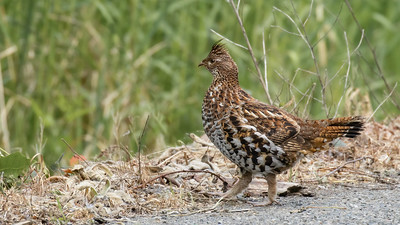
Habitat Selection and Home Range Size of Ruffed Grouse in Rhode Island
2005
Summary
Grouse are a species that require early successional forests. The populations of Grouse in New England have declined as the forests have matured. This study focuses on habitat selection and home range size of ruffed grouse in oak-hickory forests in Rhode Island.
Key Personnel & Institutions
People: Brian Tefft, Erik G. Endrulat , Scott R. McWilliams
Institutions: University of Rhode Island, Department of Natural Resources Science, Rhode Island Division of Fish & Wildlife, Rhode Island Natural History Survey
Location
Rhode Island
Resource Type
Article
Tags
habitat selection, home range, ruffed grouse
Topic Tags
conservation, drivers, wildlife and habitat, landscape pattern and connectivity
Purpose Tags
conservation
Citation
Endrulat, E.G., McWilliams, S.R., Tefft, B.C. "Habitat Selection and Home Range Size of Ruffed Grouse in Rhode Island" Northeastern Naturalist, vol. 12, no. 4, Eagle Hill Institute, 2005, pp. 411–24, http://www.jstor.org/stable/3858330.
Source Link
Alternative Forest Uses
2003
Summary
This fact sheet is a guide for forest owners that suggests sustainable management practices for smaller parcels and alternatives to tradition wood production.
Key Personnel & Institutions
Institutions: Rhode Island Division of Forest Environment
Location
Rhode Island
Resource Type
Article
Tags
No tag keywords available
Topic Tags
conservation, methods, management, ecosystem services
Purpose Tags
conservation, management
Citation
"Alternative Forest Uses" Rhode Island Forest Conservator’s Organization, 2003. Accessed from (https://www.rifco.org/CMPG.pdf)
Source Link
Rhode Island Chapter - Society of Americal Foresters
2009
Summary
The Society of American Foresters (SAF) is a national scientific and educational association representing the forestry profession in the United States. The RI Chapter ,formed in 1989, is part of the multi-state of the New England Society of American Foresters.
Key Personnel & Institutions
Institutions: Society of American Foresters
Location
Rhode Island
Resource Type
Article
Tags
No tag keywords available
Topic Tags
conservation, methods, management, ecosystem services, landscape pattern and connectivity
Purpose Tags
conservation, management
Citation
"Rhode Island Chapter - Society of Americal Foresters" Society of American Foresters, 2009. Accessed from (http://www.nesaf.org/userfiles/RI_chapter/2009 Chapter Info.pdf)
Source Link
http://www.nesaf.org/userfiles/RI_chapter/2009 Chapter Info.pdf

Rhode Island National Wildlife Refuge Complex
2018
Summary
The purpose of this paper is to explain the planned process and strategies of the Fish and Wildlife Service to reintroduce New England Cottontails to the Ninigret National Wildlife Refuge.
Key Personnel & Institutions
People: Nick Ernst , Charlie Vandemoer
Institutions: United States Fish and Wildlife Service
Location
Rhode Island
Resource Type
Article
Tags
No tag keywords available
Topic Tags
conservation, methods, management, ecosystem services, planning, drivers, wildlife and habitat
Purpose Tags
conservation, management
Citation
Ernst, N., Vandemoer, C. "Rhode Island National Wildlife Refuge Complex" US Fish and Wildlife Service, 27 February, 2018. Accessed from (https://www.fws.gov/uploadedFiles/Region_5/NWRS/North_Zone/Rhode_Island_Complex/Ninigret/NEC.NewsRelease.withProjectDescription.pdf)
Source Link
R.I.’s Green Canopy Provides Priceless Protection
2021
Summary
This article highlights the importance of Rhode Island’s forests and the threats facing them.
Key Personnel & Institutions
People: Grace Kelly
Institutions: Eco RI News
Location
Rhode Island
Resource Type
Article
Tags
protection, canopy
Topic Tags
conservation, ecosystem services, wildlife and habitat, landscape pattern and connectivity
Purpose Tags
conservation, management, education
Citation
Kelly, G. "R.I.’s Green Canopy Provides Priceless Protection" ecoRI News, 11 February, 2021. Accessed from (https://www.ecori.org/natural-resources/2021/2/9/rhode-islands-green-canopy-provides-priceless-protection)
Source Link
Time for the General Assembly to Finally Act on Forest Conservation
2021
Summary
This article highlights the importance of conserving Rhode Island’s forests and the factors threatening them.
Key Personnel & Institutions
People: Scott Millar
Institutions: Eco RI News
Location
Rhode Island
Resource Type
Article
Tags
No tag keywords available
Topic Tags
conservation, management, ecosystem services
Purpose Tags
conservation, management, education
Citation
Millar, S. "Time for the General Assembly to Finally Act on Forest Conservation" ecoRI News, 21 April, 2021. Accessed from (https://www.ecori.org/green-opinions/2021/4/21/time-for-rhode-island-to-finally-act-on-forest-conservation)
Source Link
Rhode Island Forest Fragmentation Analysis
2021
Summary
The objectives for completing this project were to create a 6-class forest fragmentation analysis, expand the study area to include the entire state of Rhode Island and utilize NOAAs high-resolution land cover data to create a more accurate and comprehensive analysis.
Key Personnel & Institutions
People: Emma Tondre
Institutions: University of Rhode Island
Location
Rhode Island
Resource Type
Report
Tags
analysis
Topic Tags
conservation, management, landscape pattern and connectivity
Purpose Tags
conservation, management, education
Citation
Tondre, E. "Rhode Island Forest Fragmentation Analysis" ArcGIS, May 10, 2021, Accessed from (https://storymaps.arcgis.com/stories/94de331e0f414ecd83e0ca0cbf3f7bcf)
Source Link
https://storymaps.arcgis.com/stories/94de331e0f414ecd83e0ca0cbf3f7bcf
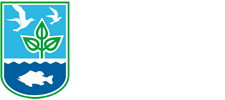
Rhode Island Wildlife Action Plan
2015
Summary
The 2015 RI WAP is a comprehensive plan that provides direction to and coordination of wildlife conservation efforts over the coming decade.
Key Personnel & Institutions
Institutions: Rhode Island Department of Environmental Management
Location
Rhode Island
Resource Type
Report
Tags
No tag keywords available
Topic Tags
conservation, methods, management, wildlife and habitat
Purpose Tags
conservation, management
Citation
"Rhode Island Wildlife Action Plan" Rhode Island Department of Environmental Management, 2015. Accessed from (http://www.dem.ri.gov/programs/fish-wildlife/wildlifehuntered/swap15.php)
Source Link
http://www.dem.ri.gov/programs/fish-wildlife/wildlifehuntered/swap15.php
Rhode Island Wildlife Action Plan
2004 to 2015
Summary
This article is an overview of Rhode Island’s Wildlife Action Plan and the state of the forests and wildlife in Rhode Island.
Key Personnel & Institutions
Institutions: Northeast Association of Fish and Wildlife Agencies, LandScope America
Location
Rhode Island
Resource Type
Article
Tags
No tag keywords available
Topic Tags
conservation, methods, management, wildlife and habitat
Purpose Tags
conservation, management
Citation
"Rhode Island Wildlife Action Plan" Association of Fish and WIldlife Agencies, 2021. Accessed from (http://www.landscope.org/rhode-island/priorities/)
Source Link
Private Forests, Public Benefits: Increased Housing Density and Other Pressures on Private Forest Contributions
2009
Summary
For this study, we map and rank watersheds across the conterminous United States to analyze the relative contributions of private forest land to water quality, timber volume, at-risk species habitat, and interior forest. In addition, we rank watersheds according to the pressures on private forest contributions from increased housing density, wildfire, insect pests and diseases, and air pollution.
Key Personnel & Institutions
People: David Theobald, Ron McRoberts , Susan Stein , Sara J. Comas , Mary A. Carr , Ralph J. Alig , Lisa G. Mahal , Amanda Cundiff
Institutions: United States Department of Agriculture (USDA), Forest Service, Pacific Northwest Research Station
Location
VERMONT, Massachusetts, Maine, New York, New Hampshire, Connecticut, Rhode Island, New England
Resource Type
Article
Tags
benefits, housing development, private forests
Topic Tags
conservation, methods, management, ecosystem services
Purpose Tags
conservation, management
Citation
Stein, S.M., McRoberts, R.E., Mahal, L.G., Carr, M.A., Alig, R.J., Comas, S.J., Theobald, D.M., Cundiff, A."Private forests, public benefits: increased housing density and other pressures on private forest contributions". Gen. Tech. Rep. PNW-GTR-795. (2009) Portland, OR: U.S. Department of Agriculture, Forest Service, Pacific Northwest Research Station. 74 p. Accessed from: http://citeseerx.ist.psu.edu/viewdoc/download?doi=10.1.1.463.5175&rep=rep1&type=pdf
Source Link
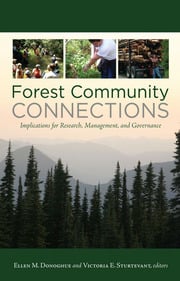
Forest Community Connections
2008
Summary
Focusing primarily on the United States, this book examines the ways that social scientists work with communities, their role in facilitating social learning, informing policy decisions, and contributing to community well being.
Key Personnel & Institutions
People: Ellen Donoghue , Victoria Sturtevant
Institutions: United States Department of Agriculture (USDA), Forest Service
Location
VERMONT, Massachusetts, Maine, New York, New Hampshire, Connecticut, Rhode Island, New England
Resource Type
Book
Tags
communities
Topic Tags
conservation, methods, ecosystem services, planning
Purpose Tags
conservation, management
Citation
Donoghue, E., Sturtevant, V. "Forest Community Connections: Implications for Research, Management, and Governance". First edition, 8 December, 2008. Routledge. https://doi.org/10.4324/9781936331451
Source Link
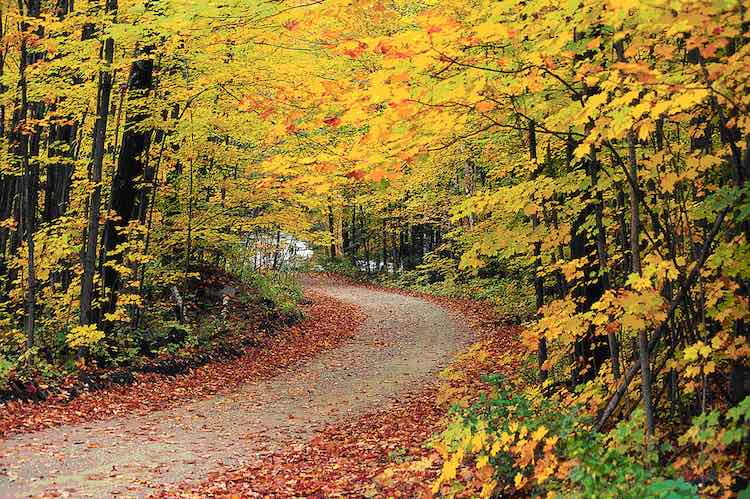
Harvard Report: New England Losing 24,000 Acres of Forest a Year
2017
Summary
This article highlights the findings of a report by researchers at Harvard University and the University of Vermont which shows that New England states need to triple the rate at which forest land is conserved or risk losing a campaign to protect millions of acres from residential and commercial development.
Key Personnel & Institutions
People: Sherry Devlin
Institutions: Treesource
Location
VERMONT, Massachusetts, Maine, New Hampshire, Connecticut, Rhode Island, New England
Resource Type
Article
Tags
No tag keywords available
Topic Tags
conservation, management, ecosystem services, planning, drivers, landscape pattern and connectivity
Purpose Tags
conservation, management
Citation
Devlin, S. "Harvard Report: New England Losing 24,000 Acres of Forest a Year". Treesource, September 25, 2017. Accessed from: https://treesource.org/news/lands/new-england-forests/
Source Link

Extinction, Causes of
2013
Summary
This chapter of the Encyclopedia of Biodiversity (Second Edition) focuses on the threats effecting biodiversity as the human population grows.
Key Personnel & Institutions
People: Richard Primack , Rachel A. Morrison
Institutions: Boston University , National Institute of Oceanography , Scripps Institute of Oceanography
Location
VERMONT, Massachusetts, Maine, New York, New Hampshire, Connecticut, Rhode Island, New England
Resource Type
Article
Tags
extinction
Topic Tags
conservation, ecosystem services, drivers, wildlife and habitat
Purpose Tags
conservation
Citation
Primack, R.B., Morrison, R.A. "Extinction, Cause of". Encyclopedia of Biodiversity ed.2, pp 401-412, 2013. https://doi.org/10.1016/B978-0-12-384719-5.00050-2
Source Link
https://www.sciencedirect.com/science/article/pii/B9780123847195000502

Rise of Human Influence on the World’s Biota
2014
Summary
This article outlines the impacts of humans on the environment from a prehistoric time all the way up to and beyond the human population boom with a focus on climate change and invasive species.
Key Personnel & Institutions
People: Scott A. Elias
Institutions: University of London
Location
VERMONT, Massachusetts, Maine, New York, New Hampshire, Connecticut, Rhode Island, New England
Resource Type
Article
Tags
human impacts
Topic Tags
conservation, ecosystem services, drivers, wildlife and habitat
Purpose Tags
conservation
Citation
Elias, S.A., "Rise of Human Influence on the World’s Biota" Reference Module in Earth Systems and Environmental Sciences, 2014. https://doi.org/10.1016/B978-0-12-409548-9.09144-2
Source Link
https://www.sciencedirect.com/science/article/pii/B9780124095489091442
A Landowner’s Guide to New England Cottontail Habitat Management
2008
Summary
Information about the New England cottontail and how you can manage your land for habitat is included in this guide.
Key Personnel & Institutions
People: Margaret Arbuthnot
Institutions: United States Department of Agriculture (USDA), Natural Resources Conservation Service , United States Fish and Wildlife Service, Maine Department of Inland Fisheries and Wildlife, Environmental Defense Fund
Location
VERMONT, Massachusetts, Maine, New York, New Hampshire, Connecticut, Rhode Island, New England
Resource Type
Article
Tags
landowners, new england cottontail
Topic Tags
conservation, methods, management, ecosystem services, wildlife and habitat, landscape pattern and connectivity
Purpose Tags
conservation, management, education
Citation
Arbuthnot, M. "A Landowner’s Guide to New England Cottontail Habitat Management". Environmental Defense Fund. 36 pp. 2008. Accessed from (https://www.edf.org/sites/default/files/8828_New-England-Cottontail-Guide_0.pdf)
Source Link
https://www.edf.org/sites/default/files/8828_New-England-Cottontail-Guide_0.pdf
Guide to Sustainable Forest Management
2018
Summary
This document will first provide background information and the history of NEFF, and then guide you through the management of NEFF’s Community Forests.
Key Personnel & Institutions
Institutions: New England Forestry Foundation
Location
VERMONT, Massachusetts, Maine, New York, New Hampshire, Connecticut, Rhode Island, New England
Resource Type
Article
Tags
sustainability
Topic Tags
conservation, methods, management, planning
Purpose Tags
conservation, management, education
Citation
"Guide to Sustainable Forest Management" New England Forestry Foundation, 2018. Accessed from (https://newenglandforestry.org/wp-content/uploads/2018/02/NEFF-forestry-guide.pdf)
Source Link
https://newenglandforestry.org/wp-content/uploads/2018/02/NEFF-forestry-guide.pdf
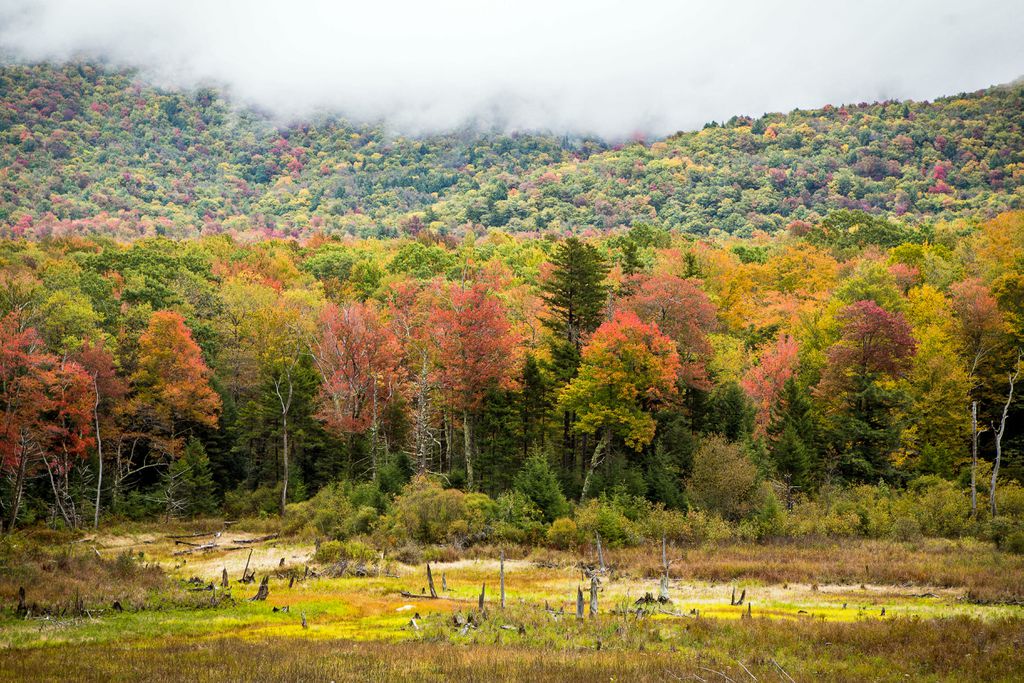
How the Forests in New England are Connected to Forests Everywhere
2020
Summary
This article highlights the impact of forestry and harvesting decisions made in New England on those same practices and the decisions made globally as a result.
Key Personnel & Institutions
People: Jas Smith , Rachel Hellman
Institutions: Vermont Youth Conservation Corps (VYCC)
Location
VERMONT, Massachusetts, Maine, New York, New Hampshire, Connecticut, Rhode Island, New England
Resource Type
Article
Tags
connectivity
Topic Tags
conservation, methods, management, ecosystem services
Purpose Tags
conservation, management
Citation
Smith, J., Hellman, R. "How the Forests in New England are Connected to Forests Everywhere" Globe, 12 December 2020. Accessed from (https://www.bostonglobe.com/2020/12/12/opinion/how-forests-new-england-are-connected-forests-everywhere/)
Source Link
Rhode Island Forest Legacy Assessment of Need
2020
Summary
To establish eligibility for funding, each state is required to complete a state-wide forest Assessment of Need (AON) that analyzes forest conditions and trends, delineates priority forest legacy areas, and outline the policies and procedures for implementation of the Program.
Key Personnel & Institutions
Institutions: United States Department of Agriculture (USDA), Forest Legacy Program, Rhode Island
Location
Rhode Island
Resource Type
Article
Tags
assessment
Topic Tags
conservation, methods, management, planning
Purpose Tags
conservation, management
Citation
"Rhode Island Forest Legacy Assessment of Need" Forest Legacy Program, October 2020. Accessed from (http://www.dem.ri.gov/programs/bnatres/forest/pdf/legacy/forasse.pdf)
Source Link
http://www.dem.ri.gov/programs/bnatres/forest/pdf/legacy/forasse.pdf
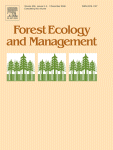
Effects of Parcelization and Land Divestiture on Forest Sustainability in Simulated Forest Lanscapes
2006
Summary
This study used a timber harvest simulator and neutral model landscapes to systematically study how parcelization and divestiture affect measures of forest composition and fragmentation, timber production and public access. They studied parcelization effects by systematically varying the probability that ownerships would be parcelized at three different spatial scales (9216, 256, 16 ha).
Key Personnel & Institutions
People: Eric J. Gustafson , Craig Loehle
Institutions: United States Department of Agriculture (USDA), Forest Service, Northern Research Station , National Council for Air and Stream Improvement
Location
VERMONT, Massachusetts, Maine, New York, New Hampshire, Connecticut, Rhode Island, New England
Resource Type
Report
Tags
simulation, landscape
Topic Tags
conservation, methods, management, ecosystem services
Purpose Tags
conservation, management
Citation
Gustafson, E. J., Loehle, C., "Effects of Parcelization and Land Divestiture on Forest Sustainability in Simulated Forest Lanscapes" Forest Ecology and Management, vo. 236, issues 2-3, 1 December 2006, pp. 305-314. https://doi.org/10.1016/j.foreco.2006.09.015
Source Link
https://www.sciencedirect.com/science/article/abs/pii/S0378112706009030
Forest Fragmentation and Island Biogeography: A Summary and Bibliography
1992
Summary
This report consists of a summary of theory and findings that relate to forest fragmentation and the consequent creation of edge habitats, and a bibliography on these subjects.
Key Personnel & Institutions
People: Robert N. Rosenfield , Christopher M Morasky , John Bielefeldt , Walter L. Loope
Institutions: University of Wisconsin, Stout Menomonie, Department of Biology
Location
No location information available
Resource Type
Report
Tags
summary
Topic Tags
conservation, drivers, wildlife and habitat
Purpose Tags
conservation, education
Citation
Rosenfield, R. N., Morasky, C. M., Bielefeldt, J., Loope, W. L.. "Forest Fragmentation and Island Biogeography: A Summary and Bibliography" National Resources Publication Office, August 1992. Accessed from (https://books.google.com/books?hl=en&lr=&id=4vNPAAAAYAAJ&oi=fnd&pg=PP8&dq=forest+fragmentation+northeast+us&ots=SBhQ5NVZGX&sig=PNbs-WHSEUliT3-m42ZWR54V7LY#v=onepage&q=forest fragmentation northeast us&f=false)
Source Link

Management of North Central and Northeastern Forests for Nongame Birds
1979
Summary
This is a report of the proceedings of the third workshop on the management of forest and range habitats for nongame birds. It was hosted by the USDA forest service of the Eastern Region, the Northeastern area State and Private Forestry, the Northeastern Forest Experiment Station and the Northcentral Forest Experiment Station.
Key Personnel & Institutions
People: Richard DeGraaf , Keith E. Evans
Institutions: United States Department of Agriculture (USDA), Forest Service, North Central Forest Experiment Station
Location
VERMONT, Massachusetts, Maine, New York, New Hampshire, Connecticut, Rhode Island, New England
Resource Type
Report
Tags
birds
Topic Tags
conservation, drivers, wildlife and habitat
Purpose Tags
conservation
Citation
DeGraaf, R. M., Evans, K. E.. "Management of North Central and Northeastern Forests for Nongame Birds" North Central Forest Experiment Station, 1979. Accessed from (https://books.google.com/books?hl=en&lr=&id=LHN7SmcBeDsC&oi=fnd&pg=PA198&dq=forest+fragmentation+northeast+us&ots=5TpbzYtVyf&sig=kaCHNShmVI0ZqPmIzwRVOmhWvvs#v=onepage&q&f=false)
Source Link
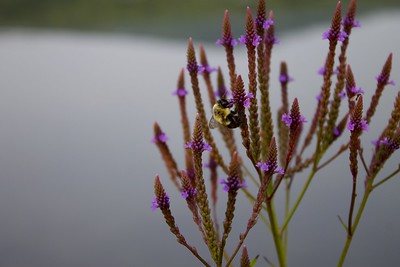
Bees, Specialists and Global Change in Forests of the Northeastern United States
2020
Summary
This dissertation focuses on two types of specialization found in wild bees. The first of these is foraging-bout specialization, whereby an individual bee will visit a single plant species during a foraging bout. The second focus is on forest specialist bee species, which depend exclusively on forest habitat for their survival. Evidence from non-bee taxa suggests that, in general, forest specialists are particularly vulnerable to decline, given widespread deforestation.
Key Personnel & Institutions
People: Colleen Smith
Institutions: Rutgers University
Location
VERMONT, Massachusetts, Maine, New York, New Hampshire, Connecticut, Rhode Island, New England
Resource Type
Report
Tags
No tag keywords available
Topic Tags
conservation, ecosystem services, drivers, wildlife and habitat
Purpose Tags
conservation
Citation
Smith, C. "Bees, specialists and global change in forests of the northeastern United States". Rutgers University, School of Graduate Studies. 2020. Retrieved from https://doi.org/doi:10.7282/t3-p5wx-7t84
Source Link
Forest Fragmentation and Lyme Disease in the Northeastern US
2014
Summary
Fragmentation has had important consequences for the animal host communities that support tick populations and transmission of the Lyme disease spirochete in the region, including evidence that fragmented forests support fewer vertebrate species, higher abundance of reservoir hosts for the bacteria and larger populations of ticks.
Key Personnel & Institutions
People: Andrew MacDonald
Location
VERMONT, Massachusetts, Maine, New York, New Hampshire, Connecticut, Rhode Island, New England
Resource Type
Article
Tags
lyme disease
Topic Tags
drivers, wildlife and habitat, landscape pattern and connectivity
Purpose Tags
education
Citation
Macdonald, A. J.. "Forest Fragmentation and Lyme Disease in the Northeastern US" 2014. Accessed from (https://andrewjmacdonald.weebly.com/forest-fragmentation-and-lyme-disease-transmission-in-the-us-northeast.html)
Source Link
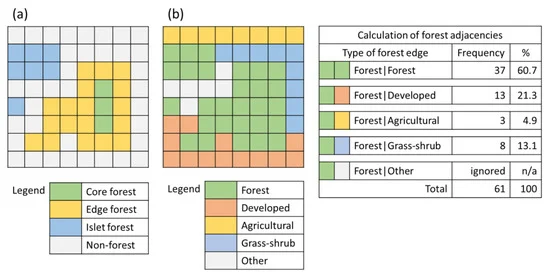
A Subcontinental Analysis of Forest Fragmentation Effects on Insect and Disease Invasion
2018
Summary
Using national survey data on forest pest richness and fragmentation data across United States forest ecosystems, this study examines how forest fragmentation and edge types (neighboring land cover) may affect pest richness at the county level.
Key Personnel & Institutions
People: Kevin Potter, Kurt Ritters , Qinfeng Guo
Institutions: United States Department of Agriculture (USDA), Forest Service, Southern Research Station , North Carolina State University, Department of Forestry and Environmental Resources
Location
VERMONT, Massachusetts, Maine, New York, New Hampshire, Connecticut, Rhode Island, New England
Resource Type
Report
Tags
diseases, invasive insects
Topic Tags
conservation, drivers, wildlife and habitat, landscape pattern and connectivity
Purpose Tags
conservation
Citation
Guo, Q., Riitters, K. H., and Potter, K. M.. "A Subcontinental Analysis of Forest Fragmentation Effects on Insect and Disease Invasion" Forests 9, no. 12. 2018: 744. https://doi.org/10.3390/f9120744
Source Link
Issue: Land Use Change
1979 to 2005
Summary
This article is an overview of land use changes and patterns in the United states.
Key Personnel & Institutions
Institutions: Northeast-Midwest State Foresters Alliance
Location
VERMONT, Massachusetts, Maine, New York, New Hampshire, Connecticut, Rhode Island, New England
Resource Type
Article
Tags
land use change
Topic Tags
conservation, ecosystem services, drivers, landscape pattern and connectivity
Purpose Tags
conservation
Citation
"Issue: Land Use Change" Northeast-midwest State Foresters Alliance, Accessed from (https://www.nmsfa.org/issues/land-use-change/)
Source Link
Climate Change Driving Widespread Loss of Coastal Forested Wetlands Throughout the North American Coastal Plain
2021
Summary
This study used classified satellite imagery to document a net loss of 13,682 km2 (8%) of forested coastal wetlands across the North American Coastal Plain (NACP) between 1996 and 2016. Most forests transitioned to scrub-shrub (53%) and marsh habitats (24%).
Key Personnel & Institutions
People: Elliott E. White , Emily A. Ury , Emily S. Bernhardt , Xi Yang
Institutions: Duke University, Department of Biology, University of Virginia, Department of Environmental Sciences
Location
No location information available
Resource Type
Article
Tags
climate change, wetlands
Topic Tags
conservation, ecosystem services, drivers, landscape pattern and connectivity
Purpose Tags
conservation, policy
Citation
White, E.E., Ury, E.A., Bernhardt, E.S. et al. "Climate Change Driving Widespread Loss of Coastal Forested Wetlands Throughout the North American Coastal Plain". Ecosystems (2021). https://doi.org/10.1007/s10021-021-00686-w
Source Link
https://link.springer.com/article/10.1007/s10021-021-00686-w

Effects of Terrestrial Transport Corridors and Associated Landscape Context on Invasion by Forest Plants
2019
Summary
This study compiled data on the number of invasive plant species per?~?672 m2 plot (=?invasive richness) from 44,000?+?forest inventory plots in the eastern USA. Using a generalized linear model framework, they investigated how invasive richness is influenced by distance from the nearest terrestrial transport corridor, surrounding land use type, and ecological province.
Key Personnel & Institutions
People: Kurt Ritters , Samuel F. Ward , Benjamin S. Taylor , Kelly-Ann Dixon Hamil , Songlin Fei
Institutions: United States Department of Agriculture (USDA), Forest Service, Southern Research Station , Purdue University, Purdue University, Department of Forestry and Natural Resources , University of the West Indies, Mona Campus, Department of Economics
Location
VERMONT, Massachusetts, Maine, New York, New Hampshire, Connecticut, Rhode Island, New England
Resource Type
Article
Tags
plants, corridors, terrestrial habitat
Topic Tags
conservation, wildlife and habitat, landscape pattern and connectivity
Purpose Tags
conservation
Citation
Ward, S.F., Taylor, B.S., Dixon Hamil, KA. et al. "Effects of Terrestrial Transport Corridors and Associated Landscape Context on Invasion by Foreastern USA.est Plants". Biol Invasions 22, 3051–3066 (2020). https://doi.org/10.1007/s10530-020-02308-3
Source Link
https://link.springer.com/article/10.1007/s10530-020-02308-3

Growing Forests "a rare piece of good news in climate science"
2009 to 2022
Summary
Boston University researchers Lucy Hutyra and Luca Morreale, along with scientists from Harvard Forest and The City University of New York, find that trees along the edges of temperate forests grow faster and are denser as a result of fragmentation.
Key Personnel & Institutions
People: Gina Mantica
Institutions: Boston University
Location
VERMONT, Massachusetts, Maine, New Hampshire, Connecticut, Rhode Island, New York
Resource Type
Article
Tags
No tag keywords available
Topic Tags
conservation, management, drivers, landscape pattern and connectivity
Purpose Tags
conservation, management
Citation
Mantica G., "Growing forests "a rare piece of good news in climate science"", Boston University, 6 January, 2022. Accessed from: https://www.bu.edu/hic/2022/01/06/growing-forests-a-rare-piece-of-good-news-in-climate-science/
Source Link
https://www.bu.edu/hic/2022/01/06/growing-forests-a-rare-piece-of-good-news-in-climate-science/
The Ecological Consequences of Habitat Fragmentation
Summary
This research article analyzes habitat fragmentation, one subset of global land use change, and its ecological consiquences.
Key Personnel & Institutions
People: Raphael Didham
Institutions: University of Western Australia, School of Biological Sciences , Floreat - CSIRO , University of Canterbury
Location
VERMONT, Massachusetts, Maine, New York, New Hampshire, Connecticut, Rhode Island, New England
Resource Type
Article
Tags
No tag keywords available
Topic Tags
conservation, drivers, wildlife and habitat, landscape pattern and connectivity
Purpose Tags
conservation, education
Citation
Didham R. K., "The Ecological Consequences of Habitat Fragmentation", Encyclopedia of Life Sciences A21904, 3 May 2010, Accessed from: https://publications.csiro.au/rpr/download?pid=csiro:EP101968&dsid=DS1
Source Link
https://publications.csiro.au/rpr/download?pid=csiro:EP101968&dsid=DS1
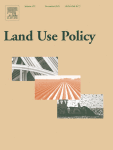
The future of family forests in the USA: Near-term intentions to sell or transfer
1905
Summary
This study uses national NWOS data to explore whether and how FFO and land characteristics differ with the intention to transfer forestland in the next 5 years.
Key Personnel & Institutions
People: Brett Butler , David Kittredge , Marla Markowski-Lindsay
Institutions: University of Massachusetts Amherst , United States Department of Agriculture (USDA), Forest Service, Northern Research Station , Family Forest Research Center , University of Massachusetts, Amherst, Department of Environmental Conservation
Location
VERMONT, Massachusetts, Maine, New York, New Hampshire, Connecticut, Rhode Island, New England
Resource Type
Report
Tags
No tag keywords available
Topic Tags
drivers, landscape pattern and connectivity
Purpose Tags
conservation, management
Citation
Markowski-Lindsay M., Butler B. J., Kittredge D. B., "The future of family forests in the USA: Near-term intentions to sell or transfer", 2017. Accessed Online: https://pdf.sciencedirectassets.com/271740/1-s2.0-S0264837717X00082/1-s2.0-S0264837716313102/Marla_Markowski_Lindsay_Near_term_intentions_2017.pdf?X-Amz-Security-Token=IQoJb3JpZ2luX2VjEFMaCXVzLWVhc3QtMSJIMEYCIQCmcdhsq28SICTkKxdNwnsWkxKXPDAsxdlN/+1t9/T2FAIhAJ5u+c72neTWnKLzlcckuWJdH+OsieANfEfksi4sk+CIKtsECKv//////////wEQBRoMMDU5MDAzNTQ2ODY1Igwz5bKcgOtptmMLdesqrwSnIHF54FdMG+k//AjmLzyb563wiP5DcG+q97wD9uaqqffZeL6ui1qOF6HNONQWZBTON+JbXdKuWs5z/r0gvkMJ3RzzNLH267V+1inoS8qpcxdF1CrpUzkbagi3zG1QCBaSTq9XK7cerV97KvXAyZUZAeBN7f8w1UDpojwh7/cTFgb9j422GqKzVe707CTvS0FP/3NidqEbYnYjIxLvnmqXNt5cNt5rhX4wI4TMhAJuc6UTNnthpbvA8EXFBd+LH+4/80Kr+yJ8qyMqKb3BbTHbU7jMrtFDgJj5IkGPmEy1XFdM3yp0orzVfCEqzFvZkdmHCXKtZLGFD7wa2CPzY3Ykujj/Lk6GqXP5Rr4Ap4CHH0CvlsiXDjDZwNQ6osX1gUnk/5V3Ffexc7XQ9W2M+OJz68/sBCZdJG3HstqamFd8jzE/SabJrph6OWSxKqJW1lJ2zWhqSoOASr3w8flOlaHVeX6f3aknc6vocwqBuT+8iMZlGjJvJX0D5Uau7ytRct8tUQy4GCh+Old9SBrMIweEgq7P3AbZg53ZLc3K+samXC6RYUoj7aOHXGHWST2KsQv/PmT5i4y0bvlz2lviCMg9XVdsMfmlKR1u206MCaMBdKMA3cGr9LmFYM2AWDQls30N/xA2ziZtfBdTOPuLx2p8ZhOYWRYHChRM/YYoCuS0y7fPyMRttYfBWGWxz3wpzEpU99kiOBy8wzl949AZGjdkNyTAeOK7P3Bk+BJxofVvMPuasJcGOqgBExIblksMS/jYjLQFcjjneDY8lQNE7+Rje08gHUOETdmiQbSZmZrWJ1IEc5R5kETBBb+0uZMbKl2+e8/sYq36f6yUjrOiSHJEVq5l3m4xM/x86ypAxJS5n8wt1f5hWPAFZKSmqvYCIST8XdQ2+4mLLjHYPk9GDcxS6wC4HgAKNeD117iNWj2IpnpIaKdnD3HmDvbhaNGPr1RRZUcI+3g56j6ONXVaeXL7&X-Amz-Algorithm=AWS4-HMAC-SHA256&X-Amz-Date=20220804T191817Z&X-Amz-SignedHeaders=host&X-Amz-Expires=300&X-Amz-Credential=ASIAQ3PHCVTYTHF5MQM3/20220804/us-east-1/s3/aws4_request&X-Amz-Signature=b5ed6117a808f56c50d1f8671128335f039115185bcaf2cb0e68c383ab4a190d&hash=825de334d21e057e3cfd1c0fea1b3d570fa7dc2194e0cf5005cc7266ed698764&host=68042c943591013ac2b2430a89b270f6af2c76d8dfd086a07176afe7c76c2c61&pii=S0264837716313102&tid=pdf-41c6f48e-f625-4bf0-ba43-d77c0cdf02d0&sid=ea52a4d4144d5341f608db6708e3683a163egxrqa&type=client
Source Link
Forests, Forestry and the Forest Products Industry: Opportunities for Creative Investment
2012
Summary
This paper addresses a working landscape of forests and farms in five counties (4.9 million acres) including the Tug Hill Region and a small portion of the Adirondack Park.
Key Personnel & Institutions
Institutions: New York State Tug Hill Commission
Location
New York
Resource Type
Article
Tags
No tag keywords available
Topic Tags
management, ecosystem services
Purpose Tags
management, education
Citation
"Forests, Forestry and the Forest Products Industry: Opportunities for Creative Investment", New York State Tug Hill Commission, October 2012. Accessed from: http://www.tughill.org/wp-content/uploads/2011/09/forestry_paper_FINAL_October_20121.pdf
Source Link
http://www.tughill.org/wp-content/uploads/2011/09/forestry_paper_FINAL_October_20121.pdf
Vermont Forest Legacy Program Assessment of Need (AON)
2010
Summary
A required component of the forest legacy program, the assessment of need (AON) process determines areas where the state's most valuable forestlands face the greatest threats, solicits and receives input from the public, and seeks approval of these forest legacy areas from the secretary of agriculture.
Key Personnel & Institutions
People: James E. Hubbard
Institutions: Vermont Department of Forests, Parks and Recreation
Location
VERMONT
Resource Type
Report
Tags
No tag keywords available
Topic Tags
conservation, management, ecosystem services
Purpose Tags
conservation, management
Citation
"Vermont Forest Legacy Program Assessment of Need (AON)" Vermont Department of Forests, Parks and Recreation, James E. Hubbard, February 2010. Accessed from https://fpr.vermont.gov/sites/fpr/files/Forest_and_Forestry/Vermont_Forests/Library/2017_VT_ForestActionPlanAppC.pdf
Source Link
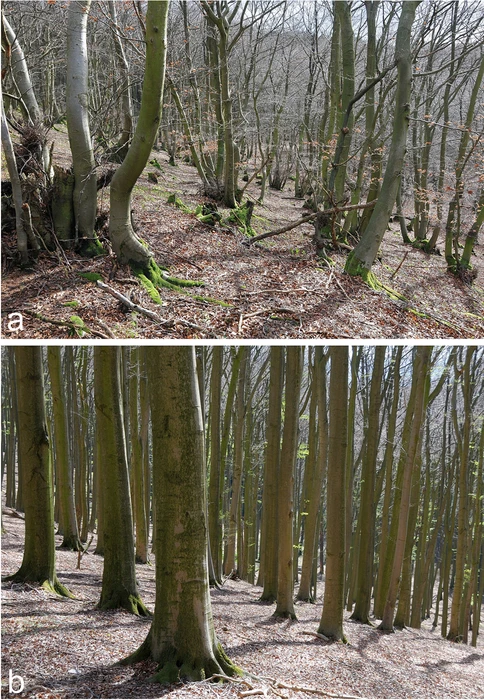
On the Interplay of Ownership Patterns, Biodiversity, and Conservation in Past and Present Temperate Forest Landscapes of Europe and North America
2021
Summary
Ownership patterns and the associated management characteristics are related to forest structures, biodiversity patterns, and their conservation worldwide. A literature review on this topic is missing so far. This research will fill this gap with an emphasis on the temperate forests of Europe and North America.
Key Personnel & Institutions
People: Andreas Molder , Tobias Plieninger , Malin Tiebel
Institutions: Northwest German Forest Research Institute (NW-FVA), Department of Forest Nature Conservation , University of Gottingen, Department of Agricultural Economics and Rural Development , University of Kassel, Faculty of Organic Agricultural Sciences
Location
VERMONT, Massachusetts, Maine, New York, New Hampshire, Connecticut, Rhode Island, New England
Resource Type
Report
Tags
No tag keywords available
Topic Tags
conservation, management, landscape pattern and connectivity
Purpose Tags
conservation, management
Citation
Molder A., Tiebel M., Plieninger T., "On the Interplay of Ownership Patterns, Biodiversity, and Conservation in Past and Present Temperate Forest Landscapes of Europe and North America", Topical Collection on Forest Management, 29 November 2021, Current Forestry Reports v. 7, 195-213. https://doi.org/10.1007/s40725-021-00143-w
Source Link
https://link.springer.com/article/10.1007/s40725-021-00143-w

Estimating regional timber supply and forest carbon sequestration under shared socioeconomic pathways: A case study of Maine, USA
1959 to 2022
Summary
This study provides a regional model framework to evaluate timber supply and carbon impacts of environmental and socioeconomic change in Maine, USA. They construct alternative future narratives that vary economic growth, forest management, and environmental policies and then conduct econometric analysis to project forest area and timber supply over the next 80 years under five shared socioeconomic pathways (SSPs).
Key Personnel & Institutions
People: Aaron Weiskittel , Jianheng Zhao , Adam Daigneault
Institutions: University of Maine, School of Forest Resources
Location
Maine
Resource Type
Report
Tags
No tag keywords available
Topic Tags
conservation, management, ecosystem services, drivers, landscape pattern and connectivity
Purpose Tags
conservation, management
Citation
Zhao J., Daigneault A., Weiskittel A., "Estimating regional timber supply and forest carbon sequestration under shared socioeconomic pathways: A case study of Maine, USA", 9 May 2022, https://doi.org/10.1371/journal.pclm.0000018
Source Link
https://journals.plos.org/climate/article?id=10.1371/journal.pclm.0000018
Economic Contributions from Conserved Forests: Four Case Studies of the USDA Forest Service Forest Legacy Program
2015 to 2022
Summary
This research employed IMPLAN's input-output model of the 2016 economy to estimate how land protected by the USDA Forest Service Forest Legacy Program (FLP) in four regions of the United States contributes to the economy.
Key Personnel & Institutions
People: Paul Catanzaro , Brett Butler , Helena Murray , Marla Markowski-Lindsay, Henry Eichman
Institutions: United States Department of Agriculture (USDA), Forest Service , United States Department of Agriculture (USDA), Forest Service, Northern Research Station , University of Massachusetts Amherst , Family Forest Research Center , University of Massachusetts, Amherst, Department of Environmental Conservation
Location
VERMONT, Maine, New York, New Hampshire
Resource Type
Article
Tags
No tag keywords available
Topic Tags
conservation, methods, ecosystem services
Purpose Tags
conservation
Citation
Murray H., Catanzaro P., Markowski-Lindsay M., Butler B. J., Eichman H., "Economic Contributions from Conserved Forests: Four Case Studies of the USDA Forest Service Forest Legacy Program", Forest Science, Volume 67, Issue 6, December 2021, Pages 629–632, https://doi.org/10.1093/forsci/fxab039
Source Link
https://academic.oup.com/forestscience/article/67/6/629/6375812
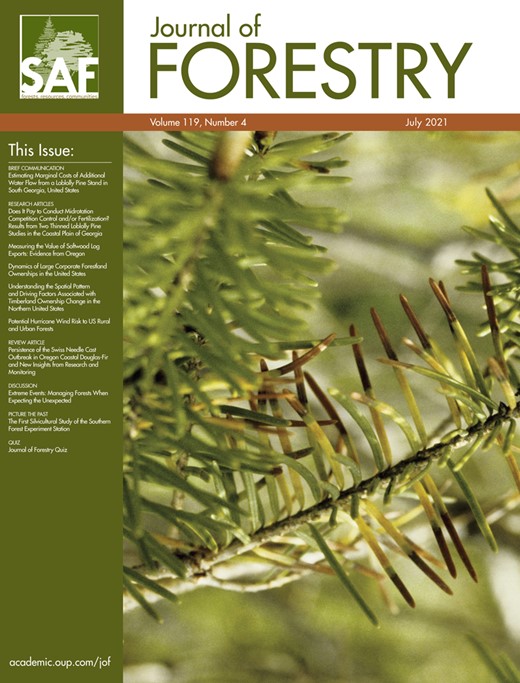
Dynamics of Large Corporate Forestland Ownerships in the United States
2006 to 2017
Summary
This article quantifies forest ownership transitions among ownership categories between 2007 and 2017 and investigates how and why large corporate ownerships own and manage their forestlands. Ownership transitions were determined from refined USDA Forest Service, Forest Inventory and Analysis data; they also conducted a survey of large corporate forestland ownerships.
Key Personnel & Institutions
People: Brett Butler , Emily Huff , Marla Markowski-Lindsay, Jesse Caputo , Amanda Robillard , Emma Sass , Andrew Hartsell
Institutions: United States Department of Agriculture (USDA), Forest Service, Northern Research Station , Michigan State University , United States Department of Agriculture (USDA), Forest Service, Southern Research Station , Family Forest Research Center , University of Massachusetts, Amherst, Department of Environmental Conservation
Location
VERMONT, Massachusetts, Maine, New York, New Hampshire, Connecticut, Rhode Island, New England
Resource Type
Article
Tags
No tag keywords available
Topic Tags
conservation, management, drivers, landscape pattern and connectivity
Purpose Tags
conservation, management
Citation
Sass E. M., Markowski-Lindsay M., Butler B. J., Caputo J., Hartsell A., Huff E., Robillard A., "Dynamics of Large Corporate Forestland Ownerships in the United States", Journal of Forestry, Volume 119, Issue 4, July 2021, Pages 363–375, https://doi.org/10.1093/jofore/fvab013
Source Link
Expanding Family Forest Owner Options to Keep Their Land in Forest Use
2021
Summary
This research explored northeastern Family Forest Owners (FFO) likelihood of Conservation easements (CEs) adoption through contingent behavior responses to permanent and temporary CE scenarios. For each commitment length, they tested a range of financial compensation amounts and FFO characteristics.
Key Personnel & Institutions
People: Paul Catanzaro , Marla Markowski-Lindsay
Institutions: University of Massachusetts, Amherst, Department of Environmental Conservation
Location
VERMONT, Massachusetts, Maine, New York, New Hampshire, Connecticut, Rhode Island, New England
Resource Type
Article
Tags
No tag keywords available
Topic Tags
conservation, management, drivers, landscape pattern and connectivity
Purpose Tags
conservation, management, policy
Citation
Catanzaro P., Markowski-Lindsay M., "Expanding Family Forest Owner Options to Keep Their Land in Forest Use", Journal of Forestry, Volume 120, Issue 2, March 2022, Pages 208–221, https://doi.org/10.1093/jofore/fvab052
Source Link
https://academic.oup.com/jof/article-abstract/120/2/208/6377833

Place Attachment and Concern in Relation to Family Forest Landowner Behavior
2021
Summary
Contemporary approaches to studying family forests have identified distinct subgroups of landowners through segmentation analysis. This study expands on this approach, incorporating the concept of place to provide a novel perspective on how the cognition and emotions that create place attachment and landowner concerns influence certain landowner behaviors. They specifically modeled legacy planning and future landowner ownership behavioral intentions and behaviors.
Key Personnel & Institutions
People: Jessica Leahy, Patrick Lyons
Institutions: University of Maine, School of Forest Resources
Location
Maine
Resource Type
Article
Tags
No tag keywords available
Topic Tags
conservation, management, drivers, landscape pattern and connectivity
Purpose Tags
conservation, management
Citation
Leahy J Lyons P., "Place Attachment and Concern in Relation to Family Forest Landowner Behavior" Forests, 2021; 12(3):295. https://doi.org/10.3390/f12030295
Source Link
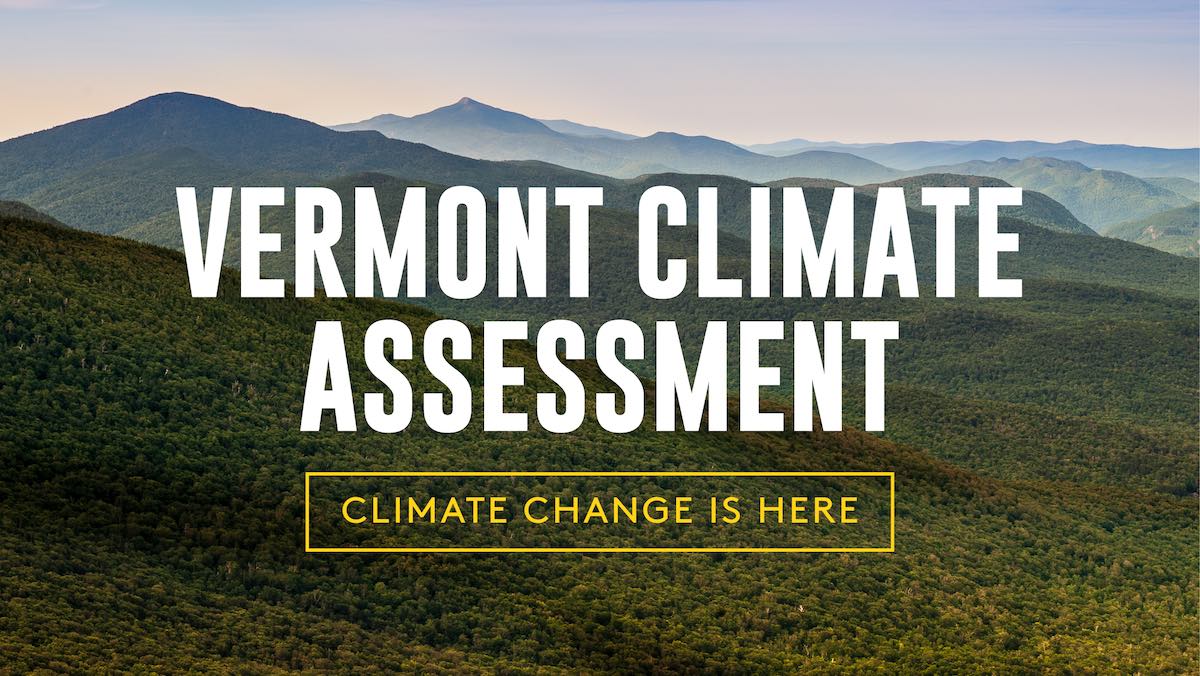
Vermont Climate Assessment
2022
Summary
The Vermont Climate Assessment (VCA) assesses the science of climate change and its impacts across Vermont. This report draws from foundational science about climate change and variability to analyze the effects of global change on Vermont's people, economy, and environment.
Key Personnel & Institutions
People: Steven Faccio , Dani Cook , Pablo Bose , Mahalia Clark , Peter Clark , Jake Carlo , Deniz Dutton , Caitlin Crossett , Stephanie Clement
Institutions: University of Vermont, Department of Geography , University of Vermont, Rubenstein School of Environment and Natural Resources , Vermont Center for Ecostudies, VCE , University of Vermont, Plant and Soil Science , University of Vermont, Extension , Vermont EPSCoR , Forest Ecosystem Monitoring Cooperative (FEMC) , Gund Institute for Environment , Vermont Center for Ecostudies , Vermont Sustainable Jobs Fund , One Tree Planted
Location
VERMONT
Resource Type
Report
Tags
No tag keywords available
Topic Tags
conservation, management, ecosystem services, drivers
Purpose Tags
conservation, management, policy
Citation
Bose P., Clark M., Clark P., Claro J., et. al. "Vermont Climate Assessment" University of Vermont, 2021, https://site.uvm.edu/vtclimateassessment/about-vca/
Source Link

Theory Meets Reality: How Habitat Fragmentation Research has Transcended Island Biogeographic Theory
2008
Summary
This research critically evaluates the conceptual utility and limitations of Island Biogeographic Theory to the study of fragmented ecosystems. It briefly encapsulates the historical background, considering how IBT has helped to shape our thinking about habitat fragmentation over the past four decades. It then describe how fragmentation research has transcended the theory, using findings from a wide variety of terrestrial ecosystems.
Key Personnel & Institutions
Not available.Location
No location information available
Resource Type
Article
Tags
No tag keywords available
Topic Tags
No topic tag keywords available
Purpose Tags
No purpose tag keywords available
Citation
Laurance W. F., "Theory meets reality: How habitat fragmentation research has transcended island biogeographic theory", Biological Conservation (2008), doi:10.1016/j.biocon.2008.05.011
Source Link
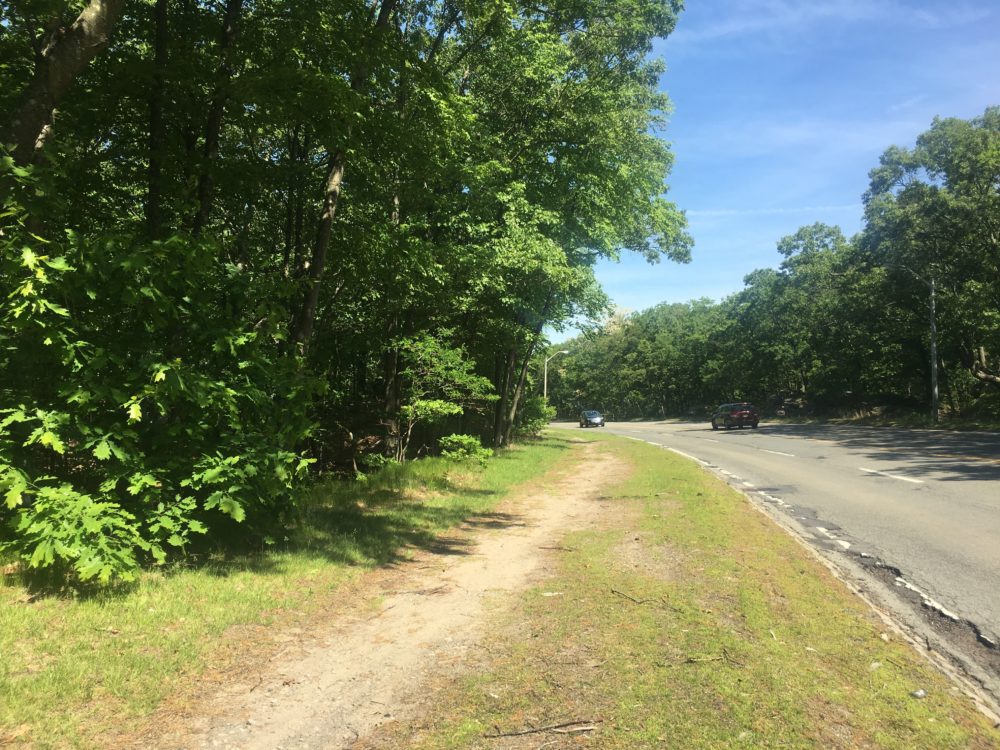
Urban forests may store more carbon that we though, study finds
2022
Summary
This article explains the findings of two studies from Boston University which found that trees around the edges of urban forests grow faster and the soil gives off less carbon dioxide than scientists expected.
Key Personnel & Institutions
People: Barbara Moran
Institutions: WBUR News
Location
VERMONT, Massachusetts, Maine, New York, New Hampshire, Connecticut, Rhode Island
Resource Type
Article
Tags
No tag keywords available
Topic Tags
conservation, ecosystem services, drivers, landscape pattern and connectivity
Purpose Tags
conservation, management
Citation
Moran B., "Urban forests may store more carbon that we though, study finds", wbur, Boston University, Accessed from: https://www.wbur.org/news/2022/02/16/forest-fragments-northeast-us-climate-change-soil-respiration
Source Link
https://www.wbur.org/news/2022/02/16/forest-fragments-northeast-us-climate-change-soil-respiration
Distribution and Causes of Global Forest Fragmentation
2003
Summary
Using 1-km advanced very high resolution radiometer (AVHRR) satellite-based land cover, this study presents a method to seperate forest fragmentation into natural and anthropogenic components, and report results for all inhabited continents summarized by World Wildlife Fund biomes.
Key Personnel & Institutions
People: Timothy Wade
Institutions: United States Environmental Protection Agency (EPA), National Exposure Research Laboratory
Location
VERMONT, Massachusetts, Maine, New York, New Hampshire, Connecticut, Rhode Island, New England
Resource Type
Report
Tags
No tag keywords available
Topic Tags
conservation, drivers, landscape pattern and connectivity
Purpose Tags
conservation
Citation
Wade T. G., Riitters K. H., Wickham J. D., Jones K. B., "Distribution and Causes of Global Forest Fragmentation", 2003, Conservation Ecology 7(2): 7 (online) URL: http://www.consecol.org/vol7/iss2/art7
Source Link
https://www.jstor.org/stable/26271943#metadata_info_tab_contents
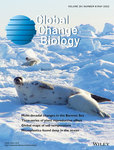
Diverging Patterns at the Forest Edge: Soil Respiration Dynamics of Fragmented Forests in Urban and Rural Areas
2022
Summary
This study characterizes soils in fragmented forests along an urban to rural gradient, evaluating the sensitivity of soil respiration to changes in soil temperature and moisture near the forest edge.
Key Personnel & Institutions
People: Andrew Reinmann , Lucy Hutyra , Pamela Templer , Erin A. Pierce , Sarah M. Garvey
Institutions: Boston University, Department of Biology, Boston University, Department of Earth and the Environment, The City University of New York (CUNY), Advanced Science Research Center, Environmental Sciences Initiative, Hunter College, Department of Geography and Environmental Science , Advanced Science Research Center (CUNY), Graduate Center, Earth and Environmental Sciences and Biology
Location
Massachusetts
Resource Type
Article
Tags
No tag keywords available
Topic Tags
conservation, ecosystem services, landscape pattern and connectivity
Purpose Tags
conservation
Citation
Garvey S. M., Templer P. H., Pierce E. A., Reinmann A. B., Hutyra L. R., "Diverging Patterns at the Forest Edge: Soil Respiration Dynamics of Fragmented Forests in Urban and Rural Areas", 15 February, 2022, Global Change Biology, V. 28, Iss. 9, p.3094-3109 (Online) https://doi.org/10.1111/gcb.16099
Source Link
Elevated Growth and Biomass Along Temperate Forest Edges
2021
Summary
This study shows that, in contrast to tropical systems, temperate forest edges exhibit increased forest growth and biomass with no change in total mortality relative to the forest interior. They analyze >48,000 forest inventory plots across the north-eastern US using a quasi-experimental matching design.
Key Personnel & Institutions
People: Andrew Reinmann , Jonathan Thompson , Lucy Hutyra , Luca L. Morreale
Institutions: Harvard University, Harvard Forest , Boston University, Department of Earth and the Environment, The City University of New York (CUNY), Advanced Science Research Center, Environmental Sciences Initiative, Advanced Science Research Center (CUNY), Graduate Center, Earth and Environmental Sciences and Biology
Location
VERMONT, Massachusetts, Maine, New York, New Hampshire, Connecticut, Rhode Island, New England
Resource Type
Report
Tags
No tag keywords available
Topic Tags
conservation, ecosystem services, drivers, landscape pattern and connectivity
Purpose Tags
conservation
Citation
Morreale L. L., Thompson J. R., Tang X., Reinmann A. B., Hutyra L. R., "Elevated Growth and Biomass Along Temperate Forest Edges", Nature Communications, V. 12, Article 7181 (10 December 2021), https://doi.org/10.1038/s41467-021-27373-7
Source Link
Are Family Forest Owners Facing a Future in Which Forest Management Is Not Enough
2009
Summary
This study evaluated the effectiveness of three tools commonly suggested for meeting the financial demands of property taxes: (1) use of economic returns from timber management, (2) enrollment in a current-use tax program, and (3) sale of a conservation easement, within a rural watershed in western Massachusetts.
Key Personnel & Institutions
People: Paul Catanzaro , Anthony D'Amato , David Kittredge , David T. Damery , Kristina A. Ferrare
Institutions: University of New Hampshire Cooperative Extension , University of Minnesota, University of Massachusetts, Department of Natural Resources Conservation
Location
Massachusetts
Resource Type
Article
Tags
No tag keywords available
Topic Tags
conservation, management, ecosystem services, drivers
Purpose Tags
conservation, management
Citation
D'Amato A. W., Catanzaro P. F., Damery D. T., Kittredge D. B., Ferrare K. A., "Are Family Forest Owners Facing a Future In Which Forest Management Is Not Enough", Journal of Forestry, 01 January 2010, v. 108, iss. 1, pp 32-38, https://doi.org/10.1093/jof/108.1.32
Source Link
Thoreau, Muir, and Jane Doe: Different Types of Private Forest Owners Need Different Kinds of Forest Management
2000 to 2006
Summary
This study presents a three-phase segmentation analysis designed to highlight the heterogeneity of forest ownership values and attitudes toward government control, privacy, and environmental protection held by a sample of Massachusetts private forest owners.
Key Personnel & Institutions
People: David Kittredge , Andrew O. Finley
Institutions: University of Minnesota, University of Massachusetts, Department of Natural Resources Conservation
Location
Massachusetts
Resource Type
Article
Tags
No tag keywords available
Topic Tags
conservation, management, planning, drivers
Purpose Tags
conservation, management, policy
Citation
Finley A. O., Kittredge D. B. Jr., "Thoreau, Muir, and Jane Doe: Different Types of Private Forest Owners Need Different Kinds of Forest Management", Northern Journal of Applied Forestry, Volume 23, Issue 1, March 2006, Pages 27–34, https://doi.org/10.1093/njaf/23.1.27
Source Link
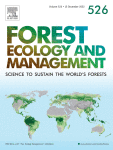
Are pre-Columbian conditions relevant baselines for managed forests in the northeastern United States?
2003
Summary
Populations of a number of taxa associated with shrublands, early-successional forests, and other disturbance-generated habitats (collectively referred to as thickets) are declining in the northeastern United States. To assure that species dependent on thicket habitats persist, intervention is warranted. However, conservationists concerned with the status of thicket-dependent species are confronted with two important questions. How much habitat is needed? And how should these habitats be distributed?
Key Personnel & Institutions
People: John Litvaitis
Institutions: University of New Hampshire, Department of Natural Resources and the Environment
Location
VERMONT, Massachusetts, Maine, New York, New Hampshire, Connecticut, Rhode Island, New England
Resource Type
Article
Tags
No tag keywords available
Topic Tags
conservation, methods, management, wildlife and habitat, landscape pattern and connectivity
Purpose Tags
conservation, management, policy
Citation
Litvaitis J. A., "Are pre-Columbian conditions relevant baselines for managed forests in the northeastern United States?" Forest Ecology and Management, 3 november 2003, v. 185, iss. 1-2, pp 113-126
Source Link
https://www.sciencedirect.com/science/article/abs/pii/S0378112703002500
The Fire in the East
2009
Summary
Development fragments forests that remain reducing their ability to provide habitat, recreation, and timber. Private family ownerships continue to get smaller through parcelization and isolated in an increasingly fragmented landscape, which impairs their ability to provide the full range of benefits. The US Forest Service nationally estimates over 2,500 ac/day are lost to development (Stein et al. 2005). These "Forests on the Edge" (Stein et al. 2005) provide invaluable ecosystem services and are incredibly vulnerable to permanent conversion because they are owned by hundreds of thousands of private families and individuals. This "fire in the East" continues to "burn" and acres of forestland are permanently lost.
Key Personnel & Institutions
People: David Kittredge
Institutions: UMass Amherst Department of Natural Resources Conservation
Location
VERMONT, Massachusetts, Maine, New York, New Hampshire, Connecticut, Rhode Island, New England
Resource Type
Article
Tags
No tag keywords available
Topic Tags
conservation, management, planning, drivers, landscape pattern and connectivity
Purpose Tags
conservation, management, policy
Citation
Kittredge D. B., "The Fire in the East", Journal of Forestry, April/May 2009
Source Link
http://www.familyforestresearchcenter.org/wp-content/uploads/2016/03/20Fire_in_the_East.pdf
Forest-Based Biomass Supply in Massachusetts: How Much is There and How Much is Available
2011 to 2012
Summary
Forest owners in Massachusetts (U.S.) live in a densely populated state and near forestland that is under pressure of development and characterized by small parcel size. Forest-based biomass harvesting in Massachusetts is a renewable energy topic generating a great deal of discussion among all constituents. To provide perspective on these discussions, this analysis asks how much forested land in Massachusetts could be available for biomass supply
Key Personnel & Institutions
People: Paul Catanzaro , Brett Butler , David Kittredge , Marla Markowski-Lindsay, David T. Damery
Institutions: United States Department of Agriculture (USDA), Forest Service , Family Forest Research Center , University of Massachusetts, Amherst, Department of Environmental Conservation , University of Massachusetts, College of Social & Behavioral Sciences, Resource Economics
Location
Massachusetts
Resource Type
Article
Tags
No tag keywords available
Topic Tags
conservation, management, ecosystem services, drivers, landscape pattern and connectivity
Purpose Tags
conservation, management
Citation
Markowski-Lindsay M., Catanzaro P., Damery D., Kittredge D. B., Butler B. J., Stevens T., "Forest-Based Biomass Supply in Massachusetts: How Much is There and How Much is Available" Journal of Environmental Management 106 (20 March 2012), Accessed online: https://citeseerx.ist.psu.edu/viewdoc/download?doi=10.1.1.1089.1381&rep=rep1&type=pdf
Source Link
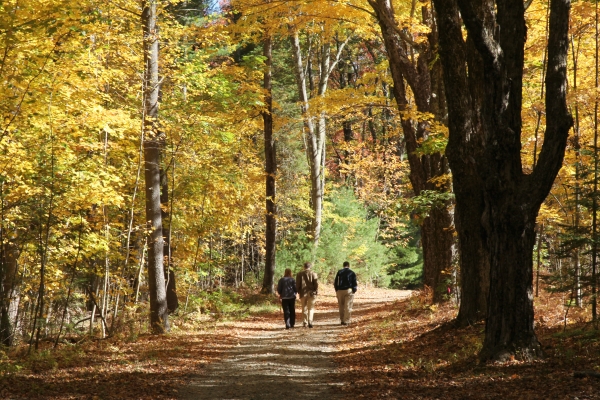
Harvard Forest Symposium Abstract 2005: The Parcelization of Forests and Timber Harvest
2005
Summary
The specific objectives of this study are to focus on parcelization in Massachusetts communities, and to identify: an expression or index to describe the extent to which it is occurring; any socioeconomic or demographic variables that are related to parcelization; and the extent to which harvesting may be influenced by parcelization.
Key Personnel & Institutions
People: David Kittredge , Kelly Grogan
Institutions: Dartmouth College , Harvard University, Harvard Forest , University of Massachusetts Amherst
Location
Massachusetts
Resource Type
Article
Tags
No tag keywords available
Topic Tags
conservation, management, ecosystem services, drivers, landscape pattern and connectivity
Purpose Tags
conservation, management
Citation
Kittredge D., Grogan K., "Harvard Forest Symposium Abstract 2005; The Parcelization of Forests and Timber Harvest" Harvard Forest, 2005, Accessed online: https://harvardforest2.fas.harvard.edu/asp/hf/php/symposium/symposium_abstract_view.php?id=36
Source Link
https://harvardforest2.fas.harvard.edu/asp/hf/php/symposium/symposium_abstract_view.php?id=36
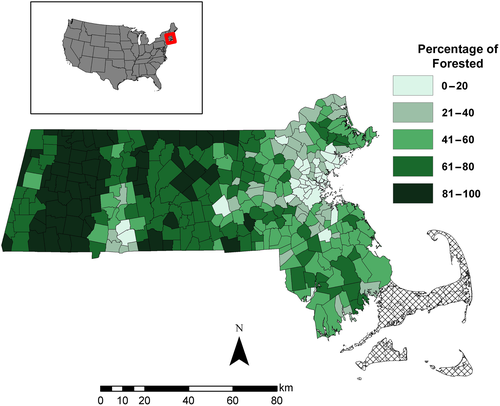
Three Decades of Forest Harvesting Along a Suburban-Rural Continuum
1983 to 2017
Summary
This study analyzed three decades of change in commercial timber harvesting on all private and public forest throughout 328 towns in Massachusetts (USA). They quantified changes in harvest activity over time and estimated probability of harvest occurrence and proportion of a town's harvest as functions of biophysical and social settings.
Key Personnel & Institutions
People: Jonathan Thompson , Lucy Hutyra , David Kittredge , Luca L. Morreale , Anne G. Short Gianotti
Institutions: Harvard University, Harvard Forest , Boston University, Department of Earth and the Environment, University of Massachusetts, Amherst, Department of Environmental Conservation
Location
Massachusetts
Resource Type
Article
Tags
No tag keywords available
Topic Tags
conservation, management, ecosystem services
Purpose Tags
conservation, management
Citation
Kittredge D. B., Thompson J. R., Morreale L. L., Gianotti A. G. S., Hutyra L. R., "Three Decades of Forest Harvesting Along a Suburban-Rural Continuum", Ecoshpere V. 8, Iss. 7, E 01882, 25 July 2017, https://doi.org/10.1002/ecs2.1882
Source Link
https://esajournals.onlinelibrary.wiley.com/doi/full/10.1002/ecs2.1882
Report of the Massachusetts Commission on Financing Forest Conservation
2011
Summary
In the following report on the work of the Massachusetts Commission on Financing Forest Conservation, we have set forth several of those opportunities and imperatives that can enable citizens of the Commonwealth to advance conservation through public legislation and administrative action, the initiative of the state‘s remarkable array of not-for-profit conservation organizations, universities, colleges and research institutions, and the decisions of its public-spirited private individuals and organizations.
Key Personnel & Institutions
People: James N. Levitt , Leigh Youngblood
Institutions: Massachusetts Commission on Financing Forest Conservation
Location
Massachusetts
Resource Type
Report
Tags
No tag keywords available
Topic Tags
conservation, methods, management, ecosystem services, planning, drivers, landscape pattern and connectivity
Purpose Tags
conservation, management, policy
Citation
Levitt J. N., Youngblood L., "Report of the Massachusetts Commission on Financing Forest Conservation", Massachusetts Commission on Financing Forest Conservation, July 2011. Accessed online: http://cpicfinance.com/wp-content/uploads/2017/03/forest-consv-financing-rpt-jul15-2011.pdf
Source Link
http://cpicfinance.com/wp-content/uploads/2017/03/forest-consv-financing-rpt-jul15-2011.pdf
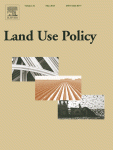
How are America's private forests changing? An integrated assessment of forest management, housing pressure, and urban development in alternate emissions scenarios
2009 to 2013
Summary
This study examines the changing patterns in the private forests across the urban–rural gradient in 36 states in the eastern United States. They combined observed forest management activities, housing pressure, and 50-year projections of development pressures under alternate IPCC emission scenarios (A1, A2, B1, and B2) to produce a forest pressures index for a total of 45,707 plots located on privately owned land.
Key Personnel & Institutions
People: Brett Butler , David Kittredge , W. Keith Moser
Institutions: United States Department of Agriculture (USDA), Forest Service, Northern Research Station , Columbia University, Department of Ecology, Evolution and Environmental Biology
Location
VERMONT, Massachusetts, Maine, New York, New Hampshire, Connecticut, Rhode Island, New England
Resource Type
Article
Tags
No tag keywords available
Topic Tags
conservation, management, drivers, landscape pattern and connectivity
Purpose Tags
conservation, management
Citation
Mondal P., Butler B. J., Kittredge D. B., Moser W. K., "How are America's private forests changing? An integrated assessment of forest management, housing pressure, and urban development in alternate emissions scenarios" Land Use Policy, May 2013, v. 32, pp 230-238, https://doi.org/10.1016/j.landusepol.2012.10.014
Source Link
https://www.sciencedirect.com/science/article/abs/pii/S0264837712002025
Deer Wintering Areas and Forest Fragmentation
2013
Summary
This map contrasts deer wintering sites with areas of human-induced forest fragmentation and conserved lands in Maine. Fragmentation is represented as the percentage of remaining forest cover.
Key Personnel & Institutions
Institutions: Colby College
Location
Maine
Resource Type
Map
Tags
No tag keywords available
Topic Tags
conservation, wildlife and habitat, landscape pattern and connectivity
Purpose Tags
conservation
Citation
Abel V., "Deer Wintering Areas and Forest Fragmentation," Atlas of Maine: Vol. 2013: No. 1, Article 15. Available at: https://digitalcommons.colby.edu/atlas_docs/vol2013/iss1/15
Source Link
https://digitalcommons.colby.edu/atlas_docs/vol2013/iss1/15/
Forest Health Monitoring: 2005 National Technical Report
2004 to 2007
Summary
This annual technical report is a product of the Forest Health Monitoring (FHM) program. The report provides information about a variety of issues relating to forest health at the national scale. Previous FHM national reports have had a dual focus of presenting analyses of the latest available data and showcasing innovative techniques for analyzing forest health data.
Key Personnel & Institutions
People: Mark Ambrose
Institutions: United States Department of Agriculture (USDA), Forest Service, Southern Research Station
Location
VERMONT, Massachusetts, Maine, New York, New Hampshire, Connecticut, Rhode Island, New England
Resource Type
Report
Tags
No tag keywords available
Topic Tags
conservation, wildlife and habitat, landscape pattern and connectivity
Purpose Tags
conservation
Citation
Ambrose M. J., "Introduction to 2005 National Technical Report", 2007, https://www.srs.fs.usda.gov/pubs/55878
Source Link
Forest Ecology Research at Schoodic Institute
2022
Summary
The Schoodic Institute Forest Ecology Program studies the establishment, growth, survival, and abundance of tree seedlings—the future forest—and actions forest managers can take in response.
Key Personnel & Institutions
Not available.Location
Maine
Resource Type
Article
Tags
No tag keywords available
Topic Tags
conservation, wildlife and habitat, landscape pattern and connectivity
Purpose Tags
conservation
Citation
"Forest Ecology Research at Schoodic Institute", Schoodic Institute, Acadia National Park, 2022, Accessed from: https://schoodicinstitute.org/science/forest-ecology-research/
Source Link
https://schoodicinstitute.org/science/forest-ecology-research/
Effects of Habitat Fragmentation on Birds in Western Landscapes; Contrasts With Paradigms From the Eastern United State
2002
Summary
This volume grew from recognition of the need for a forum to address explicitly the contrasts and similarities of fragmentation processes and fragmentation effects in eastern and western landscapes.
Key Personnel & Institutions
People: David S. Dobkin
Institutions: The Cooper Ornithological Society , University of California
Location
VERMONT, Massachusetts, Maine, New York, New Hampshire, Connecticut, Rhode Island, New England
Resource Type
Report
Tags
No tag keywords available
Topic Tags
conservation, drivers, landscape pattern and connectivity
Purpose Tags
conservation
Citation
George T. L., Dobkin D. S., etc, "Effects of Habitat Fragmentation on Birds in Western Landscapes; Contrasts With Paradigms From the Eastern United State", Studies in Avian Biology No. 25, Cooper Ornithological Society, 18 December 2002, Accessed from: https://sora.unm.edu/sites/default/files/journals/sab/sab_025.pdf
Source Link
https://sora.unm.edu/sites/default/files/journals/sab/sab_025.pdf
Early Implementation of the US Forest Service's Shared Stewardship Strategy in the Eastern United States
2021
Summary
Led by the Public Lands Policy Group (PLPG) at Colorado State University, researchers at PLPG, the Ecosystem Workforce Program at University of Oregon, and the University of Georgia are jointly conducting a five-year study to understand Shared Stewardship perspectives from agency leadership, state officials, land managers, and other stakeholders in states where Shared Stewardship partnerships exist.
Key Personnel & Institutions
People: Destin Kee , Tyler Aldworth , Jesse Abrams , Chad Kooistra , Courtney Schultz , Heidi Huber-Stearns
Institutions: University of Georgia , Colorado State University, Warner College of Natural Resources , University of Oregon , University of Oregon, Ecosystem Workforce Program , Colorado State University, Forest, Fire, and Public Lands Policy and Governance, Public Lands Policy Group
Location
VERMONT, Massachusetts, Maine, New York, New Hampshire, Connecticut, Rhode Island, New England
Resource Type
Report
Tags
No tag keywords available
Topic Tags
conservation, methods, management, planning, drivers
Purpose Tags
conservation, management
Citation
Kee D., Alderworth T., Abrams J., Kooistra C., Schultz C., Huber-Stearns H., "Early Implementation of the US Forest Service's Shared Stewardship Strategy in the Eastern United States" The University of Oregon, 2021, Accessed from: https://ewp.uoregon.edu/sites/ewp.uoregon.edu/files/WP_110.pdf
Source Link
https://ewp.uoregon.edu/sites/ewp.uoregon.edu/files/WP_110.pdf
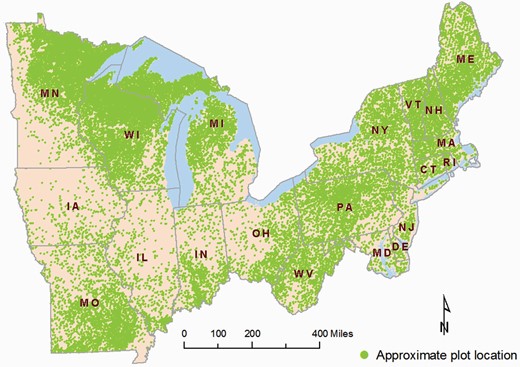
Understanding the Spatial Pattern and Driving Factors Associated with Timberland Ownership Change in the Northern United States
2021
Summary
This study analyzes changes in timberland ownership from 2003 to 2012 across the northern United States based on Forest Inventory and Analysis data identified according to five ownership categories. A total of 26,940 FIA plots that were remeasured between selected years were used for the analysis. Publicly available corporate ownership data were investigated and used to differentiate industrial and institutional (timber investment management organizations [TIMO] and real estate investment trusts [REIT]) ownership.
Key Personnel & Institutions
People: Brett Butler , David Newman , Eddie Bevilacqua , Karun Pandit
Institutions: United States Department of Agriculture (USDA), Forest Service, Northern Research Station , The State University of New York (SUNY), College of Environmental Science and Forestry , University of Florida, School of Forest, Fisheries & Geomatics Sciences
Location
VERMONT, Massachusetts, Maine, New York, New Hampshire, Connecticut, Rhode Island, New England
Resource Type
Article
Tags
No tag keywords available
Topic Tags
conservation, management, ecosystem services, drivers
Purpose Tags
conservation, management
Citation
Pandit K., Bevilacqua E., Newman D. H., Butler B. J., "Understanding the Spatial Pattern and Driving Factors Associated with Timberland Ownership Change in the Northern United States", Journal of Forestry, Volume 119, Issue 4, July 2021, Pages 376–392, https://doi.org/10.1093/jofore/fvab017
Source Link
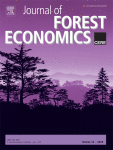
Factors affecting NIPF landowner participation in management programs: a Massachusetts case study
2022
Summary
Conjoint analysis is used to examine landowner attitudes toward specific management program attributes and requirements.
Key Personnel & Institutions
People: Donald Dennis , David Kittredge , Sarah White , H. Stevens Thomas
Institutions: United States Department of Agriculture (USDA), Forest Service, Northeastern Research Station , University of Massachusetts, Department of Natural Resources Conservation, University of Massachusetts, Amherst, Department of Resource Economics
Location
Massachusetts
Resource Type
Article
Tags
No tag keywords available
Topic Tags
conservation, management, ecosystem services, drivers
Purpose Tags
conservation, management, policy
Citation
Thomas H. S., White S., Kittredge D. B., Dennis D., "Factors affecting NIPF landowner participation in management programs: a Massachusetts case study", Journal of Forest Economics, 2002, v. 8, iss. 3, pp. 169-184, https://doi.org/10.1078/1104-6899-00012
Source Link
https://www.sciencedirect.com/science/article/abs/pii/S1104689904700124

Confounding factors in the detection of species responses to habitat fragmentation
2005
Summary
This is a review of the extensive literature on species responses to habitat fragmentation, and detail the numerous ways in which confounding factors have either masked the detection, or prevented the manifestation, of predicted fragmentation effects.
Key Personnel & Institutions
People: Raphael Didham
Institutions: University of Canterbury
Location
VERMONT, Massachusetts, Maine, New York, New Hampshire, Connecticut, Rhode Island, New England
Resource Type
Article
Tags
No tag keywords available
Topic Tags
conservation, wildlife and habitat, landscape pattern and connectivity
Purpose Tags
conservation
Citation
Ewers R. M., Didham R. K., "Confounding factors in the detection of species responses to habitat fragmentation" University of Canterbury, 2005, Accessed from: https://repository.si.edu/bitstream/handle/10088/4079/Ewers_and_Didham_2006.pdf?sequ
Source Link
https://repository.si.edu/bitstream/handle/10088/4079/Ewers_and_Didham_2006.pdf?sequ
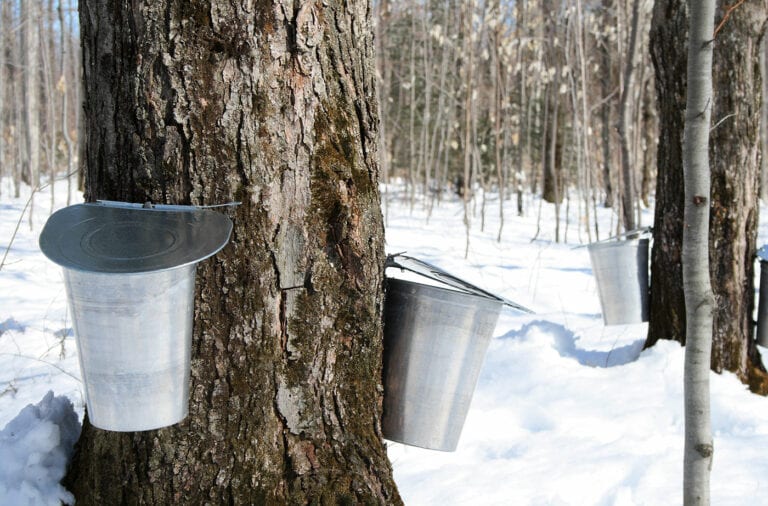
How Climate Change is Impacting Maine's Forests & Industries that Depend on Them
2020
Summary
This article is an overview of the impacts of climate change on many aspects of Maine's forests. These changes are climate, forests and wildlife, global warming, air pollution, etc.
Key Personnel & Institutions
Not available.Location
Maine
Resource Type
Article
Tags
No tag keywords available
Topic Tags
conservation, ecosystem services, drivers, wildlife and habitat
Purpose Tags
conservation
Citation
Strum M., "How Climate Change is Impacting Maine's Forests & Industries that Depend on Them" Forests and Wildlife, 10 September 2020, Accessed from: https://www.nrcm.org/blog/climate-change-impacting-maine-forests/
Source Link
https://www.nrcm.org/blog/climate-change-impacting-maine-forests/
Global Forest Review: Data and Methods
2022
Summary
This page has the data sets, methodology, indicators overview, limitations and definitions of the Global Forest review which provides an independent assessment of the state of the world's forests based on the best available geospatial data and analysis each year.
Key Personnel & Institutions
Not available.Location
No location information available
Resource Type
Poster
Tags
No tag keywords available
Topic Tags
No topic tag keywords available
Purpose Tags
No purpose tag keywords available
Citation
"Data and Methods" Global Forest Review, 2022, Accessed from: https://research.wri.org/gfr/data-methods
Source Link
Global Forest Review: Indicators of Forest Condition
2022
Summary
The Indicators of Forest Condition include Forest Degredation and Forest Recovery. Newly available data provide the first globally consistent understanding of forest integrity, as determined by the degree of anthropogenic modification, and will improve our understanding of forest condition in future editions of the Global Forest Review.
Key Personnel & Institutions
Not available.Location
VERMONT, Massachusetts, Maine, New York, New Hampshire, Connecticut, Rhode Island, New England
Resource Type
Website
Tags
No tag keywords available
Topic Tags
conservation, drivers
Purpose Tags
conservation
Citation
"Indicators of Forest Condition", Global Forest Review, 2022, Accessed from: https://research.wri.org/gfr/forest-condition-indicators
Source Link

CMP Corridor: What it is and why it should be rejected
2021
Summary
This article discusses the cons of the proposed 145 mile long corridor through Maine's North Woods.
Key Personnel & Institutions
People: Karl Honkonen
Location
Maine
Resource Type
Article
Tags
No tag keywords available
Topic Tags
conservation, landscape pattern and connectivity
Purpose Tags
conservation
Citation
Hokkanen K., Spear G., "CMP Corridor: What it is and why it should be rejected"
Source Link
https://www.sierraclub.org/maine/blog/2021/06/cmp-corridor-what-it-and-why-it-should-be-rejected
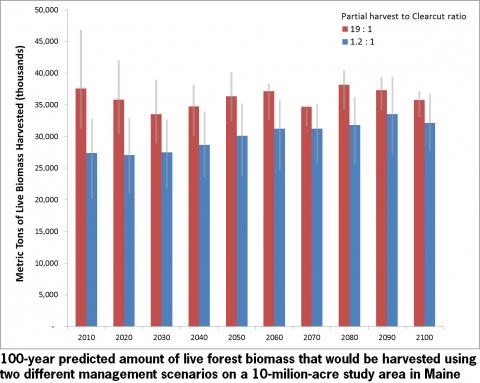
Hundred Year Predicted Benefits of Including Clearcutting in Management of Maine's Forests
2010
Summary
NSRC researchers used the forest landscape computer model LANDIS-II (LANDscape DIsturbance and Succession) to simulate forest conditions for the next 100 years (2010-2110) across 10 million acres of commercial forestland in Maine in predominately spruce-fir forest.
Key Personnel & Institutions
People: Erin Simons-Legaard, Kasey Legaard, Steve Sader
Institutions: United States Department of Agriculture (USDA), Forest Service, Northern Research Station , University of Maine
Location
Maine
Resource Type
Report
Tags
timber
Topic Tags
conservation, management, ecosystem services, drivers
Purpose Tags
conservation, management
Citation
Simons-Legaard E., Legaard K., Sader S., Lister A., Sturtevant B., "Hundred Year Predicted Benefits of Including Clearcutting in Management of Maine's Forests" Northeastern States Research Cooperative, 2010, accessed from: https://nsrcforest.org/project/hundred-year-predicted-benefits-including-clearcutting-management-maines-forests
Source Link
Cumulative Effects of Habitat Change: American Marten Habitat Selection and 30 Years of Forest Harvesting in Maine
1988 to 2019
Summary
This study evaluated the effects of forest composition and patch configuration on patterns of patch-scale habitat selection displayed by American marten (Martes americana) to identify marten responses to the cumulative and multidimensional effects of forest harvesting across a 30-year period (1989-2019).
Key Personnel & Institutions
Institutions: University of Maine
Location
Maine
Resource Type
Report
Tags
No tag keywords available
Topic Tags
ecosystem services, drivers, wildlife and habitat, landscape pattern and connectivity
Purpose Tags
conservation
Citation
Woollard T., "Cumulative Effects of Habitat Change: American Marten Habitat Selection and 30 Years of Forest Harvesting in Maine" University of Maine, 2021, Accessed from: https://digitalcommons.library.umaine.edu/etd/3541/
Source Link
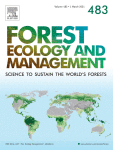
Forest management legacies affect demographics and population dynamics of spruce grouse in northern Maine
2011 to 2018
Summary
Here they studied survival and reproduction of spruce grouse from 2012 through 2018 in north-central Maine, USA, within a landscape managed extensively for commercial forest products.
Key Personnel & Institutions
People: Steve Dunham , Daniel Harrison
Institutions: University of Maine
Location
Maine
Resource Type
Report
Tags
No tag keywords available
Topic Tags
conservation, management, drivers, wildlife and habitat, landscape pattern and connectivity
Purpose Tags
conservation, management
Citation
Blomberg E. J., Tebbenkamp J., Dunham S., Harrison D., "Forest management legacies affect demographics and population dynamics of spruce grouse in northern Maine", Forest Ecology Management, v. 483, 1 March 2021, 118898, https://doi.org/10.1016/j.foreco.2020.118898
Source Link
https://www.sciencedirect.com/science/article/abs/pii/S0378112720316674
How well do proxy species models inform conservation of surrogate species?
2021
Summary
This study evaluated the North Atlantic Landscape Conservation Cooperative (NALCC) proxy models of LC and represented species framework across 13 states in the northeastern United States from Virginia to Maine. It validated a suite of questions related to co-occurrence of proxy and represented species with a compilation of independent datasets.
Key Personnel & Institutions
People: Scott Schwenk , Daniel Harrison, Cynthia Loftin, Petra Wood , Zachary G. Loman , William V. Deluca
Institutions: University of Maine , University of Massachusetts Amherst , Maine Cooperative Fish and Wildlife Research Unit, Maine Department of Wildlife, Fisheries, and Conservation Biology , West Virginia University, West Virginia Cooperative Fish and Wildlife Research Unit
Location
VERMONT, Massachusetts, Maine, New York, New Hampshire, Connecticut, Rhode Island, New England
Resource Type
Article
Tags
No tag keywords available
Topic Tags
conservation, wildlife and habitat, landscape pattern and connectivity
Purpose Tags
conservation
Citation
Loman Z.G., Deluca W.V., Harrison D.J. et al. "How well do proxy species models inform conservation of surrogate species?". Landscape Ecol 36, 2863–2877 (2021). https://doi.org/10.1007/s10980-021-01294-8
Source Link
https://link.springer.com/article/10.1007/s10980-021-01294-8
Anthropogenic Disturbances and the Emergence of Native Diseases: a Threat to Forest Health
2022
Summary
This review focuses on complex tree diseases (declines) caused by native pathogens and the key environmental drivers that contribute to this phenomenon. These systems are frequently complex, with multiple drivers at work.
Key Personnel & Institutions
Institutions: University of Canterbury
Location
VERMONT, Massachusetts, Maine, New York, New Hampshire, Connecticut, Rhode Island, New England
Resource Type
Article
Tags
No tag keywords available
Topic Tags
conservation, drivers
Purpose Tags
conservation
Citation
Burgess T.I., Oliva J., Sapsford S.J. et al. "Anthropogenic Disturbances and the Emergence of Native Diseases: a Threat to Forest Health". Curr Forestry Rep 8, 111–123 (2022). https://doi.org/10.1007/s40725-022-00163-0
Source Link
https://link.springer.com/article/10.1007/s40725-022-00163-0

State-level forestry policies across the US: Discourses reflecting the tension between private property rights and public trust resources
2022
Summary
This analysis created a typology of categories that express assumptions about landowner behavior and the appropriate role of state intervention. The typology identifies four discourse categories used to varying degrees within each state: landowner stewardship, forestry expert stewardship, science-bureaucracy, and participatory conservation. This typology allows for comparison of policy approaches and comparison across resources and jurisdictions.
Key Personnel & Institutions
People: Mindy S. Crandall
Institutions: Oregon State University
Location
VERMONT, Massachusetts, Maine, New York, New Hampshire, Connecticut, Rhode Island, New England
Resource Type
Report
Tags
No tag keywords available
Topic Tags
conservation, management, drivers, landscape pattern and connectivity
Purpose Tags
conservation, policy
Citation
Kelly E. C., Crandall M. S., "State-level forestry policies across the US: Discourses reflecting the tension between private property rights and public trust resources", Forest Policy and Economics, v. 141, August 2022, 102757, https://doi.org/10.1016/j.forpol.2022.102757
Source Link
https://www.sciencedirect.com/science/article/pii/S1389934122000697
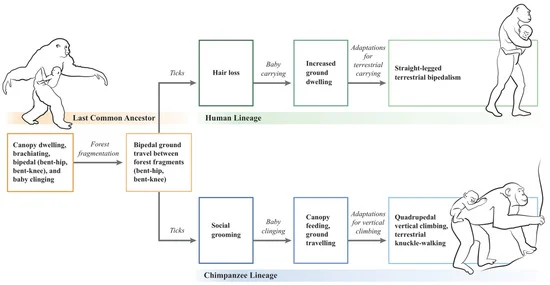
Ticks, Hair Loss, and Non-Clinging Babies: A Novel Tick-Based Hypothesis for the Evolutionary Divergence of Humans and Chimpanzees
2021
Summary
The aim of this review is to propose and evaluate a novel tick-based evolutionary hypothesis wherein forest fragmentation in hominin paleoenvironments created conditions that were favourable for tick proliferation, selecting for hair loss in hominins and grooming behaviour in chimpanzees as divergent anti-tick strategies. It is argued that these divergent anti-tick strategies resulted in different methods for carrying babies, driving the locomotor divergence of humans and chimpanzees.
Key Personnel & Institutions
Not available.Location
VERMONT, Massachusetts, Maine, New York, New Hampshire, Connecticut, Rhode Island, New England
Resource Type
Article
Tags
No tag keywords available
Topic Tags
drivers, wildlife and habitat
Purpose Tags
education
Citation
Brown J.G., "Ticks, Hair Loss, and Non-Clinging Babies: A Novel Tick-Based Hypothesis for the Evolutionary Divergence of Humans and Chimpanzees." Life 2021, 11, 435. https://doi.org/10.3390/life11050435
Source Link
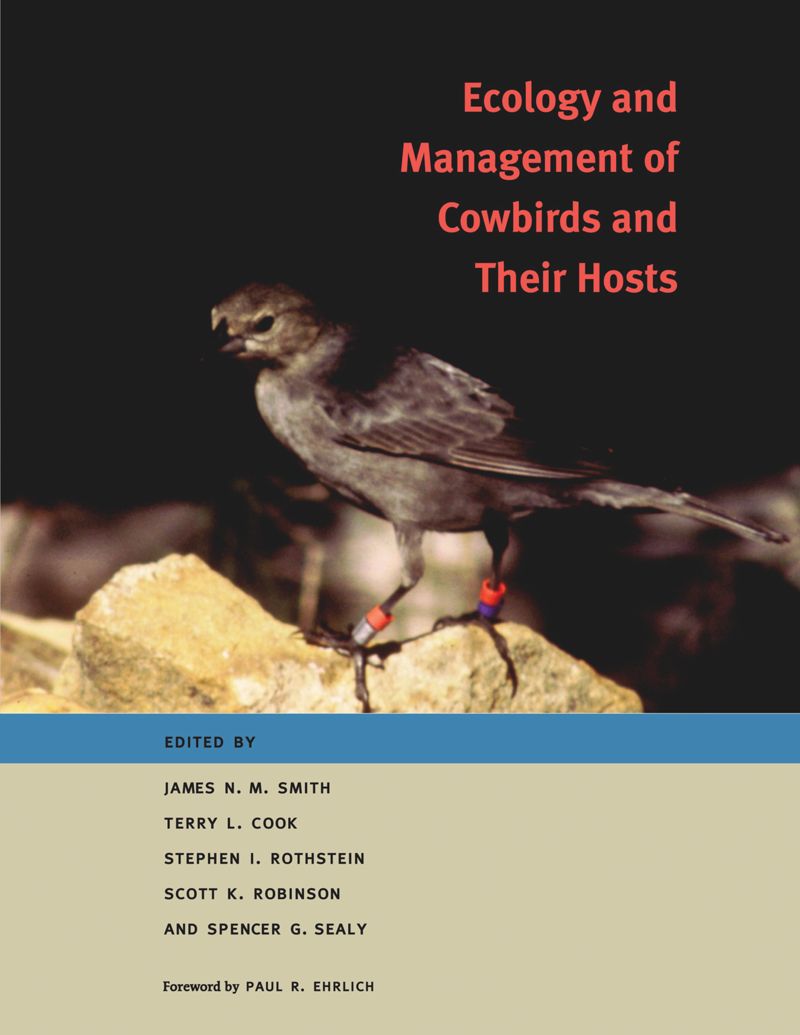
Ecology and Management of Cowbirds and Their Hosts
2000
Summary
This timely book collects forty essays by most of the principal authorities on the biology and management of cowbirds. The book's goals are to explore the biology of cowbirds, the threats they pose to host species and populations, and the management programs that are being undertaken to minimize these threats.
Key Personnel & Institutions
People: Scott K. Robinson
Location
VERMONT, Massachusetts, Maine, New York, New Hampshire, Connecticut, Rhode Island, New England
Resource Type
Book
Tags
No tag keywords available
Topic Tags
conservation, drivers, wildlife and habitat
Purpose Tags
conservation
Citation
Smith J. N. M., Cook T. L., Rothstein S. I., Robinson S. K., Sealy S. G., "Ecology and Management of Cowbirds and Their Hosts: Studies in the Conservation of North American Passerine Birds", University of Texas Press, 2000, https://doi.org/10.7560/777385
Source Link
https://www.degruyter.com/document/doi/10.7560/777385/html#contents
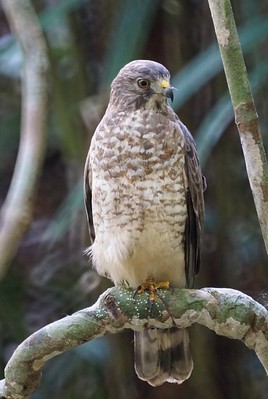
Range contractions of the Broad-winged Hawk in the Northeast United States
2021
Summary
The Broad-winged Hawk (BWHA, Buteo platypterus) is a small, secretive hawk with distinguishing broad black tail bands that breeds in northeastern North America. The hawk nests in deciduous or mixed forest, often near water, and close to clearings or forest edges. Land conversion and fragmentation alters the landscape and reduces the area of contiguous forest used by BWHA. This study seeks to determine the landscape characteristics influencing the apparent breeding range declines of the BWHA at the landscape scale.
Key Personnel & Institutions
Not available.Location
VERMONT, Massachusetts, Maine, New York, New Hampshire, Connecticut, Rhode Island, New England
Resource Type
Article
Tags
No tag keywords available
Topic Tags
conservation, wildlife and habitat, landscape pattern and connectivity
Purpose Tags
conservation
Citation
Pruitt R., Goodrich L., Shumar M. B., Wilson A. M., "Range contractions of the Broad-winged Hawk in the Northeast United States", 8 October 2021, https://doi.org/10.1101/2021.10.06.463411
Source Link
https://www.biorxiv.org/content/10.1101/2021.10.06.463411v1.abstract
Trends in Bark Beetle Impacts in North America During a Period (2000–2020) of Rapid Environmental Change
2022
Summary
This article reviews tools and tactics available for bark beetle suppression and prevention and provide an overview of temporal and spatial trends in bark beetle impacts in North American forests during 2000–2020.
Key Personnel & Institutions
Institutions: United States Department of Agriculture (USDA), Forest Service, Forest Health Protection , The University of Georgia, Warnell School of Forestry and Natural Resources
Location
VERMONT, Massachusetts, Maine, New York, New Hampshire, Connecticut, Rhode Island, New England
Resource Type
Article
Tags
No tag keywords available
Topic Tags
conservation, drivers, wildlife and habitat
Purpose Tags
conservation
Citation
Fettig C. J., Asaro C., Nowak J. T., Dodds K. J., Gandhi K. J. K., Moan J. E., Robert J., "Trends in Bark Beetle Impacts in North America During a Period (2000–2020) of Rapid Environmental Change", Journal of Forestry, 22 July 2022, https://doi.org/10.1093/jofore/fvac021
Source Link
https://academic.oup.com/jof/advance-article/doi/10.1093/jofore/fvac021/6648424
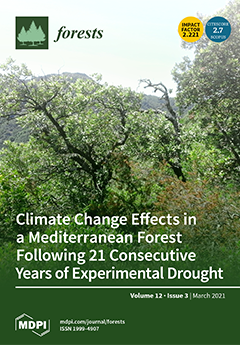
Place Attachment and Concern in Relation to Family Forest Landowner Behavior
2021
Summary
Contemporary approaches to studying family forests have identified distinct subgroups of landowners through segmentation analysis. This study expands on this approach, incorporating the concept of place to provide a novel perspective on how the cognition and emotions that create place attachment and landowner concerns influence certain landowner behaviors. We specifically modeled legacy planning and future landowner ownership behavioral intentions/behaviors.
Key Personnel & Institutions
People: Jessica Leahy
Institutions: University of Maine, School of Forest Resources
Location
Maine
Resource Type
Article
Tags
No tag keywords available
Topic Tags
conservation, management, landscape pattern and connectivity
Purpose Tags
conservation, management
Citation
Leahy J., Lyons P., "Place Attachment and Concern in Relation to Family Forest Landowner Behavior", Forests, 3 March 2021, https://doi.org/10.3390/f12030295
Source Link
Forest-associated bee species persist amid forest loss and regrowth in eastern North America
2021
Summary
This study examined the effects of forest loss and regrowth on bee pollinators in eastern North America using three datasets totaling 36,605 individual specimens.
Key Personnel & Institutions
People: Colleen Smith
Institutions: Rutgers University, University of Ottawa
Location
VERMONT, Massachusetts, Maine, New York, New Hampshire, Connecticut, Rhode Island, New England
Resource Type
Article
Tags
No tag keywords available
Topic Tags
conservation, ecosystem services, drivers, wildlife and habitat, landscape pattern and connectivity
Purpose Tags
conservation
Citation
Smith C., Harrison T., Gardner J., Winfree R., "Forest-associated bee species persist amid forest loss and regrowth in eastern North America", August 2021, v. 260, 109202. https://doi.org/10.1016/j.biocon.2021.109202
Source Link
Effects of Forest Patch Size and Shape on Breeding Bird Species Richness
2022
Summary
This study assesses the effect of forest fragmentation on breeding bird communities in Burlington, Vermont, USA.
Key Personnel & Institutions
Institutions: University of Vermont
Location
BURLINGTON
Resource Type
Article
Tags
No tag keywords available
Topic Tags
conservation, drivers, wildlife and habitat, landscape pattern and connectivity
Purpose Tags
conservation
Citation
Spindel J. M., "Effects of Forest Patch Size and Shape on Breeding Bird Species Richness", University of Vermont, 2022, Accessed from: https://scholarworks.uvm.edu/hcoltheses/502/
Source Link
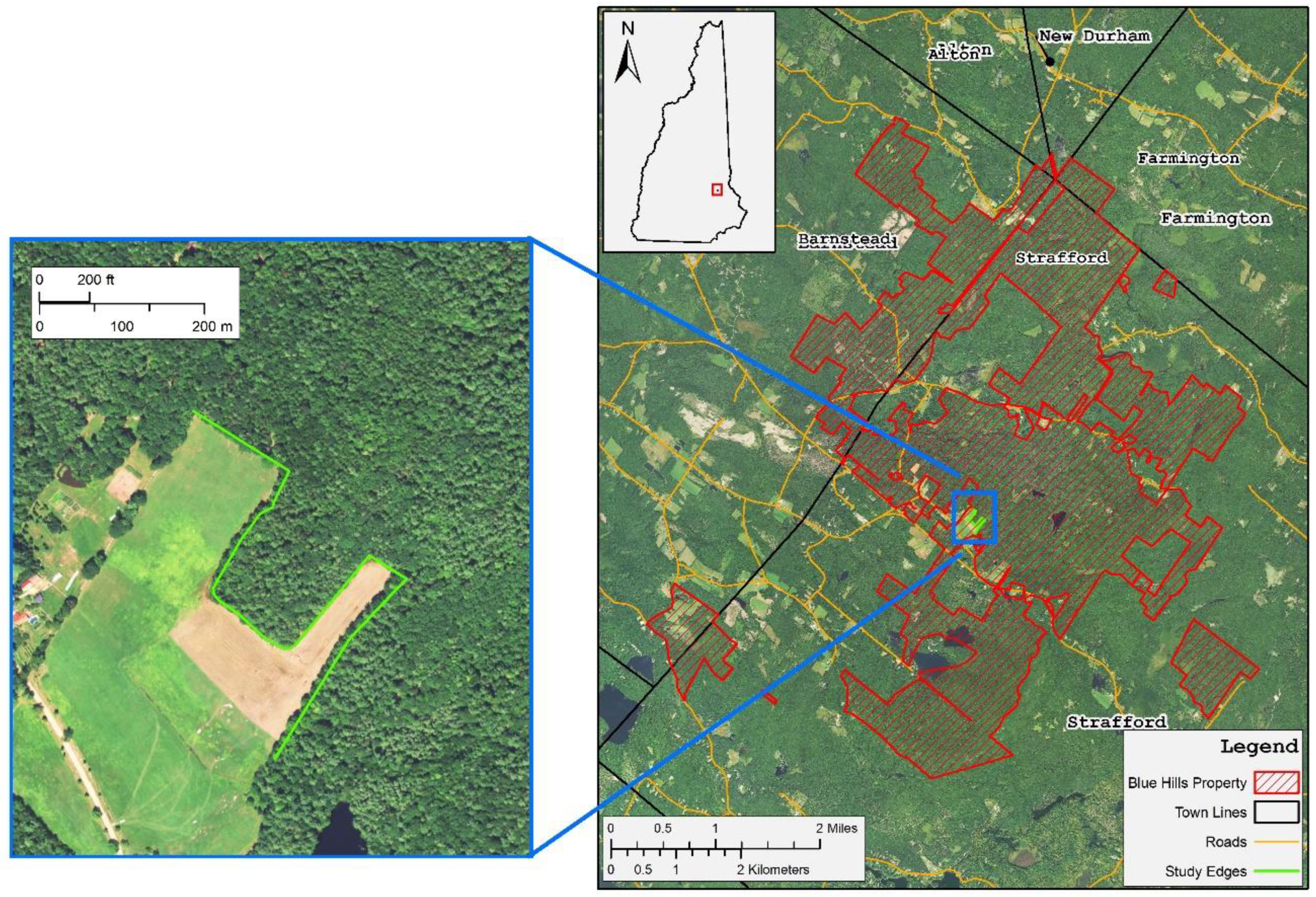
Evaluating the Capability of Unmanned Aerial System (UAS) Imagery to Detect and Measure the Effects of Edge Influence on Forest Canopy Cover in New England
2021
Summary
This study is a preliminary attempt to utilize UAS imagery to detect changes in canopy cover, known to exhibit changes due to edge influences, across forest edges in a New England forest.
Key Personnel & Institutions
People: Russell J Congalton
Institutions: University of New Hampshire, Department of Natural Resources and the Environment
Location
VERMONT, Massachusetts, Maine, New York, New Hampshire, Connecticut, Rhode Island, New England
Resource Type
Article
Tags
No tag keywords available
Topic Tags
conservation, landscape pattern and connectivity
Purpose Tags
conservation
Citation
Grybas H., Congalton R. G., "Evaluating the Capability of Unmanned Aerial System (UAS) Imagery to Detect and Measure the Effects of Edge Influence on Forest Canopy Cover in New England", Forests, 15 September 2021, 12(9), 1252, https://doi.org/10.3390/f12091252
Source Link
Assessing the Migration System of New Hampshire and Vermont's Connecticut River Valley: Impacts on Ecology and Social Systems from Human Migration and Public Desire
2021
Summary
This report, the second in a three part series, identifies the impacts of migration patterns within the towns on the Connecticut River in New Hampshire and Vermont. Terrestrial impacts from development and urbanization include fragmentation and sprawl, increased impervious surface, runoff, and flooding, loss of biodiversity and forests, disruption of nutrient cycles and weakened climate resiliency. Watershed impacts include a disrupted hydrological cycle, loss of biodiversity and aquatic habitat, degraded water quality, loss of recreational opportunity, and water scarcity
Key Personnel & Institutions
Not available.Location
VERMONT, New Hampshire
Resource Type
Article
Tags
No tag keywords available
Topic Tags
conservation, drivers, wildlife and habitat, landscape pattern and connectivity
Purpose Tags
conservation
Citation
Sylvia M., Corvus J., "Assessing the Migration System of New Hampshire and Vermont's Connecticut River Valley: Impacts on Ecology and Social Systems from Human Migration and Public Desire", 30 April, 2021, Accessed from: https://www.communityresilience-center.org/wp-content/uploads/2021/09/CRV_Migration-Impacts.pdf
Source Link
https://www.communityresilience-center.org/wp-content/uploads/2021/09/CRV_Migration-Impacts.pdf
Assessing the Migration System of New Hampshire and Vermont's Connecticut River Valley: Migration Trends, Evidence, and Indicators
2021
Summary
With a focus on implementing the responses necessary to safeguard a resilient social, environmental, and economic system, this report examines the newest analysis of migration trends and population projections influencing the migration system of New Hampshire and Vermont's Connecticut River towns.
Key Personnel & Institutions
Not available.Location
VERMONT, New Hampshire
Resource Type
Report
Tags
No tag keywords available
Topic Tags
conservation, drivers, wildlife and habitat, landscape pattern and connectivity
Purpose Tags
conservation
Citation
Sylvia M., Corvus J., "Assessing the Migration System of New Hampshire and Vermont's Connecticut River Valley: Migration Trends, Evidence, and Indicators", 30 April, 2021, Accessed from: https://www.communityresilience-center.org/wp-content/uploads/2021/09/CRV_Migration-Impacts.pdf
Source Link
https://communityresilience-center.org/wp-content/uploads/2021/09/CRV_Migration_Trends.pdf
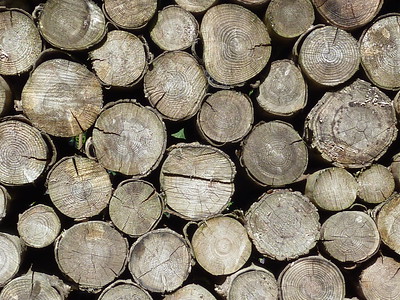
Avian Richness Increases following Group-Selection Timber Harvests in West-Central New Hampshire
2021
Summary
Following timber harvests, this study observed changes in avian richness and abundance and vegetation structure at both sites compared to preharvest conditions. It also documented differences in arthropod diversity and habitat usage of 6 target songbird species at the Canaan, NH site 8- and 9-years after harvest.
Key Personnel & Institutions
Institutions: Plymouth State University
Location
Canaan
Resource Type
Article
Tags
No tag keywords available
Topic Tags
conservation, management, ecosystem services, drivers, wildlife and habitat, landscape pattern and connectivity
Purpose Tags
conservation, management
Citation
Reitsma L., "Avian richness increases following group-selection timber harvests in west-central New Hampshire", 27 April, 2021, Accessed from: https://www.proquest.com/openview/73569ff6b02c123e547c7d86832feca3/1?pq-origsite=gscholar&cbl=18750&diss=y
Source Link
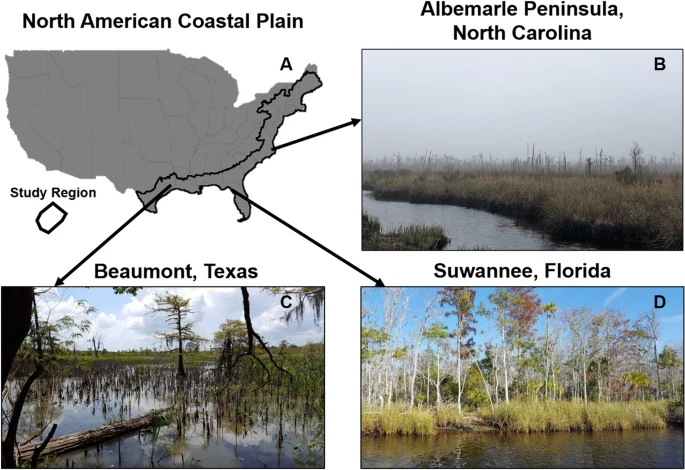
Climate Change Driving Widespread Loss of Coastal Forested Wetlands Throughout the North American Coastal Plain
2021
Summary
This study used classified satellite imagery to document a net loss of?~?13,682 km2 (8%) of forested coastal wetlands across the NACP between 1996 and 2016. Most forests transitioned to scrub-shrub (53%) and marsh habitats (24%). Even within protected areas, they measured substantial rates of wetland deforestation and significant fragmentation of forested wetland habitats.
Key Personnel & Institutions
People: Elliott E. White , Emily A. Ury , Emily S. Bernhardt , Xi Yang
Institutions: Duke University, Department of Biology, University of Virginia, Department of Environmental Sciences
Location
VERMONT, Massachusetts, Maine, New York, New Hampshire, Connecticut, Rhode Island, New England
Resource Type
Article
Tags
No tag keywords available
Topic Tags
conservation, ecosystem services, drivers, landscape pattern and connectivity
Purpose Tags
conservation
Citation
White E.E., Ury E.A., Bernhardt E.S. et al. "Climate Change Driving Widespread Loss of Coastal Forested Wetlands Throughout the North American Coastal Plain". Ecosystems 25, 812–827 (2022). https://doi.org/10.1007/s10021-021-00686-w
Source Link
https://link.springer.com/article/10.1007/s10021-021-00686-w

Large-Scale Manipulative Experiments
2022
Summary
This chapter provides an overview of manipulative experiments conducted at spatial extents of 15 ha or larger in forest, grassland, and aquatic systems. They compare and contrast experiments from around the world, illustrating how the researchers have addressed issues of control, replication and randomization, with replication as the biggest challenge with this kind of experiment. They also discuss advantages and disadvantages of large-scale manipulative experiments, and offer recommendations for researchers considering embarking on large-scale manipulative experiments.
Key Personnel & Institutions
Not available.Location
VERMONT, Massachusetts, Maine, New York, New Hampshire, Connecticut, Rhode Island, New England
Resource Type
Article
Tags
No tag keywords available
Topic Tags
conservation, methods, landscape pattern and connectivity
Purpose Tags
conservation, education
Citation
Wiersma Y. F., "Large-Scale Manipulative Experiments", Experimental Landscape Ecology, Landscape series, 2022, v. 29pp. 73-90, Springer, Cham. https://doi.org/10.1007/978-3-030-95189-4_6
Source Link
https://link.springer.com/chapter/10.1007/978-3-030-95189-4_6
New Hampshire's Coastal Watershed Conservation Plan
2021
Summary
New Hampshire's Coastal Watershed Conservation Plan identifies key conservation priorities across the lands in New Hampshire, Maine, and Massachusetts that drain to the Atlantic Ocean via the Piscataqua River and through the Hampton-Seabrook Estuary.
Key Personnel & Institutions
People: Peter Steckler
Institutions: The Nature Conservancy, New Hampshire Chapter
Location
New Hampshire
Resource Type
Report
Tags
No tag keywords available
Topic Tags
conservation, management, ecosystem services, wildlife and habitat
Purpose Tags
conservation, management
Citation
Steckler P., Ormiston A., "New Hampshire's Coastal Watershed Conservation Plan", 30 June 2021, accessed from: http://www.greatbaypartnership.org/wp-content/uploads/NH-Coastal-Watershed-Conservation-Plan-20210630.pdf
Source Link
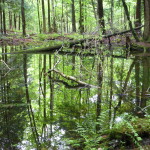
Unfragmented Forest and Natural Habitat
2016
Summary
The goad of the Upper Valley Land Trust is to support the working forest economy and connect the places plants and animals need to adapt and thrive.
Key Personnel & Institutions
Not available.Location
New Hampshire
Resource Type
Website
Tags
No tag keywords available
Topic Tags
conservation, ecosystem services, drivers, wildlife and habitat, landscape pattern and connectivity
Purpose Tags
conservation, management
Citation
"Unfragmented Forest and Natural Habitat" Upper Valley Land Trust, 2016, Accessed from: https://uvlt.org/our-strategic-goals/unfragmented-forest-natural-habitat/
Source Link
https://uvlt.org/our-strategic-goals/unfragmented-forest-natural-habitat/
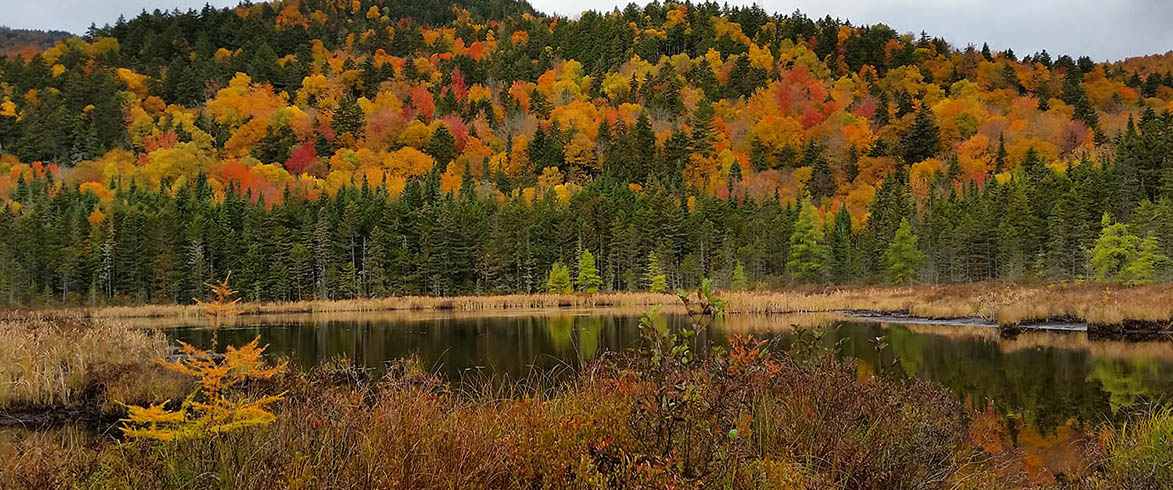
New Hampshire Forest Statistics
2012
Summary
This report is from USDA Forest Service, Northeastern Research Station RB-NRS-95 Forests of Vermont and New Hampshire 2012: jointly authored with the Division of Forests and Lands.
Key Personnel & Institutions
Institutions: United States Department of Agriculture (USDA), Forest Service, Northeastern Research Station
Location
New Hampshire
Resource Type
Report
Tags
No tag keywords available
Topic Tags
conservation, management, ecosystem services, drivers
Purpose Tags
conservation, management
Citation
"New Hampshire Forest Statistics" USDA Forest Service, Northeastern Research Station, Division of Forests and Lands, 2012, Accessed from: https://www.nh.gov/nhdfl/reports/forest-statistics.htm
Source Link
Taking Action for Wildlife: Identify and Protect Wildlife Corridors
2022
Summary
This article communicates the importance of keeping habitats connected and examples of actions that can be taken to help protect wildlife corridors.
Key Personnel & Institutions
Institutions: University of New Hampshire
Location
New Hampshire
Resource Type
Article
Tags
No tag keywords available
Topic Tags
conservation, management, wildlife and habitat, landscape pattern and connectivity
Purpose Tags
conservation, management, education
Citation
"Taking Action for Wildlife: Identify and Protect Wildlife Corridors", University of New Hampshire, 2022, Accessed from: https://www.takingactionforwildlife.org/resource/identify-protect-wildlife-corridors
Source Link
https://www.takingactionforwildlife.org/resource/identify-protect-wildlife-corridors
Town of Newbury, New Hampshire Townwide Conservation Plan
2008
Summary
In 2001, the Newbury Conservation Commission prepared an "index" or inventory of natural resources for the town as mandated by RSA 36-A:2. As permitted by that statute and as recommended in the Newbury Natural Resources Inventory (NRI), the Commission undertook a two-year project to update the NRI and create a townwide conservation plan.
Key Personnel & Institutions
Not available.Location
Newbury
Resource Type
Report
Tags
No tag keywords available
Topic Tags
conservation, methods, management, ecosystem services, planning, wildlife and habitat, landscape pattern and connectivity
Purpose Tags
conservation, management
Citation
Poole E. A., M.Sc., "Town of Newbury, New Hampshire Townwide Conservation Plan", Newbury Conservation Commission, March 2008, Accessed from: https://www.newburynh.org/sites/g/files/vyhlif4761/f/uploads/12-appendix_b-_2007_conservation_plan_4-1-08.pdf
Source Link
New Hampshire Forest Resources Plan Revision -- Assessment 2010
2010
Summary
This Assessment Report is essentially a background paper designed to provide the best information available about the status of New Hampshire's forests to facilitate a revision to the Plan with input from many stake holder groups.
Key Personnel & Institutions
Not available.Location
New Hampshire
Resource Type
Report
Tags
No tag keywords available
Topic Tags
conservation, methods, management, planning, drivers
Purpose Tags
conservation, management
Citation
"New Hampshire Forest Resources Plan Revision - Assessment 2010", 2010, Accessed from: https://indicators.ucdavis.edu/catalog/frameworks/new-hampshire-forest-resources-plan-revision-assessment-2010
Source Link

Unmanned Aerial Systems (UAS) As a Tool For Investigating Edge Influences in New Hampshire Forests
2021
Summary
This research investigated the impacts of UAS flight parameters on the accuracy of canopy height estimates made from UAS data by comparing UAS estimates across twelve combinations of flying height and image overlap to ground measured canopy height.
Key Personnel & Institutions
Institutions: University of New Hampshire
Location
New Hampshire, New England
Resource Type
Report
Tags
No tag keywords available
Topic Tags
conservation, methods, drivers, landscape pattern and connectivity
Purpose Tags
conservation
Citation
Grybas H., "Unmanned Aerial Systems (UAS) As a Tool for Investigating Edge Influences in New Hampshire Forests", University of New Hampshire, December 2021, Accessed from: https://www.proquest.com/openview/436c881c8fa2c2b22a841449a280c0f8/1?pq-origsite=gscholar&cbl=18750&diss=y
Source Link
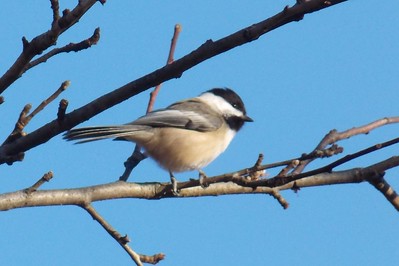
Application of Remote Sensing in Gathering Avian Data in the Wild in Order to Delineate Conservation Strategies
2022
Summary
Information on climate tendencies is essential for the powerful assurance of risked avian species. At present events, fake turbulences impacts influence the conditions. Perpetual undertakings of bounty appearances are impacting the scatterings of various sorts of birds similar to other faunal species. The time has come to get notice of such effects and find judicious ways to actually look at them. To characterize insurance procedures, it is uncommonly pressing to have every one of the information about the avian assortment present close by. For certain species, especially those living in distant locales, we by and by miss the mark on this information. Regardless, time and money-related resources for taking apart normal environmental elements use are limited.
Key Personnel & Institutions
Not available.Location
VERMONT, Massachusetts, Maine, New York, New Hampshire, Connecticut, Rhode Island, New England
Resource Type
Article
Tags
No tag keywords available
Topic Tags
conservation, ecosystem services, drivers, wildlife and habitat
Purpose Tags
conservation
Citation
Dubey S., Pant H., Malviya S. J., Kushwaha P., "Application of Remote Sensing in Gathering Avian Data in the Wild in Order to Delineate Conservation Strategies", Geospatial Technology and its Applications in Resource Management, Chapter 22, pp. 245-262, Accessed from: https://www.researchgate.net/profile/Hemlata-Pant-3/publication/363262975_Application_of_Remote_Sensing_in_Gathering_Avian_Data_in_the_Wild_in_Order_to_Delineate_Conservation_Strategies/links/63144d4c5eed5e4bd145885e/Application-of-Remote-Sensing-in-Gathering-Avian-Data-in-the-Wild-in-Order-to-Delineate-Conservation-Strategies.pdf
Source Link
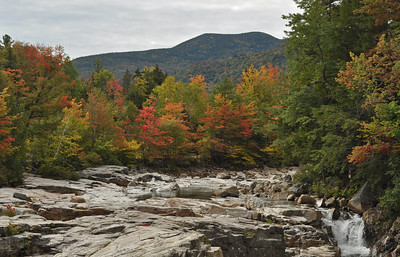
U.S. Family Forest Owners' Forest Management for Climate Adaptation: Perspectives From Extension and Outreach Specialists
2022
Summary
This study sought to understand perceptions among family forest specialists of: climate impacts and adaptation options across different forested US regions; how family forest owners are taking climate adaptation into consideration in their forest management, if at all; and major barriers to more active management for adaptation among family forest owners.
Key Personnel & Institutions
People: Courtney Schultz
Location
VERMONT, Massachusetts, Maine, New York, New Hampshire, Connecticut, Rhode Island, New England
Resource Type
Article
Tags
No tag keywords available
Topic Tags
conservation, management, ecosystem services, planning, landscape pattern and connectivity
Purpose Tags
conservation, management
Citation
vonHedemann N., Schultz C. A., "U.S. Family Forest Owners' Forest Management for Climate Adaptation: Perspectives From Extension and Outreach Specialists", Frontiers in Climate, 14 October 2021, vol. 3, issn 2624-9553, Accessed from: https://par.nsf.gov/biblio/10339178
Source Link
Forest Fragmentation and Nest Predation: Are Experiments with Japanese Quail Eggs Misleading?
1995
Summary
The evidence that fragmentation of forests in eastern North America increases rates of nest predation based on the results of experiments in which artificial nests baited with Japanese Quail eggs are used to compare rates of predation in fragments of different sizes. The lack of parental and nestling activity and the potentially unnatural positioning and appearance of artificial nests complicates the interpretation of artificial nest experiments. This paper discusses wheather quail-egg experiments are an appropriate tool for investigating among fragment differences in the rate of predation on Neotropical migrant bird nests.
Key Personnel & Institutions
People: David G. Haskell
Location
VERMONT, Massachusetts, Maine, New York, New Hampshire, Connecticut, Rhode Island, New England
Resource Type
Article
Tags
No tag keywords available
Topic Tags
conservation, methods, drivers, wildlife and habitat
Purpose Tags
conservation
Citation
Haskell D. G., "Forest Fragmentation and Nest Predation: Are Experiments with Japanese Quail Eggs Misleading?", The Auk, July 1995, v. 112, no. 3, pp. 767-770, https://www.jstor.org/stable/4088694
Source Link
The Relevance of Forest Fragmentation on the Incidence of Human Babesiosis: Investigating the Landscape Epidemiology of an Emerging Tick-Borne Disease
2013
Summary
Babesiosis is an emerging arthropod-borne infection that has been increasing in incidence for the last decade in the northeastern United States. Babesiosis may share features of its landscape epidemiology with other arthropod-borne infections transmitted by the same tick vectors in similar geographic spaces. This study examined 11 years of surveillance data in New York State to measure the relationship between forest fragmentation and the incidence of human babesiosis.
Key Personnel & Institutions
People: Michael Walsh
Location
New York
Resource Type
Article
Tags
No tag keywords available
Topic Tags
drivers, wildlife and habitat, landscape pattern and connectivity
Purpose Tags
education
Citation
Walsh M. G., "The Relevance of Forest Fragmentation on the Incidence of Human Babesiosis: Investigating the Landscape Epidemiology of an Emerging Tick-Borne Disease", 27 March 2013, v. 13, no. 4, https://doi.org/10.1089/vbz.2012.1198
Source Link

Forest fragmentation and ecosystem function
2013
Summary
Urbanization and the spread of agriculture have resulted in high levels of forest loss and fragmentation in many regions of the world. The impact of this anthropogenic fragmentation on ecological functioning has been poorly studied. This chapter assesses the responses of selected plant- and animal-mediated processes to forest fragmentation.
Key Personnel & Institutions
Not available.Location
VERMONT, Massachusetts, Maine, New York, New Hampshire, Connecticut, Rhode Island, New England
Resource Type
Article
Tags
No tag keywords available
Topic Tags
conservation, wildlife and habitat, landscape pattern and connectivity
Purpose Tags
conservation
Citation
Peh K. S. H., YangChen L., Luke S. H., Foster W. A., Turner E. C., "Forest Fragmentation and Ecosystem Services", 1 January 2014, https://doi.org/10.1079/9781780642031.009
Source Link
https://cabidigitallibrary.org/doi/abs/10.1079/9781780642031.0096
Sustainable Ecological Systems: Implementing an Ecological Approach to Land Management
1993
Summary
This conference brought together scientists and managers from federal, state and local agencies, along with private-sector interests to examine key concepts involving sustainable ecological systems and ways in which to apply these concepts to ecosystem management. Session topics were: ecological consequenses of land and water use changes, biology of rare and declining species and habitats, conservation biology and restoration ecology, developing and applying ecological theory to management of ecological systems, sustainable ecosystems and forest health, and sustainable ecosystems to respond to human needs. A plenary session established the philosophical and historical contexts for ecosystem management.
Key Personnel & Institutions
Not available.Location
VERMONT, Massachusetts, Maine, New York, New Hampshire, Connecticut, Rhode Island, New England
Resource Type
Book
Tags
No tag keywords available
Topic Tags
conservation, methods, management, landscape pattern and connectivity
Purpose Tags
conservation, management
Citation
Covington W. W., DeBano L. F., "Sustainable Ecological Systems: Implementing an Ecological Approach to Land Management", 12-15 July 1993, Accessed From: https://books.google.com/books?hl=en&lr=&id=RRqHo7br_L4C&oi=fnd&pg=PA85&dq=forest+fragmentation+new+york&ots=f31o8FtREe&sig=gzEKjbyoq-RiwBIJ16FUxXEnFGo#v=onepage&q=forest fragmentation new york&f=false
Source Link

New York Conservation Summary
2022
Summary
While the name New York is often equated with the concrete jungle of New York City, looking beyond the Big Apple reveals a remarkable diversity of natural communities and habitats throughout the state. The interplay of climate and geologic forces over millions of years has crafted the landscape into a complex array of bedrock, surficial geology, soils, landforms, and topography. These varied physical settings and their associated ecological processes support the wonderful richness of plants and animals that live in New York (State!) today.
Key Personnel & Institutions
Not available.Location
New York
Resource Type
Article
Tags
No tag keywords available
Topic Tags
conservation, methods, management, drivers, wildlife and habitat
Purpose Tags
conservation, management
Citation
"New York Conservation Summary", 2022, Accessed from: http://www.landscope.org/new-york/overview/
Source Link
Scaling up Payments for Watershed Services: Recommendations for Increasing Participation in Watershed Conservation Among Non-Industrial Private Forest Landowners in the Sebago Lake Watershed, Maine
2012
Summary
This report seeks to inform the development of a PWS program in Southeast Maine by examining the system of incentives needed to encourage private forest owners to adopt conservation best management practices that enhance water quality downstream.
Key Personnel & Institutions
Institutions: The University of Michigan
Location
Sebago, Maine
Resource Type
Report
Tags
No tag keywords available
Topic Tags
conservation, methods, management
Purpose Tags
conservation, management
Citation
Cantor D., Fay C., Harrison M., Levine E., Zwicke C., "Scaling up Payments for Watershed Services: Recommendations for Increasing Participation in Watershed Conservation Among Non-Industrial Private Forest Landowners in the Sebago Lake Watershed, Maine", April 2012, Accessed from: https://deepblue.lib.umich.edu/handle/2027.42/90874
Source Link
Are the Economics of a Sustainable Maine Forest Sustainable?
2007
Summary
Mike LeVert, Charles Colgan and Charles Lawton discuss the transformation of the economic environment of Maine's forests over the past two decades. Paper companies have sold most of their holdings; residential and conservation demand for land has increased; forestland prices have skyrocketed; and new classes of landowners have different strategies, objectives, and time horizons than the old industrial landowners. The authors believe that management of Maine's forests must now address changes in the economic environment with the same intensity as threats such as the spruce budworm were addressed if we are to keep Maine's forests as forests.
Key Personnel & Institutions
People: Mike LeVert , Charles Lawton
Institutions: Maine State Planning Office
Location
Maine
Resource Type
Article
Tags
No tag keywords available
Topic Tags
conservation, management, drivers
Purpose Tags
conservation, management
Citation
LeVert M., Colgan C. S., Lawton C., "Are the Economics of a Sustainable Maine Forest Sustainable?", Maine Policy Review 16.2 (2007) : 26 -36, https://digitalcommons.library.umaine.edu/mpr/vol16/iss2/5.
Source Link
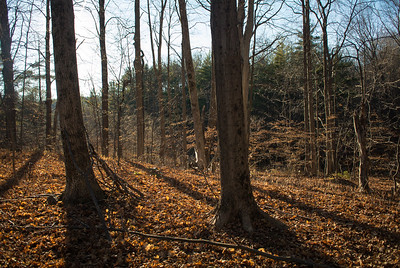
Conflict resolution and community support for conservation in the Northern Forest: A comparative case study from Maine
2009
Summary
Rapid land ownership changes in the Northern Forest have spurred development as well as conservation. Local people have experienced differing degrees of participation in land use decisions. This study compares two conservation projects from Maine to assess the policy processes and local attitudes about the conservation project and land use. One was a top-down approach, the second a grassroots, private effort by local citizens to conserve forest land.
Key Personnel & Institutions
Institutions: University of Maine , University of New Hampshire
Location
Maine
Resource Type
Report
Tags
No tag keywords available
Topic Tags
conservation, management
Purpose Tags
conservation, management, policy
Citation
Cottle M. A., "Conflict resolution and community support for conservation in the Northern Forest: A comparative case study from Maine", December 2009, Accessed from: https://www.proquest.com/openview/e8577a9f51ac040769aa9e8fba611f5a/1?pq-origsite=gscholar&cbl=18750
Source Link
https://www.proquest.com/openview/e8577a9f51ac040769aa9e8fba611f5a/1?pq-origsite=gscholar&cbl=18750
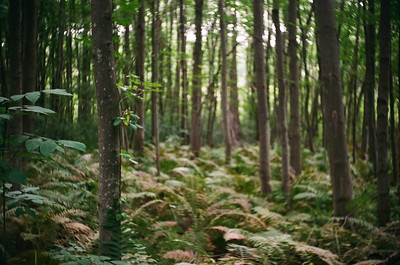
Good Moves for the Great Woods
2002
Summary
This article discusses some significant land aquisitions and conservation of forested lands.
Key Personnel & Institutions
Not available.Location
VERMONT, Massachusetts, Maine, New York, New Hampshire, Connecticut, Rhode Island, New England
Resource Type
Article
Tags
No tag keywords available
Topic Tags
conservation, methods, management, landscape pattern and connectivity
Purpose Tags
conservation, management
Citation
Dunn M. L., "Good Moves for the Great Woods", New Solutions, v.12(2), 129-134, 2002, https://doi.org/10.2190/N2M7-E1EL-8CR8-C3KB
Source Link
https://journals.sagepub.com/doi/abs/10.2190/N2M7-E1EL-8CR8-C3KB?journalCode=newa

Econometric analyses of nonindustrial forest landowners: Is there anything left to study?
2003
Summary
This paper reviews recent econometric studies focusing on how nonindustrial private forest landowners make decisions. They use a synthesis of previous work and a discussion of emerging problems involving these landowners as motivation for future research.
Key Personnel & Institutions
Not available.Location
VERMONT, Massachusetts, Maine, New York, New Hampshire, Connecticut, Rhode Island, New England
Resource Type
Article
Tags
No tag keywords available
Topic Tags
conservation, methods, management, ecosystem services, drivers
Purpose Tags
conservation, management
Citation
Gregory S. A., Conway M. C., Sullivan J., Gregory S. A., "Econometric analyses of nonindustrial forest landowners: Is there anything left to study?", Journal of Forest Economics, v. 9, iss 2, 2003, pp. 137-164, https://doi.org/10.1078/1104-6899-00028
Source Link
https://www.sciencedirect.com/science/article/abs/pii/S1104689904700264
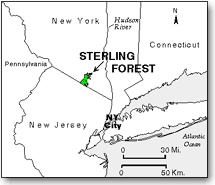
Sterling Forest: An Ecological Analysis
1994 to 1998
Summary
The interior forest habitat of the New York-New Jersy Highlands is being increasingly recoginzed as having significant biodiversity value. Satellite remote sensing and geographic information systems (GIS) were used at the Grant F. Walton Center for Remote Sensing and Spatial Analysis (CRSSA), Rutgers University, to undertake an inventory of forest habitat and an assessment of forest fragmentation in the New York-New Jersey Highlands region. The NY-NJ Highlands has a forest cover of 62-65%, but due to fragmentation only 20% of the total forest area is considered prime forest habitat.
Key Personnel & Institutions
Not available.Location
New York
Resource Type
Article
Tags
No tag keywords available
Topic Tags
conservation, methods, management, drivers, wildlife and habitat, landscape pattern and connectivity
Purpose Tags
conservation, management
Citation
"Sterling Forest: An Ecological Analysis", 1998, Accessed from: https://crssa.rutgers.edu/projects/sterling/
Source Link
Tompkins County Habitat Connectivity Strategy
2018
Summary
Tompkins County has developed this Habitat Connectivity Strategy to help combat habitat fragmentation, preserve habitat diversity, and promote ecosystem resilience. The framework provided here identifies (1) specific habitat corridors for native flora and fauna to have the ability to freely move in response to climate change; (2) key undeveloped areas that should be protected from fragmentation to retain habitat; and (3) broad strategies and policies that can be implemented to improve habitat connectivity.
Key Personnel & Institutions
Not available.Location
Tompkins
Resource Type
Article
Tags
No tag keywords available
Topic Tags
conservation, methods, management, wildlife and habitat, landscape pattern and connectivity
Purpose Tags
conservation, management
Citation
"Tompkins County Habitat Connectivity Strategy", May 2018, Accessed from: https://tompkinscountyny.gov/files2/planning/Natural_Agriculture/FINAL TC Connectivity Strategy.pdf
Source Link
https://tompkinscountyny.gov/files2/planning/Natural_Agriculture/FINAL TC Connectivity Strategy.pdf

New York Forest Owners
2012
Summary
The New York Forest Owners Association (NYFOA) was created in 1963. It represents an outgrowth of a program of woodland walks initiated by Professor Svend Heiberg at the Syracuse forestry college. Due to Heiberg's Scandinavian pronunciation, those visits to valuable private woodlands were more often referred to as Valks in de Voots.
Key Personnel & Institutions
Not available.Location
No location information available
Resource Type
Article
Tags
No tag keywords available
Topic Tags
No topic tag keywords available
Purpose Tags
No purpose tag keywords available
Citation
"New York Forest Owners", 26 August 2012, Accessed from: http://www.acsu.buffalo.edu/~insrisg/nature/nw12/0826NYFOA.htm
Source Link
http://www.acsu.buffalo.edu/~insrisg/nature/nw12/0826NYFOA.htm
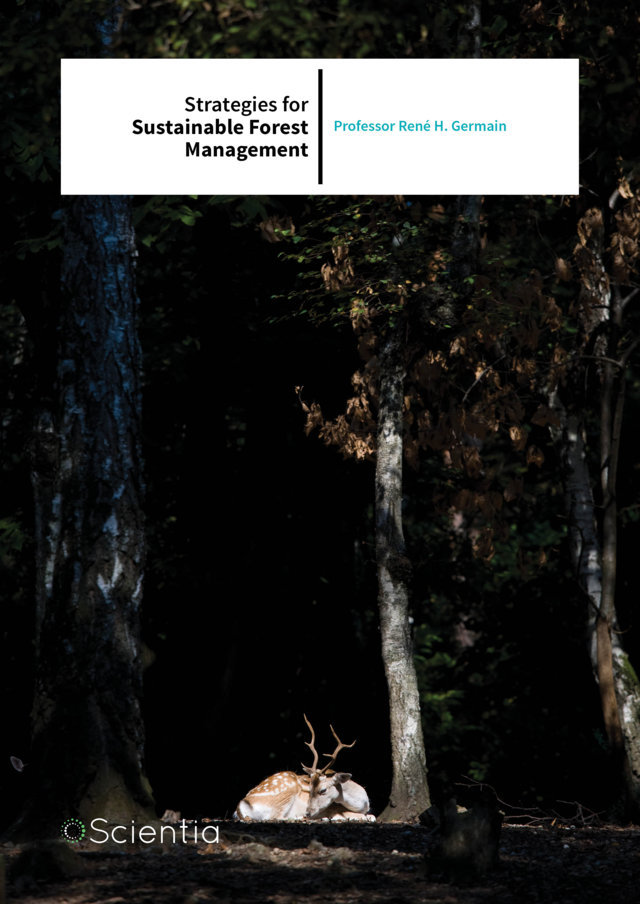
Professor René Germain – Strategies for Sustainable Forest Management
2017
Summary
Forested land improves urban water quality, but needs to be appropriately managed and protected from the impacts of land use changes. Professor René Germain at SUNY ESF is passionate about improving the sustainability of forest management, and carries out research and outreach programs to build knowledge and explore better management practices.
Key Personnel & Institutions
People: Rene Germain
Institutions: The State University of New York (SUNY), College of Environmental Science and Forestry
Location
New York
Resource Type
Article
Tags
No tag keywords available
Topic Tags
conservation, methods, management
Purpose Tags
conservation, management, education
Citation
"Professor René Germain – Strategies for Sustainable Forest Management", 7 June 2017, Earth and Environment, Accessed From: https://www.scientia.global/professor-rene-germain-strategies-sustainable-forest-management/
Source Link
https://www.scientia.global/professor-rene-germain-strategies-sustainable-forest-management/
Forest Ownership Change and Parcelization In the Hudson River Watershed
2009 to 2011
Summary
This was a presentation given by a Masters of Science student, Andrew Roe, at the Society of American Foresters National Convention in 2010 on the Hudson River watershed and how it is being affected by forest land ownership change and parcelization.
Key Personnel & Institutions
Institutions: Cornell University, Cooperative Extension , Society of American Foresters
Location
New York
Resource Type
Poster
Tags
No tag keywords available
Topic Tags
conservation, methods, management, ecosystem services, drivers, landscape pattern and connectivity
Purpose Tags
conservation, management
Citation
Roe A., "Forest Ownership Change and Parcelization In the Hudson River Watershed", 2010, Society of American Foresters, Accessed from: https://www.slideshare.net/Shorna_Allred/forest-ownership-change-and-parcelization-in-the-hudson-river-watershed
Source Link

Community forests: A study of New Hampshire's town-owned forests
2014
Summary
New Hampshire towns provided a case study of the current state of town-owned forest protection and management, with a focus on timber management. This study administered a survey to 50 randomly sampled towns and received data from 29 about permanent protection and management activities on town-owned forestland (? 50 acres). They used this data, demographic, and landscape data, to evaluate permanent protection and timber management at the town and property levels.
Key Personnel & Institutions
People: Anna Christie-Carnicella
Institutions: The State University of New York (SUNY), Albany
Location
New Hampshire
Resource Type
Article
Tags
No tag keywords available
Topic Tags
conservation, management, ecosystem services, drivers
Purpose Tags
conservation, management
Citation
Christie-Carnicella A. L., "Community Forests: A Study of New Hampshire's Town-Owned Forests" 2014, Accessed from: https://www.proquest.com/openview/af4aa23a32e4b2cd251aea11811daa9e/1?pq-origsite=gscholar&cbl=18750
Source Link
https://www.proquest.com/openview/af4aa23a32e4b2cd251aea11811daa9e/1?pq-origsite=gscholar&cbl=18750
A Case Study in the New York City Watershed
2012
Summary
Ownership fragmentation and development may impact both the working forested landscape and water quality. This study surveyed the owners of intact and subdivided family forest parcels across various parcel sizes to gauge their awareness of forest management practices and to assess the potential property-level impacts of their activities on water quality.
Key Personnel & Institutions
People: Rene Germain , Jennifer A. Caron , Nathaniel M. Anderson
Location
New York
Resource Type
Article
Tags
No tag keywords available
Topic Tags
conservation, methods, management
Purpose Tags
conservation, management
Citation
Caron J. A., Germain R. H., Anderson N. M., "A Case Study in the New York City Watershed", Northern Journal of Applied Forestry, v. 29, iss. 2, 1 June 2012, pp. 74-80, https://doi.org/10.5849/njaf.10-038
Source Link
Estimates of technically available woody biomass feedstock from natural forests and willow biomass crops for two locations in New York State
2009
Summary
A Geographic Information System (GIS) was used to estimate the technically available woody biomass from forests and willow biomass crops within a 40 km radius of Syracuse and Tupper Lake, NY. Land cover and land use data were used to identify the available land base and restrictions were applied for slope, parcel size and designated wetlands.
Key Personnel & Institutions
Not available.Location
New York
Resource Type
Article
Tags
No tag keywords available
Topic Tags
conservation, management, ecosystem services
Purpose Tags
conservation, management
Citation
Castellano P.J., Volk T.A., Herrington L.P., "Estimates of technically available woody biomass feedstock from natural forests and willow biomass crops for two locations in New York State", Biomass and Bioenergy, v. 33, iss. 3, March 2009, pp. 393-406, https://doi.org/10.1016/j.biombioe.2008.08.001
Source Link
Marketing the master forest owner volunteer program: a pilot study on the messaging and materials of engagement
2021
Summary
In New York State, the Master Forest Owner (MFO) Volunteer program provides free support from trained volunteers, however participation in the program has declined since 2012. To encourage engagement with the program, they pilot tested a message consisting of descriptive norm, benefit appeal, and individual self-frame via a direct mail campaign. Compared to a control message, requests for visits with MFOs increased from receiving the treatment message via a cost-effective postcard.
Key Personnel & Institutions
People: Shorna Broussard Allred , Peter J. Smallidge
Location
New York
Resource Type
Article
Tags
No tag keywords available
Topic Tags
conservation, methods, management
Purpose Tags
conservation, management
Citation
Eiseman D. L., Allred S. B., Smallidge P. J., Chawla P., Dellorto-Blackwell C., Boone B., "Marketing the master forest owner volunteer program: a pilot study on the messaging and materials of engagement", Applied Environmental Education and Communication, 17 December 2021, v. 21, iss. 2, https://doi.org/10.1080/1533015X.2021.2013747
Source Link
https://www.tandfonline.com/doi/abs/10.1080/1533015X.2021.2013747
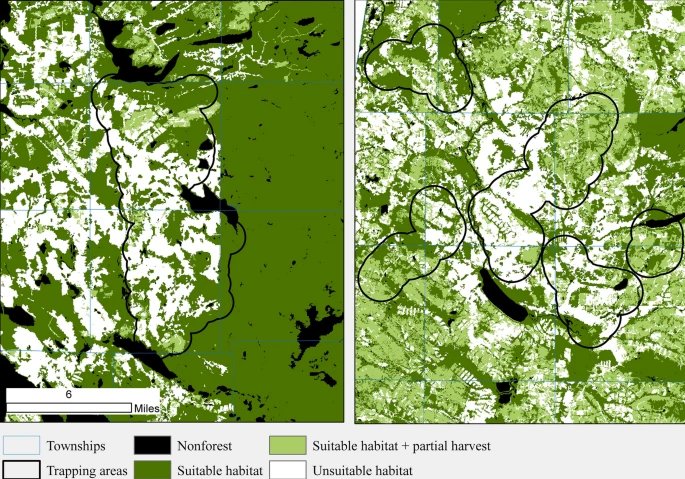
Sex-biased habitat selection by American marten in the Acadian Forest
2022
Summary
For wildlife dependent on mature forest living in managed landscapes, habitat loss from land use can outpace habitat recovery from forest regrowth, challenging persistence of habitat specialists. For some species, the effects of habitat loss or fragmentation may also differ between sexes when physiological or behavioral differences influence space use.
Key Personnel & Institutions
People: Erin Simons-Legaard, Daniel Harrison
Institutions: University of Maine , University of Maine, School of Forest Resources , Maine Department of Wildlife, Fisheries, and Conservation Biology , The University of Georgia, Warnell School of Forestry and Natural Resources
Location
Maine
Resource Type
Article
Tags
No tag keywords available
Topic Tags
conservation, drivers, wildlife and habitat
Purpose Tags
conservation
Citation
Simons-Legaard E., Harrison D., Hepinstall-Cymerman J., Payer D., "Sex-biased habitat selection by American marten in the Acadian Forest", Landscape Ecology, 8 September 2022, https://doi.org/10.1007/s10980-022-01508-7
Source Link
https://link.springer.com/article/10.1007/s10980-022-01508-7
Modeling the Effects of Emerald Ash Borer on Forest Composition in the Midwest and Northeast United States
2012
Summary
While there are methods to mitigate, contain, control, or even eradicate some nonnative invasive insects, EAB continues to spread across North America. Considering strong evidence suggesting >99 percent probability of host tree mortality, the loss of the North American ash resource is possible. To examine anticipated effects of EAB on tree species composition, they modeled future spatial and temporal changes in forest composition over the next 50 years with and without ash mortality anticipated from EAB spread.
Key Personnel & Institutions
People: David Wear , W. Keith Moser
Institutions: United States Department of Agriculture (USDA), Forest Service, Northern Research Station
Location
VERMONT, Massachusetts, Maine, New York, New Hampshire, Connecticut, Rhode Island, New England
Resource Type
Article
Tags
No tag keywords available
Topic Tags
conservation, drivers, wildlife and habitat
Purpose Tags
conservation
Citation
DeSantis R. D., Moser W. K., Huggett R. J. Jr., Li R., Wear D. N., Miles P. D., "Modeling the Effects of Emerald Ash Borer on Forest Composition in the Midwest and Northeast United States", September 2012, accessed from: https://shareok.org/bitstream/handle/11244/336492/DeSantis et al. 2013a.pdf?sequence=2
Source Link
Invasive Species in Forests and Rangelands of the United States: A Comprehensive Science Synthesis for the United States Forest Sector
2021
Summary
Stakeholders from nongovernmental organizations, academic institutions, professional organizations, private corporations, and state and federal agencies representing public, private, and tribal interests also provided input to the assessment. Input from these stakeholders helped to frame the subject matter content and management options presented in this report, ensuring relevance for decision-makers and resource managers.
Key Personnel & Institutions
Institutions: United States Department of Agriculture (USDA), Forest Service, Northern Research Station , United States Department of Agriculture (USDA), Forest Service, Rocky Mountain Research Station, United States Department of Agriculture (USDA), Forest Service, State and Private Forestry
Location
VERMONT, Massachusetts, Maine, New York, New Hampshire, Connecticut, Rhode Island, New England
Resource Type
Report
Tags
No tag keywords available
Topic Tags
conservation, management, drivers
Purpose Tags
conservation, management
Citation
Poland T. M., Patel-Weynand T., Finch M. D., Miniat C. F., Hayes D. C., Lopex V. M., "Invasive Species in Forests and Rangelands of the United States: A Comprehensive Science Synthesis for the United States Forest Sector", 2021, https://doi.org/10.1007/978-3-030-45367-1
Source Link

The Potential Role of Nematode Parasites in Wildlife Decline: Evidence from Allegheny Woodrats (Neotoma magister), Northern Flying Squirrels (Glaucomys sabrinus) and Now the Eurasian Red Squirrel (Sciurus vulgaris)
2022
Summary
Climate change and habitat loss alter the landscape for wildlife, resulting in shifts in geographic ranges, occupation of smaller, remnant habitat patches, or use of novel environments. These processes often lead to sympatry between species that historically were non-sympatric. Such interactions increase competition for resources and expose species to novel parasites that reduce a species' fitness leading to wildlife declines. We explore these interactions in species of endangered North American rodents—Northern flying squirrels (Glaucomys sabrinus) and Allegheny woodrats (Neotoma magister). Northern flying squirrels are declining in the United States due to competition with its congener, southern flying squirrels (Glaucomys volans).
Key Personnel & Institutions
Not available.Location
VERMONT, Massachusetts, Maine, New York, New Hampshire, Connecticut, Rhode Island, New England
Resource Type
Article
Tags
No tag keywords available
Topic Tags
conservation, wildlife and habitat, landscape pattern and connectivity
Purpose Tags
conservation
Citation
Mahan C., Steele M., "The Potential Role of Nematode Parasites in Wildlife Decline: Evidence from Allegheny Woodrats (Neotoma magister), Northern Flying Squirrels (Glaucomys sabrinus) and Now the Eurasian Red Squirrel (Sciurus vulgaris)", 3 March 2022, 10.5772/intechopen.103119
Source Link
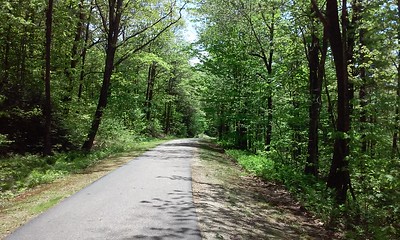
A new fractal index to classify forest disturbance and anthropogenic change
2022
Summary
Deforestation remains one of the most pressing threats to biodiversity. Characterizing the resulting forest loss and fragmentation efficiently from remotely sensed data therefore has strong practical implications. Data are often separately analyzed for spatial fragmentation and disorder, but no existing metric simultaneously quantifies the shapes and arrangement of fragments.
Key Personnel & Institutions
People: Jennifer Costanza
Institutions: United States Department of Agriculture (USDA), Forest Service
Location
VERMONT, Massachusetts, Maine, New York, New Hampshire, Connecticut, Rhode Island, New England
Resource Type
Report
Tags
No tag keywords available
Topic Tags
conservation, landscape pattern and connectivity
Purpose Tags
conservation
Citation
Peptenatu D., Andronache I., Ahammer H., Radulovic M., et. al. "A New Fractal Index to Classify Forest Disturbance and Anthropogenic Change", Research Square, 9 August 2022, https://doi.org/10.21203/rs.3.rs-1934944/v1
Source Link
Advancements in the remote sensing of landscape pattern of urban green spaces and vegetation fragmentation
2020
Summary
This review underscores the relevance of scientific findings in urban and spatial planning to minimize the loss of urban green spaces and to conserve and restore affected areas.
Key Personnel & Institutions
Not available.Location
VERMONT, Massachusetts, Maine, New York, New Hampshire, Connecticut, Rhode Island, New England
Resource Type
Article
Tags
No tag keywords available
Topic Tags
conservation, methods, management, drivers
Purpose Tags
conservation, management
Citation
Kowe P., Mutanga O., Dube T., "Advancements in the Remote Sensing of Landscape Pattern of Urban Green Spaces and Vegetation Fragmentation", International Journal of Remote Sensing, 27 May 2020, v. 42, iss. 10, https://doi.org/10.1080/01431161.2021.1881185
Source Link
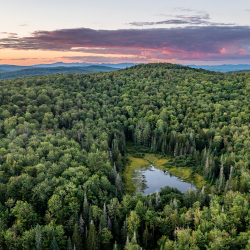
Rewilding, New Hampshire: New Hampshire Couple Protects 74 Acres
2020
Summary
This December, CC and David White protected 74 acres in Sandwich, New Hampshire as wilderness with a generous donation of a conservation easement to Northeast Wilderness Trust.
Key Personnel & Institutions
Institutions: Northeast Wilderness Trust
Location
Sandwich
Resource Type
Article
Tags
No tag keywords available
Topic Tags
conservation, management, ecosystem services
Purpose Tags
conservation, management
Citation
"Rewilding, New Hampshire: New Hampshire Couple Protects 74 Acres", Northeast Wilderness Trust, 2020, Accessed from: https://newildernesstrust.org/heath-brook-nh/
Source Link
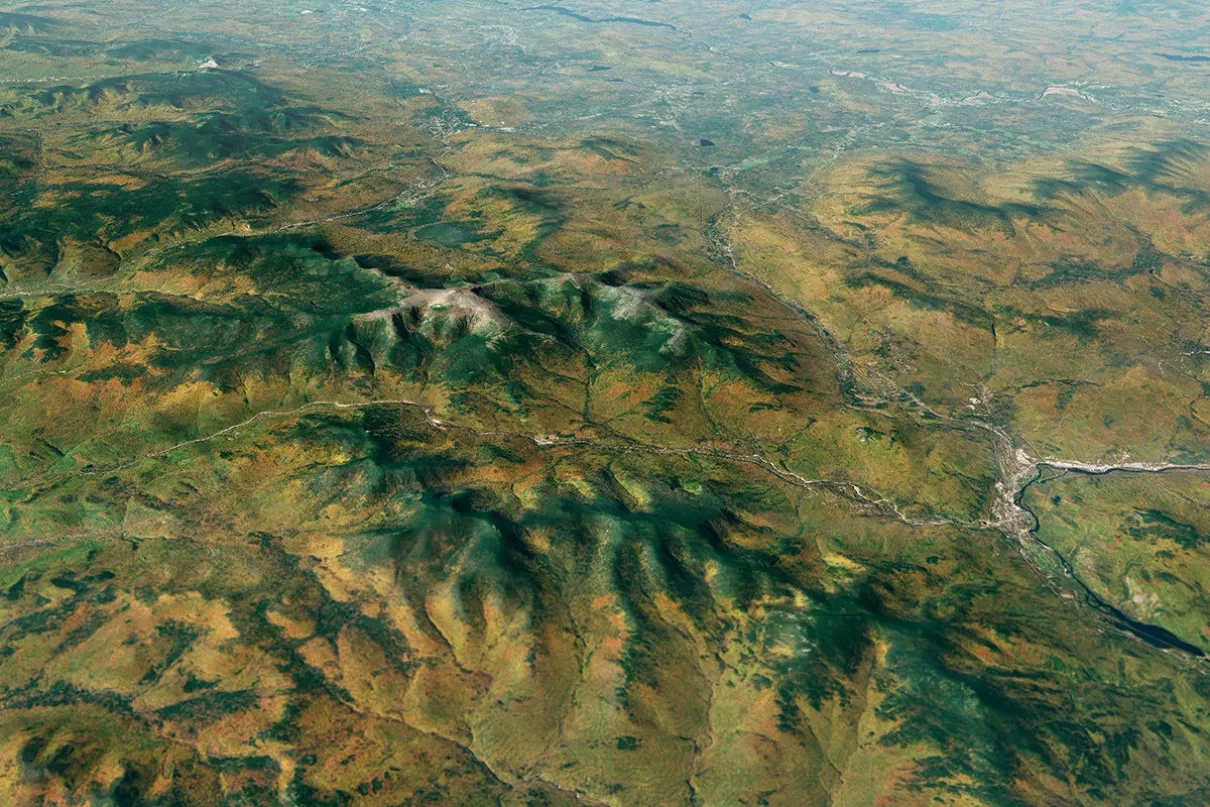
Where Have the Songbirds Gone
2022
Summary
Quieter forests are cause for concern as conservationists see decreasing populations and diversity of songbirds in New England, many of which call New Hampshire home. NASA satellite data helped map the changing forest landscape, better equipping land managers to react to the effects of forest fragmentation and changing songbird populations.
Key Personnel & Institutions
Institutions: National Aeronautics and Space Administration (NASA)
Location
VERMONT, New Hampshire
Resource Type
Article
Tags
No tag keywords available
Topic Tags
conservation, drivers, wildlife and habitat, landscape pattern and connectivity
Purpose Tags
conservation
Citation
"Where Have the Songbirds Gone", NASA, 2022, Accessed from: https://www.nasa.gov/SpaceforUS/?story=4036
Source Link
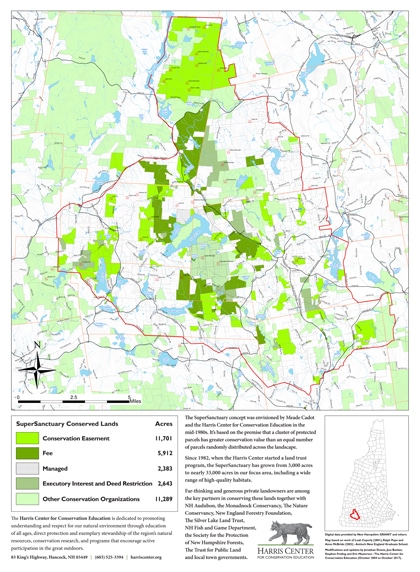
Harris Center for Conservation Education: History of the Supersanctuary
2022
Summary
Harris Center decided to expand on its environmental education work by becoming a land trust. The goal was to demonstrate how people could work together to protect land from development, with a focus on connectivity.
Key Personnel & Institutions
Institutions: Harris Center for Conservation Education
Location
Hancock
Resource Type
Article
Tags
No tag keywords available
Topic Tags
conservation, management, wildlife and habitat, landscape pattern and connectivity
Purpose Tags
conservation, management, education
Citation
"Harris Center for Conservation Education: History of the Supersanctuary", 2022, accessed from: https://harriscenter.org/land-conservation/the-supersanctuary/history-of-the-supersanctuary
Source Link
https://harriscenter.org/land-conservation/the-supersanctuary/history-of-the-supersanctuary
Forest Management Framework for New York City
2017 to 2022
Summary
A joint project of the Natural Areas Conservancy and NYC Parks, the Forest Management Framework for New York City is a strategic and comprehensive plan to bolster and protect New York City's vital urban forests. It is the first citywide vision for this critical piece of infrastructure. The plan is intended to guide restoration, management, and community engagement for 7,300 acres of New York City's forested parkland. The 25- year plan includes the process, costs, steps, recommendations, best practices, and goals for forest management in NYC. It marks the culmination of six years of research, data collection, and analysis by NAC scientists.
Key Personnel & Institutions
Not available.Location
New York
Resource Type
Report
Tags
No tag keywords available
Topic Tags
conservation, methods, management
Purpose Tags
conservation, management
Citation
Pregitzer C. C., Helen M. F., Forgoine H. M., King K. L., Charlop-Powers S., Greenfield J., "Forest Management Framework for New York City", 2018, Natural Areas Conservancy, New York, NY. Accessed from: https://naturalareasnyc.org/content/forests/fmf-2019-update-singles.pdf
Source Link
https://naturalareasnyc.org/content/forests/fmf-2019-update-singles.pdf
Act 171 and Planning for Forest Blocks and Habitat Connectors
2015
Summary
Act 171 amended Vermont Planning Statutes to encourage and allow municipalities to address protection of forest blocks and habitat connectors while supporting the local forest products industry. Learn more about how to identify regionally and locally significant forest blocks and habitat connectors by reviewing the resources linked on this resource page.
Key Personnel & Institutions
Not available.Location
VERMONT
Resource Type
Article
Tags
No tag keywords available
Topic Tags
conservation, management, planning
Purpose Tags
conservation, management, policy
Citation
"Act 171 and Planning for Forest Blocks and Habitat Connectors", Accessed from: https://anr.vermont.gov/act171_forestplanning
Source Link
Forest Fragmentation
2017
Summary
Over 100 years ago, approximately 75 percent of Vermont's landscape was clear cut for pasture, timber, potash and fuel. Since that time, the land has healed and the forest has returned – approximately 80% of Vermont is now forested. While Vermont's forests no longer face the prospect of clearing for agriculture as they did 100 years ago, today Vermont's forests face a new threat: forest fragmentation, which is the result of scattered, poorly planned rural subdivision and development.
Key Personnel & Institutions
Not available.Location
VERMONT
Resource Type
Article
Tags
No tag keywords available
Topic Tags
conservation, drivers, landscape pattern and connectivity
Purpose Tags
conservation
Citation
"Forest Fragmentation", https://www.uvm.edu/~mjk/195 Tracking Wildlife Corridors/Forest Fragmentation | VNRC.pdf
Source Link
https://www.uvm.edu/~mjk/195 Tracking Wildlife Corridors/Forest Fragmentation | VNRC.pdf
Forest Management Plan For the Andrews Community Forest
2019
Summary
The purpose of this Forest Management Plan (FMP) is to accompany the Andrews Community Forest (ACF)'s 2018 Management Plan, adopted by the Richmond Selectboard on November 19, 2018. This FMP provides detailed, specific rreccomendations for the management of forested areas of the ACF using forest inventory data and a scientific process.
Key Personnel & Institutions
People: Ethan Tapper
Institutions: Vermont Land Trust
Location
RICHMOND
Resource Type
Article
Tags
No tag keywords available
Topic Tags
conservation, methods, management
Purpose Tags
conservation, management
Citation
Tapper E., "Forest Management Plan For the Andrews Community Forest" 2019, Town of Richmond Chittenden County, Vermont, Accessed from: https://www.richmondvt.gov/fileadmin/files/Archive/2018/04/2019-Forest-Management-Plan.pdf
Source Link
https://www.richmondvt.gov/fileadmin/files/Archive/2018/04/2019-Forest-Management-Plan.pdf
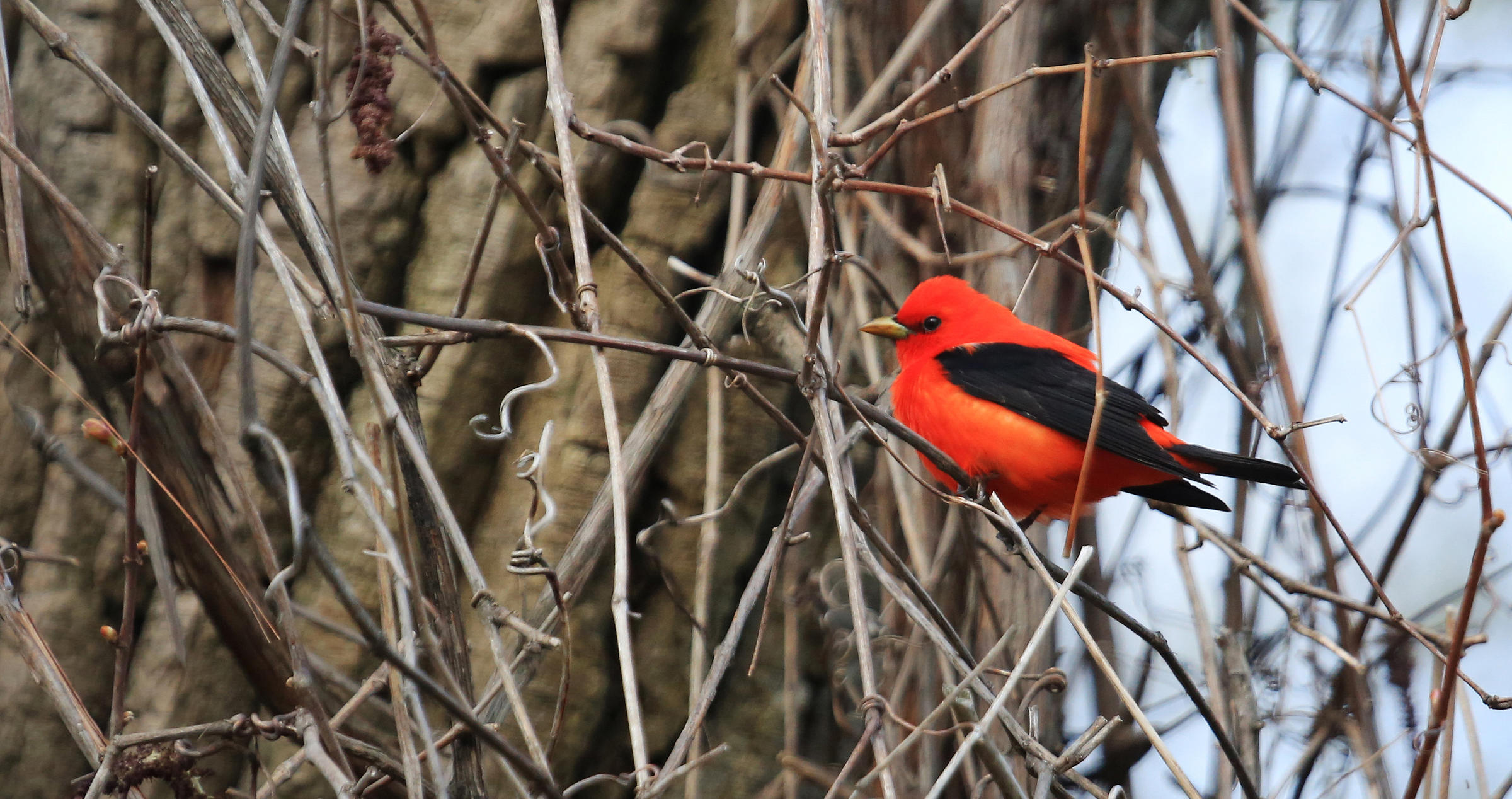
Audubon Vermont, Why Healthy Forests?, Keeping Common Birds Common
Summary
The Atlantic Northern Forest of Vermont, New Hampshire, Maine and New York is home to the greatest diversity of breeding bird species in the continental United States. But the populations of many of these seemingly-common species are declining at alarming rates.
Key Personnel & Institutions
Institutions: Audubon Vermont
Location
VERMONT
Resource Type
Article
Tags
No tag keywords available
Topic Tags
conservation, methods, drivers, wildlife and habitat
Purpose Tags
conservation
Citation
"Why Healthy Forests?", 2022, Audubon Vermont, Accessed from: https://vt.audubon.org/conservation/why-healthy-forests
Source Link
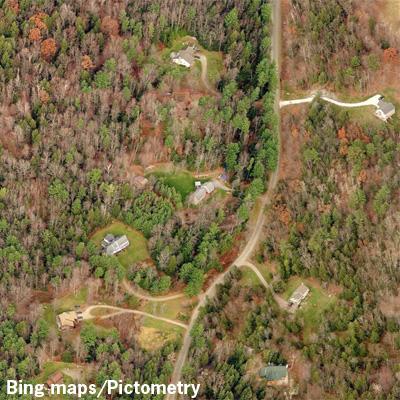
Predicted Changes in Forest Cover and Fragmentation in Vermont's Northern Forest
2008
Summary
To evaluate impacts of future residential development in Vermont's Northern Forest, NSRC researchers used the land use change model UrbanSim and Geographic Information Systems (GIS). They predicted where development is likely to occur, how it will affect forest habitat, and how the resultant land use pattern might change under alternative infrastructure investment and policy scenarios, such as construction of new Interstate highway exits and more stringent implementation of the Current Use forest property tax program. Using pre-determined population forecasts, researchers modeled residential development over the next 25 years based on soil type, slope, housing density, and proximity to retail establishments, ski resorts, and protected areas. They then mapped forest cover change based on results of the model.
Key Personnel & Institutions
People: Austin Troy
Institutions: University of Vermont
Location
VERMONT
Resource Type
Article
Tags
No tag keywords available
Topic Tags
conservation, methods, drivers, landscape pattern and connectivity
Purpose Tags
conservation
Citation
Troy A., "Predicted Changes in Forest Cover and Fragmentation in Vermont's Northern Forest", 2008, University of Vermont, Accessed from: https://nsrcforest.org/project/predicted-changes-forest-cover-and-fragmentation-vermont’s-northern-forest
Source Link
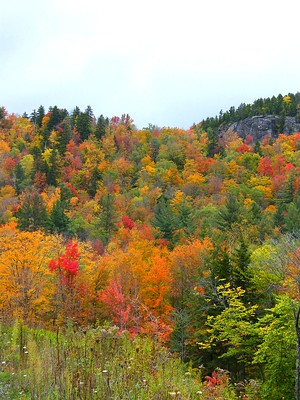
Vermont Forest Partnership: Recommendations to Vermont Climate Council
2021
Summary
Forests are a powerful tool to counter the impacts of climate change. Forests sequester and store carbon, buffer the impact of intense weather events by storing water and reducing the rate of flooding, provide durable wood products and are part of our energy portfolio, and host diverse habitat for wildlife and plant species that are under stress from climate related impacts. Maintaining a resilient and connected forest landscape must be a top priority for Vermont, and the Climate Council.
Key Personnel & Institutions
Institutions: The Nature Conservancy , Audubon Vermont , Vermont Land Trust , Vermont Natural Resources Council , The Trust For Public Land
Location
VERMONT
Resource Type
Report
Tags
No tag keywords available
Topic Tags
conservation, methods, management, ecosystem services, drivers
Purpose Tags
conservation, management
Citation
"Vermont Forest Partnership: Reccomendations to Vermont Climate Council", 30 June 2021, Accessed from: Forests are a powerful tool to counter the impacts of climate change. Forests sequester and store carbon, buffer the impact of intense weather events by storing water and reducing the rate of flooding, provide durable wood products and are part of our energy portfolio, and host diverse habitat for wildlife and plant species that are under stress from climate related impacts. Maintaining a resilient and connected forest landscape must be a top priority for Vermont, and the Climate Council.
Source Link
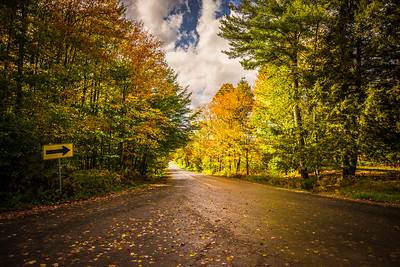
Developers, administration chop down forest fragmentation bill
2014
Summary
A proposal to limit forest fragmentation was thwarted by developers who oppose using the state's land use and development laws as a tool to keep woodlands intact, according to the lead sponsor of the bill that was gutted on the Senate floor.
Key Personnel & Institutions
Not available.Location
VERMONT
Resource Type
Article
Tags
No tag keywords available
Topic Tags
conservation, methods, management, ecosystem services, drivers
Purpose Tags
conservation, management
Citation
Herrick J., "Developers, Administration Chop Down Forest Fragmentation Bill", 19 March, 2014, Vermont Digger, Accessed from: https://vtdigger.org/2014/03/19/developers-administration-chop-forest-fragmentation-bill/
Source Link
https://vtdigger.org/2014/03/19/developers-administration-chop-forest-fragmentation-bill/
How Does Corinth Maintain its Rural Character and Natural Resources?
2017 to 2021
Summary
About 90% of Corinth's land area is composed of Primary Forest Blocks and Wildlife Corridors? Since 2018 the State of Vermont requires all municipalities to address the maintenance of these natural resources in their planning for future land use. This article explains the actions that are being taken by Cornith Vermont to adress these requirements.
Key Personnel & Institutions
Not available.Location
CORINTH
Resource Type
Article
Tags
No tag keywords available
Topic Tags
conservation, methods, management, drivers
Purpose Tags
conservation, management, policy
Citation
"Corinth Forest Blocks", 2021, Accessed from: https://corinthvt.org/wp-content/uploads/2021/08/Corinth-Forest-Blocks.pdf
Source Link
https://corinthvt.org/wp-content/uploads/2021/08/Corinth-Forest-Blocks.pdf
Managing Forests in a Changing Climate
2021
Summary
The Sierra Club hosted Ethan Tapper, the Chittenden County Forester and Tim Stout, Principal of Northam Forest Carbon, for a discussion of how to take care of our forests in a changing climate. Recorded 9/16/21
Key Personnel & Institutions
People: Ethan Tapper
Location
VERMONT
Resource Type
Poster
Tags
No tag keywords available
Topic Tags
conservation, methods, management, drivers
Purpose Tags
conservation, management
Citation
Tapper E., Stout T., "Managing Forests in a Changing Climate", 16 September 2021, Accessed from: https://www.sierraclub.org/vermont/managing-forests-changing-climate
Source Link
https://www.sierraclub.org/vermont/managing-forests-changing-climate
Waitsfield: Forest Blocks & Wildlife Road Crossings
2021
Summary
This presentation is an overview of the town plan and suggested updates to follow the requirements of Act 171.
Key Personnel & Institutions
People: Jens Hilke
Institutions: Vermont Agency of Natural Resources
Location
VERMONT
Resource Type
Poster
Tags
No tag keywords available
Topic Tags
conservation, methods, management
Purpose Tags
conservation, management, policy
Citation
Hilke J., "Waitsfield: Forest Blocks & Wildlife Road Crossings", 2021, Accessed from: http://www.waitsfieldvt.us/wp-content/uploads/2021/02/2021-2.2-PC-Mtg-Act-171-Mapping-Sub-Presentation.pdf
Source Link
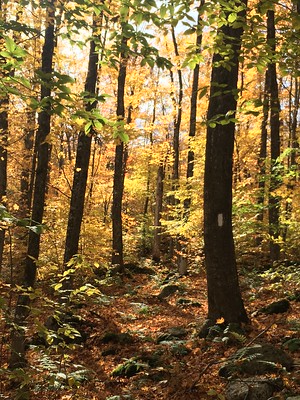
Improving Vermont's Forest Integrity Through Empowerment of Woman Forest Landowners
2020
Summary
Women represent an important part of Vermont's landowner population. They serve as the primary decision makers for 20% (475,000 acres) of the state's forestland and co-own just over another 1 million acres. Their significance relative to land management and influence over the forest landscape in Vermont is only anticipated to increase as, statistically speaking, women have longer lifespans. Research to date has shown that women have a strong interest in land conservation but are much less engaged with land management and decision-making activities. The lead collaborators on this research project see this gap as an important opportunity to engage women landowners around the most pressing issues facing Vermont's forests.
Key Personnel & Institutions
Institutions: Vermont Land Trust
Location
VERMONT
Resource Type
Report
Tags
No tag keywords available
Topic Tags
conservation, methods, management, drivers
Purpose Tags
conservation, management
Citation
Cusack C., Sausville L., "Project #1: Improving Vermont's Forest Integrity Through Empowerment of Woman Forest Landowners", 2020, Vermont Land Trust, Vermont Coverts, Accessed from: https://www.middlebury.edu/college/sites/www.middlebury.edu.college/files/2022-03/Project-Statements_FINAL_S20_MBM.pdf?fv=abcuHtlZ
Source Link
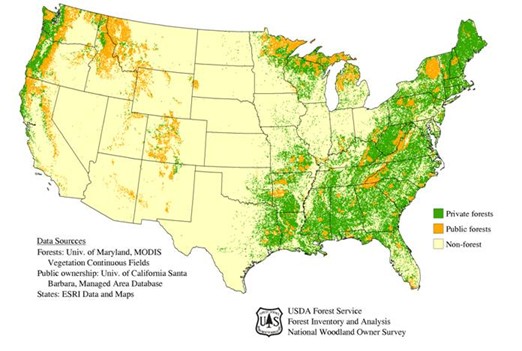
ForestParcelization and Forest Fragmentation in the U.S., Northeast, and Vermont
2006
Summary
This presentation addresses the trends in forest parcelization, private forest owners, and forest management with plans for how to improve conservation.
Key Personnel & Institutions
People: Brett Butler
Institutions: United States Department of Agriculture (USDA), Forest Service
Location
VERMONT, Massachusetts, Maine, New York, New Hampshire, Connecticut, Rhode Island, New England
Resource Type
Poster
Tags
No tag keywords available
Topic Tags
conservation, methods, management, planning, drivers, landscape pattern and connectivity
Purpose Tags
conservation, management
Citation
Butler B. J., "ForestParcelization and Forest Fragmentation in the U.S., Northeast, and Vermont", 18 September 2006, U.S. Forest Service, Accessed from: https://slideplayer.com/slide/4446117/
Source Link

Vermont Forest Products Council (2001-2002)
2000 to 2002
Summary
The Vermont Forest Products Council (VFPC) was convened in 2001 with 11 members representing state government, natural resource agencies, and wood manufacturers.
Key Personnel & Institutions
Not available.Location
VERMONT
Resource Type
Article
Tags
No tag keywords available
Topic Tags
conservation, methods, management, ecosystem services, planning, drivers
Purpose Tags
conservation, management
Citation
"Vermont Forest Products Council (2001-2002)", 2002, Accessed from: https://www.vtrural.org/programs/policy-councils/forest-products
Source Link
https://www.vtrural.org/programs/policy-councils/forest-products

Foresters for the Birds
2007 to 2022
Summary
Foresters for the Birds is an innovative project that works to keep forests as forests and common birds common by helping landowners integrate the practices of timber and songbird habitat management. The project was established through a partnership between Audubon Vermont and the Vermont Department of Forests, Parks, and Recreation in 2008. It has grown to become a network of foresters, biologists, and forest landowners across Vermont and the Atlantic Flyway who are working together to make a positive difference for forests, birds, and land stewardship in the region.
Key Personnel & Institutions
Institutions: Audubon Vermont
Location
VERMONT
Resource Type
Article
Tags
No tag keywords available
Topic Tags
conservation, methods, management, wildlife and habitat
Purpose Tags
conservation, management
Citation
"Foresters for the Birds", 2022, Audubon Vermont, Accessed from: https://vt.audubon.org/conservation/foresters-birds
Source Link
Vermont woodlands Groups meet to discuss forestry challenges
2011
Summary
The Vermont Woodlands Association annual meeting brought together forestry groups, state agencies and members of the public to discuss the future of forestry in Vermont.
Key Personnel & Institutions
Not available.Location
VERMONT
Resource Type
Article
Tags
No tag keywords available
Topic Tags
conservation, methods, management, ecosystem services, planning
Purpose Tags
conservation, management
Citation
"Vermont Woodlands Groups Meet to Discuss Forestry Challenges", 20 March 2011, Vermont Woodlands Association, Accessed from: https://www.timesargus.com/news/vermont-woodlands-groups-meet-to-discuss-forestry-challenges/article_274cf716-49cb-54a3-a8a9-48e85df0743d.html
Source Link
Vermont Housing & Conservation Board, Vermont Farm & Forest Viability Program, 2018 Annual Report
2017 to 2019
Summary
The Vermont Farm & Forest Viability Program benefits rural communities and businesses across Vermont. It supports entrepreneurs in early stages of business as well as mature operations, all the way through to succession. The proportion of businesses enrolling in the program for help planning a transfer to new ownership rapidly increased in the past year, and they now work not only with farm and forestry businesses on succession but forest landowners as well, in an effort to reduce the likelihood of parcelization of Vermont's forest blocks.
Key Personnel & Institutions
Not available.Location
VERMONT
Resource Type
Article
Tags
No tag keywords available
Topic Tags
conservation, methods, management
Purpose Tags
conservation
Citation
"Vermont Housing & Conservation Board, Vermont Farm & Forest Viability Program", 31 January 2019, Accessed from: https://vhcb.org/sites/default/files/pdfs/pubs/6 V.S.A. § 4710(f) & 10 V.S.A. § 325m - 2018 VHCB Vermont Farm & Forest Viability Program Annual Report.pdf
Source Link
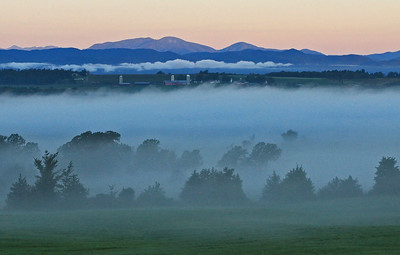
Nature conservation in an agricultural landscape: Forest ecology, fragmentation analysis, and systematic site prioritization, southern Champlain Valley, Vermont, United States
2002
Summary
This research presents a framework and methodology for understanding natural systems in a highly fragmented landscape and for prioritizing conservation sites.
Key Personnel & Institutions
People: Marc Lapin
Institutions: Cornell University
Location
VERMONT
Resource Type
Article
Tags
No tag keywords available
Topic Tags
conservation, methods, management, drivers
Purpose Tags
conservation, management
Citation
Lapin M. F., "Nature conservation in an agricultural landscape: Forest ecology, fragmentation analysis, and systematic site prioritization, southern Champlain Valley, Vermont, United States", January 2003, Cornell University, Accessed from: https://www.proquest.com/openview/4d7db23286c03c7c7e5bf630226eeb5a/1?pq-origsite=gscholar&cbl=18750&diss=y
Source Link

Preserving Biodiversity in Appalachian Mixed Mesophytic Forests Through the Permit-Based Harvest of American Ginseng and Other Forest Botanicals
2022
Summary
This article argues that a renewal of the relationship between people and culturally significant understory plants—through the expansion of permit-based harvest programs on national forestland as well as through the intentional cultivation of forest herbs (referred to as forest farming)—presents the best way forward to reestablish viable populations of understory herbs in the mature second growth forests of the Appalachian region.
Key Personnel & Institutions
Institutions: Yale University, School of Forestry and Environmental Studies
Location
VERMONT, Massachusetts, Maine, New York, New Hampshire, Connecticut, Rhode Island, New England
Resource Type
Article
Tags
No tag keywords available
Topic Tags
conservation, methods, management
Purpose Tags
conservation, management
Citation
Sheban K., "Preserving Biodiversity in Appalachian Mixed Mesophytic Forests Through the Permit-Based Harvest of American Ginseng and Other Forest Botanicals", In: Montagnini, F. (eds) Biodiversity Islands: Strategies for Conservation in Human-Dominated Environments. Topics in Biodiversity and Conservation, vol 20. Springer, Cham. https://doi.org/10.1007/978-3-030-92234-4_24
Source Link
https://link.springer.com/chapter/10.1007/978-3-030-92234-4_24
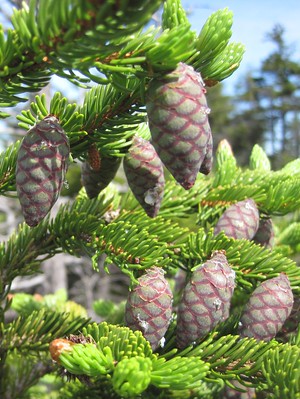
Genotypic variation and plasticity in climate-adaptive traits after range expansion and fragmentation of red spruce (Picea rubens Sarg.)
2022
Summary
This project is a stud of the levels of genetic and plastic variation for phenology and growth traits in populations of red spruce (Picea rubens), from the range core to the highly fragmented trailing edge.
Key Personnel & Institutions
People: Stephen Keller , John Butnor
Institutions: University of Vermont, Department of Plant Biology , United States Department of Agriculture (USDA), Forest Service, Southern Research Station
Location
VERMONT, Massachusetts, Maine, New York, New Hampshire, Connecticut, Rhode Island, New England
Resource Type
Article
Tags
No tag keywords available
Topic Tags
conservation, methods, management, landscape pattern and connectivity
Purpose Tags
conservation, management
Citation
Prakash A., DeYoung S., Lachmuth S., Adams J. L., Johnsen K., Butnor J. R., Nelson D. M., Fitzpatrick M. C., Keller S. R., "Genotypic variation and plasticity in climate-adaptive traits after range expansion and fragmentation of red spruce (Picea rubens Sarg.)", 21 February 2022, https://doi.org/10.1098/rstb.2021.0008
Source Link
A Geographic Information System Approach to Map Tick Exposure Risk at a Scale for Public Health Intervention
2021
Summary
This study presents a geographic information system (GIS) method for mapping predicted tick exposure risk at a 200 m by 200 m resolution, appropriate for public health intervention. They followed the approach used to map tick habitat suitability over large areas. They used drag-cloth sampling to measure the density of nymphal blacklegged ticks (Ixodes scapularis, Say (Acari: Ixodidae)) at 24 sites in Addison and Rutland Counties, VT, United States.
Key Personnel & Institutions
People: David Allen
Institutions: Middlebury College, Biology Department , University of New Hampshire, Department of Natural Resources and the Environment
Location
RUTLAND, ADDISON
Resource Type
Article
Tags
No tag keywords available
Topic Tags
drivers, wildlife and habitat, landscape pattern and connectivity
Purpose Tags
education
Citation
Baldwin H., Landesman W. J., Borgmann-Winter B., Allen D., "A Geographic Information System Approach to Map Tick Exposure Risk at a Scale for Public Health Intervention, Journal of Medical Entomology", v. 59, iss. 1, January 2022, pp. 162–172, https://doi.org/10.1093/jme/tjab169
Source Link

Ownership, Governance, Uses, and Ecosystem Services of Community Forests in the Eastern United States
2022
Summary
Through an exploratory research approach, this study enhances the understanding of the characteristics of community forests (CFs) in the U.S. and the ecosystem services and other benefits that they provide. Through online web searches, we compiled one of the first comprehensive lists of CFs in the Eastern U.S.
Key Personnel & Institutions
People: Gregory Frey
Institutions: United States Department of Agriculture (USDA), Forest Service, Southern Research Station , North Carolina State University, Department of Forestry and Environmental Resources
Location
VERMONT, Massachusetts, Maine, New York, New Hampshire, Connecticut, Rhode Island, New England
Resource Type
Article
Tags
No tag keywords available
Topic Tags
conservation, management, planning, landscape pattern and connectivity
Purpose Tags
conservation, management, policy
Citation
Hovis M., Frey G., McGinley K., Cubbage F., Han X., Lupek M., "Ownership, Governance, Uses, and Ecosystem Services of Community Forests in the Eastern United States", Forests, 2022; 13(10):1577. https://doi.org/10.3390/f13101577
Source Link

Decisions nonindustrial forest landowners make: an empirical examination
2004
Summary
The purpose of this study is to estimate a model of non-industrial forest landowner behavior that considers certain types of behavior that have escaped discussion and rigorous investigation in the literature, yet which are critical to future policy making.
Key Personnel & Institutions
People: David Wear
Institutions: United States Department of Agriculture (USDA), Forest Service, Southern Research Station , Virginia Polytechnic Institute and State University
Location
VERMONT, Massachusetts, Maine, New York, New Hampshire, Connecticut, Rhode Island, New England
Resource Type
Article
Tags
No tag keywords available
Topic Tags
conservation, methods, management, drivers, landscape pattern and connectivity
Purpose Tags
conservation, management, policy
Citation
Conway M. C., Amacher G. S., Sullivan J., Wear D., "Decisions Nonindustrial Forest Landowners Make: An Empirical Examination", v. 9, iss. 3, 2003, pp. 181-203, https://doi.org/10.1078/1104-6899-00034
Source Link
https://www.sciencedirect.com/science/article/abs/pii/S110468990470029X
The Territorial Responses of Six Songbirds to Ski Trails at Smugglers Notch Resort and Stowe Mountain Resort, Vermont
2002
Summary
This study tested the territorial responses of six songbird species to cospecific playbacks of simulated intruders across ski trails of various widths. They conducted research on the ski trails of Smuggler's Notch Resort and Stowe Mountain Resort.
Key Personnel & Institutions
People: Amanda Holmgren
Institutions: University of Vermont
Location
VERMONT
Resource Type
Article
Tags
No tag keywords available
Topic Tags
conservation, management, drivers, wildlife and habitat, landscape pattern and connectivity
Purpose Tags
conservation, management
Citation
Holmgren A., "The Territorial Responses of Six Songbirds to Ski Trails at Smugglers Notch Resort and Stowe Mountain Resort, Vermont", December 2002, University of Vermont, Accessed from: https://www.uvm.edu/femc/attachments/project/999/reports/139_Holmgren_thesis_skitrailcrossing.pdf
Source Link
https://www.uvm.edu/femc/attachments/project/999/reports/139_Holmgren_thesis_skitrailcrossing.pdf
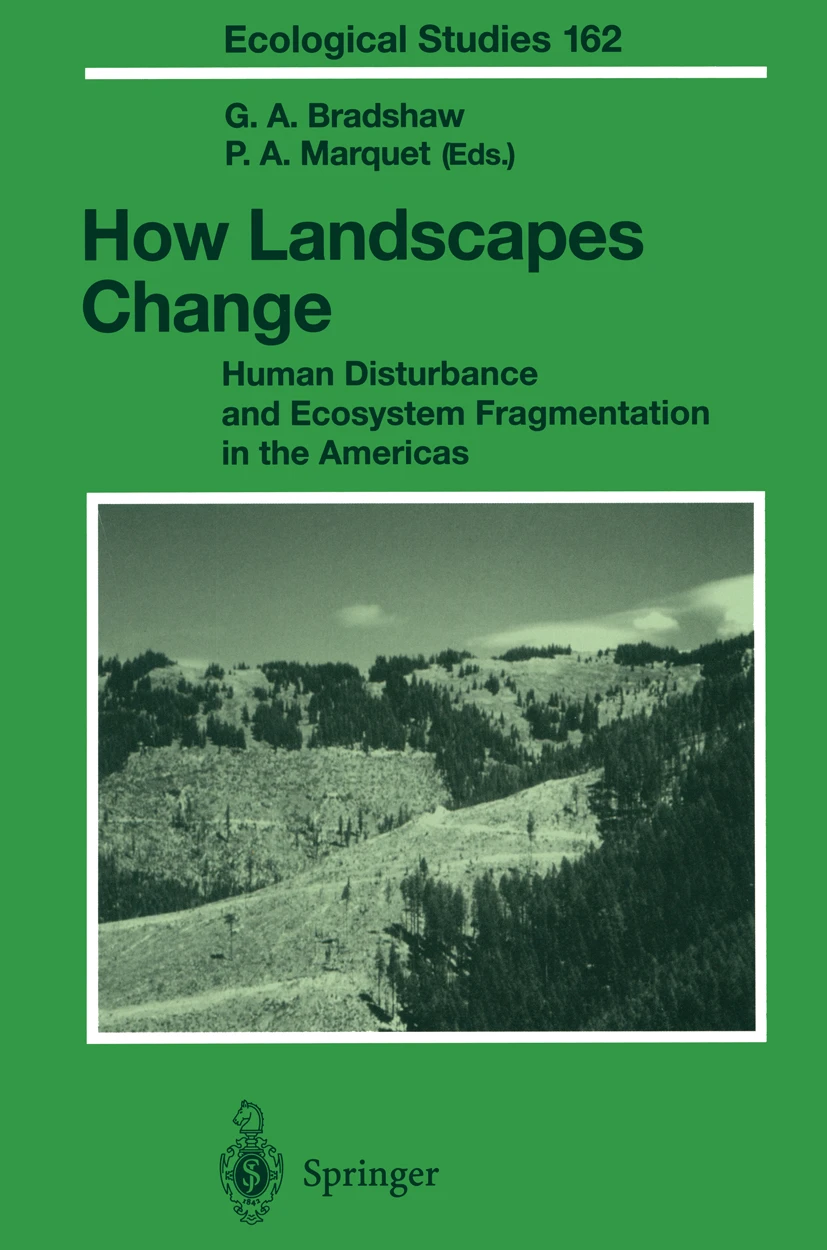
How Landscapes Change: Human Disturbance and Ecosystem Fragmentation in the Americas
2003
Summary
Provides an interdisciplinary overview of the major disruptions sustained by ecosystems in the Americas. It also Creates the basis for a common and comprehensive framework for future research and conservation policy formulation
Key Personnel & Institutions
Institutions: Oregon State University
Location
VERMONT, Massachusetts, Maine, New York, New Hampshire, Connecticut, Rhode Island, New England
Resource Type
Book
Tags
No tag keywords available
Topic Tags
conservation, drivers, landscape pattern and connectivity
Purpose Tags
conservation
Citation
Bradshaw G. A., Marquet P. A., "How Landscapes Change: Human Disturbance and Ecosystem Fragmentation in the Americas", Springer-Verlag Berlin Heidelberg 2003, https://doi.org/10.1007/978-3-662-05238-9
Source Link
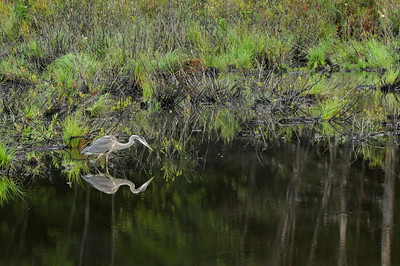
Master's Project: Policy Gap Analysis of Wildlife Conservation Objectives and Environmental Policies in Vermont, USA
2022
Summary
This research identified six state-level environmental policies deemed to be the most consequential for terrestrial wildlife conservation in Vermont: Act 250, Section 248, the Vermont Endangered Species Law, the Vermont Wetlands Rules, Act 171, and Current Use (Use Value Appraisal). A review of relevant caselaw, Vermont Fish and Wildlife Department (VFWD) legislative reports, VFWD-issued guidance documents, and peer-reviewed scientific literature informed the development of the Vermont Wildlife Policy Gap Survey. Utilizing established methodologies, the Vermont Wildlife Policy Gap Survey was designed to identify gaps in Vermont's current regulatory structure for the conservation of wildlife by eliciting feedback from a selected pool of conservation professionals in Vermont.
Key Personnel & Institutions
Institutions: University of Vermont
Location
VERMONT
Resource Type
Article
Tags
No tag keywords available
Topic Tags
conservation, methods, management, drivers, wildlife and habitat
Purpose Tags
conservation, management, policy
Citation
Lacey M. W., "Master's Project: Policy Gap Analysis of Wildlife Conservation Objectives and Environmental Policies in Vermont, USA", University of Vermont, 2022, Accessed from: https://scholarworks.uvm.edu/rsmpp/27/
Source Link
The Efficacy of Habitat Conservation Assistance Programs for Family Forest Owners in Vermont
2021
Summary
This report qualitatively compared the efficacy of two types of conservation assistance programs available in Vermont: traditional programs offered through the Natural Resources Conservation Service, and a simplified, accelerated program offered through a non-governmental partnership called Woods, Wildlife, and Warblers. The results from this survey, which was sent to 2,122 randomly selected Vermont family forest owners and had a cooperation rate of 38%, are presented.
Key Personnel & Institutions
Institutions: University of Massachusetts Amherst
Location
VERMONT
Resource Type
Article
Tags
No tag keywords available
Topic Tags
conservation, methods, management, wildlife and habitat
Purpose Tags
conservation, management, policy
Citation
Harrington M. E., "The Efficacy of Habitat Conservation Assistance Programs for Family Forest Owners in Vermont", 2021, University of Massachusetts, Amherst, https://orcid.org/0000-0002-9534-5698
Source Link
Forest Vulnerability to Climate Change: A Review for Future Research Framework
2022
Summary
Through a systematic review from 1990 to 2019, this paper examined forest vulnerability to climate change and its management practices. In this paper, descriptive, mechanism and thematic analyses were carried out to analyze the state of existing research, in order to understand the concept of vulnerability arising from climate change and forest management issues.
Key Personnel & Institutions
Not available.Location
VERMONT, Massachusetts, Maine, New York, New Hampshire, Connecticut, Rhode Island, New England
Resource Type
Article
Tags
No tag keywords available
Topic Tags
conservation, methods, landscape pattern and connectivity
Purpose Tags
conservation
Citation
Roshani S. H., Kumar P., Masroor Md, Rahaman H. Md, Rehman S., Ahmed R., Sahana M., "Forest Vulnerability to Climate Change: A Review for Future Research Framework" 12 June 2022, Forests, 13(6), 917; https://doi.org/10.3390/f13060917
Source Link
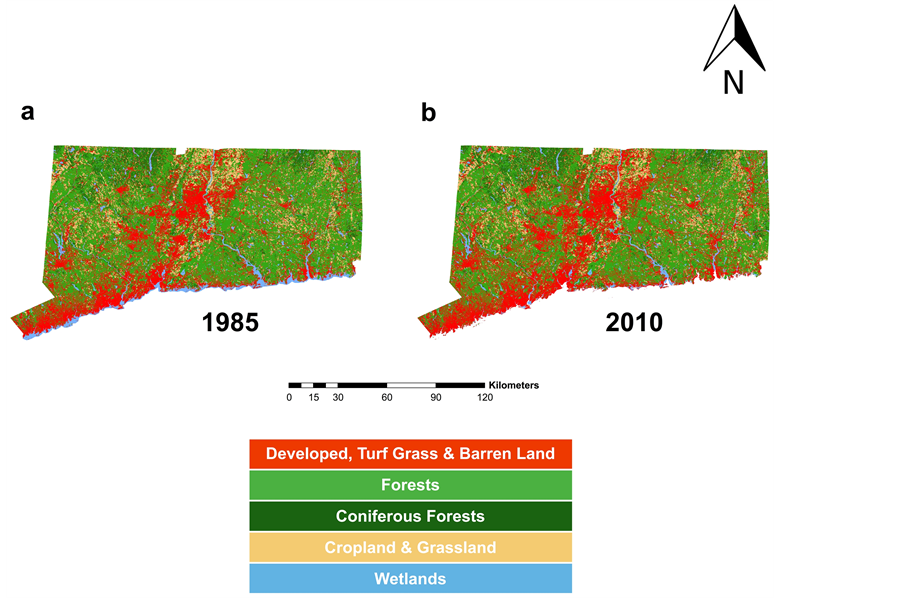
The Impact of Land Use Change for Greenhouse Gas Inventories and State-Level Climate Mediation Policy: A GIS Methodology Applied to Connecticut
2014
Summary
Greenhouse gas (GHG) inventories conducted at state and regional levels serve to quantify long- term emissions trends and set benchmarks against which to evaluate the effectiveness of state government-mandated emissions reductions. GHG inventories which incompletely account for land use, land change, and forestry (LUCF) due to insufficient measurement tools discount the value of terrestrial carbon (C) sinks. In consequence, sink preservation is often omitted from regional land use planning. This paper proposes an accounting methodology which estimates foregone C sequestration derived LUCF change in the southern New England State of Connecticut (CT).
Key Personnel & Institutions
Not available.Location
Connecticut
Resource Type
Article
Tags
No tag keywords available
Topic Tags
conservation, management, drivers, landscape pattern and connectivity
Purpose Tags
conservation, management
Citation
Tomasso L. P., Leighton M., "The Impact of Land Use Change for Greenhouse Gas Inventories and State-Level Climate Mediation Policy: A GIS Methodology Applied to Connecticut", v. 5, no. 7, 2014, Accessed from: https://www.scirp.org/html/3-6702464_52176.htm?pagespeed=noscript
Source Link
https://www.scirp.org/html/3-6702464_52176.htm?pagespeed=noscript
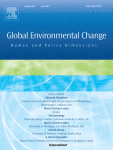
Forest carbon trajectories: Consequences of alternative land-use scenarios in New England
2021
Summary
The extent to which forest carbon sequestration can help mitigate climate change will be determined in large part by future land use. Here they quantify the impacts of five divergent future land-use scenarios on aboveground forest carbon stocks and fluxes throughout New England.
Key Personnel & Institutions
People: Meghan MacLean , Matthew Duveneck , Luca L. Morreale
Institutions: Harvard University, Harvard Forest , Boston University, Department of Earth and the Environment, New England Conservatory, University of Massachusetts, Amherst, Department of Environmental Conservation
Location
New England
Resource Type
Article
Tags
No tag keywords available
Topic Tags
conservation, methods, management, drivers, landscape pattern and connectivity
Purpose Tags
conservation, management, policy
Citation
MacLean M. G., Duveneck M. J., Plisinski J., Morreale L. L., Laflower D., Thompson J. R., "Forest carbon trajectories: Consequences of alternative land-use scenarios in New England", Change, v. 69, July 2021, https://doi.org/10.1016/j.gloenvcha.2021.102310
Source Link
https://www.sciencedirect.com/science/article/abs/pii/S0959378021000893

Studies of Family Forest Owners in the USA: A Systematic Review of Literature from 2000 through 2019
2022
Summary
This article summarizes the literature related to family forest ownerships in the USA published from 2000 through 2019 to better understand what is currently known about family forests in the USA and explore potential future research directions. This is not the first article to summarize this literature, but it is the first that they are aware of that does so using a formal, systematic approach and is unique in its scope and timespan.
Key Personnel & Institutions
People: Brett Butler , Kristen Floress
Institutions: United States Department of Agriculture (USDA), Forest Service, Northern Research Station , University of Massachusetts, UMass, Family Forest Research Center
Location
VERMONT, Massachusetts, Maine, New York, New Hampshire, Connecticut, Rhode Island, New England
Resource Type
Article
Tags
No tag keywords available
Topic Tags
conservation, methods, management, drivers, landscape pattern and connectivity
Purpose Tags
conservation, management, education
Citation
Butler B. J., Butler S. M., Floress K., "Studies of Family Forest Owners in the USA: A Systematic Review of Literature from 2000 through 2019", Small-Scale Forestry, 2022, Accessed from: https://link.springer.com/article/10.1007/s11842-022-09529-5
Source Link
https://link.springer.com/article/10.1007/s11842-022-09529-5

America's Evolving Relationship with Trees: A Statistical Analysis of Social, Economic, and Environmental Drivers of Forest Management
2021
Summary
This dissertation seeks to elucidate the motivations and actions of private landowners in the United States using a variety of data sources, including Zillow home estimates, the American Community Survey, satellite remote sensing imagery, and the Forest Inventory and Analysis database, and by implementing interpretable modeling frameworks, such as the hedonic pricing method and structural equation modeling.
Key Personnel & Institutions
Not available.Location
VERMONT, Massachusetts, Maine, New York, New Hampshire, Connecticut, Rhode Island, New England
Resource Type
Article
Tags
No tag keywords available
Topic Tags
conservation, management, drivers, landscape pattern and connectivity
Purpose Tags
conservation, management
Citation
Holt R. J., "America's Evolving Relationship with Trees: A Statistical Analysis of Social, Economic, and Environmental Drivers of Forest Management", 2021, Accessed from: https://www.proquest.com/openview/335f97dee9733feec42e51c92d4bb2a8/1?pq-origsite=gscholar&cbl=18750&diss=y
Source Link
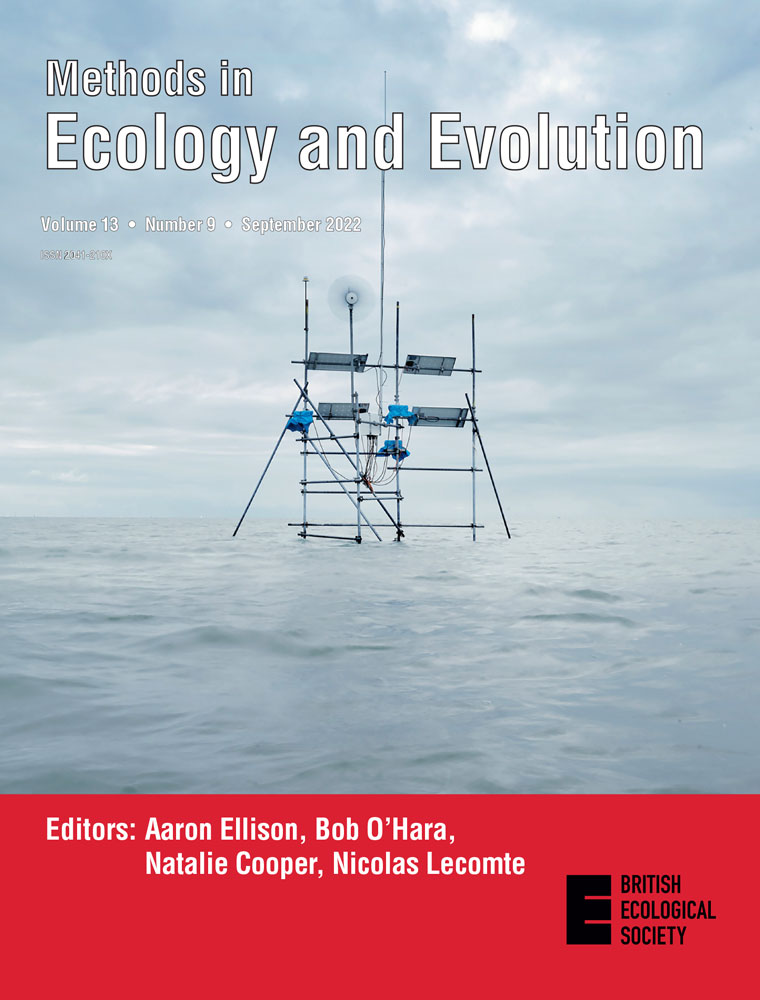
A systematic method for hypothesis synthesis and conceptual model development
2022
Summary
This study presents a novel, systematic approach to conceptual model development through qualitative synthesis and graphical analysis of hypotheses already present in the scientific literature. The resulting network can be analysed to identify shifts in thinking over time, variation in the application of ideas over different axes of investigation (e.g. geography, taxonomy, ecosystem type) and the most important hypotheses based on the network structure. To illustrate the approach, they present examples from a case study that applied the method to synthesize decades of research on the effects of forest fragmentation on birds.
Key Personnel & Institutions
Not available.Location
No location information available
Resource Type
Article
Tags
No tag keywords available
Topic Tags
No topic tag keywords available
Purpose Tags
No purpose tag keywords available
Citation
Grames E. M., Schwartz D., Elphick C. S., "A systematic method for hypothesis synthesis and conceptual model development", Methods in Ecology and Evolution, v. 13, iss. 9, September 2022, pp. 2078-2087, https://doi.org/10.1111/2041-210X.13940
Source Link

Perspective Chapter: The Potential Role of Nematode Parasites in Wildlife Decline – Evidence from Allegheny Woodrats (Neotoma magister), Northern Flying Squirrels (Glaucomys sabrinus) and Now the Eurasian Red Squirrel (Sciurus vulgar)
2021
Summary
Climate change and habitat loss alter the landscape for wildlife, resulting in shifts in geographic ranges, occupation of smaller, remnant habitat patches, or use of novel environments. These processes often lead to sympatry between species that historically were non-sympatric. Such interactions increase competition for resources and expose species to novel parasites that reduce a species' fitness leading to wildlife declines. This study explores these interactions in species of endangered North American rodents—Northern flying squirrels (Glaucomys sabrinus) and Allegheny woodrats (Neotoma magister).
Key Personnel & Institutions
Not available.Location
VERMONT, Massachusetts, Maine, New York, New Hampshire, Connecticut, Rhode Island, New England
Resource Type
Article
Tags
No tag keywords available
Topic Tags
conservation, drivers, wildlife and habitat, landscape pattern and connectivity
Purpose Tags
conservation
Citation
Mahan C., Steele M., "Perspective Chapter: The Potential Role of Nematode Parasites in Wildlife Decline – Evidence from Allegheny Woodrats (Neotoma magister), Northern Flying Squirrels (Glaucomys sabrinus) and Now the Eurasian Red Squirrel (Sciurus vulgar)", Parasitic Helminths and Zoonoses - From Basic to Applied Research, 19 December 2021, DOI: 10.5772/intechopen.103119
Source Link
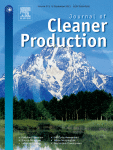
Mitigating vector-borne pathogen spread risks through promoting Gmelina arborea-based afforestation and agroforestry on private farms
2021
Summary
In this paper, the role of afforestation and agroforestry in mitigating risk of bat-borne disease transmission to humans is explored using an epidemiological-agroforestry model of land use decision on private farms.
Key Personnel & Institutions
Not available.Location
VERMONT, Massachusetts, Maine, New York, New Hampshire, Connecticut, Rhode Island, New England
Resource Type
Article
Tags
No tag keywords available
Topic Tags
conservation, ecosystem services, drivers, wildlife and habitat
Purpose Tags
conservation
Citation
Ranjan R., "Mitigating vector-borne pathogen spread risks through promoting Gmelina arborea-based afforestation and agroforestry on private farms", Journal of Cleaner Production, v. 315, 15 September 2021, https://doi.org/10.1016/j.jclepro.2021.128215
Source Link
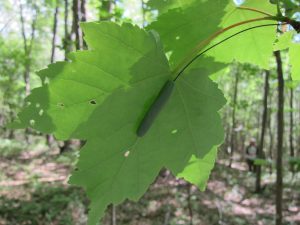
Effects of forest fragmentation on tri-trophic interactions
2022
Summary
As has been seen more generally with habitat specialist species, this study observed that more fragmented forest harbors fewer dietary specialist caterpillars relative to dietary generalist caterpillars. This project tests several alternative hypothetical mechanisms for this pattern.
Key Personnel & Institutions
People: Michael S. Singer
Institutions: Wesleyan University
Location
Connecticut
Resource Type
Article
Tags
No tag keywords available
Topic Tags
conservation, drivers, wildlife and habitat
Purpose Tags
conservation
Citation
Singer M., "Effects of Forest Fragmentation on Tri-Trophic Interactions", Wesleyan University, Accessed from: https://msinger.faculty.wesleyan.edu/enemy-free-space-and-caterpillar-diet-breadth/
Source Link
https://msinger.faculty.wesleyan.edu/enemy-free-space-and-caterpillar-diet-breadth/
Our forests are a precious resource
2019
Summary
The forests and trees add to the quality of life in The Last Green Valley. They are fundamental to the character of not just local communities but also the entire New England region. It is the woods and deeper forest blocks that provide the conditions supporting healthy ecosystems for animals and humans alike.
Key Personnel & Institutions
People: Bill Reid
Institutions: The Bulletin
Location
Connecticut
Resource Type
Article
Tags
No tag keywords available
Topic Tags
conservation, management, ecosystem services
Purpose Tags
conservation, management, education
Citation
Reid B., "Our forests are a precious resource", The Bulletin, 1 December 2019, Accessed from: https://www.norwichbulletin.com/story/news/columns/2019/12/01/our-forests-are-precious-resource/2178154007/
Source Link
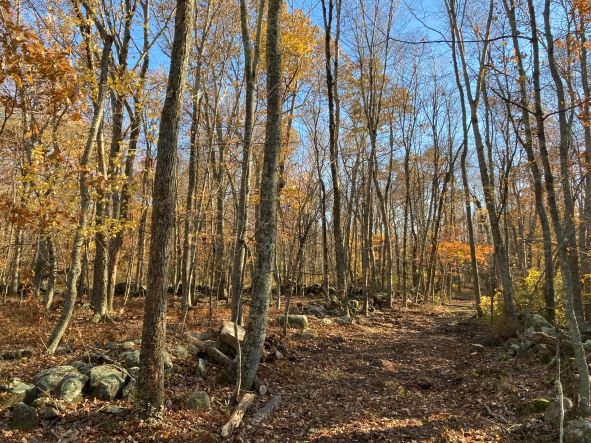
Southern New England Exurban Oak
2019
Summary
The Southern New England Exurban Affiliate Oak project, located in eastern Connecticut and southern Rhode Island, is participating in a study called the Adaptive Silviculture for Climate Change (ASCC) Network. This project is a collaborative effort to establish a series of experimental silvicultural trials across different forest ecosystem types. They are currently implementing an affiliate trial within Southern New England to test different silvicultural approaches to climate change and forest health adaptation that will also serve as useful examples across the U.S. and Canada.
Key Personnel & Institutions
People: Thomas E. Worthley , Christopher Riely
Location
Connecticut, Rhode Island
Resource Type
Website
Tags
No tag keywords available
Topic Tags
conservation, management, ecosystem services
Purpose Tags
conservation, management
Citation
Worthley T., Fahey R., Riely C., "Southern New England Exurban Oak", 2022, Accessed from: https://www.adaptivesilviculture.org/SNEoak
Source Link
The Lower Connecticut River and Coastal Region Land Trust Exchange
2006
Summary
The Lower CT River and Coastal Region Land Trust Exchange (LTE) is an informal collaboration of 14 land trusts representing the 17 communities of its coordinating organization the Lower CT River Valley Council of Governments (LCRVCOG), formerly the CT River Estuary Regional Planning Agency and Mid State Regional Planning Agency, consecutive CT River centered regional planning organizations merged in large part to conserve and protect the unique character and environment of the communities of the lower CT River and Coastal Region. The creation of the LTE was an outcome of the National Fish and Wildlife Foundation, 2006 funded Lower CT River Ground-Truthing Project
Key Personnel & Institutions
Not available.Location
Connecticut
Resource Type
Article
Tags
No tag keywords available
Topic Tags
conservation, methods, management, ecosystem services, landscape pattern and connectivity
Purpose Tags
conservation, management
Citation
"The Lower Connecticut River and Coastal Region Land Trust Exchange", 2022, Accessed from: https://www.rivercog.org/wp-content/uploads/2022/05/LTEupdate042817.pdf
Source Link
https://www.rivercog.org/wp-content/uploads/2022/05/LTEupdate042817.pdf
Natural Resources North Smothfield Rhode Island
2018
Summary
The purpose of the Natural Resource and Conservation element is to provide guidance and support through various goals, policies, and actions for conservation efforts that protect and manage the town's natural resources. Conservation of natural resources are evaluated and protected concurrently with open space, historical and cultural significant areas. Therefore, this element is closely linked to the Open Space element as well as the Historical and Cultural elements of this Plan. This Plan includes an inventory of existing natural resources, the threats to these resources, and ways to assure the conservation of these Town assets.
Key Personnel & Institutions
Not available.Location
Rhode Island
Resource Type
Article
Tags
No tag keywords available
Topic Tags
conservation, management, ecosystem services
Purpose Tags
conservation, management
Citation
"Natural Resources North Smothfield Rhode Island" December 12, Accessed from: https://www.nsmithfieldri.org/sites/g/files/vyhlif3596/f/uploads/natural_resources_12-12-18.pdf
Source Link
https://www.nsmithfieldri.org/sites/g/files/vyhlif3596/f/uploads/natural_resources_12-12-18.pdf

Forest Planning and Assessment
2022
Summary
The Center for Watershed Protection works to advance clean water resources and healthy ecosystems through responsible land and water management. Some projects include forest planning and assessment which is important for conservation and the health of our nation's watersheds.
Key Personnel & Institutions
Not available.Location
VERMONT, Massachusetts, Maine, New York, New Hampshire, Connecticut, Rhode Island, New England
Resource Type
Article
Tags
No tag keywords available
Topic Tags
conservation, management, ecosystem services, drivers, landscape pattern and connectivity
Purpose Tags
conservation, management, education
Citation
"Forest Planning and Assessment", Center for Watershed Protection, Accessed from: https://cwp.org/forest-planning-and-assessment/
Source Link
Forest Fragmentation, Town of East Granby, Connecticut
2006
Summary
This is a map of connecticut's forest land cover from the year of 2006.
Key Personnel & Institutions
Not available.Location
Connecticut
Resource Type
Map
Tags
No tag keywords available
Topic Tags
landscape pattern and connectivity
Purpose Tags
No purpose tag keywords available
Citation
"Forest Fragmentation, Town of East Granby, Connecticut", 2016, Accessed from: file:///C:/Users/FEMC/Downloads/ForestFragmentation_11X17.pdf
Source Link
The Future of our Forests: Land Protection and Sustainable Forest Management
2013
Summary
This is a strategic conservation plan for the MassCon Sustainable Forest Partnership. The MassConn Sustainable Forest Partnership (MassConn) has placed a high premium on working closely and cooperatively with a variety of partners and private landowners to develop a Strategic Conservation Plan that will build a greener, more sustainable future for all.
Key Personnel & Institutions
Institutions: The Sustainable Forestry Partnership
Location
Massachusetts, Connecticut
Resource Type
Report
Tags
No tag keywords available
Topic Tags
conservation, methods, management, ecosystem services, planning
Purpose Tags
conservation, management, policy
Citation
"The Future of our Forests: Land Protection and Sustainable Forest Management", August 2013, Accessed from: https://newenglandforestry.org/wp-content/uploads/2016/04/Final_MassConn_SCP_09.30.13.pdf
Source Link
https://newenglandforestry.org/wp-content/uploads/2016/04/Final_MassConn_SCP_09.30.13.pdf
Managing Forests for Trees and Birds in Connecticut
2020
Summary
This manual presents basic principles to evaluate forests with bird habitat in mind and ways to use silviculture to manage for bird habitat. Here, silviculture is considered as a way to produce birds as well as timber.
Key Personnel & Institutions
Institutions: Audubon Connecticut
Location
Connecticut
Resource Type
Book
Tags
No tag keywords available
Topic Tags
conservation, methods, management, ecosystem services, wildlife and habitat
Purpose Tags
conservation, management, education
Citation
"Managing Forests for Trees and Birds in Connecticut", Audubon Connecticut, 2020, Accessed from: https://ct.audubon.org/sites/default/files/guide_to_managing_forests_for_trees_birds_in_ct.pdf
Source Link
https://ct.audubon.org/sites/default/files/guide_to_managing_forests_for_trees_birds_in_ct.pdf
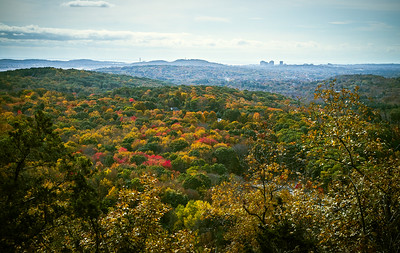
Expanding Forest Resource Education For Municipal Officials
2008 to 2011
Summary
CLEAR's National NEMO Network, in partnership with the USDA CSREES Forestry Program (through the RREA NFF program) and the U.S. Forest Service, launched the Forest Resources Education for Municipal Officials (FREMO) project in 2006 to augment traditional forestry outreach practices with new educational tools and approaches targeting local land use officials.
Key Personnel & Institutions
People: David W. Dickson
Institutions: University of Connecticut
Location
Connecticut
Resource Type
Report
Tags
No tag keywords available
Topic Tags
conservation, methods, management
Purpose Tags
conservation, management, education
Citation
Dickson D., "Expanding Forest Resource Education For Municipal Officials", University of Connecticut, 2011, Accessed from: https://reeis.usda.gov/web/crisprojectpages/0216077-expanding-forest-resource-education-for-municipal-officials.html
Source Link
The Forests of Rhode Island
1997 to 2002
Summary
This report summarizes a 1998 inventory of the forests resources of Rhode Island.
Key Personnel & Institutions
People: Tonya Lister , Andrew Lister , Brett Butler , Eric H. Wharton , Catherine Sparks , Paul Ricard , Marla Emery , Thomas A. Dupree , Paul Dolan , Charles J. Barnett
Institutions: United States Department of Agriculture (USDA), Forest Service, Northern Research Station
Location
Rhode Island
Resource Type
Report
Tags
No tag keywords available
Topic Tags
conservation, drivers, wildlife and habitat
Purpose Tags
conservation
Citation
Barnett C., Butler B., Dolan P., Dupree T., Emery M., Lister A., Lister T., Ricard P., Sparks C., Wharton E., Widmann R., “The Forests of Rhode Island” 2002, Accessed from: https://www.fs.usda.gov/research/treesearch/4855
Source Link
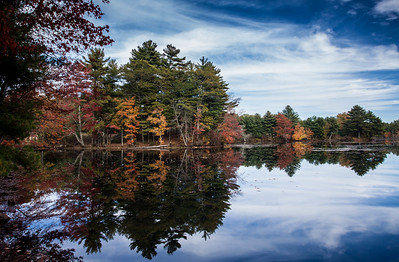
2021, H 5760 Substitute A, State of Rhode Island
2021
Summary
This is an act to amend the General Laws entitled "Agriculture and Forestry" in the state of Rhode Island.
Key Personnel & Institutions
Not available.Location
Rhode Island
Resource Type
Report
Tags
No tag keywords available
Topic Tags
conservation, methods, management, drivers
Purpose Tags
conservation, management
Citation
"2021, H 5760 Substitute A, State of Rhode Island", 2021, Accessed from: http://webserver.rilin.state.ri.us/BillText/BillText21/HouseText21/H5760A.pdf
Source Link
http://webserver.rilin.state.ri.us/BillText/BillText21/HouseText21/H5760A.pdf
USDA awards new partnership project in Rhode Island to help mitigate climate change and protect natural resources
Summary
The U.S. Department of Agriculture (USDA) has announced that it is investing $330 million nationwide in 85 locally driven, public-private partnerships to address climate change, improve the nation's water quality, combat drought, enhance soil health, support wildlife habitat and protect agricultural viability, including a project in Rhode Island. Projects are awarded through the Natural Resources Conservation Service (NRCS) Regional Conservation Partnership Program (RCPP).
Key Personnel & Institutions
Not available.Location
No location information available
Resource Type
Report
Tags
No tag keywords available
Topic Tags
No topic tag keywords available
Purpose Tags
No purpose tag keywords available
Citation
Petit D., "USDA awards new partnership project in Rhode Island to help mitigate climate change and protect natural resources", 30 April 2021, Accessed from: https://www.nrcs.usda.gov/wps/portal/nrcs/detail/ri/newsroom/releases/?cid=NRCSEPRD1770845
Source Link
https://www.nrcs.usda.gov/wps/portal/nrcs/detail/ri/newsroom/releases/?cid=NRCSEPRD1770845
State and Private Forestry Fact Sheet: Rhode Island 2022
2022
Summary
The U.S. Forest Service and state forestry agencies collaborate with other partners on shared stewardship goals, which also support each State Forest Action Plan. The State and Private Forestry programs promote the health, resilience, and productivity of trees and forests across all ownerships for the benefit of people and wildlife; establish and manage urban and community forests; empower private landowners with information and technical assistance to sustainably manage their forests; and protect critically important rural forests and watersheds.
Key Personnel & Institutions
Institutions: United States Department of Agriculture (USDA), Forest Service
Location
Rhode Island
Resource Type
Report
Tags
No tag keywords available
Topic Tags
conservation, methods, management, ecosystem services, planning
Purpose Tags
conservation, management, policy
Citation
"State and Private Forestry Fact Sheet: Rhode Island 2022", 13 October 2022, Accessed from: https://apps.fs.usda.gov/nicportal/temppdf/sfs/naweb/ri_std.pdf
Source Link
https://apps.fs.usda.gov/nicportal/temppdf/sfs/naweb/ri_std.pdf
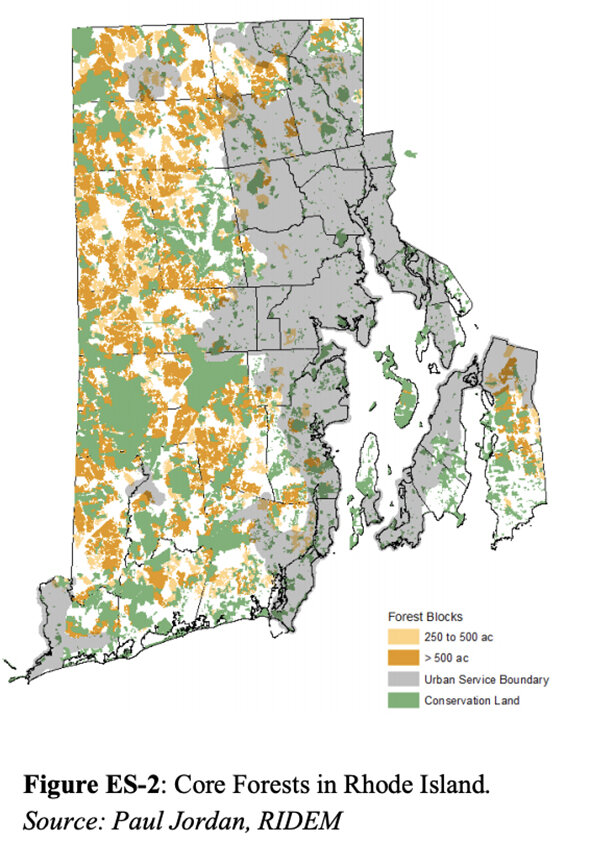
The Value of Rhode Island's Forest Land: R.I.'s Green Canopy Provides Priceless Protection
2021
Summary
This article discusses the importance of Rhode Island's forests, what threats the forests are facing and what needs to be done to protect this valuable resource.
Key Personnel & Institutions
People: Grace Kelly
Institutions: EcoRI
Location
Rhode Island
Resource Type
Article
Tags
No tag keywords available
Topic Tags
conservation, methods, management, drivers, landscape pattern and connectivity
Purpose Tags
conservation, management
Citation
Kelly G., "The Value of Rhode Island's Forest Land: R.I.'s Green Canopy Provides Priceless Protection", 20 Fabruary 2021, ecoRI News, Accessed from: http://www.progressive-charlestown.com/2021/02/the-value-of-rhode-islands-forest-land.html
Source Link
http://www.progressive-charlestown.com/2021/02/the-value-of-rhode-islands-forest-land.html
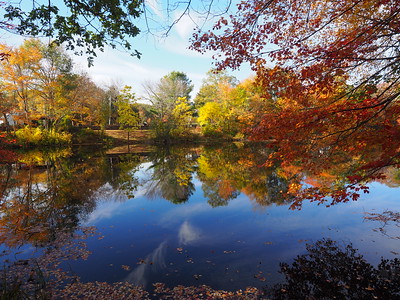
Development threatens R.I. woodlands
2018
Summary
Despite that image, the ability of woodlands to provide all those benefits is threatened by their continued loss and by fragmentation of the canopy. The rate at which the construction of roads, subdivisions and other human development continue to break up large, contiguous blocks of forest into an increasing number of smaller pieces is alarming. Fragmentation divides up the resource, and these islands of woodland provide limited benefits.
Key Personnel & Institutions
People: Christopher Riely
Institutions: Providence Journal
Location
No location information available
Resource Type
Article
Tags
No tag keywords available
Topic Tags
No topic tag keywords available
Purpose Tags
No purpose tag keywords available
Citation
Riely C., "Development Threatens R.I. Woodlands", 3 March 2018, Accessed from: https://www.providencejournal.com/story/opinion/2018/03/03/my-turn-development-threatens-ri-woodlands/13764670007/
Source Link
Forest Birds of Connecticut and Rhode Island
1984 to 2017
Summary
This volume extends upon the earlier works of Rhode Island and Connecticut breeding bird atlases by mapping the population density of forest birds inhabiting Connecticut and Rhode Island.
Key Personnel & Institutions
Not available.Location
Connecticut, Rhode Island
Resource Type
Book
Tags
No tag keywords available
Topic Tags
conservation, ecosystem services, drivers, wildlife and habitat
Purpose Tags
conservation
Citation
Craig R., "Forest Birds of Connecticut and Rhode Island", Bird Conservation Research, Inc., 2017, Accessed from: https://d1wqtxts1xzle7.cloudfront.net/67189700/Forest_Birds_of_CT_RI_2-with-cover-page-v2.pdf?Expires=1666020802&Signature=ZFB~SKGya-s5srW5E~XUgqZRVBd4JiqAcMloIJsWzEFPHBOB-9ZMZuMeCLR45B2qOlHVXpxDbSvX2pVuJ67zRXI6yfa-cs9-c6IXaKxGR-Sn5y1a5inURk~~Pdsut-cgTQKB0dMbMdljKo7WaQ3bAeIJXLL6b1kuyLN56Tm3dW9qRTECjyw-poatrMB6stQOB0K4lSd0W-RBB1Hp~W2Ti1~TJa7VxPC8EN0cls~X3MtnDjvJ0P6y0tnjBZgx4u4U7DZNzSqk1XFx8OozEColLVux1n2Emu1cMTwrfA6ld37PDwzLJkl8hB7X8mo~dkmptBkplmxSigPUxOL9hJdQug__&Key-Pair-Id=APKAJLOHF5GGSLRBV4ZA
Source Link
https://www.academia.edu/35777828/Forest_Birds_of_Connecticut_and_Rhode_Island

Relationship Between Habitat and Landscape Features and the Avian Community of Red Maple Swamps in Southern Rhode Island
2001
Summary
This study investigated the relationship between habitat and landscape characteristics and the abundance and species richness of breeding birds in 12 southern Rhode Island red maple (Acer rubrum) swamps of varying size (0.5–19.2 ha).
Key Personnel & Institutions
People: Francis C. Golet
Institutions: US Army Corp of Engineers , University of Rhode Island, Department of Natural Resources Science
Location
Rhode Island
Resource Type
Article
Tags
No tag keywords available
Topic Tags
conservation, ecosystem services, drivers, wildlife and habitat
Purpose Tags
conservation
Citation
Golet F. C., Wang Y., Merrow J. S., DeRagon W. R., "Relationship Between Habitat and Landscape Features and the Avian Community of Red Maple Swamps in Southern Rhode Island", The Wilson Bulletin, 113(2), 217-227, 1 June 2001, https://doi.org/10.1676/0043-5643(2001)113[0217:RBHALF]2.0.CO;2
Source Link
How Forest Gaps Affect Tree Crown Architecture: The Response of Some New England Deciduous Forest Tree Genera
2017
Summary
This study was conducted in the Yale -Myers Experimental Forest. It is a temperate deciduous forest. This study asked (1) whether light from a gap promotes asymmetrical growth of tree crowns, (2) if the asymmetrical growth diminishes as a function of distance from the gap edge, and (3) if the response was species specific and related to a given species of shade tolerance.
Key Personnel & Institutions
Not available.Location
Connecticut
Resource Type
Report
Tags
No tag keywords available
Topic Tags
conservation, drivers, landscape pattern and connectivity
Purpose Tags
conservation
Citation
Godfrey K. N., "How Forest Gaps Affect Tree Crown Architecture: The Response of Some New England Deciduous Forest Tree Genera", 2017, Accessed from: https://w3.ric.edu/faculty/rdegouvenain/kate godfrey 2017.pdf
Source Link
https://w3.ric.edu/faculty/rdegouvenain/kate godfrey 2017.pdf

Population Genetics and Spatial Ecology of Bobcats (Lynx rufus) in a Landscape with a High Density of Humans in New England
2021
Summary
The objectives of this study were to better understand the spatial and population structure of Bobcats in Rhode Island. They specifically examined space use, resource selection, and population genetics.
Key Personnel & Institutions
Institutions: United States Department of Agriculture (USDA), Agricultural Research Service , University of Rhode Island, Department of Natural Resources Science, Rhode Island Department of Environmental Management, Rhode Island Division of Fish & Wildlife
Location
Rhode Island
Resource Type
Article
Tags
No tag keywords available
Topic Tags
conservation, management, drivers, wildlife and habitat, landscape pattern and connectivity
Purpose Tags
conservation, management
Citation
Mayer A. E., McGreevy J. Jr, Sullivan M. E., Brown C., Husband T. P., Gerber B. D., "Population Genetics and Spatial Ecology of Bobcats (Lynx rufus) in a Landscape with a High Density of Humans in New England", Northeastern Naturalist, 28(4):408-429 (2021), https://doi.org/10.1656/045.028.0401
Source Link

Transient persistence of bobcat (Lynx rufus) occurrence throughout a human-dominated landscape
2017 to 2020
Summary
The objectives of this study were to investigate the landscape occupancy dynamics of bobcats in a highly developed and densely populated region of the northeastern United States to evaluate the sensitivity of bobcat occurrence to natural and anthropogenic landscape features.
Key Personnel & Institutions
Institutions: University of Rhode Island, Department of Natural Resources Science, Rhode Island Department of Environmental Management, Rhode Island Division of Fish & Wildlife
Location
Rhode Island
Resource Type
Article
Tags
No tag keywords available
Topic Tags
conservation, management, wildlife and habitat, landscape pattern and connectivity
Purpose Tags
conservation, management
Citation
Mayer A. E., McGreevy T. J. Jr., Brown C., Ganoe L. S., Gerber B. D., "Transient persistence of bobcat (Lynx rufus) occurrence throughout a human-dominated landscape", Population Ecology, v. 64, iss 4, p. 323-335, 23 March 2022, https://doi.org/10.1002/1438-390X.12123
Source Link

How fire interacts with habitat loss and fragmentation
2021
Summary
This comprehensive synthesis, including 162 papers which provided 274 cases, offers a framework for understanding how fire interacts with fragmentation.
Key Personnel & Institutions
Institutions: University of Melbourne
Location
VERMONT, Massachusetts, Maine, New York, New Hampshire, Connecticut, Rhode Island, New England
Resource Type
Article
Tags
No tag keywords available
Topic Tags
conservation, management, drivers, landscape pattern and connectivity
Purpose Tags
conservation, management
Citation
Driscoll D. A., Armenteras D., Bennett A. F., Brotons L., Clarke M. F., Doherty T. S., Haslem A., Kelly L. T., Sato C. F., Sitters H., et al, "How fire interacts with habitat loss and fragmentation", Biological Reviews, v. 96, iss 3, p. 976-998, 9 February 2021, https://doi.org/10.1111/brv.12687
Source Link
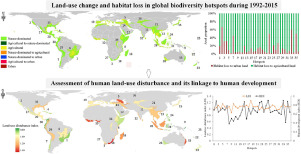
Hotspots of land-use change in global biodiversity hotspots
2021
Summary
Land-use conversion from natural areas to agriculture and human settlements is causing global biodiversity loss. The authors proposed a human land-use disturbance index (LDI) to assess habitat loss and fragmentation in global biodiversity hotspots from 1992 to 2015. Negative (LDI > 1) and positive (LDI < 1) impacts on habitat were observed in 30 and 6 biodiversity hotspots, respectively. The hotspots with a relatively small proportional area of nature-dominated land were more likely to face habitat loss.
Key Personnel & Institutions
Not available.Location
VERMONT, Massachusetts, Maine, New York, New Hampshire, Connecticut, Rhode Island, New England
Resource Type
Article
Tags
No tag keywords available
Topic Tags
conservation, management, drivers, wildlife and habitat, landscape pattern and connectivity
Purpose Tags
conservation, management
Citation
Kong X., Zhou Z., Jiao L., "Hotspots of land-use change in global biodiversity hotspots", Resources, Conservation and Recycling, v. 174, November 2021, https://doi.org/10.1016/j.resconrec.2021.105770
Source Link
https://www.sciencedirect.com/science/article/abs/pii/S0921344921003797
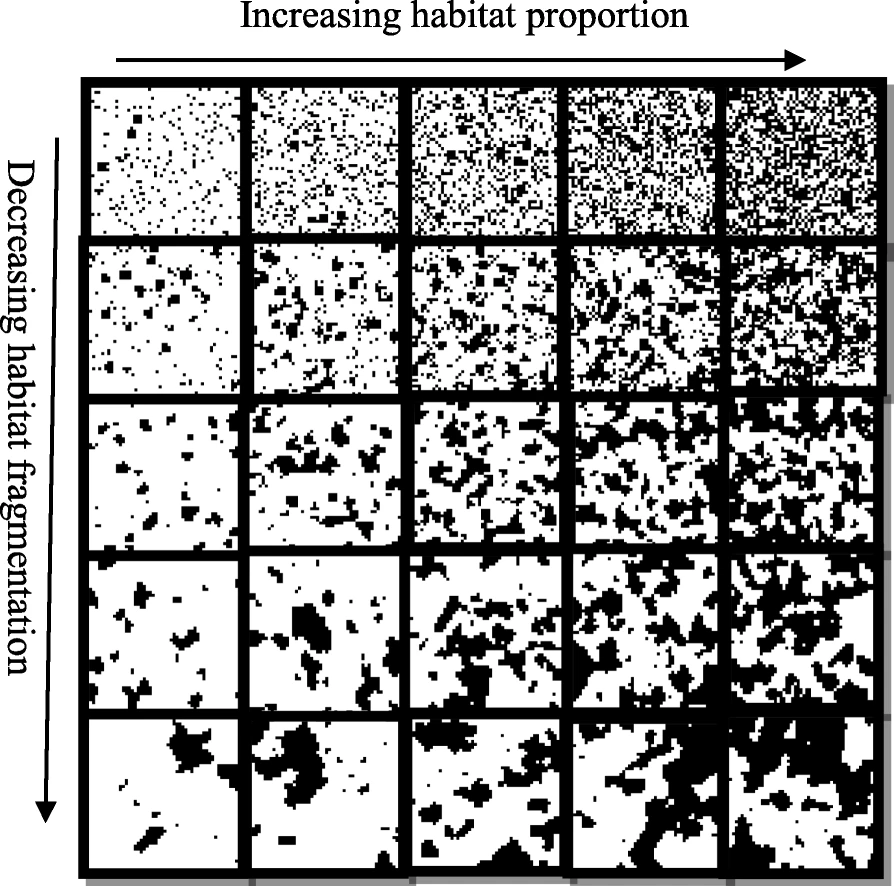
Using the Lonsdorf model for estimating habitat loss and fragmentation effects on pollination service
2021
Summary
This study aimed to examine the effects of habitat loss and fragmentation on pollination separately. For this purpose, first, they generated different simulated agricultural landscapes, including two habitats of forest and agriculture. Then, according to the Lonsdorf model, they estimated the potential of the simulated landscapes in providing pollination in different scenarios. Finally, using statistical models, they estimated the effects of habitat loss and fragmentation on pollination at the landscape and farm levels.
Key Personnel & Institutions
Not available.Location
VERMONT, Massachusetts, Maine, New York, New Hampshire, Connecticut, Rhode Island, New England
Resource Type
Article
Tags
No tag keywords available
Topic Tags
conservation, methods, drivers, wildlife and habitat, landscape pattern and connectivity
Purpose Tags
conservation
Citation
Rahimi E., Barghjelveh S., Dong P., "Using the Lonsdorf model for estimating habitat loss and fragmentation effects on pollination service", Ecological Processes 10, no. 22, 2021, https://doi.org/10.1186/s13717-021-00291-8
Source Link
https://link.springer.com/article/10.1186/s13717-021-00291-8

Forestry Matters: Decline of Oaks Will Impact Wildlife in Hardwood Forests
2010
Summary
This article speaks to the important role of oaks and the production of acorns to support the wildlife in many deciduous forests. Forest management, introduced pests and pathogens and increased deer populations have resulted in significant changes in teh demography of oaks in eastern North America. Effective forest management is important. This article provides reccomendations on management practices.
Key Personnel & Institutions
People: Frank Koch , William M. Healy
Institutions: United States Department of Agriculture (USDA), Forest Service , North Carolina State University, Department of Forestry and Environmental Resources , Virginia Polytechnic Institute and State University
Location
VERMONT, Massachusetts, Maine, New York, New Hampshire, Connecticut, Rhode Island, New England
Resource Type
Article
Tags
No tag keywords available
Topic Tags
conservation, methods, management, wildlife and habitat
Purpose Tags
conservation, management
Citation
McShea W. J., Healy W. M., Devers P., Fearer T., Koch F. H., Stauffer D., Waldon J., "Forestry Matters: Decline of Oaks Will Impact Wildlife in Hardwood Forests", The Journal of Wildlife Management, v. 71, iss 5, p. 1717-1728, 13 December 2010, https://doi.org/10.2193/2006-169
Source Link
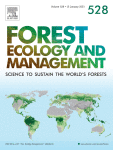
State efforts to promote early-successional habitats on public and private lands in the northeastern United States
2003
Summary
State wildlife agencies are generally charged with conserving all native wildlife and their habitats within their respective state. However, some have suggested that state wildlife agencies in the region are not addressing the decline of early-successional wildlife and habitats sufficiently. This study investigated the extent to which 11 state agencies in this region are creating and maintaining early-successional habitats on public and private lands.
Key Personnel & Institutions
People: James Oehler
Institutions: Massachusetts Division of Fisheries and Wildlife, New Hampshire Fish and Game Department
Location
VERMONT, Massachusetts, Maine, New York, New Hampshire, Connecticut, Rhode Island, New England
Resource Type
Article
Tags
No tag keywords available
Topic Tags
conservation, methods, management, wildlife and habitat, landscape pattern and connectivity
Purpose Tags
conservation, management
Citation
Oehler J. D., "State efforts to promote early-successional habitats on public and private lands in the northeastern United States", v. 185, iss 1-2, p. 169-177, 3 November 2003, https://doi.org/10.1016/S0378-1127(03)00253-6
Source Link
https://www.sciencedirect.com/science/article/abs/pii/S0378112703002536
Forests on the Edge: Housing Development on America's Private Forests
2005
Summary
The Forests on the Edge project seeks to improve understanding of the processes and thresholds associated with increases in housing density in private forests and likely effects on the contributions of those forests to timber, wildlife and water resources. This report, the first in a series, displays and describes housing density projections on private forests, by watershed, across teh conterminous United States.
Key Personnel & Institutions
People: David Theobald, Ron McRoberts , Mark Nelson , Mike Eley , Mike Dechter , Susan Stein , Ralph J. Alig , Marcy Carr
Institutions: United States Department of Agriculture (USDA), Forest Service , United States Department of Agriculture (USDA), Forest Service, Pacific Northwest Research Station
Location
VERMONT, Massachusetts, Maine, New York, New Hampshire, Connecticut, Rhode Island, New England
Resource Type
Book
Tags
No tag keywords available
Topic Tags
conservation, management, drivers, wildlife and habitat, landscape pattern and connectivity
Purpose Tags
conservation, management
Citation
Stein S. M., McRoberts R. E., Alig R. J., Nelson M. D., Theobald D. M., Eley M., Dechter M., Carr M., "Forests on the Edge: Housing Develipment on America's Private Forests", 2005, Accessed from: https://books.google.com/books?hl=en&lr=&id=o8OtV6o4zu4C&oi=fnd&pg=PP7&dq=forest+parcelization+rhode+island&ots=nta0vCllKs&sig=HA_FvLe6exX0NPfhAejChgzzEtc#v=onepage&q&f=false
Source Link
Criterion 7: Legal, institutional, and economic framework for forest conservation and sustainable management
2012
Summary
This criterion focuses on the social context of forests—the laws, policies, administrative rules, and social and economic institutions—that governs forest resource management and use. What society permits or restricts, encourages or discourages all influence the sustainability of forest resources. Criterion 7 captures this by turning attention to all the different social institutions that create and enforce rules about resource management and use.
Key Personnel & Institutions
People: Sherri Wormstead , Stephen Shifley, Francisco Aguilar, David J. Nowak , Eric J. Greenfield , Susan Stewart , Nianfu Song , Dale D. Gormanson , W. Keith Moser
Institutions: United States Department of Agriculture (USDA), Forest Service, Northern Research Station , United States Department of Agriculture (USDA), Forest Service, Rocky Mountain Research Station
Location
VERMONT, Massachusetts, Maine, New York, New Hampshire, Connecticut, Rhode Island, New England
Resource Type
Article
Tags
No tag keywords available
Topic Tags
conservation, management, ecosystem services
Purpose Tags
conservation, management, policy
Citation
Shifley S. R., Aguilar F. X., Song N., Stewart S. I., Nowak D. J., Gormanson D. D., Moser W. K., Wormstead S., Greenfield E. J., "Criterion 7: Legal, institutional, and economic framework for forest conservation and sustainable management", 2012, General Technical Report, Accessed from: https://www.fs.usda.gov/research/treesearch/40229
Source Link
How are America's private forests changing? An integrated assessment of forest management, housing pressure, and urban development in alternate emissions scenarios
2013
Summary
Private forests are a vital component of the natural ecosystem infrastructure of the United States, and provide critical ecosystem services including clean air and water, energy, wildlife habitat, recreational services, and wood fiber. These forests have been subject to conversion to developed uses due to increasing population pressures. This study examines the changing patterns in the private forests across the urban–rural gradient in 36 states in the eastern United States.
Key Personnel & Institutions
People: Brett Butler , David Kittredge , W. Keith Moser
Institutions: United States Department of Agriculture (USDA), Forest Service, Northern Research Station , Harvard University, Harvard Forest , University of Massachusetts, Amherst, Department of Environmental Conservation
Location
VERMONT, Massachusetts, Maine, New York, New Hampshire, Connecticut, Rhode Island, New England
Resource Type
Article
Tags
No tag keywords available
Topic Tags
conservation, management, drivers, landscape pattern and connectivity
Purpose Tags
conservation, management
Citation
Mondal P., Butler B. J., Kittredge D. B., Moser W. K., "How are America's private forests changing? An integrated assessment of forest management, housing pressure, and urban development in alternate emissions scenarios", Land Use Policy, v. 32, p. 230-238, 16 October 2012, Accessed from: https://d1wqtxts1xzle7.cloudfront.net/47884817/How_are_Americas_private_forests_changi20160808-9002-1p709ec-libre.pdf?1470659666=&response-content-disposition=inline;+filename=How_are_Americas_private_forests_changin.pdf&Expires=1666120463&Signature=Dtrwpket~u840ueYs6Wa0j9SAmhMA~LWl-nQ4fNAJBZ4bHbeLvi5rdIks1IHZKUCzeLRsgLkhL1rcXQyeLB9Z9Hro5GzKwyygEX2SWj-rYuNjuri6arxRpc3C~EwZnjE1DAQ9ESC4BN7IR1MgItMwCq-HXVGwANX0K-s5MIRQxWmh3DYXdk9eiCjGz459tH98wqxRvTvIKCjvTGRe0fgsjn3volA~H81mw51bUI5LKGUGFcvxi3Fy-IcSepsxKMedygBGrg4zKOcfFKIKZsbFSBDOS08tkVfEcXeIWNZ-Yu8sHfV9gJBMeFSxjNHoGzCMpuvvwIM7GyNsZqGpUXj4A__&Key-Pair-Id=APKAJLOHF5GGSLRBV4ZA
Source Link
US Urban Forest Statistics, Values, and Projections
2018
Summary
The purpose of this paper is to update and summarize urban forest ecosystem services and values (i.e., pollution removal, carbon storage and sequestration, altered building energy use and power plant emissions) at the state and national level, as well as provide new state estimates on urban forest structure (i.e., tree cover, number of trees, leaf area, leaf biomass) and projections of urban land growth between 2010 and 2060. These statistics and projections can be used to help inform states on the value and magnitude of their urban forests, as well as guide state policies to help protect and enhance this valuable resource.
Key Personnel & Institutions
People: David J. Nowak , Eric J. Greenfield
Institutions: United States Department of Agriculture (USDA), Forest Service , The State University of New York (SUNY), College of Environmental Science and Forestry (ESF)
Location
VERMONT, Massachusetts, Maine, New York, New Hampshire, Connecticut, Rhode Island, New England
Resource Type
Article
Tags
No tag keywords available
Topic Tags
conservation, ecosystem services
Purpose Tags
conservation, policy
Citation
Nowak D. J., Greenfield E. J., "US Urban Forest Statistics, Values, and Projections", Journal of Forestry, v. 116, iss. 2, 12 March 2018, pp. 164-177, https://doi.org/10.1093/jofore/fvx004
Source Link
Forest conditions and trends in the northern United States
2012
Summary
This section describes current conditions and trends for the 20 Northern States by focusing on selected characteristics associated with forest sustainability. Its format is based upon a set of 64 indicators within 7 broad criteria that the United States and 11 other countries have adopted under the auspices of the Montréal Process Working Group on Criteria and Indicators for the Conservation and Sustainable Management of Temperate and Boreal Forests. To these, we have added an eighth criterion focused on the urban and community forests in the northern United States.
Key Personnel & Institutions
People: Sherri Wormstead , Stephen Shifley, Francisco Aguilar, David J. Nowak , Eric J. Greenfield , Susan Stewart , Nianfu Song , Dale D. Gormanson , W. Keith Moser
Institutions: United States Department of Agriculture (USDA), Forest Service, Northern Research Station , United States Department of Agriculture (USDA), Forest Service, Rocky Mountain Research Station
Location
VERMONT, Massachusetts, Maine, New York, New Hampshire, Connecticut, Rhode Island, New England
Resource Type
Article
Tags
No tag keywords available
Topic Tags
conservation, management, drivers
Purpose Tags
conservation, management
Citation
Shifley S. R., Aguilar F. X., Song N., Steward S. I., Nowak D. J., Gormanson D. D., Moser W. K., Wormstead S., Greenfield E. J., "Forest conditions and trends in the northern United States", 2012, Accessed from: https://www.fs.usda.gov/research/treesearch/40222
Source Link
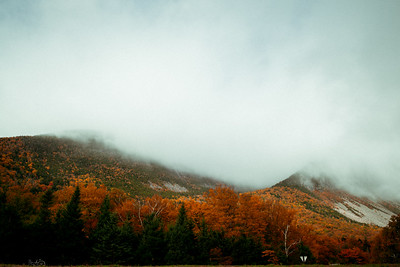
Financial Incentive Programs' Influence in Promoting Sustainable Forestry in the Northern Region
2009
Summary
Selected forestry officials in each of the 20 northern states were surveyed concerning their opinions on the public and private financial incentive programs available to nonindustrial private forest owners in their state. The officials were asked to name and describe the programs and to assess forest owners' awareness of each one, its appeal among the owners aware of it, its effectiveness in encouraging sustainable forestry and enabling owners to meet their objectives, and the percentage of program practices that remain in place and enrolled acres that remain in forest over time. They also were asked to suggest ways to improve the programs.
Key Personnel & Institutions
People: Michael Kilgore, John L. Greene , Thomas J. Straka
Institutions: United States Department of Agriculture (USDA), Forest Service, Southern Research Station , Utah State University, University of Minnesota, The Pennsylvania State University
Location
VERMONT, Massachusetts, Maine, New York, New Hampshire, Connecticut, Rhode Island, New England
Resource Type
Article
Tags
No tag keywords available
Topic Tags
conservation, methods, management, ecosystem services
Purpose Tags
conservation, management
Citation
Jacobson M. G., Straka T. J., Greene J. L., Kilgore M. A., Daniels S. E., "Financial Incentive Programs' Influence in Promoting Sustainable Forestry in the Northern Region", Northern Journal of Applied Forestry, V. 26, Iss. 2, June 2009, p. 61-67, https://doi.org/10.1093/njaf/26.2.61
Source Link
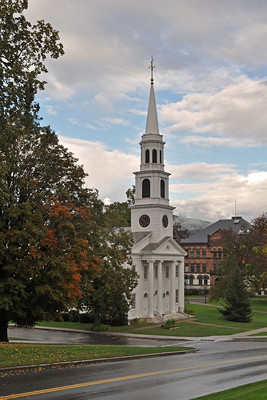
Urbanization in the US: land use trends, impacts on forest area, projections, and policy considerations
2010
Summary
Since World War II, socio-economic drivers of US urbanization such as population totals and personal income levels have increased substantially. Human land use is the primary force driving changes in forest ecosystem attributes including forest area, which is the focus of this paper.
Key Personnel & Institutions
People: Ralph J. Alig
Institutions: United States Department of Agriculture (USDA), Forest Service, Pacific Northwest Research Station
Location
VERMONT, Massachusetts, Maine, New York, New Hampshire, Connecticut, Rhode Island, New England
Resource Type
Article
Tags
No tag keywords available
Topic Tags
conservation, management, drivers, landscape pattern and connectivity
Purpose Tags
conservation, management
Citation
Alig R., "Urbanization in the US: land use trends, impacts on forest area, projections, and policy considerations", Journal of Resources, Energy and Development, 2010, v. 10, no. 2, pp. 35-60, DOI: 10.3233/RED-120068
Source Link
https://content.iospress.com/articles/journal-of-resources-energy-and-development/red120068
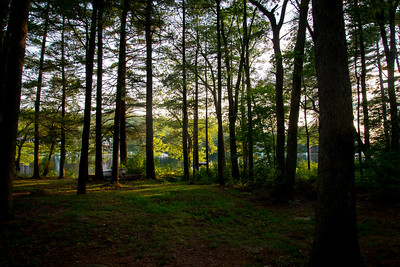
Investigating the Role of Professional Planners for Enhancing Private Forest Legacy Decisions
2019
Summary
This research project addresses the deficit in the existing literature that identifies and demonstrates the process a forest owner will experience working with the planning professionals in developing strategies and plans to achieve the forest legacy outcome by engaging planning professionals to understand and delineate this process in two key sectors: estate attorneys and financial planners.
Key Personnel & Institutions
Institutions: The Pennsylvania State University
Location
VERMONT, Massachusetts, Maine, New York, New Hampshire, Connecticut, Rhode Island, New England
Resource Type
Article
Tags
No tag keywords available
Topic Tags
conservation, management
Purpose Tags
conservation, management, education
Citation
Roth P. A., "Investigating the Role of Professional Planners for Enhancing Private Forest Legacy Decisions", 2019, Accessed from: https://www.proquest.com/openview/b9930918a69ff1d53eb1547718d12fe0/1?pq-origsite=gscholar&cbl=18750&diss=y
Source Link
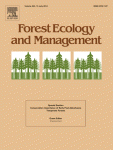
Synthesis of the conservation value of the early-successional stage in forests of eastern North America
2014
Summary
As a result of changes in natural and anthropogenic disturbance regimes, the extent of early-successional forest across much of eastern North American is near historic lows, and continues to decline. This has caused many scientists to identify the conservation of early-successional species as a high priority. This synthesis discusses the conservation implications of this loss of early-successional habitats using examples from the literature on songbirds.
Key Personnel & Institutions
People: David King
Institutions: United States Department of Agriculture (USDA), Forest Service, Northern Research Station , University of Massachusetts, Amherst, Department of Environmental Conservation
Location
VERMONT, Massachusetts, Maine, New York, New Hampshire, Connecticut, Rhode Island, New England
Resource Type
Article
Tags
No tag keywords available
Topic Tags
conservation, ecosystem services, drivers, wildlife and habitat
Purpose Tags
conservation
Citation
King D. I., Schlossberg S., "Synthesis of the conservation value of the early-successional stage in forests of eastern North America", Forest Ecology and Management, v. 324, 15 July 2014, p. 186-195, https://doi.org/10.1016/j.foreco.2013.12.001
Source Link

Ecosystems and Sustainable Development VII
2009
Summary
ECOSUD is a challenge for the creation of a new science in line with Prigogine's statement that "at all levels we observe events associated with the emergence of novelties and narrative elements, which we may associate with the creative power of nature". This is not only a platform to present novel research related to ecological problems from all over the world; it also gives opportunities for new emergent ideas in science arising from the cross fertilization of different disciplines, including mathematical models and eco-informatics, evolutionary thermodynamics and biodiversity, structures in ecosystems modelling and landscapes to mention but a few.
Key Personnel & Institutions
Not available.Location
VERMONT, Massachusetts, Maine, New York, New Hampshire, Connecticut, Rhode Island, New England
Resource Type
Book
Tags
No tag keywords available
Topic Tags
conservation, methods, management, ecosystem services, drivers
Purpose Tags
conservation, management, education
Citation
Brebbia C. A., Tiezzi E., "Ecosystems and Sustainable Development VII", 2009, Accessed from: https://books.google.com/books?hl=en&lr=&id=4nzNS-veZFMC&oi=fnd&pg=PA141&dq=forest+parcelization+rhode+island&ots=EkWCfY5XTr&sig=gCc8CPTAopF2vUAaYOwgValW82k#v=onepage&q&f=false
Source Link
Forest Biomass and Bioenergy: Opportunities and Constraints in the Northeastern United States
2011
Summary
Both the federal government and most states in the region are actively engaged in assessments of the potential role of forest biomass in renewable energy standards and portfolios. This study addressed two critical components of those assessments: the amount of biomass that can be sustainably harvested from Northeastern forests for energy purposes, and which conversion technologies and end?use applications should be pursued to most effectively reduce greenhouse gas emissions, reduce dependence on foreign oil, and promote the rural economy of the region.
Key Personnel & Institutions
People: Thomas Buchholz , Charles D. Canham
Institutions: University of Vermont, Rubenstein School of Environment and Natural Resources , Cary Institute of Ecosystem Studies , Environmental Defense Fund
Location
VERMONT, Massachusetts, Maine, New York, New Hampshire, Connecticut, Rhode Island, New England
Resource Type
Report
Tags
No tag keywords available
Topic Tags
conservation, methods, management, ecosystem services
Purpose Tags
conservation, management
Citation
Buchholz T., Canham C. D., Hamburg S. P., "Forest Biomass and Bioenergy: Opportunities and Constraints in the Northeastern United States", 17 February 2011, Accessed from: https://forestindustries.eu/sites/default/files/userfiles/1file/report_biomass_2011.pdf
Source Link
https://forestindustries.eu/sites/default/files/userfiles/1file/report_biomass_2011.pdf
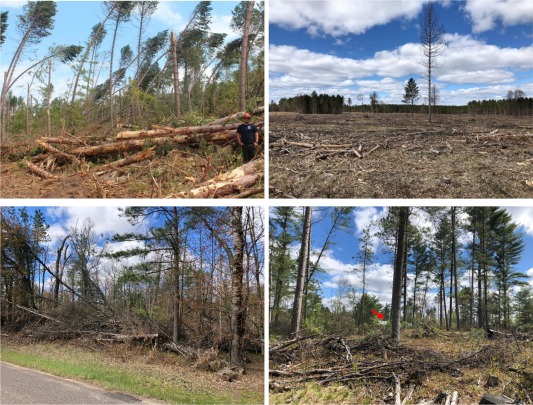
Place, loss, and landowner response to the restoration of a rapidly changing forest landscape
2022
Summary
Place-based models of landscape change assert that the strength of people's attachments can influence their experience of and response to change. This study applies a qualitative deductive-inductive approach to examine rapid change experienced by family forest owners in the northern Great Lakes region of the U.S. (N = 17), whose densely forested property was in the path of a major windstorm and near an ongoing pine barrens restoration.
Key Personnel & Institutions
People: Anna Haines, Kristen Floress
Institutions: United States Department of Agriculture (USDA), Forest Service, Northern Research Station , University of Massachusetts, UMass
Location
New York
Resource Type
Article
Tags
No tag keywords available
Topic Tags
conservation, management, ecosystem services, drivers
Purpose Tags
conservation, management
Citation
Gobster P. H., Weber E., Floress K. M., Schneider I. E., Haines A. L., Arnberger A., "Place, loss, and landowner response to the restoration of a rapidly changing forest landscape", Landscape and Uban Planning, V. 222, June 2022, https://doi.org/10.1016/j.landurbplan.2022.104382
Source Link
https://www.sciencedirect.com/science/article/pii/S0169204622000317
Multi-scale analysis of habitat fragmentation on small-mammal abundance and tick-borne pathogen infection prevalence in Essex County, MA
2022
Summary
Habitat fragmentation and heterogeneity transform otherwise contiguous tracks of forest into smaller patches in the northeastern U.S. and likely impact abundances, movement patterns, and disease transmission pathways for small-mammal communities at multiple scales. We sought to determine the structure of a small-mammal community in terms of mammal abundance and infection prevalence of Borrelia burgdorferi sensu stricto (s.s.), Anaplasma phagocytophilum, and Babesia microti within a fragmented landscape in Essex County, Massachusetts, USA.
Key Personnel & Institutions
Not available.Location
ESSEX
Resource Type
Article
Tags
No tag keywords available
Topic Tags
conservation, ecosystem services, wildlife and habitat
Purpose Tags
conservation
Citation
Mason S. D., Sherratt S. C., Kruguer S. M., Muthersbaugh M., Harris J. P., Gatlin W. C., Topp J. D., Keller G. S., "Multi-scale analysis of habitat fragmentation on small-mammal abundance and tick-borne pathogen infection prevalence in Essex County, MA", 13 June 2022, https://doi.org/10.1371/journal.pone.0269768
Source Link
https://journals.plos.org/plosone/article?id=10.1371/journal.pone.0269768
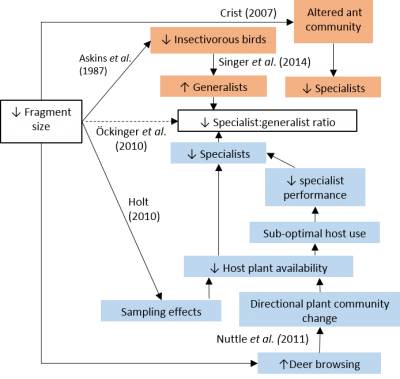
Forests Facing Environmental Change: Fragmented Ecological Networks
2022
Summary
The alteration of ecological networks by environmental change, including habitat fragmentation, is not well understood. This project will test alternative mechanistic pathways for loss of trophic specialization due to habitat fragmentation in a plant-herbivore-carnivore network. Elucidating these pathways will greatly improve predictive models of the impacts of fragmentation, which threatens habitat- and host-specialist species with local and global extinction.
Key Personnel & Institutions
People: Robert Bagchi , Dipanjana Dalui
Institutions: University of Connecticut, Department of Ecology and Evolutionary Biology
Location
Connecticut
Resource Type
Article
Tags
No tag keywords available
Topic Tags
conservation, drivers, wildlife and habitat
Purpose Tags
conservation
Citation
Bagchi R., Wasserman B., Dalui D., LaScaleia M., Lucky B. M. A., "Forests Facing Environmental Change: Fragmented Ecological Networks", 2022, Accessed from: https://bagchi.eeb.uconn.edu/fragmented-ecological-networks/
Source Link
https://bagchi.eeb.uconn.edu/fragmented-ecological-networks/#
A Safe Harbor for Nature: New England's Resilient and Connected Network of Land
2021
Summary
For over a decade, a team of scientists at The Nature Conservancy has worked to identify which land areas in the United States are most resilient to climate change—and can support the most diverse range of plants and animals into the future. These are the pieces of land we are focused on conserving because they hold the promise of a safe harbor for nature.
Key Personnel & Institutions
Institutions: The Nature Conservancy
Location
New England
Resource Type
Article
Tags
No tag keywords available
Topic Tags
conservation, methods, management, planning, drivers
Purpose Tags
conservation, management
Citation
"A Safe Harbor for Nature: New England's Resilient and Connected Network of Land", The Nature Conservancy, 2021, Accessed from: https://www.nature.org/content/dam/tnc/nature/en/documents/New_England_Focal_Lands_Booklet.pdf
Source Link
https://www.nature.org/content/dam/tnc/nature/en/documents/New_England_Focal_Lands_Booklet.pdf

New England losing forest cover, accelerated conservation urged
2010
Summary
As forest lands decline in New England, a group of 20 scholars, UMass Extension forester David B. Kittredge, Jr.(right), has issued a report calling on the six states to retain 70 percent of the region's land as forest.
Key Personnel & Institutions
Institutions: University of Massachusetts, UMass
Location
New England
Resource Type
Article
Tags
No tag keywords available
Topic Tags
conservation, methods, management, planning, landscape pattern and connectivity
Purpose Tags
conservation, management
Citation
"New England losing forest cover, accelerated conservation urged", 20 May 2010, Accessed from: https://www.umass.edu/archivenewsoffice/article/new-england-losing-forest-cover-accelerated-conservation-urged
Source Link

Three decades of forest harvesting along a suburban–rural continuum
2017
Summary
This study analyzed three decades of change in commercial timber harvesting on all private and public forest throughout 328 towns in Massachusetts (USA). They quantified changes in harvest activity over time and estimated probability of harvest occurrence and proportion of a town's harvest as functions of biophysical and social settings.
Key Personnel & Institutions
People: Jonathan Thompson , Lucy Hutyra , David Kittredge , Luca L. Morreale , Anne G. Short Gianotti
Institutions: Harvard University, Harvard Forest , Boston University, Department of Earth and the Environment
Location
Massachusetts
Resource Type
Article
Tags
No tag keywords available
Topic Tags
conservation, methods, management, ecosystem services, drivers
Purpose Tags
conservation, management
Citation
Kittredge D. B., Thompson J. R., Morreale L. L., Gianotti A. G. S., Hutyra L. R., "Three decades of forest harvesting along a suburban–rural continuum", 25 July 2017, Ecosphere, v. 8, iss 7, https://doi.org/10.1002/ecs2.1882
Source Link
https://esajournals.onlinelibrary.wiley.com/doi/full/10.1002/ecs2.1882
Vermont Forest Legacy Program Assessment of Need (AON), February 2010
2010
Summary
A required component of the Forest Legacy Program, the Assessment of Need (AON) process determines areas where the state's most valuable forestlands face the greatest threats, solicits and receives input from the public, and seeks approval of these forest legacy areas from the secretary of agriculture. Vermont's most recent AON was completed in 2010.
Key Personnel & Institutions
Institutions: Vermont Department of Forests, Parks and Recreation
Location
VERMONT
Resource Type
Report
Tags
No tag keywords available
Topic Tags
conservation, methods
Purpose Tags
conservation, policy
Citation
"Vermont Forest Legacy Program Assessment of Need (AON), February 2010", July 2010, Accessed from: https://fpr.vermont.gov/sites/fpr/files/Forest_and_Forestry/Vermont_Forests/Library/2017_VT_ForestActionPlanAppC.pdf
Source Link
Special Report: Farms Under Threat, A New England Perspective
2020
Summary
Farms Under Threat is American Farmland Trust's multi-year effort to produce the most comprehensive assessment ever undertaken of U.S. agricultural land use, clearly identifying the loss of farmland and ranchland to date while examining different scenarios for the future.
Key Personnel & Institutions
Not available.Location
VERMONT, Massachusetts, Maine, New York, New Hampshire, Connecticut, Rhode Island, New England
Resource Type
Report
Tags
No tag keywords available
Topic Tags
conservation, methods, management, ecosystem services, planning
Purpose Tags
conservation, management
Citation
Pottern J. B., Barley L. N., "Special Report: Farms Under Threat, A New England Perspective, New Findings to Guide Our Work and Inspire Action", American Farmland Trust, October 2020, Accessed from: https://s30428.pcdn.co/wp-content/uploads/sites/2/2020/10/AFT_NE_FUT-10_14_20_rev.pdf
Source Link
https://s30428.pcdn.co/wp-content/uploads/sites/2/2020/10/AFT_NE_FUT-10_14_20_rev.pdf
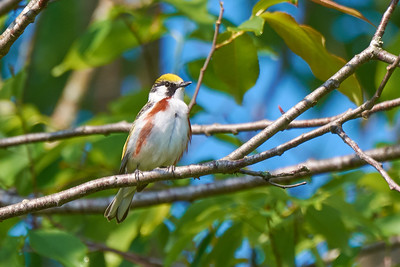
Assessing the effects of Close-to-Nature Forestry on forest birds in the eastern United States: A case study and way forward
2022
Summary
This study sought to 1) assess the effects of forest structural characteristics on avian species richness in a CTNF-managed forest in the eastern USA; 2) compare the results to county-level eBird data to identify the challenges of assessing the impacts of forestry practices on birds at landscape scales; 3) highlight the ambiguities in current forest management guidelines for improving avian habitats in the USA and 4) suggest long-term direction for evaluating the impacts of alternative forest management practices on birds.
Key Personnel & Institutions
Not available.Location
VERMONT, Massachusetts, Maine, New York, New Hampshire, Connecticut, Rhode Island, New England
Resource Type
Article
Tags
No tag keywords available
Topic Tags
conservation, management, planning, drivers, wildlife and habitat
Purpose Tags
conservation, management
Citation
Gresh J. M., Courter J. R., "Assessing the effects of Close-to-Nature Forestry on forest birds in the eastern United States: A case study and way forward", 27 August 2022, https://doi.org/10.1177/1758155922112171
Source Link
https://journals.sagepub.com/doi/abs/10.1177/17581559221121712
Cohabitating with New England Cottontails: Habitat restoration for at-risk New England cottontail also benefits shrubland birds
2022
Summary
Ongoing habitat restoration efforts will help the survival of the New England cottontail, and new research by the New Hampshire Agricultural Experiment Station (NHAES) researchers published in Ecosphere finds that these efforts will have far-reaching benefits to shrubland-obligate birds with which the cottontail shares its habitat.
Key Personnel & Institutions
Not available.Location
VERMONT, Massachusetts, Maine, New York, New Hampshire, Connecticut, Rhode Island, New England
Resource Type
Article
Tags
No tag keywords available
Topic Tags
conservation, methods, management, wildlife and habitat
Purpose Tags
conservation, management
Citation
Gosling N., Hatch A., "Cohabitating with New England Cottontails: Habitat restoration for at-risk New England cottontail also benefits shrubland birds", UNH Today, 9 August 2022, Accessed from: https://scholars.unh.edu/cgi/viewcontent.cgi?article=6690&context=unh_today
Source Link
https://scholars.unh.edu/cgi/viewcontent.cgi?article=6690&context=unh_today
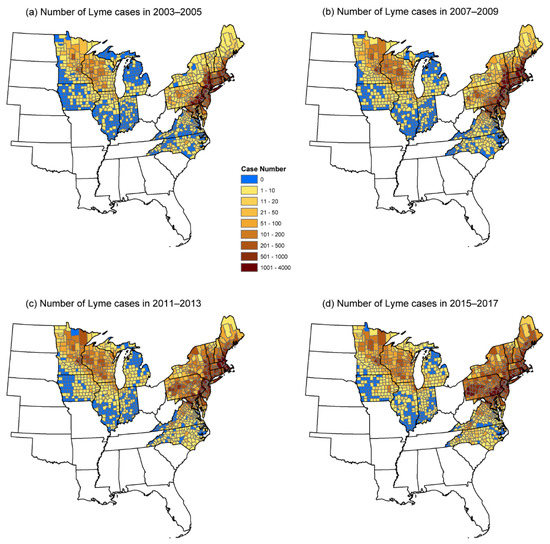
Effect of Land-Use Change on the Changes in Human Lyme Risk in the United States
2022
Summary
This study compared the spatial patterns of changes of human Lyme cases and incidence in the Northeast and Upper Midwest between 2003–2005 and 2015–2017, and applied two different approaches (i.e., a statistical regularization approach and model averaging) to investigate the climatic and landscape factors affecting the risk change between the two periods.
Key Personnel & Institutions
People: Yuting Dong , Zheng Huang , Yingying X.G. Wang
Institutions: Nanjing Normal University, College of Life Sciences , University of Jyväskylä, Department of Biological and Environmental Science
Location
VERMONT, Massachusetts, Maine, New York, New Hampshire, Connecticut, Rhode Island, New England
Resource Type
Article
Tags
No tag keywords available
Topic Tags
wildlife and habitat, landscape pattern and connectivity
Purpose Tags
No purpose tag keywords available
Citation
Ma Y., He G., Yang R., Wang Y. X. G., Huang Z. Y. X., Dong Y., "Effect of Land-Use Change on the Changes in Human Lyme Risk in the United States", Sustainability, 2022, v. 14, iss 10, https://doi.org/10.3390/su14105802
Source Link
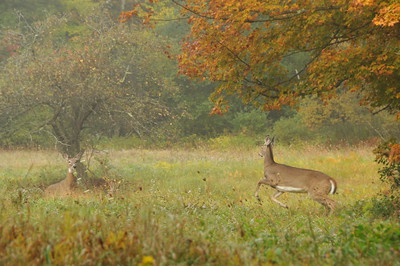
Deer and invasive plants in suburban forests: assessing variation in deer pressure and herbivory
2021
Summary
Deer browsing/grazing pressure varies among sites, potentially affecting herbivory on nonindigenous plants and their invasion success. We aimed to identify a useful deer pressure indicator for suburban forests and then use it to relate deer pressure to grazing on and abundance of two herbaceous invaders, Microstegum vimineum and Alliaria petiolata.
Key Personnel & Institutions
Not available.Location
VERMONT, Massachusetts, Maine, New York, New Hampshire, Connecticut, Rhode Island, New England
Resource Type
Article
Tags
No tag keywords available
Topic Tags
conservation, drivers, wildlife and habitat
Purpose Tags
conservation
Citation
Morrison J. A., Fertitta M., Zymaris C., diBartolo A., Akparanta C., "Deer and invasive plants in suburban forests: assessing variation in deer pressure and herbivory", Ecoscience, 2022, v. 29, iss. 2, https://doi.org/10.1080/11956860.2021.1958535
Source Link
https://www.tandfonline.com/doi/abs/10.1080/11956860.2021.1958535
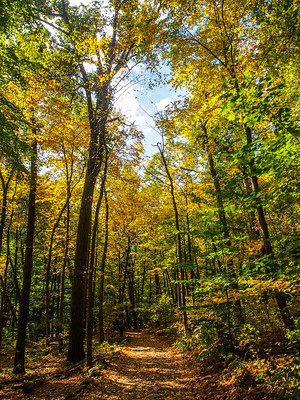
Is Forest Fragmentation a Management Issue in the Northwest?
1988
Summary
This is a compilation of papers from the technical session sponsored by the Wildlife and Fish Ecology Working Group Society of American Foresters' Annual Convention on October 19, 1988 in Rochester, NY.
Key Personnel & Institutions
People: Richard DeGraaf , William M. Healy
Location
Rochester
Resource Type
Report
Tags
No tag keywords available
Topic Tags
conservation, management, wildlife and habitat
Purpose Tags
conservation, management
Citation
DeGraaf R. M., Healy W. M., "Is Forest Fragmentation a Management Issue in the Northwest?", 19 October 1988, Accessed from: https://books.google.com/books?hl=en&lr=&id=vIQOyw-uScUC&oi=fnd&pg=PA1&dq=forest+fragmentation+northeast+us&ots=fA1aWv6y-O&sig=83_lkpSRZeV_qKnoMDm_Z7RBg8w#v=onepage&q&f=false
Source Link
The effects of forest fragmentation on genetic variation in Acer saccharum Marsh. (sugar maple) populations
1993
Summary
To investigate the effects of forest fragmentation on genetic variation in Acer saccharum Marsh. (Aceraceae) populations, aflozyme variation in eight populations in fragmented forest patches was compared to variation in eight population samples from extensive continuous forest.
Key Personnel & Institutions
Not available.Location
VERMONT, Massachusetts, Maine, New York, New Hampshire, Connecticut, Rhode Island, New England
Resource Type
Report
Tags
No tag keywords available
Topic Tags
conservation, management, drivers, wildlife and habitat, landscape pattern and connectivity
Purpose Tags
conservation, management
Citation
Young A. G., Merriam H. G., Warwick S. I., "The effects of forest fragmentation on genetic variation in Acer saccharum Marsh. (sugar maple) populations", Heredity, 1993, v. 71, pp. 277-289
Source Link
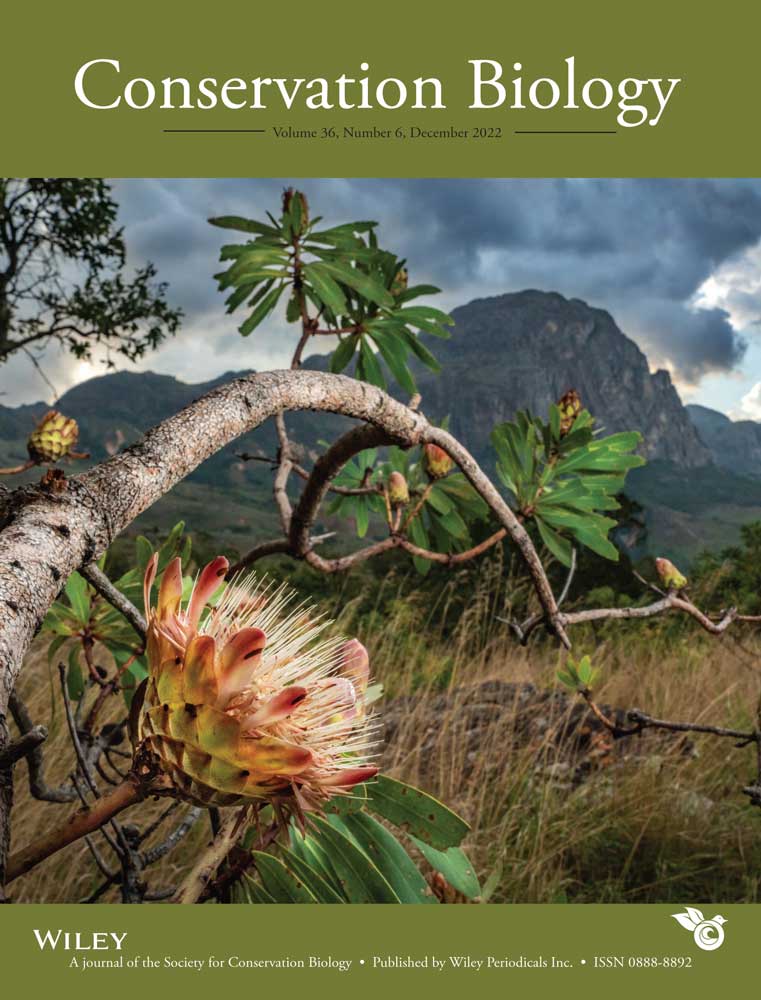
Forest Edges as Nutrient and Pollutant Concentrators: Potential Synergisms between Fragmentation, Forest Canopies, and the Atmosphere
2002
Summary
Forest fragmentation leads to a dramatic increase in forest edge, and these edges may function as traps and concentrators for wind-borne nutrients and pollutants. This study assessed the influence of forest edges on atmospheric deposition and subsequent inputs to the forest floor in deciduous-forest fragments in the eastern United States.
Key Personnel & Institutions
People: Kathleen Weathers
Location
VERMONT, Massachusetts, Maine, New York, New Hampshire, Connecticut, Rhode Island, New England
Resource Type
Article
Tags
No tag keywords available
Topic Tags
conservation, ecosystem services, drivers
Purpose Tags
conservation
Citation
Weathers K. C., Cadenasso M. L., Pickett S. T. A., "Forest Edges as Nutrient and Pollutant Concentrators: Potential Synergisms between Fragmentation, Forest Canopies, and the Atmosphere", Conservation Biology, 12 January 2002, v. 15, iss. 6, p. 1506-1514, https://doi.org/10.1046/j.1523-1739.2001.01090.x
Source Link
Assessment and Mapping of Forest Parcel Sizes
2005
Summary
A method for analyzing and mapping forest parcel sizes in the Northeastern United States is presented. A decision tree model was created that predicts forest parcel size from spatially explicit predictor variables: population density, State, percentage forest land cover, and road density.
Key Personnel & Institutions
People: Brett Butler , Susan L. King
Institutions: United States Department of Agriculture (USDA), Forest Service, Northern Research Station
Location
VERMONT, Massachusetts, Maine, New York, New Hampshire, Connecticut, Rhode Island, New England
Resource Type
Report
Tags
No tag keywords available
Topic Tags
landscape pattern and connectivity
Purpose Tags
No purpose tag keywords available
Citation
Butler B. J., King S. L., "Assessment and Mapping of Forest Parcel Sizes", 2005, Accessed from: https://www.fs.usda.gov/research/treesearch/14259
Source Link
Reconciling the Effects of Historic Land Use and Disturbance on Conservation of Biodiversity in Managed Forests in the Northeastern United States: Part 2 – Transition Hardwoods
2005
Summary
This study was designed to 1) determine the composition, dynamics, and natural disturbance regimes of presettlement forest communities in the northeast, 2) describe the changes and biodiversity impacts imposed on the landscape by human land use over the past 400 years, and 3) offer realistic suggestions for sustainable forest management that could simulate presettlement ecological processes while supplying timber resources, thus favoring natural species assemblages and promoting long-term conservation of biodiversity in managed forests.
Key Personnel & Institutions
People: Thomas Lee , John Litvaitis
Location
VERMONT, Massachusetts, Maine, New York, New Hampshire, Connecticut, Rhode Island, New England
Resource Type
Report
Tags
No tag keywords available
Topic Tags
conservation, methods, management, drivers, landscape pattern and connectivity
Purpose Tags
conservation, management
Citation
Howard L. F., Litvaitis J. A., Lee T. D., Ducey M. J., "Reconciling the Effects of Historic Land Use and Disturbance on Conservation of Biodiversity in Managed Forests in the Northeastern United States Part 2 – Transition Hardwoods", February 2005, accessed from: https://www.researchgate.net/profile/Lauren-Howard-4/publication/242444000_Reconciling_the_Effects_of_Historic_Land_Use_and_Disturbance_on_Conservation_of_Biodiversity_in_Managed_Forests_in_the_Northeastern_United_States_Part_2_-_Transition_Hardwoods/links/588a3f1492851c2779b2592e/Reconciling-the-Effects-of-Historic-Land-Use-and-Disturbance-on-Conservation-of-Biodiversity-in-Managed-Forests-in-the-Northeastern-United-States-Part-2-Transition-Hardwoods.pdf
Source Link
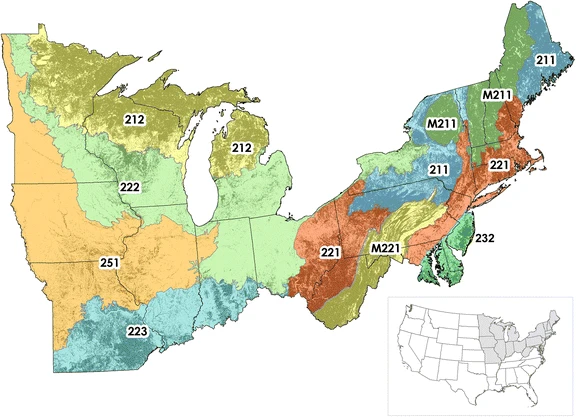
Vulnerability of forests of the Midwest and Northeast United States to climate change
2017
Summary
The Climate Change Response FrameworkFootnote1 (CCRF; Swanston et al. 2016) has generated vulnerability assessments of forest ecosystems across the Midwest and Northeast as a first step to identifying risks and adapting to climate changes. This study synthesizes findings from these forest ecosystem vulnerability assessments with consideration of common themes in nine ecological provinces (McNab et al. 2007) (Fig. 1).
Key Personnel & Institutions
People: Frank Thompson , Maria K. Janowiak , Christopher W. Swanson , Louis Iverson
Institutions: United States Department of Agriculture (USDA), Forest Service , United States Department of Agriculture (USDA), Forest Service, Northern Research Station , Northern Institute of Applied Climate Science , Northern Research Station, Michigan Technological University
Location
VERMONT, Massachusetts, Maine, New York, New Hampshire, Connecticut, Rhode Island, New England
Resource Type
Article
Tags
No tag keywords available
Topic Tags
conservation, drivers
Purpose Tags
conservation
Citation
Swanston C., Brandt L. A., Janowiak M. K., Handler S. D., Butler-Leopold P., Iverson L., Thompson F. R. III, Ontl T. A., Shannon P. D., "Vulnerability of forests of the Midwest and Northeast United States to climate change", Climatic Change, 2018, iss 146, pp. 103-116
Source Link
New York-New Jersey Highlands Regional Study
1990
Summary
This is a report transmitted in accordance with Section 1244(b) of the Food, Agriculture, Conservation and Trade Act of 1990. The study team included representatives from the states of New York and New Jersey, and the Forest Service.
Key Personnel & Institutions
Institutions: United States Department of Agriculture (USDA)
Location
New York
Resource Type
Report
Tags
No tag keywords available
Topic Tags
conservation, methods, management, ecosystem services, planning
Purpose Tags
conservation, management, policy
Citation
Michaels J. A., Nevill L. R., Edelman D., Sullivan T., DiCola L. A., "New York-New Jersey Highlands Regional Study", 1990, Accessed from: https://books.google.com/books?hl=en&lr=&id=veW1WN_QSqIC&oi=fnd&pg=PA5&dq=forest+parcelization+northeast+us&ots=IWCQ6WgPZ9&sig=v3aZKeB3tDDb63OwLcoyhkBx0l4#v=onepage&q&f=false
Source Link
Maintaining Sustainable Forests
2021
Summary
This presentation highlights the problems facing vermont forests and possible methods or management to minimize the losses.
Key Personnel & Institutions
People: Jamey Fidel
Institutions: Vermont Natural Resources Council
Location
VERMONT
Resource Type
Poster
Tags
No tag keywords available
Topic Tags
conservation, methods, management, planning, drivers, landscape pattern and connectivity
Purpose Tags
conservation, management
Citation
Fidel J., "Maintaining Sustainabl Forests", 2021, Accessed from: https://legislature.vermont.gov/Documents/2022/WorkGroups/Senate Natural Resources/Forests/W~Jamey Fidel~Sustainable Forests.~4-28-2021.pdf
Source Link
Dynamic Models of Land Use Change in Northeastern USA
2022
Summary
This study is designed to test the ability of a dynamic simulation modeling tool—GEOMOD—to illustrate local and regional land use changes, both in the recent past and in the near future. It stems from the idea that if people know how rapidly their forest resource is being lost, where it is being lost, and what forces seem to be driving the losses, they will be better equipped to take effective conservation action.
Key Personnel & Institutions
People: Mary Tyrrell , Myrna H. Hall , Neil Sampson
Institutions: Yale University, School of Forestry and Environmental Studies , The State University of New York (SUNY), College of Environmental Science and Forestry , Yale School of Forestry and Environmental Studies
Location
VERMONT, Massachusetts, Maine, New York, New Hampshire, Connecticut, Rhode Island, New England
Resource Type
Report
Tags
No tag keywords available
Topic Tags
conservation, methods, management, planning, drivers, landscape pattern and connectivity
Purpose Tags
conservation, management
Citation
Tyrell M. L., Hall M. H. P., Sampson R. N., "Dynamic Models of Land Use Change in Northeastern USA", Global Institute of Sustainable Forestry, August 2004, Accessed from: https://yff.yale.edu/sites/default/files/files/landuse_complete.pdf
Source Link
https://yff.yale.edu/sites/default/files/files/landuse_complete.pdf
Forest Fragmentation
2007
Summary
What Is Forest Fragmentation,and Why Is It Important? Forest fragmentation refers to a loss of forest and the division of the remaining forest into smaller blocks. Fragmentation is of concern primarily because of its impact on the conservation of biological diversity. Forest fragmentation can affect the amount and quality of habitat for many wildlife species (Fahrig 2003, Roundtable on Sustainable Forests 2000). Fragmented forests may consist of patches of forest too small to maintain viable populations of certain species. Fragmentation is also an issue because the resulting smaller blocks of forest may not be viable units for forest management (Roundtable on Sustainable Forests 2000).
Key Personnel & Institutions
People: Kurt Riitters
Institutions: United States Department of Agriculture (USDA), Forest Service
Location
VERMONT, Massachusetts, Maine, New York, New Hampshire, Connecticut, Rhode Island, New England
Resource Type
Report
Tags
No tag keywords available
Topic Tags
conservation, management, drivers, wildlife and habitat, landscape pattern and connectivity
Purpose Tags
conservation, management
Citation
Riitters K. H. "Forest Fragmentation", 2007 pp 9-15 In: Forest health monitoring: 2005 national technical report. General Technical Report SRS-104. Asheville, NC: U.S. Department of Agriculture, Forest Service, Southern Research Station.
Source Link
Filter by
Keywords
Begin typing a tag below. Click or tap a match to add it to your list of filters. You may enter more than one tag term.
Resource Topics
Resource Purpose
Document Type
Location
Begin typing a state, county, town, or area below. Click or tap a match to add it to your list of filters. You may enter more than one location term.
